

Planning a Trip to South Korea: a Step By Step Guide
By: Author Kris
Posted on Last updated: March 28, 2023
Planning a trip to South Korea can be a difficult and overwhelming process but with our extensive guide, you will be able to breeze through all the steps required.
Keep reading for our tips, advice, and information on the best way to plan a trip to South Korea.
There is a really good chance that this post contains affiliate links. If you click one of them, we may receive a small commission (for which we are deeply grateful) at no extra cost to you.
Table of Contents

Why Visit South Korea?
If you are just starting out the planning process you may still be deliberating on whether South Korea is even the best place for you to visit.
We can help you finalize that decision with some of the best reasons to visit South Korea and why it is such a wonderful travel destination.
South Korea has an amazingly rich culture and long history.
There are many cultural sites to visit and incredible experiences, such as temples and palaces. This includes a number of UNESCO World Heritage Sites such as the Bulguska Temple and the lava tubes in Jeju.
The cities are full of unique modern designs and high-tech displays and shopping malls while beautiful nature and scenery are also easily accessible.
Whether you like beach activities, hiking, shopping, cultural experiences, or a mix of everything, there is something for everyone to enjoy in South Korea.
Here is a list of amazing things to do in Korea.
Best Time Of The Year to Visit South Korea
South Korea is very seasonal and the climate is the only thing that changes.
There can be large differences in available activities, recommended places to visit, and things to do depending on the season.

Spring
Spring is one of the most popular times to visit Korea and for good reason. The weather is clear, the temperature is moderate and flowers are blooming.
If you enjoy outdoor pursuits, this is one of the best times to be in Korea.
It is also the time of cherry blossoms, and if you time your visit right you could be treated to a magnificent display of pink and white blossoms.
However, the flowers aren’t limited to cherry blossoms, with flower fields across the country of plum blossoms, azaleas, and roses.
Spring can be cool at night and might be difficult for those who have bad hay fever or pollen allergies.

Summer
Summer in Korea can be very changeable with the monsoon season hitting in August.
It is also very humid in summer, so while the temperature isn’t too hot, the humidity can be difficult to deal with.
However, it can be a great time to visit if you plan on visiting some of the coastal areas or islands.
It can also be good for enjoying balmy evenings with casual outdoor eating and a relaxed holiday atmosphere as schools and universities are on summer vacation.

Autumn
Autumn is a beautiful time in South Korea with vibrant autumn foliage to be seen in many places. This time of year is ideal for hiking and climbing mountains.
It is also a good time to visit the many palaces populated by autumnal maple and ginkgo trees.
Autumn is also the time of Chuseok, the Korean harvest festival celebration.
Many Chuseok events are held during this time and can be a great way to have a unique cultural experience while in South Korea.

Winter
Winter in Korea can be very cold, with temperatures reaching negative and snowstorms.
However, it is also a beautiful time of year if you enjoy the winter scenery. The snow-topped mountains can be very picturesque and it is great for skiing, snowboarding, and other winter activities.
Winter is also the time of the Lunar New Year celebrations, which can be easily enjoyed as a cultural experience.
It is also the time of Christmas and western New Year, which can be interesting to experience in a different country and culture than your own.

How Many Days In South Korea?
An essential part of planning a trip to South Korea is deciding how long to spend there.
Finding the balance between too short and too long can seem difficult, especially without already having experience in Korea.
Luckily, a visit to Korea can be quite versatile, depending on where you plan to visit.
Longer is generally better, as it will give you more time to visit different cities, take various day trips and see more of the country.
However, it is easily possible to have a short trip and just stick to one city.
An example of this is covered in our 4-day and 3-7-day Seoul itineraries.
If you have a bit longer in the country, you can visit cities such as Busan, and utilize our Busan itinerary .
A longer itinerary can also allow for taking more time in each location and having more downtime.
The range of places to visit and things to do means it is unlikely that you could run out of things to do, and the variation from traditional temples to modern shopping malls, palaces to theme parks, means it is unlikely to become repetitive.
In summary, the longer you can make your itinerary, the better, but if you only have a short amount of time available, it is still possible to have a great time on a shorter trip.
- 7 Days in South Korea
- 14 Days South Korea Itinerary

Dos And Don’ts In South Korea
When visiting another country and culture, it is always important to be aware of cultural etiquette and common dos and don’ts of the country.
This can be related to social manners or simply making your trip easier.
Learn Basic Korean Words
While traveling in Korea, it can be beneficial to learn a few basic Korean words and phrases.
Important phrases like “Excuse me,” “I’m sorry,” and “thank you” can come in very helpful and will be appreciated by those around you.
Some simple words like ‘this’ and ‘that’ as well as question words, including what, where, and how much, can be very useful in getting around and working things out on the go.
Using translation apps or tools like Google Translate is another useful option. Here is a list of more handy Korean apps.

Tipping In South Korea
Tipping at a bar or restaurant in South Korea is not necessary or expected.
Some high-end restaurants may have the opportunity to tip if you want to, but it’s never an expectation.
In some cases, tipping can be seen as rude as it can imply that the employee or the business doesn’t have enough money and needs pity.
Overall, it is safer to just not tip in South Korea unless there is an explicit prompt. In these cases, it is still completely your choice and you are free to not tip.

Bring Cash
When traveling in Korea, having cash on hand is extremely useful.
While credit cards have become more common in recent years and many businesses do accept credit cards, not all credit cards will be available to be used and there is always the possibility of a restaurant or shop not accepting cards at all.
For this reason, having a good amount of cash with you is essential.
ATMs can also be hit-or-miss as some will work with foreign cards while others won’t.
It is a good idea to remove a decent amount at a time in case you can’t find another ATM to withdraw from easily.

Photography
It is common to want to take photos and document all the amazing sights, foods, and places you’re experiencing while on vacation.
However, it is important to be careful when taking photos in public.
In some countries, including South Korea, the right to privacy extends into the public sphere, meaning photos, where someone is easily identifiable, can be illegal.
Of course, a photo taken in a crowded place will likely have people in it and it is unlikely that you will be challenged over this but taking a photo of a specific person or group of people may bring issues.

Priority Seating
Most buses and trains in Korea have a designated area for priority seating.
This seating is reserved for elderly, pregnant, or disabled people.
These seats should be left empty unless someone from one of those categories is using them.
While it may seem ok to sit down and just move if someone who needs them enters the train or bus, this can still be seen as rude and it is best to just stand if no other seats are available.

Korea Trip Budget
A trip to Korea can be quite reasonably priced as the number of expenses is fairly low.
Categories like food are often cheap day-to-day.
The more expensive categories include accommodation, which can range from cheaper hostel-style accommodation to more expensive hotels.
Accommodation in the main cities tends to be more expensive than in smaller cities or the countryside.
Transport costs can vary a lot depending on how much traveling around the country you wish to do and what transport methods you use.
For long-distance travel, there are some train passes that can offset the costs somewhat, or you can use a rental car.
While in the city, buses and trains are fairly easy to use and budget-friendly. Taking a taxi is more expensive but may be easier when visiting certain places.
Overall, Korea is a very accessible country on a range of budgets.
There are a number of areas where you can cut costs for a more budget-friendly trip or spend a bit more to suit your preferences.
Here is more information on the budget you should foresee.

Your Korea Trip Planning
Planning a trip can be done in stages with different steps being done at different times.
Here is our breakdown of what should be done when in order to best plan your trip to South Korea.
The Timeline For Your Korea Trip Planning
6 months in advance
Book international flights
Join our Facebook group
Get travel insurance Plan your itinerary Check if you need a Visa
About 3 months in advance
Do you need an International Driving Permit? Book domestic flights
1 month in advance
Internet in South Korea Book Tours and other Fun Experiences
1 week in advance
What to pack
6 Months In Advance
Join our korea facebook group.
Become a member of our Korea Travel Planning and Tips Facebook group.
The purpose of this group is to help you plan an amazing vacation to Korea. You can ask questions and exchange tips with fellow travelers.
Book Flights To South Korea
If you have decided on South Korea and narrowed down your travel dates, it’s best to start checking flight prices as soon as possible.
Prices will change over time usually in a U-curve shape, starting high, slowly becoming cheaper, and then moving back towards expensive as it gets closer to the travel date.
The absolute lowest point is unpredictable but usually falls around 4-6 months before the travel dates.
The earlier you start checking the prices, the easier it will be to have a good idea of when you’re seeing ‘good’ prices and whether it is likely to fall further or not.
This can easily be done through price tracking or price alerts on various flight comparison websites.

Tips To Find Cheap Flights
If you are looking to save on flights, there are a number of things you can do.
The first is to make the best use of flight comparison websites.
This can be Skyscanner, Momondo, or even Google Flights. You can set up price tracking or alerts as mentioned previously and see various options at different prices.
You can also use a number of different limitations, such as flight duration, departure time, arrival time, and stopovers to get the best flights for your situation.
Using low-cost carriers (LCC) airlines can also be an opportunity to save some money on flights.
Here is more information on finding cheap flights to South Korea.

Travel Insurance
As soon as you have flights booked, the next step should be travel insurance.
An international trip is a big expense and can become even more expensive if something should go wrong while you’re out of the country.
It is easy for accidents to happen and a travel insurance policy can be very helpful when dealing with a medical or personal issue while in a foreign country.
Korea is generally a safe country with a modern and trustworthy healthcare system. Many doctors are able to speak English and will be ok dealing with foreigners.
This may be more difficult to find in more rural areas.
However, while the quality of medical care is high, costs as a tourist can also be quite high. Having a travel insurance policy in place to cover these costs can help relieve stress in a high-pressure situation.
It is important to make sure you know what your policy covers and not always go for the cheapest option, as sometimes this can lead to expensive surprises when an accident does occur.
It is also best to get a policy that can cover costs as they happen, rather than paying upfront and receiving reimbursement later.
If you are looking for travel insurance, we recommend you to look at Safetywing . They offer very competitive prices for very decent coverage.

Passports And Visa
Many countries have a visa-waiver agreement with South Korea, meaning you do not need a visa to enter for tourism purposes.
This includes many parts of Europe, North America, much of South America, Oceania, and a number of Asian countries.
If you are unsure about your home country’s status, you can find more info here.
If you are from a country that is part of the visa-waiver agreement you will still need to apply for a Korea Electronic Travel Authorization or K-ETA.
This will require some personal details, your passport details, and a payment of 10,000KRW (approx. $10 USD).
This should be approved in a short period of time.
This application can be done on the official Korean website.
For more details, see our guide to travel in South Korea .

Covid Testing And Q Code
Korea has had constantly changing and often strict rules regarding entry during the last few years.
Covid-19 has led to pre-departure tests, on-arrival tests, and varying quarantines.
However, as of 1 October 2022, travelers no longer need to have testing either pre-departure or on-arrival and quarantine is no longer necessary.
You will need to apply for Q-code to enter South Korea.
This is a QR code that will be issued to you after applying and will contain your relevant health and contact information.
This application must be done no more than 3 days prior to entry.

Plan Your Travel Itinerary
Korea highlights , seoul .
With Seoul as the capital of South Korea, it makes sense to be one of the highlights of any Korea trip.
With its unique blend of old and new, Seoul is an amazing city to visit. Over the last few decades, Seoul has grown to be at the forefront of design, urban planning, technology, and more.
There is also a great celebration of traditional culture and historic sites.
Also setting Seoul apart from many modern cities is Bukhansan Park in the north of the city.
This national park borders the capital city and offers a welcome respite into beautiful nature and hiking trails.
Here is our comprehensive list of Seoul posts that will help you plan your trip:
Things To Do And Itineraries:
- Best things to do in Seoul
- Best things to do in Seoul at night
- What is Seoul known for
- Best day trips from Seoul
- Best Seoul itinerary
- Best 4-day Seoul itinerary
Accommodation:
- Where to stay in Seoul
- 15 cool hotels in Seoul
- Best Boutique hotels in Seoul
- Best Hanok Stays in Seoul
- Best vacation rentals in Seoul
Seoul Guide

For the price of a single cup of coffee, you can get this Seoul itinerary as a nicely formatted PDF document.
It contains all the information in this post.
You can print it or store it on your phone so you can access it anytime during your visit to Seoul.
Have a look here for more information and a preview.

Busan
Busan is a coastal city in the southeast of the country.
In recent years it has grown from a small and quaint fishing village to a bustling city with its own unique personality.
As a coastal city, Busan has a great predilection for seafood and is a great place to try out various Korean seafood dishes.
There are also some beautiful beaches to visit and waterfront activities to enjoy.
Here is our comprehensive list of Busan posts that will help you plan your trip:
Things to do and itineraries :
- What to do in Busan
- The perfect 2-day Busan itinerary
- Best Busan day trips
- Best Busan day tours
- Best things to do in Busan at night
Accommodation posts:
- Where to stay in Busan
- Best Airbnbs in Busan

The DMZ
Many people consider the DMZ a must-see while visiting South Korea.
The DMZ, or demilitarized zone, is the zone surrounding the border of South Korea and North Korea.
This is one of the few remainders of the Cold War that is still active, as the Korean War never officially ended and the two Koreas remain in an official state of conflict.
This border can only be visited on an organized tour due to the sensitivity of the area. Some tours also include the JSA or Joint Security Area, the actual borderline passing through the barracks on site.
Visiting this area is a unique look at how history and the present can intertwine.
Note that the JSA is currently closed. We don’t know if and when it will reopen.
However, a visit to the DMZ stills gives you a unique understanding of North and South Korea’s history.
Book your DMZ tickets here, or read our full guide on how to choose the best DMZ tour.
Check prices and availability: Half or Full Day DMZ Tour

Jeonju
Jeonju has a unique place in Korean history as the birthplace of the Joseon Dynasty, the rulers of Korea from 1392 until the early 20 th Century.
For this reason, the city is steeped in history and tradition, with many cultural sites.
This long historical period gave rise to many rich cultural pursuits and uniquely Korean innovations. These include traditional Korean wine, paper, and dolls.
Jeonju is well-known for its Hanok Village, an area of the city with predominantly Hanok buildings.
This is a style of building based on traditional Korean ways of thinking and architectural design.
It involves the ideal placement of a home, how to keep the building comfortable and temperate throughout the changing seasons, and catering to the social needs of the time.
Many of these traditional houses are still in existence and can be seen in the Jeonju Hanok Village. You can even spend the night in one of them.
There are also a number of historic sites in Jeonju as well as museums commemorating Korean history and tradition.
Jeonju is an ideal place to visit to truly soak in the long traditions and history of Korean culture. Here is a list of the best things to do in Jeonju.

Gyeongju
Gyeongju, one of the most beautiful places in South Korea, is another historic city in South Korea.
It was the main capital of the Silla Kingdom which ruled the Korean Peninsula from 57BC – 935AD.
This long history has led to a number of historic and culturally significant sites in Gyeongju, including a number of UNESCO World Heritage Sites.
In fact, the sheer number of historic sites is the reason behind the city’s nickname of “the museum without walls” or “the museum without a roof”.
There are many historical temples and palaces in Gyeongju, documenting the history of religion and the kingdom during this time.
It is also home to Cheomseongdae, one of the oldest astronomical observatories in Asia.
It dates to the 7 th Century and is amazing to visit for both historical reasons and the astronomical illuminations that are regularly displayed.
Gyeongju is also home to the UNESCO Gyeongju Historic Area, an entire area of historic ruins and relics. This area has museums, ruins to explore, serene temples, and more.
The city of Gyeongju is a must-see for anyone interested in history, Korean culture, or both.
From hotels, highlights, transportation, and other booking needs, this section of our Korea itinerary has got you covered.

Hotels In South Korea
There is a wide range of hotel accommodations available in South Korea.
The major cities, such as Seoul, are often more expensive, especially in the central areas.
Smaller cities can be cheaper, although it can depend on the time of year and location.
Accommodation prices in Korea can be quite seasonal generally, with spring being one of the most popular times of year to travel and prices reflecting this trend.
However, regardless of when you travel, with some research and careful booking, you will always be able to find something to suit your budget.
Choose a hotel from this list of well-rated hotels.
Check out our where to stay section in our Korea travel guide for all our hotel posts.

Best Booking sites For South Korea
There are a number of booking sites that can be used to look for hotel accommodations in South Korea. Some of the top booking sites include:
Booking.com
The behemoth of accommodation Booking, Booking.com is just as active in South Korea as in other countries.
The majority of hotels can be found on Booking.com and the popularity of the site means there are often plenty of reviews which can be helpful in deciding on accommodation.
Check prices and availability: Booking.com
Agoda
Agoda is another big name in the accommodation booking business, although slightly less well-known than booking.com.
It is also part of the Booking.com group and so contains many of the same hotels.
However, as it was started in Asia, there are sometimes hotels listed which haven’t made it to Booking.com and sometimes deals are listed on Agoda but not booking.com.
Check prices and availability: Agoda
VRBO
If you are traveling with a family or just want a bit more space, staying in a VRBO or accommodation rental may be the answer.
Many hotel rooms in Korea can be small or feel cramped, and a full apartment to yourself may be a better alternative.
This also gives you the freedom to cook for yourself and more space if you need some relaxing time.
Check prices and availability: VRBO

Special Accommodations In South Korea
If you’re looking for a more unique accommodation experience while in South Korea, a hanok stay may be ideal for you.
These traditional houses can be found in many places throughout the country and are a step back in time to traditional Korea and the architecture and design of the period.
Most hanok accommodations have futon-style bedding and traditional rooms, so they may not be your accommodation for the entire trip, but staying for a night or two is a great option and a unique way to experience Korean tradition.
If you’re looking for hanok accommodation in Seoul, check out our previous post here.
If you plan to stay in a hanok while visiting the historic city of Jeonju, you can see our top picks here .

Getting Around In South Korea
Once you have decided on your general travel plans and which cities you will be visiting, it’s time to look into how you will get around in South Korea.
This includes both between cities and inside the city.
We have three main means of transport.
Driving is a great way to travel between cities and visit the regions that aren’t serviced by the railway.
It also provides the opportunity to plan your own journey, meaning you can make stops that wouldn’t be possible when traveling by train or public transport.
There are many rental car companies operating in South Korea and it is easy to rent a car from the airport.
However, driving isn’t really necessary or even very convenient while inside the big cities so if you are staying in Seoul before moving on, you may want to wait before renting a car.
If you plan on renting a car in South Korea, click here.
To see more about our experience of driving in South Korea, see our post here.

Train
Korea has a rail network connecting many of the major metropolitan cities.
There are a number of trains available, including a high-speed bullet train, known as the KTX lines. The trains are reliable and easy to use.
This can be a great way to get between major cities quickly.
The six largest cities in Korea also have a subway or metropolitan system, which is useful for moving around the city or visiting different areas within the same city.
Korail also offers a number of tourism rail passes to foreign visitors, including 3- and 5-day passes.
However, it is important to check the prices of individual tickets before buying a pass, as sometimes the pass doesn’t work out cheaper.

Express Bus
Buses offer another alternative mode of transport.
If you don’t like driving or just want to avoid driving in a foreign country, buses can be another road option.
They are slower than the train but cover more area and so might end up more interesting.
They also serve more cities along the way. An express bus tends to go straight from one city to another while an intercity bus will make stops at different cities along the way.
There are also many local buses for getting around the cities after you have arrived.
For more information on public transport in South Korea, see our guide here.

Organized Tours
Planning a trip itinerary can be difficult and organized tours can simplify the process.
There are many different types of tours available and there is most likely one to suit you. Some tours are more guided while others plan the itinerary and provide minimal guidance to allow you more independence and options while on your trip.
Tours can have varying group sizes and be fast-paced or slow-moving.
There are also tours that are more focused on a certain type of traveler or interest, such as tours for young adults who want to experience a lot of nightlife, or tours more centered around the history and culture of an area.
There are many different tour options available in South Korea and we have curated some of the best options into our list here.

3 months In Advance
International drivers license .
If you are planning on driving while in Korea you will need an IDP or International Drivers Permit.
This will give you permission to drive in Korea while holding an international driver’s license. Without an IDP or Korean driver’s license, there is no way for you to drive in Korea.
An IDP provides an official translation of your original driver’s license and can be provided by the official authority in your home country. You will need to show this when renting a car.
Getting an IDP is a reasonably easy process and can help to provide a lot of freedom and flexibility in your travel planning and itinerary.
Domestic Flights
Domestic flights aren’t necessary if you only visit the beautiful mainland of South Korea. However, if you also wish to go to the subtropical Jeju island you will need to fly. There’re multiple daily flights from Seoul and you should find reasonably priced flights if you book them 3 months out. Don’t wait too long if you’re traveling during the peak season.
If flights have become too expensive you can also take a ferry from Busan or some other places in the south of the country.
Check for flights on Momondo: Flights to Jeju

1 Month In Advance
Staying online in south korea .
Staying online can be a key aspect of travel in general, especially so when traveling in South Korea.
Having a reliable internet connection will allow you to use helpful tools like Google translate and navigation and map apps.
It will also help you find on-the-go recommendations, last-minute additions, up-to-date currency conversions, and more.
On top of that, many of us like to stay connected to friends and family while traveling, and reliable internet can be very helpful.
Many places in Korea have free wi-fi available but it is always useful to have your own internet connection for the times when public wi-fi isn’t working or if you are in an area without public wi-fi.
There are a few main options available. One of the most convenient options is a pocket wi-fi or wi-fi egg as they are sometimes called.
This small device will provide a constant wi-fi connection Pocket wi-fi devices can be easily rented either in advance or at the airport.
These can then be returned by mail or to the same kiosk at the airport where it was rented.
There is a range of different plans available.
Pocket wi-fi is a convenient and easy-to-use option for the internet while in South Korea. To see more about pocket wi-fi in Korea, check out our post here.
Another option is a travel sim. Many companies offer travel sims that can simply be swapped with your phone’s current sim.
You may also need to change some settings, but many travel sims will also provide you with a local phone number which may come in handy when making reservations that require contact details.
Another advantage of a travel sim is that you don’t have to return it at the end of your stay. For our experience and recommendations when using a travel sim in Korea, see our previous post .

Transportation From The Airport
There are a number of airports in South Korea that you may end up using and so it is necessary to be aware of the available transport to get to and from the airport.
Seoul has two main airports – Gimpo and Incheon.
Gimpo is predominantly used for domestic flights and is located about 50 minutes from the city center.
Gimpo is connected via the subway and airport express.
Incheon is the much larger and more commonly-used airport and is where most international visitors will first land.
It is about 47km from Seoul station, in the center of Seoul, and is easily reached.
A’REX Airport Express
The A’REX airport express is the fastest and cheapest way to move from Incheon to Seoul station.
Limousine Bus
You can also take the limousine bus which will make various stops at different points in Seoul.
There are 4 lines that stop at various places in Seoul.
- 6701 Airport: Seoul City Hall
- 6702 Airport: Dongdaemun/Namsan
- 6703 Airport: Gangnam/COEX
- 6705 Airport: Jamsil/East Seoul Bus Terminal
The buses run from early in the morning until the evening.
Note that the schedule for all buses is different, so definitely check the bus hours before booking a ticket.
Private Transfer
However, it is also possible that you could be tired and overwhelmed and not keen on navigating public transport after a long international flight.
In this case, paying a bit more for a direct private transfer going straight from the airport to your hotel might be the answer.

Busan
If you are planning on flying to Busan, you will likely end up using Gimhae, Busan’s airport.
This airport is only about 11km from Busan station in the city center. If you take a taxi from the airport, it will only be about 15 minutes. However, the cheaper options are to take the subway or bus.
Unfortunately, these take a more roundabout route and take 53 minutes for the subway and 1hr for the bus.
The option you choose will really depend on your budget and how much time you are willing to spare.

Jeju
While in Korea you may be planning on visiting the beautiful island of Jeju.
This island is easily reached by plane with flights from Seoul and Busan only taking around 55 minutes.
A number of other regional airports also have flights available. In fact, Jeju airport is actually the second-largest airport in South Korea due to its popularity.
It is located around 3km from the city center and is very easy to reach by bus or taxi.
Both options take around 5 minutes, however, the taxi is more expensive.

Tours And Other Fun Activities In South Korea
Best booking sites .
If you are planning on booking activities, day tours, or other fun things to do in South Korea, there are a number of booking sites you can use to find the best activities and get the best deals.
Here are our top picks:
GetYourGuide
GetYourGuide is a great website with a wide range of activities and tours available.
They can be easily booked through the website and customer service is handled by GetYourGuide rather than directly with the operator.
The customer service is very professional and quick to respond to any issues.
Many of the activities on GetYourGuide can be canceled for free with 24 hours’ notice which leaves you with more flexibility while you’re actually on your trip.
Check prices and availability: GetYourGuide
Viator
Viator is another company that works to connect travelers with tour and activity operators in the country.
It is owned by TripAdvisor and is considered reliable and consistent.
It often has more tours than Getyourguide listed, so if you can’t find the right activity for you on GetYourGuide, Viator might be the better option for you.
Check prices and availability: Viator
Klook
Klook is a large Asian-based booking site with many activities and tours able to be booked in South Korea.
There are a number of activities that can’t be found on other sites and many of them come with great deals.
This makes Klook a great option when looking for a variety of activities, including some that aren’t obvious or as well-documented.
It can also be great for your budget.
It’s important to note that not all activities can be canceled for free on Klook so your itinerary needs to be fairly certain when booking through this site.
Check prices and availability: Klook

Fun Activities In South Korea
There are a number of fun activities available in Korea that you may consider booking in advance.
This is especially relevant for the more limited or very popular activities which can book out weeks in advance.
To avoid disappointment, consider booking these in advance of your travel dates.

The DMZ : Visit the border of South Korea and North Korea and see how the hangovers of the Cold War continue to affect Korea to this day.
Look across North Korea while learning about its history and current situation in Korea.
Nami Island : A river island located near Seoul that is considered beautiful in every season. This island is a popular romantic destination and is well-known for its beautiful tree-lined paths and scenery.

N Seoul Tower : Wander through the beautiful Namsan Park before climbing the hill to N Seoul Tower where you can quickly rise to 500m to see stunning panoramic views over Seoul.
This offers some of the best views in Seoul and is often considered a must-see when visiting Seoul.
Nanta Show : Nanta is a unique, long-running form of musical comedy blending culinary skills, martial arts, acrobatics, and comedy.
It is also completely non-verbal. Spectators are encouraged to participate and the show provides a captivating 90 minutes of fun and entertainment.

Huwon Secret Garden : The Secret Garden is a beautiful rear garden at Changdeokgung Palace. Extensive yet intimate, beautifully designed yet natural, the garden is picturesque and relaxing.
Visitors must join a tour and tour tickets book out fast so it is necessary to be fast when booking tickets to the Secret Garden (click on tour reservation at the top of the page).
Best Theme Parks In South Korea
There are many amazing theme parks in South Korea and visiting one or more of them may be a fun activity while you are traveling.
Theme parks in Korea are often very extensive with many different things to do and enjoy.
They are designed and built with the aim of being the best theme park possible and often achieve this aim. Some of the top theme parks in South Korea include:

Lotte World
Lotte World Adventure is the world’s largest indoor amusement park with amazing rides and beautiful seasonal parades and performances.
The Garden Stage has regular performances changing with the season or relevant celebration (such as Christmas) and is well-loved by domestic and international tourists alike.
The Magic Island is the outdoor component of Lotte World and rivals Disney with its fairytale atmosphere.
Since March 31, 2022, Lotte World also opened in Busan.

Everland
Everland is one of Korea’s largest amusement parks and consists of five unique zones. These include Global Fair, Magic Land, American Adventure, Zootopia, and European Adventure.
Each zone is beautifully decorated and themed and can be very fun to visit. There are many rides at Everland, including the famous T-Express, Korea’s first wooden rollercoaster.
This is also one of the fastest rollercoasters in the world. There are also many themed exhibits and festivals depending on the season.
Check prices and availability:
Everland 1 day ticket
Everland shuttle bus and ticket
Here is an overview of more great amusement parks in South Korea.

1 Week In Advance
What to pack for your korea trip .
Packing can be a difficult task, especially when there is always a niggling fear in the back of your mind that you’ve forgotten something.
Some of the most important categories to cover are your important documents and electronics.
Important Documents
This includes items like your passport, travel insurance policy, and various other travel documents.
It can also include hotel reservations, although these are likely electronic and you probably don’t need printouts of these.
Electronics
Electronics will include your phone, plans for how to stay online in Korea, and possibly a camera and chargers for everything.
Items like medication and a refillable water bottle are also necessary and should be at the top of your list.
Some medications are banned in South Korea so it may be necessary to check if any medication that you need is permitted.
The season in Korea will largely determine how you pack with winter requiring much warmer clothing and thick jackets while summer requires cool and breathable clothes.
It is important to remember that seasons like spring can get very cool at night so you will still need some warm clothing.

More South Korean Travel Tips
Money saving tips .
Taking an international trip can be an expensive venture and there are likely many places where you are willing to spend a bit more money for comfort and convenience.
There are also a number of ways you can save money and reduce your budget.
This can include things like transport.
While traveling within the city sticking to public transport such as subways and buses will help save a lot of money that might otherwise have been spent on taxis.
Free Entry To Attractions And Museums
Another good idea is to research which attractions, museums, and locations have free entry.
While you probably won’t want to limit yourself to these, including some can be a good way to save money.
You can also save money by eating and shopping where the locals do, rather than at more touristy places.
Sometimes places catered directly to tourists can have inflated prices while local restaurants and shops will have much cheaper options.
Discover Seoul Pass
One of the best ways to save money while traveling in Seoul is with the Discover Seoul Pass.
This 1-3 day pass provides a range of benefits for a very reasonable price. The pass provides free entry to 35 different attractions and discounted entry at another 30.
This can add a lot to your list of places to visit for free or for a lower price. It also provides a free one-way Airport Express (A’REX) ride.
This can be very useful when coming from or returning to the airport after arrival or before departure.
Another useful function is the T-Money function. This will keep working after your pass expires and means you don’t have to spend extra money to buy a separate T-Money card.
This will work as a rechargeable public transport card and allow you to utilize the public transport system easily.
The Discover Seoul Pass can be bought online and picked up at the airport or at the Myeongdong Tourist Information Center.
Note that the Discover Seoul Pass is not always available. If it isn’t, you can see if they have the BTS edition. It’s a 24hr edition of the Discover Seoul Pass without the T-money option. Instead, you get a Korea Tour T-money Card as a bonus. The BTS edition covers the same attractions as the regular Discover Seoul Pass.
Discover Seoul Pass BTS (24hour+Korea Tour Card)
For more tips on how to get around Seoul, click here.

Google Maps
One unusual and sometimes confusing aspect of travel in South Korea is the lack of Google Maps information.
Many of us rely on Google Maps as our go-to when navigating an unfamiliar area, but in South Korea, Google Maps is rarely used.
It does exist and has some information but is rarely updated and can be very spotty, especially at a close-up level. It also isn’t very useful for driving or walking directions.
However, Korea has a number of local navigation apps that you can easily make use of.
These include Naver Maps, Korea Seoul Metro Navi, and Kakao Taxi.
Available on: Google Play – Apple (This app is not getting much love for its Apple version. We used the Android version which worked like a charm)
Korea Seoul Metro Navi
Korea Seoul Metro Navi will guide you quickly and efficiently through Seoul’s extended subway system. The app calculates the fastest route to your destination.
Available on: Google Play – Apple
If you plan on taking taxis, we recommend that you use the Kakao Taxi app.
Available on: Google Play , – Apple

Travel Adapter
Another important aspect to consider is travel adapters and plug types.
South Korea uses plug type F. This is used in a number of other countries, including Indonesia, Thailand, Vietnam, and some European countries.
If you live in a country that uses a different plug type, you will need a plug adapter for travel in South Korea.
However, even if you live in a country that does use plug type F, it is important to also check the voltage to make sure it won’t affect your devices. South Korea has 220V and 60hz.
If your country operates on a different voltage, you may need a travel adapter that can also convert the voltage.
These are easily available from travel goods stores, as well as many electronics stores and department stores.
H ere is a list of more Korea travel tips that will help you plan an unforgettable holiday.

Conclusion
South Korea can be an amazing travel destination with a rich culture, delicious cuisine, and an array of fun activities and tours to participate in.
This guide has curated some of the most important information needed to plan an ideal trip to South Korea.
By using this information, your next trip to South Korea should be well-organized without being strict, fun without being chaotic, and enjoyable without any problems along the way.
In My Korea
Complete South Korea Travel Guide 2024: Korean Travel Tips
Planning a trip to Korea but not sure where to start? First-time traveller who isn’t sure if Korea is the right country for your next trip? Worried about travelling to Korea and facing problems with the Korean language, culture, money, Internet, transportation, hotels, food, or etiquette? Then this complete South Korea travel guide is packed full of tips that you’ll certainly need.
You’ll find all the best Korean travel tips and advice in this article. Whether you’re a first-time traveller to Korea, or you’ve visited before, this South Korea travel guide will show what to see, when to travel, and which places to visit, as well as help you avoid any difficult situations or surprising culture shocks.
This guide is designed to walk you through everything you need to know to prepare for your trip to Korea. You can use it to plan your itinerary, to pre-book travel essentials, to learn about what festivals and seasonal events are on, and to find more reasons to want to travel to Korea right now.
Table of Contents
Affiliate Disclaimer : This site contains affiliate links and I may earn commission for purchases made after clicking these links.
What’s In This South Korea Travel Guide
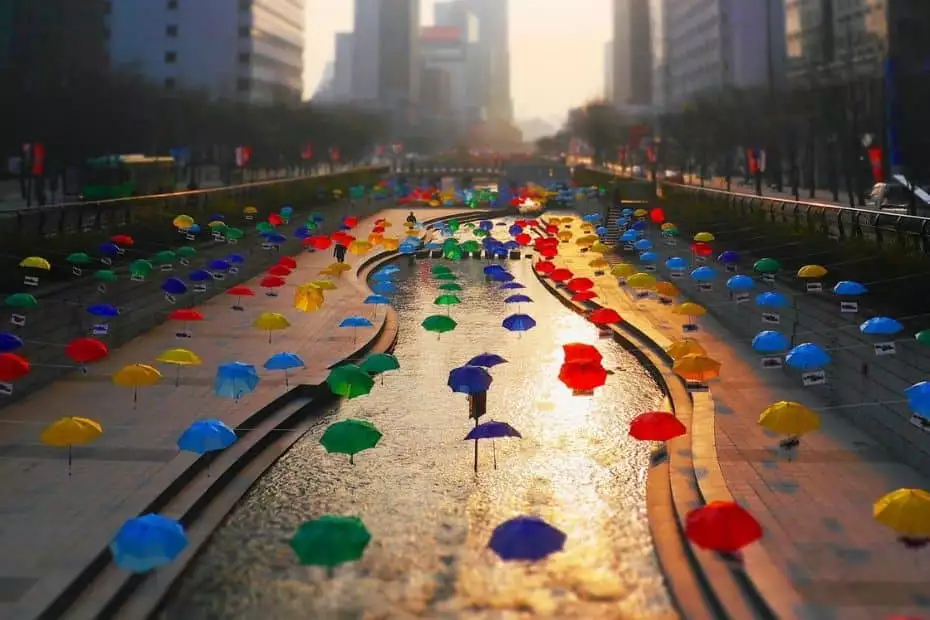
This South Korea travel guide covers all the essential information you need to plan a trip to Korea. This is useful for first-time travellers to Korea who might not be aware of uniquely Korean cultural and travel issues. Even if you’ve visited Korea before, I’m sure you can learn a lot from this travel guide.
This article contains lots of insights and knowledge about travelling to Korea and is quite long. I’ve added links in each section to articles that provide more information about each topic. Therefore, I suggest viewing this South Korea travel guide on a desktop computer as it will be easier to read.
What Are You Looking For?
To help make it easier for you to find what you’re looking for, I’ve broken this article into the following sections. Click the quick links below to jump straight there or keep reading through all parts.

Latest Travel News
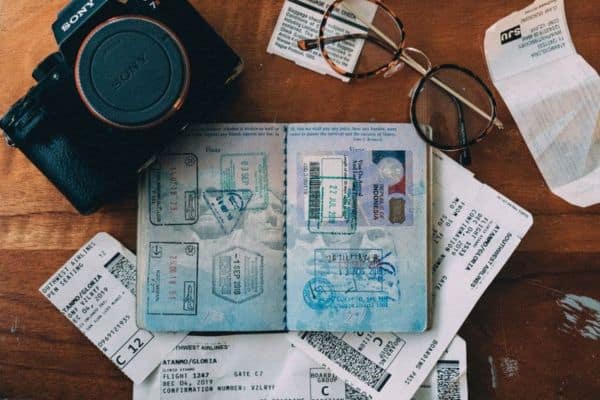
Entry Requirements
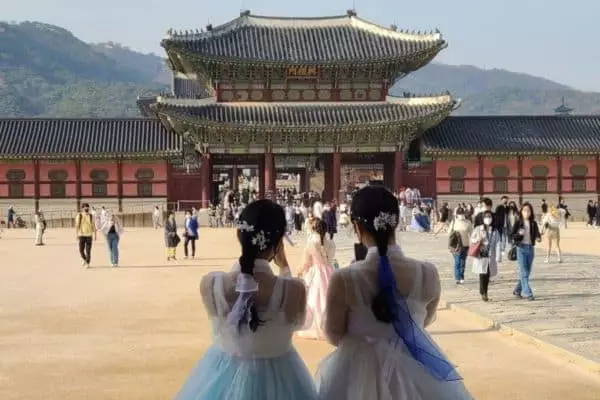
Why Visit Korea
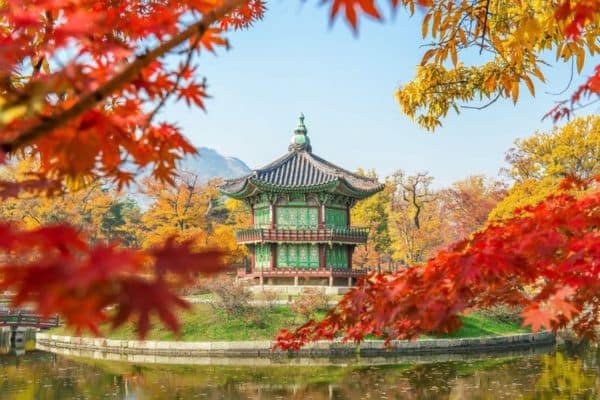
When To Visit
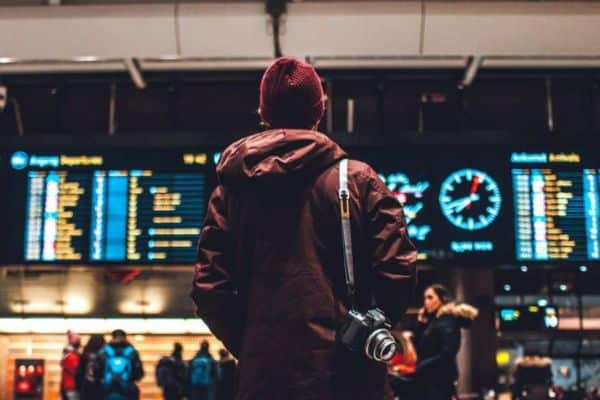
Flights To Korea
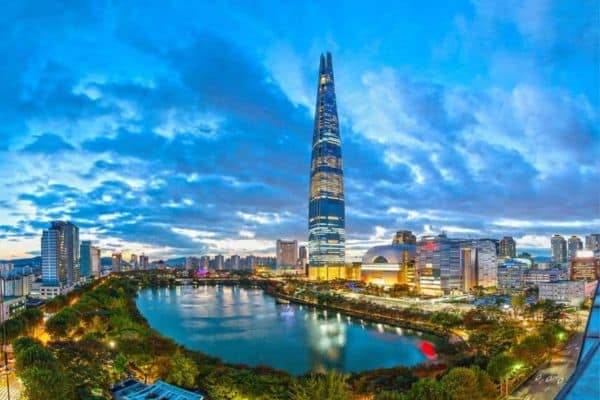
Where To Stay

Korea Travel Costs
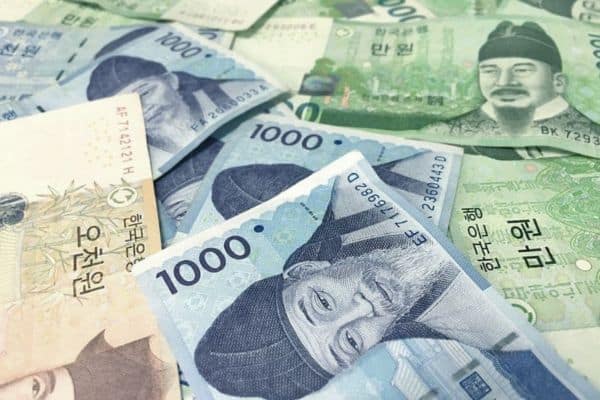
Travel Money
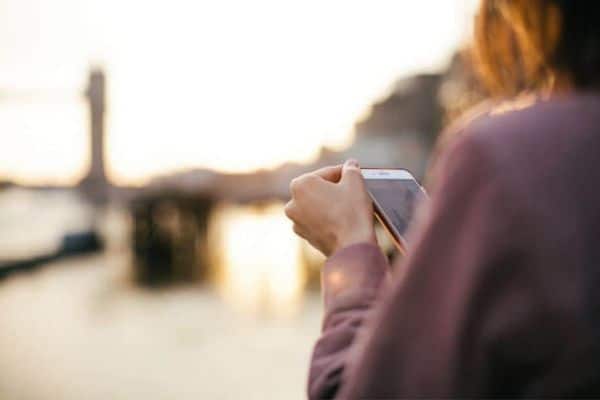
Phones & Internet
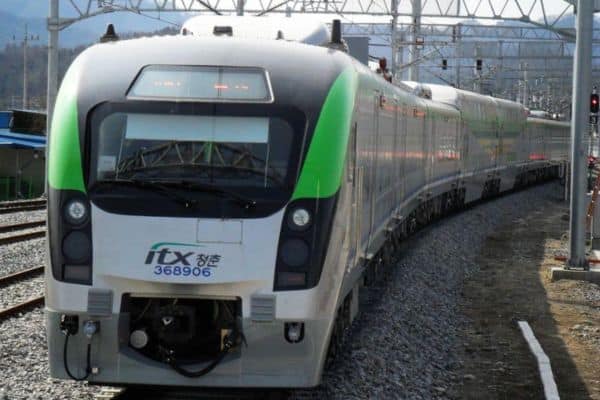
Public Transport
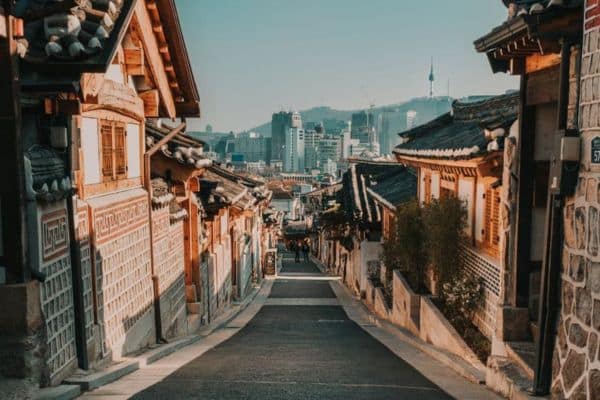
Where To Visit
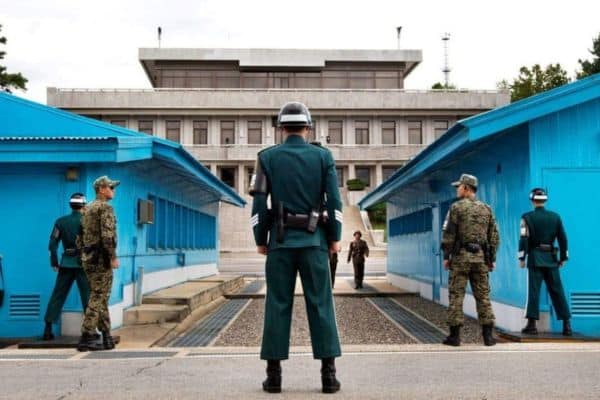
Seoul Day Tours
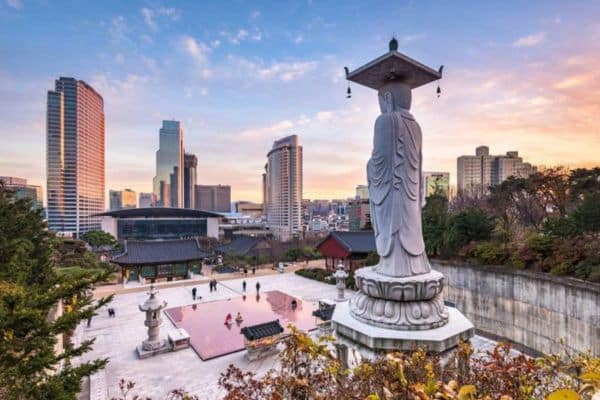
Sightseeing Spots
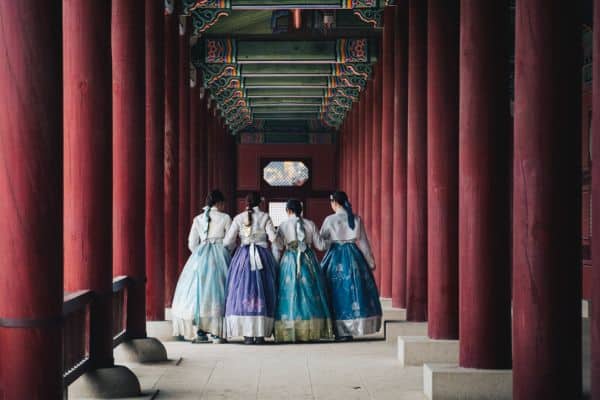
Korean Activities
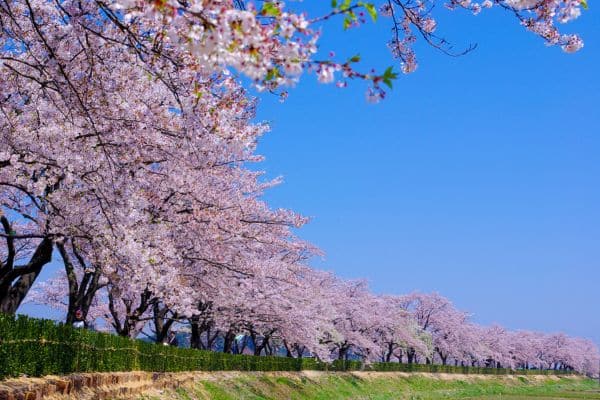
Korean Festivals
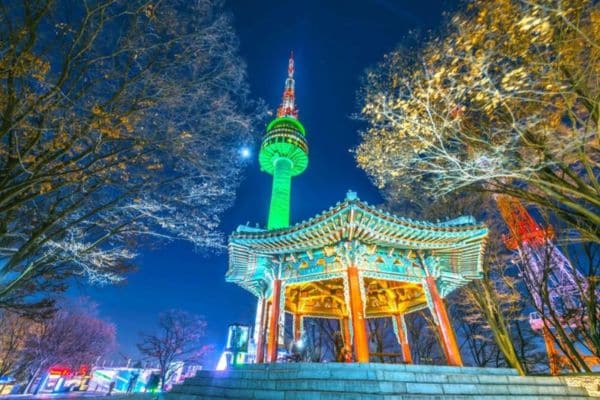
1-Week Itinerary
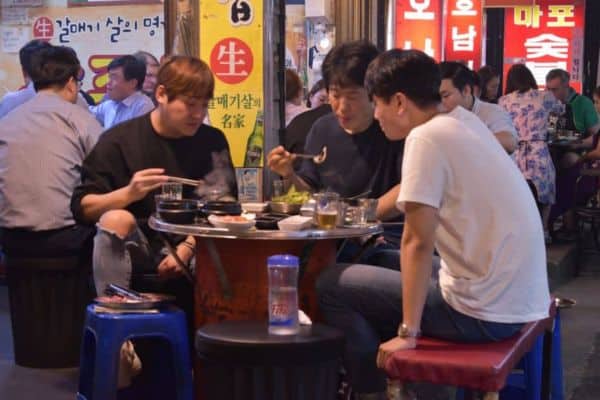
Culture Issues
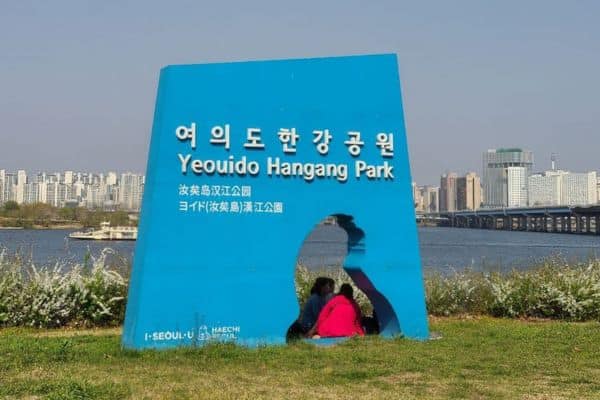
Language Issues
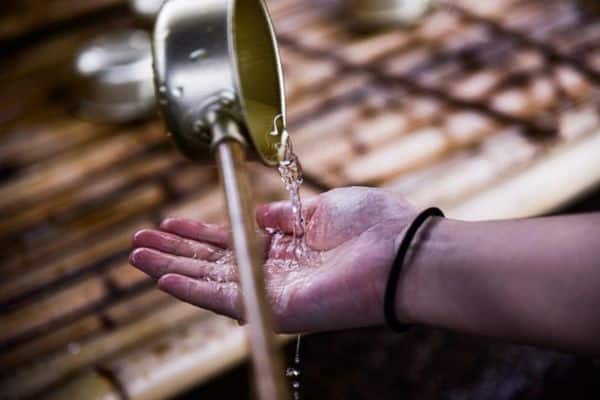
Health & Safety
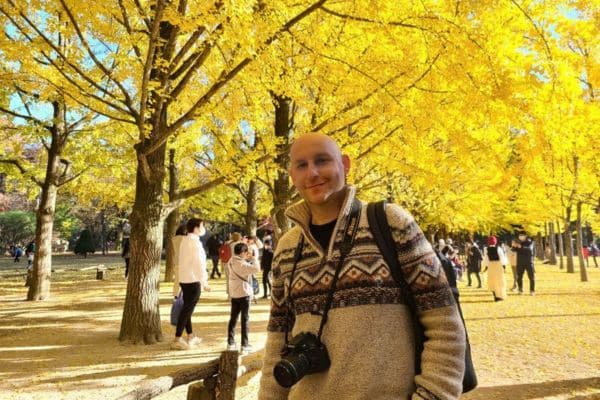
Korean Travel Tips
Korean Travel News And Travel Restrictions 2024
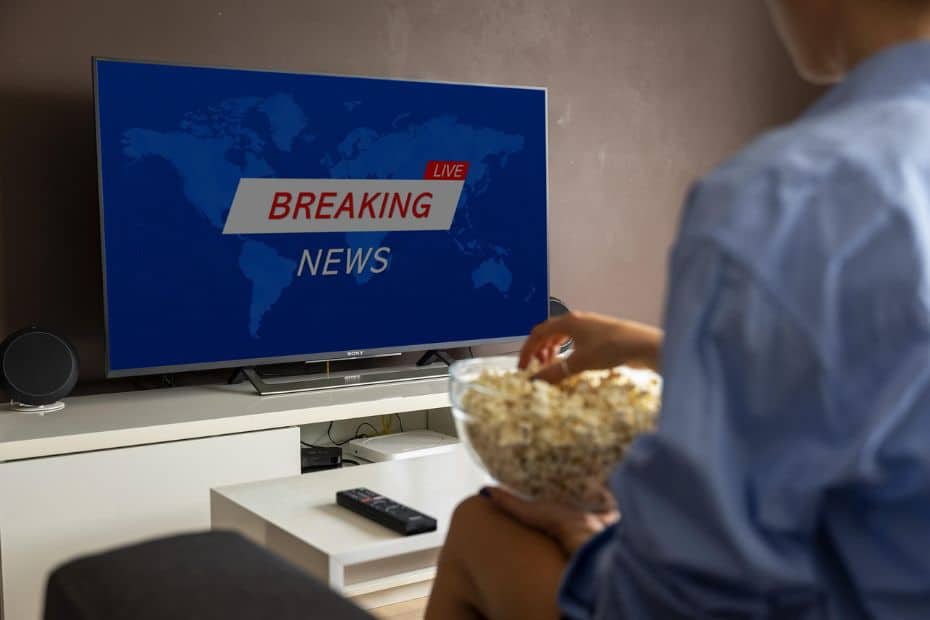
This section of the South Korea travel guide will show you the latest travel news and restriction updates, including any temporary or permanent changes to the entry process, visa changes, and other things that might affect travel to Korea. COVID-related updates will also be posted here.
Latest Korean Travel News In 2024
This section will detail any interesting or important travel news that could affect travellers to Korea, such as price increases in public transport, travel changes, new services, or closures.
The Korean government is aiming to boost tourism to Korea by doubling the amount travellers can claim back in tax when shopping in Korea. From 2024, travellers will be able to claim up to 5,000,000 KRW on eligible purchases with a limit of 1,000,000 KRW tax back per transaction. Source : Korea Herald
From August 2023, the price to travel on buses in Seoul is set to rise. Bus fares will rise to 1,500 KRW per journey. From October 7th, 2023, Seoul’s subway fares will rise to 1,400 KRW per journey. Other cities in Korea will enact similar rises throughout 2023 to cover higher costs of public transportation. Source : Korea Herald
From July 15th, 2023, the requirement to register your health condition through the Q-Code portal will be scrapped. Source : Korea Times
From July 3rd, 2023, children aged 17 years and younger, as well as adults aged 65 and older, will no longer need to apply for a K-ETA to travel to Korea. Furthermore, the validity period has been increased from 2 years to 3 years to make travelling to Korea easier. Source: K-ETA website .
From June 2023, Korea will end almost all pandemic-related restrictions for tourists and locals. Masks will no longer be necessary except in hospitals and infected people no longer face mandatory self-isolation (although the government still recommends 5 days self-isolation). Q-Code requirements haven’t been mentioned, however. Source : Korea Herald .
From April 2023 until December 2024, travellers from 22 countries won’t have to complete a K-ETA when visiting Korea, saving time and money for citizens of those countries. People from other countries still need a K-ETA. Source : K-ETA
The 22 countries temporarily excluded from the K-ETA requirement are Australia, Austria, Belgium, Canada, Denmark, Finland, France, Germany, Hong Kong, Italy, Japan, Macao, Netherlands, New Zealand, Norway, Poland, Singapore, Spain, Sweden, Taiwan, UK, US (including Guam).
From April 2023, all foreigners under 19 years old (18 and under) can now enter major royal palaces and tombs, including Seoul’s Gyeongbokgung Palace, for free. Previously, all foreigners were made to pay a fee to enter. Source : Korea Herald
From March 2023, a quarter of all buses in Seoul will refuse cash payments and allow only card payments using transportation cards, such as the T-Money card. Seoul’s night buses won’t be included for now, and 262 of Seoul’s 370 bus routes will still accept cash. Expect further increases in cash-free buses in the future. Source : Korea Herald
From February 2023, the base fare for a taxi journey in Korea has increased by 1,000 won to a minimum of 4,800 won. The distance that the base fare applies has also been shortened from 2km to 1.6km, which will make fares more expensive. Source : Korea Times
What Are the Current COVID Restrictions In Korea In 2024?
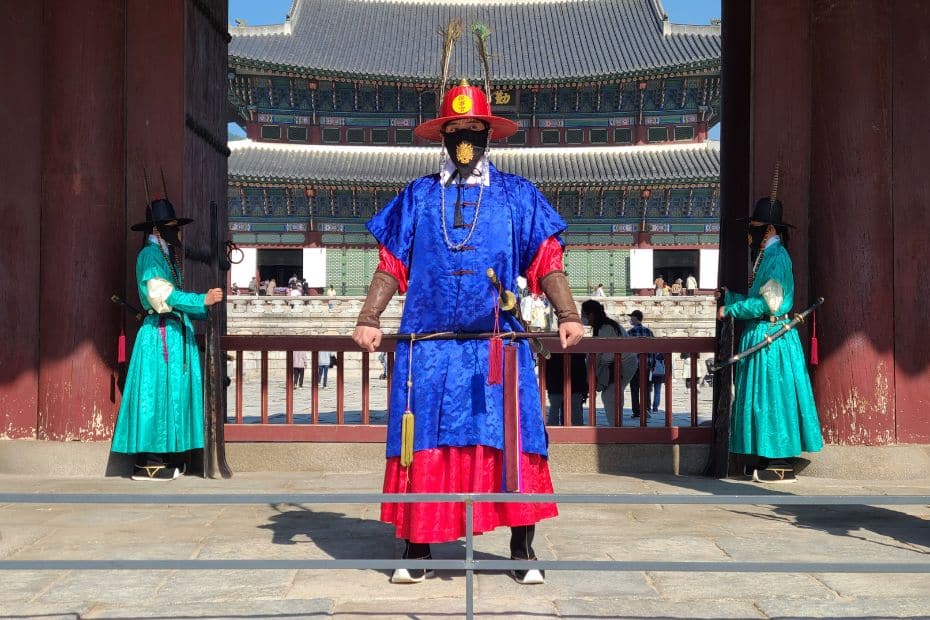
Korea has been removing COVID-related restrictions in the country throughout 2022 and 2023. It is no longer necessary to show a QR code to enter a building and restrictions involving masks and health checks have mostly gone. The latest COVID-related rules for Korea are as follows .
Masks : From Monday, March 20th, Korea has removed the mandatory mask rule for public transport, one of the final places that masks were required for the general public. The only places that require a face mask (from June 1st) are in medical facilities (hospitals). Masks are not mandatory elsewhere, including in schools, shops, restaurants or anywhere outside. Source : Korea Herald
Self-Quarantine : From June 1st, Korea will no longer impose a mandatory self-isolation period on infected people. The government instead ‘recommends’ a period of self-isolation for 5 days to reduce the chance of transmission to other people. Source : Korea Herald
For further details about the latest COVID requirements for entering or travelling in Korea, check out the second section of this South Korea travel guide, which has a list of all the updated entry requirements, including visas, tests, and other considerations.
Planning to visit Korea? These travel essentials will help you plan your trip, get the best deals, and save you time and money before and during your Korean adventure.
Visas & K-ETA: Some travellers to Korea need a Tourist Visa , but most can travel with a Korean Electronic Travel Authorisation (K-ETA). Currently 22 Countries don’t need either one.
How To Stay Connected : Pre-order a Korean Sim Card or a WiFi Router to collect on-arrival at Incheon Airport (desks open 24-hours). Alternatively, download a Korean eSIM for you travels.
Where To Stay : For Seoul, I recommend Myeongdong (convenient), Hongdae (cool culture) or Gangnam (shopping). For Busan, Haeundae (Beach) or Seomyeon (Downtown).
Incheon Airport To Seoul : Take the Airport Express (AREX) to Seoul Station or a Limo Bus across Seoul. Book an Incheon Airport Private Transfer and relax to or from the airport.
Korean Tour Operators : Tour companies that have a big presence in Korea include Klook , Trazy , Viator , and Get Your Guide . These sites offer discounted entry tickets for top attractions
Seoul City Passes : Visit Seoul’s top attractions for free with a Discover Seoul Pass or Go City Seoul Pass . These passes are great for families and couples visiting Seoul – you can save lots.
How To Get Around : For public transport, grab a T-Money Card . Save money on Korea’s high speed trains with a Korea Rail Pass . To see more of Korea, there are many Rental Car Options .
Travel Money : Use money exchanges near Myeongdong and Hongdae subway stations for the best exchange rates. Order a Wise Card or WOWPASS to pay by card across Korea.
Flights To Korea : I use flight comparison sites such as Expedia and Skyscanner to find the best flights to Korea from any country. Air Asia is a good option for budget flights from Asia.
How To Learn Korean : The language course from 90 Day Korean or Korean Class 101 both have well-structured lessons and lots of useful resources to help you learn Korean.
Current Requirements To Travel To Korea In 2024
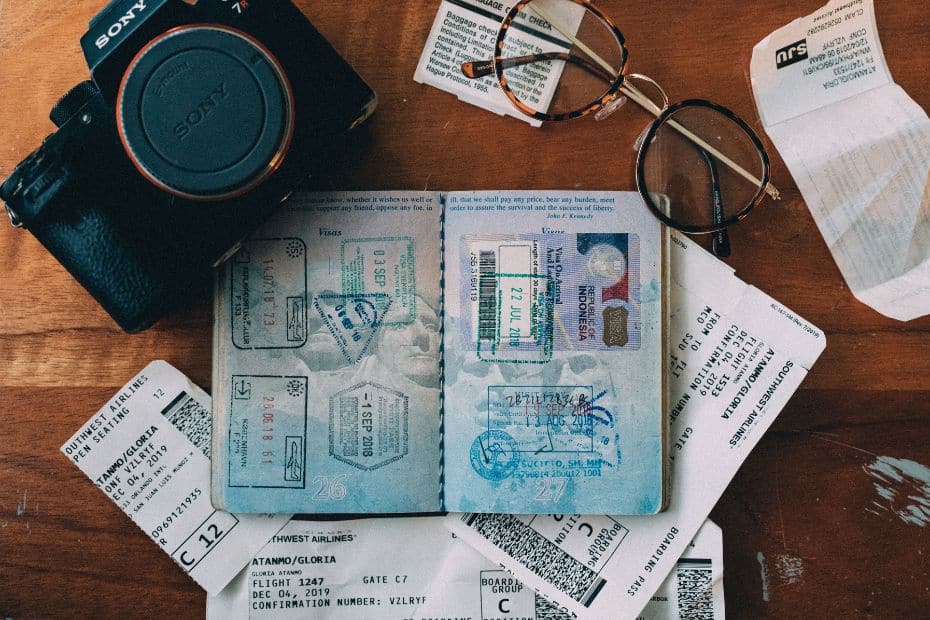
This part of the South Korea travel guide is for tourists . If you plan to travel for business, employment, or other reasons, check your nearest Korean embassy for the latest travel requirements.
Most of the restrictions and requirements for travelling to Korea have now been scrapped. You can see what entry and travel rules are in place for Korea in the table below:
The following section provides more information and exceptions about these requirements:
COVID-positive travellers should avoid travelling to Korea : To avoid infecting others on the way to Korea, as well as in Korea, the Korean government recommends that you shouldn’t travel to Korea if you exhibit COVID-symptoms or have tested positive. Self-quarantine is mandatory in Korea.
There are no PCR or other testing requirements : It is not necessary to take a PCR or other test before travelling to Korea. However, you will be asked to take a test if you show symptoms of COVID or similar illnesses when travelling to or arriving in Korea.
There is no quarantine on arrival : Travellers to Korea no longer need to quarantine when entering Korea. From June 1st, there is only a ‘recommended’ 5 day self-isolation period for infected travellers, but this is not enforced.
Complete the self-health check before or on arrival : From July 15th, 2023, travellers to Korea no longer need to complete a Q-Code self-health check or declare their health status on arrival.
Apply for a K-ETA or tourist visa before travelling : You need to apply for either a K-ETA or tourist visa for South Korea before flying to the country. Entry will be prohibited without the correct one. From April 1st, 2023 until December 31st, 2024, 22 countries are excluded from the K-ETA.
If you’re not sure which of these you need to apply for, more information is provided in the next section of this South Korea travel guide about the K-ETA and tourist visa for Korea.
K-ETA (Korean Electronic Travel Authorisation)
The K-ETA (Korean Electronic Travel Authorisation) is an online travel authorisation that visa-free foreign visitors aged 18 to 65 must obtain before entering the Korea for tourism, visiting relatives, participating in events or meetings, and for business purposes other than profitable activities.
Tourists from 112 eligible countries need to apply for a K-ETA before travelling to Korea and won’t be allowed to board a flight to Korea without it. The approval process isn’t difficult, but requires accommodation details, travel dates, and personal details such as passport number, etc.
From April 1st, 2023 until December 31st, 2024, the Korean government has decided to suspend the K-ETA requirement for travellers from the following 22 countries:
Australia, Austria, Belgium, Canada, Denmark, Finland, France, Germany, Hong Kong, Italy, Japan, Macao, Netherlands, New Zealand, Norway, Poland, Singapore, Spain, Sweden, Taiwan, UK, US (including Guam).
The aim is to reduce the burden of travellers coming to Korea and to encourage more people to visit Korea during the ‘Visit Korea Year’, which runs during 2023 and 2024.
Source : K-ETA website news .
From July 3rd, 2023, the Korean government will no longer ask for travellers who are 17 years and younger, or 65 years and older, to apply for a K-ETA when visiting Korea. These are ages based on the time you travel to Korea, not the age when you apply to travel.
Furthermore, the validity period of the K-ETA is now 3 years, not 2 years. The Korean government has decided to extend the validity period to make it easier for people to travel to Korea.
The K-ETA is based on your nationality , not the country you’re travelling from. That means, if you require a tourist visa from your home country (e.g. the Philippines), but are travelling from a country that requires a K-ETA (e.g. the USA), you can’t use the K-ETA to travel to Korea.
Tourists should apply as far in advance as possible at the official K-ETA website. If you would like to know more about the K-ETA, check out my article explaining what is the K-ETA . The K-ETA costs 10,000 KRW (about $9.00 USD). If you are charged more than this, you’re on the wrong site.
Official K-ETA website
Not sure if you need a K-ETA? Check out this infographic to find out.
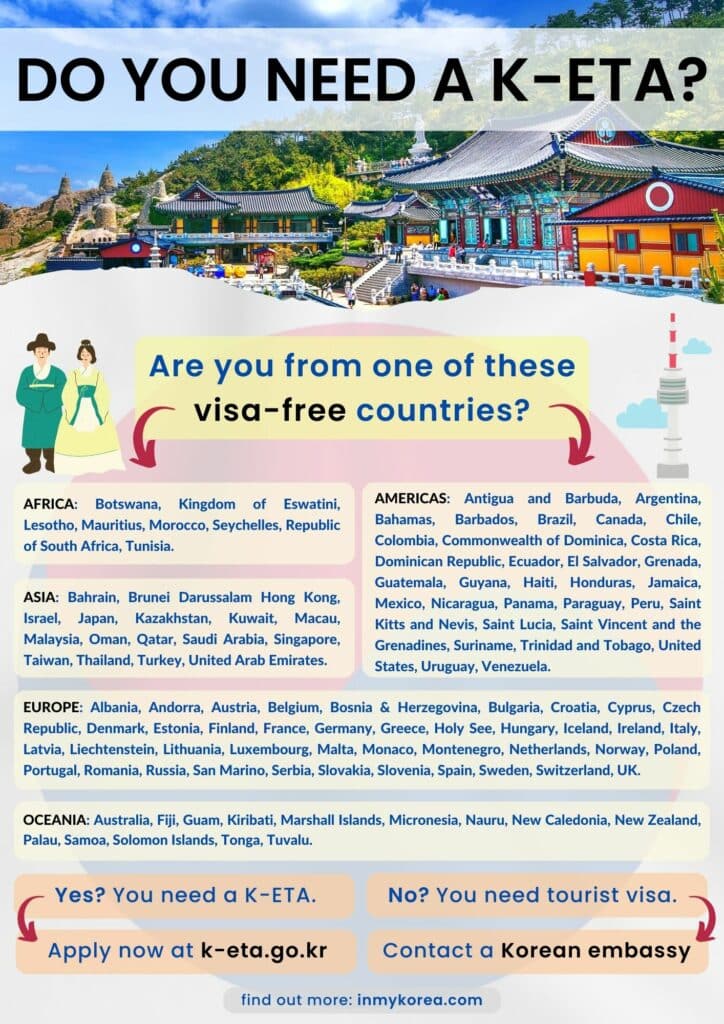
Will The K-ETA End In The Future?
The K-ETA will continue for the indefinite future. It is not a pandemic-related travel restriction but a permanent feature that just happened to start in 2021. The Korean government have stated that the K-ETA will be ongoing and other countries and areas, such as the EU, are planning similar ETAs.
Update : In July 2023, the Korean government stopped requiring children 17 years and younger and adults 65 years and older to apply for a K-ETA. The validity period was also increased to 3 years.
Update : In April 2023, the Korean government suspended the K-ETA for travellers from 22 countries (listed previously). This is in an effort to reduce the burden on travellers visiting Korea during the ‘Visit Korea Years’ of 2023 and 2024. This lasts until December 2024, but could possibly go on longer.
Tourist Visas For South Korea
Tourists that aren’t from one of the 112 countries that require a K-ETA to travel to Korea will need to apply for a tourist visa. This includes nationals from countries such India, Indonesia, Pakistan, and the Philippines. Tourist visas are based on nationality (passport), not country of residence.
The process to apply for a tourist visa differs depending on the country and may be as simple as submitting an application at the Korean embassy in the country you live in. For other countries, it may be necessary to submit extra information like bank statements and a full itinerary.
If you need a tourist visa for South Korea, contact your nearest Korean embassy as soon as you can to start the process. Tourist visas may be rejected, delayed, or take longer than expected. For some countries, such as the Philippines, it is necessary to apply through a specialist visa agency.
Transit Tour Visas For South Korea

Visa-free entry for foreign transit passengers at Incheon Airport will resume from May 2023 after being suspended for 3 years during the pandemic. There are two types of visa-free transit entry methods for travellers to Korea, they differ in length, requirements, and eligibility.
The first type of visa-free entry for transit passengers is open to all travellers to Korea and allows entry for 3 days, as long as they take a transit tour from Incheon Airport. The second type of visa-free entry for transit passengers is available for 30 days, but only from travellers from 36 select countries.
Visa-Free Entry For Transit Passengers (3 Days)
From May 15, 2023, travellers from any country can travel from Incheon Airport to the Seoul Metropolitan area for up to 3 days, as long as they book at least 1 transit tour from Incheon Airport. If Korea is not their final destination, they’re free to explore more of Seoul after the tour.
There are a wide range of transit tours available from Incheon Airport, including cultural, historic, food, shopping, and entertainment tours. See the sights of Seoul’s most popular places in a few hours, or stay for longer and see more. You can find out more about transit tours from the Visit Korea website .
Requirements : To be eligible for a transit tour visa, travellers must:
- Have an onward flight to their home country or a 3rd country after Korea.
- Participate in a transit tour program by a designated travel agency.
- Stay within the Seoul Metropolitan area only.
- Have more than 2 hours between connecting flights.
Eligible countries : Visa-free entry with a transit tour is open to passengers of all countries, as long as they meet the above requirements.
Tip : If you have a transit tour in Korea, I recommend staying in Hongdae , as there is a direct train from Incheon Airport to Hongdae called the All-Stop Airport Line. Hongdae is also a really fun place where you can see lots of culture, try Korean dishes, and pack your suitcase with Korean souvenirs.
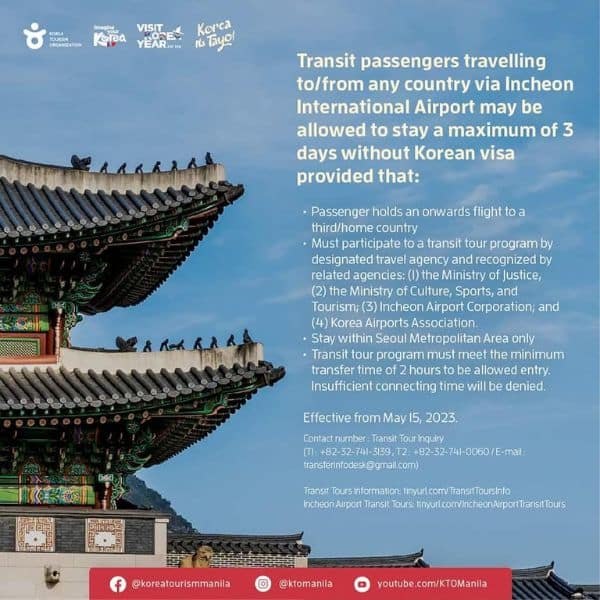
Visa-Free Entry For Transit Passengers (30 Days)
This will allow travellers from 36 countries to enter and stay in Korea for up to 30 days without a Korean visa. Travellers must be travelling to or from one of these 36 countries to be eligible to stay in Korea without a visa. This includes passengers who are not citizens of those countries.
Requirements : To be eligible for a visa-free entry as a transit passenger, travellers must:
- Hold an onward flight to any of the 36 countries mentioned below.
- Have no illegal stay records of any kind, nor have been denied entry to Korea.
- Not have exceeded a maximum of 3 days stay in any other transit airport.
Eligible countries : Travellers from the USA, Canada, Australia, New Zealand, and 32 EU countries (see picture below) can stay for up to 30 days, as long as the above-mentioned requirements are met.
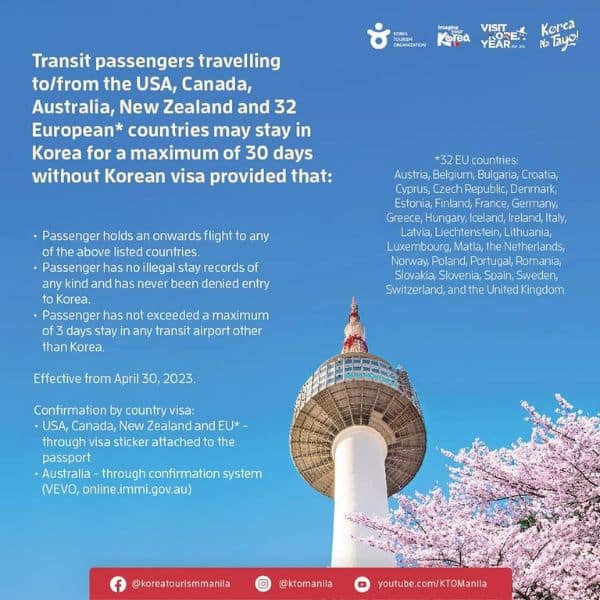
Why You Should Travel To Korea In 2024
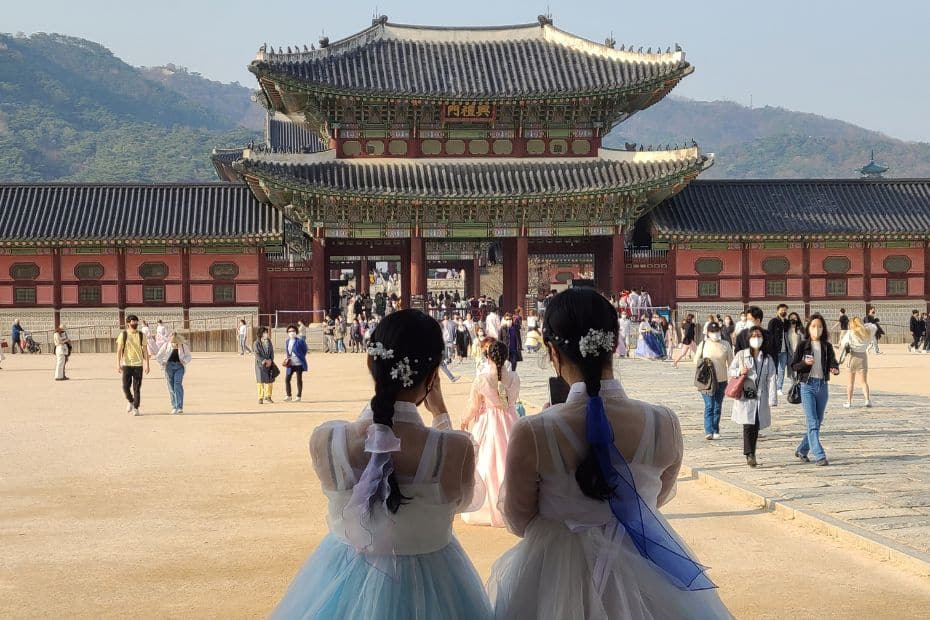
There’s not enough space in this South Korea travel guide to write down all of the reasons why you should travel to South Korea. Korea is an under-appreciated gem that has so much to discover and experience that’s completely different from what you’ll find in other countries.
Much the way that Japan has a very distinct culture and history, Korea has lots of unique, appealing places to see, people to meet, history to learn about, and natural sights to appreciate. Many people only see a small slice of Korean culture and beauty through modern media, but there’s a lot more.
Here are some of the reasons you should travel to Korea:
- Delicious foods and tasty seasonal dishes.
- Four distinct seasons that offer a variety of views.
- Fascinating history to learn about and explore.
- Stunning mountains and beaches for outdoor lovers.
- Unique and unusual festivals throughout the year.
- Friendly locals and a safe country to travel around.
- Modern, high-tech cities that are clean and efficient.
- Welcoming Buddhist temples and temple stays.
- Cheaper than most other developed countries.
- A shopper’s paradise with many markets and malls .
- Korea really wants you to come and visit.
Korea wants you to visit so much that they declared 2023-2024 the Visit Korea Year . This two-year period, confusingly referred to as a single year, is set to feature loads of events and activities to draw tourists to Korea, and includes promotions for discounted flights, accommodation, and food.
Some of the events you can expect to see during the Visit Korea Year(s) include K-Pop concerts, e-sports competitions, food festivals, and cultural celebrations. There’ll be K-Cultural stars involved, too, including your favourite K-Pop and K-Drama stars. Get ready to travel to Korea soon!
Want to know what you can do in Korea that you can’t do in other countries? Check out these amazing unique Korean experiences that should definitely be on your Korean bucket list.
The Best Time To Visit Korea
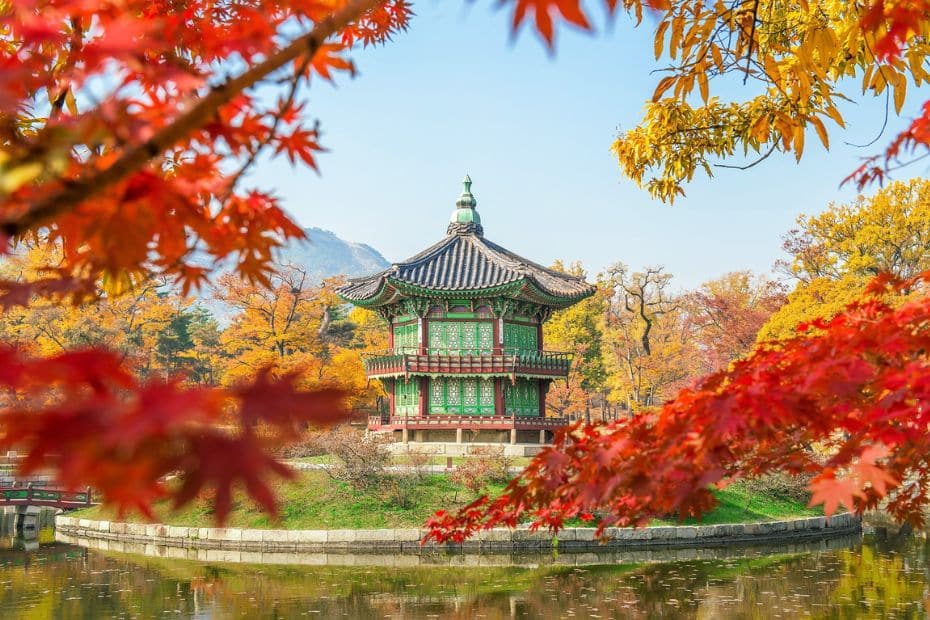
The best time to visit Korea is in spring (late-March to May) or autumn (mid-September until mid-November). These seasons have the most comfortable weather, ranging from 10 to 30 degrees Celsius, an average amount of rain, and also have the most festivals and events.
My favourite months to travel in Korea are April and October . Early-April is when cherry blossoms come out and the weather warms up enough to stop wearing a jacket. October in Korea is a beautiful month when autumn foliage sweeps across the country and the weather is warm and calm.
When you travel to Korea, the season you travel in can have a big impact on what you can see, eat, and do. This section of the South Korea travel guide is one of the most important and if you want to travel to Korea in the future, I recommend learning about Korea’s seasons before making plans.
What Can You See In Korea Each Season?
Although spring and autumn are undoubtedly the best time to visit Korea, there are plenty of reasons to visit in other seasons, too. Visitors to Korea who are restricted to travelling during certain times, such as during school or work holidays, needn’t be put off by travelling in summer or winter.
Here’s a summary of what you can see and do in each season in Korea:
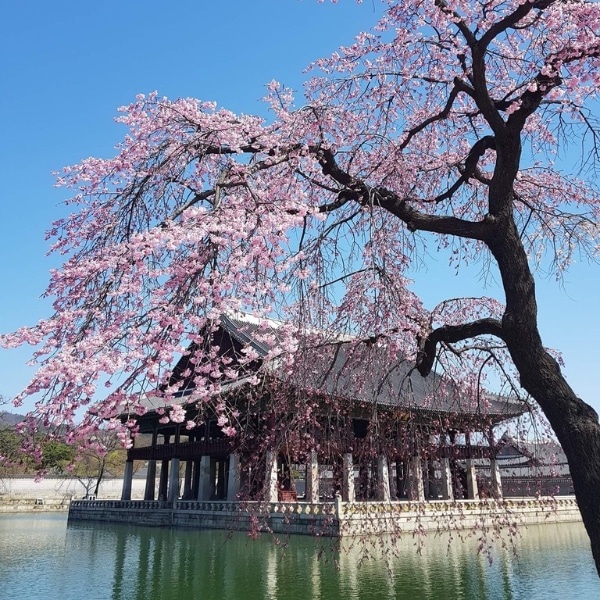
Spring: Cherry Blossoms, Blooming Nature, Culture Festivals
Spring is an amazing season to travel in Korea as you can see colourful plum blossoms (Mar), cherry blossoms (Mar-Apr), and many other bright sights. The warm weather allows people go out more to enjoy cultural activities and spring festivals , such as the Lotus Lantern Festival and Jindo Sea-Parting Festival, and also trekking, hiking, and cycling. Spring is one of the most popular times to travel in Korea for locals, so expect places to be busy, especially around cherry blossom season.
Check out my cherry blossom guide for the best places to see cherry blossoms in Korea.

Summer: Beaches, Korean Desserts, Water Sports, Camping
Summer is a difficult season for travellers due to the high humidity and heat. June and July are rainy season in Korea and it may rain for days on end, causing people to change travel plans to indoor activities. In late July and August it gets very hot, which is good for going to the beach and enjoying water sports or water parks, which Korea has many of. Evening activities like hiking, drinking in rooftop bars, and visiting night markets are great ways to get out in summer when it’s not as hot.
Check out my guide to Korean summer activities for the best places to have fun during summer and rainy day activities in Busan in case the weather isn’t so good.
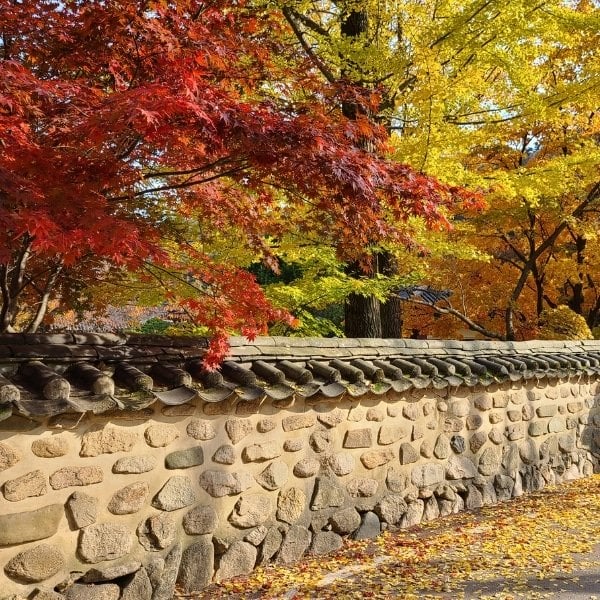
Autumn: Foliage, Festivals, Fresh Foods, Harvest Festivals
Autumn is another incredibly popular time to travel in Korea, especially in October when the autumn foliage is at its best. The foliage really brings everything to life, adding shades of colour to plain palace walls, mountains, and parks. The calm weather is warm with clear skies, making it perfect for going into nature to see the fresh fruits and other harvest goods, as well as join in harvest and cultural festivals. Enjoy local Korean dishes, fresh from the farm to your table.
Check out my guide to autumn foliage in Korea for the best places to see the leaves.
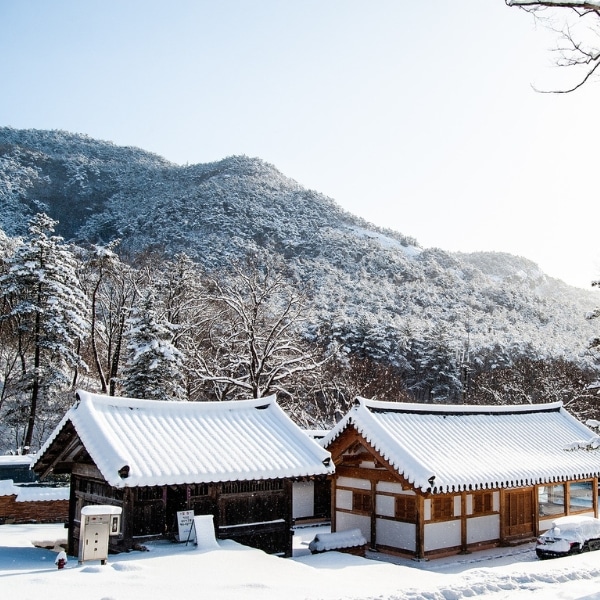
Winter: Snow, Winter Sports, Ice Fishing, Light Festivals
Winter in Korea is often neglected due to the cold weather, but is actually a very nice time to travel with delicious winter foods to try. It’s the driest time of year with blue skies making everything bright and beautiful. When it snows, sights look even more incredible. Jeju Island is a great place to visit during winter as it has fresh citrus and colourful camellia flowers to see. You can enjoy winter sports, festivals and activities, such as ice fishing, ice skating, sledding, and more.
Check out my guide to Korean winter activities for the best places to have fun during winter.
What Is The Weather Like In Korea?
The weather in Korea follows a similar pattern each year, spread over five distinct seasons. As well as spring, summer, autumn, and winter, Korea also has a rainy season, which starts around mid-June and finishes mid-July. It doesn’t constantly rain during rainy season, but may do for several days.
There’s always something to do in Korea, no matter what the season. Even rainy season in Korea is fine for travelling, as long as you plan lots of indoor activities and can be flexible with your schedule. Don’t let the weather in Korea put you off visiting, you’ll find plenty to do in each season.
Here’s a summary of the weather in Korea each season:
The graph below shows you the average temperature each month in Seoul. This is an average temperature, so some days will be much hotter and others much colder. I’ve experienced summer temperatures of over 35 degrees and winter nights of -20, so be prepared for both.
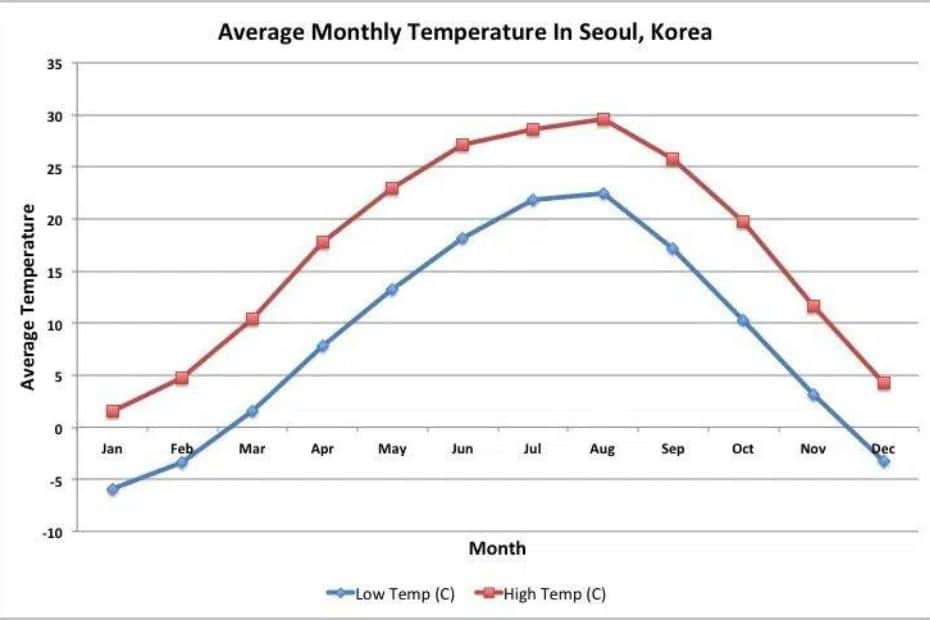
The table below shows the average rainfall for each month in Korea, based on records from climate-data.org . The summer months have the most, while winter in Korea is very dry. The rainfall in the winter months can turn to snow when it’s cold enough, too.
There will be more information about the sights, festivals, and events you can enjoy in Korea in later parts of this South Korea travel guide. Check them out for travel ideas for your trip to Korea.
How To Book Flights To Korea
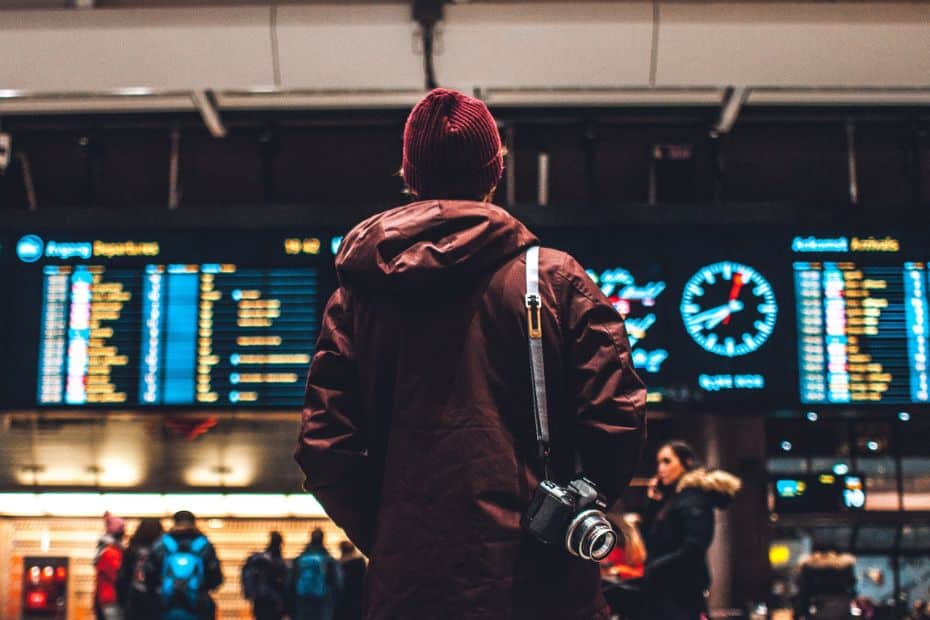
Flying to Korea in 2024 is getting easier with more airlines offering direct or connecting flights to Korea and budget airlines adding more routes to Korea from other parts of Asia and as far away as the USA. There aren’t as many routes as there were in 2019, but they are returning month by month.
Booking a flight to Korea is one of the first things most people do and finding the right flight can really affect your travels. Choosing the right flight not only affects how much money you need to spend, but also when you’ll arrive, how you’ll get to your hotel, and where you’ll arrive in Korea.
Check out my guide to booking flights to Korea to discover the best ways to book a flight to Korea, including the best time to book (21 to 127 days before travel), where to get cheap flights, the various airlines that offer flights to Korea, and lots more.
Arriving At Incheon Airport
Most flights to Korea arrive at Incheon Airport, which is near Seoul. It takes about an hour to get to the centre of Seoul from Incheon Airport and there are various transportation options including a high-speed train, subway, limo buses, taxis, and private transfers.
The best option for transferring from Incheon Airport to your hotel is usually a limo bus as these run to popular areas of Seoul, such as Myeongdong, Hongdae, Gangnam, and Insadong. There’s also a direct train to Seoul Station and a subway that goes to Seoul Station via Hongdae.
Arriving during the daytime gives you the best options for getting from Incheon Airport into Seoul, while nighttime flights will leave you fewer options. There are a few night buses that run, but late arrivals will either need to stay at the airport or book a private transfer or taxi instead. More details about taking a taxi from Incheon Airport can be found in my guide to taxis in Korea .
If you want to book a private transfer direct to your hotel from Incheon Airport, contact Jerry Heng , a freelance driver. I want to recommend Jerry as he has years of experience organising airport pick-ups and drop-offs, as well as personalised tours around Korea. He’s also a friendly guy.
Recommended Flight Comparison Sites
I suggest checking at least one flight comparison website before booking any flights. You can alter the arrival and departure times, flight duration, choose direct or indirect flights, and sort by price to find the perfect flight for you. Skyscanner is my preferred comparison site, but they’re all useful.
Take time to change the dates and flight times to find the most suitable flights for you. Cheaper flights often have inconvenient arrival times, so you should decide whether it’s worth the hassle to save a bit of money. Sometimes spending more for the right flight is worth it, especially when time is limited.
I try to go for a balance of convenience and savings and avoid flights that arrive late at night or leave too early in the morning. These flights require you to book an extra night at the airport or make you lose time when you could be travelling and doing more interesting things.
Here are 4 of the best flight comparison sites for booking flights to Korea:

Skyscanner is one of the most popular flight aggregators and offers flights, hotels, and other travel bookings for all major destinations. Skyscanner shows airline environmental ratings and which flights are practical or difficult.

Expedia is a large US travel company that offers tours, flights, hotels, and other services around the world. You can book hotel and flights together, to save you time and effort when travelling. A good place to start your flight search.
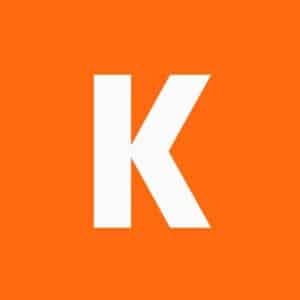
Kayak is great for people looking for cheap flights to Korea. You can see price trends for your flight to Korea to see when the best prices are available. There are also lots of budget travel options on the site that can save you more.

WayAway is a flight comparison site for the modern generation, with Instagram tips & travel advice as well as a good selection of cheap flights. You can get cashback on bookings with their premium service.
Where To Stay In Seoul
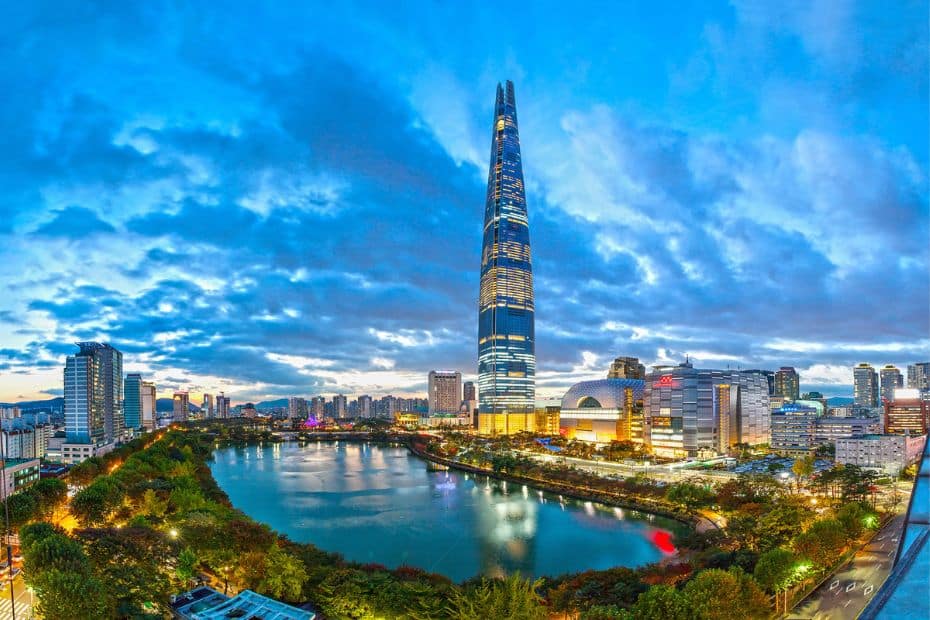
Incheon Airport is the main arrival destination for most travellers visiting Korea, with more than 71 million travellers passing through the airport in 2019, making it the world’s 14th busiest airport . It’s close to Seoul and has lots of transportation options to get into Korea’s capital.
Seoul is the first place people visit, not only because it’s close to Incheon Airport, but because it’s undeniably the heart and soul of Korea. The greater Seoul area includes about 50% of Korea’s population (25 million people) and is by far the biggest, most vibrant, and fun city in Korea.
To travel to Korea you need either a K-ETA or tourist visa . One of the requirements to apply for these is the address of the first place you’ll be staying in Korea. Therefore, you should book at least your first hotel in Korea so you can begin those applications. Seoul is an ideal first place to stay.
Best Neighbourhoods To Stay In Seoul
Deciding where to stay in Seoul can be difficult because there are so many unique neighbourhoods, each offering something interesting for travellers to experience. Knowing which has the best sights, entertainment, culture, shopping, transport, markets, restaurants, cafes, etc., is useful.
Seoul’s neighbourhoods typically contain a mixture of several of these elements and will appeal to different types of travellers. Below is a very rough guide for which neighbourhood each type of traveller might enjoy. Of course, there are plenty of other things to do in each area.
As you can see from the list above, both Hongdae and Myeongdong have a lot to offer and I would definitely recommend either of these neighbourhoods for first time travellers to Seoul. Even people who have travelled to Korea before will find lots of reasons to stay there. They’re where I usually stay.
I have detailed guides to hotels in the two best districts for staying in Seoul – Hongdae and Myeongdong. My guide to hotels in Hongdae includes a range of hotels for all types of travellers, while my guide to hotels in Myeongdong highlights Myeongdong’s best budget to mid-range hotels.
Each neighbourhood feels unique and offers something to discover, from traditional markets and eateries, modern Insta-worthy cafe districts, peaceful parks and lakes, world-class skyscrapers, and many fun activities. Wherever you choose to stay, you’re sure to find something you enjoy.
I’ve included the 8 best neighbourhoods in Seoul in this South Korea travel guide, along with a small summary about what you can expect in each area. These are the most popular areas for tourists to stay in, but certainly not the only places to stay. There are also links to hotels in these areas.
Here are the 8 best neighbourhoods in Seoul:
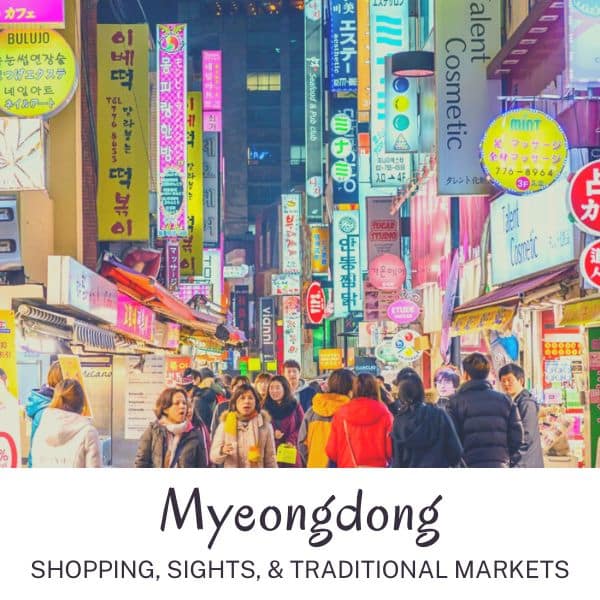
Myeongdong is arguably one of the best places to stay in Seoul for any traveller. It has the best range of budget and mid-range hotels in Seoul and is conveniently located for sights, activities, and public transport. It’s close to popular tourist sites, such as the N Seoul Tower and royal palaces. There are traditional markets and Myeongdong’s famous street food alley to check out. As Myeongdong is popular with tourists, you’ll find more people that can speak English and places to exchange money.
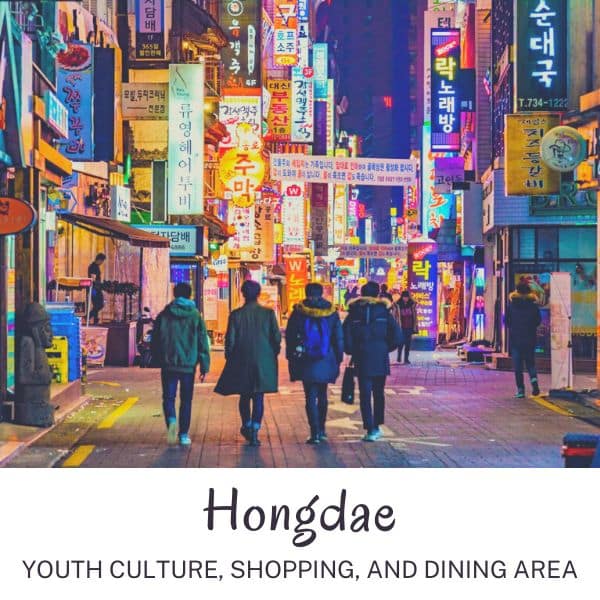
Hongdae is one of the coolest neighbourhoods in Seoul and a must-see for any traveller to the city. This area has emerged as a creative hotbed for the latest Korean fashion, art, food, and culture, thanks to innovations from students of nearby universities. Youth culture is on display in Hongdae’s main and side streets, with boutique shops, trendy bars and cafes, inventive restaurants, street art, and live performances. If you want to see a vibrant, colourful side of Seoul, then Hongdae is the place for you.
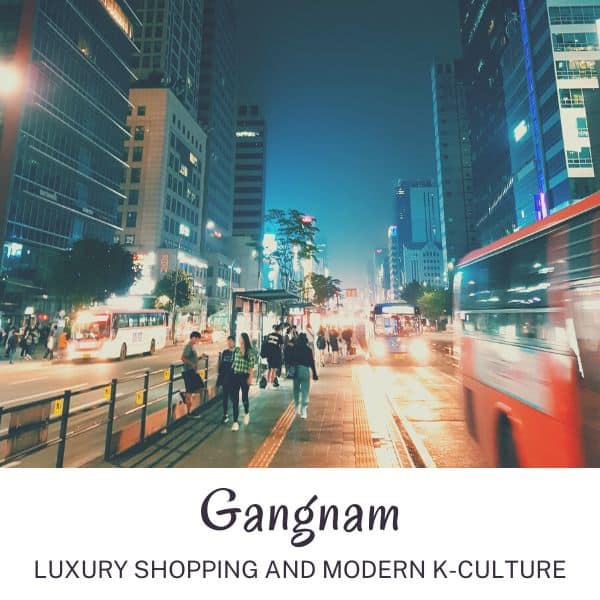
Gangnam is an upscale area of Seoul that’s home to some of Korea’s biggest stars. This area was where K-Pop was invented, as can be seen by the golden Gangnam Style statue outside COEX Mall. Gangnam is a lot more than that, and is a powerful business area with Seoul’s best shopping and dining experiences, as well as some of the city’s finest cafes and bars. Gangnam has a host of upmarket hotels that provide outstanding luxury, but also has a selection of budget and mid-range hotels making it accessible for all travellers.
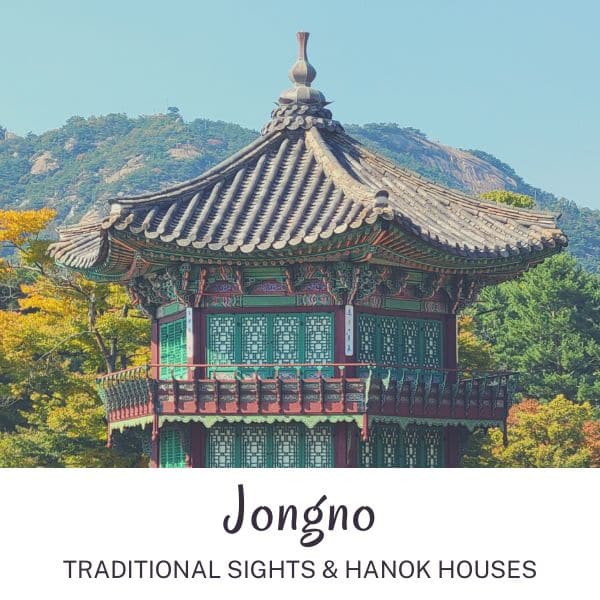
Jongno is the area north of Myeongdong that includes Insadong, Bukchon Hanok Village, Ikseongdong Hanok Village, Jogyesa Temple, 4 of Seoul’s royal palaces, the presidential Blue House, and lots more. This area is packed full of interesting sights and traditional restaurants and tea houses to explore. You can find a good range of hotels in Insadong, Seoul’s artistic area that is home to artists and tourist-friendly attractions. There are also guesthouses and apartments to rent in the residential areas of Jongno that offer a more homely stay.
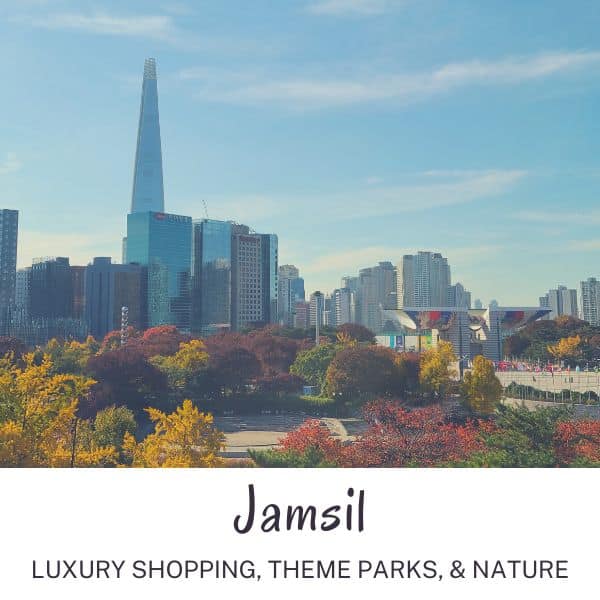
Jamsil is an upmarket residential neigbourhood close to Gangnam that’s home to one of Korea’s largest companies, Lotte. You’ll find the Lotte World Tower, Lotte World Theme Park, and Lotte Aquarium in this area, as well as the beautiful Seokchon Lake and leafy Olympic Park. Jamsil is a great base for people visiting for cherry blossoms in spring as the Seokchon Lake Cherry Blossom Festival is one of Seoul’s best. There are lots of trendy cafes and bars near the lake and it’s a relaxed part of the city to stay in.
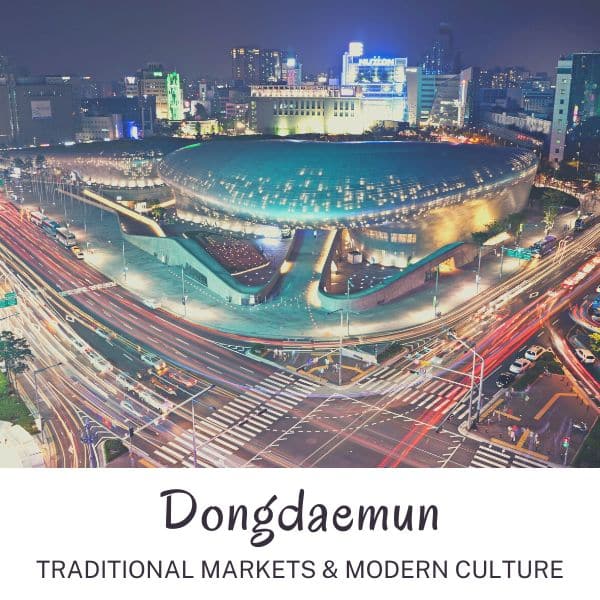
Dongdaemun is known for both its traditional markets, where you can buy a range of goods, as well as the futuristic Dongdaemun Design Plaza (DDP). The area is an unusual mix of traditional Seoul, with Gwangjang Market offering some of Seoul’s best Korean street food, and modern culture, displayed by the night markets and art installations at the DDP. There are lots of cheap eats and bargain markets and malls in this area, making it a great place to stay if you plan to do a lot of bargain shopping in Seoul.
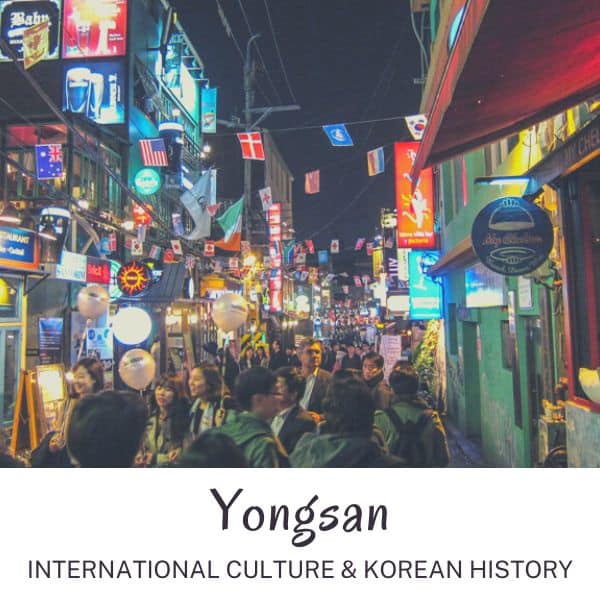
Yongsan is the area encompassing the N Seoul Tower, the popular international area of Itaewon, the trendy hilltop area of Haebangchon (HBC), Seoul Station, the National Museum of Seoul, and many riverside parks. Yongsan has a busy train station with towering skyscrapers and hotels around it catering to business and luxury travellers, as well as shoppers. This quiet business and residential area has good transport links and fewer crowds than other parts of Seoul, as well as interesting cultural attractions.
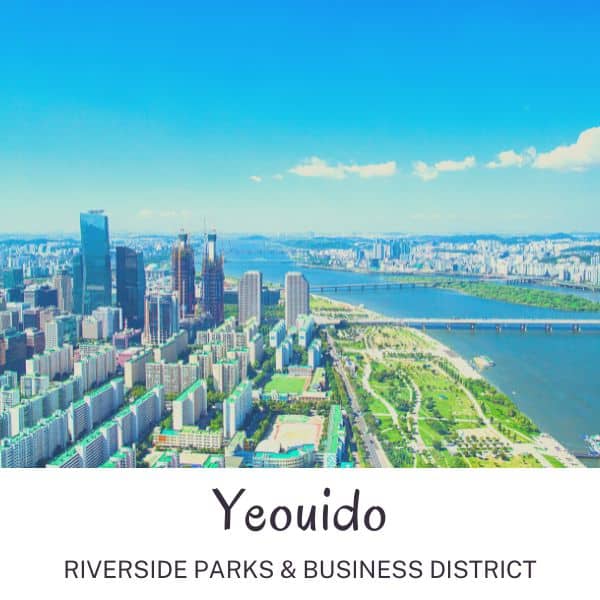
Yeouido is a large island that rests in the Han River, overlooking Hongdae and Yongsan. It has some of the best parks in Seoul and is a popular place for locals to walk along the river on weekends and at night. These parks are home to Seoul’s biggest cherry blossom festivals, as well as summer night markets, fireworks performances, live music, and people enjoying life outside of work. Yeouido is the upmarket financial centre of Seoul, making it an ideal base for business, luxury, and family travellers.
Seoul’s neighbourhoods are informal designations, not necessarily the official district name. For example, Hongdae is a neighbourhood in the Mapo-gu district and Myeongdong a neighbourhood in the Jung-gu district. Whereas Jongno is both the neighbourhood and district name (Jongno-gu).
You might see some areas referred to differently. However, the terms I’ve used in this section are the names most commonly used to describe these areas by tourists and expats. Koreans will certainly know which area of Seoul you’re talking about when you use these names.
Learn more : If you want to know more about Seoul’s best districts and figure out where the best place to stay for your trip to Korea, then check out my detailed guide about where to stay in Seoul . It’s packed with useful info about each neighbourhood, hotel recommendations for different budgets, and tips about booking accommodation in Seoul. Also learn more about the Han River Boat Service launching in 2024 to connect Yeoudio, Jamsil and other riverside destinations.
Hotel Recommendations For Seoul

There are hundreds (maybe thousands) of hotels in Seoul to choose from ranging from multi-person dorm rooms to the height of luxury looking down over Seoul from a 5-star hotel room in the Lotte World Tower . Whatever your budget or requirements, there’ll be somewhere to stay in Seoul for you.
To save you time searching for the best places to stay in Seoul, I’ve created a list of the 9 best luxury, mid-range, and budget hotels in Seoul, as well as 6 long-stay serviced apartments. This list has been created based on customer reviews, location, facilities, amenities, reputation, and quality.
I live outside of Seoul, so often book hotels when I’m visiting Seoul for the weekend . I’ve stayed at quite a few of these, so can personally recommend them based on my own experience. I’ve had both good and bad hotel experiences in Seoul and only want to recommend the best to you.
Recommended Luxury Hotels
Seoul has some incredible luxury hotels to enjoy, each with a true 5-star service, excellent amenities, and delectable restaurants. Many of Seoul’s best luxury hotels are located in Gangnam, Seoul’s wealthiest district, where you can find top restaurants and designer brand shopping.
Recommended Mid-Range Hotels
If you want to experience a luxurious stay in Seoul without breaking the bank, then these mid-range hotels will be perfect for you. These unique, 4-star hotels are reasonably priced and provide stylish, comfortable rooms that you’ll sleep easily in after a busy day exploring Seoul.
Recommended Budget Hotels
Seoul has a wide range of excellent budget hotels with prices that might surprise you for a large city. These are some of my favourite places to stay in Seoul when I visit for the weekend and are popular with travellers due to their convenient location, facilities, and comfortable beds.
Recommended Serviced Apartments
If you plan to stay in Seoul for a month or more, these serviced apartments will provide you all the comforts of home with the benefits of staying at a hotel. These excellent serviced apartments come with cleaning services, health facilities, cooking facilities, and are value for money.
Cost To Travel In South Korea In 2024
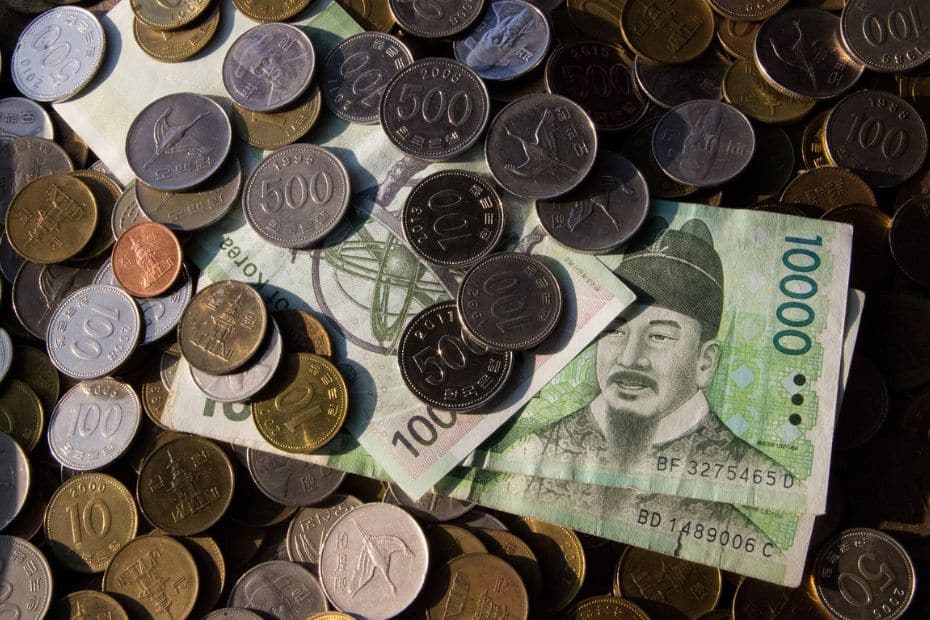
This part of the South Korea travel guide will help you understand some of your expected costs to travel to Korea. The costs to travel to Korea include flights, accommodation, food, drinks, transportation, activities, sim cards, visas, souvenirs, travel insurance, and lots more.
The costs you will pay when you travel vary massively depending on what type of traveller you are and what style of travel you can afford. If you want 5-star luxury and fine-dining, your budget will be very different from someone eating ramyeon from 7-11 and staying in a budget guesthouse.
Therefore, I will try to provide expected costs for 3 different types of traveller – budget , mid-range , and luxury . These aren’t exact figures, but should give you a rough idea of how much you’ll spend.
Daily Costs To Travel In Korea
There are costs that you will pay each day when travelling in Korea that can be averaged out to give you a daily cost. Knowing these figures will help you plan your budget for Korea and to see where you can afford to spend more for the one-off costs to travel, which will be covered next.
The daily costs are accommodation, food & drinks, transportation, attractions & tours, and miscellaneous expenses that can pop up unexpectedly. These miscellaneous costs might include getting a street food snack, an unexpected entrance fee, or a few extra drinks in the evening.
Transportation will be covered later in this South Korea travel guide and there are some useful tips to reduce your transportation costs. You will also be able to see some of the best attractions, tours, and activities in Korea and you’ll be able to work out how much you’ll spend on those.
Here are the daily costs per person to travel in Korea:
Please note : These are costs per day, per person . Couples and families sharing a room will have lower costs as double rooms aren’t much more expensive than single rooms. Some days will be cheaper, some much more expensive, especially if you take day trips or visit premium attractions.
There are also one-off costs not included in these daily costs. These can be pre-travel costs, such as flights and a K-ETA or tourist visa (already covered), travel insurance, vaccinations, and such like. Pre-travel costs are different for each traveller and depend on your country of residence.
Other one-off costs during travel in Korea may include day tours, souvenirs, shopping, celebrations, medical costs, and expenses that you don’t normally pay each day. Again, these vary for each traveller and are difficult to calculate as people’s budgets are so different.
Is Korea A Cheap Country To Travel In?
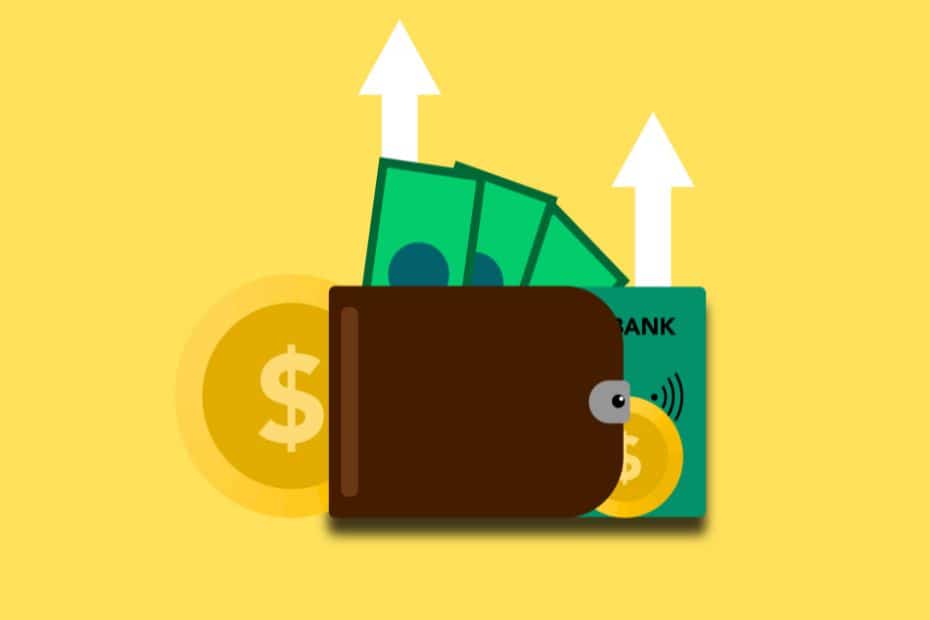
Korea is relatively cheap country to visit, but certainly isn’t always a budget destination. The cost to travel to Korea has risen over the last few years and might be more expensive than you think, even if you’ve previously visited Korea. Flying to Korea is certainly more expensive now.
Food costs rose by 7.5% in 2022 alone and these costs have been passed on to restaurants, which now charge higher prices for meals. Transportation costs rose by about 20% in 2023 for buses and subways, although these are still relatively cheap compared to some countries.
Despite these price increases, travelling in Korea is still cheaper than travelling in most other high-income industrialised countries such as Japan, the USA, and Western Europe. If you’re from countries such as the Philippines, Thailand, Indonesia, or Malaysia, Korea may seem expensive.
City Passes That Save You Money In Seoul
There are a number of city passes that can save you money when visiting Seoul by offering free or discounted entry to some of the best attractions in the city for a single price. The original city pass for Seoul is the Discover Seoul Pass, but now there is also the Go City Pass and Klook Pass Seoul.
Here’s a summary of each of these Seoul city passes:
Discover Seoul Pass : Available in 24 | 48 | 72 hour periods, allows entry to top attractions in Seoul such as Lotte World Adventure, N Seoul Tower, COEX Aquarium, Alive Museum, Zoolung Zoolung, Sealala Sauna, Gyeongbokgung Palace, and more. Prices start at 50,000 KRW .
Go City Seoul Pass : Available as 1 – 5 day passes or a flexible pass for up to 7 attractions. Covers a wider amount of attractions than the DSP, including a DMZ Tour, Nanta Cookin’ Musical, Seoul Land, Seoul Pub Crawl, Seoul Ghost Tour, and more. Prices start at 68,000 KRW .
Klook Pass Seoul : Available for use 2 – 5 attractions, including Everland or Lotte World Adventure theme parks. The Klook Pass Seoul allows free entry to selected attractions within a 30 day period. Attractions include the N Seoul Tower and Lotte World Aquarium. Prices start at 44,000 KRW .
If you’d like to know more about these passes, be sure to check out my article about the Klook Pass Seoul , as well as my suggested Discover Seoul Pass itineraries . I’ll have a review article of the Go City Seoul Pass soon, too.
How To Save Money In Korea
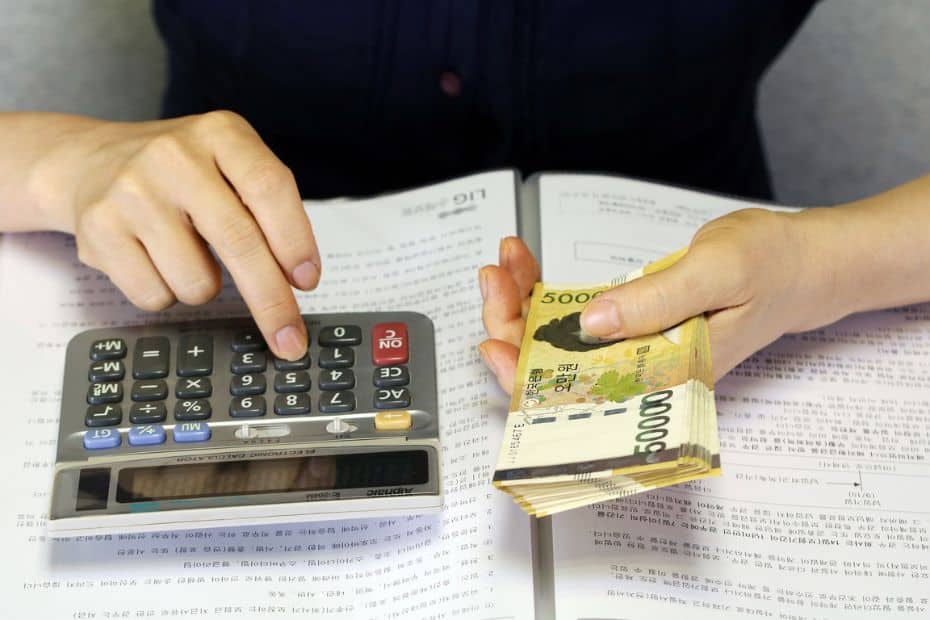
There are always ways to save money and spend less in Korea. Budget options exist for travellers and you can travel in Korea for less than 150,000 KRW per day, even as little as 50,000 KRW per day. Here are some of the ways you can save money in Korea and travel more for less:
Eat like a local : Visit the traditional markets, food stalls, and traditional Korean restaurants. These are much cheaper than eating foreign foods in Korea. University areas are usually cheap, too.
Spend less on coffee : Coffee in Korea can be expensive, but it doesn’t have to be. A latte could cost you 5,000 KRW in a chain store, but there are cheap hole-in-the-wall cafes where it’s half that.
Shop in the markets : From designer goods (possibly fake) to souvenirs, the markets of Seoul and other cities usually have the best prices. Don’t be afraid to haggle.
Use public transport : Korea has a fantastic public transport network both in cities and between cities. Don’t waste money on taxis and private transfers when you can use a bus or subway.
Book everything online : You can find discounted entry and tour tickets online that are much cheaper than the regular price. Use Klook , Get Your Guide , and Viator for the best prices.
Stay in guesthouses and hostels : You can find rooms for as little as 10,000 KRW per night in shared dorms and 20,000 KRW in guesthouses. Book ahead to find the best prices.
Take advantage of free things : There are lots of places you can visit for free in Seoul and free services, such as walking tours in Seoul, 30-minute hanbok rentals, and even free entry to the palaces.
Get your tax back : Korea makes it really easy to recover tax you’ve paid when shopping. Stores in Seoul will process tax returns for you or you can claim a refund at the airport when you leave.
You will see tips and links in this South Korea travel guide that are designed to help you save money when you visit Korea. Booking tours, attractions, and sim cards in advance can save you a lot of money, as can using a T-Money card and Wise travel card. Keep reading for more money-saving tips.
Travel Money And Money Exchanges In Korea
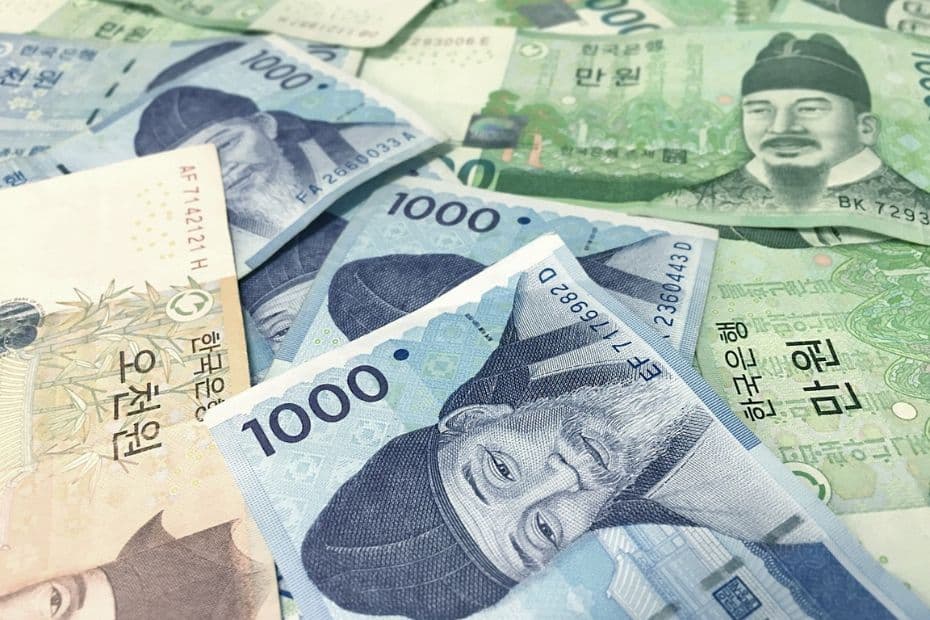
If you follow the tips in this section of this South Korea travel guide, you can certainly save yourself a lot of money and avoid unnecessary fees when spending in Korea. Learn where and how to exchange money, how to avoid ATM and card fees, and how to get tax back before you leave.
Because this section covers a lot of the common questions people ask about travel money in Korea, it will be broken down into a question and answer format. This should make it easier for you to find the information you’re looking for and discover answers you didn’t know you were looking for.
Can You Use A Foreign Card In Korea?
Almost all foreign credit cards with Visa or Mastercard will be accepted in Korea and it is possible to use these cards to pay across the country. American Express is also accepted in popular tourist areas, but not as widely as Visa or Mastercard and may have problems outside of big cities.
Foreign debit cards should work if they use Visa or Mastercard, but there may be restrictions in place with your bank when using them abroad. It is recommended that you call your bank to check before travelling. For both credit and debit cards, check your bank for any fees you’ll pay overseas.
Can You Withdraw Cash From An ATM In Korea?

You can withdraw cash from ATMs in Korea using a debit card, but not all ATMs will accept international cards. Look for a sign saying ‘Global ATM’ or ‘Foreign Currency ATM’ to withdraw cash in Korea with a debit card. You can also withdraw cash using a credit card, but it’s more expensive.
Whether you use a debit or credit card, an ATM is likely to charge a fee to withdraw money using a foreign card. Your bank or credit card company may also charge a fee or give a bad exchange rate. These costs can add up a lot if you withdraw regularly, so try to make fewer withdrawals.
Learn more : Should you use cash or card when you visit Korea? This article about the how to pay in Korea has lots of useful information about payment methods in Korea, including alternatives to the usual mix of cash and a credit card.
How Can You Save Money When Paying By Card In Korea?
Instead of using a foreign debit or credit card in Korea, which might have expensive fees or not work in places, here are two better options. The first is the WOWPASS travel card , which offers tourist-friendly card services in Korea. The other is to apply for a travel card that can be used globally.
Both the WOWPASS and the two other travel cards offer the ability to pay by card in Korea and to withdraw cash in Korean won. They also offer better exchange rates than you’ll find in airport or local money exchanges in Korea. They each have some unique features, which will be illustrated below.
Pay Like A Local With WOWPASS
The WOWPASS is a new way to pay in Korea that combines the essential functions of a T-Money transportation card with the benefits of a local debit card. This is a prepaid card you can top up at more than 90 locations in KRW or your own currency. Just look for the bright orange WOW machines.
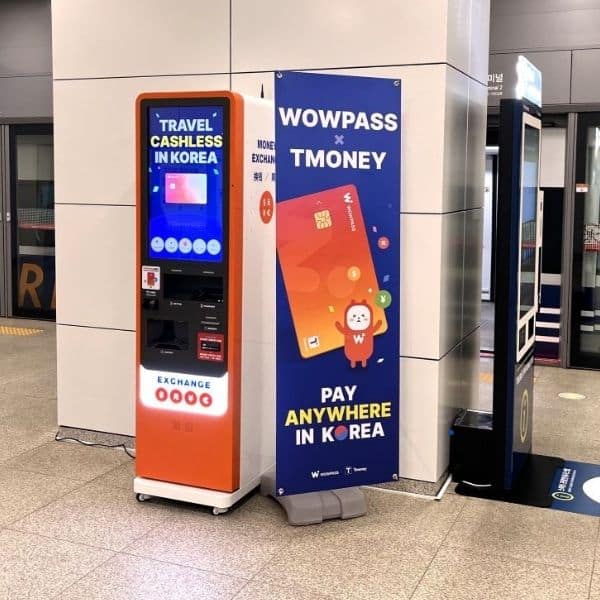
The T-Money function in the WOWPASS means it’s more useful than other travel cards as you don’t need to carry two separate cards when you travel. Please note, you still need to charge the T-Money balance of WOWPASS with cash, just like a regular T-Money card.
The WOWPASS travel card allows you to add up to 1,000,000 KRW to your card and can be used to pay for almost anything in Korea without any fees. The card is issued by a Korean company, so you can use it to withdraw cash at any WOWPASS machine located in Seoul & other cities in Korea.
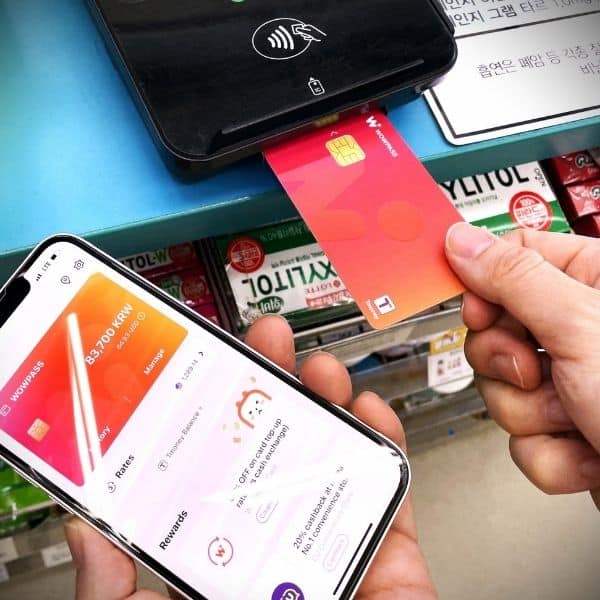
Thanks to the user-friendly WOWPASS app, users can freeze or replace their card, check their spending, add funds, and check exchange rates. Because the WOWPASS isn’t tied to your home bank account, it also reduces the damage by card fraud, in case the worst was to happen.
As well as a regular WOWPASS, you can also reserve the All-In-One Airport Package , which includes the WOWPASS, 10,000 KRW T-Money balance, and a discounted Korean sim card. This is really useful for those who want to get connected and travelling as soon as they arrive in Korea. Get the WOWPASS app for Android or Apple .
Tip : Use the invitation code INMYKOR1 to get cashback on WOWPASS top-ups in foreign currency.
Overseas Travel Cards You Can Use In Korea
Overseas travel cards are another option for spending in Korea and I use them myself to spend money from my UK bank account in Korea, as well as when travelling in other countries. They’re really simple to use and are much cheaper than paying with my foreign card or exchanging money.
Two of the leading travel card companies are Wise and Revolut . I use both of these to pay for things in Korea and have written an article about how to use the Wise card in Korea . You can use them to pay for hotels, food, drinks, transportation, taxis, attractions, and lots more. They’re really useful.
Here’s a summary of the main features of these travel cards:

The Wise travel card allows you to easily transfer and convert money from your home bank account into dozens of other currencies and use this money to pay when you’re travelling. You only need to transfer as much as you plan to spend and can easily transfer back anything you haven’t. The exchange rate will be better than your bank or a money exchange offers, too.
A versatile, easy to use app breaks down what you’ve spent by category so you can track your travel spending. You can withdraw cash from ATMs, pay by QR code, use it for Google Pay, and pay by contactless. Even if you lose your card, you can still spend money. It’s also really safe as you can freeze your card, set spending limits, and limit how much money you transfer.
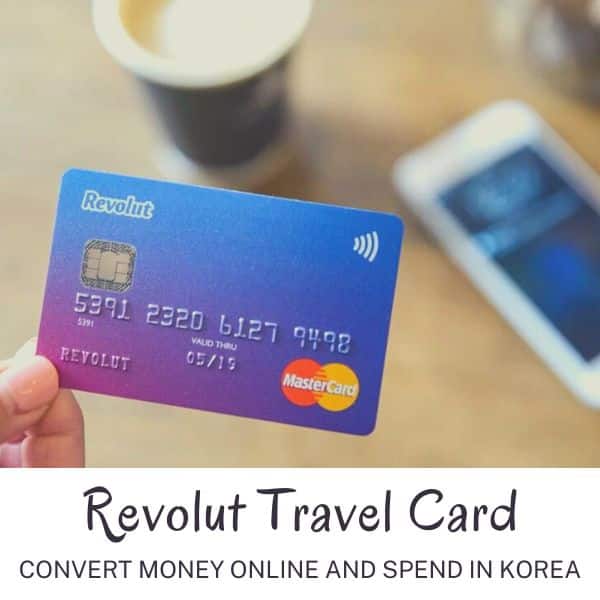
The Revolut travel card can be used in Korea to pay for a wide range of goods and services without expensive fees for spending your home currency overseas. Unlike the Wise travel card, which lets you transfer money into different currencies and then spend in a local currency, such as Korean won, the Revolut travel card lets you pay fee-free with your home currency.
The Revolut travel card comes with an easy to use app that can be used to manage your money both at home and when travelling in Korea. You can check your spending with categories and reports and set budgets for your spending. The Revolut travel card also offers cashback in the US, stock and crypto investments, and the same security features as the Wise travel card.
Can You Use Apple Pay In Korea?
Apple Pay wasn’t previously available in Korea due to a lack of approval by Korea’s financial regulator. However, in February 2023, Apple Pay received approval to begin operating in Korea through the Hyundai Card Co., allowing payments with Apple devices from March 2023 onwards.
The Apple Pay payment system has been available in Korea since March 21st , 2023 and allows Apple Pay members to pay for goods and services at NFC-enabled payment terminals. However, on the launch date of Apple Pay, there were only 70,000 NFC-enabled payment terminals in Korea.
The lack of NFC-enabled payment terminals will be a big issue for Apple Pay users in Korea as there are around 2,900,000 shops in Korea and most won’t accept Apple Pay. Franchises like Starbucks can’t accept Apple Pay and it can’t be used to pay for public transport. You’ll need a T-Money card.
Samsung Pay, which uses MST technology, not NFC, currently dominates the Korean market. NFC-enabled terminals should grow, especially in tourist areas and city-centres from 2023 onwards. This will be good news for Google Pay, which also uses NFC technology and also isn’t in use in Korea yet.
Should You Exchange Money Before Travelling To Korea?
It is not necessary to exchange money into Korean won before travelling to Korea, but it can certainly be useful to have a small amount of money. Exchange rates for Korean won outside Korea may not be as good as within Korea and changing large amounts of cash before you travel isn’t essential.
It might be hard to get Korean won from your local bank or money exchange as it’s not one of the most commonly exchanged currencies. Therefore, you might find exchange rates less favourable and extra fees applied to exchange money. Using travel cards like Wise or Revolut is a better option.
Should You Change Money At Incheon Airport?
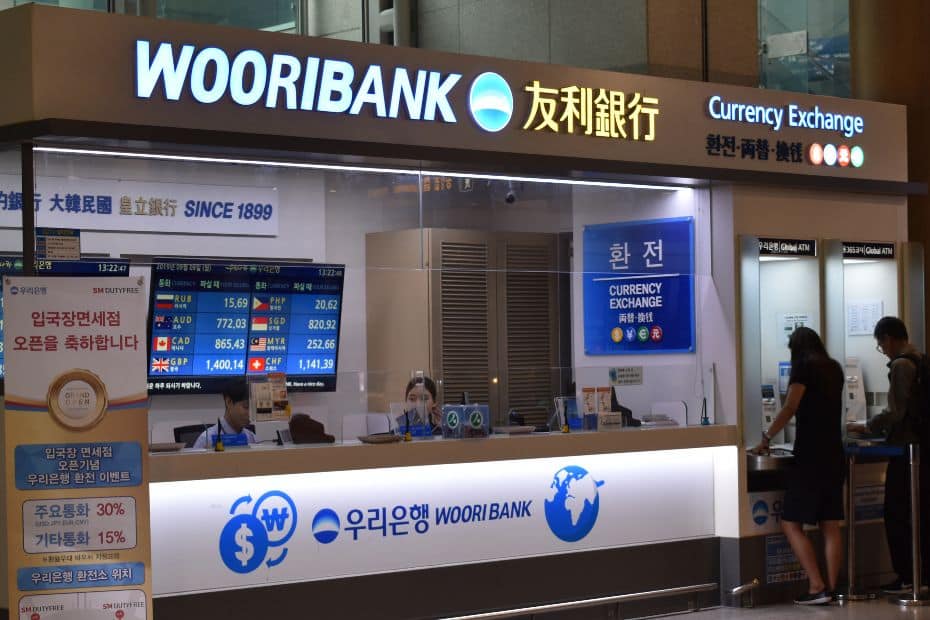
I’ve travelled around the world and always avoid exchanging money at the airport if I can help it. Airports often have the worst rates for money exchange as they know people need to get local cash, there aren’t many other options, and you need at least a bit of money to travel to your hotel.
Incheon Airport is an exception to this rule and I’ve compared travel exchange rates at several times when flying into and out of the airport. The foreign currency exchange rates at Incheon Airport aren’t that bad and are just slightly higher than what you’d find in Seoul. Not the best, but not bad.
There are also Global ATMs at Incheon Airport, so you can withdraw cash here. If you have a Wise or Revolut travel card, you can withdraw up to $200 fee-free from an ATM in Korea. However, Korean banks will charge a withdrawal fee (about 3,000 KRW), which applies to any foreign card used.
Where Can You Exchange Money In Seoul?
Seoul is the first destination for most travellers to Korea and if you want to save money on exchange rate fees, I recommend exchanging money in the capital. There are two main options for exchanging money easily and quickly in Seoul – WOW money exchange machines and money exchanges.
Here’s a summary about the two main ways to exchange money in Seoul:
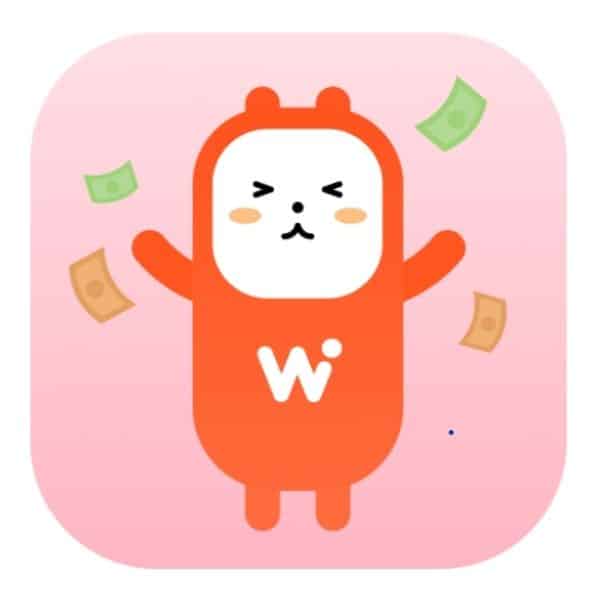
The cheapest and most convenient option for exchanging money in Seoul is through a WOW money exchange machine. This automated machine gives the best exchange rates and can quickly and easily exchange foreign cash for Korean won. It doesn’t accept card payments, only cash. All you need to do is scan your passport and deposit your cash and it will convert it into Korean won immediately. There are dozens of these machines in Seoul, as well as in other cities like Busan and Daejeon.
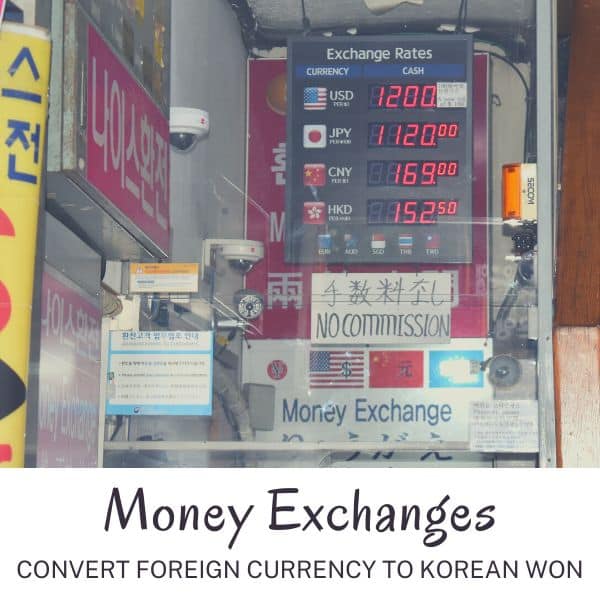
The traditional way to exchange foreign currency in Seoul was through a money exchange. You can find these in Myeongdong, where many tourists stay and visit in Seoul. There are also money exchanges inside banks and in other tourist hotspots. These used to be the best place to exchange money, until the WOW money exchanges were introduced and travel cards like Wise and Revolut made it easier to use a card. If you want to use a money exchange in Seoul, Myeongdong is the best place to do it.
Can You Get Tax Back When Shopping In Korea?
Travellers to Korea can claim tax back on eligible purchases during their trip. This can be done immediately after you purchase an item (if the shop offers the service) or at Incheon Airport or other airports in Korea before you depart.
Instant tax refunds are available at certain locations in Seoul and other big cities. These are usually department stores and large chain stores. You are able to claim tax refunds for goods up to a total value of 2,500,000 KRW (incl. tax). There is a tax refund limit of 500,000 KRW per transaction.
2024 Tax Refund Changes : From 2024, the tax refund limits will be doubled, so you will be able to claim up to 5,000,000 KRW of tax back and claim up to 1,000,000 KRW back per transaction. Source: Korea Herald .
To claim a tax refund you need:
- To show your passport
- To be a tourist in Korea
- To spend between 30,000 to 300,000 KRW in one place
- To be leaving Korea within 3 months
Tax isn’t refundable on all purchases, so be sure to check when shopping. Tax refunds can also be claimed at the airport as long as you have the receipt and the goods you’ve purchased.
Mobile Phones And Internet In Korea
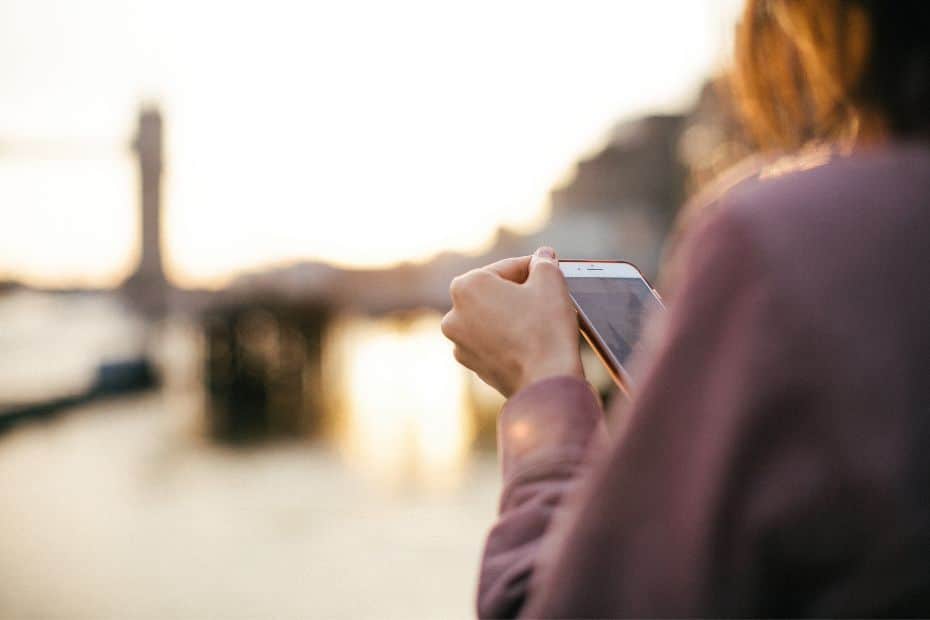
Staying connected to the Internet when visiting Korea is becoming more and more essential these days. Keeping your mobile phone, tablet, or computer connected to the web is useful not only to stay in touch with people back home, but also to help you save money and travel Korea more easily.
There are several options to stay connected in Korea when you travel. The main options for travellers are tourist SIM cards, either physical or eSIMs, portable WiFi routers, and relying on free WiFi provided in public places and hotels. All of these are good options, but there are other considerations, too.
This South Korea travel guide will cover the main differences between Korean SIM cards and portable WiFi routers and which will be most suitable for you. There are also details about why you might want a Korean phone number and which apps to use to help you travel in Korea.
Don’t forget, if you bring your phone or other mobile devices to Korea, you’ll need a travel adapter .
Should You Get A Korean SIM Card Or WiFi Router?
Both a Korean SIM card or portable WiFi router will provide access to Korea’s high-speed mobile networks and keep you connected to the Internet. They provide a secure internet connection, but do so in a different way and with different available features. Find out about the best Korean SIM card for tourists in this SK SIM card review .
Here are the main features of Korean SIM cards and WiFi routers:
Costs : SIM cards and WiFi routers are similarly priced when using them for a two week period, but they are charged in different ways. SIM cards are fixed-price and can be bought for set time periods, whereas WiFi routers are charged daily. WiFi routers are cheaper in the short-term.
Ease of use : If you purchase or pre-order a SIM card or portable WiFi router at Incheon Airport, which I highly recommend, the staff will install or setup everything for you. Once they’re activated, it’s very simple to use either one. Cancelling and returning them at the airport is also easy for both.
Here are the reasons you should get a Korean SIM card or portable WiFi router in Korea:
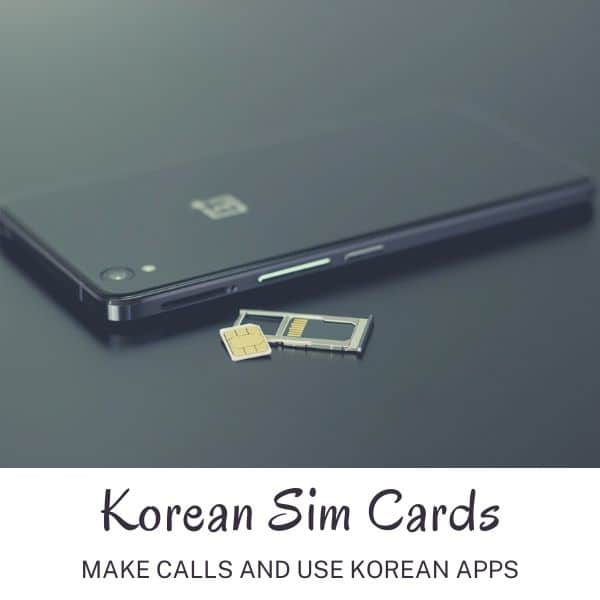
You should get a Korean SIM card when visiting Korea to get a Korean phone number. The benefits of having a Korean phone number are mainly to make calls and use Korean apps. SIM cards are also useful if you want a secure connection everywhere you go and plan to make calls or send texts. When you have a SIM card, you can tether your network connection to connect other devices you own. Korean phone coverage is amazing and you’ll get service everywhere. SIM cards don’t require you to carry any extra devices and are cheaper over the long-run than WiFi routers.
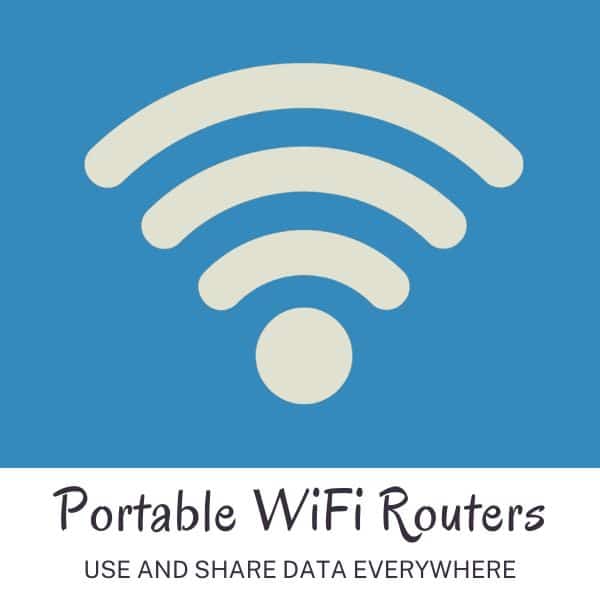
You should get a portable WiFi router if you’re travelling in a group or as a family as you can connect multiple devices to one router. This is much cheaper than getting separate SIM cards for all travellers, but also requires people stay close together. WiFi routers are charged per day and if you need additional days, they’ll be automatically added and charged when you return the router. This means you’ll never have to worry about your service suddenly ending. The main downside to using a WiFi router is the lack of Korean phone number, but that might not be an issue if you don’t need one.
Where Can You Get Korean SIM Cards Or WiFi Routers?

You can get a Korean SIM card or portable WiFi router in several ways. The easiest way, and one that I definitely recommend, is to purchase online through a tour company such as Klook , Viator , or Get Your Guide , and get a SIM card at Incheon Airport or other entry point into Korea when you arrive..
The main reason I recommend this method is that you can guarantee you will get a SIM card or router and it will be waiting for you when you arrive. The collection desks at Incheon Airport are open 24-hours a day and they will help you install everything you need to get started immediately.
You can also get SIM cards and WiFi routers when you arrive at the airport and you should find similar rates. However, you won’t be guaranteed a device and you will need to pay in person. When you book online, you can pay in your home currency and avoid those issues.
I don’t recommend getting a SIM card or WiFi router in Seoul or other cities. It is possible, but you may run into language issues and find less tourist-friendly options. Phone shops outside the airport usually cater to Koreans, not tourists. Airport rentals are the easiest options for visitors to Korea.
What’s The Benefit Of A Korean Phone Number For Tourists?
There are two main benefits of having a Korean phone number for tourists. The first benefit is the ability to call people when you’re in Korea. This can be useful for making reservations, keeping in touch with people, and in case of emergencies.
The second benefit of having a Korean phone number is the ability to use Korean apps . It isn’t mandatory to have a Korean phone number to use Korean apps, but most won’t let you use their services unless you sign up with a phone number. Using Korean apps makes travelling easier.
A phone number is like a form of identity in Korea, which is why you need your passport to register a SIM card. Once you have a phone number, many more services are available, including food delivery, ordering taxis, making reservations (such as for the Busan Sky Capsule ), and online messaging.
What Apps Do I Need For Travelling In Korea?
If you have a Korean phone number, you can use Korean apps. Even without a Korean number, you can still download these apps and use some of their services. Full features typically require a phone number though. There are other, non-Korean apps that will help you when travelling, too.
Here are the most useful apps to use when travelling in Korea:
Papago : This is the essential translation tool for visiting Korea. Papago’s translation services are the best and you can use the app to take pictures and translate Korean signs, menus, and other pictures.
Naver Maps : To find your way around Korea, use Naver Maps or Kakao Maps. Their systems are much more accurate in Korea than Google Maps. Use them to plan travel routes and transport times.
Kakao Taxi : Uber and Grab don’t really exist in Korea, so if you plan to take a taxi, you’ll need to use Kakao Taxi. Simple to use and takes the hassle out of trying to use Korean to give directions.
Kakao Talk : This is Korea’s most popular messaging app and is useful for keeping in touch with Korean friends, contacting businesses in Korea, and even calling abroad.
Seoul Subway : Use this app to travel around Seoul’s underground more easily. Plan your route, see when the next train is due to arrive, check connections, and see how late the trains run.
Korail Talk : This app allows you to book trains on Korea’s high-speed train network and regular train routes. This app has an English setting, so you can check train times and prices easily.
Coupang Eats : This is a food-delivery app that allows you to order almost anything edible and get it sent directly to you. You can even order convenience store goods. Useful for rainy days.
Mango Plate : Find restaurants in Korea with this app and discover the best places to go out and eat. You can also see restaurant details and get directions in Naver Maps and Kakao Maps.
WOWPASS : To use the WOWPASS to pay like a local in Korea and for T-Money functions, you’ll need the WOWPASS app. This will let you check your balances and spending and control your card.
Wise & Revolut : As mentioned in this South Korea travel guide, using a travel card to pay for items in Korea will save you money when you travel. If you use Wise or Revolut, make sure you have the app.
Klook : This company provides some of the best tours in Korea and if you make bookings through their website, you can easily manage them with the Klook app.
Intercity Bus by T-Money : This app is great for booking buses between cities in Korea. There is an English version that allows you to book tickets, check times, and see available seats.
These apps should be available on both Android and Apple. Some of these apps might default to Korean, but you should be able to change them to English in the side menu.
Is There Free WiFi In Korea?
Travellers in Korea have the option to not get a sim card or portable WiFi but still stay connected. This is thanks to the excellent Free Wifi in Korea that is provided in public transport, government buildings, restaurants, cafes, and many other places. This is mostly in the cities, however.
Hotels also provide free WiFi in most cities in Korea. If you plan to rely on free WiFi, I recommend using the hotel’s WiFi to plan routes, check opening times, and research places you want to visit. Take screenshots of these details so you can see them later, even if you don’t have Internet access.
The only warning I would give about relying on free WiFi when travelling in Korea is the increased use of mobile-dependent apps and passes in Korea. Physical tickets and passes are being phased out in favour of digital versions, which often need an active Internet connection to use.
I’ve noticed in recent years that services that impact travellers have moved to digital versions. This includes the T-Money card, Discover Seoul Pass, train and coach tickets, attraction tickets and event tickets. I believe that having a reliable net connection will be a must for most travellers soon.
Using Public Transport In Korea In 2024
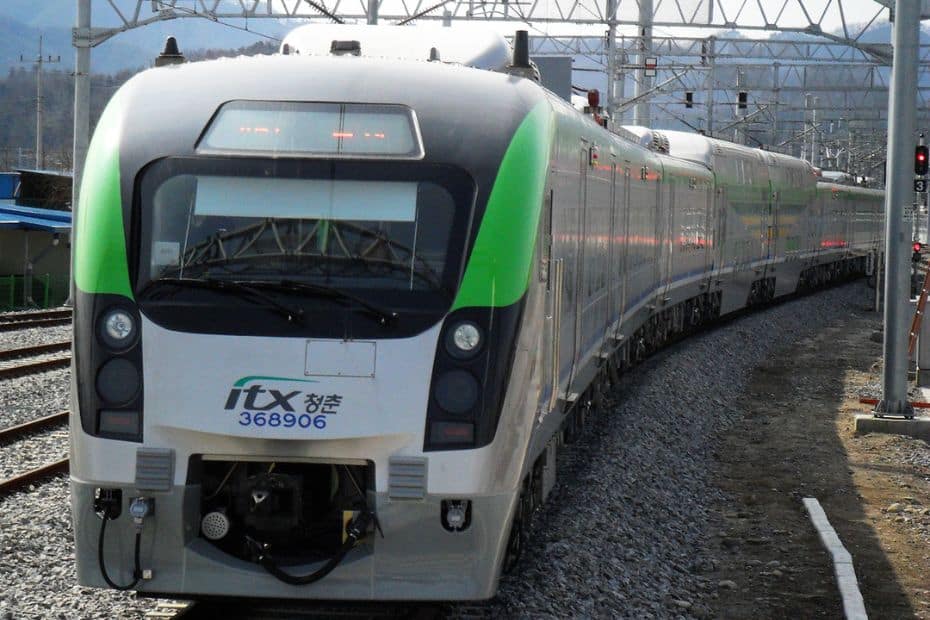
This section of the South Korea travel guide looks at Korea’s public transport system and how to navigate it as a traveller. Korea has arguably one of the best public transport systems in the world. It’s cheap, well-connected, frequent, and runs on time. Other countries could learn a lot from Korea.
The great news for tourists is that Korea’s public transport is very foreigner friendly and information is provided in English in almost all places, as well as Chinese and Japanese in popular areas such as Seoul and Busan. Travelling by public transport in Korea is cheap, easy, and convenient.
How Much Does Public Transport Cost In Korea?
The cost of public transportation in Korea is fixed, no matter what day you purchase tickets on. If you buy one month in advance, or last minute, you will pay the same price for the journey. Journeys within a city are a single price and not dependent on how far you travel, unless you leave the city limits.
All journeys are single fares and you can’t buy return tickets. You will need to buy two singles when you want to travel somewhere and back again. The cost of a single fare depends on how you pay for the ticket – by cash or with a transportation card.
Here are the costs for public transport in Korea by payment method, type and user:
Please note : The cost of subway rides is set to rise to 1,400 / 1,500 KRW in October 2023. These prices will be adjusted when this occurs.
How Do You Pay For Public Transport In Korea?
The cost of public transport in Korea depends on whether you pay with a transportation card, such as T-Money, a Korea Tour Card , or Cashbee, or in cash. This applies to both subways and buses. If you use a transportation card, you should add credit to it, then touch it to the card reader at the subway or bus to pay.
To use cash to buy a subway ticket, you will need to buy a ticket at the station. For buses, you should pay the correct fare to the driver when boarding the bus. However, since 2022, buses across Korea have started to end the use of cash and some will insist on payment by transportation card only.
In the future, bus payments are expected to become simpler with fares deducted via bluetooth-enabled phones that have the relevant app downloaded. This system has already been in place in Gyeonggi Province since March 2022 and is likely to spread to more bus routes in the future.
I highly recommend getting a T-Money card when you travel to Korea. You can use it to pay for public transportation (at a discounted rate), and it will work almost everywhere in Korea. It can also be used to buy goods from shops, cafes, and restaurants. It’s really convenient and a must-have for Korea.
Using T-Money To Pay For Public Transport In Korea
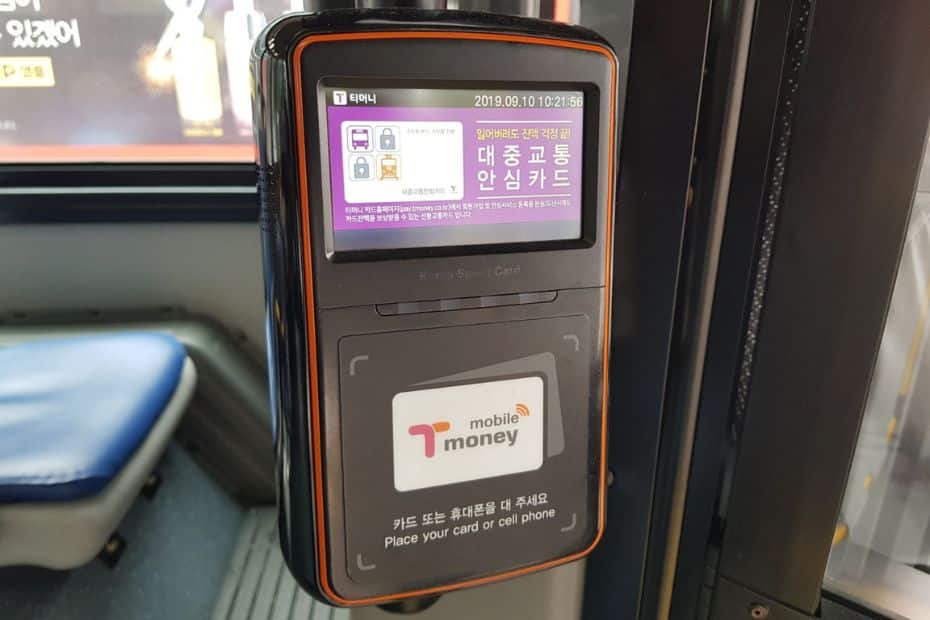
A T-Money card is the essential transportation card for using public transport in Korea. You can purchase one at Incheon Airport, subway and train stations, and convenience stores across Korea. The card can be used in many places. It never expires, so you can use it on different trips, too.
Here is how to use a T-Money card in Korea:
- Purchase a T-Money card (2,500 KRW)
- Add money to the card (cash top-up only)
- Enter the bus or subway station
- Tap the T-Money card against the card reader (see pic above)
- Tap the T-Money card again when you get off (for transfer discount)
- Recharge when necessary
I recommend adding about 10,000 KRW for each day you plan to travel in Korea. That means about 70,000 KRW for a week. You can add more money later if necessary. You can top up at convenience stores and transport stations. There is also an app version of T-Money, but the card version is better.
How Do You Use Trains In Korea?

The train network in Korea is divided into high-speed trains (KTX) and regular trains (ITX and Mugunghwa). The KTX network connects major cities in Korea and is convenient for travelling around Korea quickly and cheaply. The carriages are comfortable and come with modern facilities.
Unlike other forms of public transport in Korea, transportation cards like T-Money aren’t accepted for trains. You will need to buy a train ticket to travel and all tickets are single tickets. The price to buy a ticket doesn’t change and you can refund a ticket up to the last minute for only a small fee.
You can book tickets within 30 days of travel through the official Korail website or app, or at a train station in Korea. Unfortunately, buying a train ticket online in Korea can be difficult as Korean payment systems often reject cards issued outside of Korea. Buying in person is recommended.
How To Book Korean Rail Tickets Outside Of Korea
If you want to book Korean train tickets outside of Korea, you can do it online with Trip.com , which is Korail’s exclusive overseas distributor. The price is slightly higher (about 5%) than the price you’ll pay in Korea, but it will allow you to book tickets online and secure your seat in advance.
If you plan to travel on the main KTX route between Seoul and Busan, I highly recommend booking tickets in advance. There are three types of tickets available – first class, regular, and standing. The journey takes 2:34 and you don’t want to be standing for all that time. Book ahead for comfort.
Is The Korea Rail Pass Worth The Price?
The Korea Rail Pass is a good option for tourists who plan to travel long distances by train in Korea, such as between Seoul and Busan or Seoul and Jeonju. The pass has two main options – flexible and consecutive. These mean you can use it any time (flexible) or within consecutive days.
The flexible pass is more expensive, but offers more freedom to travel around Korea over a longer period. You can use the pass to only cover big journeys and won’t feel pressured to use it again until you’re ready. The extra cost is more than worth the inconvenience of having to rush travel plans.
Will you save money with the Korea Rail Pass? That depends on your travel plans, how often you’ll be travelling by train, and how many people are travelling. If there are 2 people or more, purchase the group saver pass and save 10,000 KRW each on the pass. Group tours make it better value.
The Korea Rail Pass does not allow you to ride on the subway for free, which would make it better value. It can also be complicated to reserve tickets online using the pass and buying tickets in the regular way is more convenient. Overall, the pass isn’t essential, but might save you money.
How Do You Use Taxis In Korea?
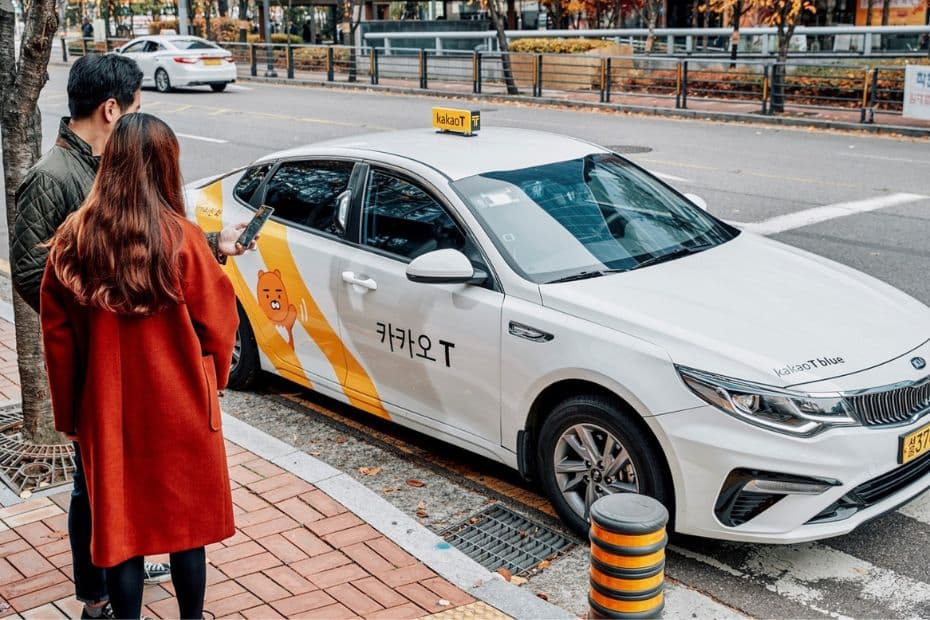
Taxis in Korea can be hailed from the street or called directly to you using apps such as Kakao Taxi . Companies like Uber and Grab don’t have a large presence in Korea and operate the same way as Kakao Taxi, by helping you find an official taxi driver. Private taxi services aren’t common.
The big issue facing the Korean taxi industry in 2024 is the lack of taxi drivers. This can make it hard to get a taxi, even when using an app like Kakao Taxi. Late night taxis are particularly difficult to find. Read this guide about how to use Kakao Taxi to help you learn how to call a taxi in Korea.
Taxi prices in Korea are reasonable, especially compared to countries like Japan and the UK. Although base taxi fares rose in 2023 to 4,800 KRW, the price is still low and relatively affordable to travel by taxi if you need to. It’s a good option if there are no direct public transport routes.
Taking a taxi to and from Incheon Airport is a convenient option if you have a lot of bags or you are travelling in a group. For solo travellers or couples, I would recommend using public transport or a limo bus, as it’s significantly cheaper and won’t take much longer than a taxi.
How Do You Use Intercity Buses In Korea?
Intercity buses in Korea operate in a similar way to trains. You can only book tickets within 30 days of travel and can only buy single tickets. Book tickets online through websites such as T-Money Bus or Bustago , through app versions of these sites, or at the bus terminal you will depart from.
You can’t walk onto intercity buses without a ticket, nor can you use transportation cards like T-Money to pay on entry. You will need to pay for and receive your ticket (physical or digital) before you can enter the bus. Ticket machines usually (but not always) have English options for buying tickets.
There are no return bus tickets in Korea and you can only buy tickets from your point of departure, unless you book online or via an app. If you’re travelling from Seoul to Gangneung, for example, you will need to buy a ticket in Seoul and then a ticket in Gangneung. You can’t buy both in Seoul.
How Can You Hire A Car In Korea?
Renting a car is a great way to see parts of Korea that aren’t covered by the train network and gives you the freedom to explore at your leisure. If you plan to travel to Jeju Island, which doesn’t have any trains, hiring a car will be a lot more convenient and is almost a must if you plan to travel inland.
Car rental in Korea isn’t that expensive and you can rent a modern car for as little as 75,000 KRW per day. I recommend booking car rentals through Klook , they will deal with the Korean car rental companies and reserve a car for you. This is easier than trying to do it in Korean.
To hire a car in Korea, you will need:
- Driver’s license (must have had it for at least 1 or 2 years)
- International Driving Permit (in some cases)
- Credit card (in the name of the main driver)
- Valid photo ID (passport)
- Printed voucher for rental (if booked online)
Here’s some more information about the International Driving Permit and rules you should follow when driving in Korea, such as the legal requirement to wear seatbelts, booster seats for under 6s, and not using your phone while driving. Be sure to read up on local rules before driving in Korea.
Best Places To Visit In Korea In 2024
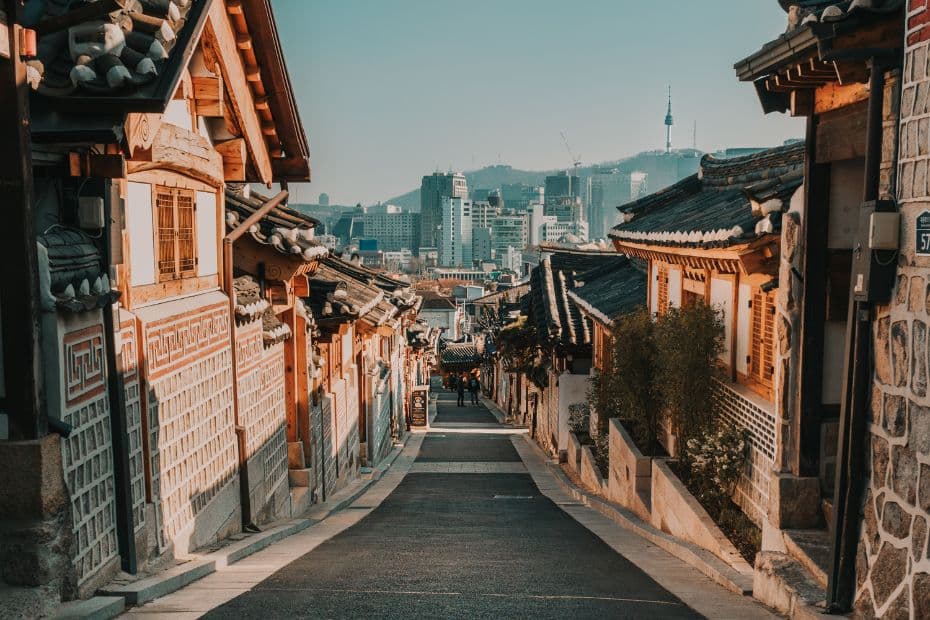
The next few sections of this South Korea travel guide will help you figure out what you want to do and see on your travels. This first section will give you a brief introduction to the best places to visit in Korea, including the major cities, tourist hotspots, and unique areas that you’re sure to love.
Here are the best places to visit in Korea:

Seoul: Korea’s Capital
Seoul is Korea’s vibrant, bustling capital and truly a must-see for any first-time visitor to Korea. There is so much to see and do in Seoul that you could easily spend a week or more exploring the city and not get bored. You will find yourself falling in love with the city for different reasons. Maybe it’s the friendly people, the deliciously cheap street eats, the way things just work, the hidden murals on old buildings down side streets, the feeling of safety even in a big city, or the historic sights creeping out from modern buildings. Seoul includes everything Korea has to offer, plus a lot more you won’t find elsewhere.
What To See In Seoul
Here are 10 great places to visit in Seoul:
- Gyeongbokgung Palace
- Bukchon Hanok Village
- Myeongdong Street Markets
- Lotte World Tower & Seokchon Lake
- Dongdaemun Design Plaza & Markets
- Yeouido Han River Park & Cruise
- Secret Garden (Changdeokgung Palace)
- N Seoul Tower & Namsan Mountain
- COEX Mall & Bongeunsa Temple
- Bukhansan National Park

Busan: Big Coastal City
While Seoul is a showcase of all things Korean, Busan is unashamedly its own city and a celebration of coastal life and local culture. Busan is famous for fresh seafood, traditional markets, great beaches, big festivals, movies, temples, and places to explore the coast. Beaches are popular places to visit in Busan, along with cliff-side walkways with views over the ocean. Central Busan is a lively spot with lots of entertainment and markets to enjoy, including a famous fish market where you can choose your own lunch and then eat it. Busan is spread out and deserves several days to explore it properly.
What To See In Busan
Here are 10 great places to visit in Busan:
- Haeundae Beach & Beach Train
- Jagalchi Fish Market
- Gamcheon Culture Village
- Haedong Yonggungsa Temple
- Songdo Beach & Cable Car
- Huinnyeoul Culture Village
- BIFF Square & Centum City Mall
- Oryukdo Skywalk & Coastal Paths
- Lotte World Busan
- Busan X The Sky Observatory

Jeju Island: Natural Wonder
Jeju Island is a gorgeous island created from a volcano rising out of the ocean 2 million years ago. Today it’s one of the New 7 Natural Wonders of Nature and deservedly so. The lush island is packed with pine trees, tangerines, rolling hills and fields, cacti, and jet black volcanic rock tumbled all around. You can relax on a beach, go horse riding, explore ancient lava tubes, scuba dive, climb to the volcano’s peak, chill in a beach-side cafe, explore traditional markets, learn about local culture, and lots more. The island has two main cities, but the attractions are spread out along the coast.
What to See On Jeju Island
Here are 10 great places to visit on Jeju Island:
- Hallasan Mountain (Volcano)
- Seongsan Ilchulbong Sunrise Peak
- Hyeopjae & Hamdeok Beaches
- Seogwipo Maeil Olle Market
- Jeju Folk Village
- Yakcheonsa Coastal Buddhist Temple
- Jungmun Beach & Jusangjeolli Cliff
- O’Sulloc Green Tea Museum
- Cheonjiyeon & Jeongbang Waterfalls
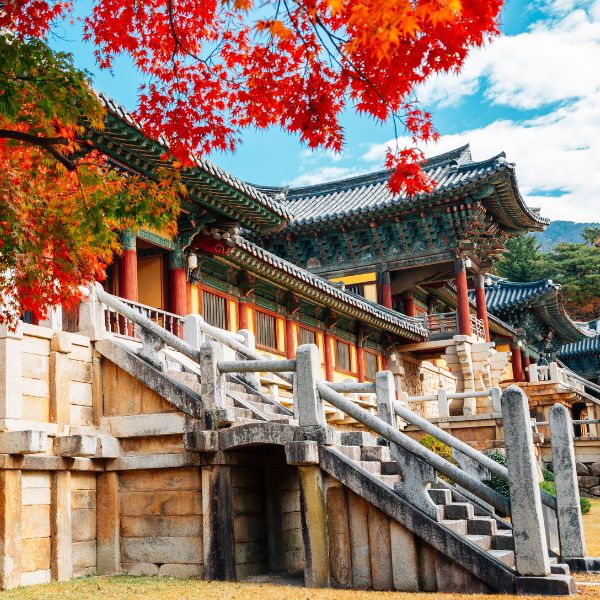
Gyeongju: Historic Capital
Gyeongju , the former capital of the Shilla Kingdom in ancient Korea, is a true treasure trove of UNESCO World Heritage sites, as well as local culture, history, and natural beauty. Described as an outdoor museum, you can see many of the big attractions in the Gyeongju Historic Area, including the 1,400 year Cheomseongdae Observatory . There’s so much to see in Gyeongju outside this area though, including the impressive Bulguksa Temple, one of the best Buddhist temples in Korea. There’s also the Bomun Lake Tourist District, a dreamy sight during cherry blossom season.
What To See In Gyeongju
Here are 10 great places to visit in Gyeongju:
- Bulguksa Temple & Seokguram Shrine
- Cheomseongdae Observatory
- Donggung Palace & Wolji Pond
- Yangdong Folk Village
- Hwangnidangil Hanok Street
- Daereungwon Tomb Complex
- Bomun Lake Tourist Complex
- Woljeonggyo Bridge
- Gyeongju National Museum
- Gyochon Traditional Hanok Village
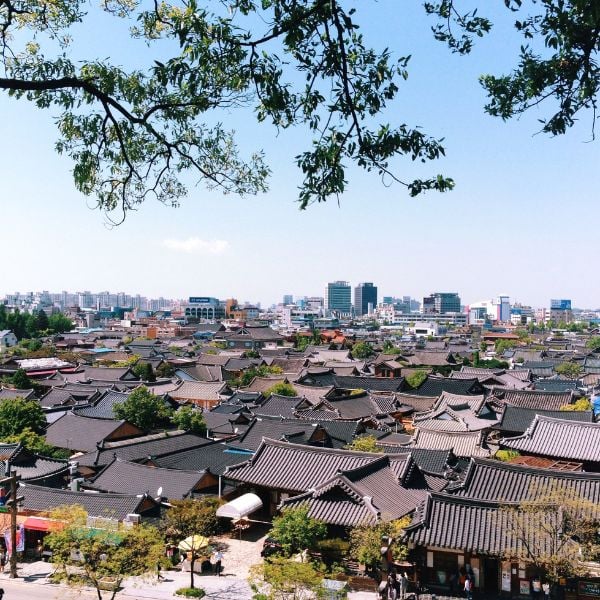
Jeonju: Traditional Views & Food
Jeonju is the perfect destination for a day trip from Seoul and has most of its main attractions in one area of the city. What can you see in Jeonju? The main attraction is the gigantic Jeonju Hanok Village , featuring more than 700 traditional hanok houses. You can dress up in Korean hanbok, dine on Jeonju’s famous bibimbap in an old restaurant, and see how life in Korea used to be. There are plenty of other sights nearby, including a traditional market, pretty river, and the rather unusual Jaman Mural Village.
What To See In Jeonju
Here are 5 great places to visit in Jeonju:
- Jeonju Hanok Village
- Jeongdong Catholic Church
- Gyeonggijeon Shrine
- Nambu Traditional Market
- Jaman Mural Village
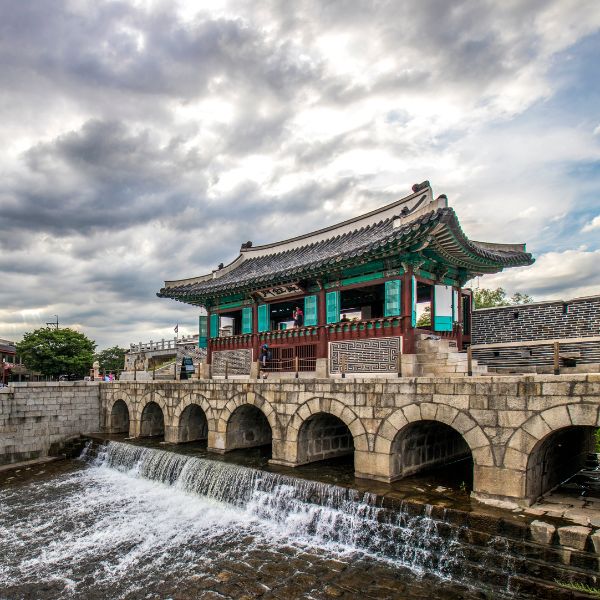
Suwon: Fortress City
Suwon is another city close to Seoul that you can visit in a day and see many interesting and unique sights. The main draw of Suwon is the Hwaseong Fortress and the fortress walls, which are still intact and run for 6km around the city. Inside this fortress you’ll find lots of museums, historic buildings, parks, and activities, such as archery. There are often cultural festivals in this area, too. Surprisingly, Suwon is the best place to get KFC (Korean Fried Chicken). There’s a whole street dedicated to making it.
What to See In Suwon
Here are 5 great places to visit in Suwon:
- Hwaseong Fortress & Fortress Walls
- Hwaseong Haenggung & Haengridan Gil
- Fried Chicken Street
- Korean Folk Village
- Gwanggyo Lake Park
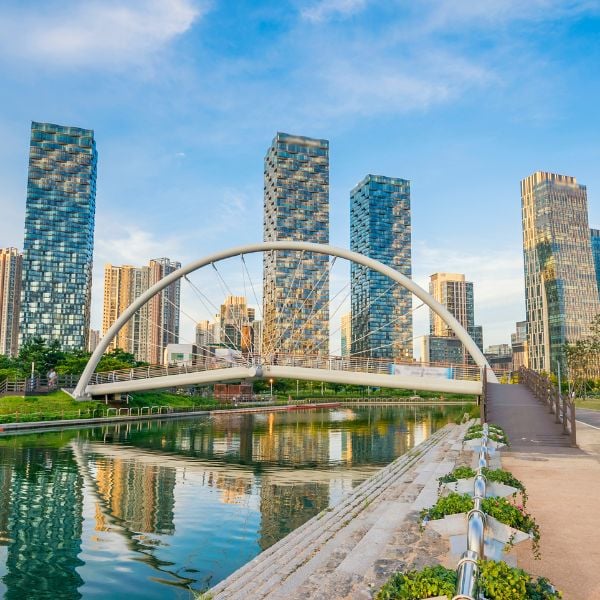
Incheon: Modern City With Islands
Incheon is one of Korea’s largest cities, but is sadly ignored as it’s right next to Seoul and most people think it’s just there for the airport. That’s not true at all and there’s plenty to see and do in Incheon. Described as a futuristic city, Incheon is at the front of Korea’s push to become an ultra-modern country and nowhere shows that more than Songdo Central Park . The traditional side of Incheon is also worth exploring, including the Chinatown, which is home to Korea’s most popular student food – jajangmyeon . If you want to explore a lesser-seen side of Korea, check out the islands near Incheon to see ancient fortresses, temples, and charming sights.
What to See In Incheon
Here are 5 great places to visit in Incheon:
- Songdo Central Park
- Incheon Chinatown
- Wolmido Island
- Incheon Grand Park
- Ganghwa Jeondeungsa Temple
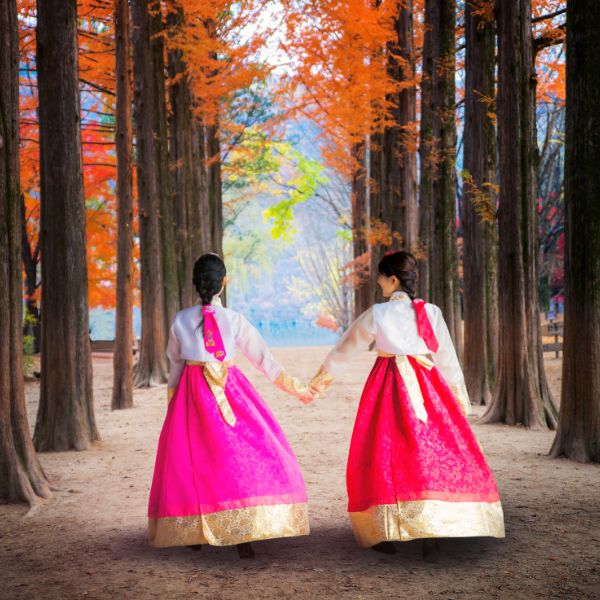
Gapyeong County: Tourists Treats
Gapyeong County is a rural part of Korea just outside Seoul that is one of the most popular day trip destinations for visitors and locals alike. Inside Gapyeong County is the lovely Garden of Morning Calm , a beautiful sculpted garden that showcases traditional Korean buildings set amongst thousands of different plants and trees. There’s also Nami Island , an ever-popular attraction that has long tree-lined streets to explore, woodland animals, bike paths, and even a zip line to the island. You can also visit Petite France, a recreation of a French village, Gapyeong Rail Bike Park, and Cheongpyeong Lake, and many other attractions in Gapyeong.
What To See In Gapyeong
Here are 5 great places to visit in Gapyeong:
- Nami Island
- Garden of Morning Calm
- Petite France
- Gapyeong Rail Bike Park
- Cheongpyeong Lake
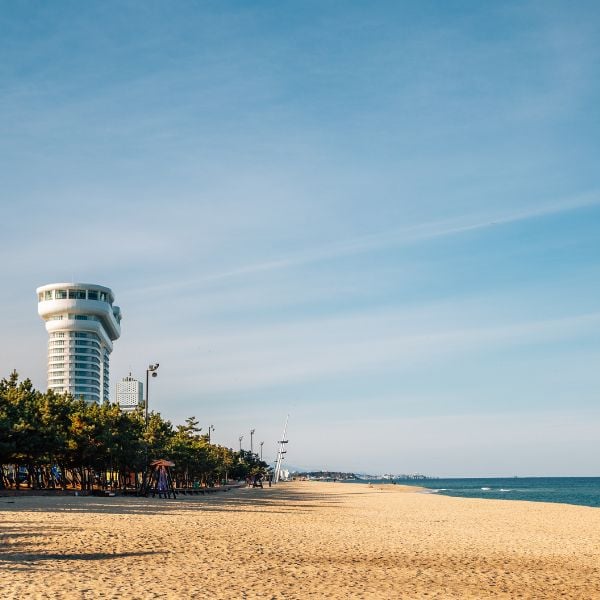
North-East Coast: Amazing Beaches
The north-east coastal region of Korea, spreading between Sokcho and Gangneung , features some of Korea’s most popular summer seaside resorts and beaches. The wide, sandy beaches are perfect for water sports, working on your tan, and sitting at night listening to local musicians perform BTS covers and their own tunes. Sokcho deserves at least two days to explore, more if you plan to visit nearby Seoraksan National Park , one of Korea’s best places to see autumn foliage. Gangneung is where to see cherry blossoms in spring, sit and relax at a seaside cafe at Gangneung Coffee Street , and enjoy beach life.
What To See On The North-East
Here are 5 great places in north-east Korea:
- Sokcho Beach
- Gangneung Beach
- Seoraksan National Park
- Yangyang Surfyy Beach
- Gangneung Coffee Street
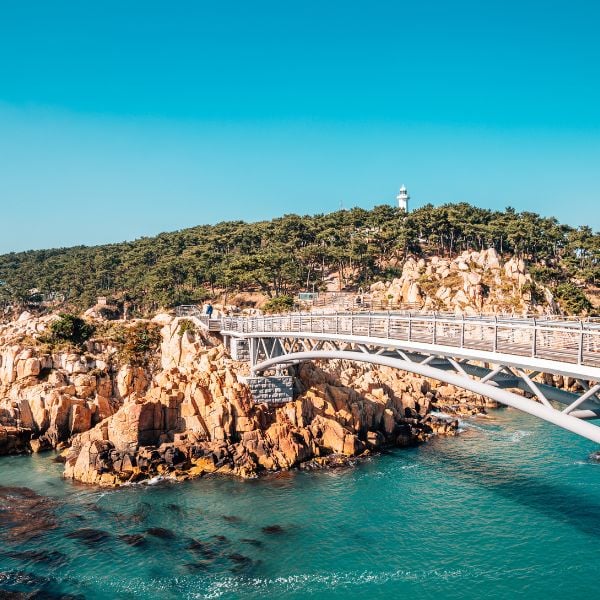
East Coast: Harbour Cities
Ulsan and Pohang are two industrial cities that don’t get enough attention, but are ideal for a weekend visit once you’ve explored other top sights. These coastal cities both have good beaches, coastal walks, and green spots, including a pretty bamboo forest in Ulsan. In Pohang, you can see the dizzying Space Walk , which looks out over the city and ocean. There’s also a former Japanese district with old buildings, and the famous Homigot Sunrise Square where you can watch the first sunrise of the year. Ulsan is famous for whaling and visitors should check out the charming Jangsaengpo Whale Museum and Daewangam Park.
What To See On The East Coast
Here are 5 great places on Korea’s East Coast:
- Yeongildae Beach & Space Walk
- Ilsan Beach & Daewangam Park
- Jangsaengpo Whale Museum
- Homigot Sunrise Square
- Taehwagang National Garden
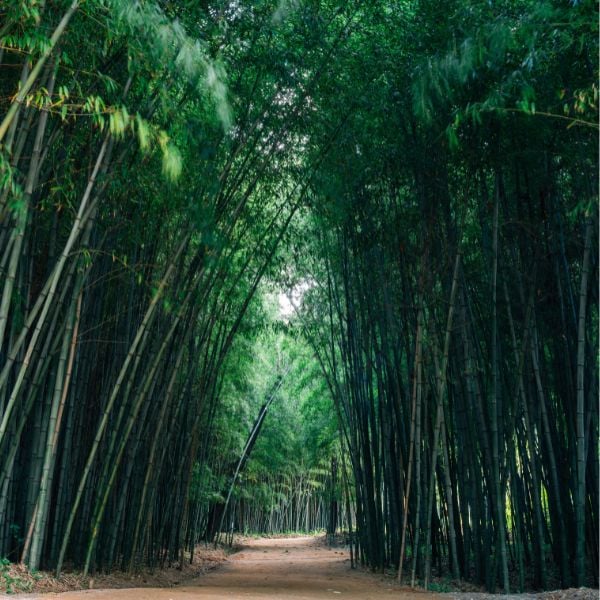
South-West: Iconic Rural Destinations
South-west Korea is a long way from most travellers’ typical route, but this area is worth visiting if you have time. Gwangju , one of Korea’s largest cities, is hidden away down here and surrounded by natural beauty, including the Juknokwon Bamboo Forest , Boseong Green Tea Fields, and Suncheon Bay Nature Reserve. If you plan to hire a car , these spots will show you a completely different side to Korea. Gwangju, too, which is a fun city and the birthplace of Korean democracy. Hidden in the far corner of Korea is Mokpo, a lovely coastal city that has a new cable car carrying you over the ocean.
What to See In The South-West
Here are 5 great places in south-west Korea:
- Damyang Juknokwon Bamboo Forest
- Boseong Green Tea Fields
- Gwangju Culture Park & Penguin Village
- Suncheon Bay Nature Reserve
- Mokpo Marine Cable Car
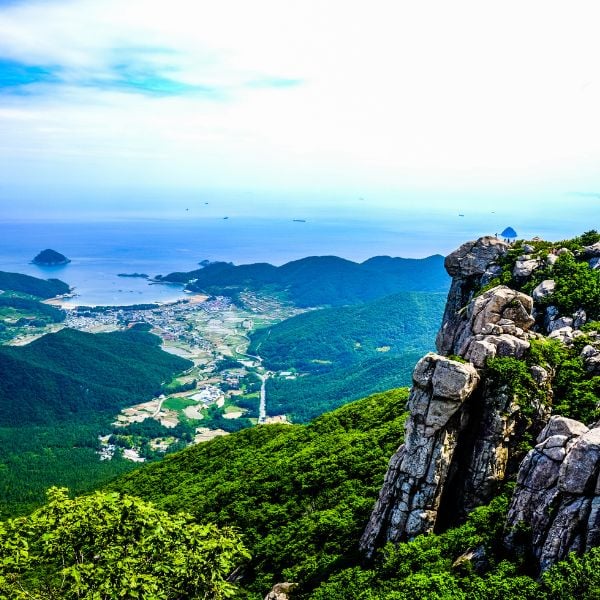
South Coast Islands: Summer Getaways
Best explored during the hot summer months and early autumn, the south coast islands in Korea, which span from Busan to Mokpo, are where Koreans spend their summer holidays. The most popular destinations here are Geoje, Tongyeong, Yeosu, Namhae, and Goheung and each offers winding coastal paths, beaches, natural beauty, and fun summer activities. The best way to see these islands is with a rented car or by bike, riding around the coast visiting a few different beaches and attractions. Don’t expect too many cultural sights, instead you’ll find luges, gardens, water sports, and lots of fun.
What to See On The South Coast
Here are 5 great places on Korea’s South Coast:
- Dolsan Park & Cable Car
- Namhae Geumsan Boriam Hermitage
- Hallyeohaesang National Park
- Oedo-Botania Botanical Garden
- Skyline Luge Tongyeong
As you can see, there are many great places to visit in Korea. Korea is truly a country of undiscovered wonders that people aren’t aware of. Seoul is an incredible place to visit, but there’s so much more to see. That’s why I try to include lesser-known places in this South Korea travel guide.
The list above covers a lot of the most popular or tour-worthy destinations in Korea, but there are still more places I could recommend, such as Andong (home to the mask dance festival), Gunsan (port town with a retro vibe), Daegu (big city with historic sights), Daejeon , and many more.
Besides cities and towns in Korea, there are also 18 national parks to explore, thousands of mountains, Buddhist temples, beaches, bike routes, campsites, and so much more. I’ll include a few of each of these in the next few sections of this South Korea travel guide.
Best Day Tours From Seoul In 2024

Taking a day tour while you’re staying in Seoul is a great way to see more of Korea’s top attractions without the hassle of moving hotels to somewhere new. The 10 day tours from Seoul below can all be done in a day or less and can even be combined with other activities in the same day.
I don’t want to include every day tour available in this South Korea travel guide as there isn’t enough room to talk about them all. If you want to find more day tours, I recommend looking at the options available through tour providers such as Klook , Viator , and Get Your Guide .
Please note : There are many day tours from Seoul and they come with various prices. I recommend avoiding the very cheapest as these will often waste your time by taking you to some overpriced gift shop area and pressuring you to buy souvenirs or rushing you through too many attractions.
Here are 10 great day tours from Seoul:
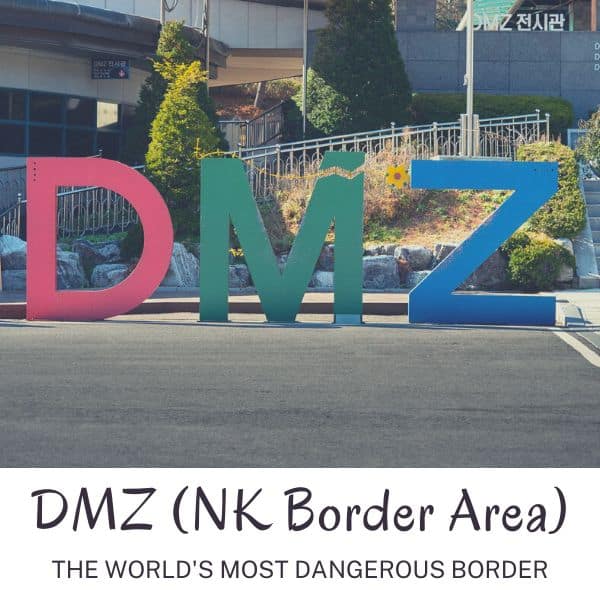
Why Visit The DMZ
The DMZ, the demilitarised zone between North & South Korea is a truly unique place to visit when you’re in Korea. There are several different locations to see in this area, each reflecting the bitter struggle between the two Korea’s in the ongoing Korean War. Some of the highlights are the 3rd Tunnel, Dora Observatory, Dorasan Station, Gamaksan Suspension Bridge, and the Imjingak Park. There’s also the Panmunjom Truce Village where you can walk into North Korea, but this is currently closed. Tours are required to travel to certain parts of the DMZ.
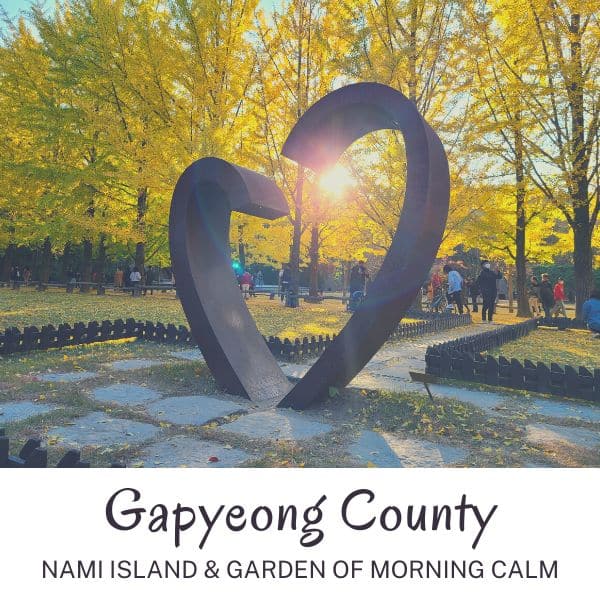
Why Visit Gapyeong County
Gapyeong County is home to Nami Island, the Garden of Morning Calm, Petite France, Gapyeong Rail Bike Park, and several other fun attractions. Nami Island and the Garden of Morning Calm are the most popular and can both be visited in a day. You can witness beautiful scenes at these destinations, especially during cherry blossom season (April) and autumn foliage season (October). Tours from Seoul to Gapyeong County are convenient and can take you to multiple places in one day without the hassle of buses and finding your own way.
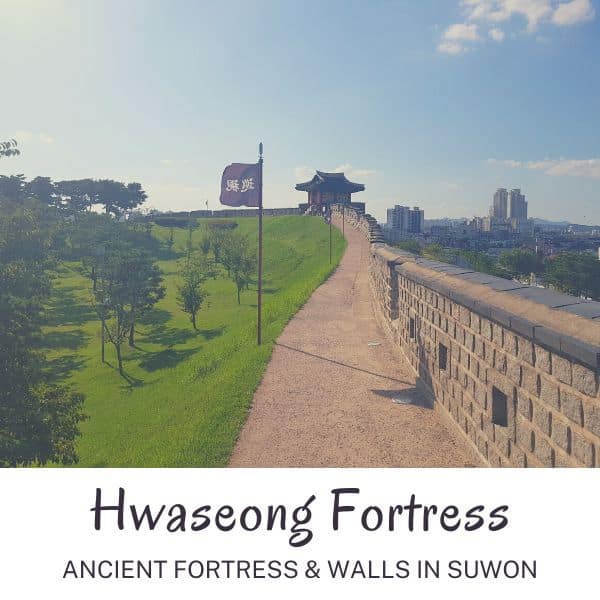
Why Visit Hwaseong Fortress
Hwaseong Fortress and its fortress walls offer a unique chance to see what life was like in Korea 200 years ago. Not only can you walk the full length of the walls around the city, you can also try archery and other traditional activities in the fortress grounds. There are many museums, fortress buildings, and exhibitions showing how people lived in this period. You can also enjoy the beautiful ponds and streams that run through the palace with traditional Korean restaurants and cafes looking out over these areas.
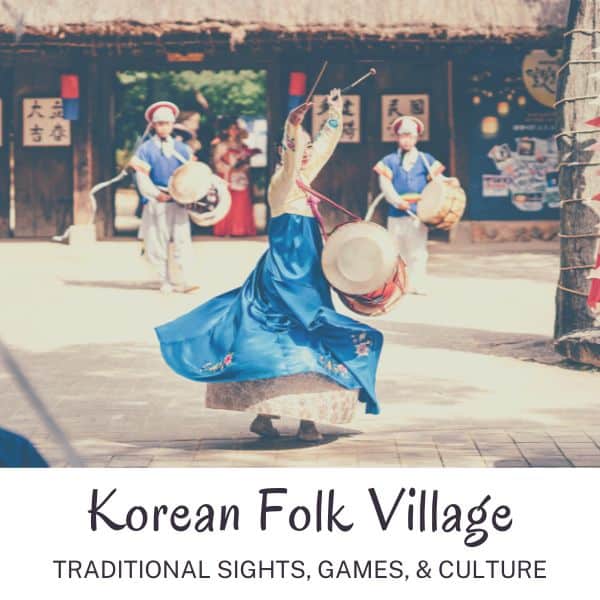
Why Visit Korean Folk Village
Discover traditional Korean life at the Korean Folk Village in Yongin during a day trip from Seoul. Walk through dozens of recreated farm buildings, government offices, academies, shops, smiths, schools, and other traditional buildings from Korea’s past to get a feel for how people lived at this time. Actors dressed in traditional Joseon-era costumes bring the scenes to life. You can try fun activities, such as mask carving, horse riding, and archery. Witness exciting festivals and cultural performances, too.

Why Visit Jeonju Hanok Village
A day trip to the Jeonju Hanok Village in Jeonju is a great way to experience various traditional Korean cultural activities in a beautiful setting. This sprawling hanok village has over 700 traditional buildings for you to explore, dine in, or even stay in. Make sure you rent hanbok in Jeonju so you look like Korean royalty and make memorable photos during your trip. Whilst you’re in Jeonju Hanok Village, you can try local delights such as Jeonju bibimbap and PNB chocopies. Also check out the traditional Nambu Market and Jeongdong Catholic Church.

Why Visit Alpaca World
When you travel to Korea, you may not think about seeing alpacas, which are from an entirely different continent. But Korea’s love of all things cute means that these furry friends have become very popular in Korea and have their own theme park a few hours from Seoul. There are dozens of cuddly alpacas to see, feed, and play with at Alpaca World , as well as hundreds of other cute critters such as ponies, rabbits, deer, goats, fennec foxes, and more. There are 17 separate areas to explore in Alpaca World and it’ll provide hours of fun for the whole family.
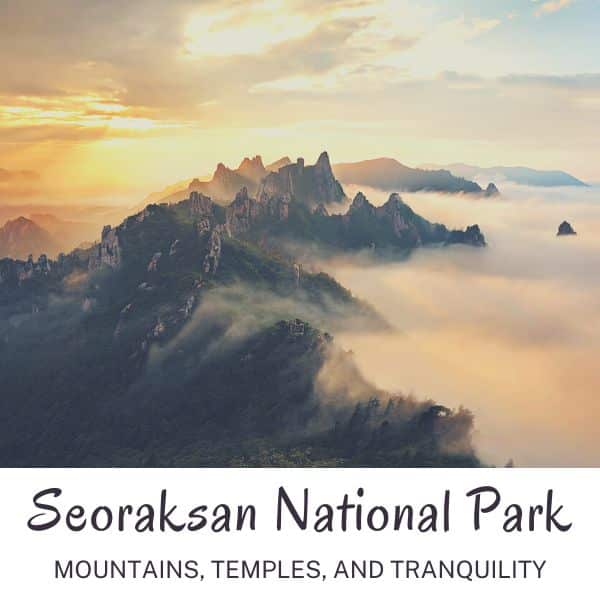
Why Visit Seoraksan
Seoraksan National Park on Korea’s east coast is a great day trip from Seoul for those who want to see mountain peaks, leafy valleys, stony rivers, and a gigantic Buddha. Even if you’re not a keen hiker, you can explore lots of the park’s valley pathways easily, or reach the top thanks to the convenient cable car. See the sights from the observatory and check out the small temple in the clouds. Make sure you try haemul pajeon (seafood pancake) and makgeolli (rice wine). It’s the traditional meal Koreans enjoy after hiking.
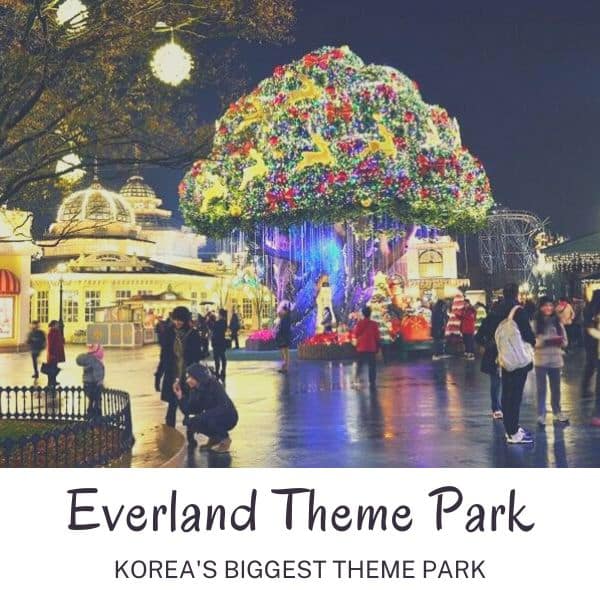
Why Visit Everland
Everland is Korea’s biggest theme park and is packed with attractions for everyone to enjoy. Thrill seekers will love the rollercoasters, such as T Express (the world’s 4th steepest rollercoaster) and many more exciting rides. Check out the Zootopia section to see wild animals and wild rides, or the Plantopia section for floral beauty, romantic walkways, and seasonal delights. There are plenty of attractions, cultural performances, entertainments, and seasonal events to keep you amused all day long.
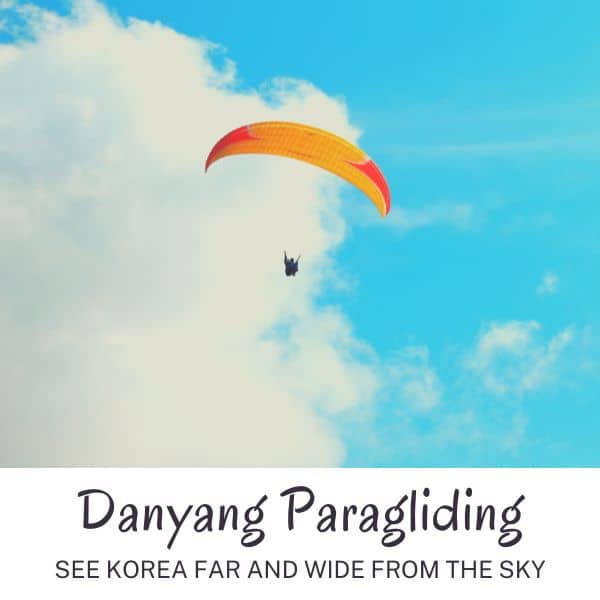
Why Visit Danyang
A great way to see Korea’s countryside is with a day trip to Danyang to enjoy the rush of sailing over valleys and beside mountains while tandem paragliding. Feel the wind in your face and the sensation of riding the air currents as you pass over the many delightful views of Danyang. You can enjoy other activities in this area, such as the Mancheonha Skywalk , a clifftop lookout with incredible views, riding an alpine coaster, and zooming along a zip line. The perfect day tour from Seoul for thrill seekers.
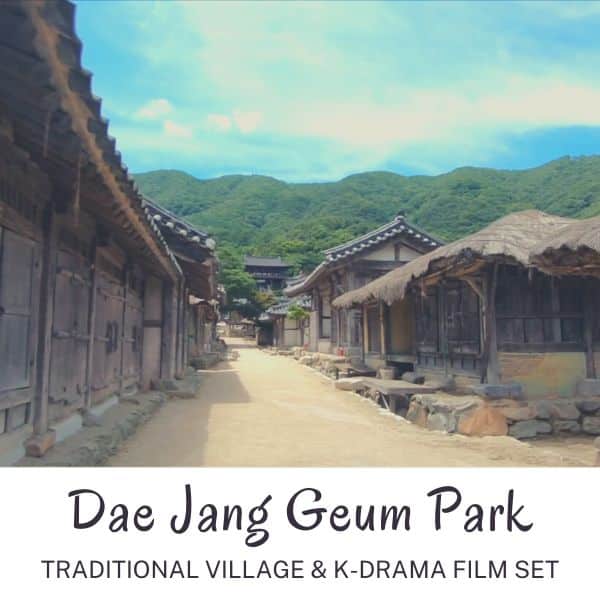
Why Visit Dae Jang Geum Park
Fans of Korean period dramas and movies will love a day trip to Dae Jang Geum Park in Yongin. This is the largest historical drama filming set in Korea and was used to film MBC productions such as ‘Wind in the Palace’ and ‘The Great Queen Seondeok’, as well as K-Pop videos including Daechwita by Suga from BTS. If you’re lucky, you may see filming going on here. But even if you don’t, it’s a fun place for those who want to learn more about Korea’s history and take some cool pictures in a real movie set.
I’ve linked to tours provided by reliable tour companies in Korea. If you would rather book a tour through a local guide, contact Jerry Heng or Andrew Chung Hanbyul . They’re freelance guides with years of experience offering tours in Korea and both offer amazing service.
These places are accessible by public transport, but may take much longer than a tour would do, wasting your precious time. Check out my guide for getting to Nami Island to help you navigate Gapyeong County. For other destinations, I would recommend a tour – it’s more practical.
Best Sights To See In Korea In 2024
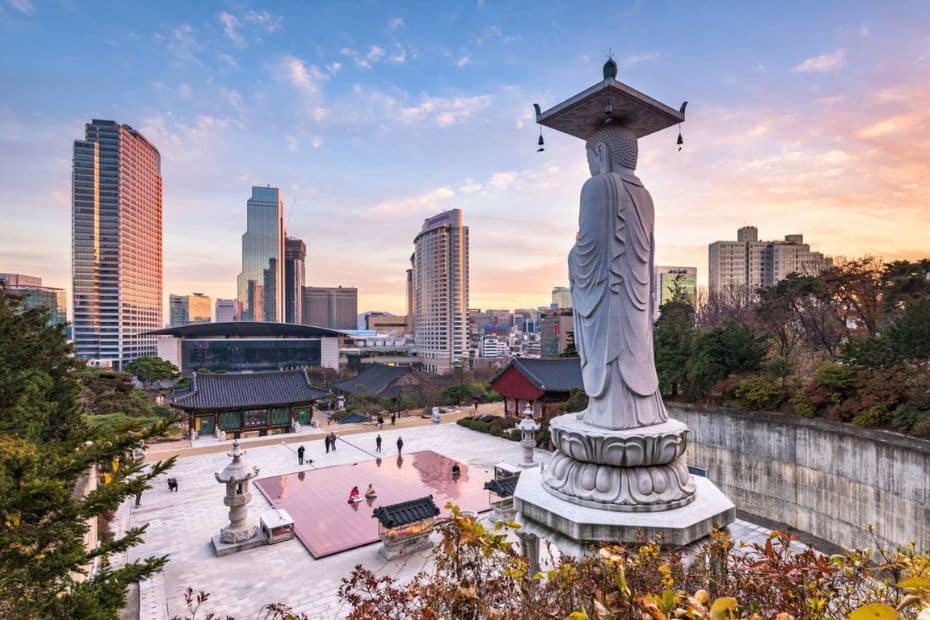
South Korea truly has something for everyone. There’s so much I want to include in this South Korea travel guide, which is why this section is full of different sights to see and explore. However, to keep things short and simple, I’ll just list them, not give full details about each one.
Whether you’re travelling to Korea to learn about Korean culture or history, to see Korea’s impressive landmarks, to enjoy family fun attractions, to hop from cafe to cafe, to immerse yourself in nature, or simply to eat and shop, then you’ll definitely find something for you in this section.
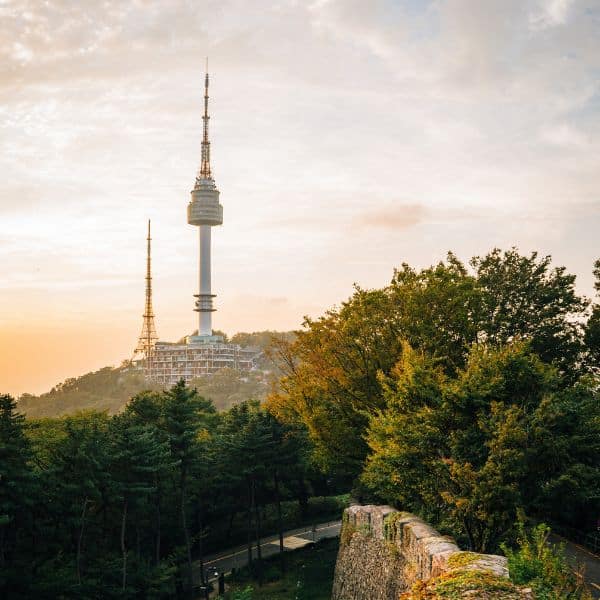
Famous Landmarks In Korea
Landmarks and iconic buildings are often top of a traveller’s bucket list for Korea as they provide great photo opportunities, showcase the best of the country, and offer fantastic views. Seoul has many top landmarks, but you can see plenty of other sights outside of the capital, too.
Here are 10 famous landmarks in Korea:
- Lotte World Tower (Seoul)
- N Seoul Tower (Seoul)
- Dongdaemun Design Plaza (Seoul)
- Cheonggyecheon Stream (Seoul)
- DMZ Area (near Seoul)
- Nami Island (Gapyeong County)
- Gamcheon Culture Village (Busan)
- Seongsan Ilchulbong (Jeju)
- Homigot Sunrise Square (Pohang)
- Banwol Purple Island (West Coast)
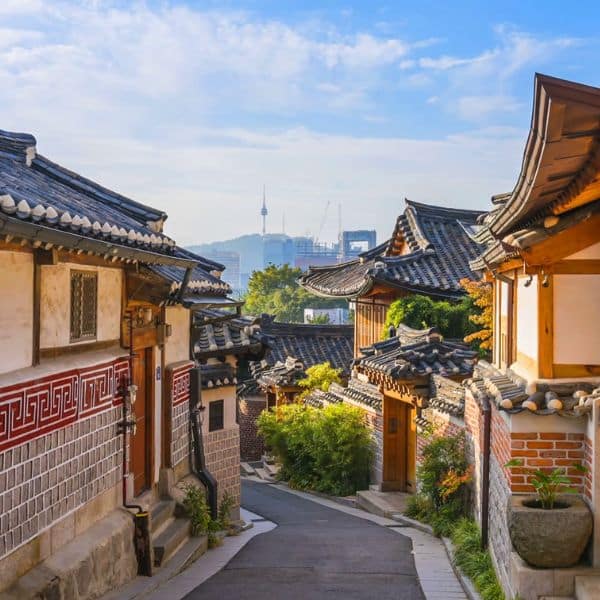
Historic Sights In Korea
Discover life in the Joseon period and before in Korea’s many captivating historic sights, including royal palaces, Buddhist temples, fortresses, and hanok villages. There are so many amazing historic sights to see in Korea, with each city having something to see.
Here are 10 historic sights in Korea:
- Bukchon Hanok Village (Seoul)
- Gyeongbokgung Palace (Seoul)
- The Secret Garden (Seoul)
- Seoul Fortress Walls (Seoul)
- Hwaseong Fortress (Suwon)
- Bulguksa Temple (Gyeongju)
- Gyeongju Historic Area (Gyeongju)
- Jeonju Hanok Village (Jeonju)
- Haedong Yonggungsa Temple (Busan)
- Andong Hahoe Village (Andong)
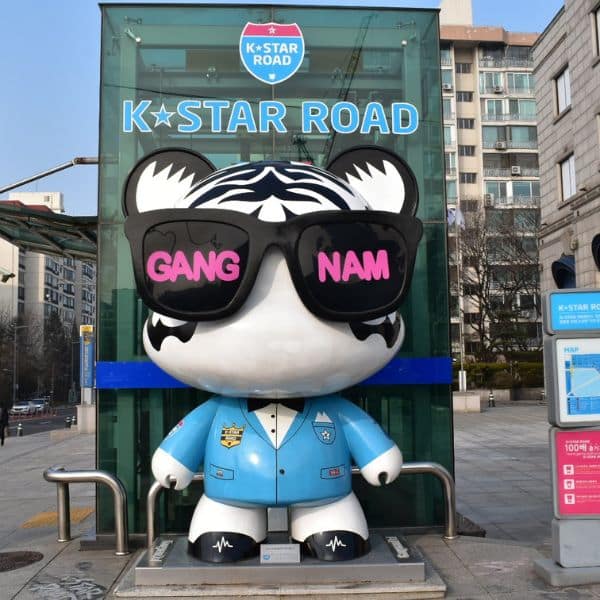
Korean Modern Cultural Sights
Fans of BTS, K-Dramas, Korean movies, and modern Korean culture in general have a lot to see and do in Korea. As well as famous filming locations across the country, these modern cultural sights will entertain, inform, and provide great destinations to visit.
Here are 10 modern cultural sights in Korea:
- Hallyu K Star Road (Seoul)
- K-Style Hub (Seoul)
- Hongik Uni. Station Area (Seoul)
- COEX Artium (Seoul)
- Asia Culture Centre (Gwangju)
- BIFF Square (Busan)
- Dae Jang Geum Park (Yongin)
- Sunshine Studio (Nonsan)
- Kim Gwang-Seok Street (Daegu)
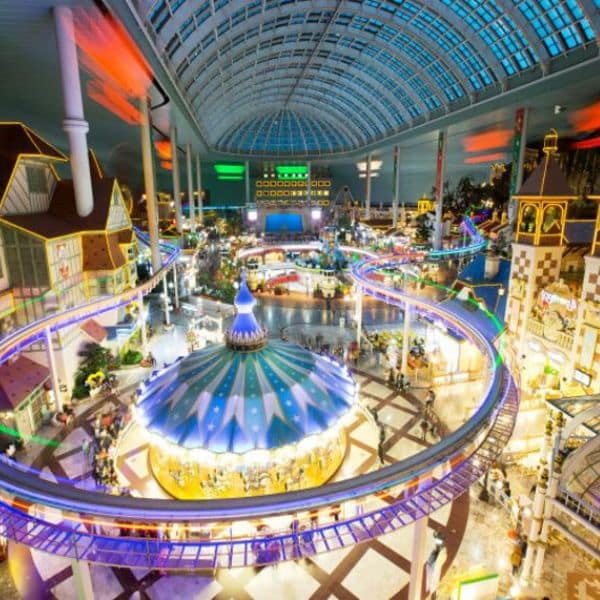
Family Fun Attractions In Korea
Families travelling to Korea have plenty of things to see and do and ways to enjoy spending time together. There’s no Disneyworld or Universal Studios in Korea, but there are plenty of great alternatives, as well as places for children to explore, learn, and discover.
Here are 10 family fun attractions in Korea:
- Lotte World Adventure (Seoul)
- Everland Theme Park (Yongin)
- Seoul Grand Park & Zoo (Seoul)
- Alive Museum & Dynamic Maze (Seoul)
- Seoul Children’s Museum (Seoul)
- Zoolung Zoolung (Seoul)
- Sea Life Busan Aquarium (Busan)
- Jeju Dinosaur Island (Jeju Island)
- Alpaca World (Gangwon Province)
- Skyline Luge & Lotte World (Busan)

Korean Museums & Galleries
Travellers to Korea who want to learn about Korea’s history, culture, and art will love Korea’s impressive museums and galleries. These are great places to visit when the weather is bad and you might be surprised at how much there is to learn about Korea’s past.
Here are 10 museums & galleries in Korea:
- National Museum of Korea (Seoul)
- War Memorial of Korea (Seoul)
- Seoul Museum of Art (Seoul)
- Seoul Museum of History (Seoul)
- Seodaemun Prison Museum (Seoul)
- Museum Kimchikan (Seoul)
- National Folk Museum of Korea (Seoul)
- Gyeongju National Museum (Gyeongju)
- National Maritime Museum (Busan)
- Daegu Art Museum (Daegu)
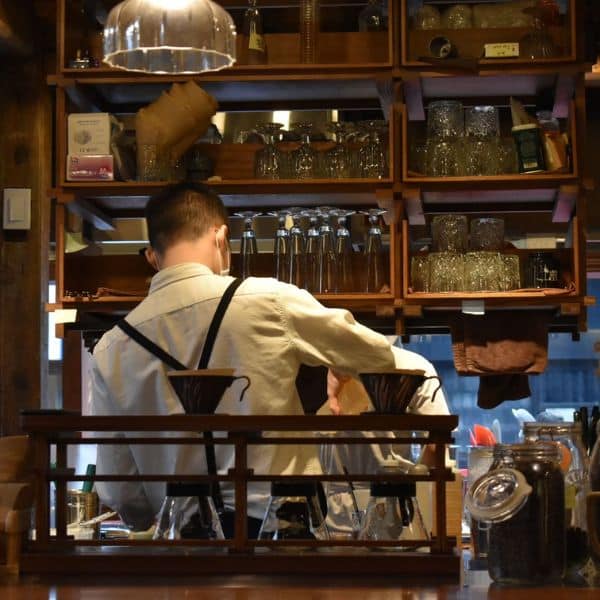
Cafe Areas In Korea
When you need a break from travelling in Korea, visit one of these cosy cafe areas and take time to relax and recharge. Although Korea was traditionally a tea drinking country, cafes are now everywhere and you’ll find photogenic cafes everywhere these days.
Here are 10 cafe areas to visit in Korea:
- Ikseondong Hanok Village (Seoul)
- Gyeongui Line Parks (Seoul)
- Samcheondong Cafe Street (Seoul)
- Sinsa-dong / Garosugil Road (Seoul)
- Jukjeon Cafe Street (Seoul)
- Jeonpo Cafe Street (Busan)
- Haeridangil (Busan)
- Hwangnidangil (Gyeongju)
- Hwaseong Haenggung Area (Suwon)
- Gangneung Coffee Street (Gangneung)
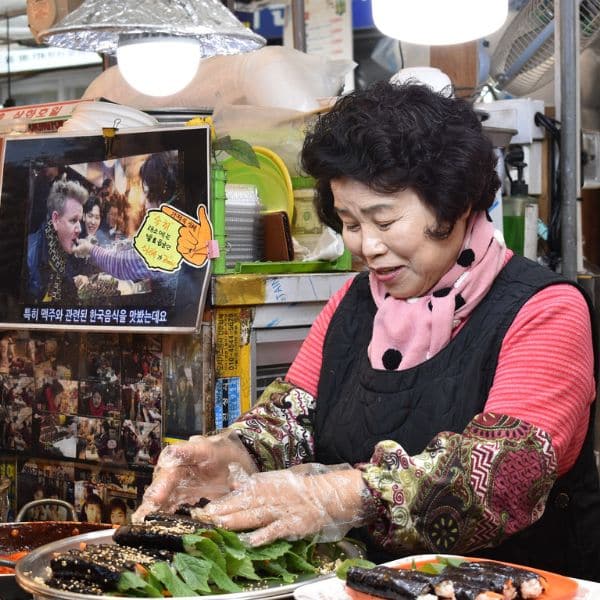
Korean Markets & Malls
If you want the best selection of street food, souvenirs, and bargain shopping options, be sure to visit Korea’s many traditional markets. It’s a cultural experience itself. Korea also has some of the world’s largest malls with a wide variety of Korean and international goods.
Here are 10 markets & malls in Korea:
- Gwangjang Market (Seoul)
- Dongaemun Market (Seoul)
- Hongdae Shopping Street (Seoul)
- Starfield COEX Mall (Seoul)
- Jagalchi Fish Market (Busan)
- Seomyeon Underground Mall (Busan)
- Centum City Mall (Busan)
- Seogwipo Maeil Olle Market (Jeju)
- Nambu Market (Jeonju)
- Paju Premium Outlets (Paju)

Korean Natural Wonders
Korea is a country covered in mountains, waterfalls, valleys, rice terraces, and beautiful natural sights. Make time to visit some of these natural wonders when you visit Korea and you’ll be amazed at the incredible views you can find. The national parks are truly breathtaking.
Here are 10 natural wonders to see in Korea:
- Hallasan Mountain (Jeju)
- Jirisan National Park (Southern Korea)
- Seoraksan National Park (Gyeonggi)
- Garden of Morning Calm (Gapyeong)
- Juknokwon Bamboo Forest (Damyang)
- Boseong Green Tea Fields (Boseong)
- Udo Island (Jeju Island)
- Seongsan Ilchulbong Sunrise Peak (Jeju)
- Hyeopjae Beach (Jeju)
- Suncheon Bay National Park (Suncheon)
These 100 ideas are just the tip of the iceberg for what you can enjoy when travelling to Korea. There’s so much more to discover and I recommend you add some time to your travel plans to explore without a plan. Sometimes the best travel memories come from unexpected discoveries.
Best Activities To Try In Korea In 2024
Often the most memorable moments when travelling come from the experiences we have, not just the places we visit. Visiting a palace is interesting, but visiting a palace while dressed in traditional Korean hanbok , pretending you’re Joseon-era royalty with your friends or family is much more fun.
This section of the South Korea travel guide offers 10 fun activities you can try when you visit Korea. These will give you a good introduction to Korean culture, food, history, and nature. If you want more ideas, check out my list of 50 unique Korean experiences you can only do in Korea.
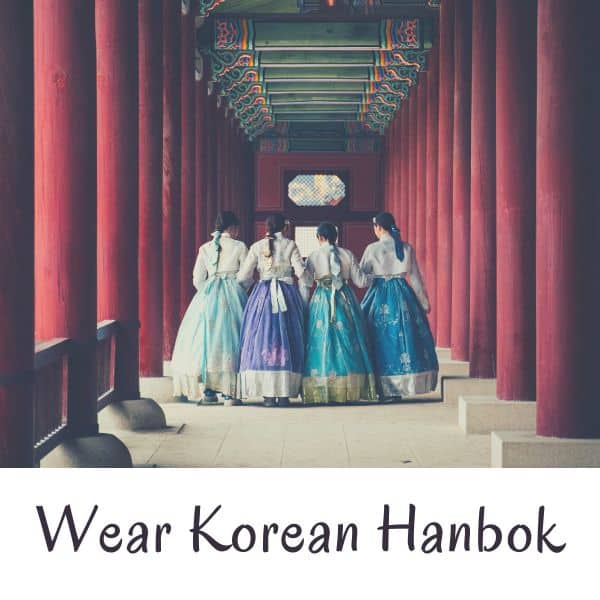
One of the top experiences to try in Korea has to be wearing Korean hanbok. It is available for all members of the family (even pets) and you can rent hanbok near most palaces or hanok villages. The hanbok easily fit over your regular clothes and come in a variety of colourful or traditional designs. You can get hair styling, accessories, and even have a hanbok photoshoot . Rentals can be as short as one hour or up to a full day.
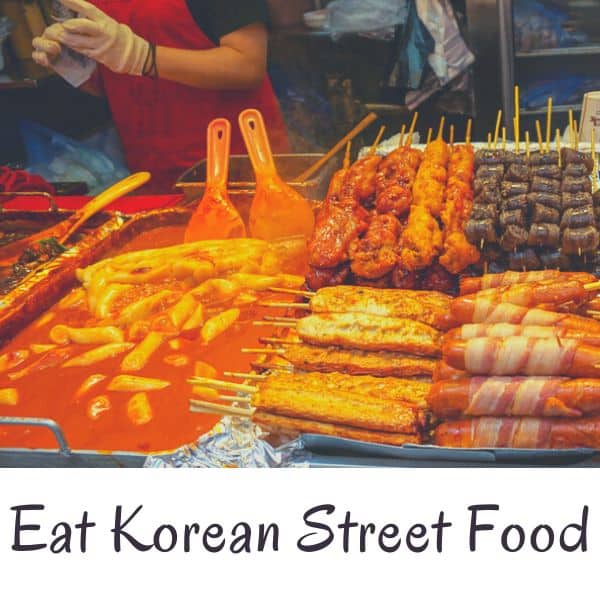
Travellers to Korea can’t say they’ve truly tried Korean cuisine until they’ve eaten Korean street food from a market stall or street vendor. There are many types of Korean street food to sample in Korea, such as savoury snacks like tteokbokki and eomuk , to sweet treats like hotteok and bungeo-ppang . Korean street food is cheap and delicious. It’s usually not that healthy, but always leaves you feeling great. Give it a try.
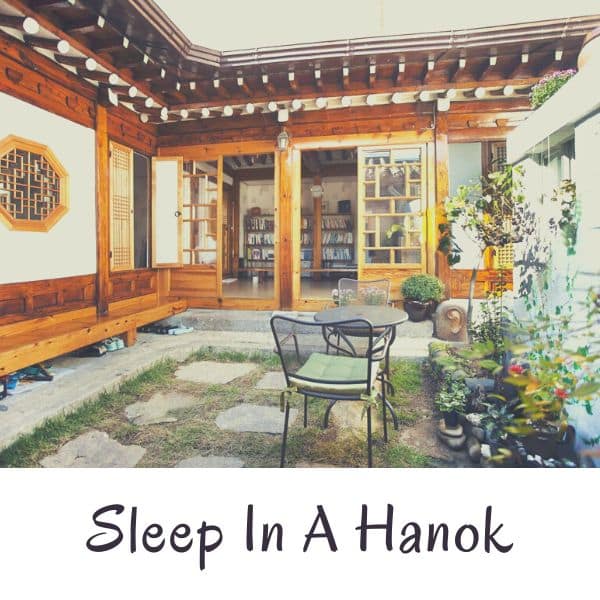
Experience life as a Korean would have in the Joseon-era with a night in a traditional hanok house. A hanok stay is very different from sleeping in a hotel and allows you to try a night on a futon (with underground heating keeping you warm in winter). Slide the doors aside in the morning and walk out onto the wooden decking to enjoy traditional Korean tea at a low table and the sight of the ornately decorated garden. Don’t forget to take your shoes off before you enter.
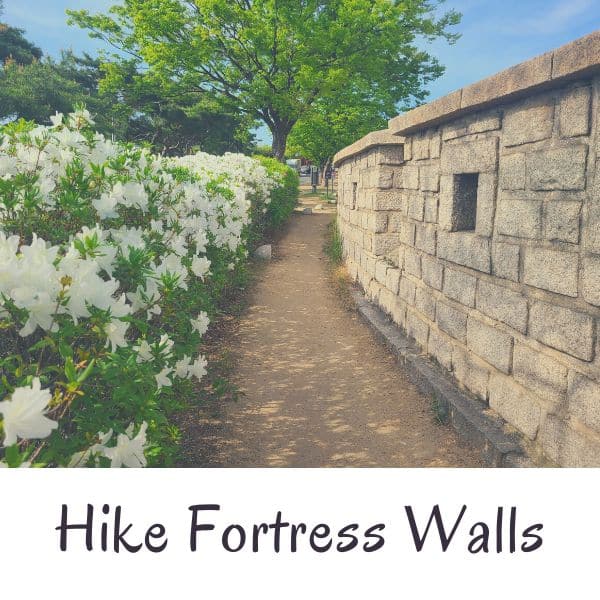
Seoul and other cities in Korea still have fortress walls you can walk or hike along that will offer incredible views of cities and mountains. As you walk along the fortress walls, you begin to imagine what life would have been like as a soldier keeping the city safe from invaders. Nowadays, you can enjoy exercise and sightseeing at the same time. Seoul’s fortress walls are a good place to start, but you can find fortress walls in many other places.
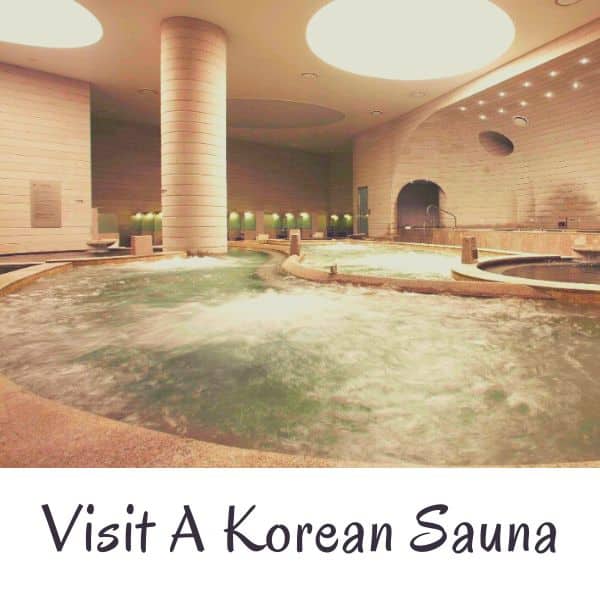
Visiting a Korean sauna might be a bit shocking for first-time travellers to Korea, but it’s a great way to relax and is especially good in winter. When you enter a Korean sauna, you should take off all your clothes, have a shower, and then enter one of the hot baths. Being naked in front of others can be scary for some, but you soon overcome that fear. Korean saunas sometimes have a communal resting area called a jjimjjilbang . These areas require pyjamas and offer snacks, drinks, and places to rest.
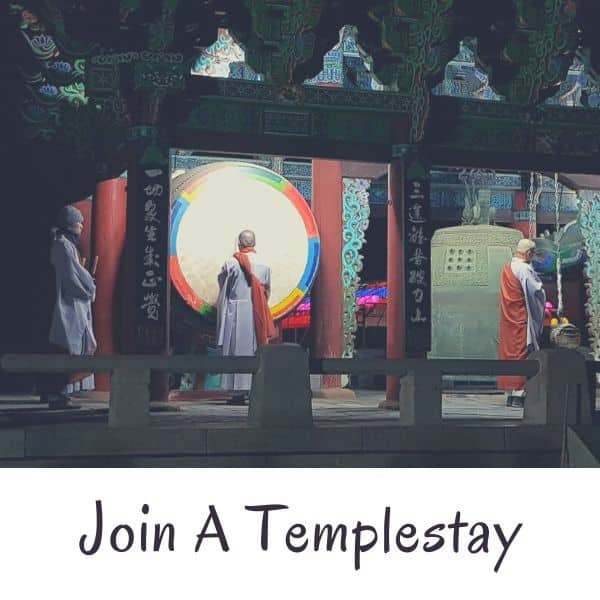
The Cultural Corps of Korean Buddhism have set up a templestay program at dozens of temples across Korea where you spend a day or two at the temple and join in various activities. This is truly a unique experience that you should try in Korea as you get to see customs performed by the monks that aren’t normally shown to the public. You also get to stay overnight at the temple and experience a hanok stay at the same time. Guests can also eat healthy vegan temple food, learn a lot, and chat with the monks.
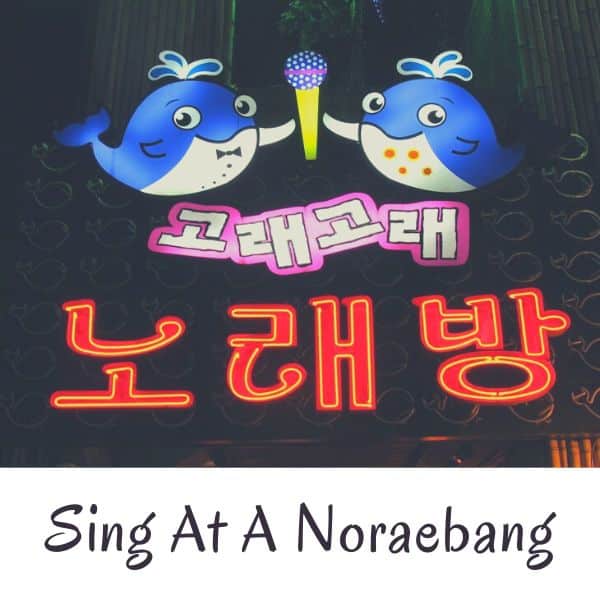
A noraebang is the Korean version of a karaoke room, but is more popular in Korea and is commonly visited by locals and tourists alike. This is a great place to visit in the evening after a big Korean bbq meal and a few drinks. Everyone can relax and belt out their favourite Korean or international tunes together (or alone), shake some tambourines in support, or just watch and enjoy the atmosphere with some drinks. You can find these in every town and city in Korea and they provide a cheap night of fun and drinks.
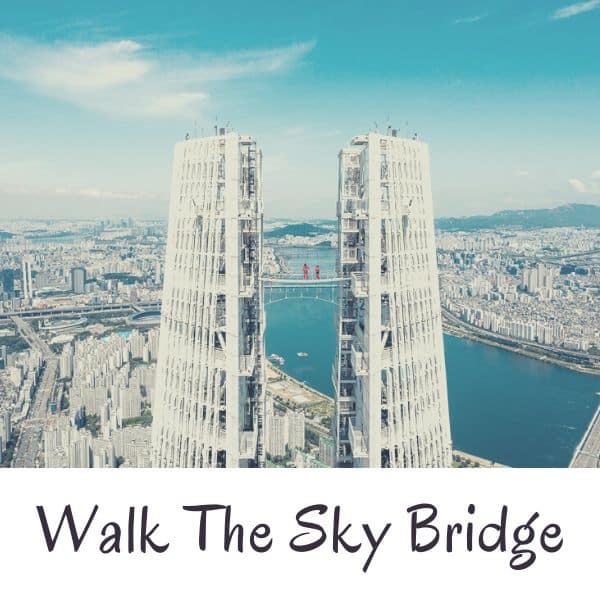
Open since 2020, the Sky Bridge at Lotte World Tower offers unbeatable views of Seoul and a nerve-racking trip above the city. Walk between the two towers at the top of the Lotte World Tower and peer down the 541 metre drop to the city streets below. It’s actually very safe and you’re strapped into a harness as you walk from one side to the other, but this definitely isn’t for the faint-hearted. If you’re not sure you can handle the height, check out the Seoul Sky Observatory on the 117th floor instead.

Koreans love to drink coffee and also love cute, unusual things, which is probably why theme cafes have become so popular in Korea. Besides the many cat cafes, there are theme cafes where you can stroke sheep, pet dogs, and see other animals. There’s more to Korea’s theme cafes than just drinking coffee with animals, you can also try drinking from a toilet at the Poop Cafe , paint pictures, build lego, go camping, practice being a wizard, and more. Hongdae in Seoul is the best place to find theme cafes.

Although cafes are replacing Korean tea houses, Korea still grows and drinks lots of tea, especially green tea. You can visit these tea fields in areas such as Boseong and on Jeju Island, both of which have visitor centres and attractions to teach you about the wonderful world of Korean tea. The Daehan Dawon Tea Plantation in Boseong has lush green fields all year round and has been used as a filming location for several Korean shows. The O’sulloc Tea Museum on Jeju Island also has lovely views.
I recommend trying at least a few of these unique activities, they’ll really make your trip to Korea more memorable and offer insights into Korean culture and life. My advice is to be brave when visiting Korea and try new things, even if they seem a bit unusual at first. The same applies to Korean foods.
Best Korean Festivals To Join In 2024
There are dozens of festivals held in Korea each year celebrating the seasons, local products, traditions, culture, and often just for the sake of having fun. Visiting a festival in Korea will offer you a glimpse of how locals celebrate life, culture, and nature and let you join in the fun.
Whenever you visit Korea, there’ll be festivals going on. However, the biggest festivals occur in spring or autumn. As mentioned previously in this South Korea travel guide, these are the best seasons to visit Korea as the weather is pleasant and people are celebrating the end of summer or winter.
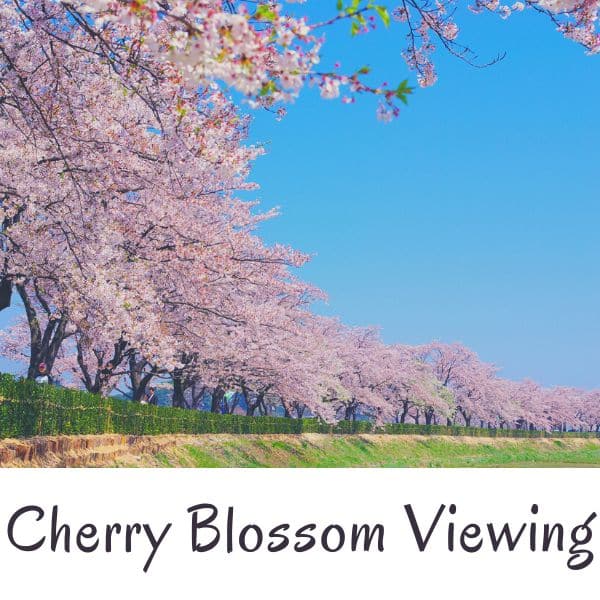
Cherry Blossom Festivals
The cherry blossom festivals in Korea occur in late March and early April and are some of the biggest festivals in Korea. People flock to forests, lakes, and rivers to see the pretty blossoms. The Jinhae Cherry Blossom Festival has over 2 million visitors each year, and even more people visit Seokchon Lake and Yeouido Hangang Park in Seoul. There are many festivals and tours to see cherry blossoms in Korea so you should be able to find a quiet place to enjoy the view.
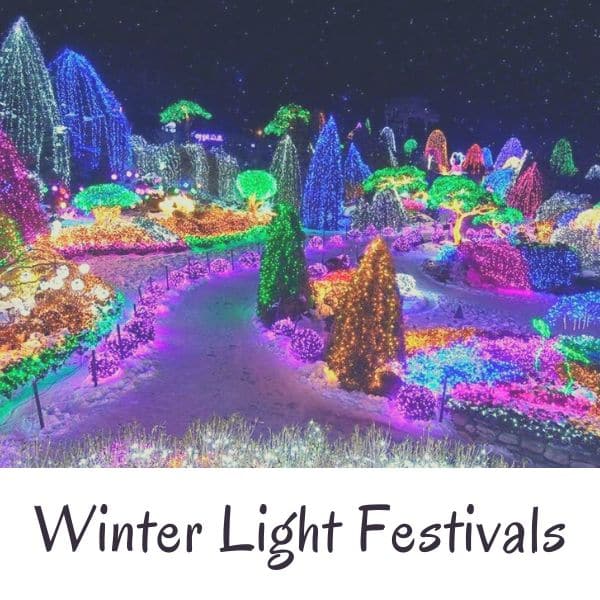
Winter Light Festivals
During the cold, dark days of winter, attractions such as Nami Island, the Garden of Morning Calm, and Herb Island transform into sparkling winter wonderlands with millions of bright lights illuminating them. There are also winter illumination festivals in Korean cities, such as the Haeundae Lighting Festival in Busan, Cheonggyecheon Stream Winter Lights in Seoul, and the Busan Christmas Tree Cultural Festival. When it snows in Korea, these festivals look even more magical.
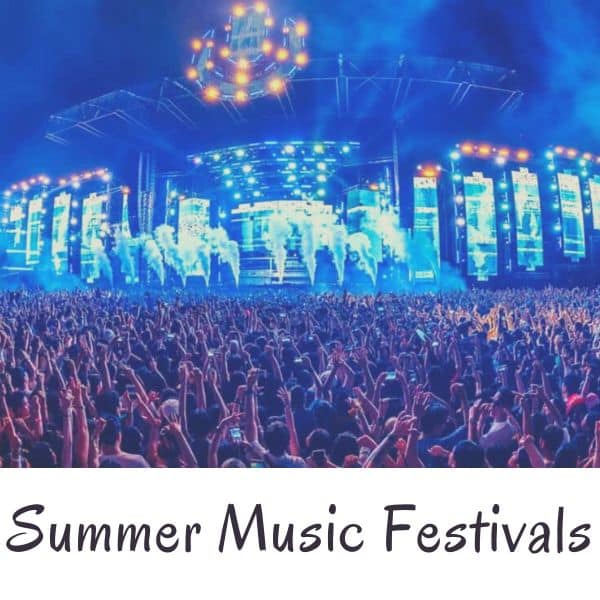
Summer Music Festivals
Summer in Korea is hot, but that doesn’t stop people enjoying day-long music festivals across the country. From chilled jazz festivals like the Seoul Jazz Festival , to action-packed concerts like Psy’s Summer Swag , there are music festivals to suit everyone. This is a popular summer activity in Korea , so be sure to book in advance for ticketed events. If you can’t get tickets, just go to a popular beach in the evening and you’ll usually find musicians performing.
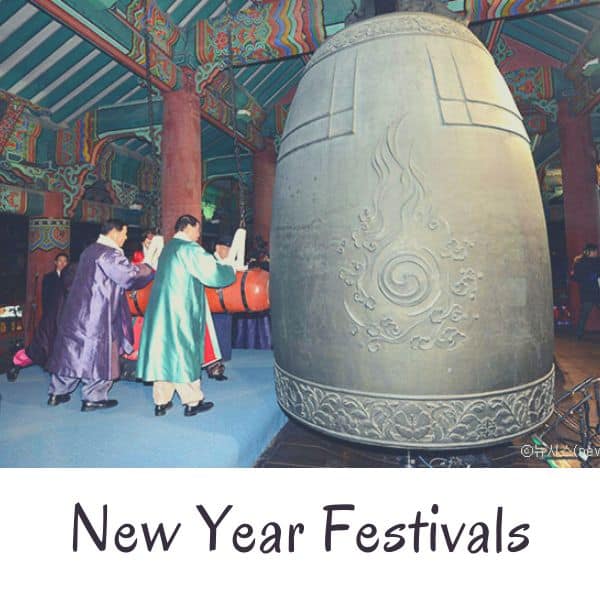
New Year Festivals
There are various festivals in Korea to celebrate the solar new year. New Year’s Eve festivals involve a bell-ringing ceremony where a giant bell is rung at midnight to welcome in the new year. Fireworks festivals are common events in cities across Korea, starting at midnight, too. Koreans celebrate the start of the new year by visiting the East Coast to see the first sunrise of the year at places like Homigot Sunrise Square or Seongsan Ilchulbong on Jeju Island.
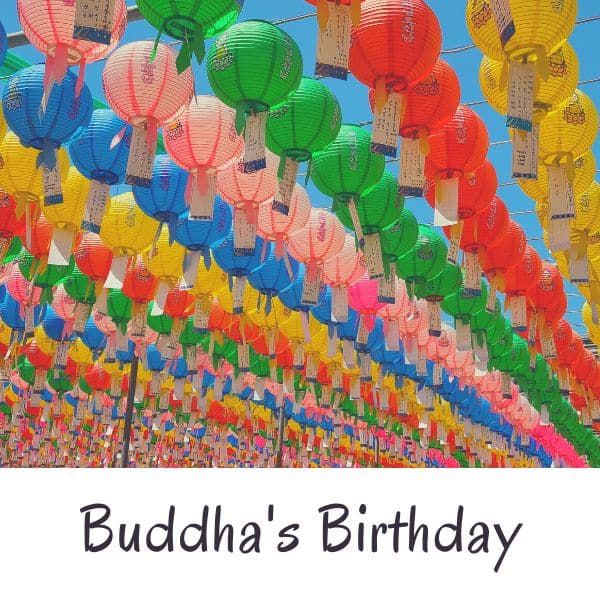
Buddha’s Birthday Festivals
Buddha’s Birthday is like Christmas for the Buddhist world, but celebrated very differently. It also falls on changing dates each year as it follows the lunar calendar, just like Korean New Year. Korean Buddhist temples across Korea will celebrate by putting up colourful lanterns and decorations for at least a month before the actual date. The biggest festival celebrating Buddha’s Birthday is the Yeon Deung Hoe Lantern Festival , which features thousands of lanterns and a lantern parade through central Seoul.
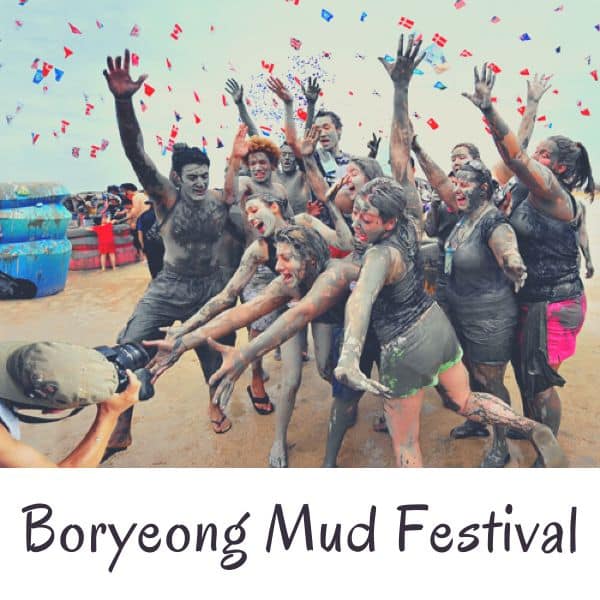
Boryeong Mud Festival
The Boryeong Mud Festival is one of Korea’s largest festivals and attracts visitors from around the world. Running for 2 weeks during rainy season, this is the best way to see a Korean festival even when the weather is bad. There’s a lot to see and do at this festival, including getting dirty in the mud with mud sports, mud wrestling, mud tug-of-war, and other mud-filled events. Boryeong is famous for the high-quality mud found in nearby waters and, by joining this festival, you’re getting a free mud facial.
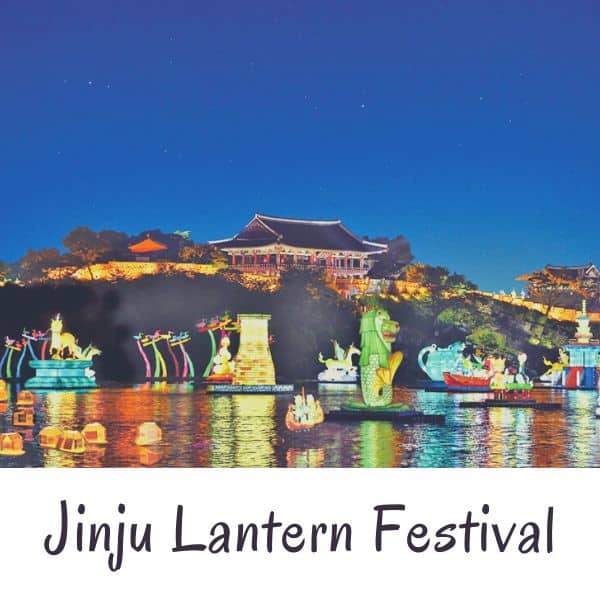
Jinju Lantern Festival
The visually stunning Jinju Lantern Festival is held in October each year in Jinju City and runs for several weeks. During the day, watch cultural performances and enjoy exploring the central fortress grounds of Jinju. Once it gets dark, see the city transform as thousands of lanterns, some as big as trees, come to life. There are so many weird and wonderful lanterns to discover at this festival. You can also set your own lanterns to float down the river with your wish inside.

Andong Mask Dance Festival
The Andong Mask Dance Festival in Andong, home of the Andong Hahoe Village, is a great opportunity to witness traditional Korean dance and music performances. Not only can you see traditional Korean performances during this 4 day festival, there are also international performers displaying their own culture’s dancing. Get hands-on with traditional Korean culture at this festival. Explore Andong and learn about its contributions to Korea’s cultural development.
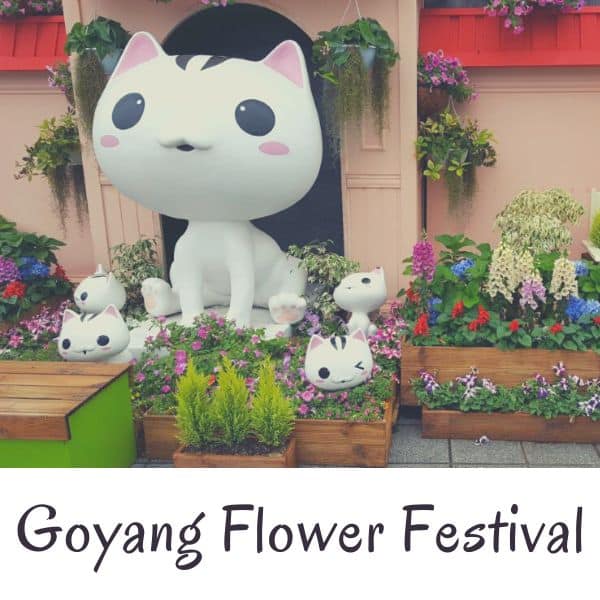
Goyang Flower Festival
The Goyang International Flower Festival runs twice per year, once in spring and once in autumn. It’s a beautiful celebration of floral beauty mixed with Korean cuteness and creativity. At this flower festival you can stroll through a maze of different displays, with each section focusing on certain flowers and plants. There are indoor displays with vividly coloured roses, nature-based outdoor photo zones, and the lovely Ilsan Lake Park in the background.
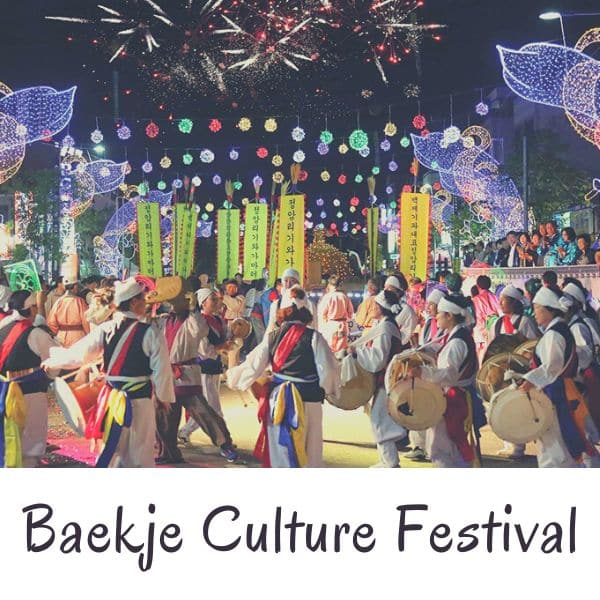
Baekje Culture Festival
The Baekje Culture Festival probably isn’t one that first-time travellers to Korea would know about. Held in Gongju and Buyeo, the two former capitals of the ancient Baekje Kingdom, this 10-day long festival held around Chuseok (Korean mid-autumn harvest festival), is packed with unique events and sights and is set in historic locations in each city. There’s local food to try, musical & cultural performances, fun photo zones, lantern displays, and much more.
Knowing when you plan to visit Korea will help you research what festivals are on and what the weather will be like. There are certainly a lot more than just the ones mentioned above, including some others mentioned previously in the seasons part of this South Korea travel guide.
I recommend using a tour company to see out of the way festivals like the Jinju Lantern Festival and the Jinhae Cherry Blossom Festival. These are often far from typical tourist destinations and can take hours to get to by public transport. Tours are worth the cost to save you time and avoid hassle.
Recommended Itinerary For Korea In 2024
In this section of this South Korea travel guide is my recommended first-timer itinerary for South Korea. This introduces you to two of Korea’s biggest cities, as well as a couple of day trips to highly rated destinations in Korea. There’s a mix of history, culture, nature, sights, and experiences.
This itinerary starts in Seoul as that’s where most people arrive to Korea after flying into Incheon Airport. If you arrive in Busan, you can change the route to start and end there instead. For travellers to Korea with only 2 or 3 days, I recommend using the first few days of this itinerary instead.
The itinerary lasts for one week, which isn’t enough time to see all of Korea, but enough time to get a feel for the country. If you have more time, use this itinerary and add in or replace extra destinations as you like. Jeju Island is certainly worth visiting if you have an extra 2 or 3 days.
Classic Sights Of Korea Itinerary
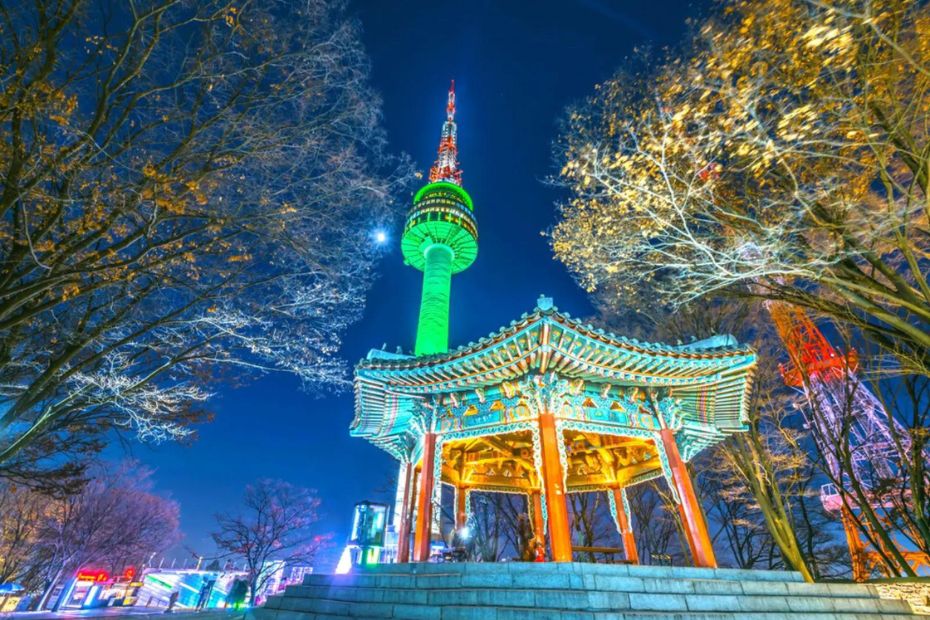
This itinerary covers a few must-see sights in Korea, including the two largest cities, the history city of Gyeongju, and some popular day trip destinations from Seoul.
Day 1 : Arrive in Seoul and explore Gyeongbokgung Palace, Bukchon Hanok Village, Insadong Art Street, Jogyesa Temple, and Cheonggyecheon Stream. Get dinner at the Jonggak Avenue of Youth for authentic Korean food that’s better than the touristy places in Myeongdong.
Day 2 : Learn about Korean history at the War Memorial of Korea or National Museum of Korea, explore Seoul’s traditional Gwangjang market in Dongdaemun, take the cable car to the N Seoul Tower for sunset & night views, then head down to Itaewon or Myeongdong for dinner & drinks.
Day 3 : Take a day trip to Gapyeong and visit Nami Island, the Garden of Morning Calm, and the Gapyeong Rail Bike Park. Return to Seoul for dinner and rooftop drinks in Myeongdong and then walk along the fortress walls from Dongdaemun Station if the weather is good.
Day 4 : Take the KTX to Busan, drop your bags, and take the subway to Nampo-dong for Jagalchi Fish Market, Bosu-dong Book Alley, and traditional sights. Take a taxi to Huinnyeoul Culture Village. End the day in Haeundae for evening dinner & drinks and a walk along the beach at night.
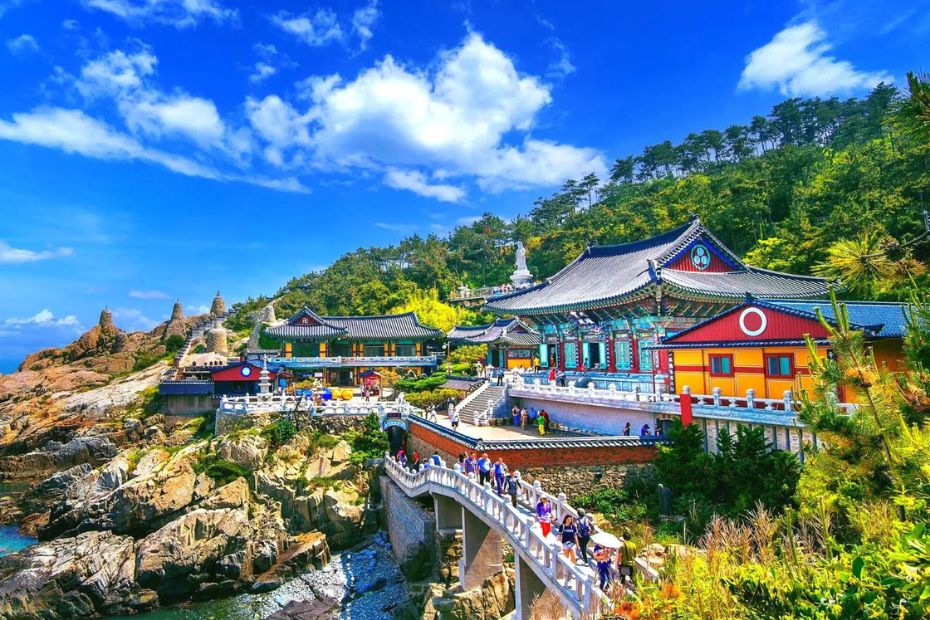
Day 5 : Take the bus to Haedong Yonggungsa Temple, then a taxi to Songjeong Beach. Relax in a beachside cafe, then take the Haeundae Beach Train to Cheongsapo, change to the Sky Capsule, and end up in Haeundae. Take a bus to Gamcheon Culture Village and get dinner at Songdo Beach.
Day 6 : Take a day trip from Busan to the UNESCO World Heritage City of Gyeongju. Visit the Gyeongju Historic Area, then Gyeongju Gyochon Traditional Village for traditional food and sights of Woljeonggyo Bridge. See tranquil night views of Wolji Pond before getting dinner at Hwangnidangil.
Day 7 : Head back to Seoul on the KTX for a final day of shopping and sightseeing in Hongdae. Walk along the Gyeongui Line Forest Park or Book Street or visit a theme cafe. Take the subway directly to Incheon Airport from Hongdae or spend a night here and check out the lively night scene.
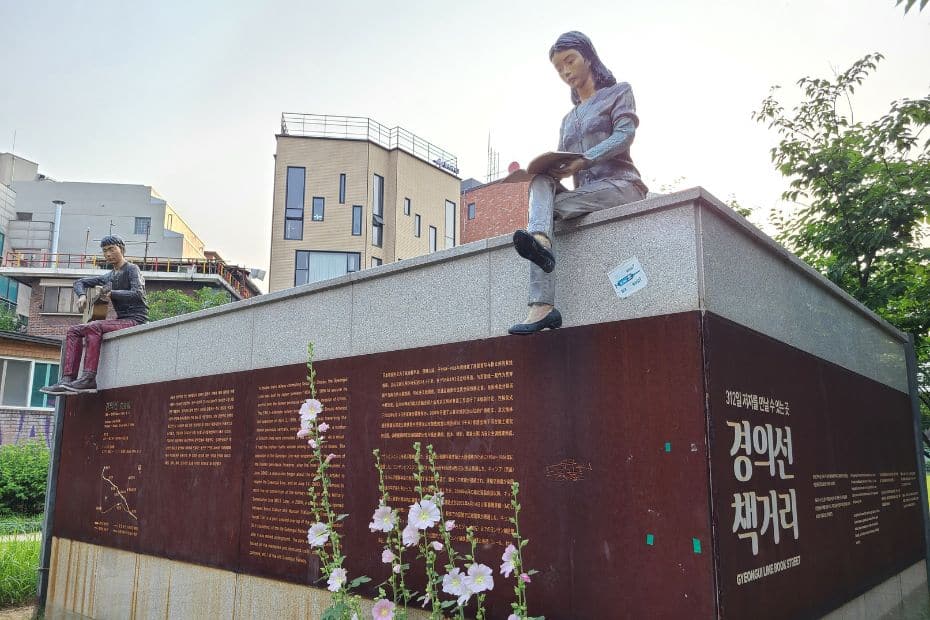
Please note : I recommend trying not to cram too much into your itinerary. You may want to see as much as possible, but people often end up rushing past sights and not appreciating them. Plan for less and see more if you have time. It gives you a chance to be spontaneous.
To plan a realistic itinerary for South Korea, it is important to factor in transportation, meal breaks, and rest times. Use Naver Maps to plan your route and work out travel times. A short journey on the map might take much longer if there’s no direct route. Also consider breaks if you plan to walk a lot.
Cultural Issues When Visiting Korea
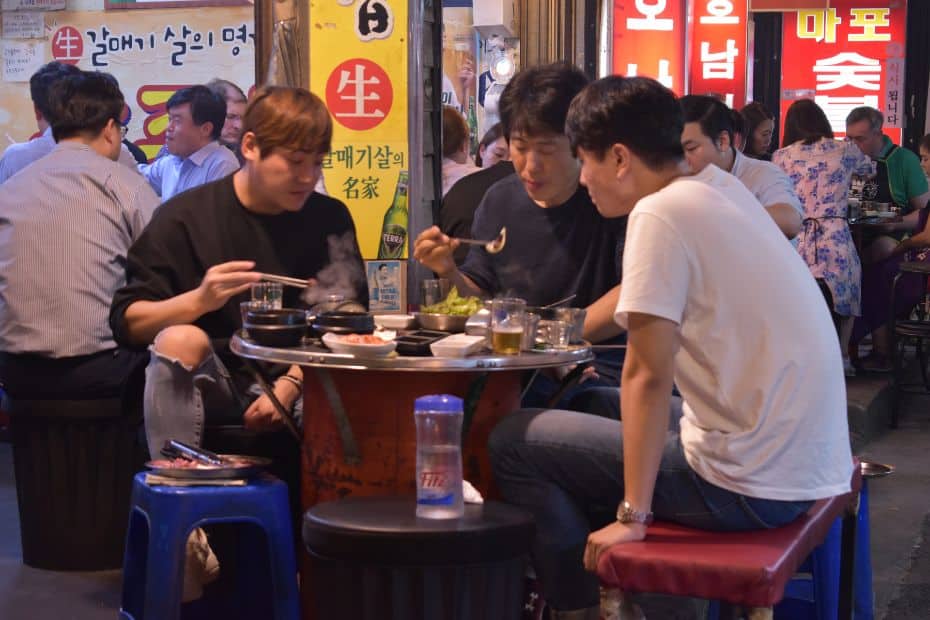
The next few sections of this South Korea travel guide will provide answers to some of the most common questions first-time travellers to Korea have in regards to cultural, language, and safety issues. Korea is a culturally unique country with customs and traditions you might not be aware of.
Korea is a society that places a strong emphasis on social image, respect for others, and social harmony. This means Koreans will often try to avoid conflict, especially in public. To show respect for Korean culture and to avoid being rude, try to respect social harmony and always avoid conflict.
If you follow these tips, you’ll find it easier to avoid accidentally upsetting someone in Korea. There’s far too much to cover in this South Korea travel guide, so if you’d like to know more, check out my detailed guide to Korean etiquette and culture , it’s packed with tips and insights to understand Korea.
What is considered rude in Korea? It is considered rude to point with one finger or with chopsticks, give and receive with one hand, cross your legs when sitting, and to walk inside with your shoes on. Things considered rude in other countries such as swearing and spitting are also rude in Korea.
What is considered unlucky in Korea? It is considered unlucky to write someone’s name in red ink and to stand chopsticks upright in rice. Both are used in rituals for deceased people. The number 4 is also unlucky as the word is the same as the word for ‘death’.
Do you need to tip in Korea? It’s not necessary to tip in Korea and most restaurants and cafes won’t expect or allow you to tip. There is no service charge added to bills in Korea, with the exception of some upmarket restaurants, bars, and hotels in touristy areas of Seoul. Tipping guides is okay.
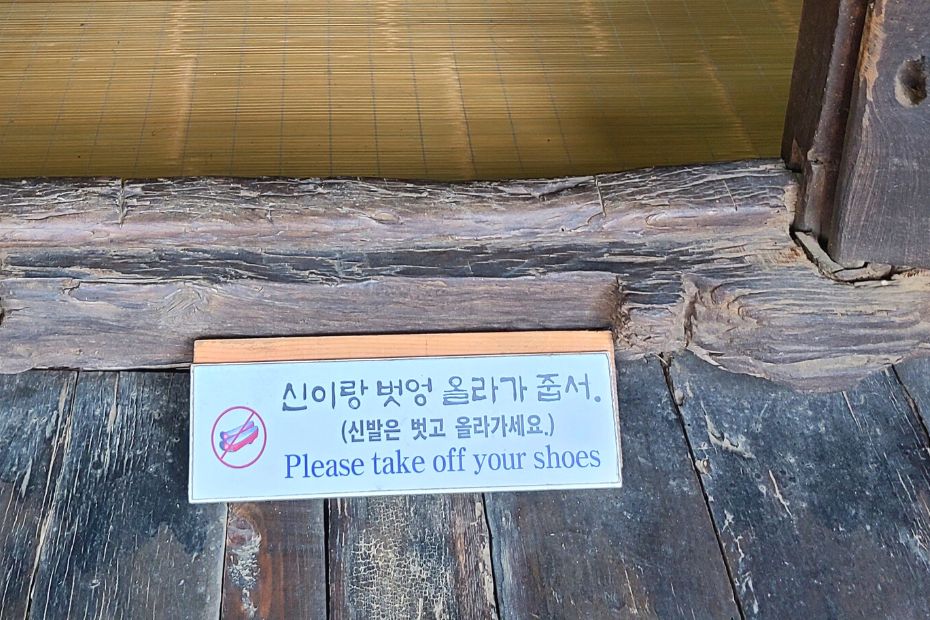
Do you need to take off shoes when going inside? If you enter someone’s house in Korea, you should take off your shoes. This rule also applies to temples, traditional restaurants, and other places in traditional buildings. Most cafes, shops, and restaurants won’t ask you to take off your shoes.
When should you use two hands in Korea? You should use two hands when giving and receiving things in Korea, such as money, a gift, a business card, or food. When you shake hands, use both hands, not just one. The same applies to pouring drinks, both pouring and holding a glass.
Do I have to act like a Korean in Korea? You don’t have to follow Korean customs and traditions when you visit Korea. You are a guest in the country and Koreans won’t expect you to know every rule. However, showing cultural awareness in Korea will help you make friends and impress locals.
The best tip for being culturally sensitive in Korea is to first consider all the things that you’d consider rude in your own country – spitting, swearing, shouting, physical violence, etc. Show the same acts of kindness you’d show at home – help others, give up your seat for those in need, be polite, etc.
Furthermore, remember that social harmony is really important in Korea and try not to cause a scene. Keep your voice down in public, don’t talk or act aggressively, be polite, and don’t force things when people are reluctant. Koreans may feel obliged to do things, even when they don’t want to.
Language Issues When Travelling Korea
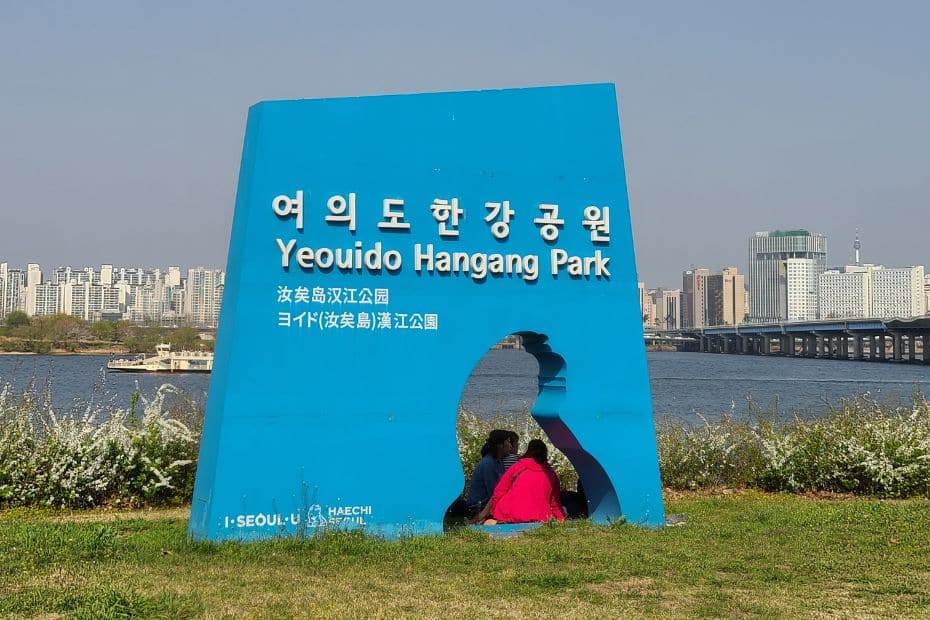
Language issues can be a big concern for first-time travellers to Korea as Korean is a very different language from English and has a unique alphabet. Korean is also one of the most difficult languages to learn for English speakers, ranked alongside Japanese, Chinese, and Arabic.
However, as a tourist to Korea, you don’t need to worry about mastering the language. English is used for signs and announcements in most places that you’ll need it, such as on public transport, at the airport, at attractions & tourist sites, on menus, and most other places. It’s common across Korea.
If there is a sign or notice that isn’t in Korean, I recommend using the Papago app to take translate it. Use the image translation function in the app to scan the sign and Papago will translate it into English for you. It’s really convenient and the way I translate things I can’t read in Korean.
Do Korean People Speak English?
Speaking in English to Korean people is different from being able to read and translate signs. English is taught from elementary school until the end of high school. That doesn’t mean everyone will remember it, but there’s a good chance some people will know English, especially younger Koreans.
It is best to ask if someone speaks English before trying to have a conversation. You can do this in Korean by asking “영어 할 수 있어요?” (Yong-oh hal su iss-o-yo?) or just ask it in English. Tour guides and people in the tourism industry will probably be able to speak English, but it’s not guaranteed.
Shyness is an issue in Korea and locals may be reluctant to speak English at first for fear of making a mistake. As an English teacher in Korea, I know that Korean students are usually quite competent in English, but lack confidence to use it. Be patient and encouraging when talking in English.
Although some Koreans may be too shy to use English, other people may be enthusiastic about speaking English to you and want to practice it. I’ve been asked random questions in English by strangers in the street in Korea who want to practice English and find out about my life.
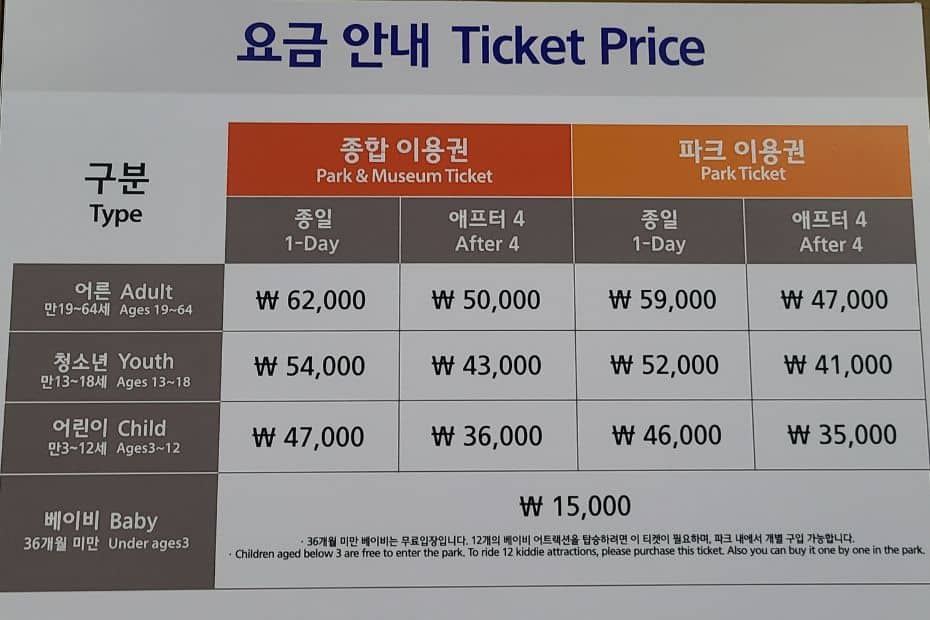
Should You Learn Korean Before Visiting Korea?
If you do want to learn some Korean before you travel, I recommend you start by learning the Korean alphabet , or at least learning some basic Korean travel phrases . Knowing how to introduce yourself, discuss prices, ask for directions, and ask for help will make your trip to Korea a lot easier.
You can learn Korean online through courses such as 90 Day Korean and Korean Class 101 , or with self-study textbooks like the excellent Talk To Me In Korean series. There are lots of resources on YouTube, too. I particularly like Learn Korean with GO! Korean Billy as he explains things clearly.
Another way to prepare to move to Korea is to read some Korean novels in English . Although these books won’t teach you any Korean, they’ll offer up valuable insights into Korean culture, both traditional and hidden under the surface. Literature is a good way to gain an understanding of a culture.
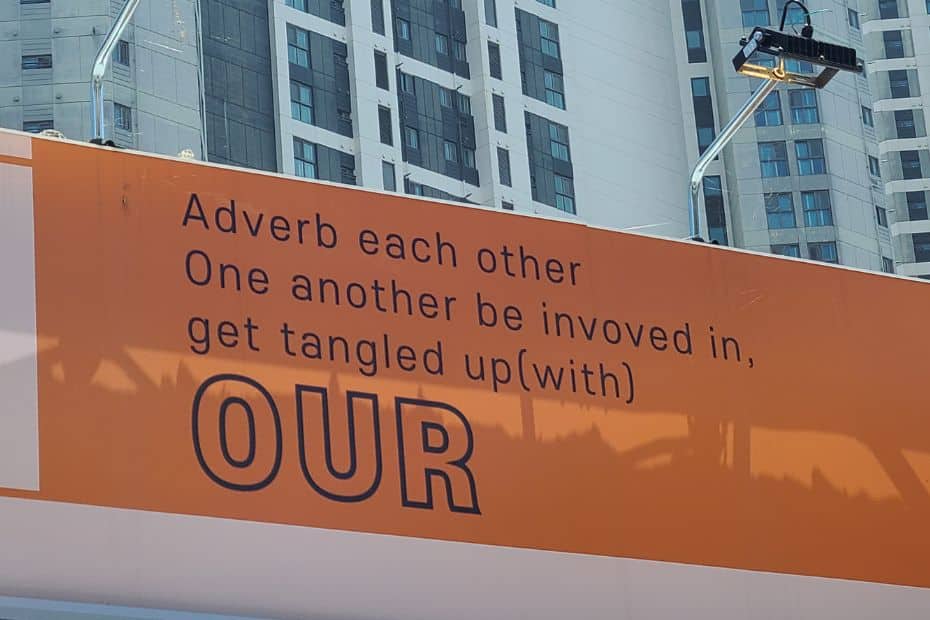
A warning about Konglish : Although Korea uses English in many useful ways, there’s also a lot of Konglish. The sign above is a good example of random English words being used to look cool, but ending up being confusing. There’s a lot of this in Korea and it’s mostly harmless, so don’t worry.
Health And Safety Issues In Korea

First-time travellers to Korea may be worried about health and hygiene issues, such as if certain foods are available and if they’re safe to eat. Other issues include vaccinations, personal safety, and how easy it is to contact emergency services. These issues are addressed below.
Is Korean Street Food Safe To Eat?
Korean street food is generally safe to eat and won’t give you any health issues unless you have an intolerance to the food. Korean street food can be spicy or contain a lot of salt, be aware of your own personal tolerances and dietary requirements before trying it.
Also be careful when ordering food with meat or seafood and check that it is cooked thoroughly. Korean street food that has been left out for a long time is more likely to cause food poisoning problems, so ask for freshly cooked food if you’re concerned.
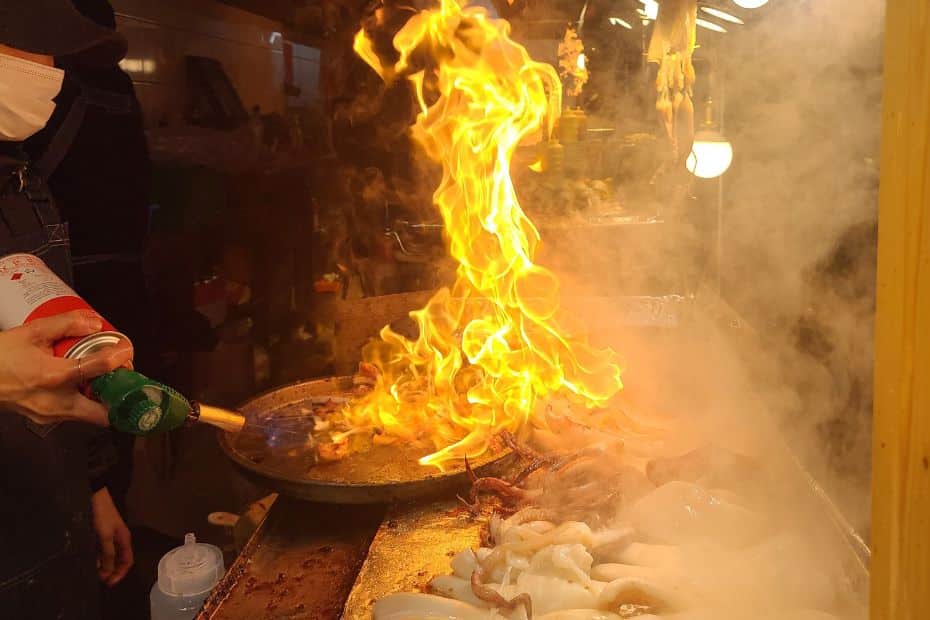
Is It Easy To Find Vegan-Friendly Food In Korea?
There are many vegan-friendly Korean dishes , such as gimbap , japchae , pajeon , bibimbap , ramyeon , and tteokbokki . However, some restaurants may use non vegan-friendly ingredients when preparing these foods, so be careful. Kimchi isn’t vegan-friendly due to its seafood ingredients & sauces.
Vegetarianism and veganism aren’t common in Korea with fewer people following these diets than in countries such as the USA or UK. Vegetarians in Korea account for 3% of the population, while vegans in Korea are only 0.2% of the population as of 2022. The UK is 10% and 2% respectively.
However, the number of vegan-friendly restaurants and bakeries is increasing each year in Korea, especially in areas such as Hongdae and Itaewon. Korean Buddhist temple food is vegan-friendly and a good option for vegans who want to enjoy vegan food while learning about local Korean culture.
If you’re concerned about accidentally ordering non vegan-friendly food, or want to know how to tell someone about food allergies or requirements, check out my guide to Korean phrases for ordering food . This has a whole section about special requests when ordering food in Korean.
Is It Safe To Drink Tap Water In Korea?
Korean tap water is potable and safe to drink. Korea ranks 23rd for water hygiene, which is above the USA, Canada, and Australia. However, many Koreans don’t drink tap water , preferring to use water purifiers and bottled water instead, claiming that tap water smells strange or water pipes are bad.
Personally, I don’t like drinking tap water in Korea as it tastes a bit stale, but it’s perfectly fine to drink and doesn’t cause any problems. Bottled water is very cheap in Korea and costs 600 KRW for a 500ml bottle from a convenience store. Buying water from a supermarket is a cheaper option though.
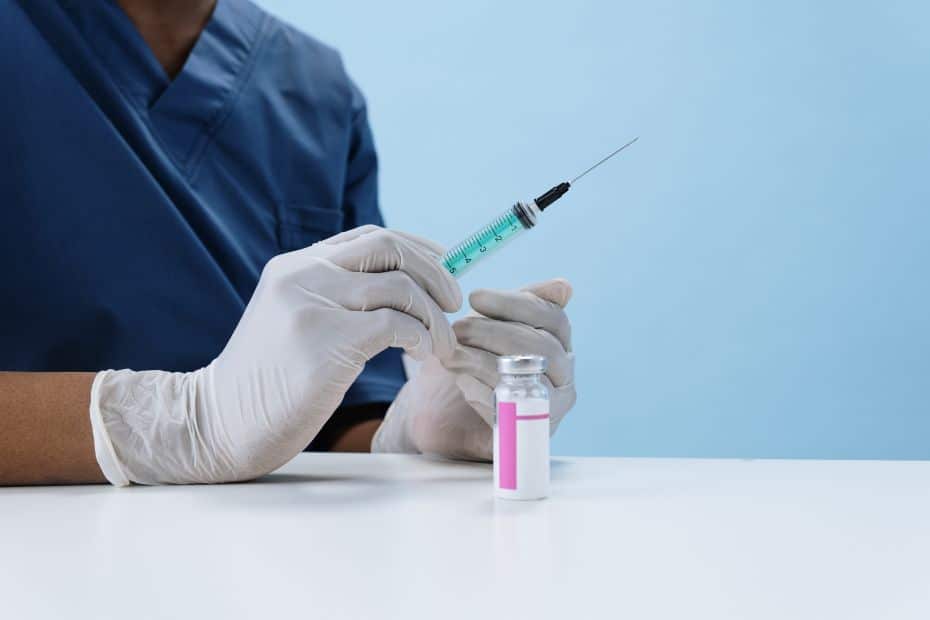
Do You Need Any Vaccinations To Travel To South Korea?
There are no mandatory vaccinations required to travel to Korea , but it is suggested you should have at least routine vaccinations such as tetanus, MMR, and polio. Hepatitis A & B, typhoid, and Japanese encephalitis vaccinations are also recommended.
Is Korea Friendly To Tourists?
Korea is generally friendly and welcoming to tourists. The Korean government spends a lot of money and effort to promote Korean tourism to the world and there are many incentives to bring people to the country. Korean people are also mostly polite and welcoming, especially in the tourism sector.
Is Korea A Dangerous Country To Travel In?
South Korea is a safe country to travel in and the crime rate in Korea is low, comparable to Norway or the Netherlands. Public crimes, such as theft and assault, are rare. Pickpocketing and purse snatching aren’t common and unattended goods are generally left alone or reported to the police.
How safe is Korea? I regularly see people leave their phone or handbag on a cafe table to reserve it before going up to order a drink. People even leave their laptops open while they pop out for lunch or go to the toilet. Stealing disturbs social harmony and is one of the reasons it’s rare in Korea.
Physical violence is also rare, but still occurs in Korea, as it does in all countries. This is most often found in areas with lots of bars and when people are drunk. However, visiting bars in Korea is a lot safer than I’ve experienced in other countries and trouble is not common, even in busy places.
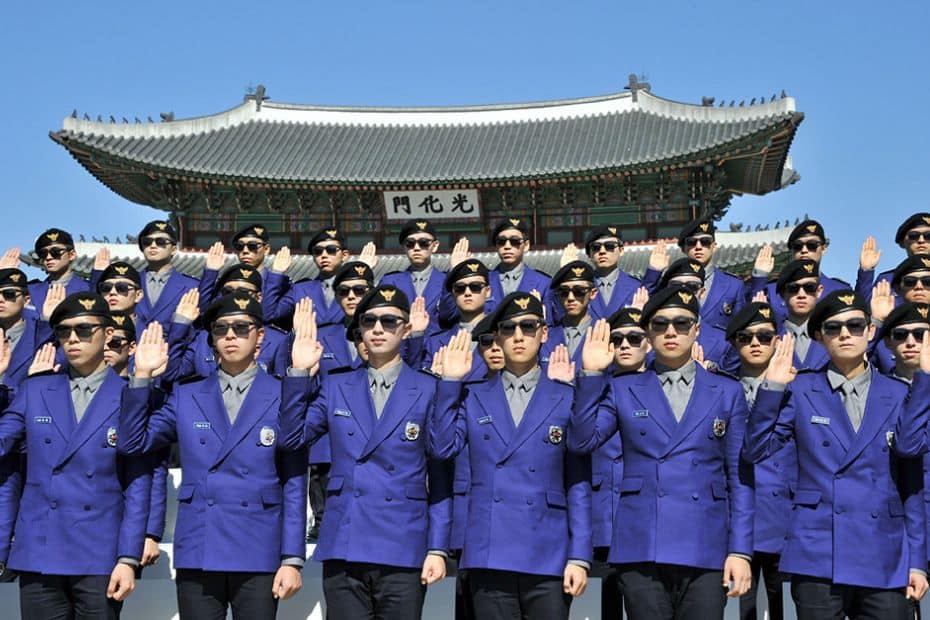
How Do You Contact Tourist Information Services In Korea?
Call 1330 in Korea to contact the Travel Helpline . The Korean Travel Helpline provides the following services free of charge to tourists in Korea.
- Tourist Information : Find out about attractions, opening hours, prices, and other information.
- Tourist Interpretation : Access travel information in several languages.
- Tourist Complaints : Report rip-offs and problems you encounter when travelling in Korea.
- Tourist Police : Report minor crimes in English and other languanges.
There are tourist police patrolling the streets of Seoul, dressed in purple uniforms as shown in the picture above. In popular tourist locations like Myeongdong and Bukchon Hanok Village, you’ll also find friendly tourist information staff dressed in red shirts with matching red cowboy hats.
What Should You Do If You Have An Emergency In Korea?
If you need to report a fire or medical emergency in Korea, you should call 119 from any phone. To contact the police in Korea, call 112. You will need to select an option to report an emergency in English or another language. It may take some time to be redirected to an English speaker.
- 119 – Medical Emergency & Fire Rescue
- 112 – Police
When you use medical services in Korea, you have to pay the cost of treatment, but there is no fee for the ambulance ride as this is covered by the Korean government. Travel insurance should cover the cost of medical bills, so if you’re worried about a large medical bill, insurance is recommended.
Fortunately, the cost of treatment in Korea is quite reasonable and Korea has advanced medical facilities, which is why it’s a popular medical tourism destination . Many people travel to Korea for minor and major surgery, including laser eye surgery, cosmetic surgery, and internal medicine.
Is Air Pollution A Problem In Korea?
Air pollution is an issue in Korea, especially in spring & summer. Winds blow yellow dust from Central Asia, field burning spreads fumes across Asia, and fossil-fuel burning contributes to higher levels of air pollution. Some days there’ll be very low visibility and health risks for people with lung problems.
My Personal Travel Tips For Korea
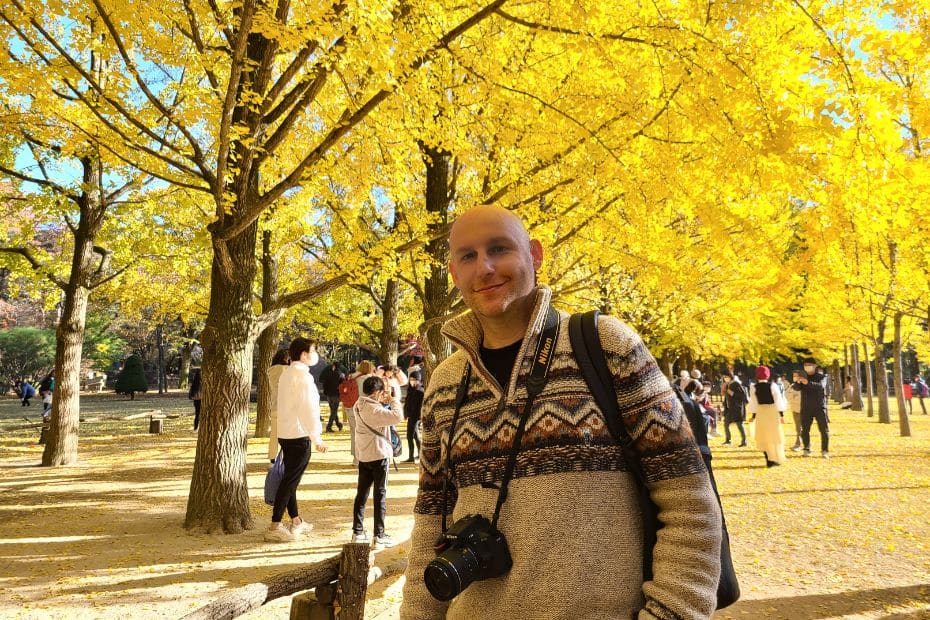
This South Korea travel guide is a collection of information I’ve researched and learned since moving to Korea in 2015 and blogging about Korean travel since 2019. I hope the provided information and insights are useful and assist you plan your dream first-time, or even tenth-time, trip to Korea.
This section includes my personal tips that didn’t really fit anywhere else and reflections built from travelling all over Korea in all seasons. These are tips I would offer to first-time travellers to Korea and people who might have some worries about visiting the Land of Morning Calm. I hope they help.
The Real Korea Isn’t What You See On TV
Korea is a developed country that went from being a 3rd world country in the mid 20th Century to a high-tech country in a short time. Despite the many high-rises and modern K-Pop stars, there are still shadows of the former Korea seen in both run-down slums and people with ‘traditional’ values.
The image created by selective K-Culture can distort people’s reality when dreaming of a trip to Korea in the same way Korean people can suffer from Paris Syndrome when visiting France. There are many wonderful things about Korea, but don’t travel thinking that everything is as shown on TV.
Be Prepared For Culture Shock
One of the best things about travelling is seeing a country and people that act and behave differently to how you do in your own country. This is known as culture shock and can be both a blessing and a challenge for first-time travellers to Korea. Things you might be used to can be different in Korea.
Some examples of culture shock in Korea include the way age determines hierarchy in Korea and how older people can be rather pushy, especially on the subway. Younger people also typically don’t question the decisions of older people in Korea as it is considered rude and disrespectful.
Less extreme cultural differences that might confuse some first-time visitors to Korea include having to shout to call someone to take your order in a Korean restaurant or not giving a tip. Koreans might similarly look at you strangely if you do something culturally different, such as walking while drinking.
Don’t Overpack When You Travel To Korea
First-time travellers to Korea may be worried about visiting a country like Korea without taking everything they need from home, even the kitchen sink. My advice is to pack as light as possible and leave yourself some space in your suitcase. There are two reasons for this.
- You can buy most things you need in Korea . This includes sun cream, heat packs, clothes, shoes, cosmetics, travel accessories, etc. They’re also probably cheaper in Korea, too.
- You will want to take home lots of things . From weird Korean snacks to beautiful hand-crafted pottery and woodwork, there are so many things to buy in Korea.
(1) The only exception is if you might have a problem finding correct-fitting items. Korean shoes and clothes are slightly smaller than what you’d find in Western countries and the sizes are also differently labelled. I’m a medium in the UK but a large (sometimes XL!) in Korea. Be careful when shopping.
(2) It’s hard to fit everything you buy in Korea into an already full suitcase. Fortunately, you can buy extra suitcases at low prices. Check out Namdaemun Market for cheap luggage options, as well as shops like the one pictured below (this is in Busan) in places like Hongdae and Dongdaemun.
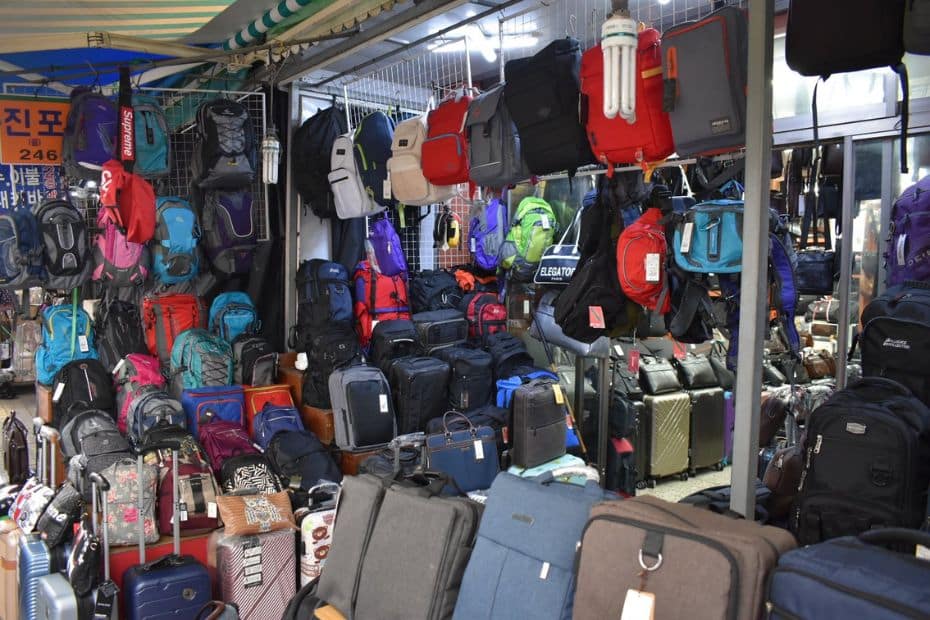
Electricity In South Korea
Be careful with electric items when travelling to Korea. Korea uses type C and F plugs , which are used in Europe, Russia, and other parts of Asia. The standard voltage is 220V with 60Hz frequency. Anything designed for a standard voltage between 220V and 240V should be fine in Korea.
Laptops, mobile phones, and other portable devices will be fine when you travel in Korea as long as you use a travel adapter with a USB or socket connection. Hairdryers, shavers, curlers, and similar devices might have problems charging in Korea and run out of power very soon. My shaver did.
Go With The Flow And Go Quickly
Korea is a very busy country and you might hear people mutter ‘빨리빨리’ ( ppalli ppalli ) if you walk slowly, especially in the subway. Koreans work long hours and are eager to get home or go out for dinner. Don’t take it personally if people push past you and don’t feel like you have to rush.
Know Where To Throw Away Rubbish
It can be difficult to find a bin to throw away rubbish in Korea, even in urban areas. The best place to dispose of rubbish in Korea is at a convenience store. You can find recycling and trash bins in these shops. If you go hiking or explore the countryside, expect to carry your rubbish home with you.
South Korea Travel Guide FAQs
Finally, here’s a few FAQs about this South Korea travel guide, in case the above information didn’t cover enough for you.
What is the best month to visit South Korea?
The best months to visit South Korea are April and October. April is warm and you can see cherry blossoms in Seoul at the start of the month. October is warm with clear skies. During October you can see autumn foliage across Korea.
How much money is enough for South Korea?
The amount of money you need to travel in South Korea depends on your travel style and desired level of comfort. A rough budget for South Korea is 50-100,000 KRW per day for budget travellers, 100-200,000 KRW per day for mid-range travellers, and 200,000+ KRW per day for luxury travellers.
Is South Korea friendly to tourists?
South Korea is a welcoming country and friendly to tourists. There are many services to welcome tourists to South Korea, including free transit tours from Incheon Airport, cultural performances in tourist destinations, low entry fees to traditional attractions like Gyeongbokgung Palace, and tourist information and signs in multiple languages.
What do I need to know before travelling to South Korea?
It’s important to know about the weather before travelling to South Korea as this can impact your day to day travel and affect what clothes you’ll need. You should also research what festivals are on before you travel, what seasonal events are happening, such as cherry blossom viewing, and also how to use public transport and get connected to the net.
What is the cheapest month to visit South Korea?
January and February are two of the cheapest months to visit South Korea and are considered low season as the weather is cold. Hotel prices and flights to Korea will be lower in these months. Winter is a good time to travel to Korea to see snow and enjoy winter sports and festivals, however, some attractions will be closed during this time of year.
Do I need a South Korea travel guide?
It is good to check a South Korea travel guide to research your trip, especially for first-time travellers to Korea. Korea has a unique culture, language, and customs that might be confusing for new travellers. A South Korea travel guide will help you prepare for these factors and give you ideas to create your perfect trip to Korea.
Can you drink tap water in Korea?
Korean tap water is potable and safe to drink. You can drink water from hotels and apartments in Korea. Restaurants and cafes will provide you with free drinking water, which usually comes from a water cooler. Bottled water is available from convenience stores and is reasonably priced.
Is South Korea safe for first-time travellers?
South Korea is a safe country for first-time travellers to visit. Personal crimes, such as theft, mugging, and physical violence are rare in Korea and it is safe to walk the streets of Seoul, even at night. First-time travellers can prepare for a trip to South Korea by being aware of potential scams, such as taxi drivers over charging them or being ripped off in the traditional markets.
What are the best apps for travelling in South Korea?
The best apps for travelling to South Korea are Papago, Kakao Taxi, Naver Maps, and Seoul Subway. These apps will allow you to translate between Korean and English, hail taxis, and navigate as you travel. All of these apps have English language options and are free to use.
Support In My Korea Thanks for reading. If you want to help me to create more great content in the future, why not buy me a coffee? A strong coffee helps me write more and is a simple way to show gratitude for this free content.

Liked This? Pin It For Others
If you enjoyed reading this article, then please share this with your friends on Pinterest.
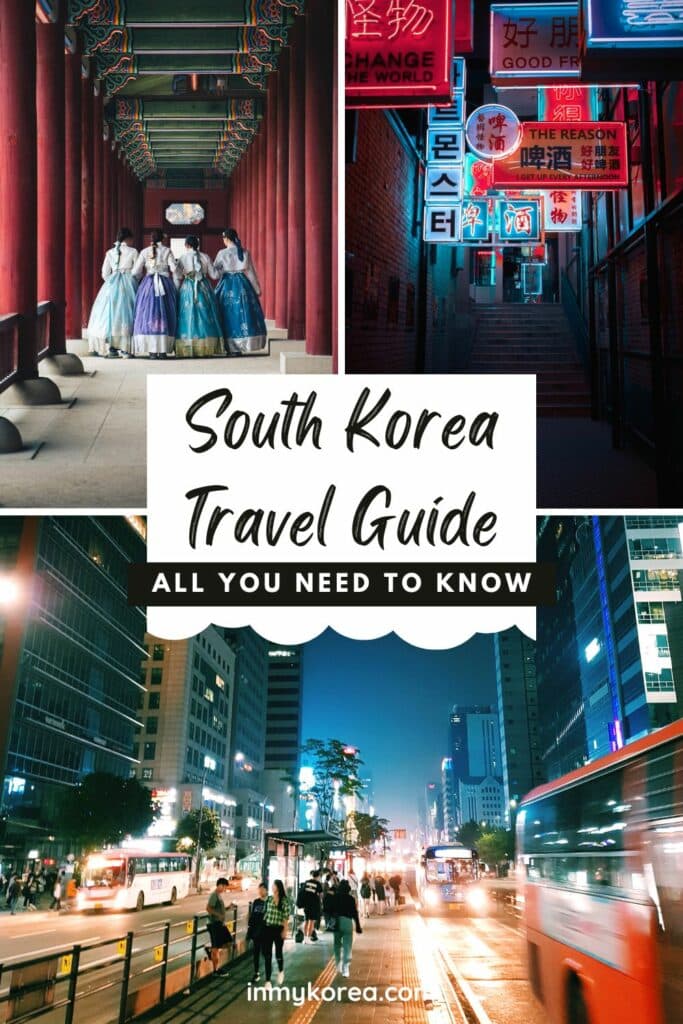
Related Articles
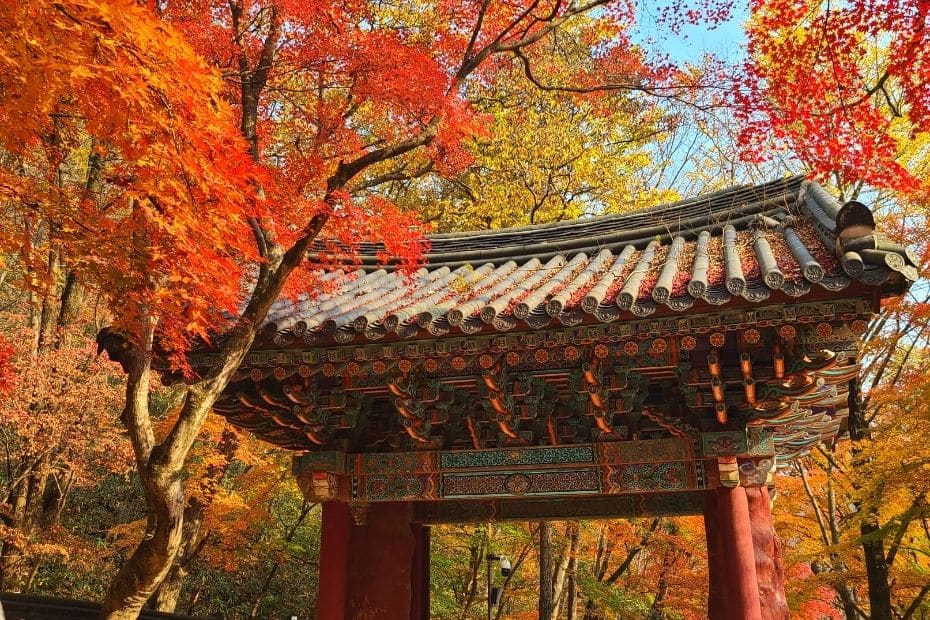
Beautiful Korean Autumn Leaves Pictures: Best Foliage 2024
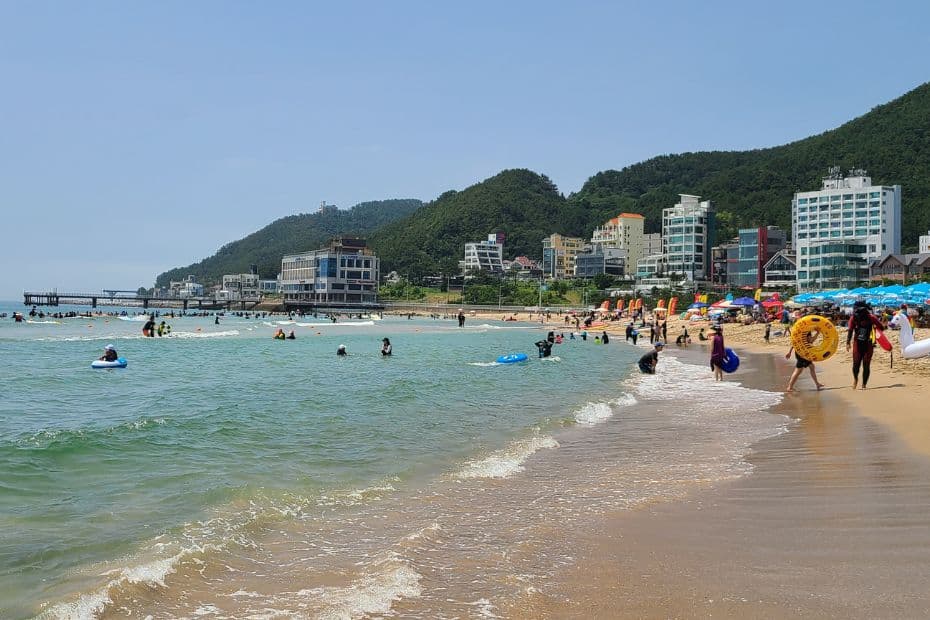
20 Cool Summer Activities In Korea: Korean Summer 2024
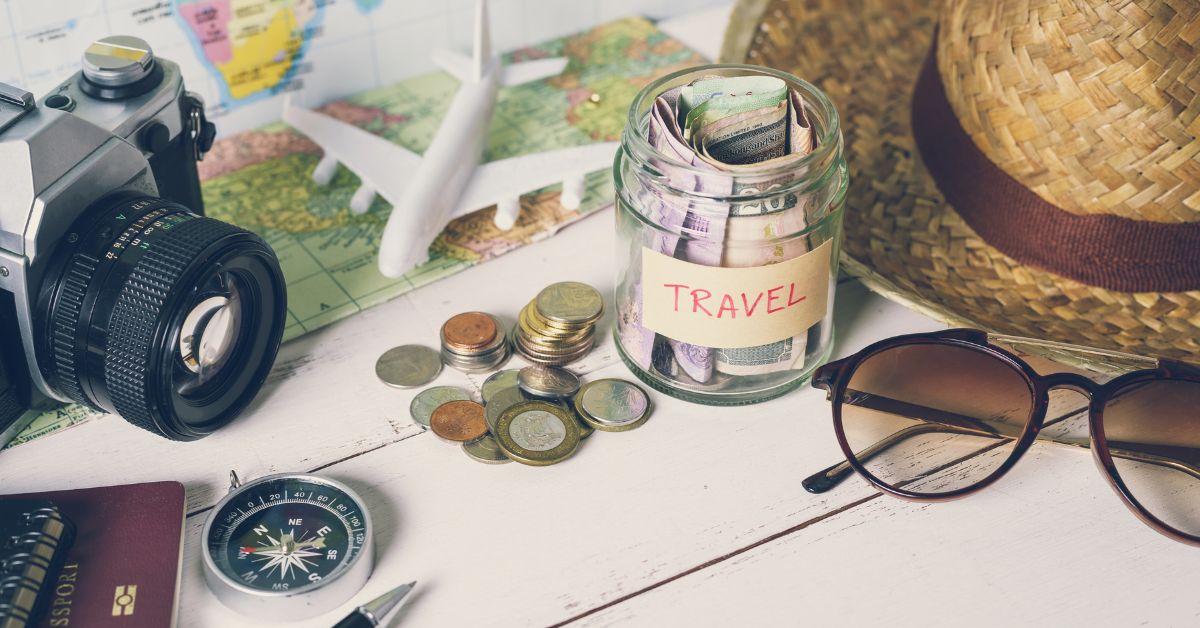
How To Pay In Korea: Cash, Card And Other Payment Methods
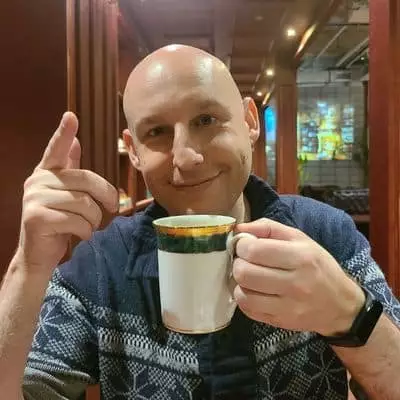
Hi! My name is Joel, I'm the author of In My Korea and writer of this article. I've lived, worked and travelled in Korea since 2015 and want to share my insights, stories and tips to help you have the best experience during your trip to Korea.
I love learning more about Korean culture, hiking the many mountains, and visiting all the coolest places in Korea, both modern and traditional. If you want to know more about my story, check out the ' about me ' section to learn why I love living in Korea.
4 thoughts on “Complete South Korea Travel Guide 2024: Korean Travel Tips”
This South Korea travel guide is a comprehensive resource for anyone planning a trip to Korea. It covers everything from entry requirements and travel tips to accommodation options and places to visit. Whether you’re a first-time traveler or have been to Korea before, this guide has something for everyone. The inclusion of the latest travel news and COVID-related updates adds to its relevance and usefulness. I appreciate the detailed breakdown of sections and the inclusion of quick links for easy navigation. Overall, this guide is a valuable tool for anyone looking to explore the wonders of South Korea.
Moderator – Nice Article! In My Korea
Thank for the great info! Could you please recommend any tours agency for a few day trips around Korea? I found a few , but they are pretty pricey!
Hi, thanks for reading. Klook and Viator have a good selection of tours in Korea with some of the best prices on the market. I’m not sure which tours you’re looking for, but they usually do day trips for less than $100 per day that cover popular tourist sights.
Leave a comment Cancel reply
Save my name, email, and website in this browser for the next time I comment.
16 things to know before heading to South Korea

Feb 18, 2024 • 10 min read
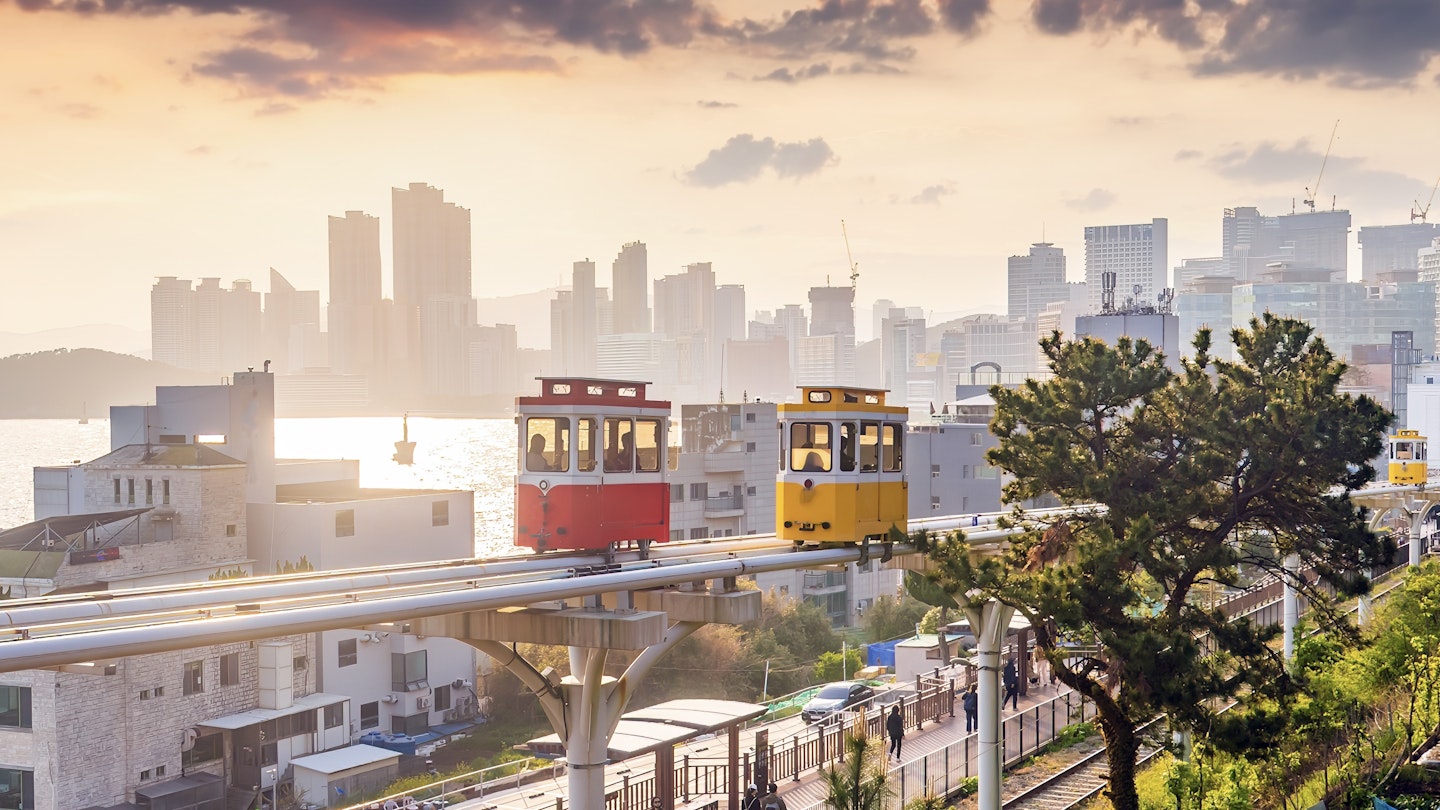
South Korea’s public-transport choices – including Busan’s Sky Capsule – are the envy of the world. As you plan your trip, count on using the nationwide network © By f11photo / Shutterstock
Has any place been on a run of late like South Korea ?
The country is on the lips of travelers around the world, thanks to its cutting-edge technology, world-class cuisine, chart-topping pop bands and some of the most exciting movies and TV series being made anywhere.
Add to all this centuries of tradition and copious natural blessings, all in a country scarcely larger than Ireland, and you’ve got one of the planet’s great travel destinations.
Safe, friendly and possessing superb infrastructure, South Korea is a truly easy – not to mention rewarding – place to explore. Read on for tips to make your visit even easier.
1. Complete your pre-trip registration three days before your flight
Most travelers – including citizens of the US, Australia and the UK – can visit South Korea visa-free for up to 90 days (up to six months for Canadians). You’ll still need to apply for a Korea Electronic Travel Authorization on the K-ETA website , however, at least 72 hours before departure. It’s a simple process, and your K-ETA is valid for two years from the date of approval.
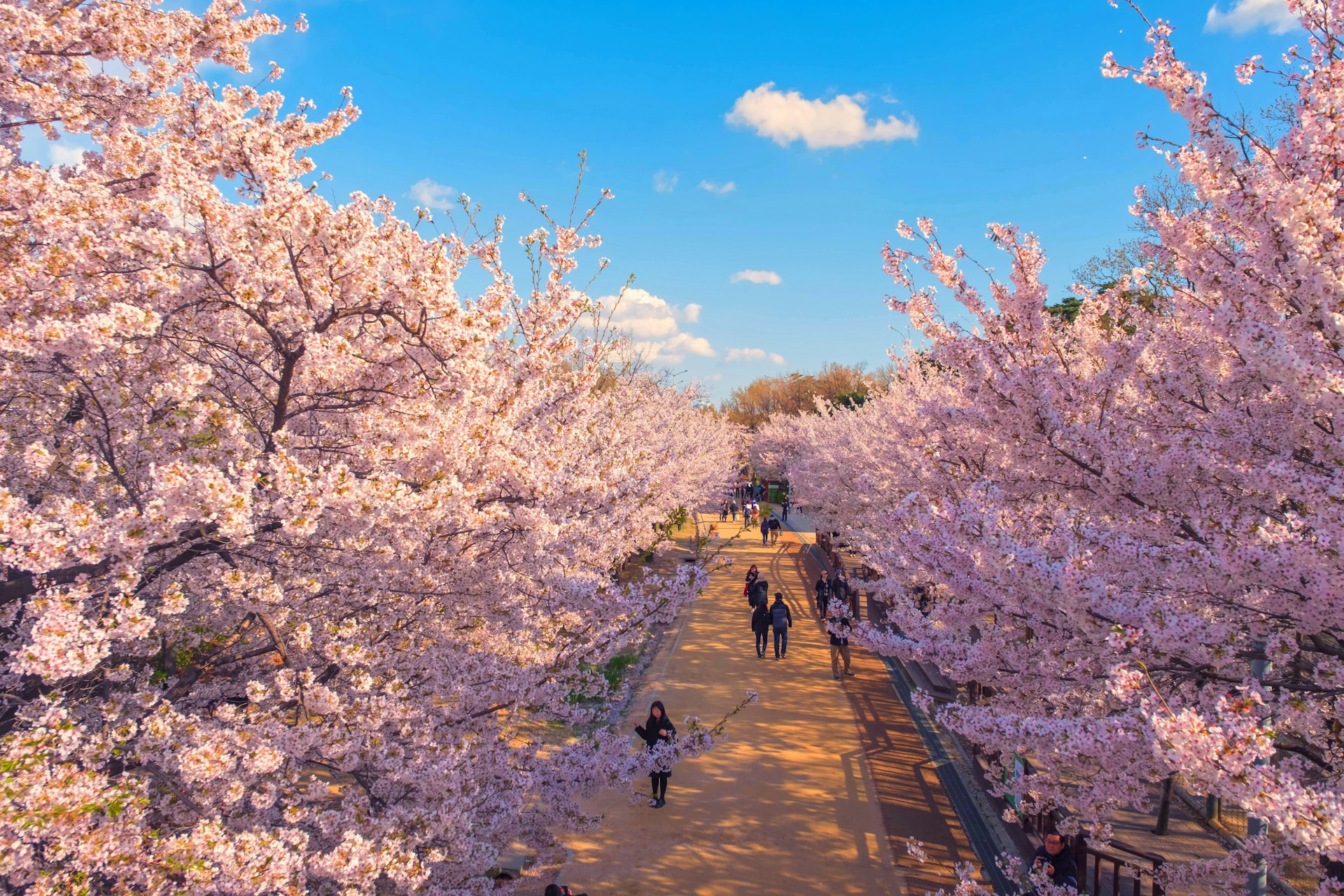
2. Time your visit with the trees
We recommend planning your visit to South Korea for spring or fall , when the peninsula gets its most temperate weather. Bonus points if you can time it to coincide with one of the country’s two periods of arboreal magic. Korea’s cherry blossoms start blooming in mid-March on Jeju-do Island , off the south coast, and typically appear in Seoul in early April. In late October and early November, the leaves of Korea’s many ancient ginkgo trees turn into brilliant golden torches, giving Seoul and other cities a particularly regal look for several weeks.
3. Mind these two major holidays
The two periods that can cause travelers real problems are the multi-day Lunar New Year and Chuseok (fall harvest) holidays. On these two occasions every year, Koreans hit the road en masse, making booking a bus or train ticket nearly impossible. The dates change each year, so be sure to check when these are before making travel plans.
If you can’t avoid a holiday, base yourself in Seoul or Busan for its duration. Plenty of businesses stay open, and the cities can be surprisingly peaceful with everyone out of town.

4. Take advantage of Korea’s world-class public transportation
Korea’s subways, trains and buses are clean, convenient and efficient . It can sometimes seem like a new station is added to the Seoul metro every month, and the rail and intercity bus networks will take you to every corner of the country. Public transportation is cheap: bus and subway fares in Seoul start at just ₩1250. In all of South Korea, Jeju-do is the only place where renting a car might make sense, and even there it’s probably not necessary.
With plentiful English information and sensible design, public transportation in Korea makes getting from here to there a breeze. To get moving, start by picking up a T-money transit card at a convenience store or from a vending machine in any subway station. Separate kiosks can be used to load money onto your card. Tap your card both when you board and get off the subway or bus. Fares are calculated by distance, so if you forget to tap when disembarking, you’ll be charged more and won’t be able to transfer for free. You can also use T-money cards in most taxis.
When traveling longer distances, it’s simple enough to just buy intercity bus or train tickets at stations. For the high-speed KTX train and some of the more popular routes and times – departing Seoul on Saturday morning, for example – it’s a good idea to purchase in advance. Bus tickets are typically readily available for purchase from machines and counters in bus stations. Buy train tickets on the website of KORAIL , the national operator.
5. Stay connected with these essential apps
Wi-fi is so prevalent in Korean cities that you can do without a local SIM card, but if you decide that you want one just in case, or if you plan to head to rural areas, the easiest place to pick one up is at one of the many telecom roaming centers at Incheon Airport upon arrival. You can also rent a phone if you didn’t bring your own.
Helpful apps to download include Naver Map ( iOS and Android ), which works better than Google Maps in South Korea; MangoPlate ( iOS and Android ) for finding restaurants and cafes; Subway Korea for navigating cities’ metro systems; and Kakao T ( iOS and Android ), which is like Uber but for taxis.
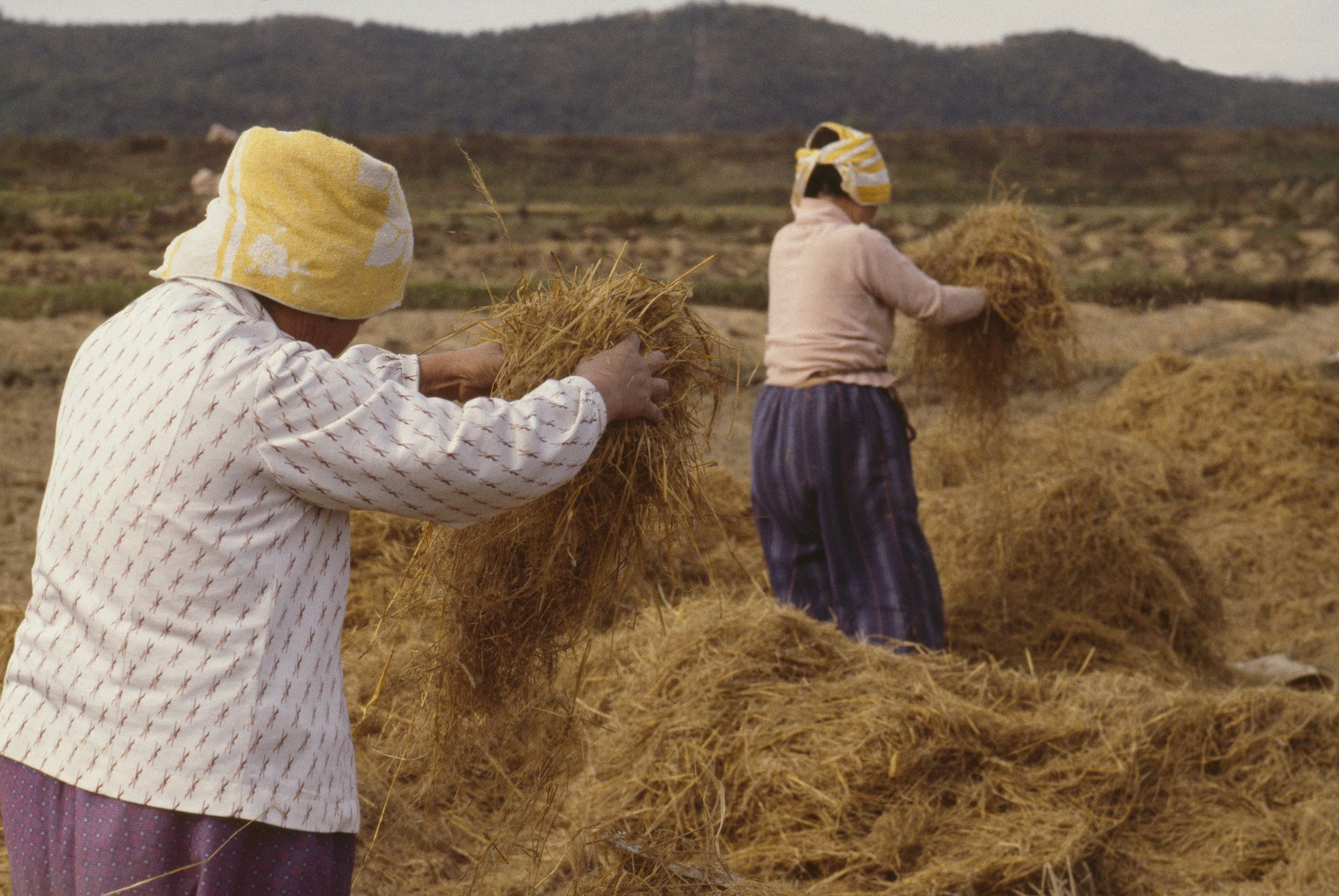
6. Get out of town
There are two Koreas. We don’t mean North and South, but rather Seoul and everything else – or, a bit more broadly, urban Korea and rural Korea. The country has a reputation for being a hyper-paced, highly wired pop-culture dynamo, but its hinterlands present a much different picture, and you’d be missing out big time if you skip them.
The Korean countryside is beautiful, mountains and rivers make for beautiful vistas, and life is lived differently here than in the cities. The population is older – most people under 40 have decamped to the cities – and the pace is slower. At least once on your trip, get out of the cities and immerse yourself in this more traditional side of Korea.
7. Learn your ga , na , da , ra , ma , bas
Basic English is widely understood in Korea by folks under 50, and signage is almost always in both Korean and English. Yet it’s still a good (and respectful) idea to learn a bit of the language.
Beyond memorizing a few essential Korean words and phrases, learning hangul, the Korean alphabet, is like gaining access to a secret bonus level of Korean travel. If you can sound out the letters, you’ll find that you already know what things like 카페 모카 ( ka-pe mo-ka ), 비빔밥 (bibimbap) and 사우나 ( sa-oo-na ) are.
Hangul is easy to learn. King Sejong the Great, who oversaw its creation in the 15th century, declared that a wise man could pick it up before noon and even an idiot could learn it in 10 days. Let’s Learn Hangul teaches the Korean alphabet in an interactive, easy-to-follow way.
8. Roll with the nudges
Koreans live life in a hurry, and they do so in a densely populated country, so you shouldn’t expect the same sense of personal space or public courtesies you find in your home country. Koreans won’t hold doors open for you or apologize if they bump into you when walking. When getting on or off the subway, they likely won’t say, “Excuse me” – they’ll just nudge you aside. They’re not being rude, though.
When you live in a city as crowded as Seoul, it’s just not practical to say sorry every time you knock shoulders with someone – you’d be apologizing constantly. This can be maddening to outsiders, but just accept it and roll with the nudges.

9. Be ready to get personal
The typical greeting here is a quick bow – nothing dramatic, just a head nod deep enough for your gaze to meet the floor – but you’ll sometimes be offered a handshake instead. If you are, expect more of a gentle clasp than the old squeeze-and-pump.
You’ll likely be asked questions more personal than you’re accustomed to by someone you just met. At the top of this list is your age. This data point is essential to Koreans, as it informs how they talk to one another: how formal their verb endings should be and whether to use honorifics. Inquiries about marital status, occupation and your opinion of Korea are also common. Answer politely, and feel free to return the question.
10. Wear what you like, but don’t pack anything too risqué
As a traveler, you can feel free to dress for the weather and comfort. Koreans are pretty relaxed about attire, even if they’re more modest than you might expect. If visiting a temple , while shorts are fine, tank tops and miniskirts are not. Both men and women frequently wear t-shirts at the beach (though it’s best to leave the Speedo or thong at home). Korean women almost never wear low-cut tops, and female travelers could find that doing so brings unwelcome looks. Tattoos are now common among young people, yet even still some bathhouses will deny entry if you show any ink.

11. Eat with others and don’t be afraid to shout for service
Eating is a communal activity in Korea, and many restaurants, especially barbecue joints, don’t offer single servings. So if you’re traveling solo, you might either have to drag someone from your hostel along with you (not a tough sell) or loosen your belt and order pork belly for two (poor thing).
At restaurants, servers won’t come check up on you, and most places have call buttons on each table. Give it a push, and someone will be right over. Otherwise, to grab the waitstaff’s attention, raise your hand and shout, “ Yogiyo !” (“Over here!”) Water is usually self-service, and occasionally side dishes are, too. If your server doesn’t set a bottle of water on your table, look around for a water dispenser and stacks of metal cups. At the end of your meal, take the check to the front counter to pay. There’s no tipping.
12. Is North Korea a concern?
Despite international headlines, South Koreans don’t worry about an attack from North Korea – and neither should you. Military clashes are very rare, and danger to civilians is rarer still. A guided tour to the DMZ can be a fascinating and truly find-it-nowhere-else experience. From afar, North Korea can seem almost comical in its eccentricities, but when you’re looking at South Korean soldiers looking at North Korean soldiers looking at you, the geopolitical stakes hit different. Plus, many tours offer what may be your only chance to actually step foot in the world’s most secretive country.
13. Monitor the air quality
Even in post-pandemic times, it’s a good idea to always carry a mask, as air quality can occasionally drop to pretty nasty levels. This is especially true in spring, when dust blown off the deserts of Mongolia and northern China combines with local pollution to create unhealthy air. Download an app like IQAir Air Visual (for iOS or Android ) to keep track of current conditions and the upcoming forecast across the country.
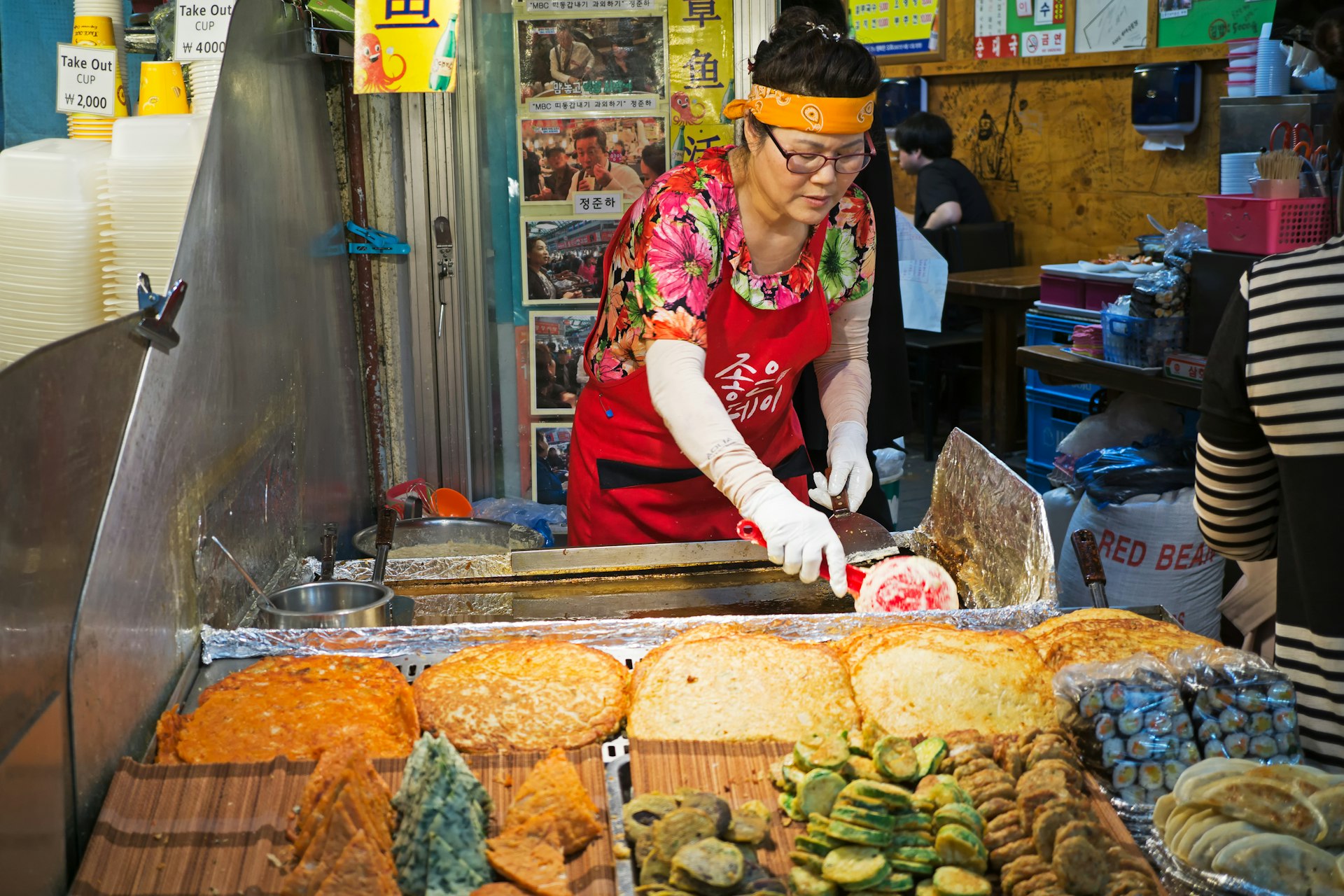
14. You might have to be flexible about your diet
If you have food allergies or a specific diet, you may have a hard time finding places to eat or getting clear information about ingredients. Vegetarianism and veganism are slowly gaining popularity in Korea, but not many restaurants cater to these diets. Even dishes that you might think are vegetarian are often made with anchovy broth or fermented shrimp.
15. Recognize that LGBTQI+ acceptance still has a long way to go
While attitudes are slowly changing, Korea remains a conservative society in many respects, and anti-LGBTQI+ prejudice is common. Even so, LGBTQI+ travelers are more likely to be on the receiving end of curious – if misinformed – questions than any sort of open hostility. Public displays of affection are generally frowned upon (though this goes for straight couples, too).
Seoul has small gay districts in Itaweon and Jongno-3-ga, while the Hongdae-Sinchon-Ewha university corridor is another place where LGBTQI+ Koreans feel comfortable being themselves.
16. Use common sense and keep these numbers handy, just in case
Theft and violent crime are rare in South Korea. Scams and pickpockets targeting travelers are virtually nonexistent, and Koreans typically go out of their way to be hospitable to visitors. Nonetheless – as anyone should anywhere – do exercise basic caution and common sense. South Korea has strict drug laws, and don’t even think about trying to sneak past them. Nightlife often revolves around heavy drinking, so know your limit to avoid putting yourself in a sketchy situation.
If you do have an emergency, call 112 to reach the police, 119 for emergency services or 1330 to reach the Korea Travel Hotline, where an operator will connect you to the appropriate service and serve as an interpreter. That number can also be used to reach the Korea Tourist Police .
This article was first published July 2022 and updated February 2024
Explore related stories
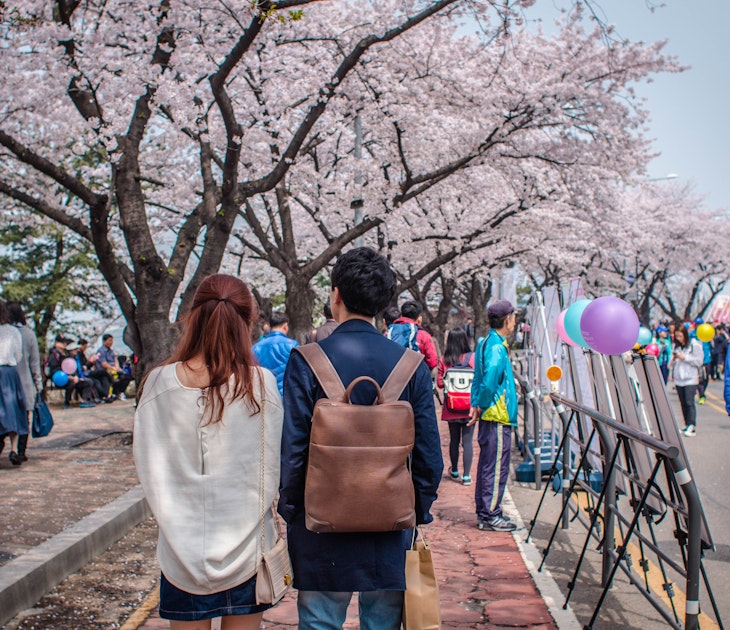
Public Transport
Feb 10, 2024 • 8 min read
Make the most of Seoul's incredible public transport but don't miss out exploring on foot.

Mar 28, 2024 • 7 min read

Feb 27, 2024 • 6 min read
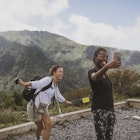
Feb 20, 2024 • 6 min read
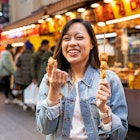
Feb 19, 2024 • 8 min read
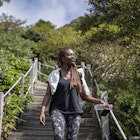
Feb 18, 2024 • 4 min read
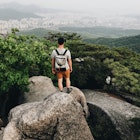
Feb 18, 2024 • 7 min read

Feb 17, 2024 • 10 min read
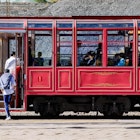
Feb 17, 2024 • 8 min read
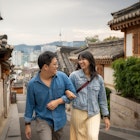
Feb 17, 2024 • 6 min read
April 29, 2024
Celebrating Buddha’s Birthday in South Korea
The top k-news from around the world, 31 best korean dramas on netflix, q&a with salle yoo, the first chief legal…, top 5 hidden gems for authentic korean food….
Join Our Newsletter

- Korean Childbirth Traditions
- HWANGAP 60TH BIRTHDAY
- LEARN THE KOREAN LANGUAGE
- KOREAN ZODIAC
- Korean Weddings
- TRAVEL GUIDE
- RESTAURANTS
- FOOD STORIES
- K-DRAMA & MOVIE
- South Korea Travel Guide
Where to Go, What to See & How to Stay on Budget
By Patricia Liu and Joel Marinan
There has never been a better time to visit South Korea. Clean, modern, sophisticated, and ultra safe, Korea is a destination that you will want to come back to again and again. With the rise of Korean culture and entertainment throughout the world, the country is experiencing a renaissance of sorts, especially for foreigners who wish to experience all that Korea has to offer.
Korea has always been a fascinating country to visit and deserves a place on everyone’s travel bucket list. Known for its stunning blend of tradition and modernity, Korea features futuristic technology, bustling markets, and a thriving pop culture scene. There are no guns or drugs allowed in Korea, and visitors can expect a high level of safety and cleanliness while exploring the country. Also of note is that Korea is a no tipping culture, so savoring the delicious cuisine is extra affordable, as are the cab rides to restaurants and other destinations.
Speaking of affordability, the exchange rate between the Korean won and the US Dollar has been very favorable for Westerners, which is another perk of traveling to Korea right now.
Our South Korea Travel Guide shows you where to go, what to see, and when to travel. Start your journey with itinerary ideas and pre-travel tips, the best day trips, and lots more essential Korean travel advice. Let’s go!
Here are some of our most popular articles that will help you make the most of your trip to South Korea.

A Local’s Guide to Gyeongju
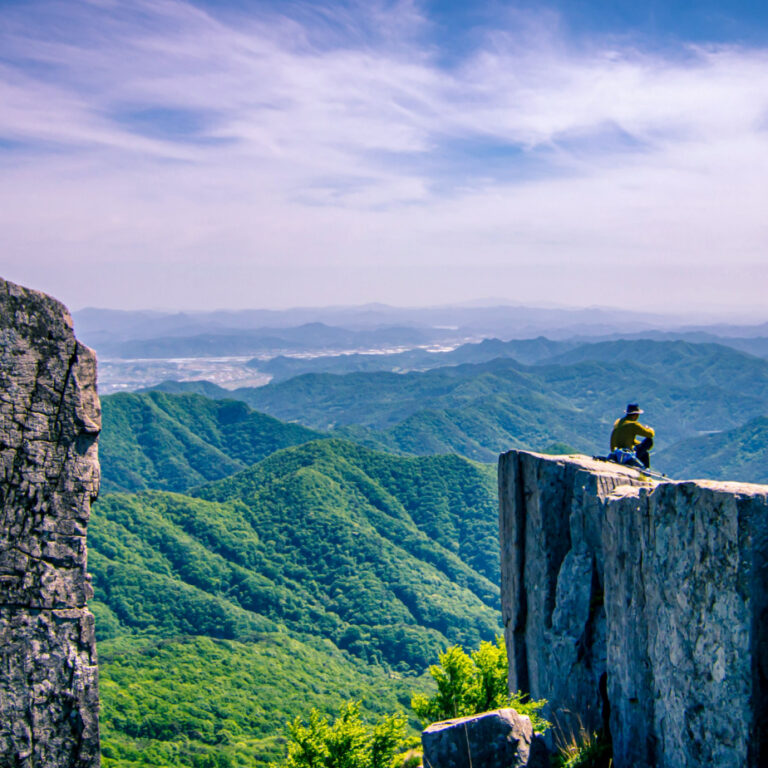
What To Do in Korea in May: The Family Month
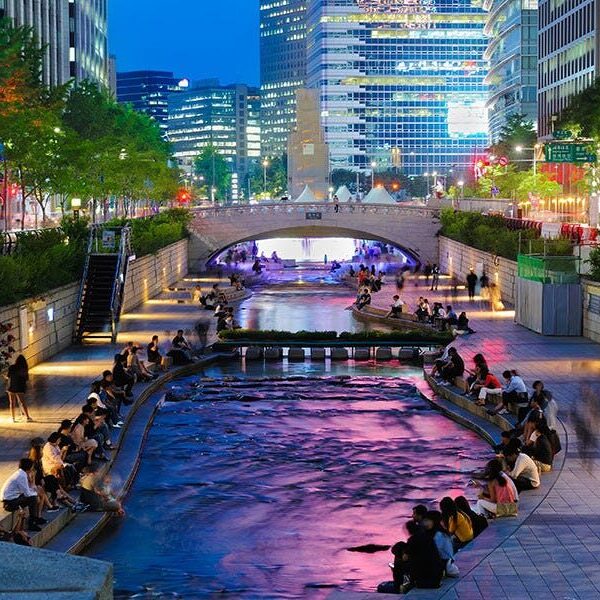
19 Did-You-Knows About Korea
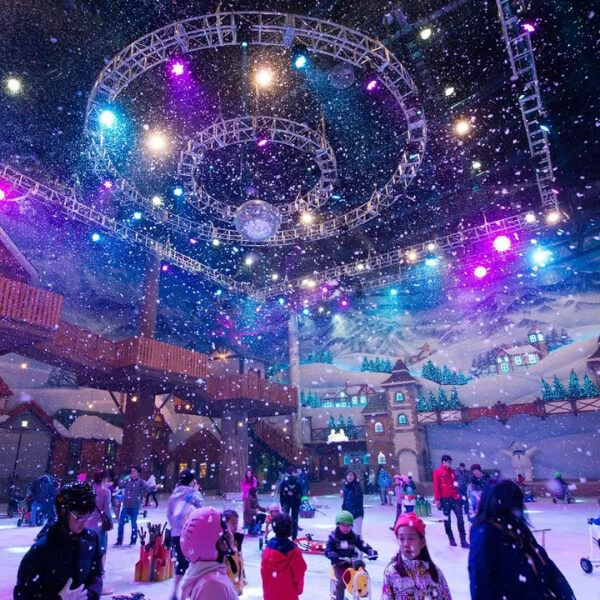
10 Ways to Spend a Magical Christmas in Korea

Hiking in Seoul, the Top 5 Mountains You Must Try

Jeju Island: Top 10 Places You Must See
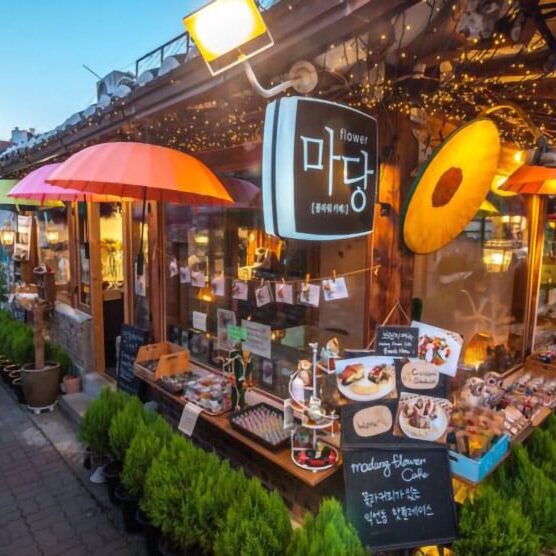
19 Best Things to Do in Seoul Right Now- An Insider’s Guide
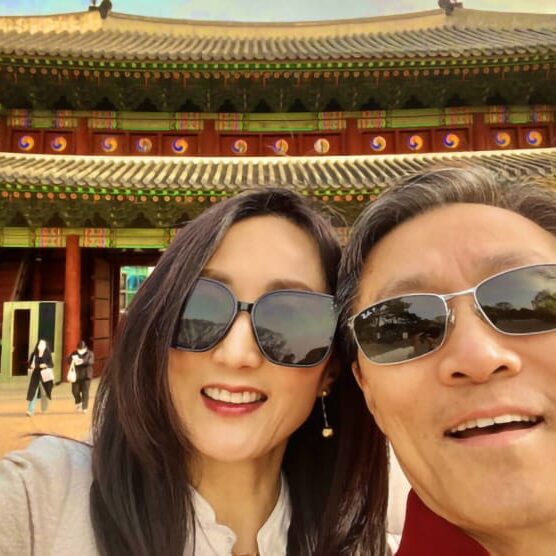
23 Reasons Seoul Will Be Your New Favorite City
Latest travel updates.
- Vaccination is NOT a requirement for entry into Korea.
- There is no requirement on the passport’s remainder validity for entry. You may travel to Korea as long as your passport remains valid throughout your stay in Korea.
- From April 1st, 2023, travelers from the USA, Canada, and 21 other countries no longer need to apply for the K-ETA to travel to Korea. This will run at least until 31st December, 2024 and is designed to make it easier to travel to Korea.

Planning Your Trip To Korea
Check the Korean Embassy for any possible travel restrictions.
- If you’re not sure where to stay, check out our guide to the best hotels in Seoul . You can find our recommendations for the best luxury, mid-range, and budget hotels in Seoul, as well as long-term apartments that you’ll love.
- For the best flight deals to South Korea, Best of Korea recommends Skyscanner and Expedia . You can find the cheapest prices and most convenient flights and buy the one that suits you best.
- For the best hotel prices in Seoul, Best of Korea recommends Klook 0r Agoda – they cover most hotels in Seoul and the rest of Korea and offer great prices without hidden fees.
- Before you travel to Korea, it’s a good idea to order an eSim card, regular sim card or portable WiFi router to collect at the airport so you’re connected as soon as you arrive. You can change a small bit of money before you travel, but you can also use the airport ATM to get some Korean won.
- There are large differences in exchange rates so you will need to do some comparing before you exchange a large sum of money. You can exchange USD to KRW easily at banks or money exchange shops in all major tourist areas like central Seoul (Myeongdong and Namdaemun are good places but the Coex Center also offers money exchange. You can also negotiate the exchange rate with the vendor if you think it is too high.
- You can withdraw cash from bank ATMs. Alternatively, use a pre-paid travel card like the one offered by Wise , which allows ATM withdrawals and payments and works perfectly in Korea.
- Don’t forget to bring a travel adapter for your electronics and leave plenty of extra space in your suitcase for the many Korean souvenirs and goodies you’ll buy on your tri
Do US Citizens Need A Tourist Visa?
No, travelers from the USA don’t need a tourist visa to enter South Korea. You can visit for up to 90 days visa-free.
Current COVID-19 Rules In Korea
Most COVID-19 rules in Korea have been dropped and now there are only 2 main rules to be aware of. First, face masks are mandatory when visiting medical facilities (hospitals). There is no longer a 7-day mandatory quarantine for people in South Korea. If you’re infected with COVID, the Korean government recommends a 5 day self-quarantine, but it’s not enforced. Travelers to Korea should follow the current restrictions or may be liable for fines or deportation.
Korean Tourism Support Hotline
If you have any concerns or problems when traveling in Korea, you can call 1330 . This is a dedicated tourism support hotline where trained specialists provide tourist assistance and is available in Korean, English, Japanese, Chinese, Russian, Vietnamese, Thai, and Malay.
US Government Travel Advisory For Korea
The U.S. Department of State currently has a level 1 travel advisory (Exercise Normal Precautions) for the Republic of Korea (ROK). Find out more about current travel advisories for South Korea on the Department of State website.

6 Best Destinations In Korea
South Korea is truly a country of contrasts. From the bustling, modern city of Seoul , with cutting-edge designer buildings, VR labs, and AI robots, to peaceful UNESCO World Heritage cities like Jeonju and Gyeongju , there are many unique places to explore.
There’s nothing worse than coming back from vacation and hearing about incredible places you missed that you wished you’d seen, such as a beautiful Buddhist temple by the beach (Haedong Yonggungsa Temple) or a leafy island getaway where deer and rabbits roam freely (Nami Island).
Here are 6 of the best destinations in Korea that you absolutely must visit, as well as some of the sights you’ll want to check out while you’re there. We’ll be bringing you lots more detailed destination guides in the future, so be sure to visit again soon.
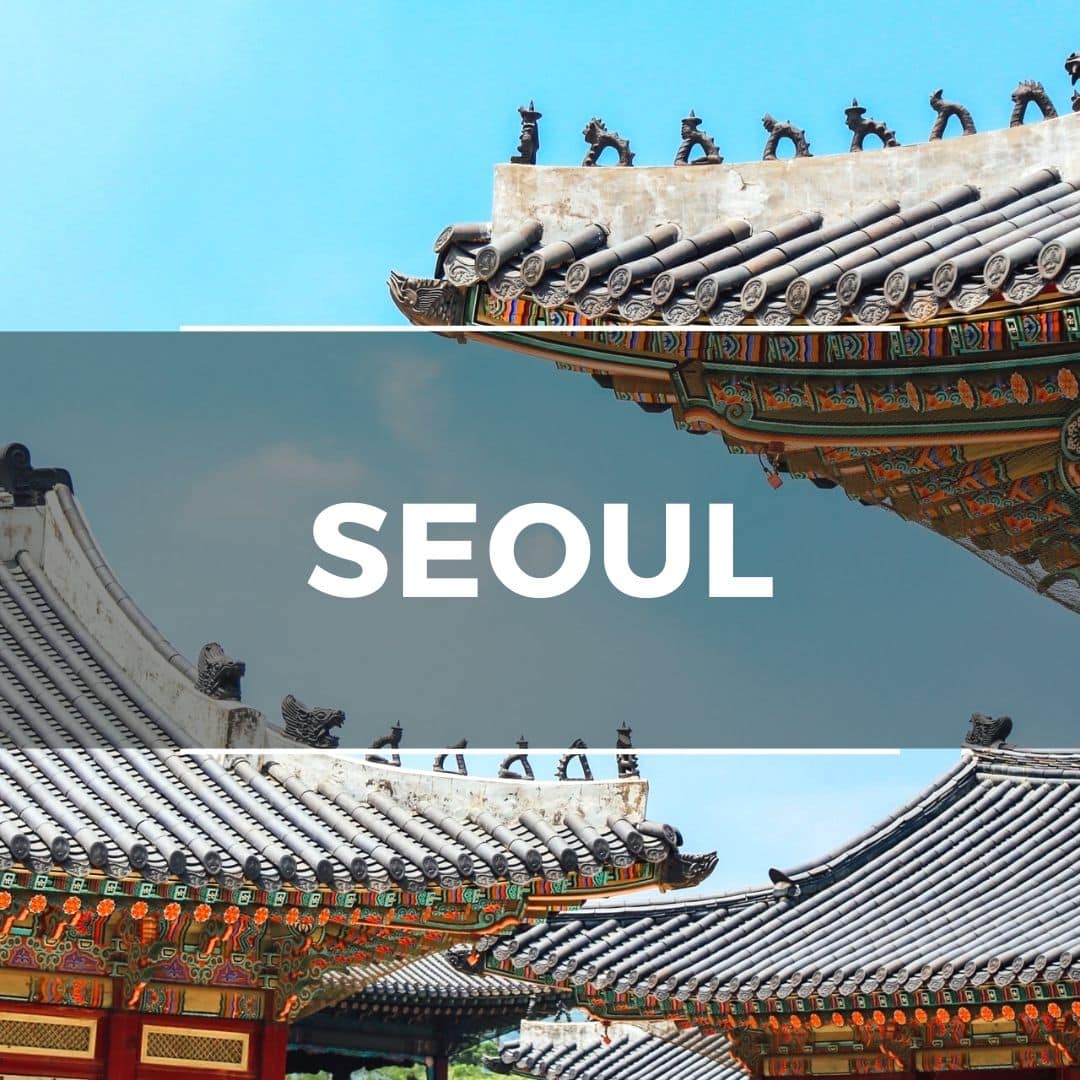
Korea’s Busy Capital
Seoul is Korea’s largest city, capital, and first, stop for most travelers to Korea. There are many beautiful places in Seoul , including landmarks, relics from ancient kingdoms, towering skyscrapers, Buddhist temples, Michelin-starred restaurants, and some of the best street food you’ll find in the world. If you see only one city in Korea, you should definitely visit Seoul.
You’ll never be bored in Seoul. Whether you’re traveling as a family, as a couple, or by yourself, there’s so much to do. Be sure to plan lots of time to check out Korea’s capital.
This Full Day Tour of Seoul will show you some of the hottest spots in the city, while this Customized Private Tour of Seoul will allow you to choose where to go.
Here are 10 of the best Seoul attractions:
- Gyeongbokgung Palace
- Bukchon Hanok Village
- Starfield COEX Mall
- Bukhansan National Park
- Myeongdong Street Markets
- Lotte World Tower
- Secret Garden (Changdeokgung Palace)
- Dongdaemun Design Plaza
- N Seoul Tower
- Yeouido Hangang Park

Korea’s Second City
Busan, Korea’s second city, is a thriving port city far away from Seoul both physically and culturally. This popular summer destination features some of Korea’s most popular beaches and bars. Explore Busan and you’ll find sprawling markets, fresh seafood, film festivals, the world’s largest shopping mall, coastal temples, and lots more.
Busan is a city with some very photogenic sights. See the sunrise on the beach, hike around leafy coastal streets on the side of cliffs, and marvel at the wide range of (living!) seafood in the markets.
This Full Day Tour of Busan will show you the best beaches, markets, and local sights, while this Customized Private Tour of Busan will allow you to choose where to go.
Here are 10 of the best Busan attractions:
- Haeundae Beach
- Gwangbokdong Food Street
- Haedong Yonggungsa Temple
- Huinnyeoul Culture Village
- Gamcheon Culture Village
- Oryukdo Sky Walk
- Lotte World Busan
- Jagalchi Fish Market
- BIFF Square & Centum City Mall
- Taejongdae Resort Park
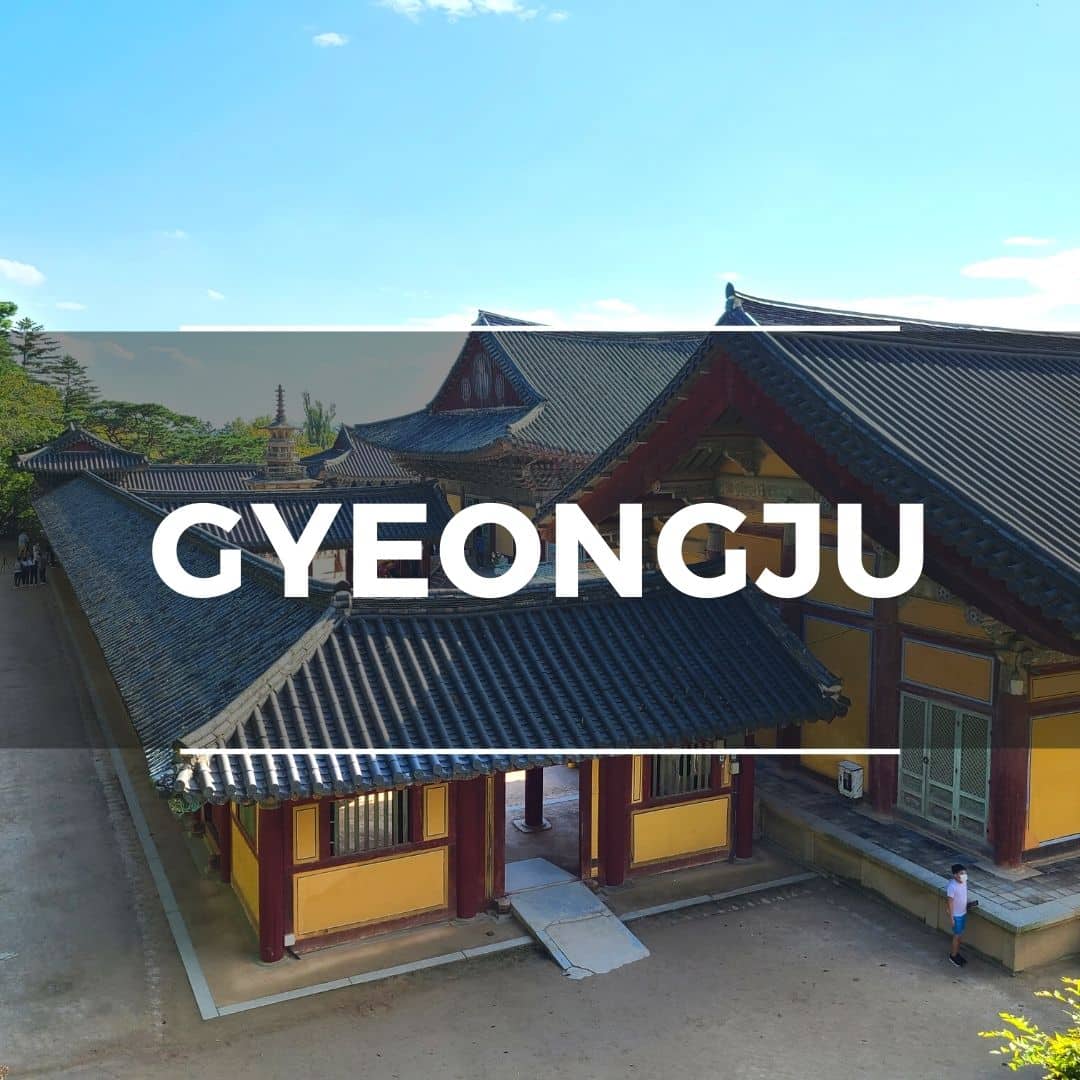
UNESCO City
Gyeongju is the former capital of the Silla Kingdom, part of the Three Kingdoms part of Korean history. These days, Gyeongju is an open air museum housing Korea’s finest history and monument. This UNESCO World Heritage City is a must-see for those who want to learn more about Korea’s deep cultural past.
Gyeongju is packed with temples, palaces, historical sights, and monuments. But it’s not just the history that draws the crowds, the city is an area of natural beauty, lined with cherry blossoms and shadowed by misty mountains.
This Full Day Tour of Gyeongju from Busan will take you around Korea’s open-air museum city, showing the top UNESCO sites along the way, while this Customized Private Tour of Gyeongju will allow you to choose where to go.
Here are 10 of the best Gyeongju attractions:
- Gyeongju Historic Area
- Bomun Lake Tourist Complex
- Bulguksa Temple & Seokguram Shrine
- Donggung Palace & Wolji Pond
- Yangdong Folk Village
- Cheomseongdae Astronomical Observatory
- Gyeongju National Museum
- Gyochon Traditional Hanok Village
- Woljeonggyo Bridge
- Gyeongju National Park
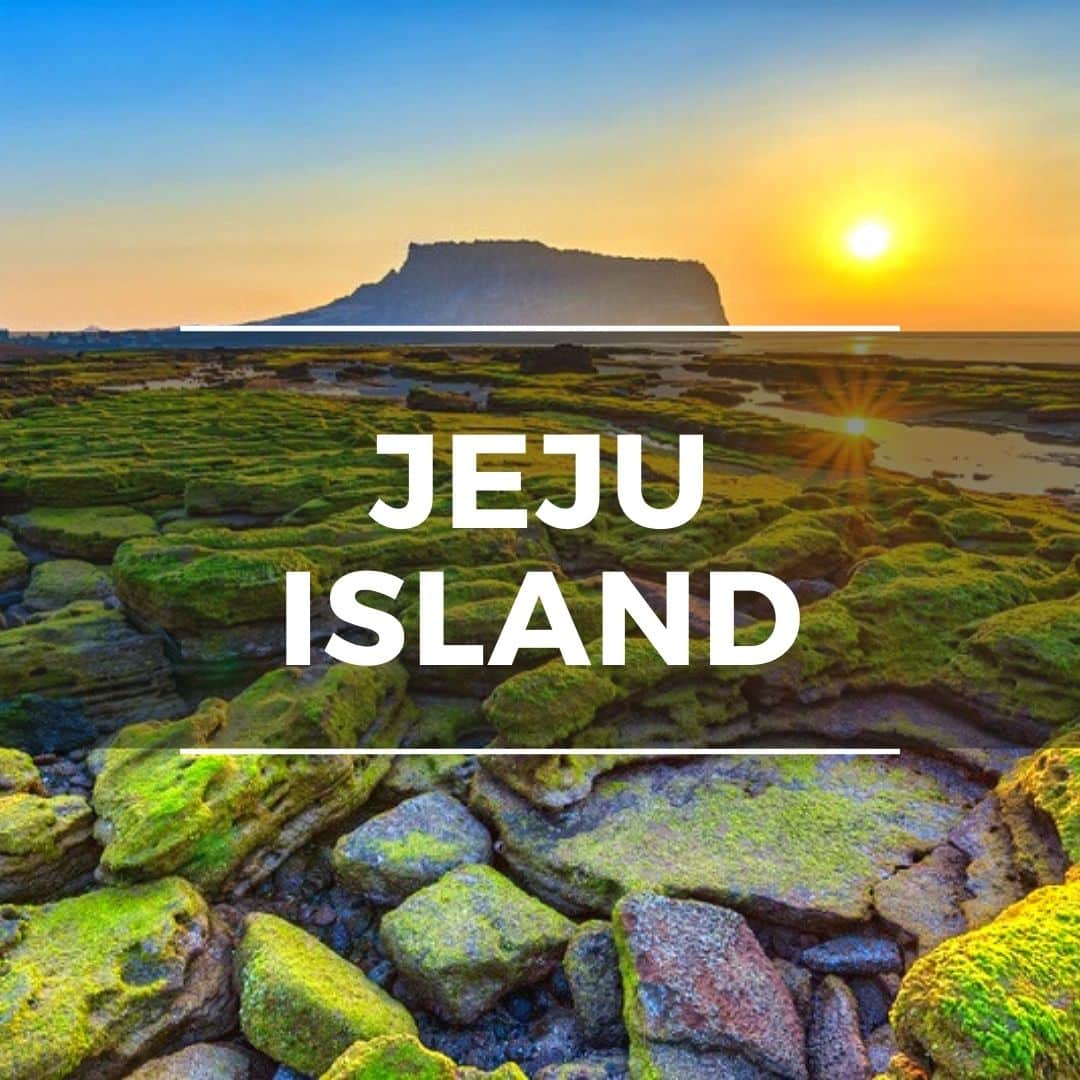
Natural Wonder
Jeju Island is Korea’s semi-tropical island that’s a popular vacation destination for locals and tourists alike. This area of outstanding natural beauty offers up rugged coastal walks, sandy beaches, green hills, and a volcano to hike up for those who enjoy a challenge. Culture and cafe lovers will also find Jeju Island a charm.
From snorkelling under the sea, to hiking above the clouds, sampling Jeju’s black pork BBQ, and drinking local green tea, there’s so many exciting activities, sights, tastes, and experiences waiting for you on Jeju Island.
This Full Day Tour of Jeju Island will show you some of the most incredible UNESCO World Heritage sites on Jeju’s East Coast, while this Customized Private Tour of Jeju Island will allow you to choose where to go.
Here are 10 of the best Jeju Island attractions:
- Seongsan Ilchulbong Sunrise Peak
- Jusangjeolli Hexagonal Lava Cliff
- Hallasan Mountain (Volcano)
- Hamdeok Beach
- Jeju Folk Village
- Hyeopjae & Geumneung Beach Areas
- Cheonjeyeon & Jeongbang Waterfalls
- Udo Traditional Island
- Yakcheonnsa Coastal Buddhist Temple
- O’Sulloc Green Tea Fields
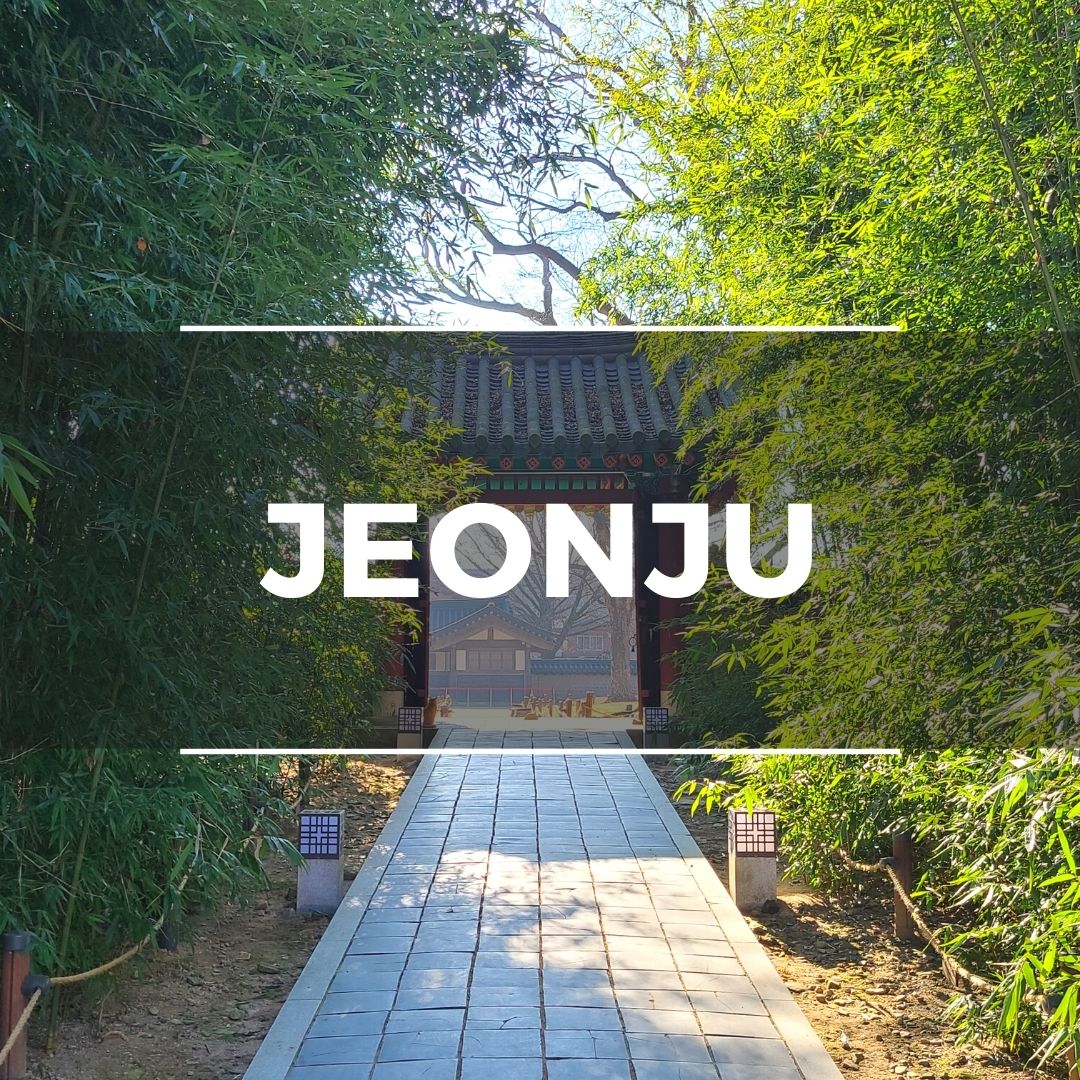
Traditional Korea
Jeonju is famous for its historical and cultural sights, including the sprawling Jeonju Hanok Village, packed with more than 700 traditional hanok houses. Jeonju’s many impressive sights are close to each other and perfect for a day trip from Seoul or Busan. You can even stay overnight in one of the traditional houses.
Jeonju is a tourist hotspot so there are plenty of things to keep travelers entertained and places to experience traditional Korean food and drinks. Be sure to check out the Jeonju bibimbap, one of Korea’s national dishes. Rent hanbok (traditional clothes), take lots of pictures, and see the sights.
This Full Day Tour of Jeonju will show you around the beautiful hanok houses and traditional Korean restaurants, while this 2-Day Tour of Jeonju includes an overnight stay in a hanok and lots of delicious Korean meals.
Here are 10 of the best Jeonju attractions:
- Jeonju Hanok Village
- Gyeonggijeon Shrine & Portrait Museum
- Jeongdon Catholic Church
- Jeonju Hyanggyo Confucian School
- Nambu Traditional Market
- Jaman Mural Village
- Omokdae Viewpoint
- Deokjin Park
- Hanbyeokdang Pavilion
- Taiji-ro & Hyangoyo-gil Shopping Streets
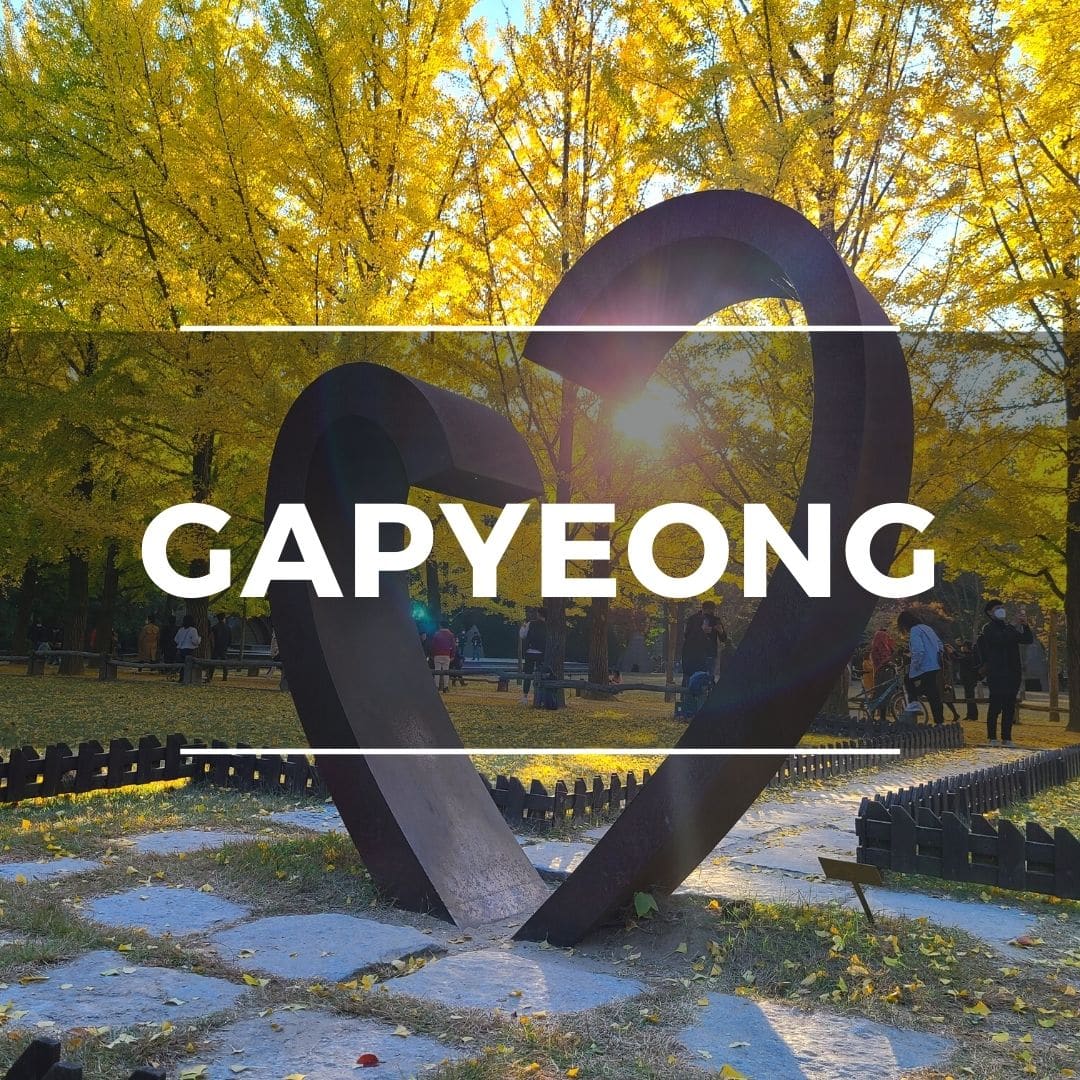
Rural Attractions
Gapyeong County is an area just outside of Seoul that’s home to several interesting attractions celebrating Korean and foreign culture. The lush green hills and blue rivers of Gapyeong make it a great place to immerse in Korean nature.
You’ll find some of the hottest day trip locations here. Explore Gapyeong County on a day trip from Seoul. You can see romantic tree-lined streets and cafes on Nami Island, explore one of Korea’s most beautiful gardens, take a trip to Petite France, and enjoy cycling through the hills on an abandoned railway track.
This Full Day Tour of Gapyeong will show you around Nami Island, Garden of Morning Calm, and the Rail Bike Park.
Here are 10 of the best Gapyeong attractions:
- Nami Island
- Garden of Morning Calm
- Petite France
- Ganchon Rail Bike Park
- Edelweiss Swiss Village
- Cheongpyeong Lake
- Jarasum Island
- Kalbongsan Recreational Forest
- Gapyeong Sledding Hills
- Nami Island Zip Line

There are loads of locations to visit in Korea that make for a perfect day trip from Seoul. Hop on a coach, train, or tour bus in the morning and explore one or more of these unique destinations.
Here are 10 of the best day trips from Seoul to discover on your next journey to Korea:
- DMZ (North Korean Border)
- Suwon Hwaseong Fortress
- Everland Theme Park
- Jeonju Historic City
- Seoraksan National Park
- Korean Folk Village
- Alpaca World
- Gwangmyeong Cave
Most travelers to Korea arrive at Incheon Airport and then travel into Seoul (it’s only 40 minutes away) to begin their journey. Seoul is certainly an incredible place to start traveling, but it definitely shouldn’t be your only destination. Korea has a lot to offer, including a lot of seasonal activities and events that you should take into consideration.
Spring and fall are the best seasons to visit Korea and during these times the traditional cities like Gyeongju and Jeonju look amazing. They’re covered with cherry blossoms or fall foliage and this creates some postcard-like scenes. Gapyeong area is packed full of natural sights to enjoy, so definitely check out these areas.
If you’re visiting during summer, head towards the coastal areas, including the north-east coastal towns of Gangneung & Sokcho, or the south-east coastal areas of Busan and the nearby islands, such as Geoje, Tongyeong, and Yeosu. You’ll find lots of winter activities to enjoy in these areas.
Winter is cold and dry and, ironically, a great time to visit Jeju Island. This semi-tropical island is warmer than the mainland, but still gets snow on the mighty Hallasan Mountain. You can sit on a sunny beach one day and then hike knee-deep in snow the next. Jeju is also famous for its citrus, with thousands of tangerine trees dropping their juicy fruits in early winter.

Where To Stay In Seoul
South Korea is truly a country of contrasts. From the bustling, modern city of Seoul , with cutting-edge designer buildings, VR labs, and AI robots, to peaceful UNESCO World Heritage cities like Jeonju and Gyeongju , there are many unique places to explore. If you’ve decided on Seoul, here are some of the best hotels that are well located and highly reviewed.
Choosing the best destinations to visit in Korea can be a challenge, especially if you don’t know what there is to see. You might not have heard of some of these destinations, which is not surprising. Korea is a country of undiscovered wonders that are waiting to be found.
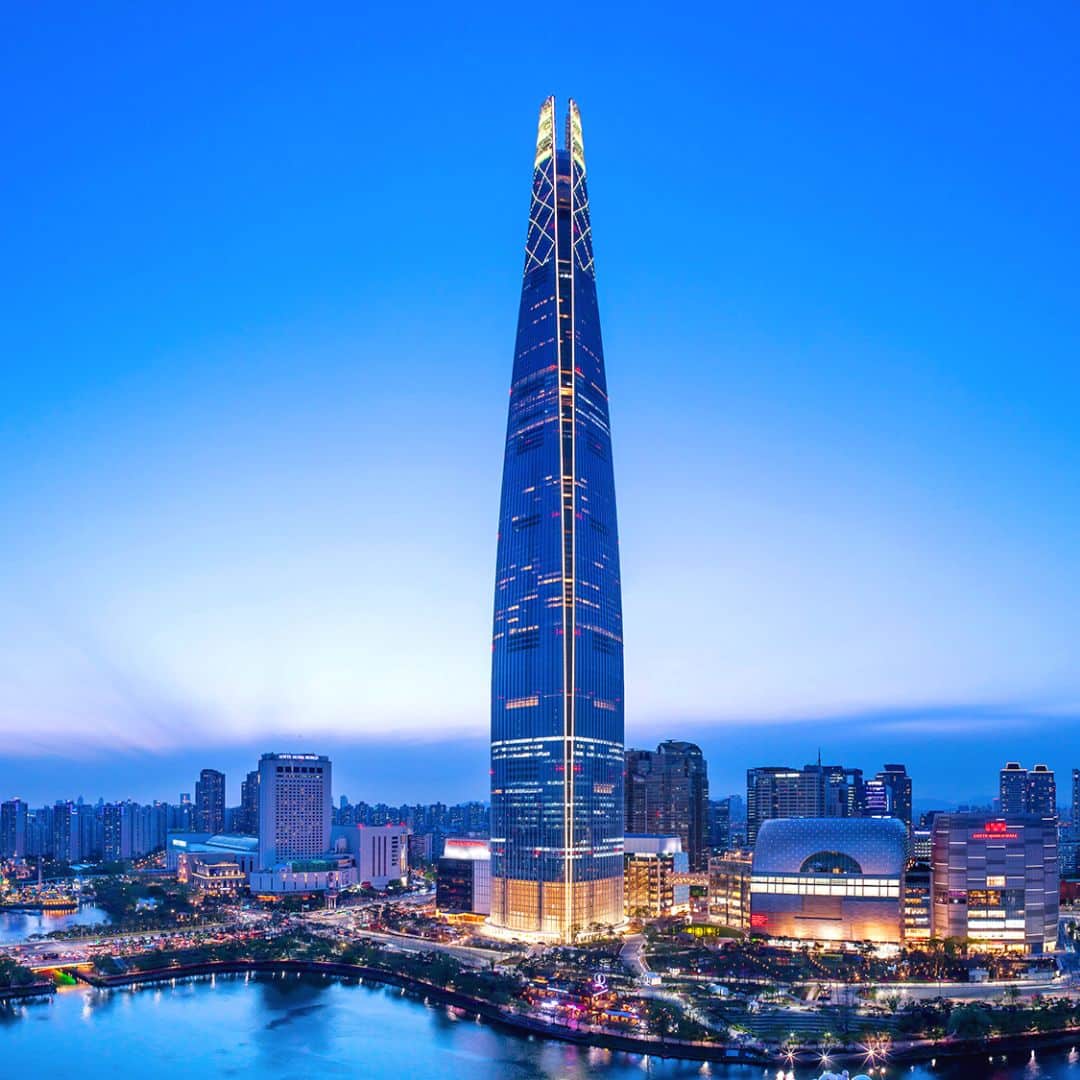
If you want the best Seoul has to offer, these luxury hotels are for you. Located in Seoul’s glitziest neighborhoods, these hotels are within walking distance of Michelin-starred restaurants, chic boutiques, galleries, museums, and the finest shopping experiences available.
Expect nothing but the best in terms of service and style at these luxury hotels. Silky soft sheets, immaculate rooms with the finest fixtures and fittings, and true 5-star service from the hotel staff. These hotels have sports, dining, and entertainment facilities to make you comfortable during your stay.
Airport transfers are available with these hotels, making your journey into and out of Seoul a breeze. Located in popular upmarket districts in Seoul, these neighborhoods have lots of local charm for you to discover, as well as allow easy access to other parts of the city with excellent transport options nearby.
Not only are these beautiful, comfortable hotels inside, but they are also located in some of the most iconic buildings or districts and provide amazing views over some of Seoul’s most interesting districts. The view from the first hotel is worth the cost alone.
Recommended Luxury Hotels In Seoul
Here are 3 of the best luxury hotels in Seoul that we recommend for an unforgettable stay in Korea’s capital:
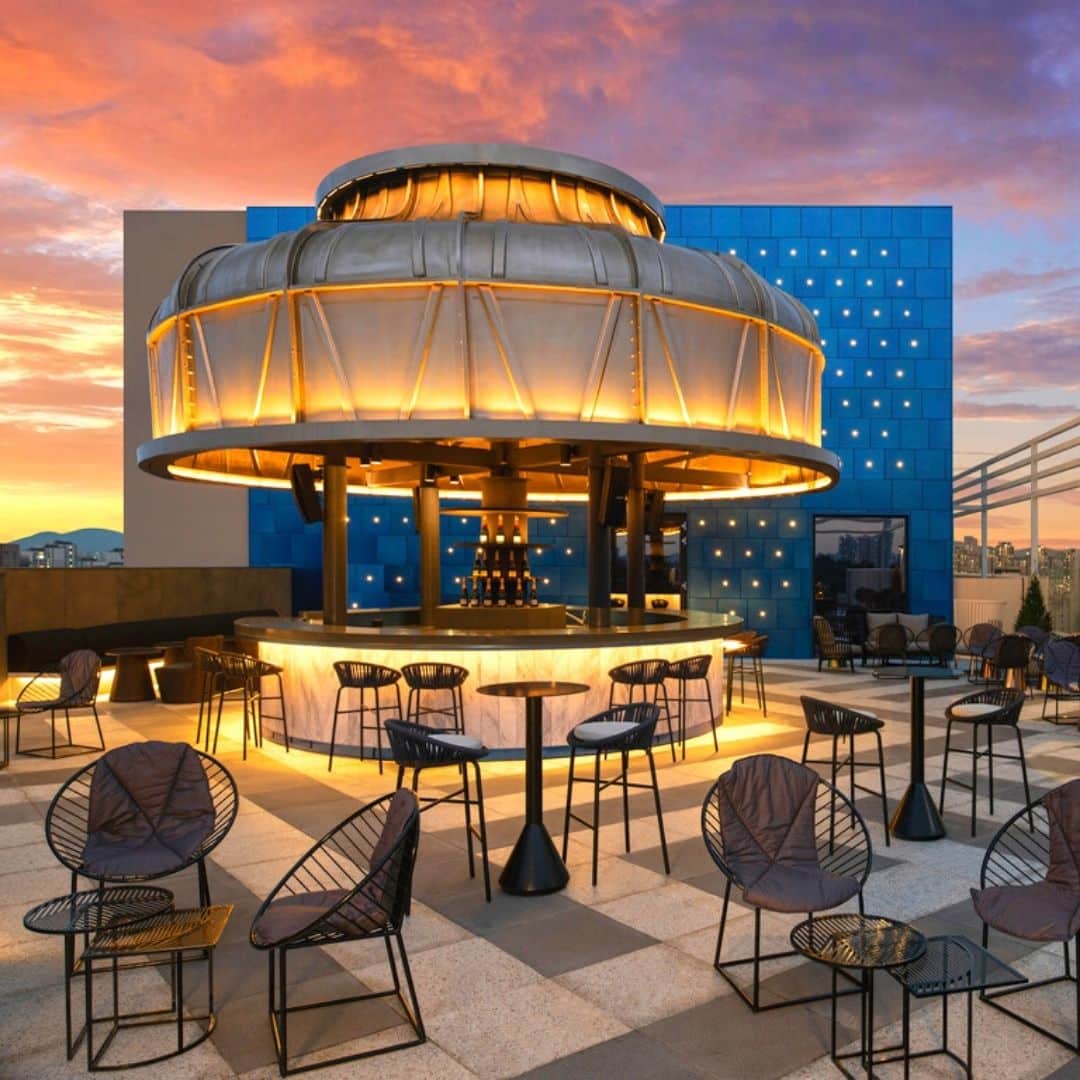
Families. couples and other travelers that want to experience the best of Seoul without breaking the bank can sleep easy with these mid-range hotel recommendations in some of Seoul’s trendy, vibrant districts, including Hongdae, Gangnam, and Myeongdong.
Encounter stylish accommodation in Seoul’s Hongdae districts, which is full of street culture and artistic scenes from the district’s eponymous Hongik University – one of Korea’s leading art centers.
Fashion lovers and shoppers will find lots to love in downtown Gangnam, with its wide streets and glassy storefronts bracketing narrow side streets and hidden delicacies.
Myeongdong is famous for its budget and mid-range accommodation options, including several hotels by the famous Lotte chain – one of Korea’s best mid-range brands.
Whichever mid-range hotel you choose in Seoul, you can be sure you’ll have fantastic city views, convenient subway access, and lots of unique cultural sights, sounds, and tastes to experience.
Recommended Mid-Range Hotels In Seoul
Here are 3 of the best mid-range hotels in Seoul that we recommend for an comfortable stay in Korea’s capital:
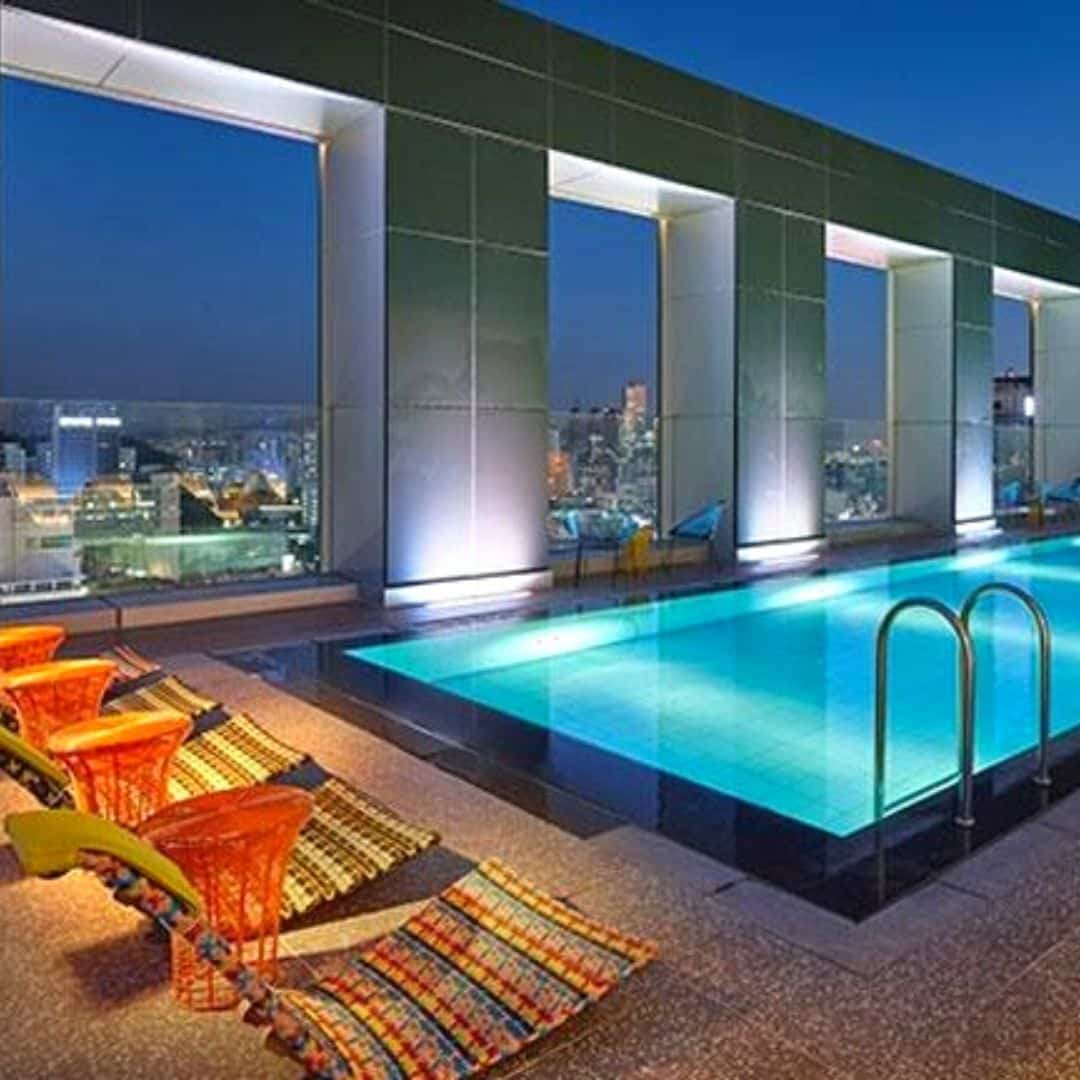
Seoul has a wealth of budget accommodation options that will help make your money go further. These hotels are all around $100 or less but offer the comfort and convenience that you’d expect to find in a mid-range hotel. One even has a beautiful rooftop pool.
Although these hotels are cheaper, don’t lower your expectations. You’ll always find great service in Korea. Save on sleeping to spend more on shopping, souvenirs, sights, and all the other fun things there are to do in Seoul.
These budget hotels in Seoul are also in great locations for shopping, enjoying local culture, and seeing the real side of Seoul and Korea. Hongdae offers bargain hunters the chance to get boutique fashion at market prices, Gangnam has plenty of cafes and cheap eats tucked away off the main avenues, and Myeongdong is a budget traveler’s paradise full of $1 street food and bargain souvenirs.
You won’t be disappointed with a night at any of these hotels. If you want to make your budget go further so you can spend more on some of the incredible day trips Seoul has to offer, definitely book a night at one of these hotels.
Recommended Budget Hotels In Seoul
Here are 3 of the best budget hotels in Seoul that we recommend for an affordable stay in Korea’s capital:

Korean Travel Tips
Korea is a unique country with a written language that looks nothing like English, fascinating etiquette rules , and an always busy lifestyle. Travelers may be lost trying to do even the simplest things.
These travel tips include the best options for staying connected, how to use public transportation easily and cheaply, great discount cards that will save you money as you travel, where to exchange money, and how to learn some basic Korean phrases for when you travel.
These essential Korean travel tips have been crafted by experienced travelers who love to save time and money. Only the best quality services and products are recommended here.
Here are our Korea travel essentials that’ll help you get around more easily, save you money, and let you get the most out of your trip.
Plan ahead now and you’ll have fewer troubles on your travels, giving you more time to enjoy your time in Korea.
If you’re traveling to Korea, you’re almost certainly going to want to get access to the internet to help you navigate, translate Korean, or even book tickets to attractions. Korea has one of the world’s best mobile internet and the prices are very reasonable. 5G mobile internet services are available across the country and Korea was one of the first to get the super-fast service. You won’t have problems connecting with a sim card or WiFi router when you travel.
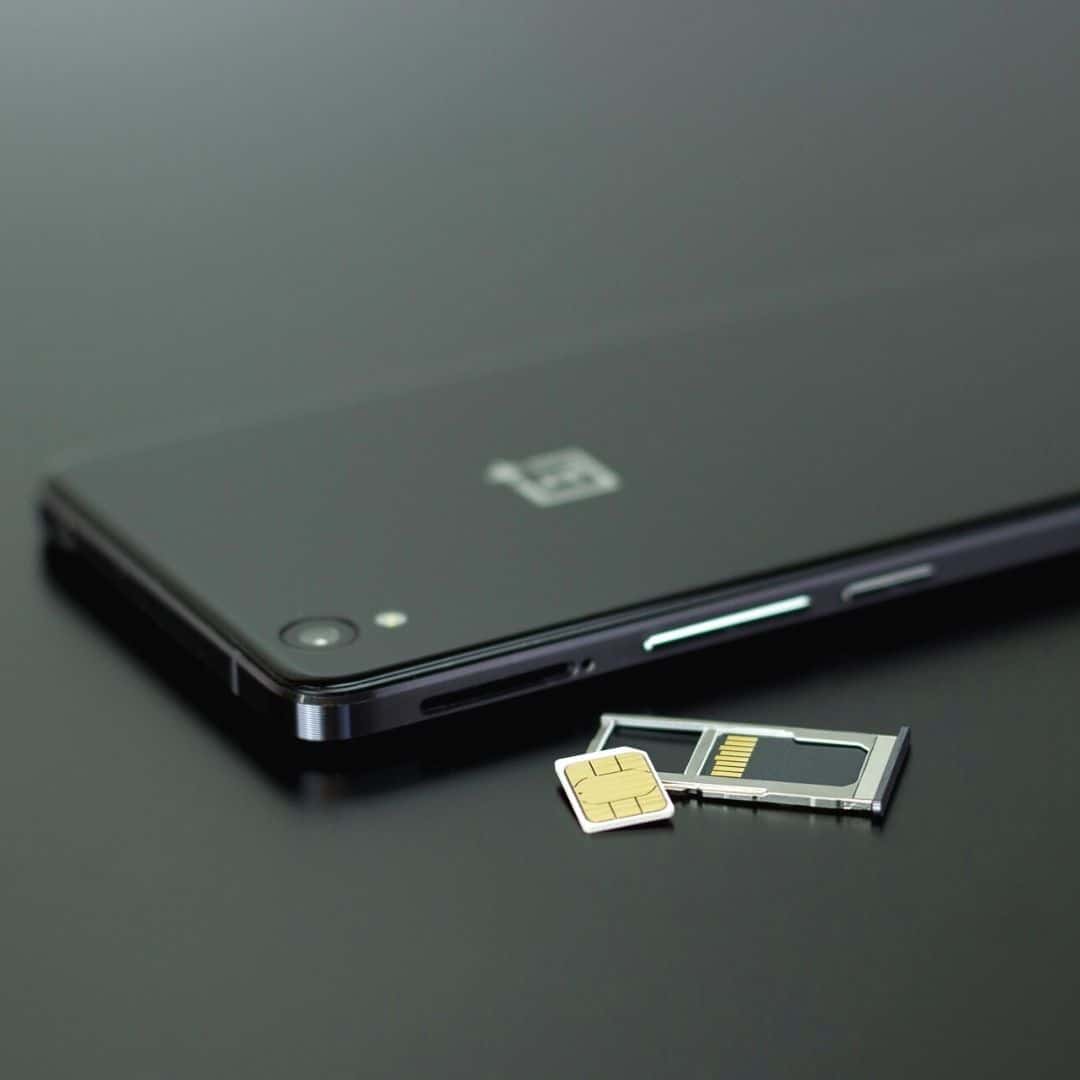
Sim Cards & Data Plans
A Korean sim card is a great way to get access to all your usual cellphone services when you travel to Korea. Sim cards come with data-only packages, or data and phone services combined.
Buying a Korean sim card will give you access to a Korean phone number, which is useful when using Korean apps. If you want to order food online in Korea, you need to have a Korean phone number to complete the order.
Korean Sim Card Costs
Prices start at W5,900 ($5) for a 1-day sim. You can also get 10-day sim cards (W34,700/$28) and 30-day sim cards (64,400/$52). These all come with unlimited data, domestic calls, and texts.
You can purchase a Korean Sim Card From Klook and collect it at the airport. This is a very convenient option as you can use it immediately to help navigate and check in back home.

Portable WiFi Routers
A Korean portable WiFi router will give you access to mobile internet throughout Korea by connecting to WiFi hotspots run by the major phone companies in Korea and comes with great coverage.
The major benefits of a portable WiFi router include a lower cost than a Korean sim card and also the ability to connect up to 3 devices to 1 router. That means that families and groups will be able to share the service.
Korean Portable WiFi Router Costs
The cost of a Korean portable pocket WiFi router is W3,200 ($2.60) per day. You can rent the WiFi router for as many days as you require and pay in advance and pay any excess days when you return it.
You can also purchase a Korean Portable WiFi Router From Klook and collect it at the airport. You can book online before you travel so that it’s guaranteed to be waiting for you.
Should I Get A Sim Card Or WiFi Router In Korea?
Both a sim card and WiFi router are great options for travelers to Korea and will almost guarantee a great reception for mobile internet. The choice between whether you should get a sim card or WiFi router in Korea really comes down to the costs involved and if you need a Korean phone number.
WiFi routers are cheaper and allow you to connect 3 devices, so they’re perfect for families. However, a sim card gives you a Korean phone number, which means you can call people and also register for Korean apps which require a phone number.
Check out our detailed article about the Best Sim Card & Portable WiFi options for traveling to Korea.
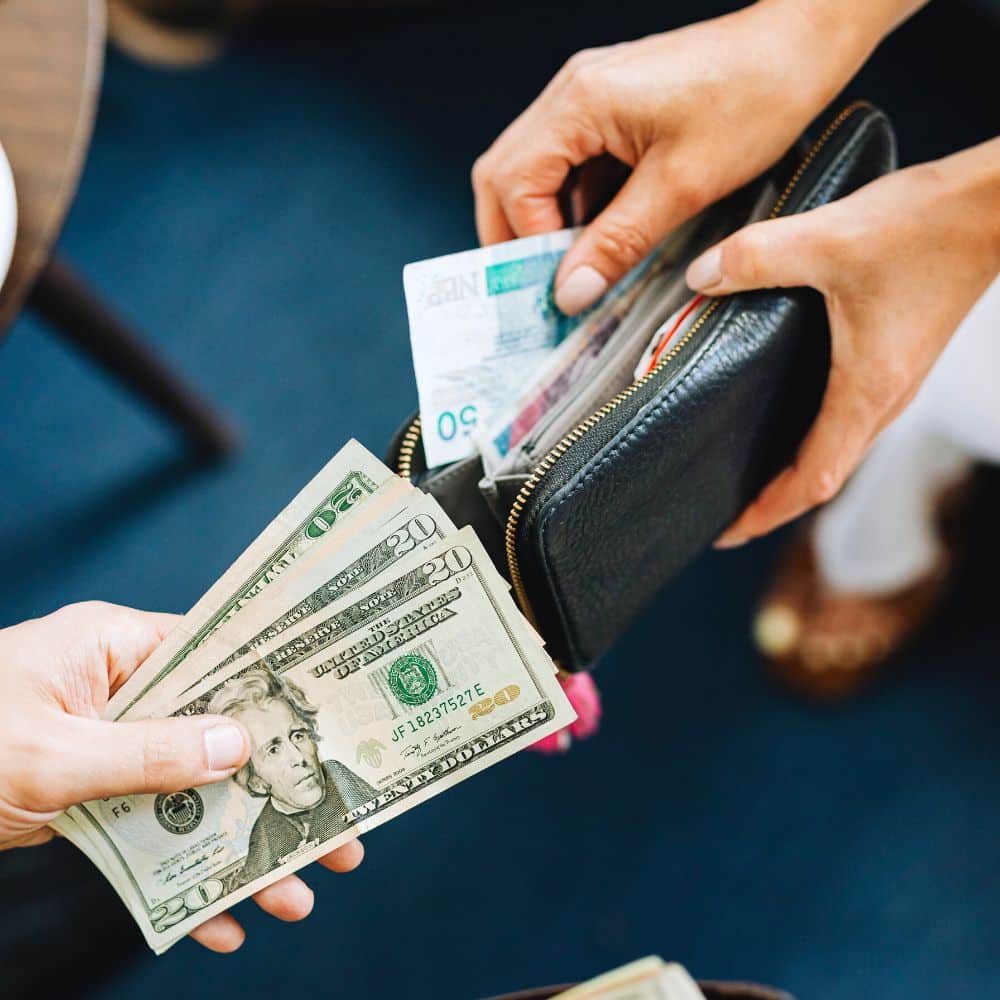
Korea is a safe, modern country and one that has pushed hard for the mass adoption of cards. Almost every location that deals with money is required to accept card payments. This is great news for travelers to Korea as you can use a card to pay for meals out, entrance tickets, trains, and lots more.
Cash is still needed for some things, such as topping up transportation cards like the T-Money Card (more on that soon) and for paying for small things like street food. Please note, as Korea doesn’t have a tipping culture, you don’t need cash for leaving a tip. In fact, if you try to leave a cash tip, it’ll be returned to you in most places.
Read on to find the best tips to avoid getting ripped off when exchanging money and how to pay the lowest fees when you use a card to pay in Korea. Be a smart traveler and save more money for shopping and souvenirs.
Korean Money Exchange Options
Once you arrive in Korea, there are several options for exchanging money. First, you can exchange money at a money changer in tourist areas such as Myeongdong. These money changers used to have the best rates in Seoul.
However, a better option these days is to use the currency exchange machines from WOW Exchange. These machines are located all over Seoul’s most popular tourist spots, stations, and hotels. They allow you to exchange foreign cash directly to Korean won, with better rates than at the airport. You can also use these machines to claim a tax refund for your shopping before heading to the airport. Both options require a passport.
Should I Change Money At The Airport?
Exchanging money at the airport is easy and convenient as you can instantly get cash to use for shopping, transportation, and general use. However, the exchange rate at the airport is usually much worse than you’ll find in other places in Korea, as mentioned previously. If you need cash as soon as you land, withdraw a small amount ($50) and then exchange the rest in Seoul.

Travel Money Cards For Korea
While cash is useful and familiar when traveling, a much better option is to use a travel money card (also known as a currency card). Travel money cards, such as the Wise Travel Money Card, allow you to pay for travel expenses without the need to carry cash or convert money.
A travel money card offers the convenience of using a credit card without high fees that a regular bank could charge. It also allows you to withdraw cash from an ATM without a fee (up to a limit), so you can avoid carrying any cash on the flight or using a money exchange. The exchange rate is the mid-market rate, meaning it’s better than you’ll find even at the money exchanges listed before.
Can I Use My Bank Card In Korea?
Credit cards are widely accepted in Korea. Visa and Mastercard users shouldn’t face a problem, but other cards aren’t as widely accepted. Debit cards and cash withdrawals might not work depending on the bank. Your bank may charge a fee when using it overseas, or give a bad exchange rate. Check with your bank before traveling.
The best option for travel money in Korea is to have a mixture of cash and cards, with a backup credit card just in case. Taking some USD with you is always a good option as you can find plenty of places to exchange it to Korean won and probably at a better rate than you’ll get in the US. If you want to withdraw money in Korea, look for the global ATMs in tourist areas.
Taking a travel money card will be safer, cheaper, and more convenient than relying on your own bank or credit card, too. These cards offer competitive rates and are widely accepted around the world so you can use them to visit other countries, too. If you use a travel money card and it gets lost or stolen, you can freeze the card instantly with the app and not have to worry about losing the balance on the card.
When you visit Korea, you’ll notice that most people pay for goods with a card or payment app, even for small purchases like a bottle of water. Unfortunately, the payment apps that are common in the US, such as Apple Pay or Google Pay, aren’t available in Korea. Korean apps, such as Kakao Pay, require a Korean bank account, and therefore aren’t an option for travelers.
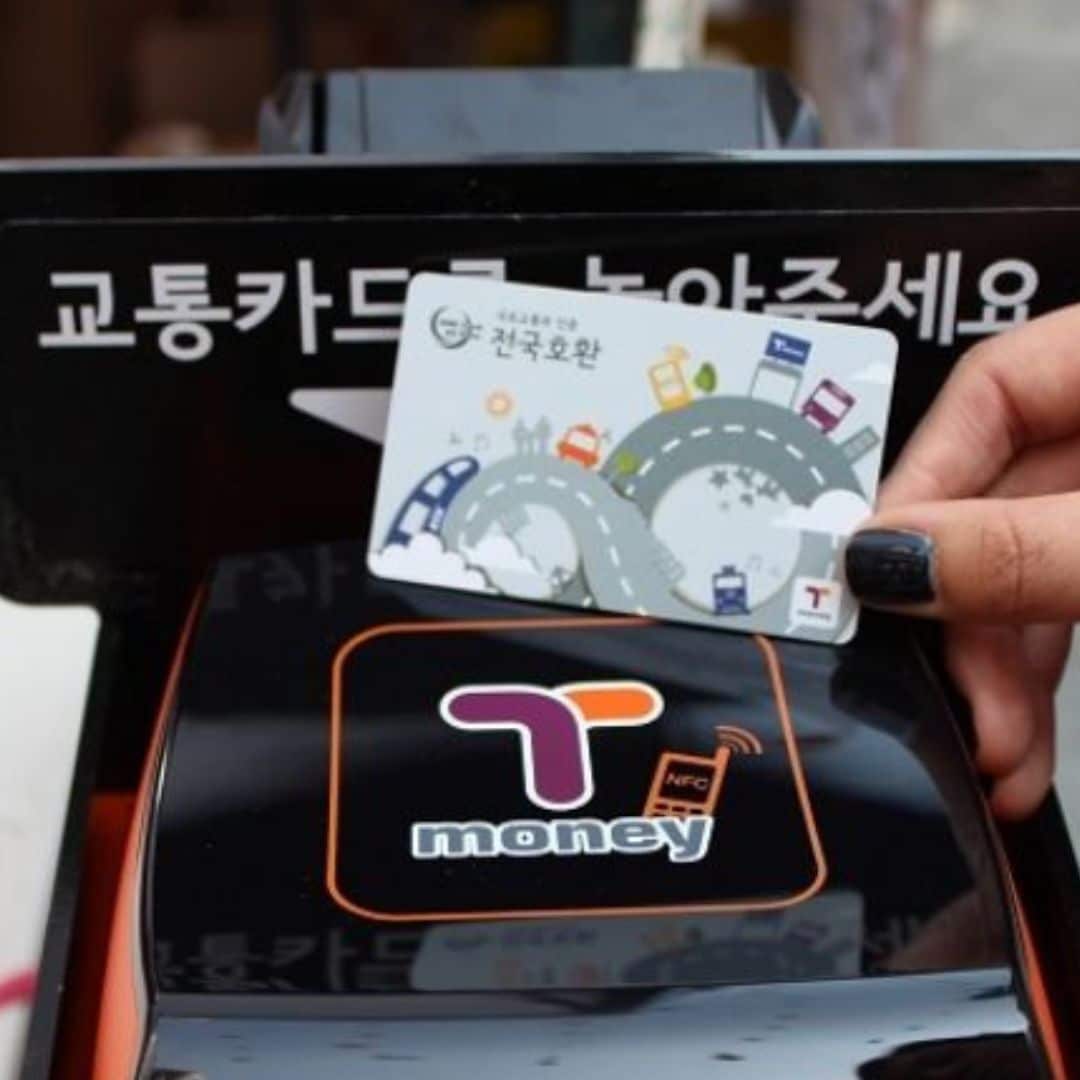
T-Money For Public Transport
The T-Money Card is an essential purchase for every traveler to Korea. The T-Money Card is a transportation card that allows contactless travel on Korea’s buses and subways. Simply buy a T-Money Card, top-up the card, then use it to travel.
Not only is this transportation card really convenient, it also saves you money. You’ll receive a discount on every bus or subway journey when you pay with the T-Money Card. These discounted fares are available in all cities across Korea, not just Seoul.
This isn’t the only use of the T-Money Card. You can also use to buy a coffee from Starbucks, get lunch in McDonald’s, shop for Korean cosmetics, and even to watch a baseball game. It’s a very useful card that can be used anywhere you see the T-Money Card.
You can get the T-Money Card in Korea from subway stations and at certain transport centers, including Seoul Station and Incheon Airport. The card costs 2,500 KRW. You can buy the card with a credit card, but to top-up the card, you need to use cash. If you buy a Discover Seoul Pass, this card includes the T-Money functions.
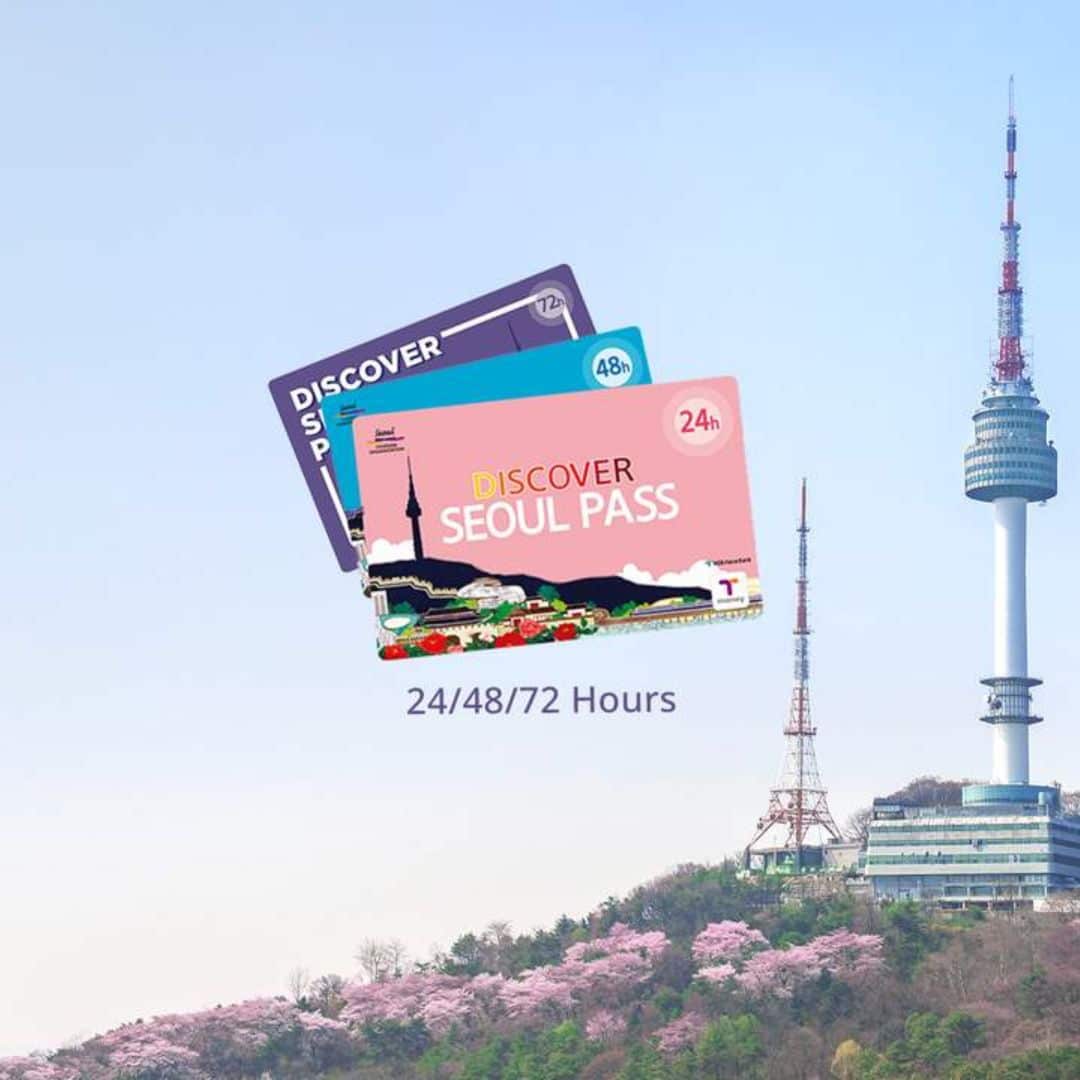

Save With The Discover Seoul Pass
Travelers to Seoul have a lot of options for incredible attractions to enjoy and experience. However, tourists, especially families, can find that the cost of these attractions quickly add up, especially when you are visiting many locations in a short time.
A great way to save money when you travel in Seoul is to buy a Discover Seoul Pass – a special card that offers you big savings on some of Seoul’s top attractions, as well as other benefits.
If you plan to visit Seoul’s Royal Palaces, N Seoul Tower, Lotte World Adventure Theme Park, the COEX Aquarium, Alive Museum, Seoul Zoo, or other premium attractions, you can gain free entry when you purchase a Discover Seoul Pass.
Not only that, you can also get a free river cruise, free hanbok rental, free ride on the Airport Express from Incheon Airport to Seoul, free City Tour Bus Ride, free T-Money Card and lots more.
The Discover Seoul Pass is valid for 24 | 48 | 72 hours and is valid from the moment you first use it until that many hours later.

Things To See & Do In Korea
If you want to build your own itinerary for South Korea, then this section of the South Korea Travel Guide will provide the building blocks you need to craft the perfect trip.
South Korea is a country packed with famous landmarks and sights, unique culture – modern & historical, family-fun activities, outdoor adventures, cozy cafe districts, and natural wonders. There’s more to do in Korea than you could imagine and it’s impossible to explore it all in one trip. Try to plan your itinerary by cities and locations. For example, plan your day in Seoul stay by district.
Here are some of the best things to see and do in South Korea, broken down into different themes so you can find things that interest you the most. The location of each of these attractions is included, too, so you can create a city by city itinerary, seeing the best South Korea has to offer.
These attractions are available all year round so whenever you go to Korea, you can enjoy them. There are plenty of things to see and do in Korea that only happen during certain seasons. Check out the Season Guide in this South Korea Travel Guide for more information about Korean festivals and seasonal events.
Here are 10 of the best Korean landmarks:
- Lotte World Tower (Seoul)
- Bukchon Hanok Village (Seoul)
- Nami Island (Gapyeong)
- Banwol ‘Purple Island’ (West Coast)
- N Seoul Tower (Seoul)
- Dongdaemun Design Plaza (Seoul)
- Seoraksan National Park (Gangwon Province)
- Hwaseong Fortress (Suwon)
- Cheonggyecheon Stream (Seoul)
- Gamcheon Cultural Village (Busan)
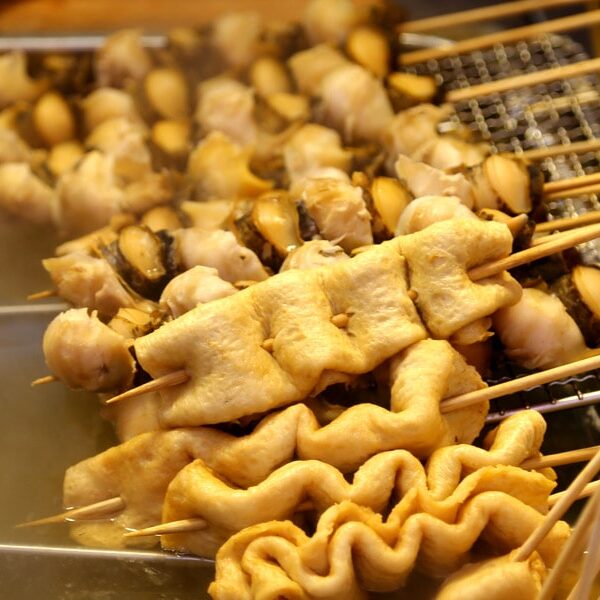
Why travel to a diverse country such as Korea and not embrace the local culture? Here are 10 of the best unique Korean experiences you can only enjoy fully in Korea. Be brave, try something new and create lasting memories of your Korean adventure.
Here are 10 of the best uniquely Korean experiences:
- Wear Traditional Korean Hanbok (Royal Palaces)
- Sing In A Korean Noraebang (Everywhere)
- Sleep In A Korean Hanok House (Hanok Villages)
- Visit The Kimchi Museum (Seoul)
- Eat Street Food (Traditional Markets)
- Experience A Korean Temple Stay (National Parks)
- Drink Makgeolli – Korean Rice Wine (Everywhere)
- Visit The World’s Most Dangerous Border – The DMZ
- Relax In A Korean Sauna (Everywhere)
- Visit A Korean Green Tea Field (Boseong, Jeju)

Here are 10 of the best Korean historic sights:
- Gyeongbokgung Palace (Seoul)
- The Secret Garden (Seoul)
- Bulguksa Temple (Gyeongju)
- Jeonju Hanok Village (Jeonju)
- Seoul Fortress Walls (Seoul)
- Haedong Yonggungsa Temple (Busan)
- Andong Hahoe Folk Village (Andong)
- Gyeongju Historic Area (Gyeongju)
- Baekje Historic Area (Gongju, Buyeo)
- Jangsaengpo Whale Museum (Ulsan)

Here are 10 of the best modern K-Culture spots:
- K-Pop Headquarters (Seoul)
- HYBE Insight (Seoul)
- COEX Artium (Seoul)
- K-Style Hub (Seoul)
- Hongdae Shopping Street (Seoul)
- Hallyu K-Star Road (Seoul)
- Asia Culture Center (Gwangju)
- Busan International Film Festival Square (Busan)
- MBC World Theme Park (Seoul)
As you’ll see, there’s just so much to see and do in Korea. You could spend a whole week in Seoul and not run out of exciting activities to do and sights to explore. Our advice is to try to avoid planning to do too many things in one day and adding in plenty of free time.
There’ll be many random things that catch your eye, such as a curious side street, or your nose, like the delicious smells from a food stall. Make sure you’ve got flexibility in your schedule to investigate these surprises and to take a rest if you need to – walking and traveling for days on end can get tiring.
Korea comes alive at night and markets and city streets are often best explored after the sun goes down. Drab concrete buildings come alive with neon signs, lanterns, and electric lights and are quite a sight to be seen. Visit popular tourist attractions such as the royal palaces and hanok villages during the morning as they’ll be less crowded.
If you plan to visit the Secret Garden in Changdeokgung Palace (you really should!), tickets are available on the day and sell out fast. Getting to these places early can guarantee you get tickets, see the sights unobstructed, and have time in the evening to soak up the night life and culture.
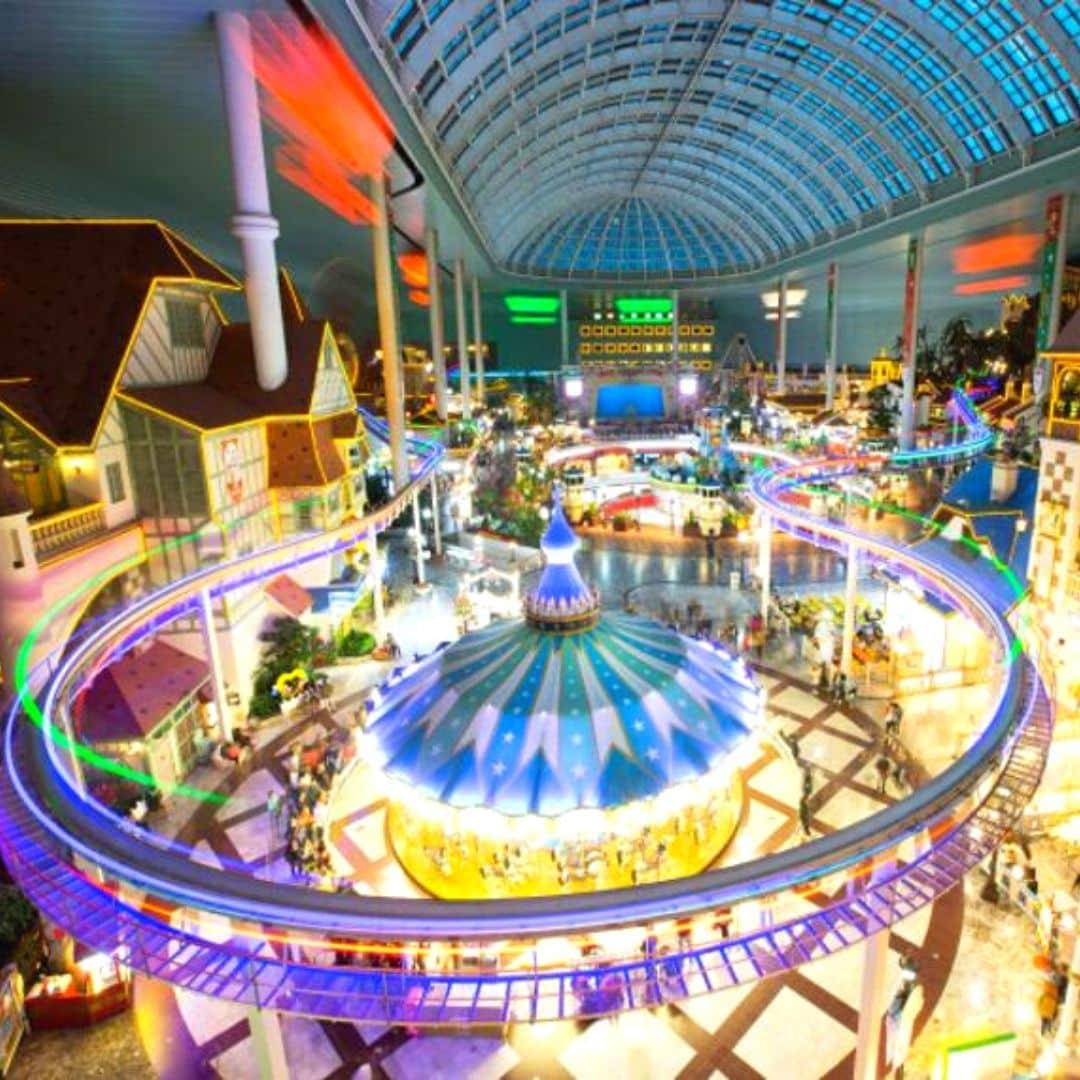
Here are the 10 best family-friendly activities in Korea:
- Nami Island & Garden of Morning Calm (Gapyeong)
- Seoul Grand Park & Zoo (Seoul)
- Lotte World Adventure (Seoul, Busan)
- Alive Museum & Dynamic Maze (Seoul)
- Seoul Children’s Grand Park (Seoul)
- Seoul Children’s Museum (Seoul)
- Everland & Caribbean Bay Theme Parks (Near Seoul)
- Sea Life Busan Aquarium
- Jeju Dinosaur Island (Jeju)
- Alpaca World (Gangwon Province)
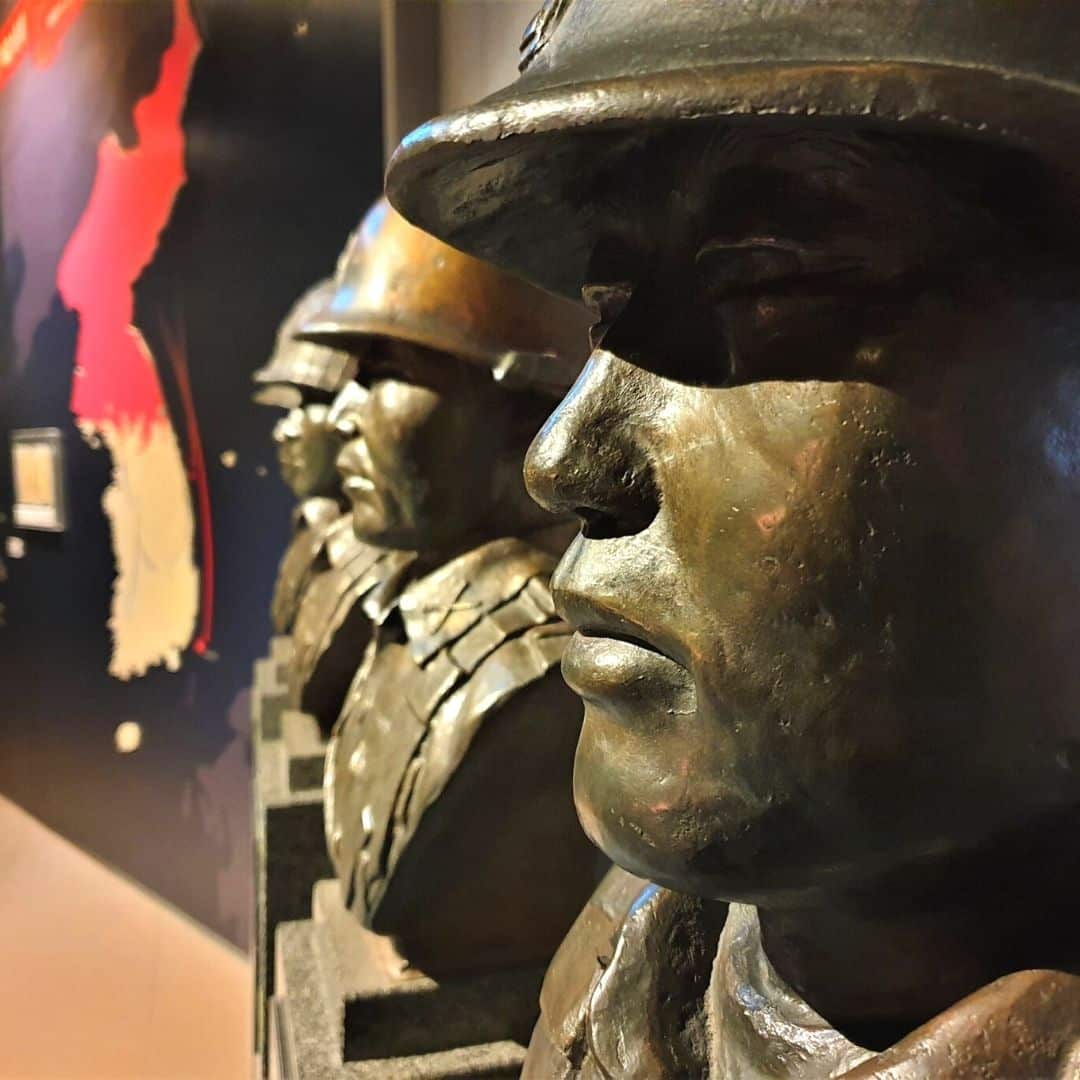
Here are the 10 best museums & galleries in Korea:
- National Museum of Korea (Seoul)
- Seoul Museum of Art (Seoul)
- Gyeongju National Museum (Gyeongju)
- War Memorial of Korea (Seoul)
- National Folk Museum of Korea (Seoul)
- National Maritime Museum (Busan)
- Seodaemun Prison History Museum (Seoul)
- Seoul Museum of History (Seoul)
- Museum Kimchikan (Seoul)
- Daegu Art Museum (Daegu)

Here are the 10 best cafe areas in Korea:
- Ikseondong Hanok Village (Seoul)
- Gyeongui Line Hongdae (Seoul)
- Samcheondong Cafe Street (Seoul)
- Jeonpo Cafe Street (Busan)
- Hwangnidan-Gil (Gyeongju)
- Gangneung Coffee Street (Gangneung)
- Sinsa-Dong / Garosugil Road (Seoul)
- Jukjeon Cafe Street (Seoul)
- Hwaseong Haenggung Area (Suwon)
- Kim Kwang Seok Gil Street (Daegu)

Here are 10 of the best Korean markets and shopping areas:
- Gwangjang Market (Seoul)
- Myeongdong Market Area (Seoul)
- Jagalchi Fish Market (Busan)
- Centum City Mall (Busan)
- IFC Mall (Seoul)
- Starfield COEX Mall (Seoul)
- Nambu Market (Jeonju)
- Seomyeong Underground Shopping Center (Busan)
- Seogwipo Maeil Olle Market (Jeju)

Here are 10 of the best natural sights in Korea:
- Hallasan Mountain (Jeju)
- Jirisan National Park (Jeollanam Provice)
- Seoraksan National Park (Gyeonggi Province)
- Seongsan Ilchulbong Sunrise Peak (Jeju)
- Damyang Juknokwon Bamboo Forest (Damyang)
- Boseong Green Tea Plantation (Boseong)
- Haeundae Beach (Busan)
- Udo Island (Jeju)
- Hwaamdonggul Cave (Gangwon Province)

Travel Itinerary For Korea
When planning a travel itinerary for South Korea, it’s best to think about what kind of experience you want when you travel to South Korea and build your itinerary from that. What kind of traveler are you and what do you want to take away from your Korea trip? Are you planning a trip for yourself, for your family, or as a romantic escape?
Do you want to learn about traditional Korean culture and history? Are you visiting to immerse yourself in modern Korean culture and maybe meet your idols? Are you planning to get out into Korea’s mountains to hike and join a Buddhist Temple Stay? Or are you going to eat, drink, shop, and make the most of Korea’s discounted goods? Or all of the above?
This section of this South Korea Travel Guide will offer some of the best one-week and two-week itineraries for South Korea. These itineraries are rough guides, created to help you begin planning your trip. Feel free to pick and choose the parts from them that you like to create your own travel itinerary for South Korea. We’ll be adding more great itineraries soon, be sure to check back for the latest ideas.
Classic 1 Week Itinerary For Korea: Seoul, Busan, Gyeongju
This is one of the most popular of the 1-week itineraries for South Korea and will take you to the most famous and interesting places that are top of most travelers’ South Korea bucket lists. Starting in Seoul, Korea’s capital, you’ll explore the best sights in this city before taking a day trip out to the lovely Gapyeong County to get a breath of fresh Korean countryside air.
From day 4, zip across the whole of Korea on the high-speed KTX train and explore Korea’s second city, Busan. See coastal temples, fish markets, wide beaches, and more in Busan before taking a day trip to Korea’s historic UNESCO World Heritage City, Gyeongju. On the last day, it’s time to return to Seoul to pack your bags full of the best souvenirs and snacks and say farewell in the highest part of the city.

Afternoon : Dressed in your hanbok, enjoy more traditional Seoul with a walk around the narrow streets of the Bukchon Hanok Village. Visit traditional Korean teahouses, galleries, markets, and more.
Evening : Check out the stalls and shops of artsy Insadong, contemplate Jeogyesa Temple, and take an evening stroll along the Cheonggyecheon Stream before dining in Myeongdong or the Jonggak Avenue of Youth. This Full Day Tour of Seoul will show you some of the hottest spots in the city, while this Customized Private Tour of Seoul will allow you to choose where to go.
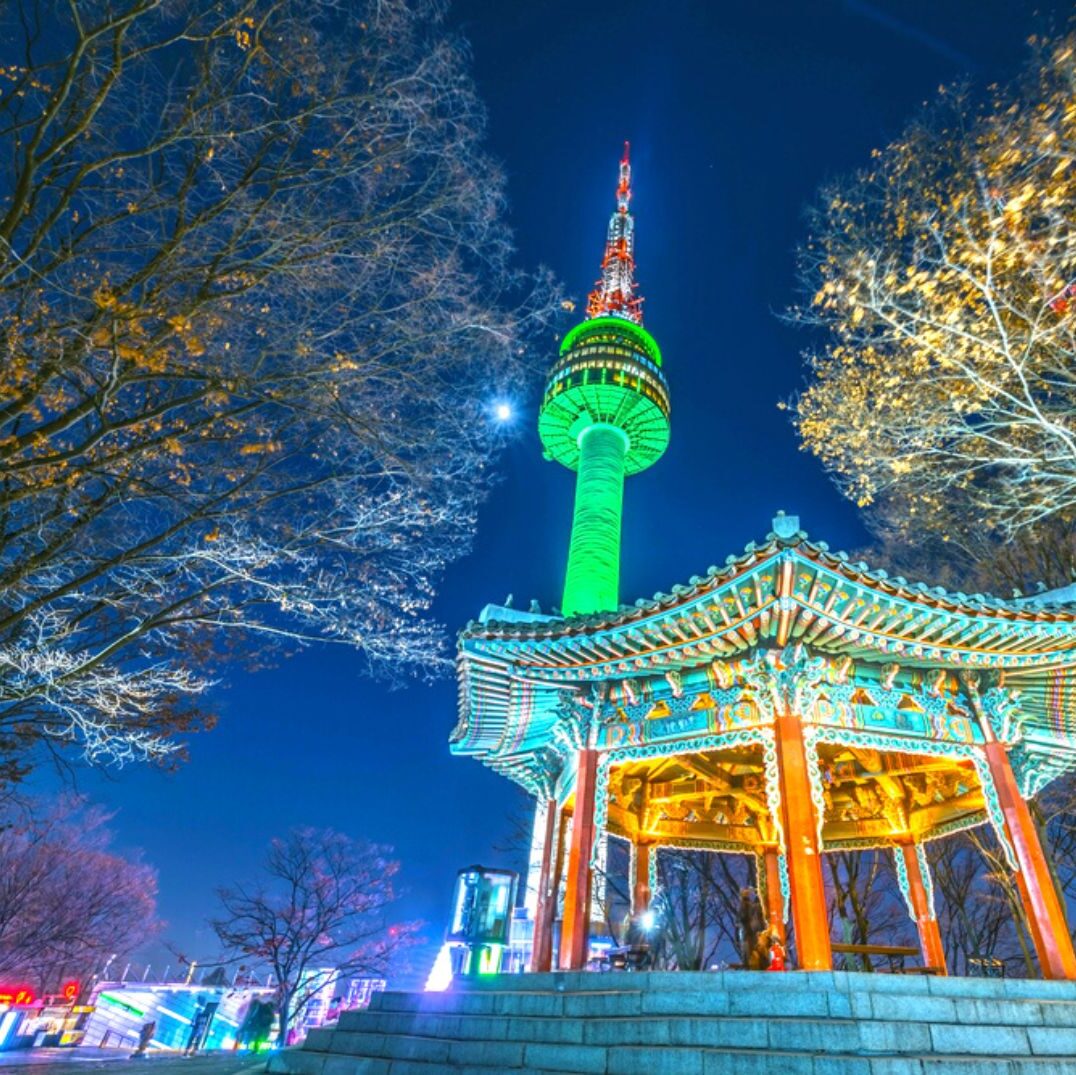
Afternoon : Head back to central Seoul and witness the bustling sights and delicious smells of Seoul’s traditional Gwangjang and Dongdaemun Markets. Try delectable Korean street foods here.
Evening : Take the Namsam Cable Car to the top of Namsan Mountain and watch the sunset from N Seoul Tower. See some of Seoul’s fortress walls before heading back down to go late-night shopping at Myeongdong Market.
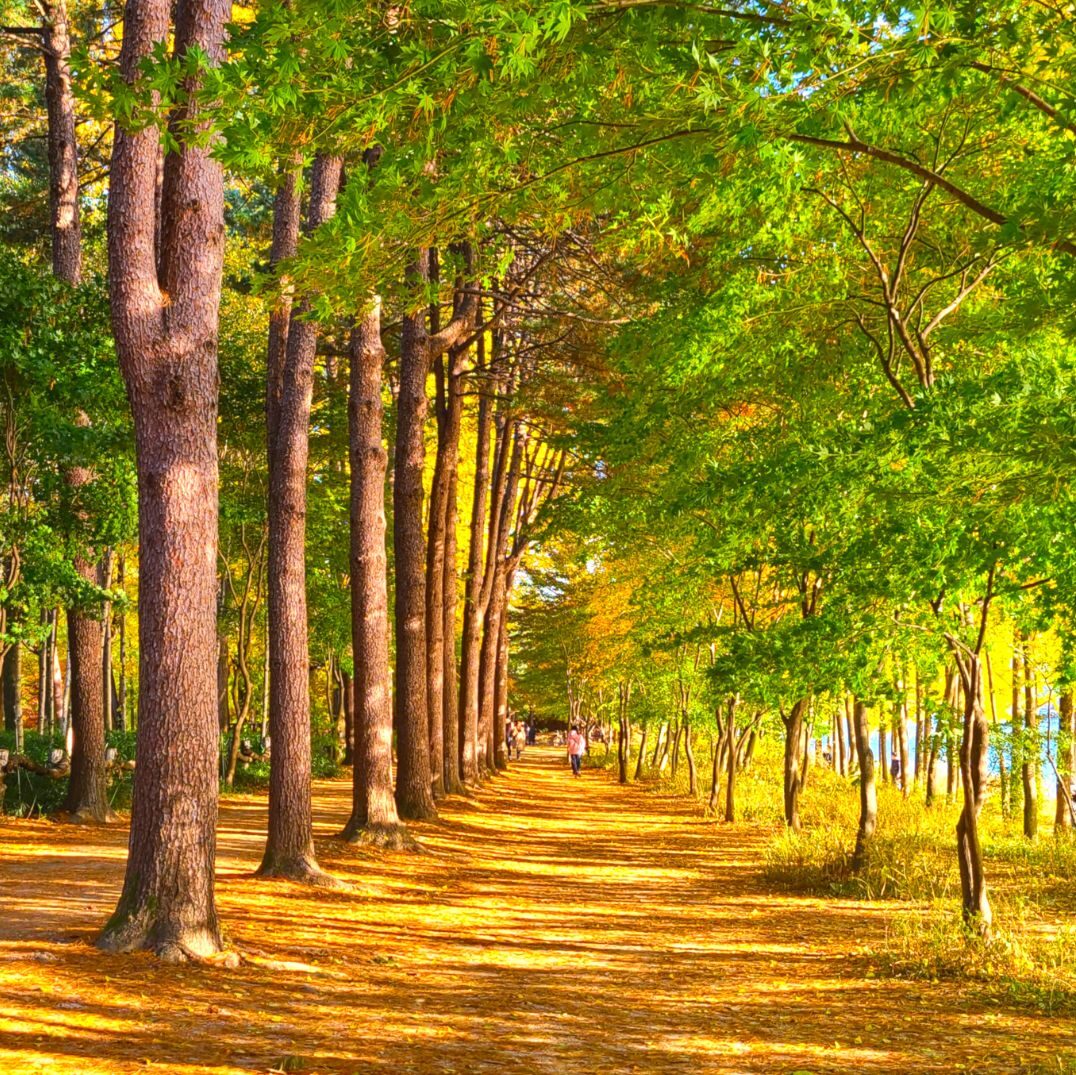
Afternoon : Zip line or sail over to Nami Island for impressive nature, bike rides, leafy walks, and cozy cafes. See popular scenes from K-dramas and even some wild animals, like deer and rabbits.
Evening : Pedal your way along an abandoned railway at the Gangchon Rail Bike Park before heading back to Seoul for fine dining in Gangnam’s Apgujeong Rodeo district.
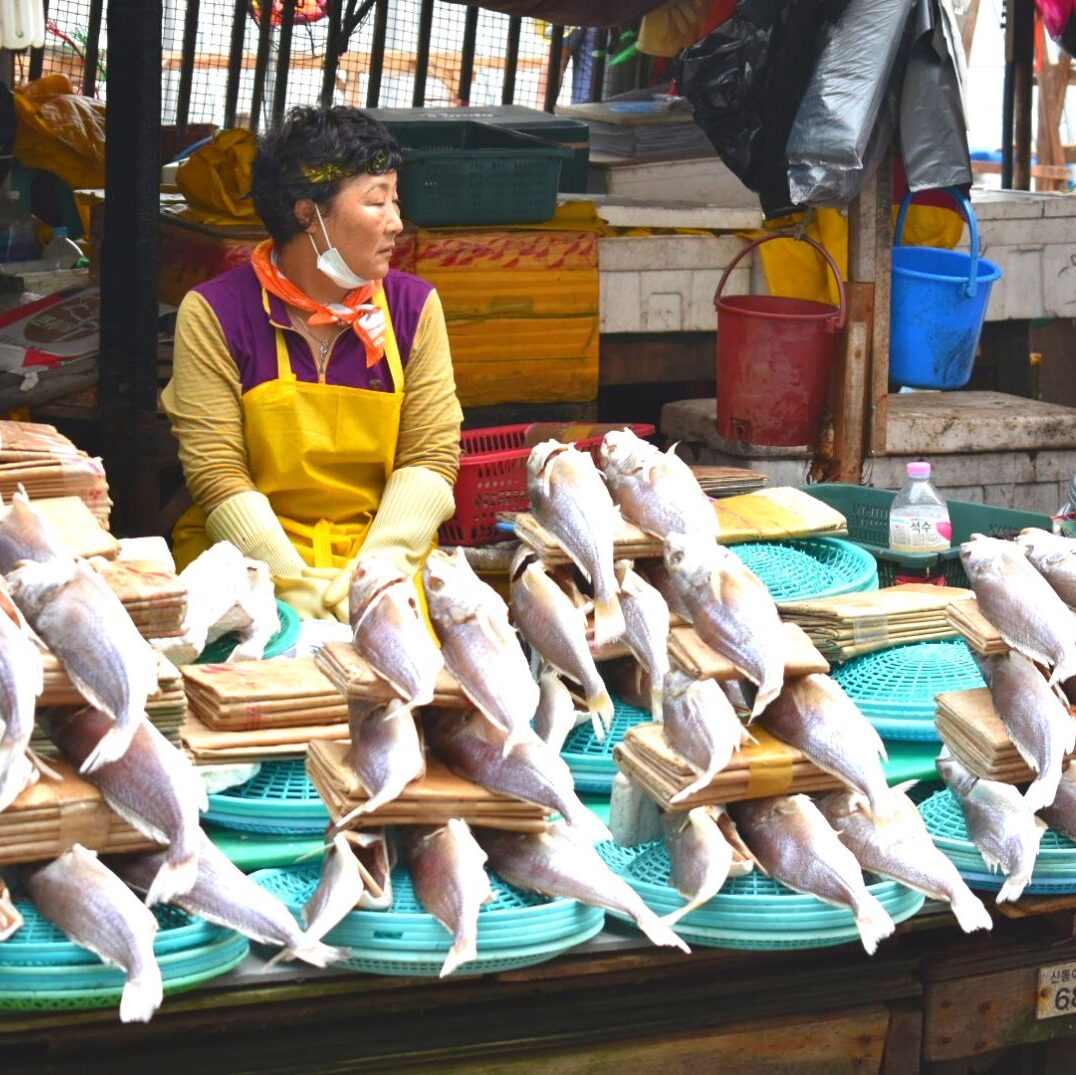
Afternoon : Head to the Nampo-dong near Busan Station and visit Jagalchi Market for a fresh seafood lunch. Then explore cosy Bosu-dong Book Alley or take a taxi to the Huinnyeoul Culture Village.
Evening : Take the subway up to Haeundae Beach for Busan’s best night-scenes. Grab dinner overlooking the beach, or at one of the market stalls. If you’re feeling brave, visit BUSAN X the SKY to see breathtaking views over the coast and city.

Afternoon : Head to the Gyeongju Gyochon Traditional Village for a traditional meal and to see the stunning Woljeonggyo Bridge. Gyeongju National Museum is nearby, too.
Evening : See the tranquil night views of Wolji Pond where palace buildings reflect perfectly in still waters. Stop at Hwangnidan-gil area for dinner and drinks before returning to Busan.
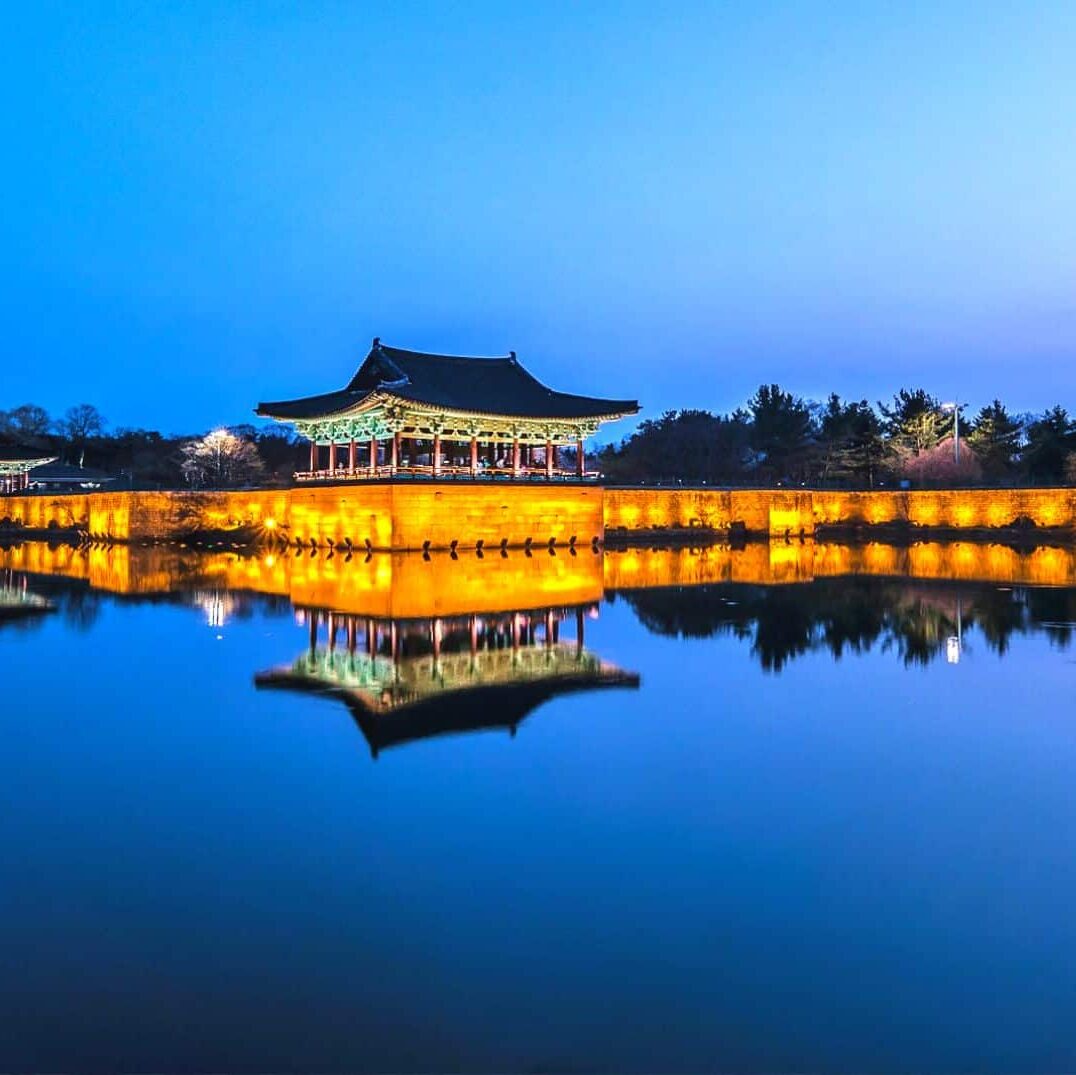
Afternoon : Explore the artistic shopping streets of Hongdae for last minute souvenirs and gifts for yourself. Take a break in one of the unique animal or artsy cafes.
Evening : Either take a night cruise along the Han River from Yeouido Hangang Park or dine in style at the Lotte World Tower in Jamsil, the world’s 6th tallest building. Both offer great night views of Seoul and unforgettable memories to take home.

Korean Seasons Guide
The best time to visit South Korea is during the warm spring or fall seasons. The weather is mild and clear, there’s a range of festivals and seasonal activities to enjoy, and you can travel to Korea comfortably.
The best months to visit are April, May, September, and October. These months are all during the Korean school semester, so there won’t be as many local travelers around during the weekdays. However, expect the weekends to be busy as people leave the cities to travel within Korea.
Large public holidays, including Chuseok (mid-autumn festival) in September / October) and Buddha’s Birthday (May), provides travelers with the opportunity to experience Korean culture and celebrations. These holidays change each year based on the lunar calendar.
Korean Weather & Climate
South Korea is a country that experiences four very distinct seasons, with temperatures ranging from 100 Fahrenheit in the summer to below 0 Fahrenheit in the winter. Each of South Korea’s seasons brings opportunities to see unique natural views and enjoy the different climates in Korea.
Spring has some of the gentlest weather, with light rain and a quick jump in temperature to the 60s and 70s by late March. Summer begins with the rainy season in late June and becomes extremely humid and hot throughout July and August before cooling again in September.
Fall has the best weather in Korea, with many warm, sunny days. Cold winter weather appears very quickly in mid-November and the first snow usually appears by late November. Winter is dry and sunny with the lowest chance of rainfall but is also very cold. Snow isn’t constant, but can fall for several weeks on and off during winter.
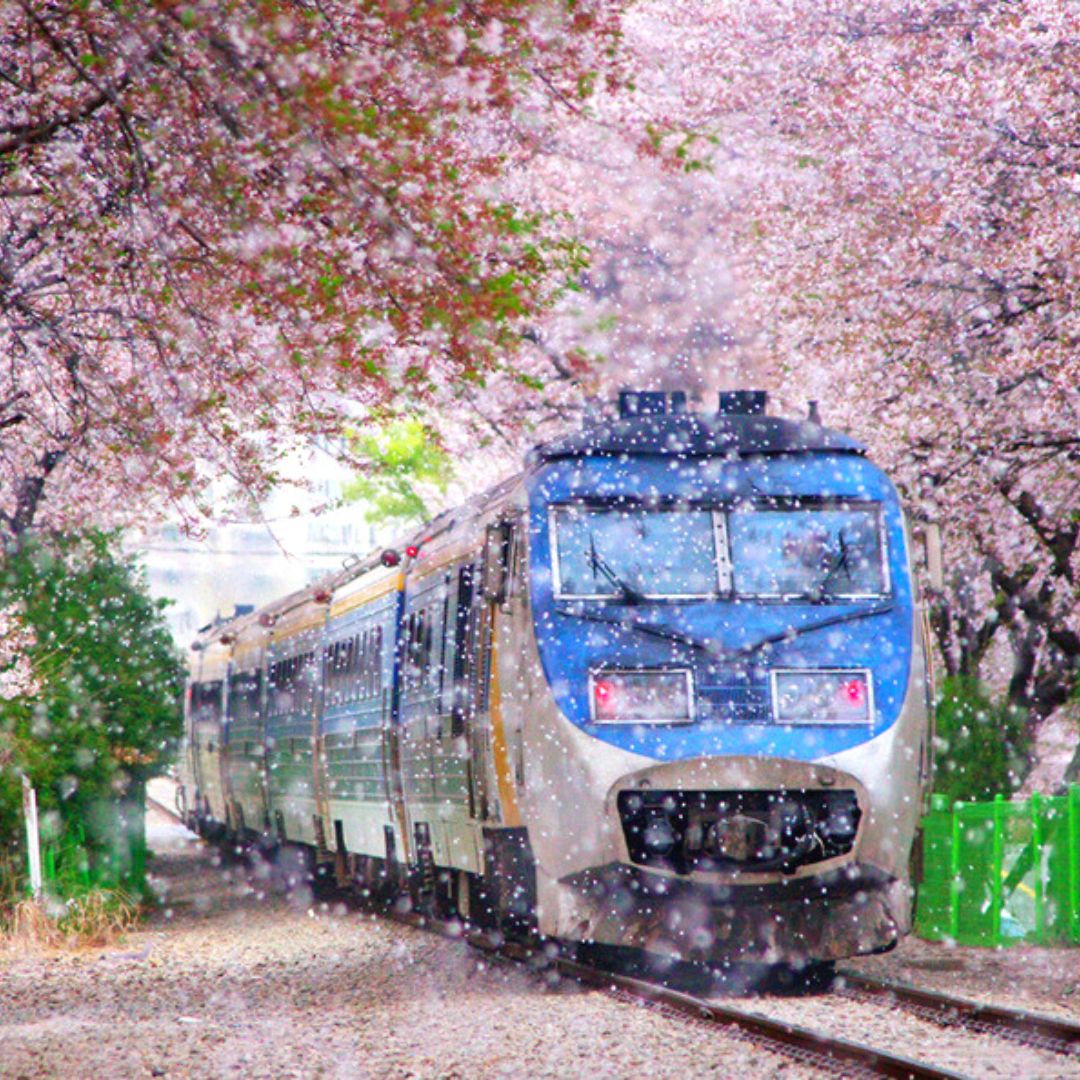
Visiting in spring offers the chance to see beautiful cherry blossoms stretch across the country, as well as many other spring flowers that brighten up Korea after a cold winter.
Spring starts in late March with the awakening of the cherry blossoms and ends in early June with the start of the rainy season. South Korea is a country with a close connection to nature, which can be witnessed in the many spring festivals and celebrations that happen throughout the year.
Some of the best spring festivals include the Jinhae Cherry Blossom Festival, Damyang Bamboo Forest Festival, Yeon Deung Hoe Lotus Lantern Festival, Jindo Sea Parting Festival, and Boseong Green Tea Plantation Festival.

The weather in summer is perfect for getting outside and relaxing on one of Korea’s many beaches. Some of the best activities include spending a weekend camping or glamping by the beach, hiking in shaded valleys in the national parks, and water sports such as surfing, kayaking, and scuba diving.
Unfortunately, the heat may put off some travelers, and high humidity makes it uncomfortable to move around too much. Fortunately, Korea is a modern country with lots of air-conditioning and ways to deal with the hot weather, including delicious summer dishes.
Cool down with a bowl of Korean bingsu (shaved ice dessert) or a cool latte in one of the many cozy Korean cafes in popular beach destinations.

Travelers to Korea in the fall are treated to spectacular fall foliage creeping far and wide. You can see it falling on palace grounds, sprawled on mountains in national parks, and along city streets.
The start of the fall foliage season in Korea coincides with the end of the hot and humid summer, with clear skies and cool weather, making it the perfect time to travel in Korea. Like spring, the fall season in Korea is one of the festivals and celebrations.
The Chuseok holidays in late September / early October are the biggest public holidays of the year, with cultural events held in popular tourist destinations. There’s also a range of cultural festivals, such as the Andong Mask Festival, Baekje Culture Festival, Jinju Namdang Yudeung Lantern Festival, Jeonju Bibimbap Festival, and the Seoul Kimchi Festival.

Winter, like summer, has more extreme weather than spring and fall, with temperatures often in the 20s and 30s and below. This season, however, is also one of the best for travelers who want to see clear, blue skies and experience good weather.
Winter is the driest season and it very rarely rains. If you don’t mind the cold weather, it’s perfect for traveling around South Korea. One of the biggest draws during winter is the chance to see snowy Korean landscapes, from snow-bedecked royal palaces to frosty peaks atop Korea’s many mountains.
Winter sports are popular in Korea, with ski and snowboard resorts aplenty. Winter also offers the chance for family fun with winter attractions including sledding, winter illuminations, and Christmas parades.

Cost To Travel To Korea
The cost to travel in South Korea largely depends on your personal style of travel. You can travel on a low budget in Korea, for under $50 per day, or you could also travel for 10 times that amount if you wished to.
Food costs range from a few dollars for a bowl of jajang (black soybean) noodles to hundreds for premium hanwoo (Korean beef) steak. The same applies to accommodation, with budget hostels costing $10 per night and premium 5 stars hotels costing hundreds.
Most travelers to Korea will already know what they want to prioritize their spending on. Some travel to Korea to eat, others to shop, and many more to experience the unique culture and history that Korea has to offer.
The costs in this section of our South Korea Travel Guide are based on the latest costs in Korea from this year. Examples of different costs have been covered to give you an idea of what to expect when you try to budget.
Please note, these prices are based on traveling in Seoul during non-peak times. Prices may be higher in peak times, which include cherry blossom season (Apr) and fall foliage season (Oct). Popular tourist cities, such as Gyeongju and Jeonju, may also have higher prices on weekends.
How Much Does It Cost To Travel In South Korea?
Travelers may find they want to spend more on hotels and less on eating out, or vice-versa, so don’t feel like you have to only follow the costs for one section. This is only a guideline to help you plan based on your own personal preferences.
To make it easier to figure out your expected costs to travel in Korea, this South Korea Travel Guide has broken down the costs into 3 different categories. These categories loosely fit 3 different types of travelers, as described below:
- Accommodation: $200+ per night, per room (double)
Korea has a wide range of luxurious hotel options, including rooms in the Lotte World Tower, historic hanok houses, and glamping for those who want to escape to the countryside.
- Food & Drink: $100+ per day, per person
It’s easy to spend a lot on food and drink in Korea as there are so many delectable restaurants. Fresh seafood, Korean steak, or the finest foreign foods are all available.
- Transportation: $20+ per day, per person
Taxis and transportation are relatively cheap in Korea. A taxi journey across Seoul can cost less than $20 for 30 minutes and even the 1st class options on Korea’s high-speed trains are under $100 for the longest journey (Seoul to Busan).
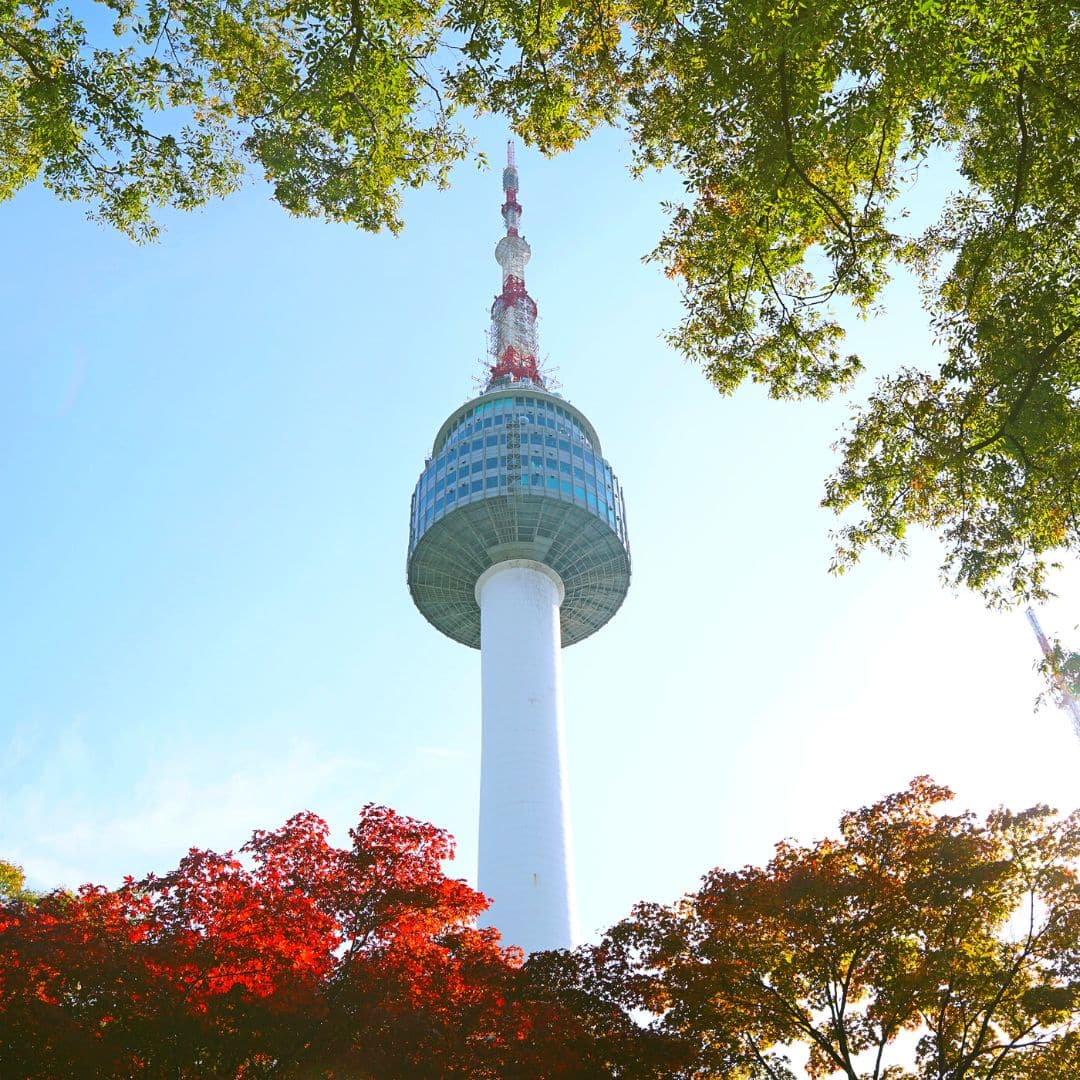
- Accommodation: $100 ~ $200 per night, per room (double)
You can book 4-star hotels in Seoul for very reasonable prices and enjoy both comfort and lower prices than you’d find at home. Korea has a wide range of comfortable mid-priced hotels.
- Food & Drink: $50+ per day, per person
With all-you-can-eat Korean restaurants that serve unlimited Korean BBQ and other dishes for under $20 or $30 per person, it’s easy to enjoy the best food Korea has to offer without breaking the bank.
- Transportation: up to $15 per day, per person
Use the subway and buses to get around the big cities and trains to travel further around Korea without breaking the bank. You can even splash out on a taxi and pay only a few dollars per person when traveling as a group for a few dollars extra.
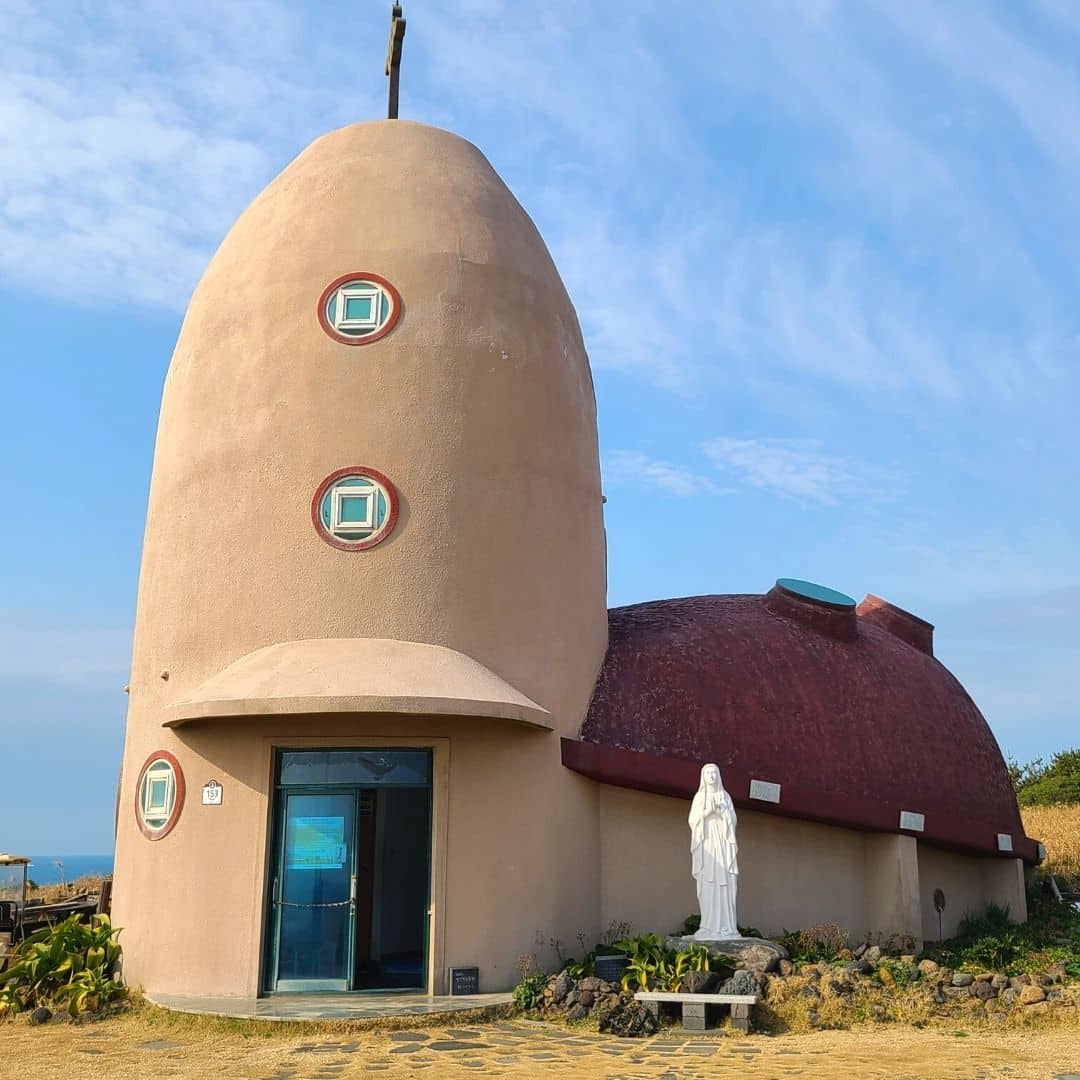
- Accommodation: up to $100 per night, per room (double)
Hostels and guesthouses can be found for under $50 per night and are perfect for somewhere to rest and recharge. If that’s all you need, save money here and spend it elsewhere.
- Food & Drink: $20 – $30 per day, per person
If you budget well and stick to street food, free hotel breakfasts, and convenience store foods, you can eat well and still have enough to splurge on good food for dinner.
- Transportation: up to $10 per day, per person
Walking and buses are cheap and convenient ways to travel around Korea’s biggest cities. Traveling from city to city is also cheap, with intercity buses costing less than $10 for 1-2 hour journeys.

Further Costs To Travel In South Korea
Besides these everyday costs to travel in South Korea, there are other costs that you’ll need to cover from time to time. These costs include internet & phone access, day trips, activities, souvenirs, travel insurance, and flights. These costs will be broken down into low and high-end costs that you can expect to pay in Korea.

Museums and galleries offer unique (and authentic) Korean souvenirs such as pottery, painting, tea & soju sets, and more. If you want something a bit more special, head to the underground markets near Gwangjang Market in Seoul and get your own handmade hanbok, which you can get posted back home to save luggage space.
- Small Souvenirs: $5+
- Korean Cosmetics: $5+
- Korean Artworks: $10+
- Korean Tea (box of): $10 to $20
- Korean Soju Set: $10 to $20
- Korean Handcrafts: $10+
- Tailored Hanbok: $200+
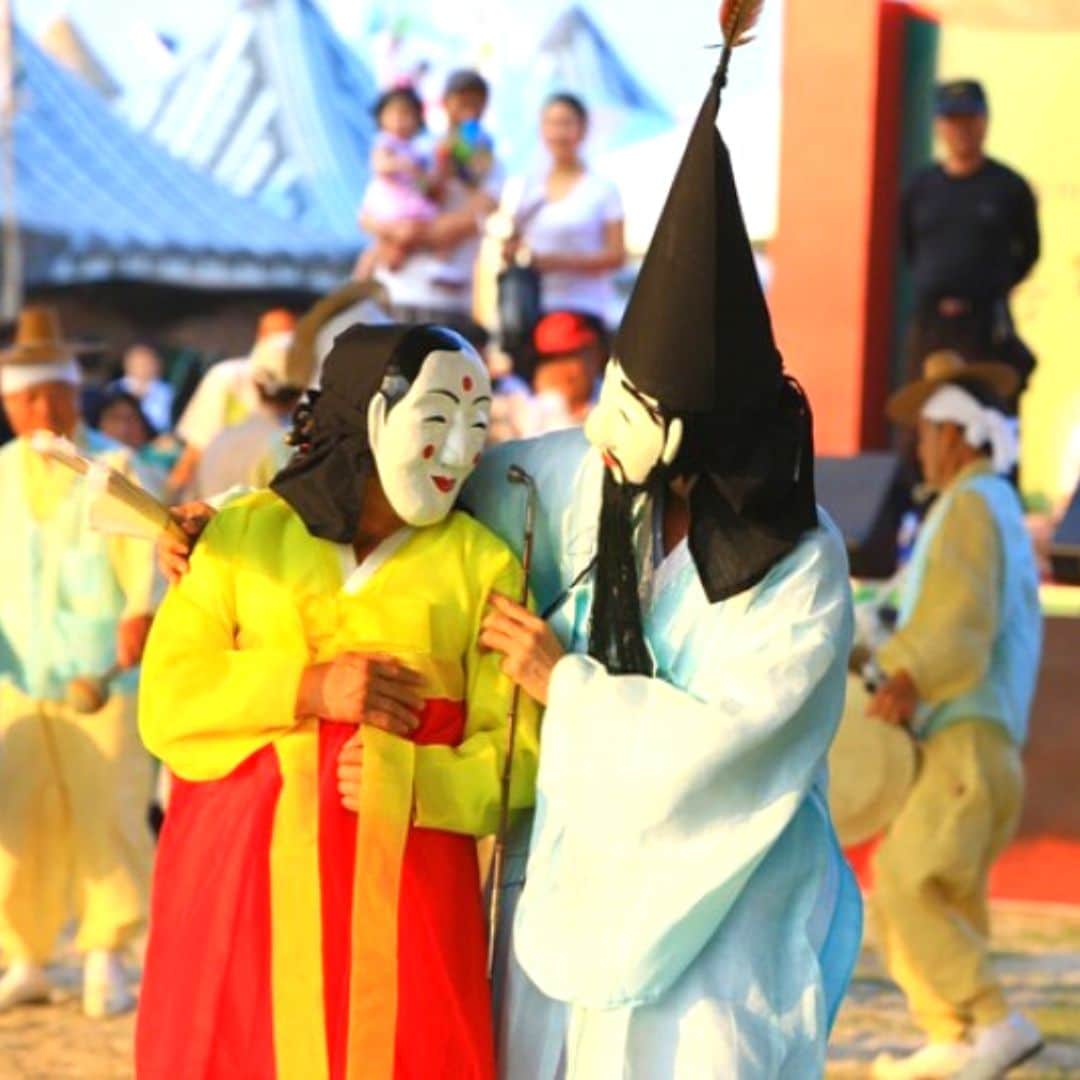
The day trip prices quoted below are the prices you can expect to pay with a reputable tour company like Klook or Trazy . Hiring a private guide will be a lot more expensive and might come to $200+ per day.
Please note: The prices quoted below are estimates and may change depending on the season or tour services.
- DMZ Tour – $50 to $120
- Nami Island Area – $40 to $70
- Everland Theme Park – $30 to $50
- Jeonju Hanok Village – $50 to $70
- Korean Folk Village – $50 to $60
- Seoraksan Mountain – $70 to $150
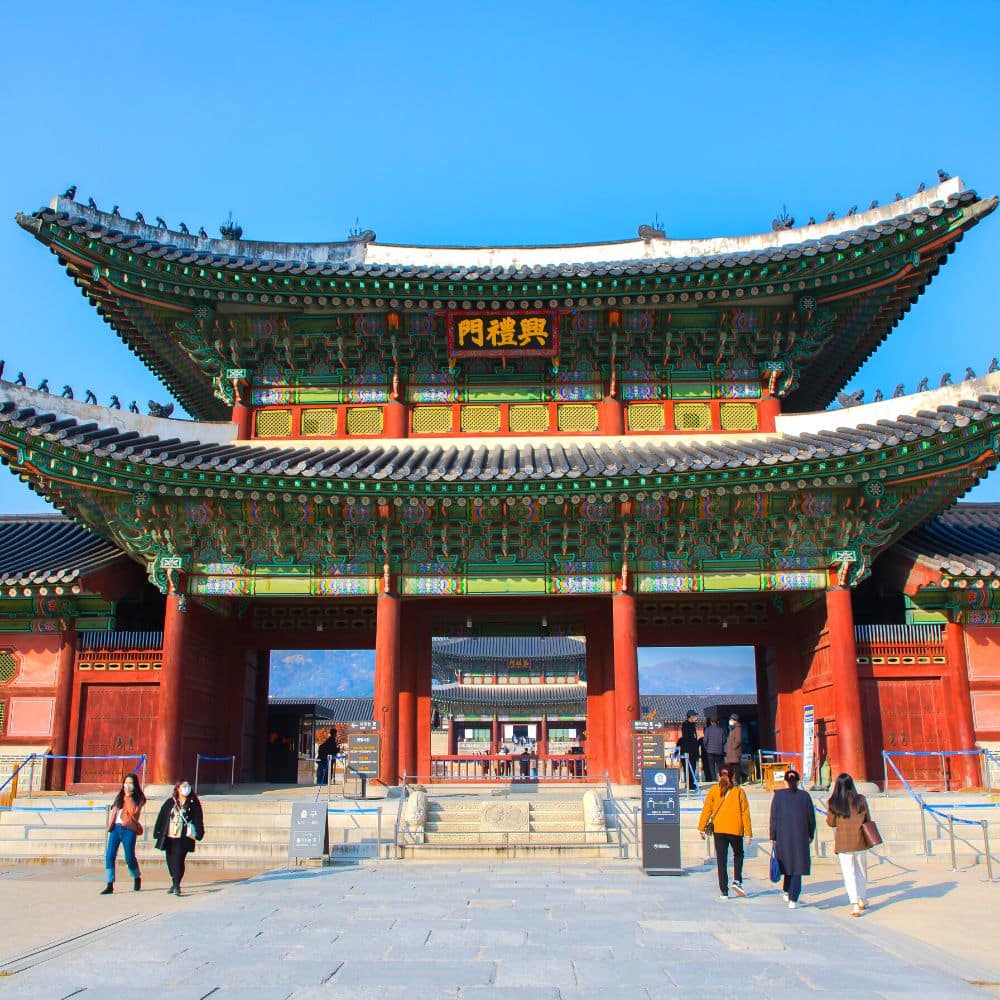
As mentioned earlier in this South Korea Travel Guide, buying a Discover Seoul Pass is a great way to save money on Seoul’s premium attractions.
- Royal Palaces – $3
- N Seoul Tower – $10
- Hanbok Rental – $10+
- Seoul City Tour Bus – $10
- Han River Cruise – $15 to $30
- Seoul Sky Observatory – $30 to $50
- Aquariums – $20 to $30
- Seoul Zoo & Seoul Grand Park $10
- Amusement Parks – $30 to $40
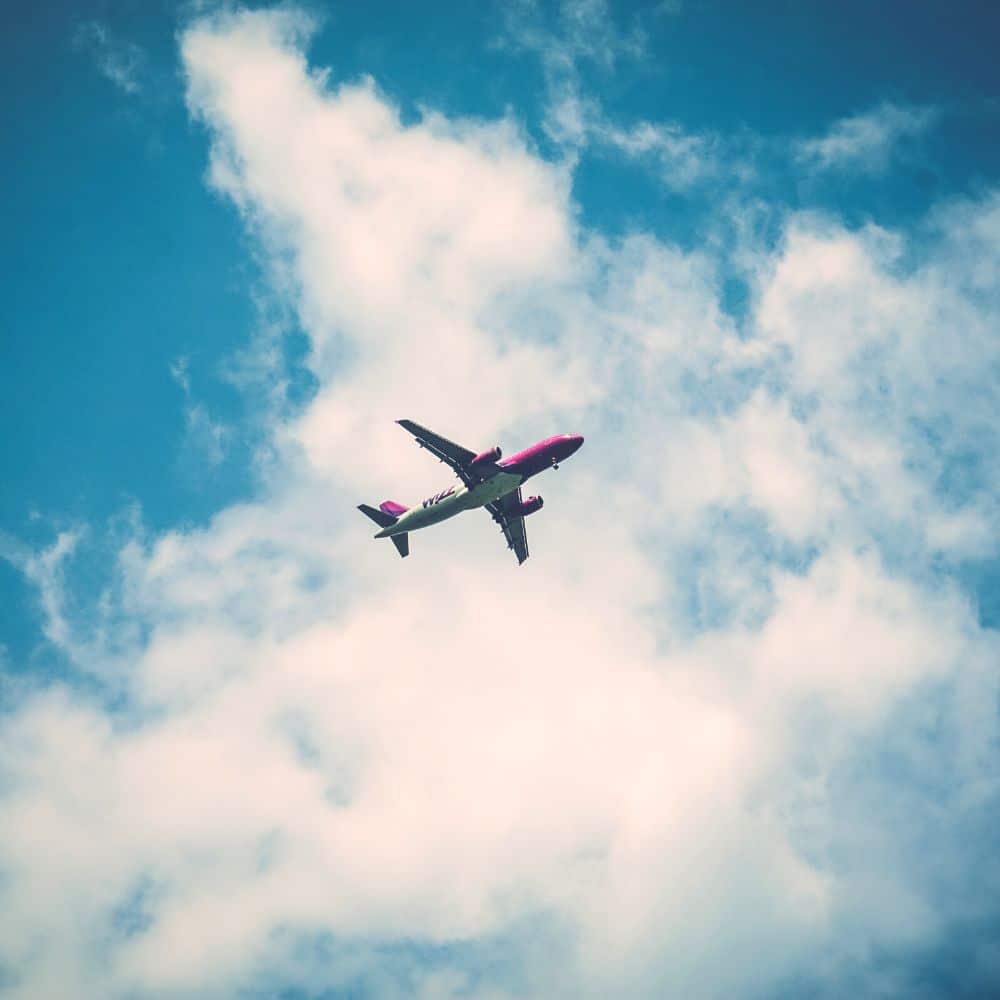
The cost to fly to Korea is more than twice the normal price right now. Fortunately, Korea ended the restrictions on the number of flights into the country from June 2022 and flight costs and availability should be improved in the near future.
Best of Korea recommends Skyscanner and Expedia for the best flight deals to Korea.

Why Travel To South Korea?
In recent years, travelers from around the world have been increasingly drawn to South Korea. The country is a must-see destination in Asia, with more than 17 million travelers in 2019. After reading this South Korea Travel Guide, you’ll understand what draws so many people to the Land of The Morning Calm, as Korea is also known.
There are myriad reasons why people visit Korea. Many come to experience life in a unique country, packed with historical and cultural sights that you won’t find elsewhere in the world. In the afternoon you can walk through a royal palace dressed in hanbok (traditional Korean clothes), sip green tea in a hanok (traditional Korean house), and pass Buddhist monks walking peacefully through an ancient temple.
Modern South Korean culture is conquering the world, with chart-topping acts that include BTS and Black Pink, Oscar-winning movies like Parasite, and phenomenally successful TV shows like Squid Game. This brings in legions of fans flocking to shooting locations and film sets to relive their favorite K-Culture moments. Some lucky travelers even get to catch sight of their favorite K-Stars walking around Gangnam, a hotspot for Korea’s most famous citizens.
Not only is Korea a beautiful country, it’s a country that will make you beautiful, with some of the world’s best fashion and beauty shops. Korea is famous for its K-Beauty products and is a beauty and fashion shoppers paradise. From the street fashions of Hongdae, to the luxurious fashion malls of Gangnam, and the wall-to-wall malls with discount clothes in Dongdaemun, you’re guaranteed to find something you can’t resist at a great price. If you prefer a cultural shopping experience, there are traditional markets all over Korea, where you can experience street food, buy novel gifts, and see how locals live and socialize.
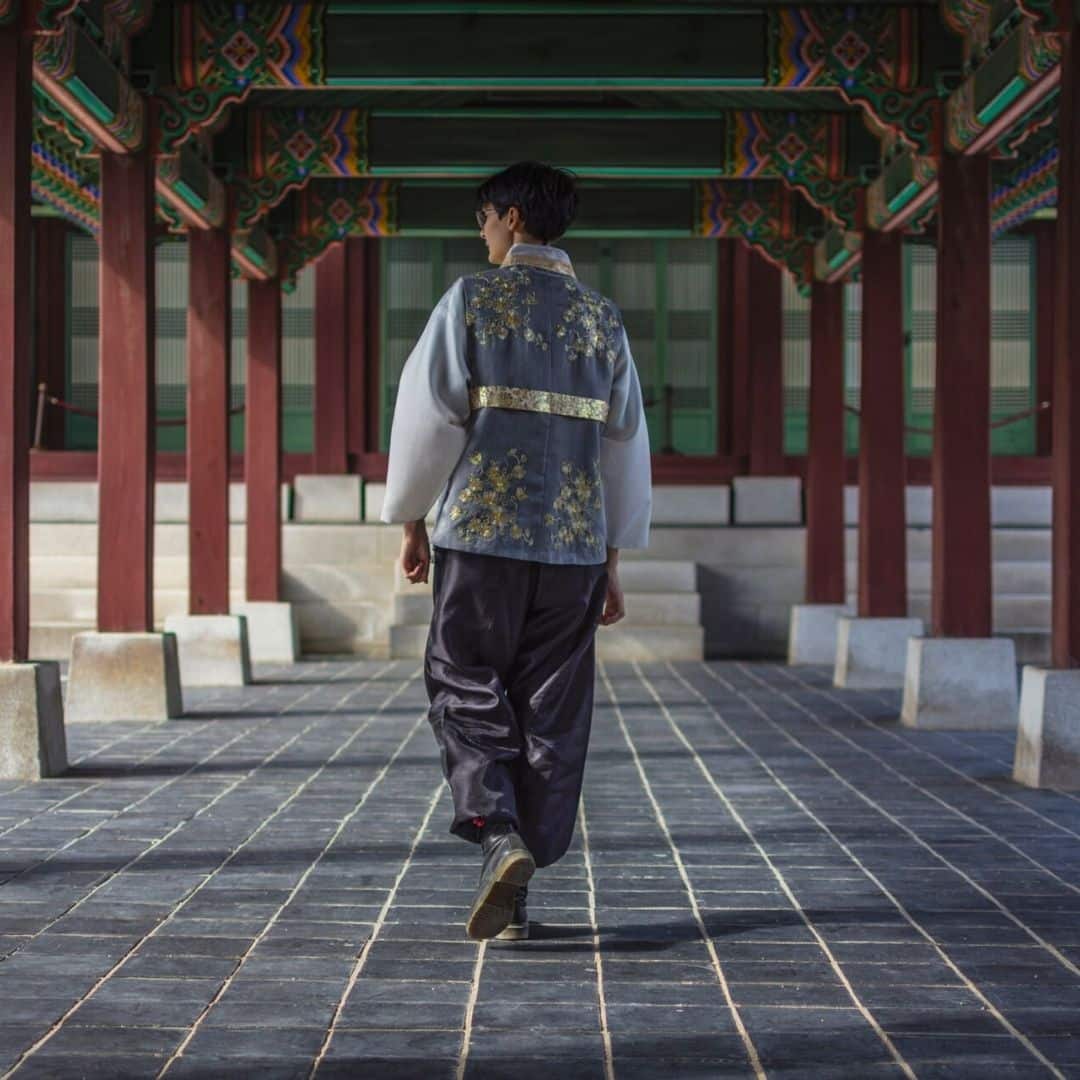
There’s so much more to South Korea than what you’ll find in the cities, however. South Korea, a country that’s 70% mountainous with coasts on three sides, offers so much to nature and adventure lovers. Hiking, South Korea’s national pastime, is a popular way to see more of the Korean countryside, looking down over rice fields, forested valleys, and pockets of urbanization. Skydiving, parasailing, scuba diving, water sports, cycling, rock climbing, white water rafting, and lots more are on offer and very reasonably priced. South Korea is a great place to enjoy the great outdoors.
The real jewel in South Korea’s natural crown, however, has to be Jeju Island – one of the New 7 Wonders of the Natural World. Explore lava caves, hike to the peak of the central dormant volcano (Hallasan Mountain), trek around the rugged coast, relax on a sandy beach in a modern cafe, and even try your hand at horse riding.
Whatever your reason to travel to South Korea, you’re sure to find more and more reasons to return again and again. Let this South Korea Travel Guide whet your appetite for your first trip, inspire you to plan a follow-up trip, and guide you to the best things to see and do in South Korea.

South Korea Travel Guide FAQs
Not sure about the South Korea travel restrictions and want to know more about visas, vaccinations, and what the rules are? This next section covers some of the most frequently asked questions about traveling to Korea now. If you have more questions that aren’t covered below, feel free to write to us on the Best of Korea Facebook page.
Do I need a visa to travel to South Korea?
US citizens and tourists from 111 other countries, including Canada and Mexico, don’t need a visa to travel to South Korea. The US government and South Korea have a visa-free travel arrangement and tourists can stay for up to 90 days.
What happens when I arrive in South Korea?
From September 2022 onwards it is no longer necessary to provide any vaccination status or take any PCR or RAT tests. A mandatory health check will be required, but this is only a simple form you can fill in on arrival.
What happens if I get a positive PCR result?
If you test positive for COVID-19 while in Korea, you will need to quarantine for 7 days at government facilities. Travelers who break the quarantine rules are subject to deportation or fines.
Can I travel to Korea if I'm unvaccinated?
Yes, you can still travel to South Korea if you’re unvaccinated. South Korea no longer restricts travel based on vaccination status (as of October 2022).
However, if a traveler (vaccinated or unvaccinated) tests positive for COVID-19 in Korea, they will have to self-quarantine until negative.
South Korea is a dynamic and culturally rich country that deserves a place on everyone’s travel bucket list. Known for its stunning blend of tradition and modernity, Korea features futuristic technology, bustling markets, and a thriving pop culture scene. Perhaps most importantly, visitors can expect a high level of safety and cleanliness while exploring the country and savoring its delicious cuisine.
This South Korea Travel Guide shows you where to go, what to see, and when to travel. Start your journey with itinerary ideas and pre-travel tips, the best day trips, and lots more essential Korean travel advice. Let’s go!
LATEST KOREA TRAVEL UPDATES
How to travel to korea, best destinations in korea, where to stay in seoul, korean travel tips, things to see & do, travel itineraries for korea, korean season guide, cost to travel to korea, further costs to korea, why travel to korea now, south korea travel faqs.
6/1/23 From June 1st, 2023, there is no longer any mandatory quarantine for COVID-infected people in Korea – both locals and travellers. The Korean government now recommends that infected people showing symptoms should self-isolate (voluntarily) for 5 days.
4/1/23 From April 1st, 2023, travelers from the USA and 21 other countries no longer need to apply for the K-ETA to travel to Korea. This will run until 31st December, 2024 and is designed to make it easier to travel to Korea.
3/20/23 From March 20th, 2023, the indoor mask mandate has been removed for public transport, including buses, trains, subway, taxis, and flights. The only remaining mask mandate is for medical facilities, including hospitals, care homes, and pharmacies.
How To Travel To Korea
Current Travel Restrictions For South Korea 2023
If you’re suspected of infection when you arrive (high temperature, feverish signs), you may be asked to take a PCR test. PCR tests are now free for travelers suspected of being COVID-19 positive within the first 3 days of arrival. This South Korea Travel Guide is regularly updated with the latest Korean travel restrictions.
Requirements To Travel To Korea
Here’s a simple 2-step guide about how to travel to Korea right now. Most restrictions have been lifted so travel to Korea is easier than ever. This applies to travelers from the US, Canada, and many other countries . As mentioned, it doesn’t matter whether you’re vaccinated or not.
Check the Korean Embassy if you’re not sure in either situation.
- When you travel to Korea, you will be asked to complete a self-check health questionnaire to show you’re not sick. You can do this when you arrive or complete it before you depart on the Q-Code website .
- You don’t need to do any testing before you fly, but it is a good idea to take a self-test to make sure you’re safe. If you’re infected in Korea, it’s necessary to do 7 days self-quarantine. You don’t need to bring copies of your vaccination records but printing a copy of the K-ETA is recommended.
No, travelers from the USA don’t need a tourist visa to enter South Korea. You can visit for up to 90 days visa-free. However, you must apply for the K-ETA before traveling and upload your travel plans and hotel details.
Here are 6 of the best destinations in Korea that you absolutely must visit, as well as some of the sights you’ll want to check out while you’re there. We’ll be bringing you lots more detailed destination guides in the future, so be sure to visit again soon

This Full Day Tour of Seoul will show you some of the hottest spots in the city, while this Customized Private Tour of Seoul will allow you to choose where to go.

Korea is a unique country with a written language that looks nothing like English, interesting Korean Cultural And Etiquette Rules , and an always busy lifestyle. Travelers may be lost trying to do even the simplest things.
If you’re traveling to Korea, you’re almost certainly going to want to get access to the internet to help you navigate, translate Korean, or even book tickets to attractions. Korea has one of the world’s best mobile internet and the prices are very reasonable. 5G mobile internet services are available across the country and Korea was one of the first to get the super-fast service. You won’t have problems connecting with a sim card or WiFi router when you travel
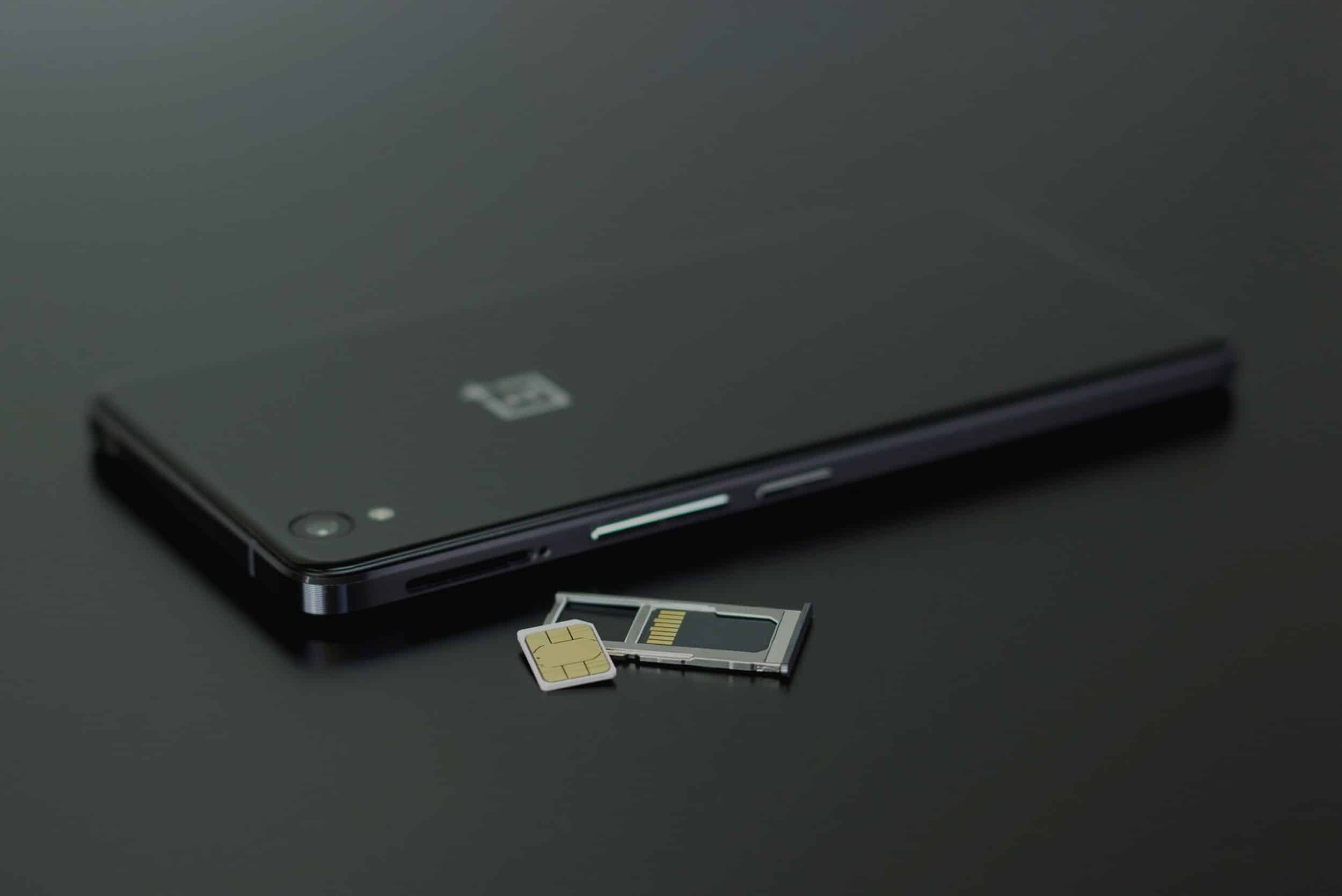
Traveling to any country involves potential scams, bad exchange rates, mistakes, and confusion when it comes to dealing with foreign currency. Fortunately, travelers to Korea have a wide range of options for travel money both before and while they travel.

South Korea is a country packed with famous landmarks and sights, unique culture – modern & historical, family-fun activities, outdoor adventures, cozy cafe districts, and natural wonders. There’s more to do in Korea than you could imagine and it’s impossible to explore it all in one trip. Try to plan your itinerary by cities and locations. For example, plan your day in Seoul and stay by the district.
Here are some of the best things to see and do in South Korea, broken down into different themes so you can find things that interest you the most. The location of each of these attractions is included, too, so you can create a city-by-city itinerary, seeing the best South Korea has to offer.
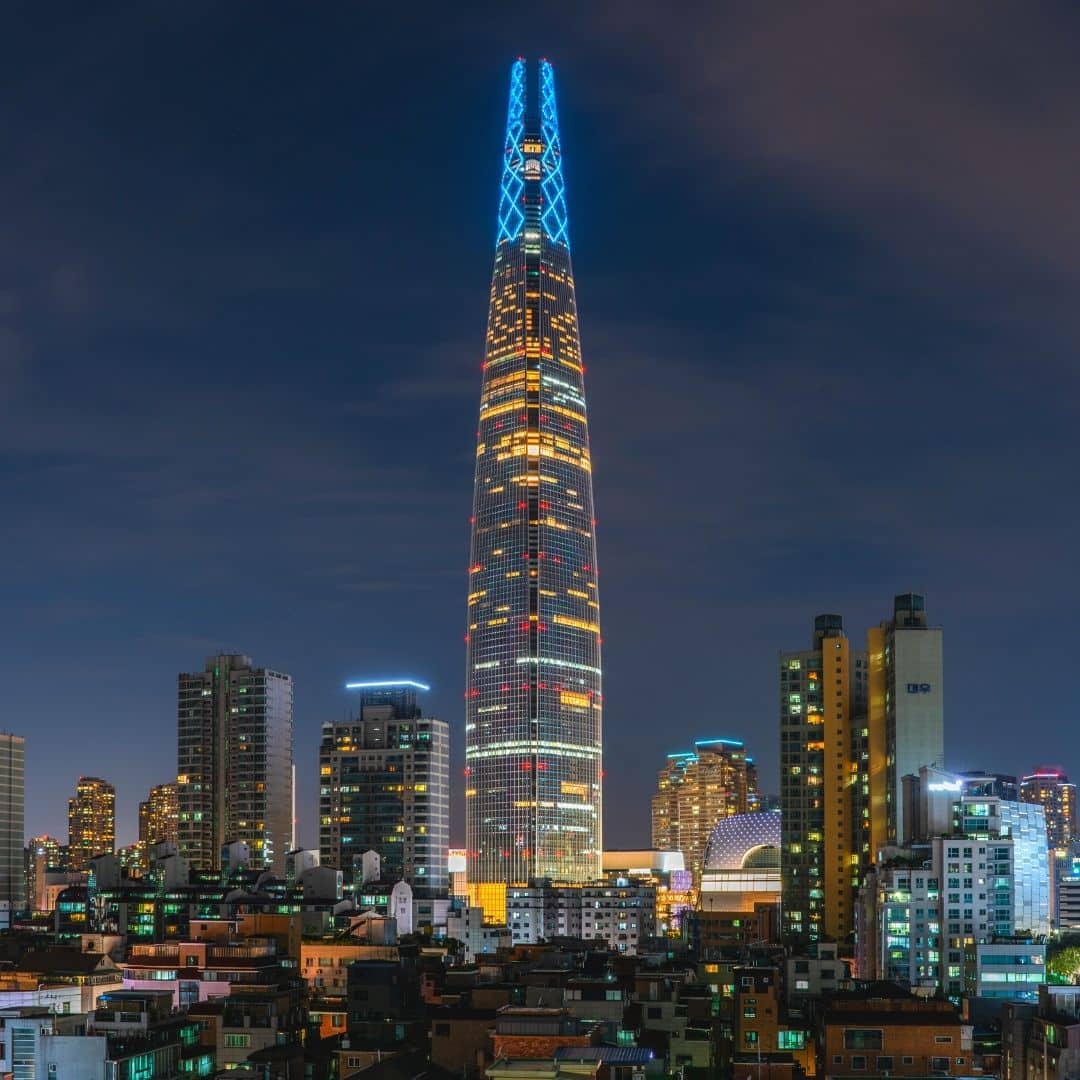
Any South Korea Travel Guide would be incomplete without thee top landmarks & famous areas in Korea. These unmissable Korean attractions offer some of the best sights in Korea, showing you Korean history, culture, design, and sense of humor.
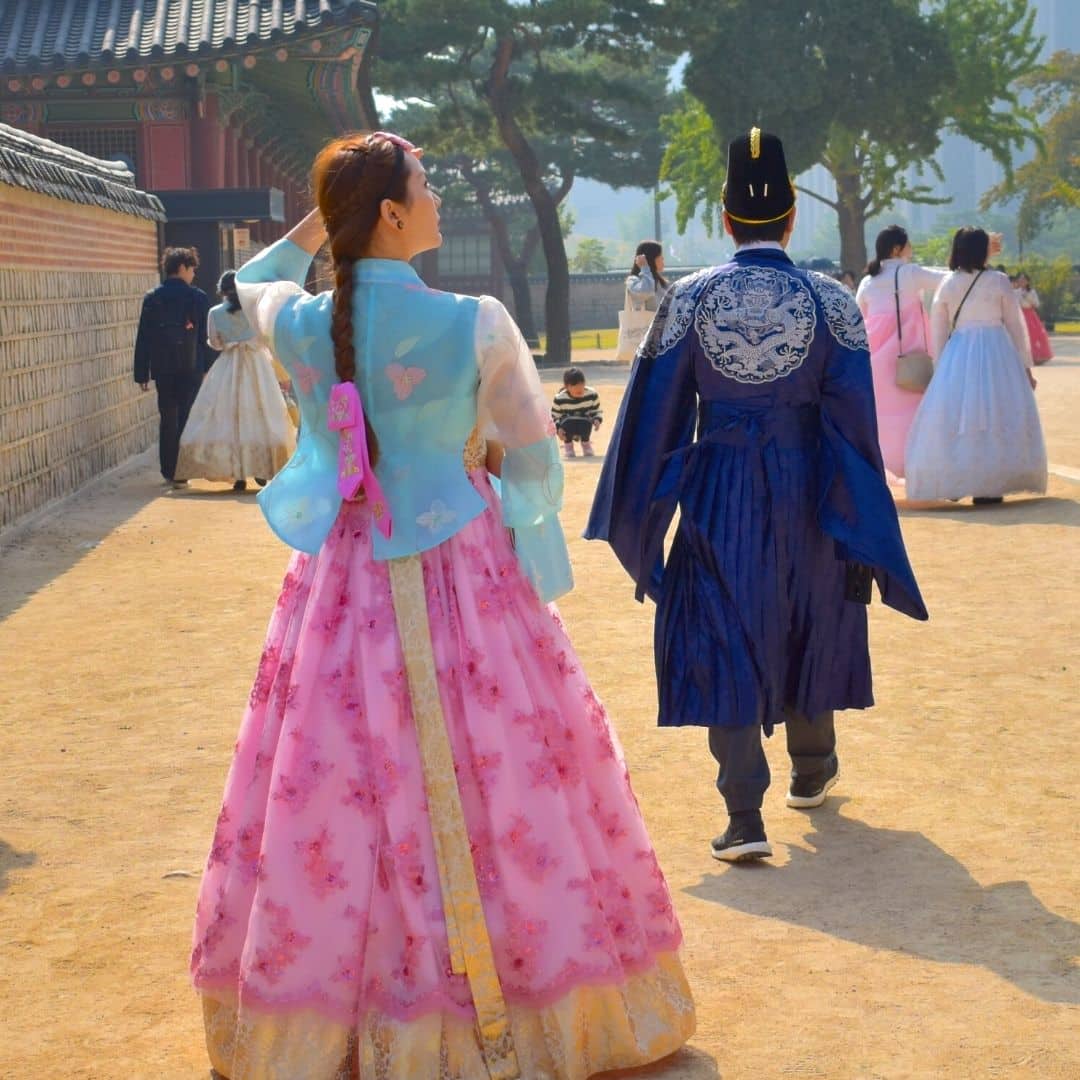
Learning about Korea’s past is not only enjoyable, it’ll also open your eyes to how modern Korean culture has evolved. Witness the majesty of grand palaces and the humble Buddhist temples and gain an insight into life in Korea with these fascination historical sights.

Are you a fan of Korean culture? Then check out these 10 modern K-Culture locations in Korea. Whether you’re ARMY or an arthouse cinema fan, you’ll love these sights. K-Drama fans, check out these K-Drama Filming Spots in Seoul .

If you’re traveling to Korea with your family, you don’t need to worry about the kids getting bored. There are plenty of family-fun attractions in Korea to keep them amused and to show them what Korea’s really like.

Culture lovers will find no shortage of places to learn about Korean, Asian, and world history & culture. Korea has a rich history and displays this through a range of museums. Learn about traditional life, Korean wars, the democracy struggles, and even kimchi .

Once a land of teahouses, Korea has now fully embraced coffee culture. Korea’s late-night culture makes cafes a great place to gather and chat. The rise of social media has also led to hundreds of insta-worthy cafes with photogenic decor, unusual coffee designs, and delicious desserts.

Many people travel to Korea just to shop, thanks to the low prices, haggling in the markets, and good quality items. From traditional markets to high-end designer goods, there’s somewhere to shop for everyone. Be sure to try authentic Korean street foods in the markets, too.

Korea is a country surrounded by sea on 3 sides and 70% mountainous, giving it a wealth of natural beauty. Besides Korean cherry blossoms , flowers, and fall foliage, there are sculpted gardens, shimmering ponds, riverside parks, and a volcano to see.

Morning : Explore Seoul’s historic royal palaces starting with Gyeongbokgung or Changdeokgung Palace in central Seoul. You get free entry if you’re wearing a Korean hanbok, so be sure to pick one up from the rental shops outside.
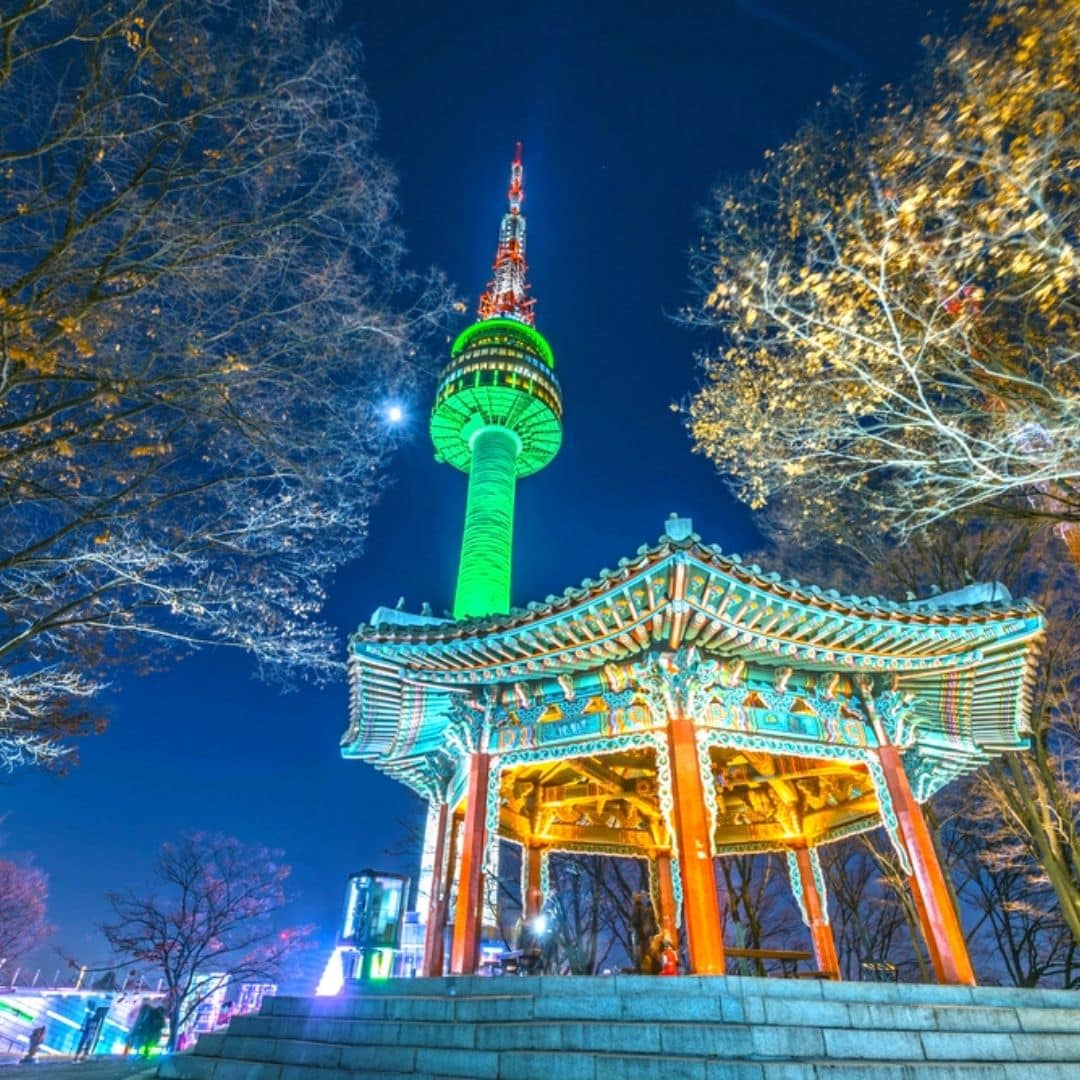
Morning : Learn about Korea’s history at the National Museum or War Memorial in Yeongsan. These fascinating museums have interactive exhibits and feature 1000’s of years of Korean history.

Morning : Take a day trip from Seoul to explore Gapyeong County. See the wonders of the Garden of Morning Calm and its idyllic nature. This is one of the most beautiful gardens in Korea.

Morning : Grab an early breakfast at Seoul Station and ride the high-speed KTX train directly to Seoul. It takes less than 4 hours and rides past rice fields, mountains, and the Korean countryside.

Morning : Take a day trip to the UNESCO World Heritage City of Gyeongju and roam the Gyeongju Historic Area. See Daereungwon Tomb Complex and Cheomseongdae Observatory.

Morning : Pack your bags and ride the KTX back to Seoul. Head to Hongdae for street food snacks or Michelin-starred delights in famous restaurants.

March to May

June To August

September to November

December to February
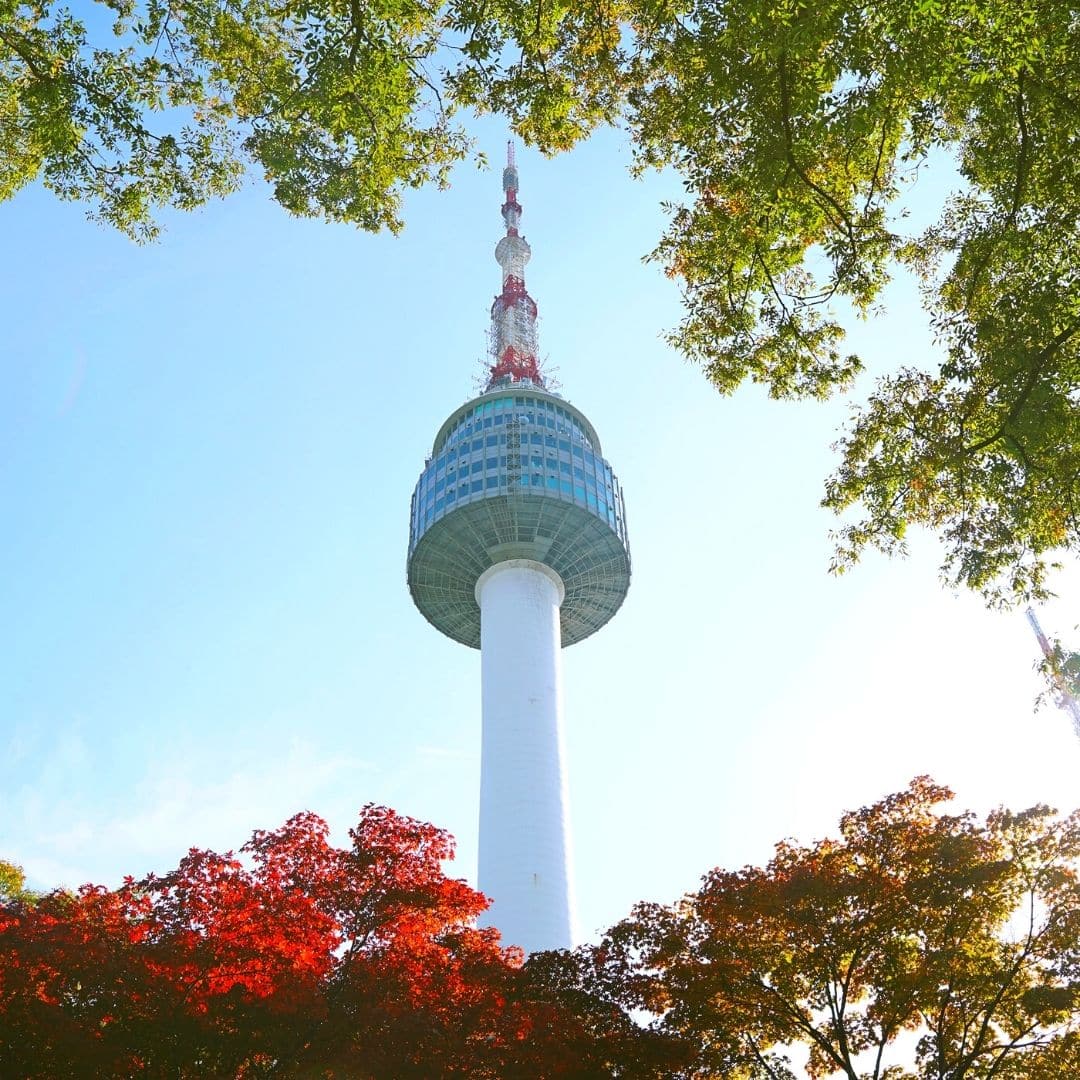
Korean Souvenir Costs
The best places to buy souvenirs in Korea are in the traditional markets and tourist areas. Insadong in Seoul has a lot of art and souvenir shops, as do the market streets around Bukchon Hanok Village. Hongdae offers lots of bargain snacks and souvenirs to take home.

Day Trip Costs From Seoul
A day trip from Seoul is a must to see a different side of Korea from what you’ll experience in the capital. Taking a day trip is a great chance to experience Korea’s countryside, nature, and hard-to-reach cultural attractions.

Korean Activity Costs
Seoul and other Korean cities have so much to offer to tourists. From historical palaces to exciting theme parks and attractions, it’s easy to have fun, explore, and discover more about Korea’s history.

Flight Costs To Korea
Flight costs depend on which airports you’re traveling from. A flight from Los Angeles to Incheon Airport (Korea’s main airport) costs around $1370 right now. Flight costs vary depending on the season and time of day.
Welcome to Best of Korea!
Please Sign Up for Updates
We hate spam. You can unsubscribe anytime.
- Korean Culture
- For Foodies
- Weather & What to wear
- Unique Experiences
- Outside of Seoul
- Best of Seoul
- onedaykorea

How To Plan a Successful Trip to South Korea
on April 12, 2022
South Korea is a country that relies significantly on tourism to survive. The country’s natural beauty and history, in addition to its expanding economy, make it a popular tourist destination for people from all over the world. It is, nonetheless, one of the countries hardest impacted by the pandemic flu. All airlines have cancelled flights to South Korea, severely restricting international travel. Because tourism makes for a substantial portion of South Korea’s GDP, this has a huge influence on the country’s economy.
Fortunately, the pandemic has slowly started to die down and travel has made a big comeback. South Korea reopened its borders on April 1, 2022, allowing people who have been completely vaccinated and have registered their vaccination status to enter the country and escape the seven-day quarantine period. People who are eager to explore South Korea and experience their cultures can now visit the country. However, they are still encouraged to take precautions before and during their trips to ensure they remain safe. If you’re planning a trip to South Korea, it’s imperative to plan so that you make the most of your time there.
Essential Travel Tips to Have a Great Visit
Prepare the required documents.
Before visiting the country, it is important to make sure you have all the necessary documents in order. Different nationalities may have different entry requirements, so it is best to be prepared ahead of time. Make sure you have a valid passport and any visas or other documentation that may be required. If you are not sure what the requirements are, consult the Korean embassy or consulate. Being prepared will help ensure a smooth and hassle-free trip.
In addition, the latest vaccination dosage must be administered within 14 – 180 days of your trip. Furthermore, you must submit a K-ETA application within 24 hours of boarding as well as a PCR test within 48 hours of boarding. Finally, you need to complete the Q-code form and present it whenever somebody asks.
Plan Your Budget and Stick to It
Whether you’re traveling for pleasure or work, it’s crucial to have a budget planned out and stick to it. Overspending can quickly ruin your trip and put a damper on the fun. By planning and being mindful of your expenses, you can enjoy your trip without going over your budget. Create a budget that includes all of the anticipated costs of your trip. This may include airfare, lodging, food, transportation, and any other expenses you may incur. You can consider renting a car because there are many car rental deals in South Korea , especially if you visit in April when the price is 13% lower than the rest of the year.
Once you have a ballpark figure for what your trip will cost, try to stick to it as closely as possible. Splurging on one thing means you’ll have to cut back elsewhere.
Choose a Destination That Appeals to You
When planning a vacation, it’s essential to choose a destination that will be enjoyable and fulfilling. In South Korea, no matter what your interests or travel style, you’ll find a destination that suits you. Whether you’re looking for an urban adventure in Seoul or Busan, natural beauty and hiking opportunities in the rural countryside, hot springs, and spa resorts, or historical sites and traditional culture, the country has something for everyone. If leisure is your first objective, you should go to Jeju Island . Seoul is the place to go if you want to experience K-POP and some of the best spots featured in K-Dramas. Different places provide different experiences and it is critical to pick one that meets your goal.
Book Your Flights and Hotels in Advance
Traveling can be an exciting experience, but it’s vital to plan to make the most of your time and money. One of the most essential things to take care of before you leave is booking your flights and hotels. This will ensure that you get the best deals and that you have a place to stay when you get to your destination. Airlines often offer the best flight deals when purchased directly from them. However, several travel websites provide competitive pricing as well. Also, if you want to stay in a specific sort of accommodation during your vacation, make sure you reserve well in advance. Waiting till the last minute often results in increased prices or no availability.
Pack Lightly and Strategically
No one wants to drag a heavy suitcase around on vacation, especially when there are plenty of beautiful beaches and interesting shops to explore. You may have a pleasant trip without feeling weighed down if you pack light and intelligently. Pack clothing appropriate for the weather conditions at the time of your stay. You should also bring important documents such as your passport and tickets, as well as prescriptions if needed. Pack the necessities, such as sunscreen, insect repellent, hats, sunglasses, and comfortable shoes. Bring a map of the area or download an app like Naver that provides precise information when navigating South Korea. If you’re going on an outdoor excursion, be sure to pack appropriate clothing and gear to prepare for any potential emergencies.
Make Your Travel More Meaningful
There’s something about traveling that just seems to make life more meaningful. Experiencing new cultures, landscapes, and foods can be transformational, filling us with a sense of awe and wonder. But sometimes it’s not enough to just see a new place – we want to feel like we’re there. That’s where the video comes in. By recording the people and places you encounter and generating videos of the sights and sounds from your travels in slow-motion effect , you can create an immersive experience that puts you in the middle of your travels.
Whether you’re a seasoned traveller or just hitting the country for the first time, incorporating video into your journey can make it more meaningful. Plus, having a travel diary filled with videos is sure to bring back great memories long after your trip has ended. So, what are you waiting for? Get started on your unforgettable journey in South Korea!

Written by: OnedayKorea
Leave a comment cancel.
Your email address will not be published. Required fields are marked *
Email Address
One Week in South Korea: The Ultimate Itinerary
There’s a lot more to South Korea than Seoul. Despite the country’s compact size (it’s roughly the same size as Indiana or Portugal), this vibrant East Asian nation is brimming with genteel Buddhist temples, mist-capped mountains, and buzzing cities. Although one could easily spend a week in Seoul alone, a seven-day itinerary encompassing the entire country is entirely doable, and will give you a thorough overview of Korea’s natural beauty and cultural treasures.
South Korea is well known for its vast and easy-to-use public transportation system; a seamless network of subways, trains, buses, flights, ferries, and (relatively inexpensive) taxis that can take you almost anywhere in the country. The backbone of north-south travel is the KTX, a high-speed train that can reach top speeds of 190 mph, and travels from Seoul to the southern port city of Busan in approximately three hours. Domestic flights are also offered to many larger cities around the country, and mainly depart from Seoul’s Gimpo International Airport; about 21 miles away from Incheon International Airport , the city’s main international hub, buses run every 15 to 25 minutes between the two airports, and cost 7,500 won.
For those who prefer autonomy, car rentals are possible but require an International Driving Permit in addition to a valid driver’s license issued in your home country. (FYI, an IDP must be obtained in the same country your driver’s license was issued in.) Another consideration before you get behind the wheel is that Korea’s main routes are toll roads, so plan accordingly.
Patrick Foto/Getty Images
Most foreign visitors to South Korea will arrive at Incheon International Airport just west of Seoul, making the capital a perfect starting point on your itinerary. Take either a limousine bus or the AREX Airport Express train to downtown Seoul to get your trip started. Once you’ve stashed your bags at one of the city’s numerous hotels, motels, or guesthouses, it’s time to hit the streets.
In the geographical center of Seoul lies Namsan Mountain, topped with the spindly N Seoul Tower . This futuristic landmark is visible from many areas of Seoul, and makes a good point of reference as you navigate your way around the capital. Starting your tour from the observation deck at the top of the tower will help you get your bearings on the layout of the sprawling city. Enjoy lunch at the tower’s rotating N Grill , a chic restaurant that offers customers 360-degree views of Seoul while they dine on fine French delicacies and wines.
Next, take a bus or subway to the 14 th -century Gyeongbokgung Palace , the largest of Seoul’s five royal palaces from the Joseon dynasty. The grand entrance gate is an impressive work of architecture guarded by traditionally clad performers who reenact historically accurate Royal Guard Changing Ceremonies daily.
To get a big picture perspective of the nation, a visit to the National Museum of Korea is in order. The majestic, striking building houses approximately 15,000 items dating from prehistory to the modern era, and is Korea’s largest and most impressive museum.
For more essential travel tips, including how to navigate the city's public transportation, where to stay, and what to pack, check out our complete guide to Seoul .
ericfoltz/Getty Images
History buffs, political aficionados, and curiosity lovers alike will revel in a bizarre day trip to one of the world’s most notorious borders. The Korean Demilitarized Zone (DMZ) is the 160-mile long border that divides the Korean Peninsula into the North and South, and lies only 31 miles from central Seoul.
Various tour options take visitors by bus from Seoul to the DMZ’s most popular sites, including the Bridge of Freedom, the 3rd Infiltration Tunnel, and Dora Observatory with views over North Korea. Plus, you can see the iconic blue buildings in the Joint Security Area, which is guarded by fierce-looking soldiers from both sides.
Many sights of the DMZ can also be reached via a special roundtrip “ Peace Train ” that departs from Seoul Station. Upon reaching Dorasan Station, the last stop before reaching North Korea, the tour continues via bus. (The DMZ Peace Train tour doesn’t include a visit to the Joint Security Area, which can only be accessed via specific tour companies, such as DMZ Tours .)
Bukhansan National Park
KR_nightview / Imazins/Getty Images
Seoul is one of the only cities in the world that has a national park within its borders. This easy access has made Bukhansan National Park a favorite among Seoulites, and has won a spot in the Guinness Book of World Records as having the highest number of visitors per square foot of any national park on the planet.
Filled with jagged rock formations, miles of hiking trails, and sweeping views of the capital, Bukhansan is well worth a day trip. Buses from Seoul Station take approximately 40 minutes to reach Bukhansan National Park Jeongneung Visitor Center, which lies just outside one of the park’s entrances.
Across from the visitor’s center is a 7-11, where you can pack your rucksack with hiking snacks like dried squid or kimbap (Korea’s version of sushi) before hitting the trails.
Aside from the natural beauty of the rock formations, 1,300 species of animal and plant life (the latter of which is especially lovely and photogenic during the colorful spring and fall seasons) and over 100 Buddhist temples can be found within Bukhansan’s borders. Hwagyesa Temple is renowned for its graceful 17 th -century architecture and its popular temple stay program, where visitors can learn what it’s like to live as a Buddhist monk.
Akanit Laveewan / EyeEm/Getty Images
Time to board the KTX train and head south to Daegu, South Korea’s fourth largest city.
Sports fans may recall that the city played host to the 2002 FIFA World Cup and the IAAF 2011 World Championships in Athletics, where superstars such as Usain Bolt and the now-infamous Oscar Pistorius wowed crowds.
Whether you’re a sports enthusiast or not, make your first stop a visit to Daegu Stadium . In addition to the stadium itself—which is surrounded by landscaped parks, mountains, and hiking trails—check out memorabilia at Daegu Sports Museum or stock up on K-Beauty products at Color Square , a shopping and entertainment complex.
Afterwards, take a cable car to the top of Palgong Mountain for lunch at a restaurant that may serve simple food, but features some of the best views of the city. Then hike down to Dongwhasa Temple and the famed Gatbawi Buddha, a 7 th- century stone statue that's said to grant one wish to each visitor who prays here.
Round out your day with a stop at Seomun Night Market , which features traditional and surprising street food from over 65 vendors, making it South Korea’s largest night market.
Insung Jeon/Getty Images
Catch an intercity bus for about 5,000 won, and an hour later you’ll find yourself in Gyeongju, the capital of Korea during the ancient Silla kingdom that reigned from 57 BC to 935 AD.
Marvel at the exquisite architectural details of Bulguksa Temple ; originally built in 528 BC, the current temple is a restored version since between then and now it was destroyed many times by fires, theft, and war. After your visit, hike to the nearby UNESCO World Heritage Site of Seokguram , a temple built inside a grotto of granite and graced with a carved seated Buddha.
Gyeongju National Museum is a must-see for insights into the Silla dynasty, and features numerous exhibits on culture and daily life of times past. But to get really up close and personal with history, head down the road to the Daereungwon Tomb Complex , where the otherworldly burial mounds conceal the underground chambers of ancient kings and queens.
Hop on a train or intercity bus to reach Busan in about 1.5 to two hours. As Korea’s second largest city and the country’s largest seaport, Busan is always bustling with things to do.
Start with a hot soak and a skin-tingling body scrub at Spa Land Centum City , a contemporary take on the traditional Korean bathhouse. There are 22 different indoor and outdoor spring water soaking pools of various temperatures, as well as 13 different types of saunas ranging from Finnish to Turkish.
No visit to Busan would be complete without a stroll along Haeundae Beach , South Korea’s equivalent to the world-famous Waikiki. The golden sand remains largely vacant in winter, but come summer it’s awash with bright beach towels and parasols. The street lining the shores houses a wide array of bars, restaurants, and hotels, as well as an aquarium and a coastline hiking trail.
Adventurous eaters can catch dinner at the Jalgachi Fish Market , Korea’s largest seafood market, which sells both live and dried fish. Options range from crab and abalone to the more exotic grilled eel and raw octopus.
Natthawut Utsawachaichot / 500px/Getty Images
The semi-tropical volcanic island of Jeju is 181 miles south of Busan, and while it merits a multiple-day visit of its own, a whirlwind tour can be done by the determined in just one.
After landing at Jeju International Airport (or taking an overnight ferry from Busan if you have more time), make use of the extremely efficient bus system that connects the most popular tourist sites.
Jeju’s most iconic destination is Seongsan IlchulBong Peak , a tuff cone crater that formed 100,000 years ago during a submarine volcanic eruption. Take a walk along the rim for some seriously sensational views of the sunrise and the surrounding sea and countryside.
Hike the network of trails through Hallasan National Park to the 6,397-foot Halla, a volcanic peak that’s the tallest mountain in South Korea. Home to 1,800 plants and 4,000 different species of animals and insects, this UNESCO World Heritage is known for its unique vertical ecosystem resulting from the varying temperatures at each elevation.
Another UNESCO site worth admiring is the Manjanggul Lava Tube . At 59 feet wide and 75 feet high, it’s one of the largest lava tubes in the world, and stretches nearly 5 miles into the subterranean darkness.
Bukhansan National Park: The Complete Guide
Getting Around Seoul: Guide to Public Transportation
The Top 18 Things to Do in South Korea
Getting Around Busan: Guide to Public Transportation
The Top 10 Destinations in South Korea
The Top 15 Things to Do in Daegu
The 12 Best Day Trips From Seoul
The 12 Best National Parks in South Korea
The 9 Best Day Trips From Busan
Seoul Guide: Planning Your Trip
The Top 7 Temples in Busan
One Week in Argentina: The Ultimate Itinerary
The Top 12 Things to Do in Busan, South Korea
One Week in France: The Ultimate Itinerary
Where to Go in 2022: The Most Exciting Destinations to Explore This Year
The Best Time to Visit South Korea

- 2 Weeks for Couple
- 2 Weeks for Family
- Thailand Lantern Festival
- Indonesia(Bali)
- South Korea
- China (HK, Taiwan)
- Itinerary Ideas
- Asia Highlights Travel Reviews
- Thailand Travel Reviews
- Vietnam Travel Reviews
- Cambodia Travel Reviews
- Japan Travel Reviews
- Myanmar Travel Reviews
- China Travel Reviews

South Korea Travel Guide: Customize a Personalized Trip
South Korea has become an exciting destination, thanks to the immense popularity of K-POP music, movies, and mouthwatering Korean barbecues. This makes it an excellent choice for a family getaway, especially if you have teenagers who are into these trends.
Popular South Korea Private Tours
Sign up for your favorite tours or simply seek inspiration. We can craft a trip around you and help you realize your own holiday dreams.
8-Day South Korea Tour
10-day south korea tour.
Discover real reviews of Highlights Travel Family 's best-rated service across trusted platforms.
Popular Asia Tours Including South Korea
14-day classic japan and south korea tour, 16-day south korea and japan cultural adventure tour, 17-day south korea and taiwan tour, 17-day japan and south korea tour, 11-day south korea and bali tour, how to plan a trip to south korea & japan, how to plan a trip to south korea, best (and worst) times to visit south korea, how to plan a 12-day trip in japan and south korea, how to plan a 2-week itinerary in japan and south korea, south korea weather by month, south korea weather in january, south korea weather in february, south korea weather in march, south korea weather in april, south korea weather in may, south korea weather in june, south korea weather in july, south korea weather in august, south korea weather in september, south korea weather in october, south korea weather in november, south korea weather in december, get inspired with some popular itineraries.
At Asia Highlights, we create your kind of journey — your dates, your destinations, at your pace. You can have any trip tailor made for your travel.
More Travel Ideas and Inspiration
Sign up to our newsletter.
Be the first to receive exciting updates, exclusive promotions, and valuable travel tips from our team of experts.
Why Asia Highlights
Where can we take you today.
- Middle East
- African Safari
- Travel Agents
- Loyalty Program
- Our Differences
- Privacy Policy
Address: Building 6, Chuangyi Business Park, 70 Qilidian Road, Guilin, Guangxi, 541004, China
- Skip to main content
- Skip to primary sidebar

Follow Me On

South Korea Itinerary: 2 Weeks Or Less (From A Local)
Updated: Apr 5, 2024 by Max · This post may contain affiliate links · 50 Comments
This two weeks in South Korea itinerary is based on my three years living in Korea, discovering the country's beautiful places and the people who live there. Since I left, I've also been back to visit several times, most recently last year.
So while I could write a South Korea 10 day itinerary or 14 day itinerary centered only on Seoul and Busan , maybe even Jeju , I'm not going to do that. This country deserves so much more attention to detail, and so do you. So this guide actually covers five different cities in Korea to check out on your visit.
Even though there's no such thing as the perfect itinerary for Korea, the country is small enough that two weeks is enough time to adjust to the culture change and still have time to enjoy most everything. But if you only have 10 days in Korea (or even fewer), then I highly suggest you start in Seoul for 4 days, at least.
Starting with 4 days in Seoul, you can see the basics for tourists & build out your itinerary from there, as I mention in the South Korea sample itinerary section. So let's get to planning!
Buy a PDF Version of This Post!
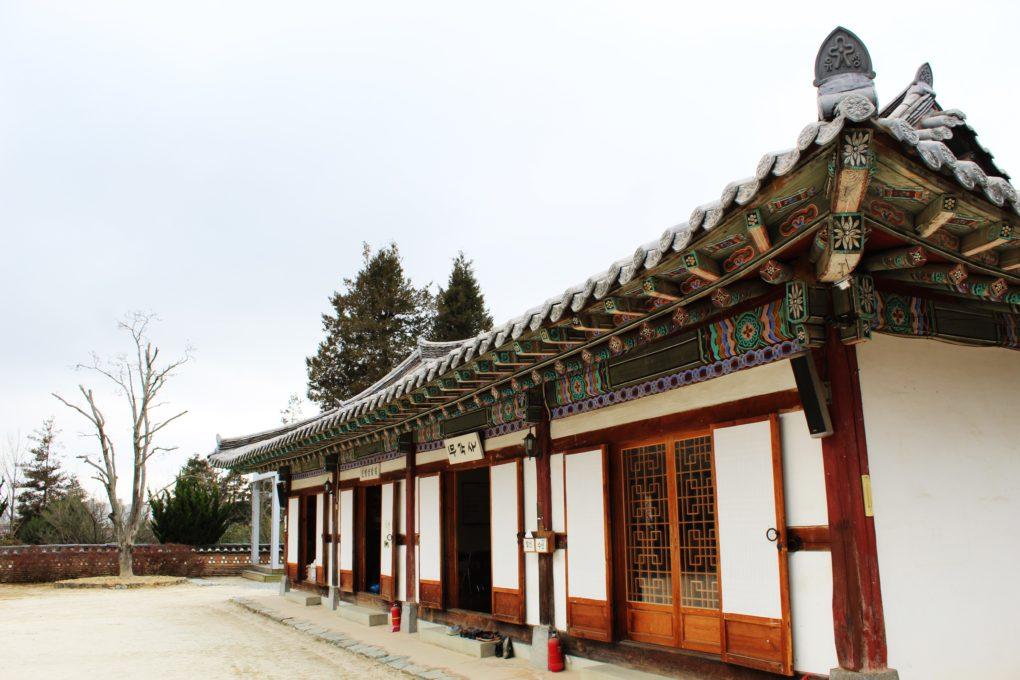
- 🇰🇷 Planning Vacations in South Korea
- 🛫 Basics of Korea Travel
- 🙋 South Korea Travel FAQ
- 🗺️ South Korea Trip Itinerary Examples
- 🚕 Where To Visit In South Korea
- 🧳 Budget For A Trip To South Korea
- 🚈 South Korea Travel Tips
- ☺️ Basic Phrases For Your Trip to Korea
🇰🇷 Planning Vacations in South Korea
Those of you looking to visit South Korea are probably as confused by all the changes as I was before I visited again post-covid. But as of March 20th, 2024, masks are still required in medical settings like hospitals but are NO LONGER REQUIRED in all other indoor public places, including public transport.
Here are what document you need to visit Korea as a tourist:
- K-ETA ( Korean Electronic Travel Authorization , applied for at least 72 hours before departure) OR Visa to visit Korea (countries which previously had a visa exemption now need to apply for a K-ETA). From April 1, 2023 to December 31, 2024, passport holders from 22 countries will also temporarily NOT need a K-ETA or visa to visit Korea (includes: Australia, Austria, Belgium, Canada, Denmark, Finland, France, Germany, Hong Kong, Italy, Japan, Macao, Netherlands, New Zealand, Norway, Poland, Singapore, Spain, Sweden, Taiwan, UK, US (including Guam)). If you're a valid ABTC card holder (APEC card), you are not required to apply for a K-ETA [excluding Americans & Canadians].
- Q-Code (can also be filled out upon arrival) : visitors need to fill out information for the Korean quarantine system, known as Q-Code . Note that all travelers are now allowed in regardless of vaccination status, but you do need to have filled out your Q-Code before going through immigration.
If for some reason you need to take a covid test in a South Korea airport, the cost of a covid test in Incheon Airport is currently ₩80,000 ($60USD), with some options within Seoul as inexpensive as ₩65,000 ($50USD). There's no testing requirement to leave South Korea.

🛫 Basics of Korea Travel
In Korea we use the Korean won (KRW), written as ₩ or 원 in Korean. ₩1000 is roughly equal to $0.75USD or ₱43. The won used in South Korea is different from the won used in North Korea.
This depends on your style of travel, but a mid-range budget for a solo traveler spending 10 days in South Korea would be about $65USD per day. If you're willing to stay in cheap hostels, stick to more free activities in Seoul, and eat local foods, then you could get it down to maybe $40USD per day. So I'd say that traveling Korea is really quite affordable, though you can always upgrade your trip, and the longer you stay the cheaper it will be per dium.
As you might expect, Korean people speak the Korean language , but many people in more urban areas also speak decent English, especially younger people. But the written language of Korea is called hangeul , and it's similar in number to the roman alphabet, but the appearance and pronunciation is different. You will not be able to read Korean unless you study some beforehand (if you're interested, I recommend Talk To Me In Korean ).
The internet is generally great in Korea. You can find free public wifi in basically every major point of transit, tourism, and general town hub (even in my little countryside area). But if you want to be connected constantly, you can rent a wifi egg as soon as you land at the airport, or buy a pre-paid sim card for trips longer than a week (I recommend KT/Olleh sims; it's what I've used all three years here).
South and North Korea are technically still at war. That said, there is no sense that this is a country at war, as the last few decades have been relatively quiet on that front. In fact, Korea and Japan are two of the safest places I've ever been; the biggest peril I've ever felt is from potential alcohol poisoning (the drinking culture here is insane; the local liquor of soju is the most popular beverage in the world ). I'd feel comfortable telling anyone they could walk around here at night, though unfortunately women should be extra vigilant with their drinking.
I agree with the general consensus that May, September, and October are the nicest months of the year, weather wise. They have nice sunshine, beautiful foliage, and outside of major holidays, they're light on domestic tourism. But if you want to find the shoulder season, come in April or June. They're either a bit colder or warmer than you might like, but the kids are still in school and the pollution will be less heavy than it would be in May or October. However, winter is food festival season in Korea, with coffee festivals and chocolate festivals happening across the country.
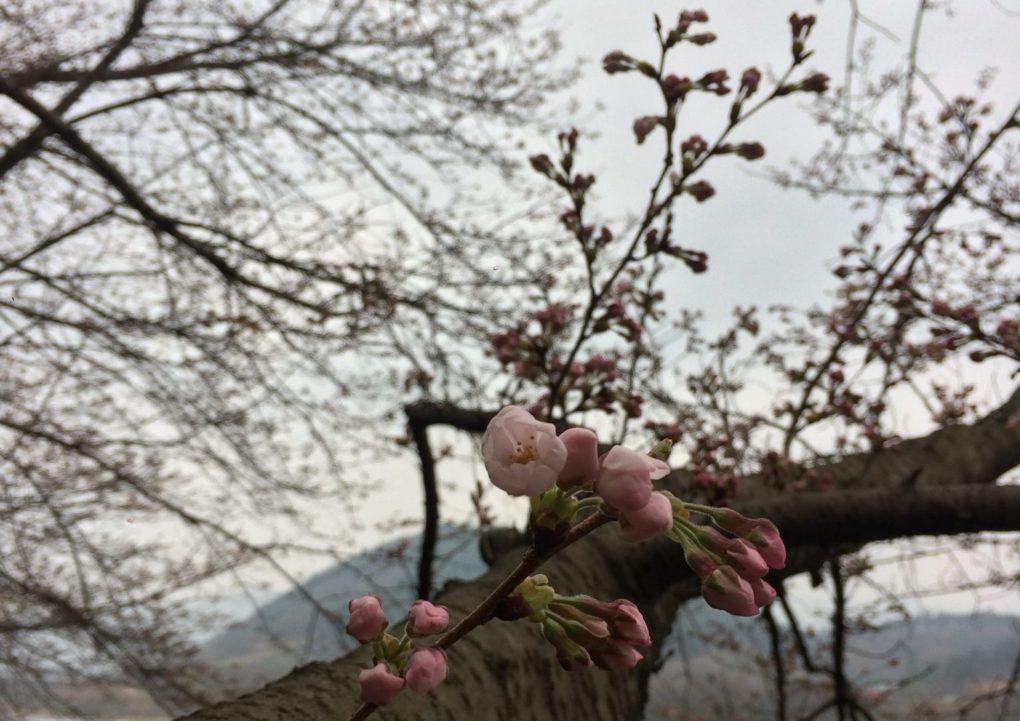
🙋 South Korea Travel FAQ
I've included a FAQ section including the most common questions I've been asked in the last 3 years, by friends, family, and complete strangers. Hopefully this answers the majority of your questions!
What should I wear in Korea during winter, spring, summer, and fall?
From mid-November to mid-March, it could definitely snow and you'll want a heavy winter jacket and some heat-retaining leggings for under your pants. From mid-March through early May & early October through mid-November, there's still the possibility of chilly nights. So bring pants and a jacket for the nights, and t-shirts for the days.
Pack more conservative tops to take to Korea, as showing your collarbones can be cause for staring, especially in smaller towns. Respect is very important in Korea. Early May through early October is a toss-up between extremely hot and warm with a breeze, but it will definitely be humid.
What do I need to bring to Korea?
Other than the basics you'd always pack for yourself, remember to bring higher-cut shirts, as Koreans are more conservative in their dress than most westerners. Women should be sure to bring tampons and pads, as there was recently an issue with domestic pads & tampons are extremely hard to come by.
Many readers have told me that purchasing a sim card and attraction pass (like the Discover Seoul Pass ) helped them make the most of shorter visits, and those are simple things to arrange in advance and take to Korea.
Do I need a visa to visit Korea?
While there are still 112 countries whose citizens don't need to apply for visas before visiting Korea for 30 to 90 days, as of September 2021, ALL visitors from those approved countries still need to have an approved K-ETA before arriving in Korea, even if you just have a long layover in Incheon .
K-ETA stands for Korea-Electronic Travel Authorization. You can check if yours is one of those visa-exempt, countries and how long your visa lasts for, here . Common countries: USA (up to 90 days), Canada (up to 6 months), South Africa (up to 30 days), Malaysia (up to 90 days), Singapore (up to 90 days).
But remember, even if you don't need to apply for a visa, from now on you do still need to apply for a K-ETA , which is good for two years form the date of approval. If you already need to apply for a visa, you do not need to apply for a K-ETA .
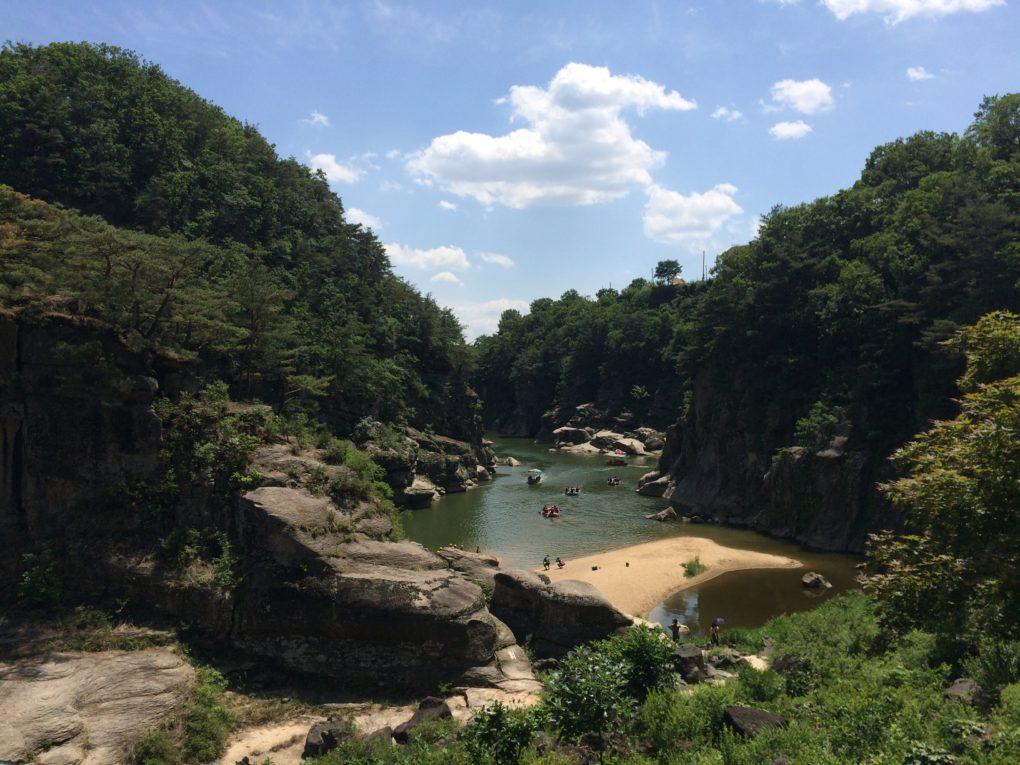
How can I get to & around Korea?
Since South Korea is on a peninsula off the southern coast of China, you have to fly in. Note that if you have a layover at Gimpo Airport for some reason, the airport closes each night from 12am-4:30am. Theoretically you could also arrive by boat from China or Japan, but that truly sounds awful to me.
As for actually getting around Korea, that's a much easier question. Getting between the cities is best done by bus, or train if it's a very popular route. Some people prefer to fly between Seoul, Busan, and Jeju, though you can also go via bus & boat.
Within the major cities, buses and metro and taxi are all reliable and safe forms of transport (just make sure your taxi uses their meter). In smaller areas, buses and the occasional taxi are the way to go; taxis are very affordable in South Korea.
How many days in South Korea is enough?
I think two weeks in Korea is ideal for getting a taste of the coast, the nature, and the overall urban lifestyle. But if you have less time on you vacation in South Korea, you can get a condensed version of all of that with just 5 days in Seoul (yes, even the beaches!).
If you have fewer than 5 days, I really do think it will be tough to get a good sense of the culture and people and cuisine.
Which apps should I download before visiting Korea?
My most used apps have been: Kakao Talk (like Korean WhatsApp), Naver Maps (Google Maps is trash here, so you'll want to download this local equivalent), Google Translate (the speaking function is a lifesaver; just remember town download Korean offline), and a Seoul Subway App (mine is in Korean, but there are plenty out there in English).
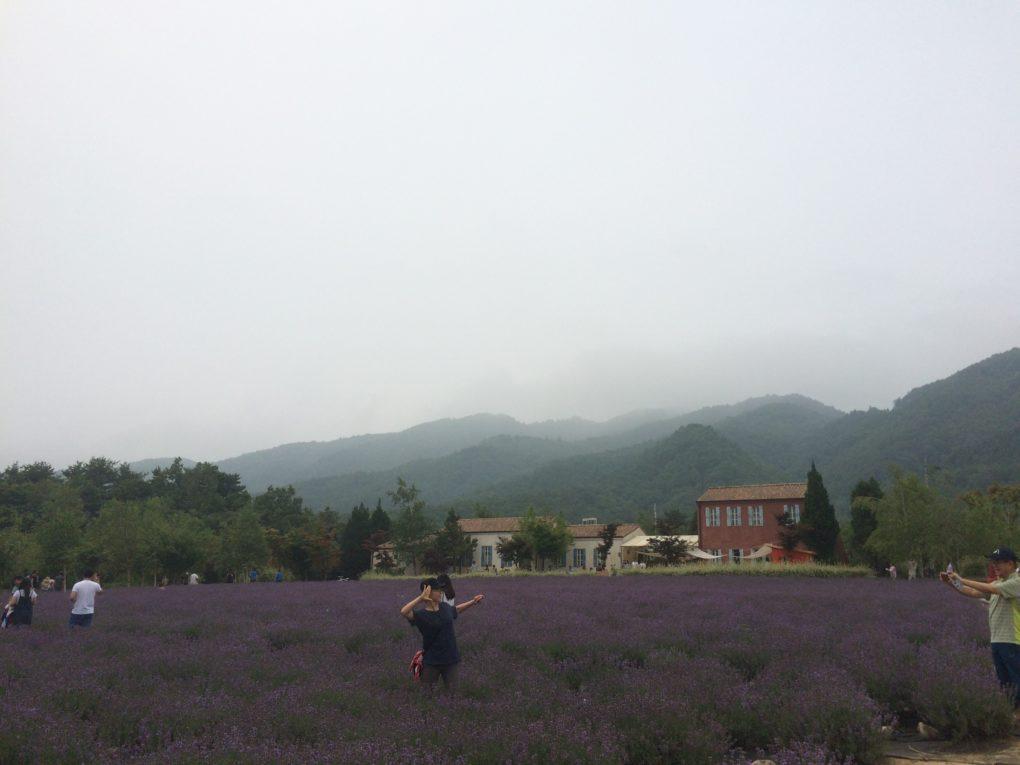
🗺️ South Korea Trip Itinerary Examples
The whole idea of this guide it to give you an idea of where to visit in Korea and how long you want to spend there. Tourism is on the rise in Korea, and having a unique experience is becoming more important than ever for visitors.
So in true DIY spirit, here are some route examples for a 2 weeks in Korea itinerary or less, for each of the following lengths.
South Korea Itinerary 14 Days
- Seoul (Days 1-4)
- Jeju (Days 5-7)
- Busan (Days 8-9)
- Suncheon area (Days 10-12)
- Jeonju (Days 13-14)
See below for more information on each city.
South Korea Itinerary 10 Days
- Suncheon area (Days 8-10)
Click to check current hotel prices in Korea.

South Korea Itinerary 7 Days
- Suncheon area (Days 5-7)
South Korea Itinerary 5 Days
- Seoul (Days 1-3)
- Jeonju (Days 4-5)
South Korea Itinerary 3 Days
Seoul. Just spend 2 days exploring all you can in Seoul, and then spend your middle day doing a day trip from the city, maybe to nearby Chuncheon .

🚕 Where To Visit In South Korea
Seoul : the capitol city, the darling of K-Pop fans, and one of the most populous cities in the world. Seoul is not for the faint of heart, but for those who can handle serious crowds, Seoul can be most anything you want it to be.
Almost everyone planning South Korea vacations will end up either starting or ending here, and they're lucky to do so. It's a great base from which to travel the rest of the country, or even spend a week or so experiencing all of the different neighborhoods & their vibes.
Seoul is great for culture, food, nightlife, and just about anything else you want in a trip to Korea, except for peace and quiet.
Busan : possibly best known outside of Korea for the movie Train To Busan , this port city is thought of domestically as the seafood and cinema capitol of the country.
Even though it's incredibly urban in its own right, people also think of it as more laid back, with beach vibes and ocean views for days. Busan is perfect for seafood lovers looking to spend time at the beach and indulge in some cinematic activity.
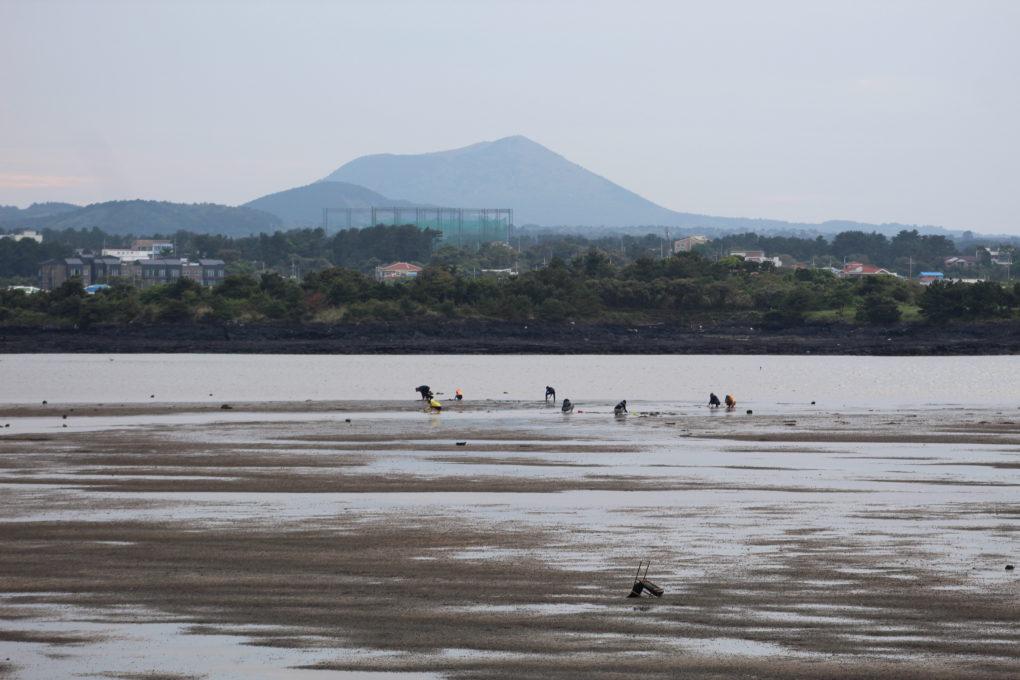
Jeju : the Hawaii of Korea, as it's often called, Jeju is known for its beaches and seafood and nature. The entire island comes from a single volcanic explosion thousands of years ago, and you can actually see the peak of that volcano from any point on the island.
Jeju is ideal for those looking to get a taste of Korean culture and cuisine, but with much more tranquility and beach vibes than you'd find anywhere on the mainland.
Jeonju : this lesser-known Korean destination is where Koreans go when they want to experience the "olden times" of Korea. Jeonju is one of the oldest cities in Korea , famous for its spicy bibimbap, traditional hanok houses, and many unique festivals.
Come to Jeonju if you want to soak in a whole city happily dedicated to maintaining traditional Korean culture, one bowl of spicy bibimbap at a time.
Suncheon : truly off-the-beaten path, Suncheon is a gorgeous region full of flowers, agriculture, and stunning natural landscapes. Domestic tourists most often visit in the springtime to see the green tea fields & cherry blossoms, but Suncheon is also a great base from which to explore a few nearby cities.
Visit Suncheon if you want to see a less-touristed side of Korea's natural beauty, with an emphasis on local agriculture.

✈ Seoul
What seoul is known for.
Seoul has everything you could want in a destination. It's one of the biggest cities in the world, and despite being the center of international cultures in Korea, it's still very much culturally Korean. It's for this reason that I think Seoul is the perfect place to put at the beginning of your Korea itinerary.
You'll probably arrive here, anyway, since Incheon Airport is one of Asia's biggest transport hubs. Many people even plan a Seoul itinerary for 10 days for a taste of the Korean dishes which have become so popular around the world.
Others come for the world-class shopping and cosmetics selection, or even for medical tourism . But I think that the most worthy reasons to write Seoul into your Korean itinerary are the natural beauty , historic temples , and little cultural quirks which all add up to an ambiance that's purely Korean.
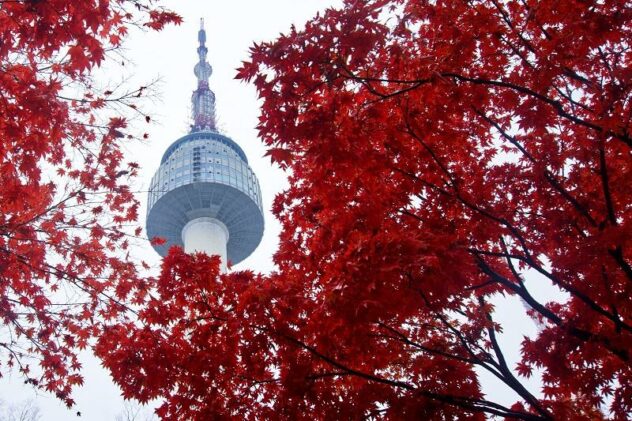
What To See In Seoul
I won't list out everything you can do or see in Seoul, since that could fill a whole book (and probably has). But here are 7 things you can't miss seeing in Seoul , since 7 is a lucky number here. Click here for more ideas of what to do in Seoul, with entrance fees, Korean translations, and hours .
Go to the spa. The spa, or sauna, is an important pastime for Koreans of all ages, and it's most common to go on the weekends as a family. A Korean sauna, however, is divided by gender and has you completely naked.
While you could visit a sauna in most any city in Korea, Seoul is going to have the most options for different types of baths and treatments, and it's going to be the most foreigner-friendly. I highly recommend Itaewon Land Spa.
Walk to Namsan Tower. This landmark is rather characteristic of Itaewon and the whole HBC area, located in central Seoul and considered the international hub of the city. Namsan Tower is set in a very green park, and right around the tower itself is a temple and a gate with “love locks” attached to it, but the Tower is best known for having an amazing view of the city.
It’s a bit of a walk from Itaewon’s downtown area, but there’s a bus if you get tired, and a cable car to take you to the top. I think the view is just as good from the cafe right before the top floor, so I wouldn't recommend paying for the cable car.
Visit Gyungbokgung , one of the 5 royal palaces in Seoul. Of the 5, Gyeongbokgung is the most accessible by public transportation, located just outside of a subway stop. I also think it’s the most beautiful, but I’ve had the chance to visit in both fall and spring.
Those are the seasons when the colors of the palace grounds come to life; in summer and winter it's a bit less colorful. The grounds of Gyeongbongung are large, but you could spend anywhere from twenty minutes to two hours exploring each corner of the grounds.
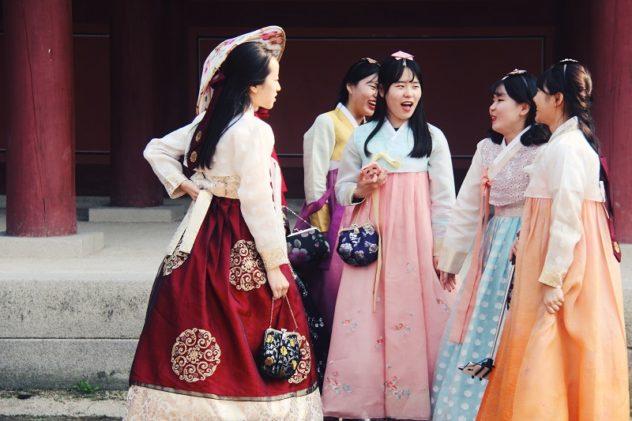
Sing in a Noraebang . Literally translated as "song room," noraebang are the quintessential nighttime activity of the Korean public. In English we usually know then by the Japanese name karaoke .
From middle school onward, on any given night you can find a noraebang full of Korean students hanging out with friends, or adults drinking with co-workers or family. In Seoul it's easy to find either coin noraebang, in which you pay per song, or regular noraebang, in which you rent a room by the hour & buy snacks .
Hike Bukhansan. Just a half hour north of Seoul is one of Korea’s many national parks. Hiking is a national pastime, so every day of the week you’ll see groups of older people geared up for a trip up Bukhansan. On the weekends there are visitors of all ages, usually ending their hikes with a picnic and drinks at whichever peak they decide to stop on.
Explore Gana Art Center . Gana is known across Seoul for its beautiful think pieces. Amidst all the traditional Korean food and aesthetics of northern Seoul, walking around Gana Art Center gives you a different perspective on the current events in Korea.
Luckily, you don’t have to speak any Korean to get the gist of real art, though it may be helpful to know some about Korean culture in order to get the full impact. The permanent exhibits are free, but you may have to pay to enter the special exhibits.
Wander Bukchon Hanok Village . A hanok is a traditional Korean house, a small building with a thatched roofs and beautiful painted walls & roof. In the spring and fall the foliage creates a stunning backdrop for photos, so that’s the perfect time to enjoy the village in traditional garb.
Note that Bukchon Hanok Village doesn’t actually close, but between the hours of 11pm and 5am there’s nothing going on.
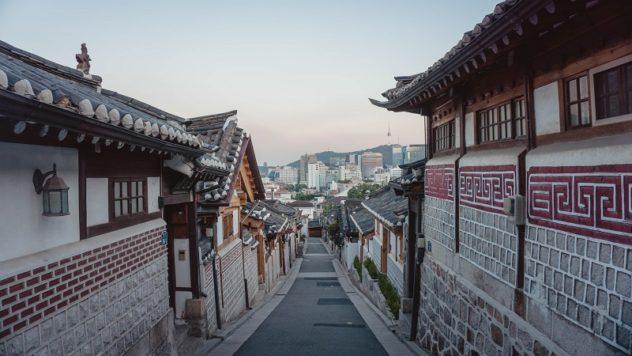
What To Eat In Seoul
In case you only have a few days in Seoul, this is where you'll get to sample a range of uniquely Korean foods. And hopefully also visit some of Seoul's dozens of delicious chocolate shops . So while you're in Seoul, be sure to look out for these top 5 Korean foods, particular to the country, but not to any specific region.
Japchae (잡채). A noodle dish containing thinly chopped vegetables, sweet potato starch noodles, and sometimes a little bit of meat. It’s great served warm as a main dish, but it’s often served as a side dish, tossed in sesame oil and soy sauce.
Hoddeok (호떡). This cinnamon sugar-filled fried rice cake is my absolute favorite treat. It's one of the few traditional sweets in Korea, but it's most easily found in the colder months, from October to April (I'd recommend you get it in the neighborhood of Insadong).
Samgyupsal (삼겹살). This is Korean pork belly, the most popular meat of choice in the country. It's just one of many types of meat you can have for Korean barbecue , which is basically a particularly communal style of cooking meat in the center of a table. If this is your only trip to Korea, you need to try this before you go!
Mul Nangmyeon (물냉면) . Translated as "water cold noodles," this chilled dish is made with buckwheat flour, and served with sliced cucumber & half a boiled egg on top. The dish is made with a meat broth and most commonly eaten right after barbecue, preferably with meat hot off the grill.
Samgyetang (삼계탕) . Quite possibly my favorite Korean meal, samgyetang is basically Korean chicken soup. The main part of the dish, thought be very healthy, is a whole chicken stuffed with rice and a bit of ginseng, jujubes, & ginko beans. You eat these with the side dishes and the meat & soup, after you dip it in the salt they serve on the side.

Where To Stay In Seoul
There are hundreds of lovely guesthouses and hotels throughout Seoul, and there are equally as many crappy ones. Most egregiously, some of them are both expensive and crappy. So here's my selection for the three best places to stay in Seoul . Each spot is centrally located, high quality, and foreigner-friendly. These are listed in order from least expensive to most expensive.
Budget: G Guesthouse
There's a reason this is always the recommended guesthouse in Itaewon. Not only does it always come in under budget, but the facilities are clean, the staff is helpful but unobtrusive, and the beds are comfortable. They even provide towels, a luxury not as common as you'd like.
Although you can't control what other guests do or what time they come back, my friends & I have always found that G provides a quieter environment for late-night entries than the other hostels in the area. Pro tip: the kebab place just down the street has the best kebabs in Seoul hands-down.
Mid-Range: Solaria Nishitetsu Seoul
Voted a traveler’s favorite in 2017, Solaria Nishitetsu is part of a Japanese hotel chain which combines comfort & convenience at a reasonable price. Guests love the huge rooms and large, firm beds, a real find in the heart of Myeongdong.
Because of its popular with business travelers, there are lots of harder-to-find amenities for digital nomads and other business people on-the-go, like work spaces and less-expensive single rooms.
Luxury: Signiel Seoul
Located in the top floors of Lotte Tower, Signiel is truly in a league of its own. Its sauna, gym, and pool facilities are world-class, with a staff and suites to match. Each room has a spa-style bathroom and a cozy place to rest your head, in addition to their unparalleled views of the city.
There are even free drinks and appetizers for guests in the hotel lounge, at all times of day. The Signiel is truly the place to get pampered, perfect for those looking for a honeymoon hotel .
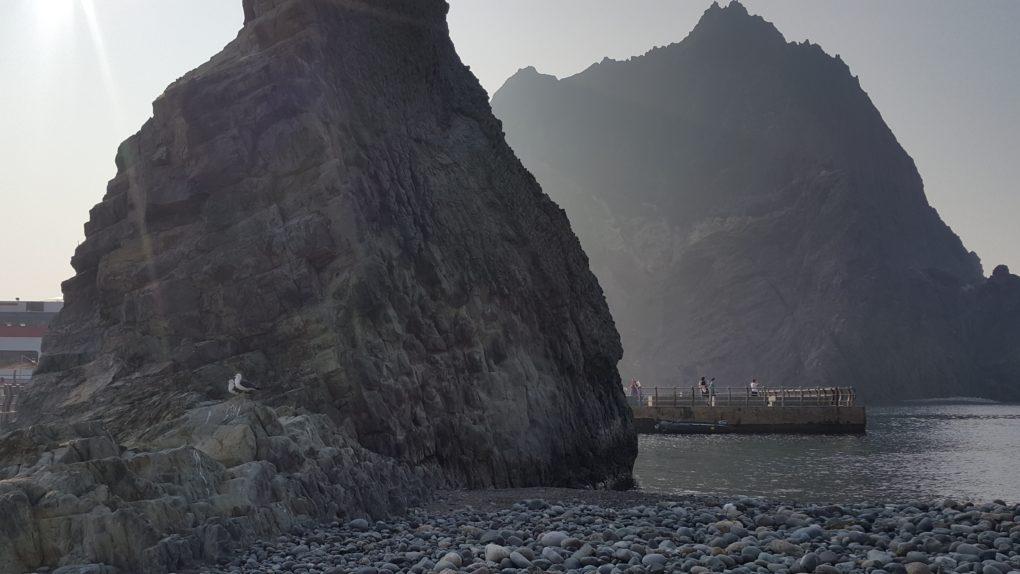
✈ Busan
What busan is known for.
Even though it's the second-largest city in Korea, and a metropolis in its own right, Busan doesn't get a lot of love from tourists. Most people think of it as a smaller version of Seoul, with a lot of the same cultural attractions but just harder to get to.
They have a point; Busan and Seoul are both massive port cities with cosmopolitan & hipster neighborhoods, alike. However, I'd argue that the feel of a place and its unique natural landscape plays a big role in your experience there.
In that regard, Seoul and Busan are more comparable to LA and San Diego. Seoul has glitz & glamour and a little of everything, while Busan has a more relaxed ocean-side vibe with lots of fresh seafood & quick flights to neighboring Japan .
As one of Korea's most popular weekend destinations, 3 days in Busan is plenty to see the city's highlights and get a feel for the ancient seaside temples , the beaches , and the local importance of cinema .
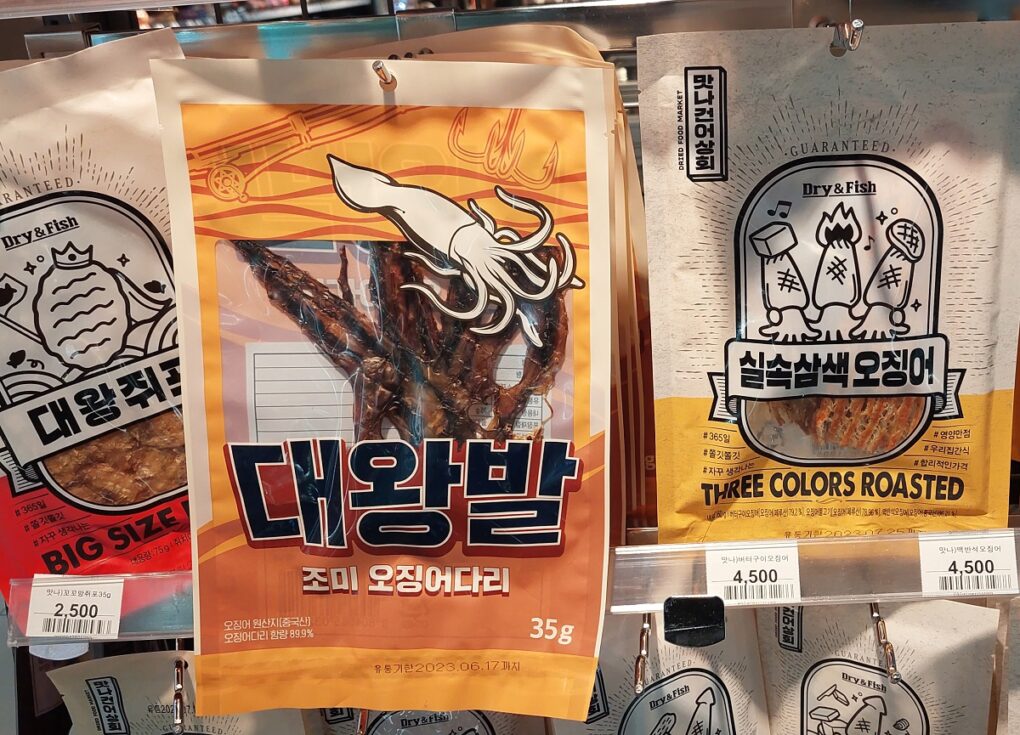
What To See In Busan
I won't write up everything you can do or see in Busan, since that'd take hours for you to pour through. So here are 7 things you can't miss seeing or doing in Busan (since 7 is a lucky number). Click here for more ideas of what to do in Busan, with entrance fees, Korean translations, and hours .
Lounge on Haeundae Beach. Undoubtedly the most popular beach in Korea, Haeundae is always packed in the summer, especially with families. But public schools don’t actually let out until mid-July, so if you time your visit well, you may just have a patch of sand to yourself. Note that beaches are only open for swimming from June to August.
Skip down Cheongsapo Daritdol Skywalk. This unique attraction has become quite popular over the last few years. It's basically a see-through bridge out over the ocean, perfect for showing off the ocean without you having to get in it. There’s also an observatory in the area, one of just 3 in the city. The skywalk is located a short walk from Haeundae Beach.
Explore Busan Cinema Center. As home to the Busan International Film Festival, which is held each fall, this is a great introduction to the film culture for which Busan is famous within Korea. The center has 3 buildings containing theatres of varying sizes, each offering daily tours & lectures. There are restaurants and cafes on-site.
Have a photoshoot in Gamcheon Culture Village. Probably the most popular photo backdrop in all of Busan, "GMC" has become known as a sort of Korean Cinque Terre . The calming blue houses look right out over the ocean, and are actually still people’s homes.
You'll see many an older person drying their laundry on their balconies and chatting on rooftops on sunny afternoons, so remember to stay respectful of the residents.
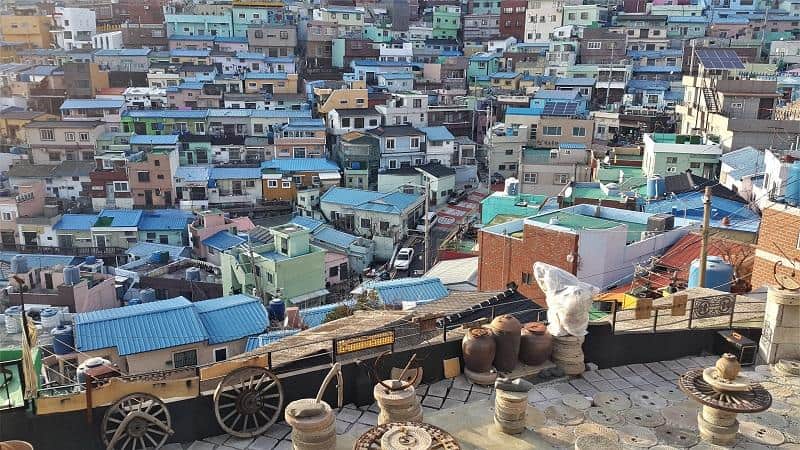
Have a meal at Jagalchi Market. This is the largest open-air seafood market in Korea, often compared to Noryangjin Market in Seoul. It’s actually become so famous that each October the city holds the Jagalchi Cultural Tourism Festival.
But even if you can’t make it on time for the festival, seafood lovers will have a blast walking through the market and exploring the diverse sea life found in Busan’s waters. The entire first floor is a wet market, while restaurants and the like are found on floors 2-7.
Wander the grounds of Taejongdae. Of all the things to do in Busan, this is by far one of my favorites. Equal parts resort & park, Taejongdae has become famous for its beautiful views and colorful tourist train.
The area's temples are accessible within an hour's walk, but even right around the entrance you can hike down and reach the shore in less than 10 minutes. Basically no matter where you go on the grounds, you’ll find a great view. Note that while it’s free to enter the grounds, this is likely to take up half of your day since it's so far south of downtown.
Watch sunrise at Haedong Yonggungsa Temple. In case you don't have the time to spare for a visit to Taejongdae, this is your alternative glimpse at Korea's ancient seaside temples. Most of Korea's temples are in the mountains, offering tranquility and spectacular views of life below.
But Haedong offers a broader view of the life going on below, focusing on the deep blue sea rather than countryside valleys. Some people come here to watch the sunrise, which is a spectacular choice considering it's on the east coast & opens at 5am!
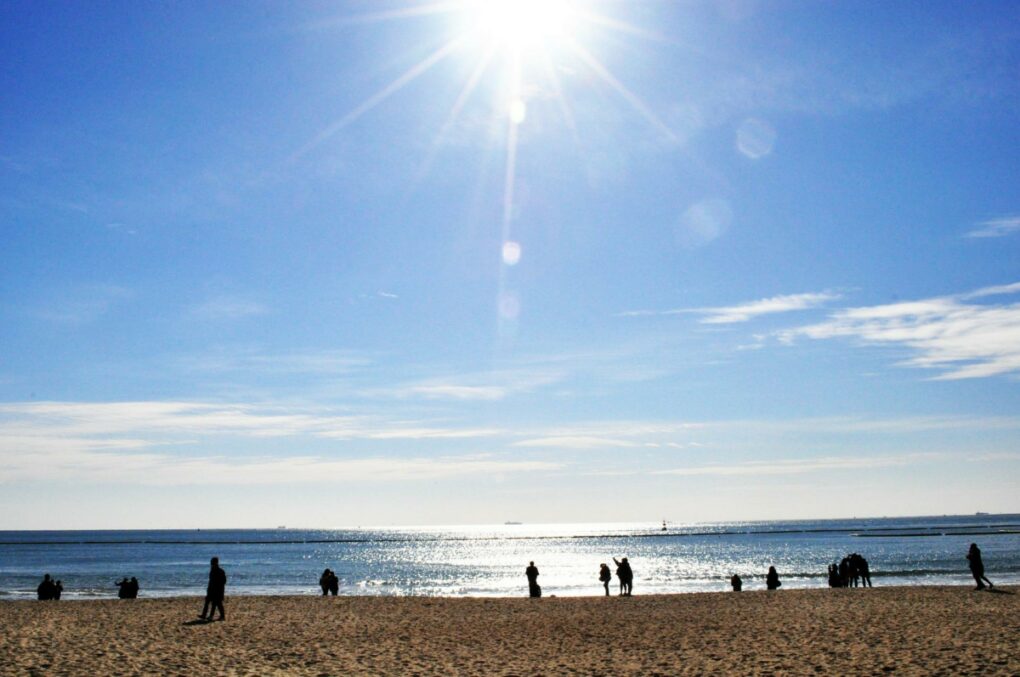
What To Eat In Busan
Busan is not a city for vegetarians or non-adventurous eaters, unless you're looking for chocolate in Busan , that is. The region's most famous foods are definitely of the sea variety, and thus, so are most of these 5 foods you should try in Busan. I have included a couple of land-based options for those who aren't into eau de ocean , however.
Sannakji : likely one of the most famous Korean foods, sannakji is often translated as “live baby octopus.” Cut & served immediately after being pulled from the water, sannakji are squirted with sesame oil & acidic fruit juices, making the tentacles continue to move around for minutes after death.
Haemul Pajeon : this is a seafood pancake, basically, but a Korean version (made with rice flour). They usually include tiny octopus, and are especially popular as a drinking snack, though many people come to Busan’s fish markets to enjoy them with family and friends.
Busan Jokbal : I don’t think I’ve ever met a Korean who didn’t like this dish. The jokbal , or pig’s feet, are cooked in a sweet cinnamon & honey mixture which reminds me of spiral-cut ham on Christmas. They're then served cut-up and ready for eating; the meat is fatty and rich, so don’t knock it ’til you try it.
Dwaeji Gukbap : this is a very hearty pork-based stew, prepared by slowly boiling pork bone into a broth & adding tender little pork bits. It’s served with rice and side dishes; you plop the rice into the stew and then eat it with side dishes of your choosing. It’s popular year-round, but is a must-try in winter.
Mulhoe : hoe literally means raw seafood, while mul means water. Mulhoe is therefore a raw fish soup, served cold & spicy with a variety of noodles and veggies. I'd only recommend it if you're eating somewhere right off the coast, like in Busan's Jagalchi market.
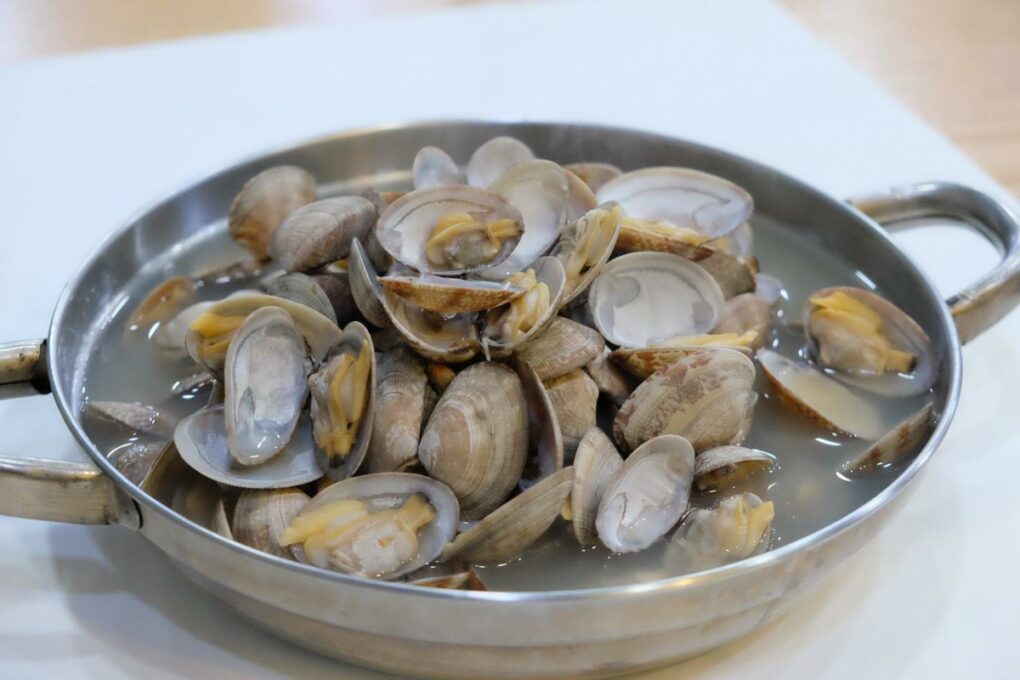
Where To Stay In Busan
Domestically, Busan is just as much of a tourist destination as Seoul is, since most of the people who travel around regularly are actually coming from Seoul. So Busan has hundreds of quality guesthouses, and probably an equal number of not-so-great ones.
So here's my selection for the 3 best places to stay in Busan , because there's no reason to suffer through a crappy, expensive hotel. Each of these spots is centrally located, high quality, and foreigner-friendly. These are listed in order from least expensive to most expensive.
Budget: The Bay Guesthouse
The Bay has become my go-to guesthouse in the warmer months, just 3 minutes from the beach & 2 minutes from the metro. It’s centrally located, the beds are large & comfortable, and the style is as a cross between a capsule hotel and a more typical hostel.
Every morning the manager even cooks breakfast for the guests, and there’s coffee brewed in the dining room.
Mid-Range: Stanford Inn Busan
Stanford Inn is a relatively new addition to Busan's "affordable luxury" lineup. But in the few years since it's opened its doors, guests have been very impressed with the high quality of the rooms & breakfast buffet.
Port-side suites garner the most praise, with guests impressed by the view and the proximity to the metro, just a few blocks in either direction.
Luxury: Lotte Hotel
Though best known internationally for department stores & perishables, domestically Lotte is known for offering a variety of luxury experiences; this includes their chain of hotels. Each suite in Lotte Hotel offers big fluffy beds and a spacious bathroom, as well as a bevy of modern furnishings.
Lotte Hotel is especially popular with families, thanks their reputable spa & restaurant facilities.
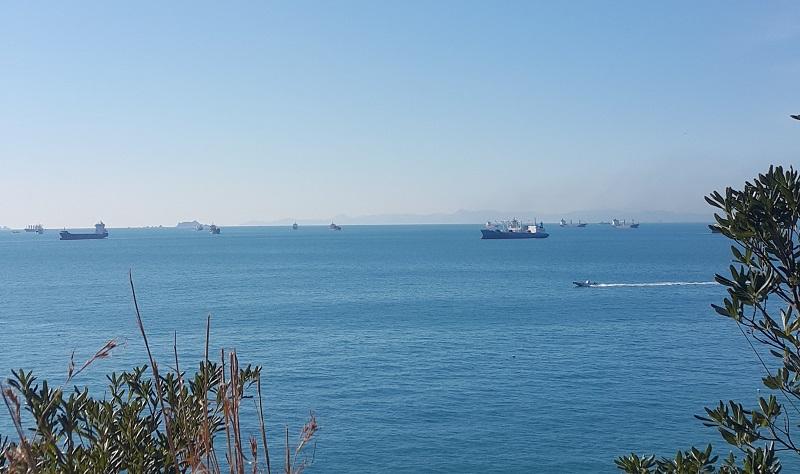
✈ Jeju
What jeju is known for.
A few days after one of my trips to Jeju, a Korean friend told me he was jealous that I went without him, because Jeju is his "stereotype of a beautiful place." Well to be honest, it's mine, too. Jeju is breathtaking in the spring & fall, and somehow a haven from the mainland's overwhelming weather in winter & summer.
The route from Seoul's Gimpo Airport to Jeju is actually the most traveled route in the world . That's how much Koreans love visiting this idyllic little island off their southern coast. But tourists? Not so much. Every time I visit Jeju, mine is one of the very few foreign faces I see.
But Jeju Island has so much to offer, from gorgeous hikes to unique local foods , that there's no reason it shouldn't be on every South Korea travel itinerary. Jeju is the place for you if you love exploring natural beauty , learning about sea life , and relaxing seaside .
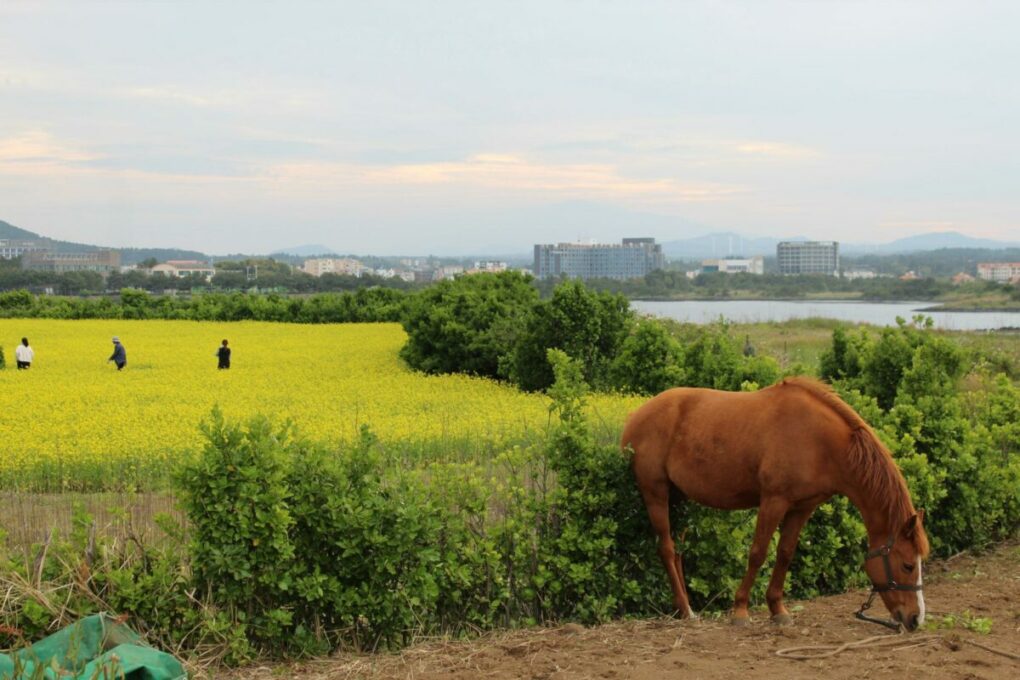
What To See On Jeju
There is such an incredible number of things to do on Jeju, in every season, that you could spend hours researching. But to give you an idea of some of the many things you can do across the island, here are 7 things you should do or see on Jeju Island. Click here for more ideas of what to do on Jeju, with entrance fees, Korean translations, and hours .
Pose in Love Land (erotic museum). This is often one of the most unexpected sites to find in Korea: a park full of penises & other various erotic sculptures. The park was opened in 2004 by a group of art students from Seoul’s prestigious Hongik University, and since then the park has been a surprising success, where selfies abound. Note that you must be at least 18 to enter the park .
Watch sunrise at the top of Seongsan Ilchulbong. Is this in Korea or the Highlands of Ireland? The immensity of the green and the brightly colored flowers that greet you in the spring could very well distract you from ever climbing to the top of Seongsan.
From the hike to the viewpoint, horseback riding, and boating, you could easily spend half a day here. If you’re lucky, this is also where you’ll catch site of some of Jeju’s famous women divers, though you may see some on the walk over.
Hike around Seopjikoji. Just across from Seongsan Ilchulbong is Seopjikoji, an area famous for being the filming location for several dramas, and just a stunning place in general. The stairs built into & walking trails leading along the cliffs can get a bit crowded on weekends in the summer.
But if you get too hot, there's also a sea side restaurant at the top of the climb. Seopjikoji's most gorgeous scenes are in the spring, when the hills are vibrant green and dotted with bright yellow canola flowers.

Stare in awe at Jeongbang Waterfall. Jeongbang’s claim to fame is that it's the only waterfall in Asia to fall directly into the ocean. It's honestly a cool sight to see, basically from the parking lot, making it my pick for the best waterfall in Jeju.
There’s even a tiny beach in front of it, just before the vast ocean extending way beyond. The shops just along the parking lot will also be selling souvenirs, oranges, and Jeju chocolates.
Walk the Jusangjeolli Lava Cliffs. Often compared to Giant’s Causeway in Northern Island, Jusangjeolli is another act of nature bestowed upon Jeju by the volcano from which it was forged. Less than 5 minutes from the parking lot, the cliffs are deep grey rectangular formations jutting out into the ocean.
It almost looks as if they were formed by a child slowly stacking blocks. They’re quite the popular photo spot, and certainly worth a stop, though lines for selfies can get long on weekends.
Bathe in Sanbangsan Carbonate Springs. This will be one of the strangest experiences of your life, if you’ve never been to a Korean sauna. Everybody here is separated by gender, and then strips themselves buck naked. It takes some getting used to, but when you do, it’s glorious. These hot springs are divided by each temperature and healing properties, making for a very soothing way to spend an evening.
Sip on a cup of tea at O’Sulloc Tea Fields & Museum. The museum is tiny, but if you came to the fields for the tea products, then this is your spot. The aforementioned museum is attached to a massive cafe serving up a variety of teas from their farm, plus coffee and desserts .
The entire complex is located next to a cosmetics shop & a second cafe. But the best part for most people will be the tea plantation itself, situated across the street from the museum, and laid out with pictures in mind.
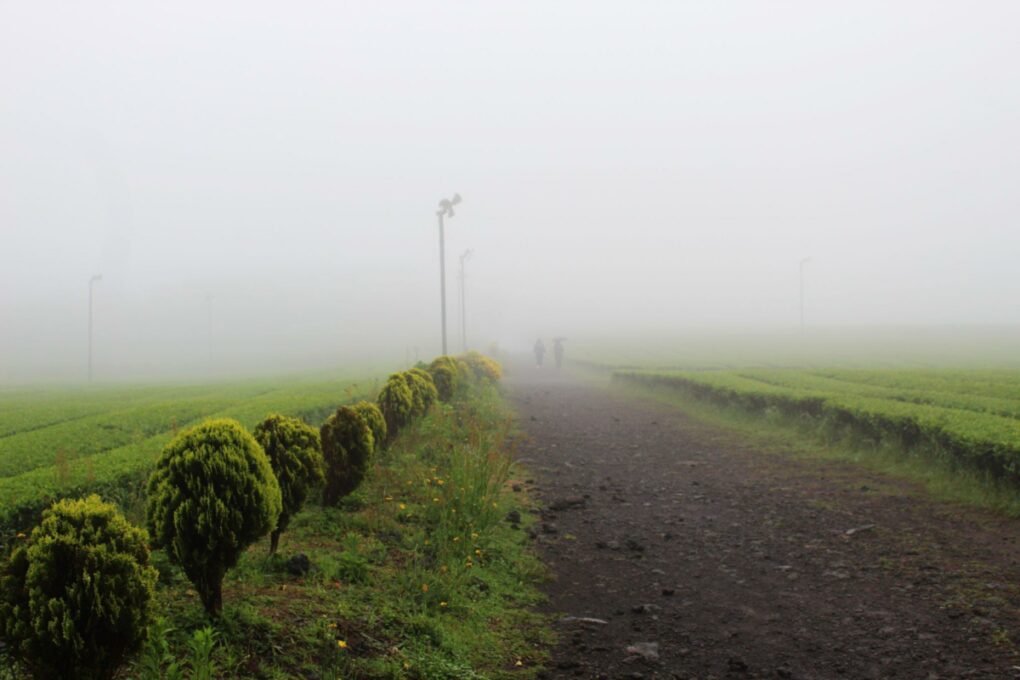
What To Eat In Jeju
Like all other provinces and cities in Korea, Jeju has a few foods it's famous for, but unlike most of those other regions, Jeju is famous for them because they're actually grown there. A few of these products have turned into a whole range of foods, all focused on that one crop. Take a look.
Abalone (Sea Snails). I know the translation doesn't sound very appetizing, but abalone are actually shellfish, more like oysters than snails (but don’t go looking for any pearls). They’re one of the many sea foods caught by the women divers of Jeju, and are caught & served fresh daily. Local favorites are abalone rice porridge and grilled abalone.
Black Pork. This is meat from a specific type of pig raised mainly on Jeju Island , and I find it to be a softer & more flavorful version of the meat found on the mainland. If you’re looking for easy pickings of a variety of black pork restaurants, check out Black Pork Street in Jeju City.
Hallabong (those big oranges grown throughout the island). The season for hallabong is actually winter time, but some of the groves manage to grow oranges year round. So you’ll see these thick-skinned beauties for sale in boxes along the side of the road, and at gift shops in most of the major tourists sites. Keep an eye out specifically for hallabong tea.
Green Tea Anything . Home to the well-known O’Sulloc tea fields, you’ll see green tea-flavored things for sale throughout Jeju. But nowhere is there a higher concentration of tea-flavored items than at the O’Sulloc tea museum, itself, which is profiled above.
Peanut Ice Cream. Depending on where you get it from, the cream flavor can be more or less intense, and the ice crystals can be very strong. But peanuts are actually grown on Udo, an island off the coast of Jeju, making it a truly local food. Though honestly, most people just buy it for the cute pictures.
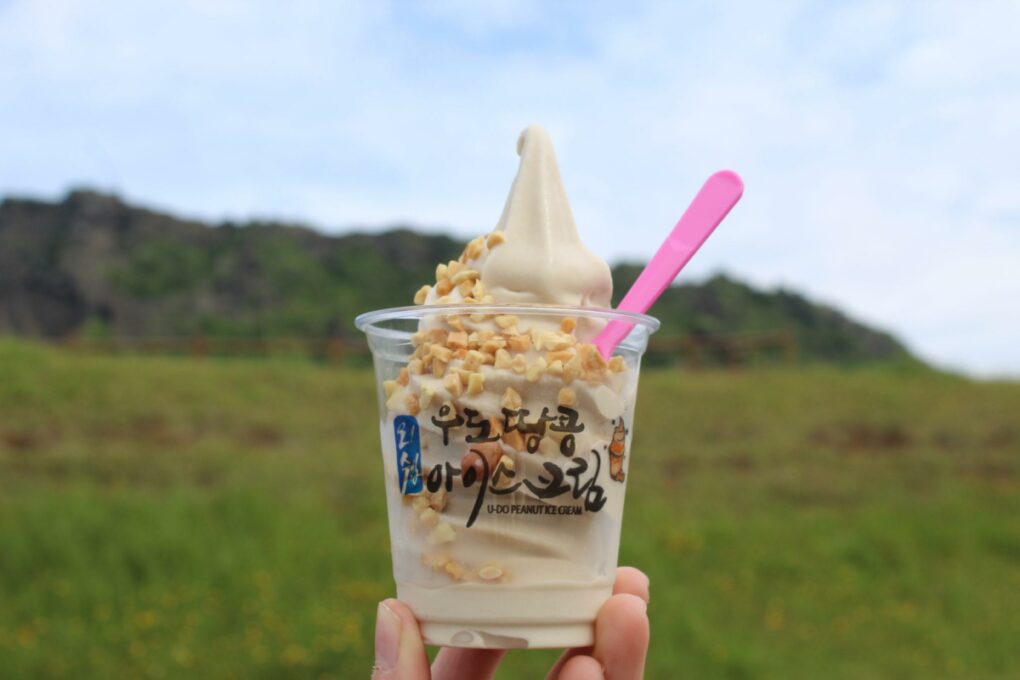
Where To Stay On Jeju
Since so much of the Island's economy depends upon tourism, you'll have your pickings of Jeju accommodation, especially in Jeju City and the southern city of Seogwipo. But there are some hidden gems, so allow me to shine light on 3 of the best places to stay on Jeju . Each spot is centrally located, high quality, and foreigner-friendly. These are listed in order from least expensive to most expensive.
Budget: Yeha Guesthouse
Seoul is famous for their inexpensive accommodation, but Jeju City really puts up a fight. Yeha is the best choice for backpacking or budget-minded visitors, with a solid 9/10 rating for their dorm beds, and a good connection to island's public transporation.
To top it all off, they’ll happily store your luggage for you if you want to explore a bit before your flight back.
Mid-Range: Color In Jeju
If you’re looking to stay on the eastern coast and want to splurge a bit, Color In is the move. They’ve got immaculate rooms, a small outdoor pool, and the rugged surroundings typical outside of the big cities. Front desk hours are limited, but that’s easily overlooked once you get to the pool.
With just 6 guest rooms in the entire place, odds are good that yours will be poolside.
Luxury: Kensington Hotel Jeju
One of the highest-rated hotels in Jeju, the Kensington contains all the opulence one expects from a 5-star hotel, infinity pool included. If the layers of indoor & outdoor pools isn’t enough, however, consider the superb staff and various on-site restaurants; their breakfast buffet is included in your stay.
Within walking distance of the hotel are a botanical garden and the teddy bear museum.
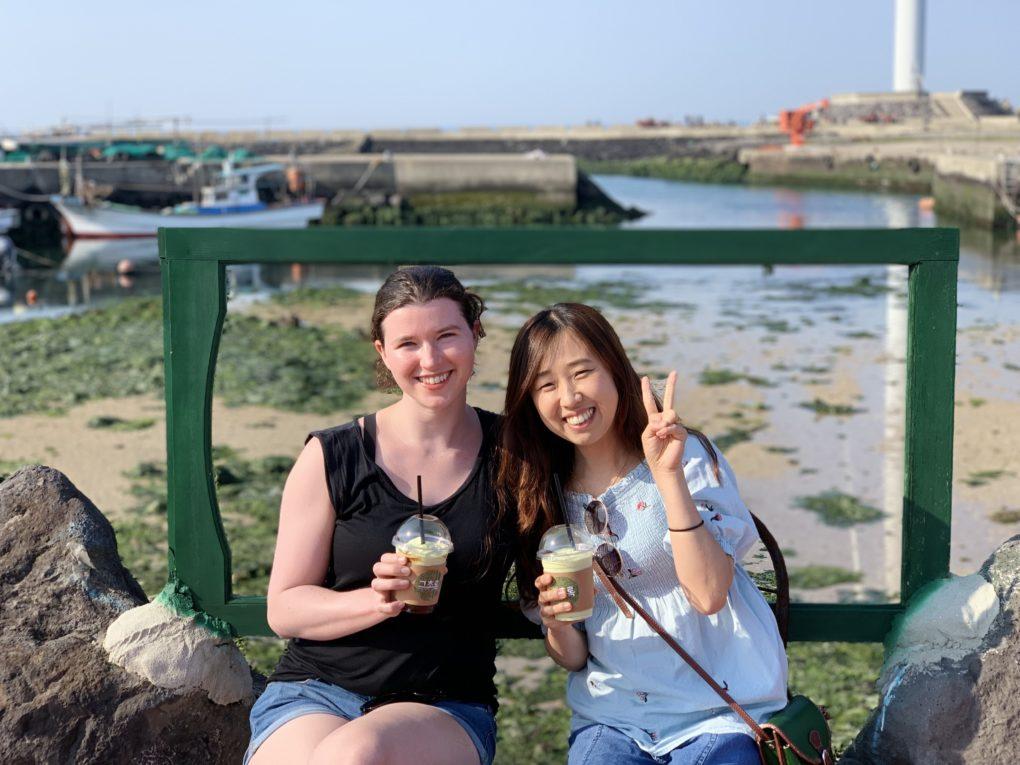
✈ Suncheon
What suncheon is known for.
Of all the cities in this Korea itinerary, Suncheon is probably the least famous internationally. The city has just a few hundred thousand residents, quite small by Korean standards, but each spring the county is flooded with domestic tourists chasing beautiful flowers and stunning natural landscapes .
But despite its size, I'd recommend Suncheon because of its great potential as a base from which to explore the rest of southern Korea. Just south of Suncheon are Boseong, where most of the country's green tea is grown, and Yeosu, a beautiful island with lots of attractions in its own right.
Northeast of Suncheon is Gurye, whose spring flower festival & fall cherry festival are famously striking. Simply put, people visit Suncheon in order to revel in the beauty of nature , get away from the big cities , and enjoy the festival culture of small Korean communities.
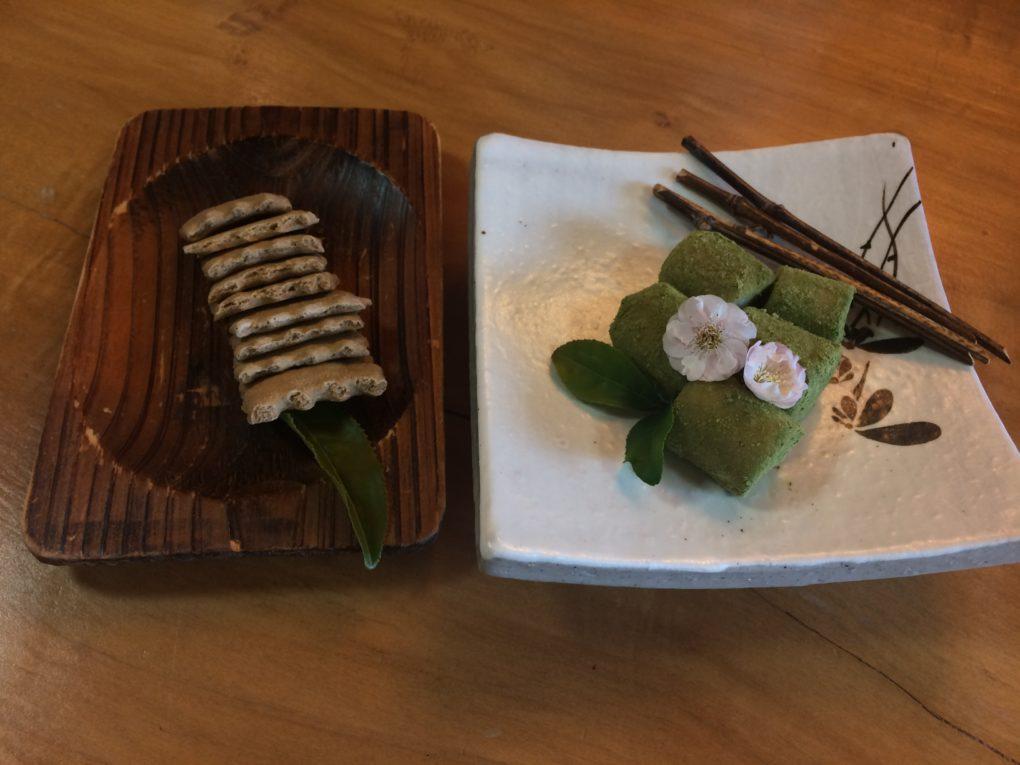
What To See Around Suncheon
As just one of four great cities to explore in southern Korea, it's difficult to distill Suncheon attractions into one post. But in order to lend an idea of some of the things you can do around Suncheon, here are 7 things you should do or see near Suncheon City.
Learn hands-on at Naganeupseong Folk Village. With remaining residents numbering in the hundreds, calling this a village is a bit of a stretch. But Naganeupseong is more like a demonstrative village, offering visitors performances and traditional experiences you couldn't find even in Seoul.
Each region of Korea has their own unique traditions that they've chosen to keep alive and highlight here. This means that for as vast & varied as Seoul is, you won't find as many ways to experience southern Korean culture up there.
This is honestly in large part because most Seoulites see Korea's southernmost areas as countryside and backwards and unworthy of a visit. However, I think that each is gorgeous (including my own countryside town), and this one in particular is worth a trip.
Hike the Suncheon Bay Wetlands. Small crabs reach up at you from the mud, wheat whispers in the wind, and old people are probably yelling from just behind you. So go the wetlands. Starting from the parking lot and continuing on through the carefully-curated gardens, you'll reach the wetlands themselves.
From there you can cross the gardens via a long bridge. On the other side is a small mountain, which you can take about half an hour to hike up, or you could stop and turn around where you are, admiring the other side of the wetlands' natural beauty.
Picnic at Suncheon Bay National Gardens. When I think of gardens, I think of somewhere well-kept and brightly-colored, maintained within a specific small area. Suncheon's National Gardens are a vast and impressive version of that, including not just flowers but also sculptures, a bridge covered in hangeul , and a variety of cafes & eateries on site .
In peak bloom season, from around mid-March to mid-May, you could easily spend a whole day walking across the ponds and admiring the colorful fauna, wondering why you didn't come here sooner.
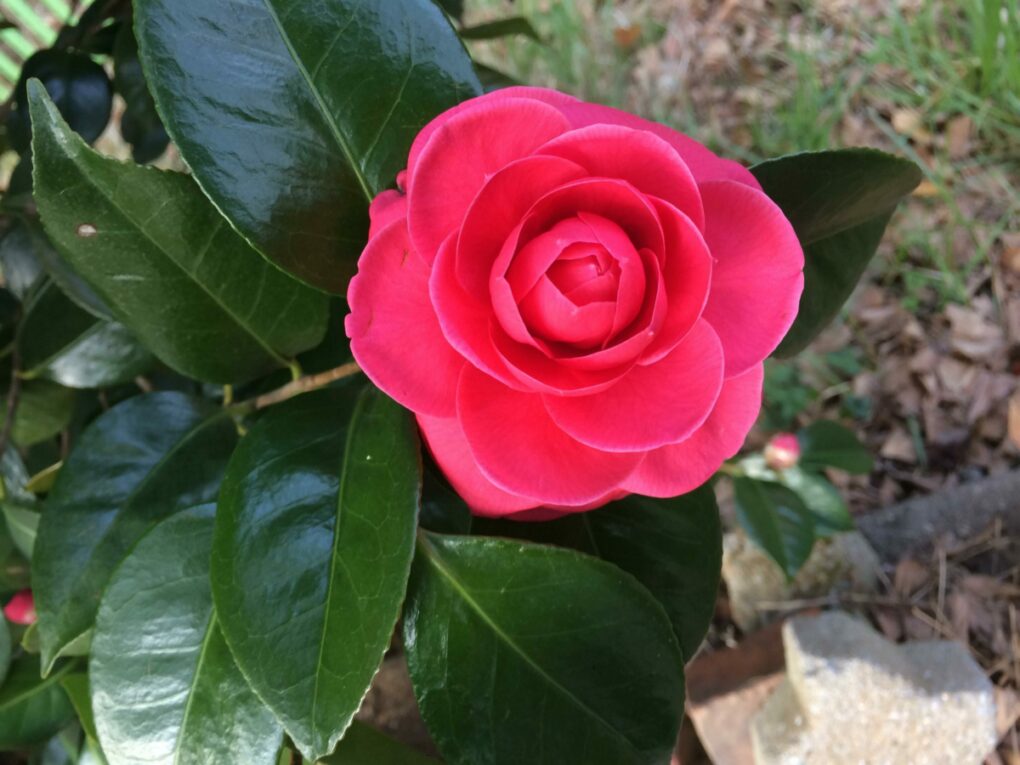
Relax at Jirisan Spa Land. If you've never been to a Korean sauna, you are missing out. Spas are a national past time here, and they're also quite affordable, and fun in a group, couple, or solo. Jirisan is particularly well-known because it features hot springs-supplied baths. Keep in mind that like all Korean spas, the indoor regions of the spa are separated by gender and have a no-clothes policy.
Do a photo shoot amongst Gurye Cherry Trees. These bright yellow blossoms have taken up root throughout the village of Gurye, bringing hoards of people (& tourism dollars) to town every spring. In the fall, the trees' cherries cover them in color once again, this time a deep red . If you manage to visit in March (outside of festival time), you may even find this to be the perfect spot for a photo shoot.
Ride the Yeosu Cable Car. Especially beautiful around sunset, Yeosu's cable car takes you across the bridge which connects Yeosu to the mainland. From an incredible height it gives you a look at the still-active port area and many smaller surrounding islands. Not to mention it saves you a taxi ride!
Drink up at Boseong Green Tea Fields. The green tea fields of Boseong hit their peak around mid-May, but they start turning a deep green color as early as March, continuing to lighten until late September. Koreans come to visit the main green tea plantation in order to hike up to the top of the hill on which the tea trees are planted.
Most people end up taking selfies and enjoying the view of everyone walking around far below them. At the plantation, other than the tea itself, you can enjoy green tea-flavored churros, lattes, and even a few savoury dishes (though don't expect much tea to be put in those).

What To Eat In Suncheon
Suncheon is often hailed as the foodie capital of the southern part of Korea. Located near the coast, in Jeollanam-do, local restaurants in Suncheon will serve all the classics, but with a southern twist. Popular themes include seafood, fresh local vegetables, and abundant side dishes.
Mudskipper Soup. Arguably the most popular way to consume this local fish, the soup is prepared using boiled fish, radish leaves, and soybean paste. It's a very strong flavor, but all the side dishes it's served with temper it beautifully.
Kongnamul Gukbap . Literally "soybean soup rice," you can find gukbap all over Korea; I actually recommend trying a hearty pork or beef version in Busan. But each region has their own special recipes for the soups and when they add the rice and where they source the ingredients. In the case of Suncheon's gukbap , the soybean sprouts add beautiful crunch to a very traditional Korean dish.
Sannakji Bibimbap. Another dish I sort of recommended in Busan, sannakji is basically the freshest form of raw octopus you could eat, served with lemon juice and seasoned with sesame oil. This iteration is less of a snack and more of a full meal, incorporating fresh vegetables and rice. Look for 산낙지비빔밥 on a menu.
Green Tea Churros. I couldn't recommend visiting the green tea fields of Boseong without also recommending the snacks! Only available on the weekends, these churros are nice when paired with a cup of green tea soft serve ice cream.
Grilled Duck. Suncheon famously raises about half the duck in Korea, meaning that finding a local duck dish is more likely than not. If you can find it, my favorite is Yangnyum Ori (양념오리).
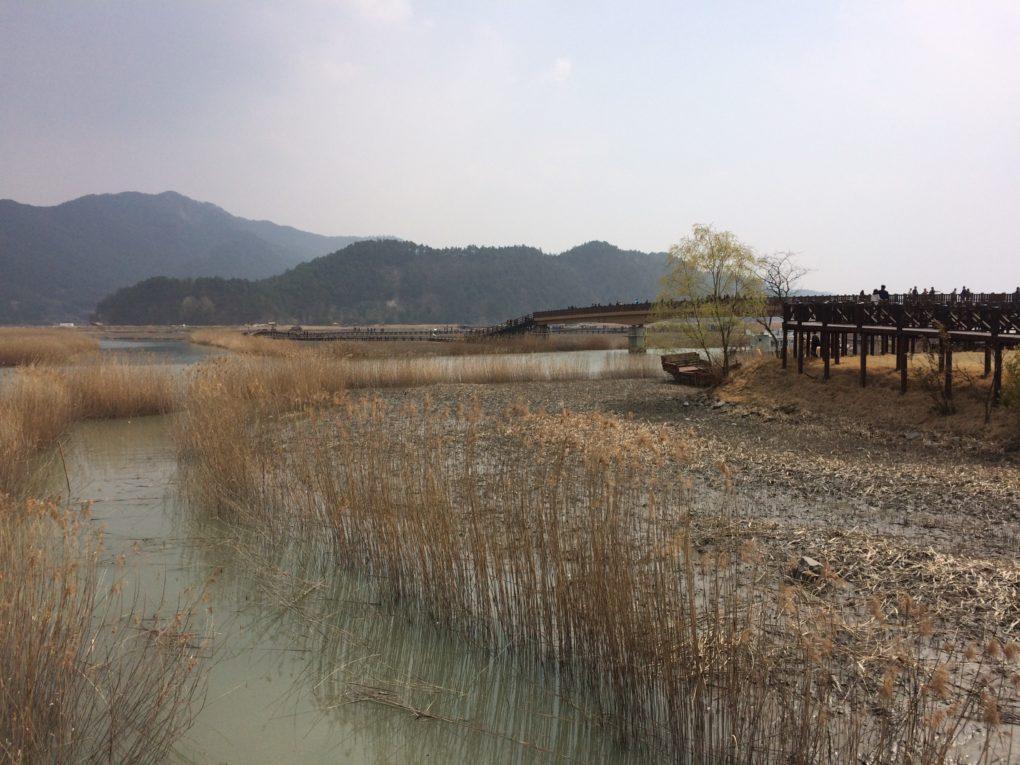
Where To Stay In Suncheon
Suncheon is quite the hot spot for domestic tourism, so most of the places to stay in Suncheon are Korean-style. This means that you sleep on the floor, and usually call to book directly. But there are some nice western-style guesthouses to choose from, three of which I've listed below. If you're visiting Suncheon between April and June, I'd recommend booking a guesthouse in advance!
Budget: Suncheon Namu Guesthouse
You can't get much closer to Suncheon bus terminal than Namu Guesthouse. No matter what time of day or night you arrive (or depart), if you stay at Namu you're just a few minutes from the city's bus terminal.
The beds are pretty standard for Korea, on the hard side, but the shared space is very homey and comfortable. At just $16USD a night for a dorm bed, it's the perfect spot for those planning to stay awhile and do a lot of day trips.
Budget: Baguni Hostel
It's rare to find a hostel with affordable dorm beds and a decent sense of privacy, but Baguni manages to strike this balance with grace. The dorm beds are each in their own little cubbies, with privacy curtains and fluffy bedding.
But the building itself makes use of lots of white and neutral tones, choosing to focus mainly upon providing a clean, comfortable, and affordable environment for guests.
The hostel is located right in the city center, a short walk from the bus terminal, making it a great choice for visitors who can't or choose not to rent a car. Single hostel beds start at $18USD a night.
Mid-Range: Hotel Iam
Every room at Iam includes an en-suite bathroom and complementary breakfast in the dining room. For those looking to upgrade their stay in Suncheon, this is an affordable hotel with comfortable beds, a nice staff, and a central location.
It's family-friendly, but more popular with couples looking to get away from hostels without breaking the bank. Double rooms start at $40USD.
Click here to check out prices for other hotels in Suncheon
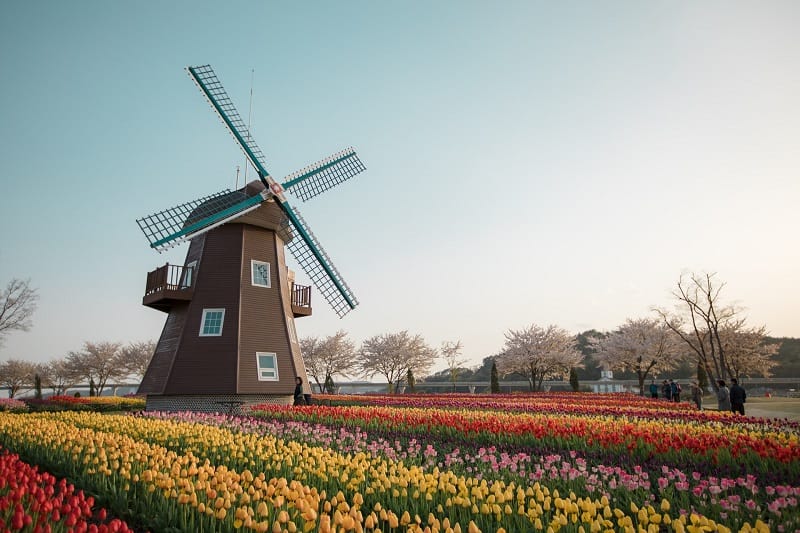
✈ Jeonju
What jeonju is known for.
Despite being just 1.5 hours from Seoul, Jeonju rarely features on a Korea itinerary, and that is a mistake. While you can easily visit Jeonju on a day trip from Seoul, I humbly recommend you spend at least two days in the city.
Preferably while staying in one of the historic houses & enjoying traditional Korean dishes in Korea's "Foodie Capital." Unlike Suncheon, most of the things to see in Jeonju are within the city itself, making it walkable and perfect for any wintertime Korea itinerary.
Seoulites tend to visit the city on the weekends, so take a couple of weekdays to discover the city whose name literally translates as "perfect region." While you're there, make the most of your time with visits to local galleries and walks around the city's many parks and green spaces.
Jeonju is seen as a very spiritual city, a place of historical importance for its maintenance of traditional foods, architecture, and those intangible parts of Korean culture we all strive to experience in a new place.
What To See Around Jeonju
Jeonju is a great place to just walk around, similar to some of the neighborhoods in central Seoul, but it's always nice to have a destination in mind. So in order to give you an idea of some of the things you can do in Jeonju, here are 7 things you should do or see in the city.
Photoshoot in Jaman Mural Village. Somewhat similar to Gamcheon Cultural Village in Busan or Rainbow Village in Taiwan , Jaman has become a symbol of revitalization for older parts of the city.
While the nearby hanok village has become well-known, just beyond the overpass is Jaman, a neighborhood painted up & beautified by local artists. The uphill scene is worth the trip, and makes for some very cute photos, especially for families and couples.
Tour a Hanok . A hanok is a type of small house, traditionally one story tall, which were the main type of dwelling in Korea for centuries. Due to Jeonju's ancient status, it was designated a UNESCO City of Gastronomy, and as a result, the rest of the city has also been well-preserved.
One thing that sticks out in Jeonju compared to Seoul or Busan is the height of the buildings. It can be hard to put your finger on at first, but you'll quickly notice how short most places are, and how it opens up the entire city.
This is due in large part to the city's hanoks . Places feel greener, even when you visit Jeonju in the winter. While you can tour a hanok ( hopefully stay in one, too! ) just by walking by, I'd also recommend checking out Gyeonggijeon Shrine for a more holistic look at how hanok culture shaped contemporary Korea.
Eat Street Food at Nambu Night Market. You can't recommend a visit to Jeonju without also recommending a trip to a night market. Korean night markets are notoriously boisterous affairs, with locals loudly hawking their wares from the safety of their booths, wafting any number of smells your way. The market is open every day, but Fridays and Saturdays are the busiest of all.
Some delicacies to enjoy once you've feasted your eyes are the grilled meat skewers, daepae saewoo (pork-wrapped shrimp), and hoddeok (honey cinnamon-filled rice cakes), though there are many international dishes, as well.

Try Dolsot Bibimbap With Makgeolli . Those little gold bowls full of translucent white liquid have become a staple in my life. Anytime staff at my job went out to dinner together, we always had makgeolli (rice wine), usually served from a big pot in the center of the table.
This is the most traditional way to consume the traditional rice liquor, and it's a great accompaniment to Jeonju's famous version of bibimbap (mixed rice). Try it almost anywhere in the ancient village, and I guarantee a smile.
Wear a Hanbok Amongst Hanok. Similar to the beautiful hanbok (traditional Korean outfits) you'll see in Seoul and Busan, it's almost a rite of passage to wear a hanbok around Jeonju. If you want a more unique experience in the city, this is the move. Rentals start from ₩8,000 (~$7USD), and range from 1-4 hours.
Have Tea in an Ancient Cafe. Or at least in a cafe that looks ancient, as many of the cafes in Jeonju's downtown area have been styled to look.
Some of the cafes are even in a hanok , which makes the tea-sipping feel all the more event-like. Some great cafes in Jeonju are Café Haengwon and Swan Park Cafe, but just remember to have a translation app on hand for the menus.
Admire the Flowers in Deokjin Park. One of the most popular gathering places in Jeonju, Deokjin Park has now become a draw for visitors, as well. In the spring there are flowers everywhere, while the summer sees the lotus blooming on the lake & fall brings changing colors to the leaves.
If you visit from July to August you'll notice crowds of locals taking pictures with the lotus flowers, as the high season coincides with kids' summer break.
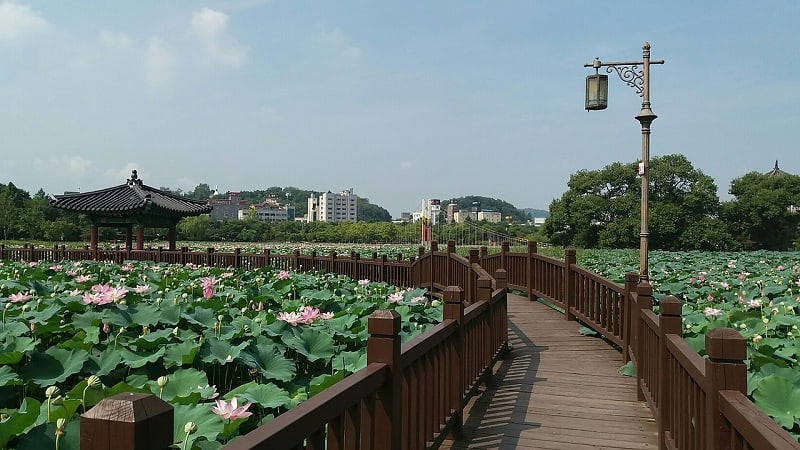
What To Eat In Jeonju
Despite the popularity of Suncheon as Korea's underground foodie capital, Jeonju is the official foodie capital of the country. In fact, in 2012 it was named a UNESCO City of Gastronomy. Domestically, Jeonju is known for its fresh vegetables and locally-grown rice, as well high levels of spice, so prepare your palate.
Legit Choco Pies. The infamous Korean treat of Choco Pies, which my students simply adore, were actually born at a bakery here in Jeonju. The bakery, PNB, has branches throughout the city, where you can find the layered chocolate and marshmallow pastry in multiple iterations.
Grilled Imsil Cheese. Korean cheese is notoriously gross. But many years ago, in a town just outside of Jeonju, one company faced this problem head-on: Imsil. In street food regions throughout the city you can find thick skewers of carefully grilled Imsil cheese, lightly sweet and crispy on the outside, halloumi-like in texture.
The brand also makes some delicious yogurt, and if you took the bus to & from Jeonju, you may even stop at an outpost where you can buy some of their cheese & yogurt. Go for the blueberry flavor; you can thank me later.
Jeonju Royal Court Cuisine. Gung hanjeongsik , as it's called in Korean, is the modern retelling of the special food eaten at the King's palace during the Joseon Dynasty. Even back then it was so intricate to prepare that it was only consumed once a month. One of my friends insisted that we try this type of meal when we went to her hometown, and it does not disappoint.
The setup is basically three tables covered in dozens of side dishes and a few main meals, all emphasizing local specialties from different parts of the country. This special meal is an investment, maybe $45USD per person. But it's seriously worth it.
Ddeok-galbi. Another local recommendation, these short rib patties will make your mouth water. They're prepared using marinated galbi , usually pork, and onion, garlic, ginger, and a umber of other spices. The meat is ground and then reformed into thin patties before being grilled on skewers or back on the bones; they're served with white rice and numerous side dishes.
Dolsot Bibimbap. While bibimbap (rice with steamed vegetables) is common throughout Korea, this version is unique because it's prepared in a piping hot stone bowl ( dol is Korean for "stone"). The rice is allowed to crisp up on the bottom, adding a delightfully different texture to the mix of ingredients.
This mix almost always includes fresh vegetables, kimchi, oak jelly, a small amount of beef, and a raw egg to stir into the steaming hot dish. Jeonju is so synonymous with bibimbap that there's now Bibimbap Festival every year. Just don't touch the bowl!

Where To Stay In Jeonju
One of the main reasons people choose to visit Jeonju over any other destination in Korea is for the hanoks (traditional Korean houses). All of them are now also equipped with ondol , the typical Korean floor heating system, making them quite comfortable even on the coldest of nights.
So most visitors do opt to spend the night in one of these beautiful guesthouses, most all of which are clustered in the famous Jeonju Hanok Village (in the southeastern part of the city).
But I'm not a huge fan of sleeping on thin blankets on a hard wooden floor, despite having done it a few dozen times. So here I've recommended just one hanok -style guesthouse, the two other being more western-style accommodations.
Budget: 24Guesthouse Jeonju
24 is a popular guesthouse chain, and I've stayed in several of their locations throughout Korea. They offer affordable double rooms with en-suite bathrooms, as well as 3- to 4-person hostel-style rooms for some of the cheapest prices around. A simple coffee & breakfast is included.
The guesthouse is a few blocks north of the Hanok Village, allowing you to be near but not right inside all of the action. At just $14USD a night per dorm bed, it's hard to beat the price if you're visiting Jeonju on a budget.
Hanok: Bu Kyung Dang Guesthouse
This is one of the most beautiful and most-loved hanoks in the whole village; no exaggeration. The entirety of the property consists of just 8 rooms, surrounded by greenery, which is found in full bloom if you visit in the spring.
On the outside is the traditional slatted doors with a paljak roof and paper lanterns around the perimeter. But heading inside you'll find a beautifully refurbished stone-tiled bathroom and wide open rooms. Grab a blanket from the stack and settle in for the night. Rooms start at just $32USD per night.
Mid-Range: N Bridge Hotel
Non- hanok accommodation in Jeonju is incredibly hard to come by; most people want to stay the night in the famous Hanok Village, and seem to have no problem sleeping on the floor. But for my fellow non-floor sleepers— at least those not on a budget— I'd recommend N Bridge.
It's got big fluffy beds, 24-hour service, and a fridge in every room. Unlike most of the hanok options, it also has multiple floors and a marble bathroom in every suite. Just be sure you don't book their futon room unless you actually do want to sleep on the floor, Korean-style. Double rooms start at $74USD.
Click here to check out prices for other hotels in Jeonju
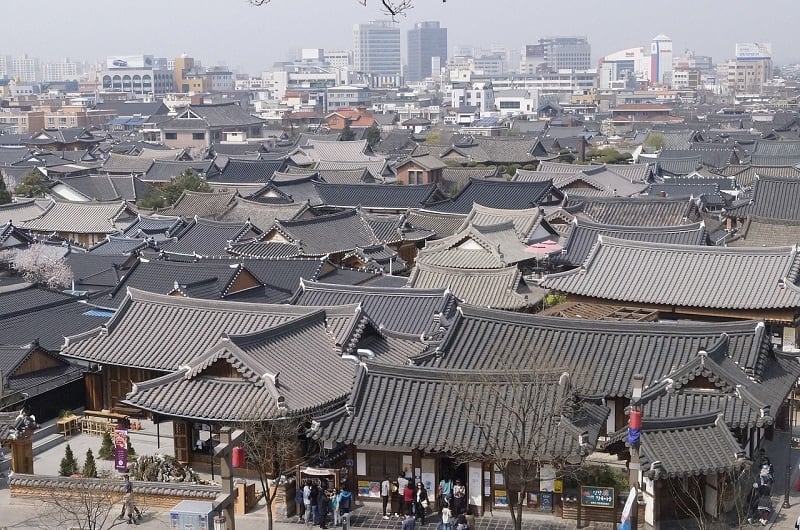
🧳 Budget For A Trip To South Korea
Of all the countries in East Asia, I'd argue that South Korea has become the most affordable to visit. There are many extremes to be found in the ROK (Republic Of Korea), a fact which extends to my daily life here over the last few years.
Visitors could stay in super cheap dorm beds booked way in advance for about ₩12000 ($10USD) a night, eat street food for another $10USD a day, and otherwise spend money only on transportation. I wouldn't recommend it, but it's doable.
On the other hand, Seoul is a massive city with plenty of hotels always ready to take your money. $500USD a night hotel rooms aren't the norm, but they're there. The key is to find a balance, and if you're looking to travel Korea on a budget, then make a list of priorities.
Do you most want a nice place to sleep? Fancy meals? Involved day trips? Budget travel in Korea is 100% possible, but it takes planning. So here's a rundown of the costs of traveling in Korea.
Note that this South Korea travel guide covers such a wide range of days that the budget below is a snapshot of how much you could spend in one day. My dad would call them "guesstimates." It also covers the cost of basic activities which most everyone would do. Remember to multiply this Korea travel budget by the number of days you'll be visiting us for!
ESTIMATED COSTS:
- Visa Fee : ₩30000 (to check if you need a visa, click here )
- Day Tours : ₩70000 (some day tours cost more, but these kids of trips include visiting the DMZ , Nami Island, and Jeju tours)
- * Each Trip To A New City : ~₩30000 (one way; this is an average)
- * Round Trip Airfare to Jeju : ₩80000 (if booked well in advance)
Decent Guesthouse : ₩25000
Meals & Snacks : ₩20000
Attractions & Activities : ₩10000
Transportation : ₩5000 (4 trips on the subway or bus)
Souvenirs & Cafes : ₩5000 (coffee or tea)
Average Cost Per Day : ₩ 65000
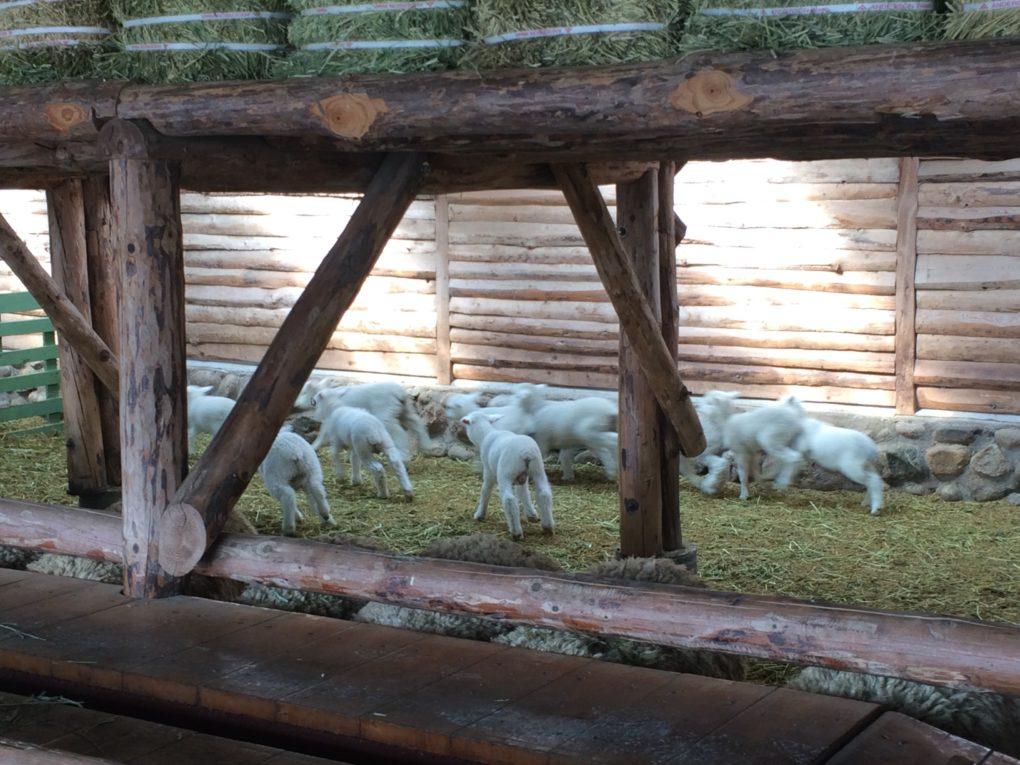
🚈 South Korea Travel Tips
- Metros aren't very accessible but the buses and taxis are. So if you're in a hurry or disabled, then you should take a taxi. They're very cheap and fast, though during rush hour they'll take as long as the metro. Most shops (like Korean chocolate shops ) are clustered right around metro stations anyway, so even if your driver doesn't speak much English you can tell them the name of the metro station closest to where you're going.
- Korean winters are not for the faint of heart . My friends from Vietnam visited me last winter and spent their first day alone— they were shivering for hours after we came inside. Even my sister was not very happy with all the snow over New Year's when she visited a few years ago. It can get brutal, thanks to winds coming down from Siberia.
- Also not for the faint of heart, entitled old people . They will push you, publicly and without shame if they think you're in their way. I understand that they act this way because they don't think young people respect their elders like they should, and they don't, in my opinion. But no matter how you think, it is something to be aware of.
- Korea is basically a cashless society , except for in the markets. This means that you can use your credit card most everywhere, but international cards aren't always accepted, so still keep some cash on hand.
- Along similar lines, in Korea you should expect late nights and late mornings . Cafes, restaurants, and shops are open very late, usually between 10pm and midnight, but rarely open before 11am. If you want morning coffee if Korea you'll have to either be at the airport or grab canned coffee from a convenience store.
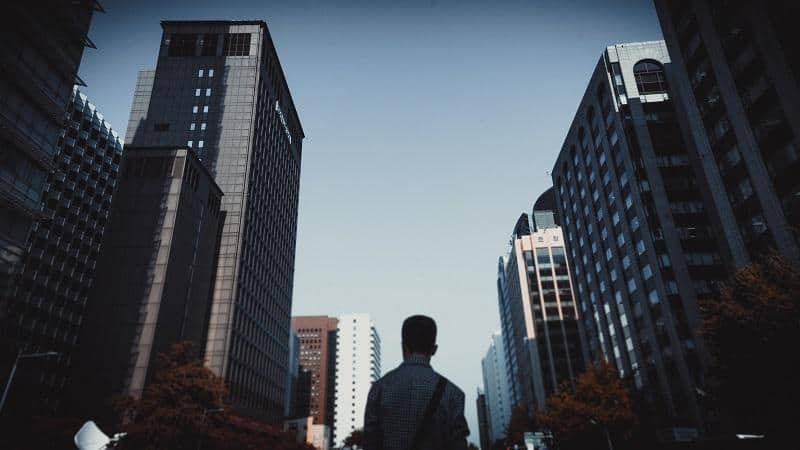
- Even though it's a more developed country, Korea has their share of travel scams. One of the most common is the fortune teller scam , in which a woman stops you on the street and offers to take you to have traditional experiences, only to scam you out of money. Either way, if someone stops you on the street, 95% of the time they want your money or to convert you. NYC rules apply.
- Pollution is horrible. Sometimes the skies aren't as bad, but spring 2018 and winter 2019 were particularly harsh, with many days seeing pollution levels as high in Seoul as in Beijing, China. Bring a mask, or buy one, especially if spending 2 weeks in South Korea, or longer.
- Naver Maps will tell you which door of the subway you should go to for the faster arrival at your next destination.
- If you're a bigger person , look for handicap-accessible or family bathrooms, as Korean public bathroom stalls are made for small people, especially the women's bathrooms.
- Look up . If you're looking for an office or guesthouse or restaurant, and you'd swear you're at the right address, just look up. It's probably just on a much higher floor, like the 11th or 32nd.
- However, when you do look up, don't make eye contact unless you want to start a conversation or get stared at as you walk away (though that might happen anyway, in the countryside).
- Hospitals are for everything , even if you're a visitor taking various South Korea tours and end up with a cold. The hospital is like the doctor's office, and in small towns like mine, they're open 9 to 5 like everything else.
- Always count to 5 before crossing the street , because without fail, at least once a week I watch someone go after the light turns red, be it a car or a motorbike. Better safe than sorry.
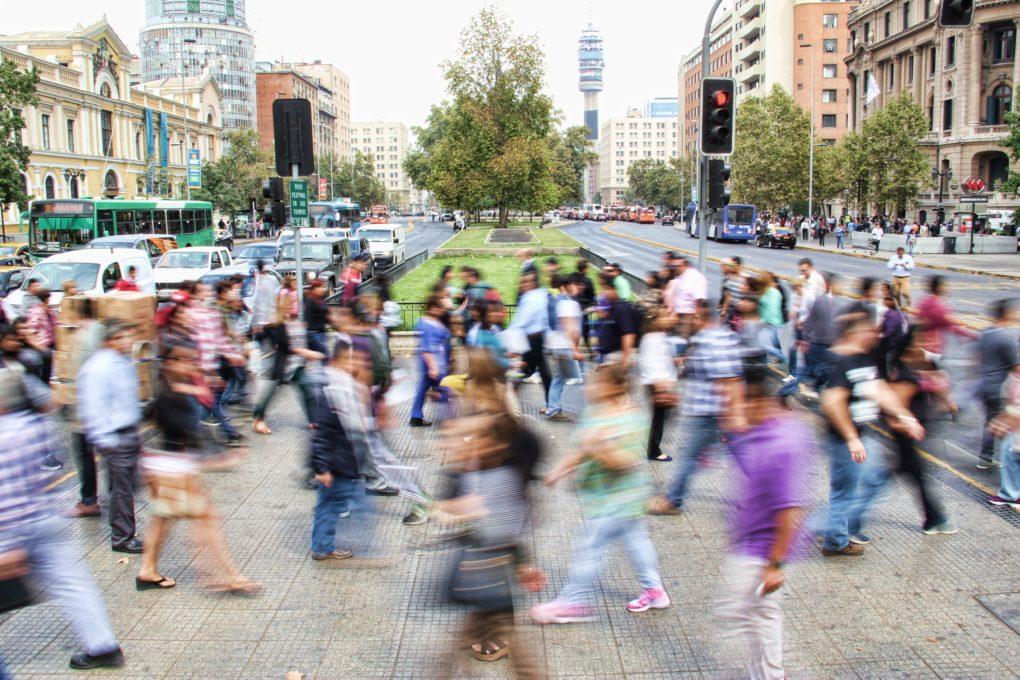
☺️ Basic Phrases For Your Trip to Korea
Hello // An-nyeong-ha-se-yo . (안녕하세요.)
Thank you // Gam-saahm-ni-da . (감사합니다.)
How much is it? // Eegaw eol-ma-yeh-yo? (이거 얼마예요?)
Do you speak English? // Yeong-aw jal-hae-yo? (영어 잘해요?)
I don’t speak any Korean. // Han-guk-aw jal-moat-hae-yo. (한국어 잘못해요.)
One of these, please. // Ee-gaw ha-na ju-say-yo. (이거 하나 주세요.)
It’s to-go/takeout. // Po-jahng ee-eh-yo or Tae-ee-kow-shi-yay-oh. (포장 이예요.)
Lesson complete! Now let’s get packing.
Did this post help you plan your trip to Korea? Save it on Pinterest so that it can help others, too!
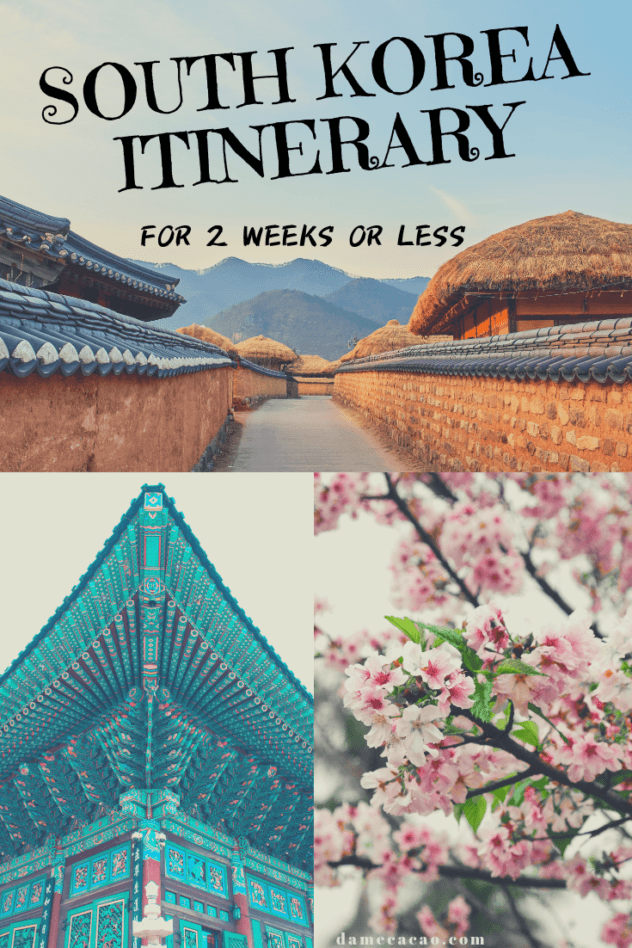
More South Korea Travel and Life

Reader Interactions
Happy Travelers
January 13, 2024 at 4:42 pm
Thanks for creating a 14 day with Jeonju! We will be in Korea feb 7-21 and obviously plan on seoul, busan, and jeju. We really wanted to hit Jeonju but was reading about doing a drive from seoul east and then south to hit Chuncheon, Sokcho, Gangneung, Samcheok, Andong, Gyeongju, Seokguram and skipping Jeonju.
I was wondering since we will be there in the Winter, which would you recommend the Jeonju plan or the east plan?
January 14, 2024 at 2:46 pm
Thank you for the kind words! At that time of year, you'd be better off giving Jeonju a visit since the warm weather that would make the east coast drive so pleasant & beautiful would be nonexistent right then. You'll also be overlapping with Seollal, or the Lunar New Year (weekend of Feb 10), with those dates, so renting a car may be a bit harder and traffic will be CRAZY heading out of the city all weekend (everyone is taking their fmailies back to the countryside to see parents/extended family). However it will be just one weekend out of two, so I recommend you just plan around that, and definitely give Jeonju a few days!
August 18, 2023 at 4:02 am
Thank you for your post. I wonder how to use 'Kakao talk' app during travel in Korea. Is there any way to use it?
August 20, 2023 at 5:55 pm
My pleasure, Kim! You can download Kakao Talk before your trip, but since it's connected to your phone number, if you need to get a local sim card in Korea, you'll just need to make a temporary new account for use in Korea. So unless you'll use your phone's regular sim card while in Korea, I recommend waiting until you're IN Korea to make your account for use during travel in Korea. Then you can use it to communicate with taxi drivers, food delivery, Air BnB hosts, local friends, etc.
August 07, 2023 at 6:14 am
Thanks for your great posts! I used this one (and a few others including the Seoul and Jeju one) to help me when I went to South Korea for two weeks. I read a few blogs on the internet, but your style and interests most closely matched me. Hope you are doing well one your new adventures 🙂
August 10, 2023 at 9:26 am
Thank you for the kind words, Kim! I'm glad you've found it all helpful. 😀
August 04, 2023 at 5:48 am
Hi, we are going to prepare a tour with golfers to Korea and beside of golf your information are very helpful. Do you live in Korea and work as DMC?
August 04, 2023 at 1:36 pm
That sounds like a very fun tour indeed, but unfortunately I don't like in Korea anymore, nor have I ever worked as a DMC. But good luck with your search, and enjoy your trip!
June 13, 2023 at 11:05 pm
What a great post! Thanks for sharing. We are planning to come from June 29th to 9th July. What do you think about the weather? Can we come now or delay due to rain and heat? Also, in Seoul what is a good location for a family stay - Four Seasons and something in Gangham?
June 14, 2023 at 12:40 am
My pleasure, VK! And since it's monsoon season, it's honestly pretty unpredictable as to which days might be nice, but with such a long stretch of time, you're bound to get some good weather days and maybe a bit of rain. I have a post covering 100+ things to do in Seoul , so I recommend looking through that and over the map on the bottom to note some things that look interesting & rain-proof, as well as some options for stuff close to where you choose to stay.
Speaking of, the Four Seasons is lovely, but I was also incredible impressed with VOCO Hotel in Gangnam . It's an affordable IHG property a block or two from the metro, and I felt like royalty for much cheaper than the Four Seasons (like 1/3 of the price)! But it's always worth comparing the two side-by-side, as the Four Seasons would offer slightly different amenities and is in an arguably more central tourist location. Either way, summertime will be warm in Seoul, but everythng is open and tends to have longer hours due to the increase in domestic tourism.
Enjoy your trip!
June 14, 2023 at 8:34 am
@Max, Thank you so much for your kind response and the details provided. I am planning to do 4 nights in Seoul, 2 nights in Busan, and 4 nights in Jeju. Is that plan correct? Given a choice you would me to skip summer and rain and come later or it is still okay to come from 27th June - 7th July? As we don't to come and spoil the trip - I hope you understand :).
The Hotel option you gave is great. I will definitely have a look. Is it better to stay in Gangnam or the area where the Four Seasons are? I know I am asking too much but if you have any recommendations for Busan and Jeju as well - would love to take your feedback.
Thanks so much again.
Regards, VK
June 14, 2023 at 5:24 pm
That's how I'd plan it out! And honestly, you can't predict the weather well enough to say whether it will rain half the days or just one or none. It can be rainy from June to September, and it gets quite cold after that, so sometimes you just have to roll the dice. If given the option, summer would be my pick over winter, but even if I knew the other times you'd be able to go, we'd still be in the same predicament about not being able to know for sure how the weather will be.
If the price difference doesn't matter as much, the Four Seasons would be my pick for a first-time visit, because it's truly in the middle of the touristy area with a large chunk of the museums, hanok (traditional) houses, souvenir shopping, royal palaces, and a ton of restaurants with great Korean food and mostly translated menus. Voco (and Gangnam as a whole) is about a half hour metro ride from that area, and while it's great for fancy shopping, visiting Lotte Tower, and some fabulous meals (if you eat beef then definitely try hanu , or Korean domestic beef, while you're there), it has a few tourist-friendly museums and not so much else. But what you save in staying there would more than pay for taxis all throughout the city! So each has their pros, and you should pick the one that's right for your preferences.
As for the other two, I spent many hours compiling accommodation guides for both Busan and Jeju Island , and you can read about the various neighborhoods/parts of the island in each, and make the best pick for each based on what you plan to do there. Again, since I'm not sure what attractions you're most interested in, I do think it would make more sense for you to look through those for the best picks for you personally, rather than booking only based on my recommendation. And if you do still have more questions after reading through those two posts, just leave another comment and I'd be happy to answer them there.
I never mind answering questions, as frustratingly few bloggers seem to still do so. But if you've found any of the info helpful, I always appreciate it if you book through my affiliate links. I specifically work with Agoda for hotels because I've always found that they have the best prices on accommodation throughout Asia, and always throughout Korea. But if you don't, no big deal; just wanted to mention it as a free way to say 'thanks'! 🙂
June 14, 2023 at 10:02 pm
@Max, Thank you so much for your kind help and answering questions. This really helps a lot. I will definitely use the affiliate links:)
Susan Hughes
February 25, 2024 at 11:01 am
My husband, oldest daughter, possibly a friend of hers and I will be in South Korea, leaving DFW the 9th (not getting there till the 10th at 3:15)-and returning the 20th at 5:25. Trying to come up with a tentative itinerary so we can experience the most of our time there. Seoul, Busan and Jeju Island are my top places to visit. I’m a Korean adoptee and would like to visit an orphanage. If you have information about Holt orphanage that would be wonderful. I was adopted in 1973 which the orphanage was called Livingstone but changed to Holt. Trying to determine if we should stay around Seoul when we get there or when a few days before we head back home. I’m realizing I should have booked 2 weeks which a friend who is living there for a year suggested but i compromised with 10 days. Would love to hear what advice you have to give. I’m just starting to do research so any info other than what you have said in your post would be much appreciated. Wish you were there when we are to be our travel guide😂Looking forward to hearing back from you!
February 28, 2024 at 1:14 am
Hi, Susan! That sounds like a wonderful experience you have planned. I'm sorry I don't know anything about Holt, but I also did my best to include every little detail about visiting in this post - it's over ten thousand words! However, when planning timing, I'd say to know your limits. If you're flying direct from Dallas and know you'd be up for another short domestic flight that would get you to Jeju by 7pm or 8pm, then I'd say to go directly to Jeju, because getting into Seoul formt he airport in Incheon take about 2 hours. It's a trek, and your time is better spent getting your sea legs, so to speak. From a few days in Jeju first, I'd fly from Jeju to Busan, then take the train from Busan to Seoul and leave form there. Lots of options depending on your particular interests!
Leave a Reply Cancel reply
Your email address will not be published. Required fields are marked *
This site uses Akismet to reduce spam. Learn how your comment data is processed .

- Visa Application Helpline
Subscribe to our newsletter
Learn how to live a sustainable long-term travel lifestyle.
By signing up, you agree to the our terms and our Privacy Policy agreement.
Top 27 Places to visit in Darjeeling, Explore the Beautiful Hills of Darjeeling
Top 10 things to do when traveling to shimla: shimla travel guide, the ultimate paris travel guidelines for first timers | top attractions & things to do.

The Best 10-Day South Korea Itinerary: Budget and how to plan
If you’re looking for a travel destination that offers a rich cultural experience and a glimpse into history, South Korea is the perfect choice. Despite its small size, this country is packed with diverse attractions and a unique charm that will captivate any traveler.
Whether you’re interested in exploring ancient palaces, indulging in delicious street food, or immersing yourself in the vibrant K-pop culture, South Korea has something for everyone. With this ultimate 10-day South Korea itinerary , you’ll be able to make the most of your time in this fascinating country.
South Korea will give you the perfect opportunity to create a storming itinerary to explore the bustling cities quiet mountains and countryside. South Korea has a synchronized harmony of traditional culture and modern history.
Tourists can enjoy the cultural heritage through the UNESCO sites and can enjoy the variety of food, local culture, and lifestyles. Along with Korea’s Buddhist temples, and UNESCO sites you will find beautiful mountains, hiking trails, and port cities will let you experience the full range of diversity in the country.
Planning a Trip to Korea Preparations
Though you cannot plan to see all there is in 10 days you surely can have the most rejuvenating experience. Planning a trip to Korean districts and there are many cultural sites. Before flying to Korea, it will require that you have ETA (Electronic Travel Authorization) for Korea.
You can apply online on their website and when granted you will be eligible to live in the country for 30 to 90 days. You will also require a valid passport, accommodation, and permit if you were to travel across the country. The required travel duration for most travelers are 10 to 15 days. And it is always recommended to get started on your preparation one or two months ahead.
Documents Required for Visiting South Korea:
- Valid Passport & Visa
- K-ETA (Electronic Travel Authorization) For citizens of Selected Countries
- Cash for Currency Exchange
To have a hassle-free trip to South Korea there are few more things you can do to prepare. Few of them are using a language translator app, using specialized local maps, downloading cab app, and getting cashless money transfer systems. Here are the top apps for planning South Korea itinerary 10-days you can use to make your journey easy.
10-Day South Korea Itinerary: Provinces, Day to Day
You must start your visit from the capital of South Korea, Seou l and you will get to learn the royal history, Korean cuisine. Then on 3rd Day, you can travel to Suwon to watch the folk village and enjoy the folk village view. Then continue your journey to the South and move to Andong where you will find the beautiful Hahoe folk village, and you should visit the Soju Museum, Bongjeongsa Temple.
After spending a few days in Andong, it’s time to visit the cultural and Spiritual heart of Korea, Gyeongju. Visit the attractions like Tumuli Park, Bulguksa Temple, and more. Then for the last days of your trip, you will travel to the bustling fishy port city of Busan where you can roam around the fish markets and taste heavenly fish or go on a fish-catching trip. With this itinerary, you will be able to see the most remarkable culture and attractions of Korea.
Seoul: 2 Days
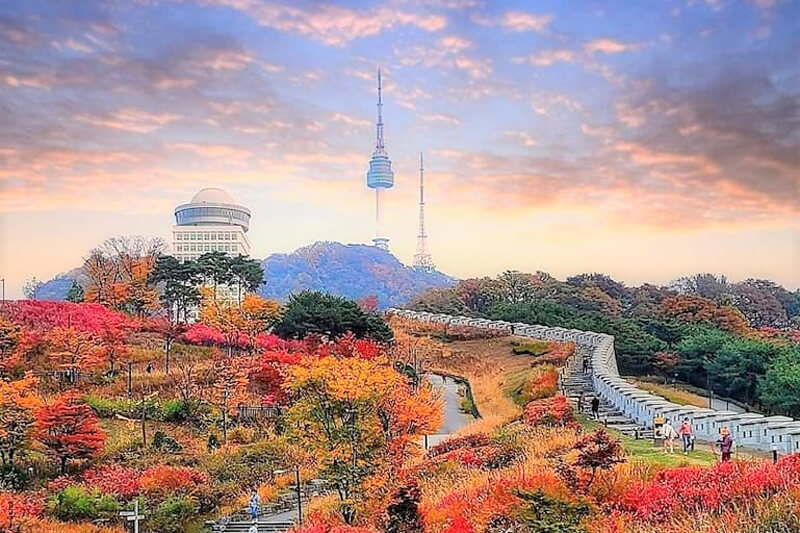
Seoul offering a modern yet traditional lifestyle should be the first place in your south Korea itinerary for 10-days. The Seoul trip for two days will be your first step in familiarizing yourself with the city’s cultural, historical, and traditional sides. Take the first day slow and visit the royal palaces and UNESCO sites. You can start your trip with Gyeongbokgung Palace, and then continue to visit Cheonggyecheon Stream, Gwangju Traditional Market, and Insadong Shopping Street.
Gyeongbokgung is one of the most popular and oldest palaces in Seoul . This served as the main official palace during the Joseon dynasty. The entrance fee to the palace is $2.50 and you can also rent hanboks if you want great pictures in the traditional dresses. After the tour head over to the Cheonggyecheon Stream where you can enjoy a nice walk and enjoy the art murals, greenery, and scenic beauty.
Make your way to Gwangju Market, where you will be enjoying a whole array of foods. Some of the famous foods there as one of the oldest markets in Seoul are bindaetteok, mandu-guk, and bibimbap. From there you can go to visit the traditional Bunchon Hanok village.
For Day 2 in Seoul , start your day with a delicious breakfast in Hongdae. Hongdae is a vibrant area where young people hang out and Hongdae shopping street is also a great area to hang out. From there you can go to museums of the city and during the sunset hike up the N Seoul tower where you will enjoy the beautiful city’s nighttime landscape view. You can also have an amazing dinner on the restaurants of N Seoul tower.
Day 3: Trip to DMZ
The DMZ tour from Seoul takes a whole day. You must keep aside a one-full day for this historic area. You can only have guided tours of the DMZ area. The Demilitarized Zone portrays the rich history of the Korean Wars. The DMZ tour packages are available from $25. Visit the freedom bridge, DMZ exhibition hall, and other monuments. You will get a brief recap of the historical moments throughout the trip to DMZ.
Day 4 & Day 5: 2 Days in Andong
By Korean standards, it’s a long journey between Seoul and Gyeongju . For this itinerary, there’s no better place to break up the trip than Andong. Long known for its traditionalism, Andong is a center of culture and folklore. It’s one of the best places to visit in South Korea for a glimpse of its ancient past.
For Day 1: Explore the impressive grounds of the historic Neo-Confucian Academy with a trip to the historic Dosan Seowon and for Day 2: Admire a stunning view of the surrounding natural landscapes from the top of the Buyongdae Observatory.
Also, the Woryeonggyo Bridge, a wooden footbridge crossing the Nakdong River, provides breathtaking views of the surrounding mountains and is a popular spot for photographers and nature enthusiasts.
Day 6: 1 Day in Gyeongju
No place during your 10 days in South Korea will live up to expectation better than Gyeongju. This fascinating city is nothing short of the cultural and spiritual heart of Korea. Gyeongju checks off all the boxes that drove you to visit South Korea in the first place.
Compared to the hubbub of Seoul and brash Busan, Gyeongju is a relaxing respite. And it’s as fulfilling as either. The top attractions in Gyeongju are spread far & wide. They encompass some of Korea’s finest cultural moments. Tumuli Park is one of the few Gyeongju tourist attractions smack dabs in the middle of town. The park is an ancient burial site. About two dozen Korean royal tombs sprout from the earth here.
Day 7 & Day 8: 2 Days in Jeju Do
Jeju is South Korea’s one of the most vibrant islands to experience beautiful braces, local markets, and more. On the first day arriving in Jeju, you can visit the Jeju Folklore and Natural Music and Halla Arboretum. And you can then visit the Jeju five-day folk market and Dongmun Traditional Market.
The next day you can catch the sunrise at Hallasan or at Sarabong Peak early in the morning. Then you can go visit the Hamdeok beach and Manjangul cave. There are a lot of places to explore in the south of Jeju-do and you will have a refreshing experience while travelling here.
Day 9: Busan
Busan is one of those take-it-or-leave-it places. Apparently, suggests that anyone should fall in love with, or even like, this brash Korean port city. And that’s usually where the story ends. When you are in Busan, don’t leave out the bustling J agalchi Fish Market.
It’s one of the city’s top cultural attractions, and an absolute must-see and must-do. This is not just the port city’s most significant market; it’s the biggest fish market in South Korea. All types of seafood caught around the Korean peninsula find their way to the market stalls of Jagalchi Fish Market .
With your trip coming to close soon, make time to fit one more temple into your Korea itinerary : Beomeosa Temple. This ancient temple is Busan’s top tourist attraction. The original temple was founded in AD 678 by Ui Sang, a monk in the Jogye Order of Korean Buddhism. It has since been rebuilt multiple times. Most of the current buildings hail from the 16th and 17th centuries.
From stone pagodas to ornate wooden gates, the beauty of the city entrances you. The temple also benefits from a spectacular location. It sits at the foot of Mount Geumjeongsan. Visiting Beomeosa Temple, it’s easy to forget you’re in Korea’s second-biggest city.
Day 10: Departure
On Day 10 return to Seoul, and get your things packed. On the last day you can visit some famous places in Seoul or have a last traditional meal of Korean cuisine. You will have a lot of memories and an experience of Korean culture by the time you live.
Most Popular Tourist Attractions in South Korea
There are a lot of beautiful places across South Korea where you can experience a diversity of landscapes, culture and food. Taking a trip to South Korea is a phenomenal way to experience the joys of life. Here are the top few tourist attractions and landmarks of South Korea that any first-time traveler must cover.
DMZ is a zone between South Korea and North Korea near the 38th parallel north. And the demilitarized zone is a walk through the history for tourists where you can understand the value of the war history of the country. This area works as a buffer zone between two countries and is a place for maintaining political peace.
Changdeokgung Palace:
One of the most popular UNESCO sites in Seoul is the Changdeokgung Palace. Changdeokng Palace is an official residential building built in the Joseon dynasty. This complex was built as a secondary palace from Gyeongbokgung Palace to have the administrative work done.
Gyeongbokgung Palace:
The Gyeongbokgung palace is a South Korean first palaces for administrative work. It was built in 1935 in Hanyang, currently the heart of Seoul. This is quite famous for taking pictures in hanbok, traditional korean dress and visiting the historical settings, and artefacts. At the entrance, you will also find the historical Gwanghwamun gate located at the three-way intersection.
Hwaseong Fortress:
Hwaseong fortress is a one-of-a-kind brick and pilestone fortress made in Joseon dynasty. It’s located in the centre of Suwon, a few kms away from Seoul. It was built by King Jeongjo to honour his father, Prince Sado.
Namsan Tower:
Namsan tower located in Seoul is an observatory tower on the highest hill in Yongsan-gu district of Seoul. It gives undeniably the best view in the city and is worth a visit. The lovelocks there for couples are also quite famous. You can also enjoy the views from the cafe or the restaurant on the N Seoul tower.
Lotte World:
Lotte World is a major theme park in Seoul with indoor and outdoor rides, shows and parades, and an aquarium. If you have come here with children, taking a day to go to Lotte world will really make the trip a lot of fun. The aquariums, ice rink and parades are a true treat to kids.
Jeju Island:
Jeju Island is one of the most peaceful and pleasant natural spaces that you can visit. It is one of the most beautiful volcanic islands on the planet Earth. Top attractions in Jeju-do are the lava tunnels, Hallasan, Cheonjiyon waterfall, and the hiking trails.
Nami Island:
Nami Island has gained popularity as a scenic and romantic spot, and you can go there to enjoy cherry blossoms and the tree-lined pathways are quite romantic during Autumn and Spring. You can also enjoy different types of activities like cycling, zip lining and boating in Han River.
Traditional Villages:
There are a beautiful Korean village like Bukchon Hanok, Yongin-si in Seoul where you can get roam around the beautiful streets, visit artisans and traditional arts.If you travel to Andong during your trip, you must visit Andong folk village to visit the Andong folk museum, thatched house. You can also visit the Jeonju-si for old shrines, Boseon-gun in South Jeolla province for the entrancing beauty.
Dodohaehaesang National Park:
Dodohaehaesang National Park is the largest natural park in South Korea and if you are a nature lover you will have a great time as there are 1500+ plant species and 1200+ animal species. The scenic beauty of the island the park is located on is all the is also an attraction.
National Museum of Korea:
National Museum of Korea has collections of Korean traditional products, and you will find a lot of art exhibitions going on every day worth visiting. You will see the collection of art, artifacts, and crafts from Korean and international artists at the National Museum.
South Korea Food Markets
South Korea has a lot of vibrant food markets which are worth visiting for tasting local foods and get immersed in the local lifestyle. A few of the top South Korean food markets are Gwangjang Market, Namdaemun, and Dongdaemun Design Plaza in Seoul for tasting the most famous traditional foods. You may also visit the jagalchi fish market in Busan for fresh fish and seafood and tasty foods.
Budget for South Korea 10-Day Itinerary
Your travel tastes, style, and the time of year you intend to travel all affect how much money you allocate for a 10-day itinerary in South Korea. I can give you a general idea of the expenditures related to a traveler on a medium budget, though. Please be aware that these projections were created using pricing as of my September 2021 update and may have altered since then.
Accommodation: The price of lodging can change based on the area and the type of lodging you select (hotels, hostels, guesthouses, etc.). Budget travelers should budget $30 to $100 per night for a mid-range hotel or guesthouse, on average.
Food: There are numerous culinary alternatives available in South Korea at various pricing brackets. For roughly $5 to $15 each meal, budget-conscious travelers may savour delectable street food and regional cuisine. The price range for meals at mid-range restaurants could be between $15 and $30.
The public transit system in South Korea, which includes buses and subways, is good. Spend between $100 and $150 on transport over the course of ten days, which includes getting around cities and possibly taking the train to various locations.
Activities and Sightseeing: Different attractions and activities have different entrance prices. Budget, on average, $5 to $20 per attraction. You can budget between $100 and $150 for this category if you’re going to numerous paid attractions.
Shopping and souvenirs: Depending on your shopping tastes, this expenditure can vary greatly. Budget travelers should set up $100 to $200 for shopping and souvenirs.
Other: It’s a good idea to have some extra cash on hand for unanticipated costs like tips, extra snacks or drinks, or any emergency requirements. Set aside between $100 and $200 for other costs.
Without factoring in international flights to and from South Korea, a ballpark estimate for a 10-day moderately priced vacation in South Korea could vary from $800 to $1,000. Remember that this is only a rough estimate, and that the actual cost of the trip may change depending on your choices. It is advised to conduct detailed pricing and expense research for your planned route and travel duration in order to obtain a more precise budget.
Related Posts
The best maldives itinerary: cost-breakdown of maldives vacation packages (4 to 7 days), new zealand itinerary & tour packages to design the perfect vacation, macau trip itinerary: experience the perfect visit, the best 4-day hong kong itinerary: explore the city’s highlights.
Save my name, email, and website in this browser for the next time I comment.
This site uses Akismet to reduce spam. Learn how your comment data is processed .
Type above and press Enter to search. Press Esc to cancel.

4 Days Korea Itinerary: Top Things to Do, Best Places to Stay & More!

I love South Korea — I mean, who doesn’t? With its sumptuous Korean food , lovely cherry blossoms , and of course, my K-pop and K-drama idols (hello Park Hyung-sik, Kim Tae-hyung, Park Seo-joon, and Park Bo-gum), South Korea truly captured my heart and soul. For all you aspiring travellers, here’s my specially curated 4 days Korea itinerary covering Seoul, Busan, and Incheon. I’ve mapped out the top things to do and best places to stay in Korea to maximise your trip. Thank me later!
How to get to South Korea
Direct flights to Korea are available from Southeast Asia’s main air hubs including Singapore, Kuala Lumpur (Malaysia), Bangkok (Thailand), Jakarta (Indonesia), and Manila (Philippines), to name a few. Most travellers fly to Incheon International Airport, the largest and busiest airport serving Seoul. Others also opt to start their Korean journey in Busan via Gimhae International Airport before exploring Seoul and the rest of South Korea.
From Incheon Airport, you can get to Seoul by taking the Airport Express Railroad (AREX), airport limousine bus, or taxi. Read this quick guide to getting from Incheon Airport to Seoul .
Day 1: Seoul city exploration
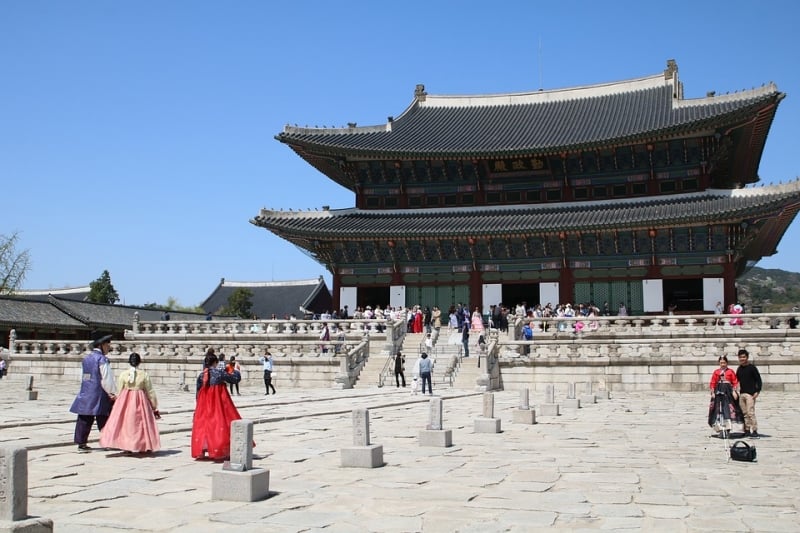
Top things to do in Seoul
There’s an endless array of exciting things to do in Seoul . Start your early morning city exploration at Bukchon Hanok Village . Strolling around this traditional village will make you feel like you’re part of the Joseon Dynasty, a Korean dynastic kingdom that lasted for about five centuries (1392 to 1897). Before 10am, make sure you have already reached Gyeongbokgung Palace to witness the changing of the guards ceremony. It only happens every 10am and 2pm daily except Tuesdays, so don’t miss it like I did!
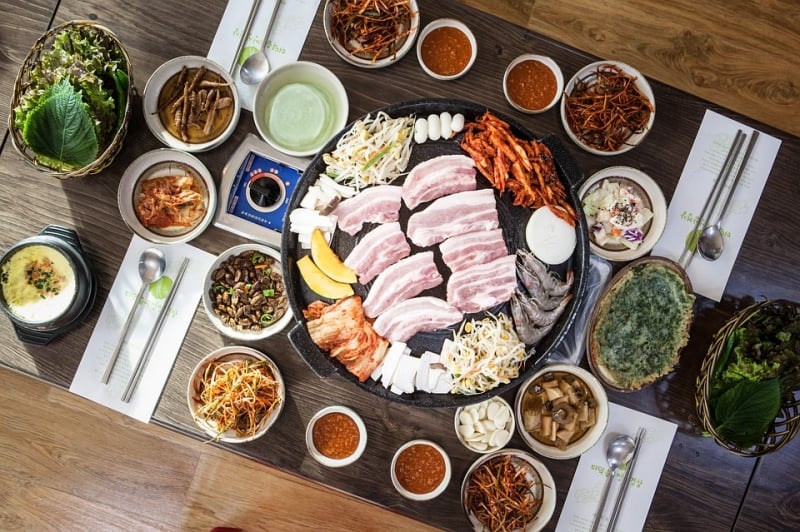
By noon, chow down on your favourite Korean food such as samgyeopsal , bibimbap , kimbap , and kimchi . If you are on a budget, take your pick from these cheap eats in Seoul , which cost ₩5,000 or less! And, if you want a more exciting Korean dining experience, eat a live octopus at Noryangjin Fish Market . Trust me, it’s not as nasty as you imagine it to be. In fact, I kind of liked it despite being a picky eater. Plus, it’ll be a good addition to your bragging rights, don’t you think?
In the afternoon, chill out in one of the hipster hangouts in Seoul to power up for your night market shopping spree. Some of the popular shopping places in Seoul are Myeongdong for skincare and cosmetics, Insadong for traditional Korean souvenirs, Dongdaemun for fashion and retail items, and Lotte Department Store (Main Branch) for Korean goodies.
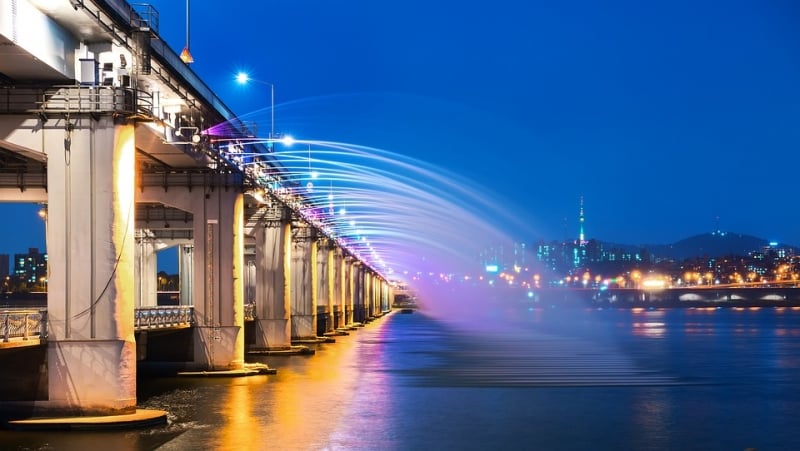
You are probably exhausted by now after all the day’s sightseeing and shopping. Have some downtime and enjoy the scenic views and lights by the Han River before snoozing off to your accommodation in Seoul.
Best places to stay in Seoul
Myeongdong and Gangnam may be popular places to stay in Seoul, but keep in mind that they are touristy and relatively more expensive, too. Consider staying in one of these underrated neighbourhoods in Seoul , or pick Insadong and Dongdaemun , where shopping places and cultural attractions like Gyeongbokgung Palace and Bukchon Hanok Village are nearby. Here are my top picks of the best accommodations worth adding in your 4 days Korea itinerary:
Ramada by Wyndham Seoul Dongdaemun for shopping & convenience
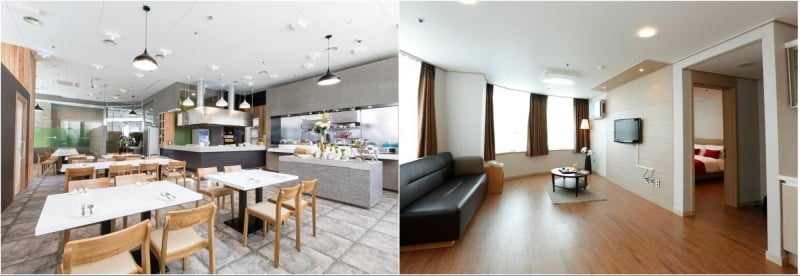
Whenever I pick an accommodation, I always favour a place that is located near modern conveniences and public transport. Ramada by Wyndham Seoul Dongdaemun is one that easily won me over because of its location. It is only about 5 to 10 minutes walk to the subway stations. Shopping places like Dongdaemun Fashion Town and Lotte Department Stores are also near. With its strategic location and modern facilities, you are guaranteed a value-for-money stay in Seoul.
Hotel Kuretakeso Insadong for a trendy stay in the heart of the city
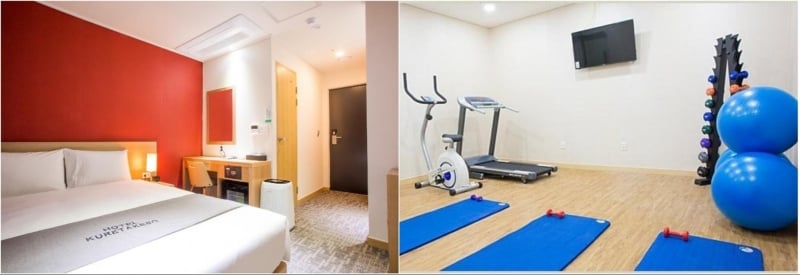
Hotel Kuretakeso Insadong is another highly rated hotel in Seoul because of its close proximity to restaurants and shopping districts like Insadong itself. On top of its chic rooms and modern facilities, this 3-star hotel also offers free breakfast and free sauna — something you don’t usually enjoy in most accommodations.
August hill Hanok for a traditional Korean home experience
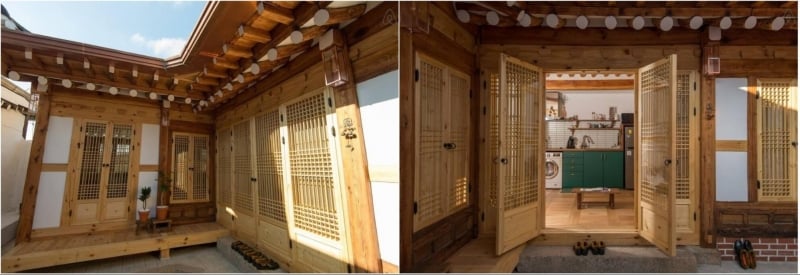
Fancy living in a hanok (traditional Korean house)? August hill Hanok will give you that one-of-a-kind experience at Bukchon Hanok Village. Built in 1923, this home was remodelled in 2018 to meet the needs of modern guests whilst taking in the old-world beauty of Korea. This hanok has two bedrooms and three beds that can fit up to five guests. There are cooking tools, tableware, washing machines, refrigerators, air conditioning, and free WiFi, too!
Day 2: Scenic tour around Nami Island
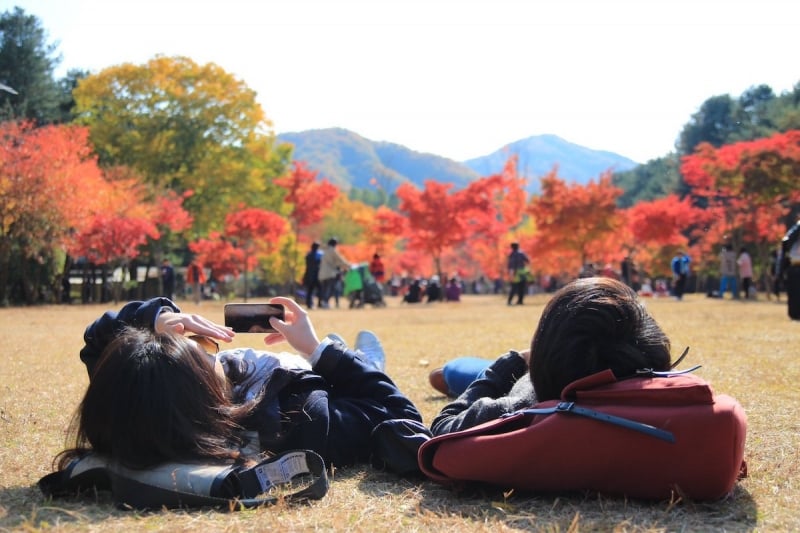
If you are a K-drama fanatic like me, it’s a MUST to visit Nami Island . After all, the classic Winter Sonata filmed their most romantic scenes here.
Also read: Travel Cheat Sheet: Recreate these 8 Cheesy K-Drama Scenes With Your Other Half in Korea
Top things to do in Nami Island
Aside from recreating the Winter Sonata scenes, other popular things to do in Nami Island include zip lining, taking Instagram-worthy shots at Metasequoia Lane, and biking along the lakeside.
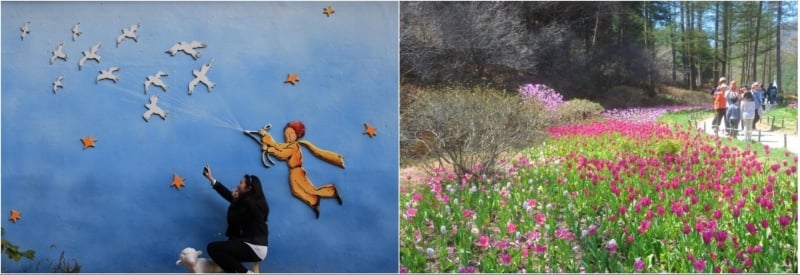
After Nami Island, go on a side trip to Petite France , Gapyeong Rail Bike , and Garden of Morning Calm . The shuttle that goes to Nami Island will also take you to these popular Korean tourist spots. Here’s a quick guide to Nami Island for more information. Nami Island is a famous day trip destination from Seoul so you don’t need to stay overnight in the area.
Day 3: Cultural immersion in Busan
Busan is an underrated Korean city that deserves a spot in your 4 days Korea itinerary. From Seoul, you can take the Korea Train eXpress (KTX) to Busan. Here’s a detailed guide on how to get from Seoul to Busan .
Top things to do in Busan
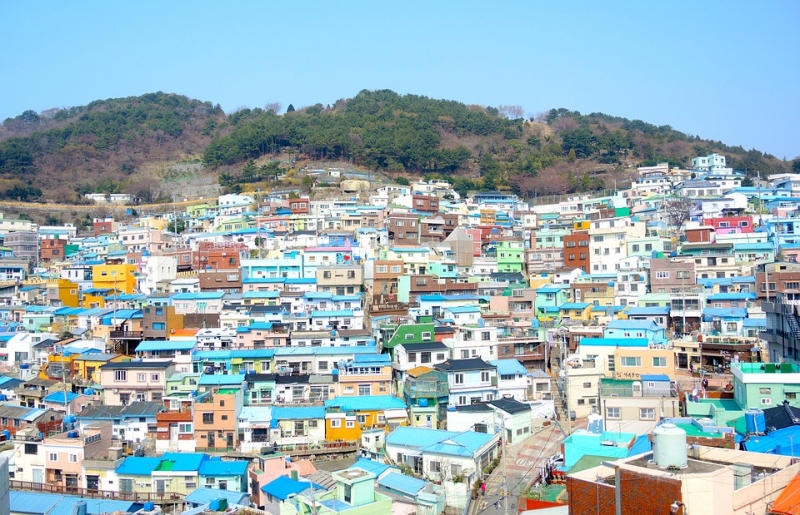
In the morning, go straight to Gamcheon Culture Village . This colourful village is truly a visual feast. As you sightsee and snap photos of the stunning murals and narrow alleyways, please observe silence and proper behaviour. Locals still live here, so let’s respect them.
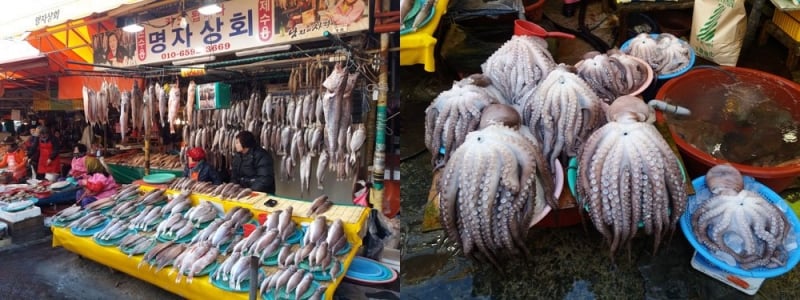
For lunch, go where the locals go — Jagalchi Market , the largest seafood market in Korea. You may buy fresh seafood from the wet market and have it cooked in one of the restaurants here.
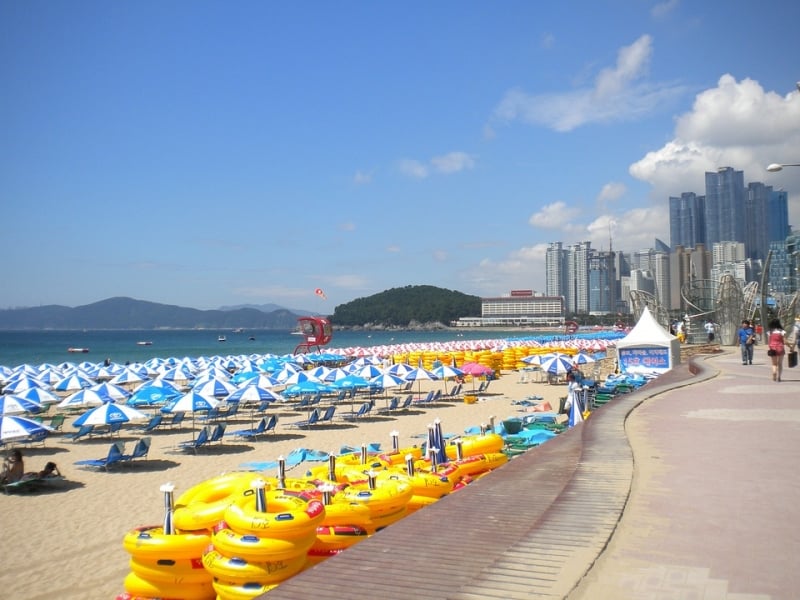
Spend the afternoon at Haedong Yonggungsa Temple , a unique Buddhist complex situated along Busan’s northeastern coast. Then, cap off your day at Haeundae Beach , one of Korea’s popular beaches where numerous festivals are held.
With so many things to do in Busan , a day trip here is simply not enough. I highly suggest that you extend your stay to fully soak up the culture and beauty of this coastal city.
Best places to stay in Busan
Busan is huge, and the best places to stay would depend on your travel interests. Stay in Haeundae if you like the beach, Busan Station if you want easy access to public transportation, and Nampo or Gwangbok to immerse in the local life. I’ve rounded up a few of the best Busan accommodations for your Korea itinerary:
Ramada Encore by Wyndham Haeundae for beach & nightlife

Busan is a coastal city, so why not stay near the beach? Ramada Encore by Wyndham Haeundae is a top-rated hotel near Haeundae Beach. It is also right beside Haeundae metro station and bus stop, so you are assured that you can easily explore Busan via public transport. Beach and public transport convenience? I’d give this hotel a thumbs up!
Busan Station Dino Hotel for convenience & city life
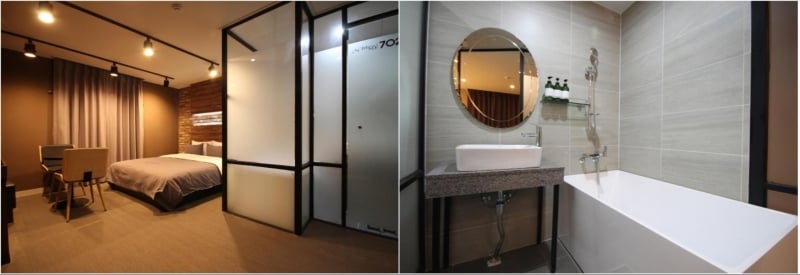
Pick Busan Station Dino Hotel if you want to stay in a central location close to Busan’s must-see tourist spots. In fact, the hotel name itself will already give you an idea that it’s a stone’s throw away from Busan Station. If you are looking for a convenient and comfy stay in Busan without blowing a hole in your wallet, this modern hotel will give you just that.
Gamcheon Stay Busan for a local home experience
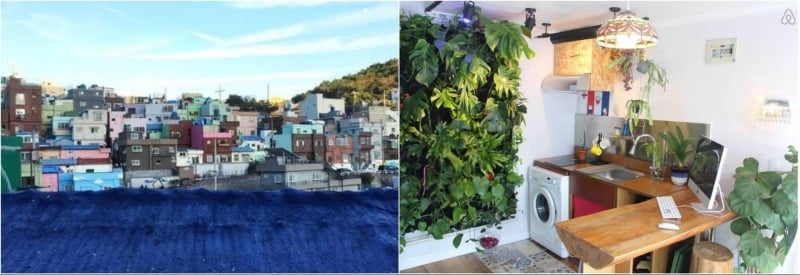
If you want to experience the laid-back local life in Busan, why not stay for a night or two at this remodelled private house in Gamcheon Culture Village ? It has all the modern amenities such as WiFi, kitchen, refrigerator, and a space for when you want to do some work. This charming guest house will definitely let you live like a local in a quaint Korean village.
Day 4: Back to Seoul and Incheon
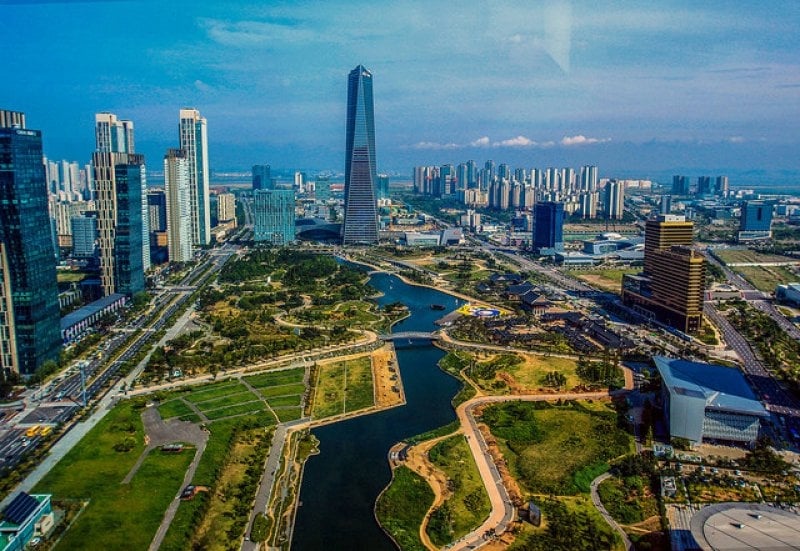
You should be back to Seoul by now for your last-minute Korean souvenir shopping . If not, proceed immediately to Incheon for a day of discovery. Did you know that Incheon also has a lot to offer than its famed airport? Incheon is worth adding in your 4 days Korea itinerary, too!
Top things to do in Incheon
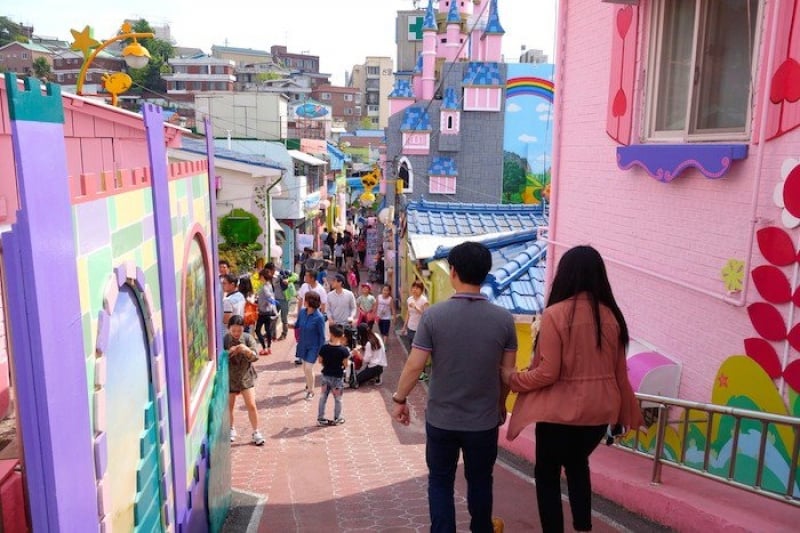
Begin your Incheon excursion at Songwol-dong Fairy Tale Village . This once decrepit village is now a top tourist attraction featuring your favourite fairy tale characters like Snow White, Beauty and the Beast, and so much more. This IG-worthy spot is just a train ride away from Incheon Airport so hit it up before your flight.
For the remaining hours, learn about jajangmyeon (black bean noodles) at Jajangmyeon Museum or stroll around Songdo Central Park . This park is like an open-air museum where you’ll find art sculptures scattered all over. And, the canal makes for a scenic place to unwind as you while away the hours. Feel free to tick the items off this list of top things to do in Incheon when you have more time to spare.
Also read: 7 Perfect One-Week Itineraries for Korea
I know, so many things to do in Korea, so little time! If you find this 4 days Korea itinerary too packed, feel free to adjust according to your interest and pace. As Korea’s tourism tagline says, “ Imagine Your Korea ”, so make it your own adventure of a lifetime. Happy trip!

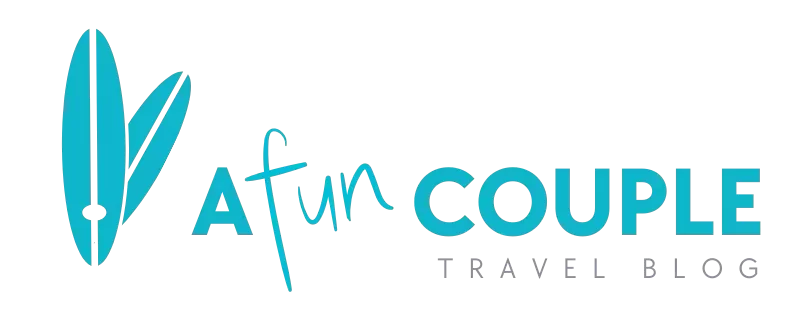
PLANNING YOUR TRIP TO SOUTH KOREA [ALL YOU NEED TO KNOW]
Planning a trip to South Korea? Wondering where to start? What to visit?
With its many places to see, delicious food, and unique atmosphere, South Korea is a great country to discover and explore.
We lived in South Korea for 3 years and explored this country restlessly and discovered places not well known to tourists. We wrote over 100 posts about Korea, you can check them all out here .
If you have chosen to go on a trip to South Korea, you must be super excited to discover the country of K-Pop, K-Drama, Kimchi, Soju and so much more!
However, organizing this trip may seem complicated if you’ve never been to South Korea. That’s why we’ve created this guide to help you plan a trip to South Korea!
Enjoy your travel to South Korea!
READ: 99 Best things to Visit in South Korea
FULL GUIDE TO HELP YOU PLAN YOUR TRIP TO KOREA

Key Takeaways
– Best Time to Visit : South Korea experiences four distinct seasons, each offering unique attractions. – Visa Requirements : Ensure your passport is valid for at least six months check if you are eligible for visa-free entry. – Currency and Payments : The South Korean currency is the Won (KRW). While credit cards are widely accepted in cities and tourist areas, it’s advisable to carry some cash. – Getting Around : South Korea has an excellent public transportation system. The Korea Rail Pass (KORAIL) is a cost-effective option for visiting the country. – Language Barrier : While English is taught in schools and widely used in tourist areas, not everyone is fluent. – Connectivity : South Korea is one of the most technologically advanced countries, with high-speed internet and excellent mobile connectivity.
Why travel to South Korea
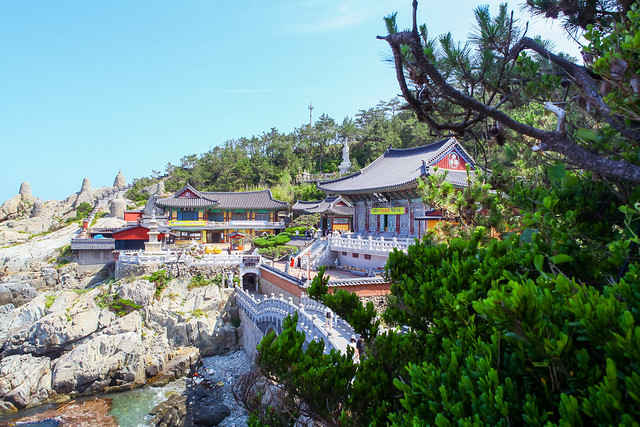
South Korea is a country that is gaining massive popularity due to the recent development of K-Pop such as the band BTS, and K-drama, it’s known for having some of the best food in Asia, and Seoul and Busan are vibrant cities making a big name for themselves.
However, South Korea’s history and culture have shaped the country and left lots of treasures such as palaces , temples (like Jingwansa ), and gorgeous villages such as Jeonju .
You will therefore have a wide choice of things to do in South Korea .
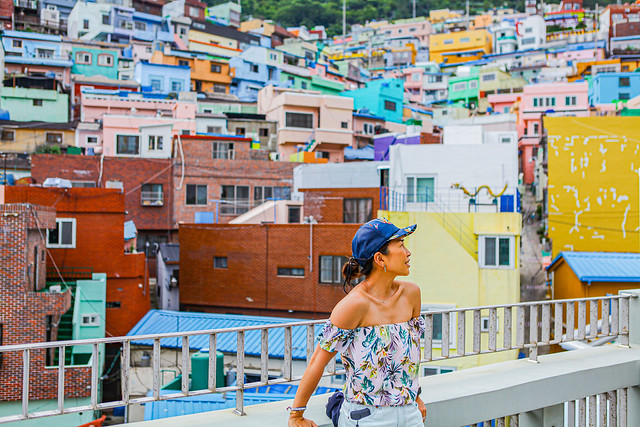
In addition, South Korea is a country with superb natural landscapes. Mountains (such as Bukhansan mountain), beaches (for example in Gangneung), rice fields (in Namhae), Green Tea Plantation (in Boseong), or beautiful islands such as Jeju …
Finally, this trip to South Korea is also an opportunity to discover Korean cuisine. Check our Namdaemun Market in Seoul, the biggest market in the country as well as Jaglachi Market the largest fish market in Korea located in Busan .
In general, a trip to South Korea is quite simply a unique experience and will have many surprises for you!
When is the best time to travel to South Korea?
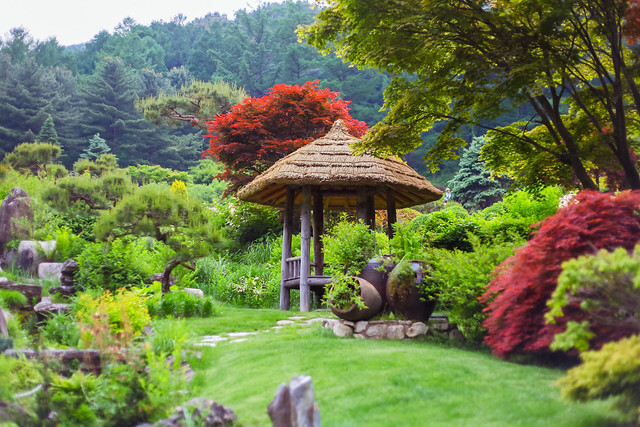
We hope that you are even more excited about your trip to South Korea now that you read the first part of this post.
You must also wonder when should you go to South Korea. To enjoy your trip to the fullest, we recommend traveling during Spring and Fall. These are the seasons when the temperatures are the most pleasant and when rainfall is at the lowest.
In addition, in spring you can admire the cherry blossoms and in autumn you can observe the change of leaves color to majestic red, orange, and yellow colors. Autumn is indeed our favorite season in South Korea.
It is also possible to visit South Korea in summer and winter. You just have to take into account the rather extreme temperature.
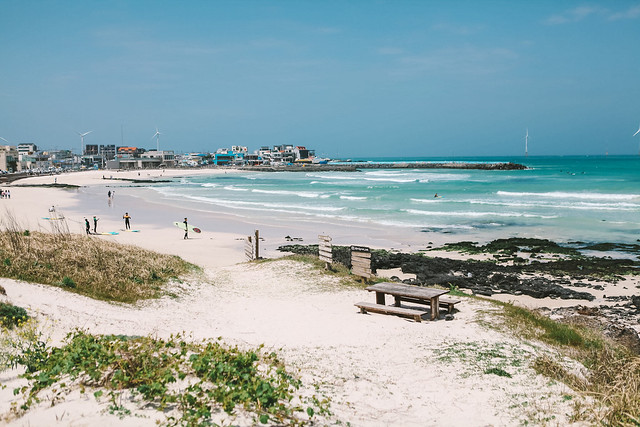
The summer is very hot and the humidity is higher than the other seasons. In addition, there is a monsoon period (called Jangma / 장마). This rainy season lasts from late June to mid-July in South Korea. n winter the temperatures drop a lot and it can get very cold.
Here you can check out the best activities during Summer in South Korea and the best 25 beaches if you need some refreshment during your trip.
If you travel there in the Winter and you are a winter sports enthusiast, check out the full guide here with the best ski resorts in South Korea.
For a detailed weather report month by month, you can check out our full guide here . Keep this in mind when planning a trip to South Korea.
How many days to visit South Korea
When planning your trip to South Korea, it is important to decide how long you will be staying. We recommend staying 10 to 15 days to see most of the main sights in Korea.
Since the flights to Korea can be quite expensive, make the most of your trip buy staying longer. If you only stay a week, you will miss many amazing sights in South Korea and will mostly have to focus on Seoul and perhaps Busan. However, as explained previously in this post, there are so many things to see outside the city.
To check the cheapest options for your flights to Korea, click here .
Here is our 10-day itinerary recommendation:
- Day 1 – 4 : Visit Seoul. Here we listed the main things to do in the capital. (3 nights)
- Day 4 – 5 : Gyeongju , a beautiful ancient city in Seoul full of amazing cultural sights. (2 nights)
- Day 5 – 8: Busan, the second biggest in South Korea. Here is our full guide for visiting Busan (3 nights)
- Day 8 : Boseong Green Tea Plantation. Here is all you need to know about the tea plantation in Korea. (1 night)
- Day 9: Jeonju Hanok Village, not to be missed if you are in Korea. Our full guide here (1 night)
- Day 10 : Back to Seoul and fly back home
For a 15-day itinerary, we recommend adding Jeju Island for 3 nights (you can easily fly there from Busan or Seoul) and adding more day trips from Seoul, such as the Garden of the Morning Calm or Nami Island .
Alternatively, you can also go on a day trip from Busan to Geoje a gorgeous island in Korea which is usually combined with a trip to the unique Oedo island .
We hope that this itinerary example will help you in planning a trip to South Korea. There are many other things to see in South Korea, check out all our posts about Korea here, or do not hesitate to ask us for more information in the comments section below.
Budget for traveling to South Korea

The cost of living is rather high in South Korea. However, it is possible to travel there even on a small budget.
Plane ticket
This is for sure going to be one of the biggest expenses for your trip to South Korea unless you are coming from a neighboring country such as Japan or China.
However, here are some tips for paying a little less for your plan ticket:
- Buy your tickets a few months in advance. Take the time to compare prices by airline. Do not hesitate to use price comparison sites (such as Skyscanner) for this. If your flight makes one or more stopovers, chances are it will be cheaper.
- Avoid leaving in July and August, as prices go up during this time.
- Take your flight in the middle of the week rather than the weekend.
So let’s assume that your round trip ticket will cost roughly: 900 USD
BOOK: to find out about the cheapest rate for your flight, click here .
Accommodation
There are several options in South Korea: Guesthouse, Pension, AirBnB, hotel, temple stay, hanok. There is something for everyone. Also, don’t forget to plan ahead to find and book your accommodation!
To make it convenient during your stay in Seoul, we highly recommend that you choose a place in Jongno. Jongno is the district that represents the historic center of Seoul and the Capital of the Joseon dynasty for more than 600 years, it shelters three of the five royal palaces (Gyeongbokgung, Changdeokgung, Changgyeonggung) as well as the royal residence Unhyeongung.

For a unique experience, we recommend staying Bukchon Bonum 1957 Hanok Hotel for a unique experience in a Hanok (Korean traditional wooden house) with a garden.

As we said earlier, Korean food is delicious and also quite inexpensive. So it won’t be your biggest expense during your trip if you get to local places. There are some very affordable little restaurants. Don’t be deceived by the decoration inside the restaurants, it’s all about the food in Korea!
Also, adventure yourself and try out some street food, Korea is famous for that. Check out the local markets of Namdeamun in Seoul and Jagalchi in Busan which are very affordable.
For a simple lunch count 10 USD and a dinner, such as Korean Barbecue count about 20 to 30 USD. If breakfast is included with your hotel, then you won’t have to spend anything extra, otherwise, there are many cafes and bakeries in Korea for a simple breakfast.

In South Korea, taking pubic transport is very easy and rather affordable. To visit other cities, unless you rent a car, take the KTX the fast train. There the cost will be slightly higher, but the trains are very efficient and will take you to Busan 2.5 hours. Count double by car. An internal flight to Jeju will also be quite affordable, you can find round trip for 100 USD ( check it out here ).
From Seoul airport to the city, you can take a bus or metro which are also relatively affordable.
So for transportation, we recommend planning for a budget of 250 USD and if you also add a trip to Jeju, then add at least 100 USD on top (you will also need to consider renting a car in Jeju).
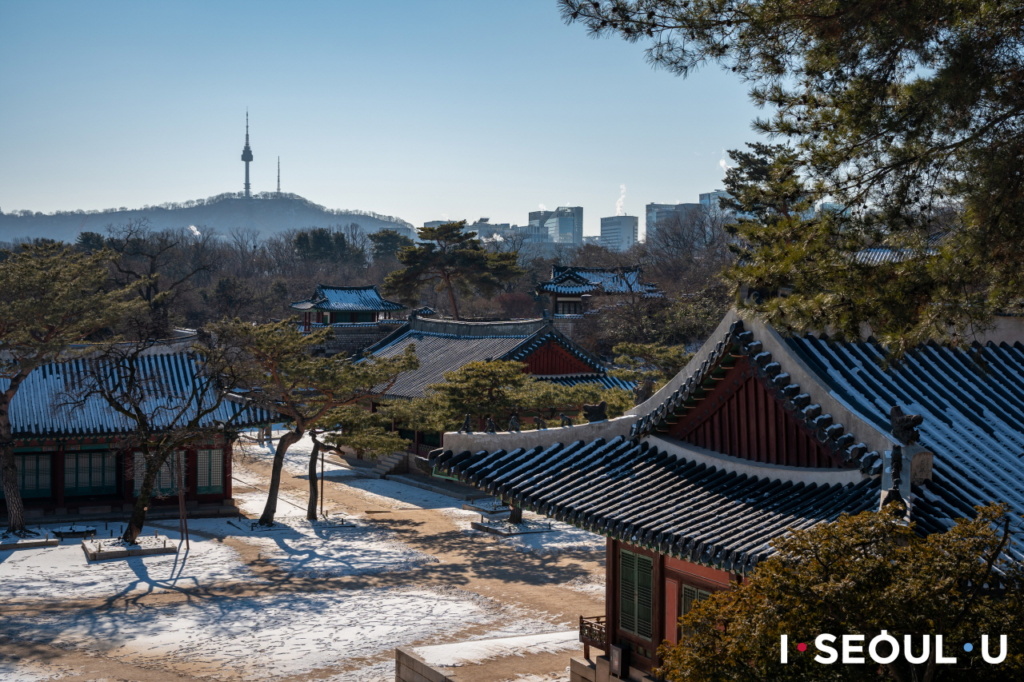
Most activities in Korea are fairly cheap. An entrance to a palace will cost less than 5 USD. Many museums are even free. For 10 days plan roughly 100 USD.
Others: Also remember to include travel insurance in your budget. And if you want, you can also add a budget for the internet. I will come back to these two points a little later.
Remember to include travel insurance in your budget. We always recommend World Nomads, one of the best insurance company out there. Check out your quote here. For 10 days in South Korea count approximately 60 USD per person.
Total Budget for 10 days for 1 person:
- Flight: 1,000 USD
- Accommodation: 1,800 to 600 USD
- Food: 400 USD
- Transport: 250 USD (excl. trip to Jeju)
- Activities: 100 USD
- Travel Insurance : 60 USD
- Others (buffer) : 100 USD
Total: 2,510 to 3,710 (the main difference being which kind of hotels you would like to stay in during your trip)
How to access the Internet during your trip

These days it is difficult to travel without our phones and without the internet! Here are a few options for you:
Free WiFi Hotspot
If you didn’t know, South Korea has some of the best and fastest internet connections in the world. They were also one of the first countries to roll out the 5G. There are several internet access points that can be found in public places such as cafes, restaurants, shopping malls, tourist sites, and even sometimes on certain streets! Most accommodations will also provide free internet.
Access to these hotspots is free. The only downside is that you won’t necessarily find wifi hotspots everywhere during your trip. It is not indicated if there are WiFi hotspots nearby, so you may end up a bit lost sometimes…
If you want to go for a simpler solution, I advise you to read on!
Portable WiFi Pocket
This is a portable 4G router that allows you to access the internet at all times. The box can be purchased directly at Incheon Airport and you can also reserve it in advance online for even cheaper. Book it here . Pocket wifi is also very interesting if you are traveling with several people because you can share the connection and therefore divide the costs!
Another option for accessing the Internet is the prepaid SIM card. By taking a SIM card, you will have access to internet and you can also make calls and send text messages locally. There are only limited places to buy SIM cards for foreigners, hence buy it directly at Incheon Airport after landing.
The SIM card also allows you to make calls and send text messages locally. It also gives you the right to a Korean number.
How to pay in Korea or withdraw money?
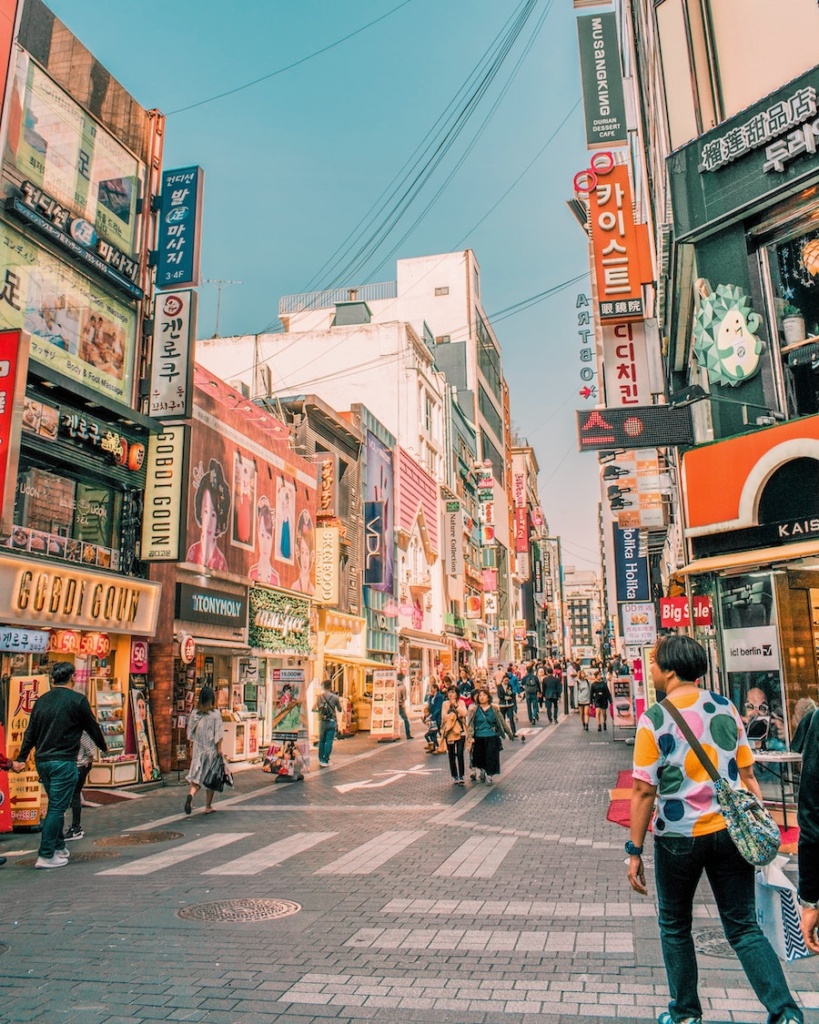
Payment in Korea
Credit Card: You can pay by credit card (with a Visa, MasterCard…) almost anywhere in South Korea. Depending on your bank card options, it is possible that with each payment you will have a commission fee. Also check with your bank before leaving, to ensure that your card allows payment abroad. Sometimes you need to activate it for payment outside of your country.
Cash : You can easily pay cash with won during your trip. I recommend that you always have a minimum amount of cash with you. This may help you in a few situations. For example, when you want to eat street food or in traditional markets.
Getting some Korean Won
Withdrawing cash : A first option for obtaining won is simply to withdraw money from ATM. However, just be aware that many foreigners have trouble with their cars when taking money out of an ATM in Korea… You can find ATMs pretty much everywhere. We mostly used KEB HANA Bank which is the most internal bank with English translation when taking cash. Never had any issues with them…
Change currencies : It is also possible to exchange your currency directly for won at banks (open weekdays from 9 a.m. to 4 p.m.) or at exchange offices. There aren’t many currency exchange office in Korea, in Seoul there are a few in Myeongdong, Dongdaemun, Insadong or Itaewon. Exchange rates are usually better than the airport.
Things to know before traveling to South Korea

The official language of South Korea is Korean. They use a writing system called “hangeul”. During your trip to South Korea, you will surely find people who speak English, especially among young people, however, expect to be lost in translation many times… Well, it’s part of the fun!
The voltage is 220V and the frequency is 60Hz. If you live in Europe, the power outlets are compatible with South Korea. You won’t need to buy an adapter. For the US, an adaptor will be needed.
Driving License
Although the transport network is well-developed in South Korea, it is possible during your stay that you will consider renting a car (for example if you are visiting Jeju Island). An international driving license will then be required.
In most places, it is not common to tip in South Korea.
Movies to watch
We recommend that you watch the movie “Ode to My Father”, which portrays the modern history of South Korea very well. We also loved the drama Mr. Sunshine, available on Netflix.
And most recently Parasites won many prizes. We love that movie!
READ: 20 MOVIES THAT WILL MAKE YOU WANT TO TRAVEL TO ASIA
In conclusion about a trip to South Korea

With these tips for your trip to South Korea, you should be well-prepared with the essentials before you go! If you would like to know more about what to see in Korea, we recommend that you continue reading our travel diary in Korea here .
Finally, if you need more information or have any additional questions about planning a trip to South Korea, feel free to comment on this post! We will be happy to answer.
Enjoy your trip to this great country!
Related posts
- SOUTH KOREA : best things to do in South Korea here
- JEJU : All you need to know before you go to Jeju
- BUSAN : top things to do in the 2nd largest city in Korea
- GYEONGJU , the most beautiful place in Korea
- NAMDAEMUN MARKET , the largest market in Korea
- WHEN? Best time to visit South Korea
- GYEONGBOKGUNG Seoul’s main palace
- GANGNAM your ultimate guide
- JEONJU Hanok village
We are Hammer and Guillaume, a fun couple traveling the world. We will take you to some of the most amazing places on earth. Hammer is a yoga instructor and Guillaume a true water baby, enjoying all kinds of water sports. Follow-us to get the latest update about our travels.
Similar Posts
![planning a trip to south korea 15 BEST THINGS TO SEE IN TAKAYAMA [JAPAN GUIDE]](https://afuncouple.com/wp-content/uploads/2022/12/Best-things-to-see-in-Takayama-11-768x512.jpg)
15 BEST THINGS TO SEE IN TAKAYAMA [JAPAN GUIDE]
Takayama is nicknamed “little Kyoto”. This charming town in Japan has many places to discover. Here are the best things to see in Takayama.

GUIDE TO NAMSANGOL HANOK VILLAGE IN SEOUL
Namsangol is a beautiful Hanok Village in Seoul. It consists of 5 restored Hanok, a gorgeous pavilion and hold many events every years.
![planning a trip to south korea 10 BEST THINGS TO DO IN INSADONG [SEOUL GUIDE]](https://afuncouple.com/wp-content/uploads/2020/05/yujing-zhang-tg6uE64lEJs-unsplash-768x610.jpg)
10 BEST THINGS TO DO IN INSADONG [SEOUL GUIDE]
Insadong is a fantastic neighborhood to visit while in Seoul. It has a lot of traditions, artists, great food and unique shops. FULL GUIDE
![planning a trip to south korea VISIT NARAI-JUKU ALONG NAKASENDO [JAPAN GUIDE]](https://afuncouple.com/wp-content/uploads/2022/12/Best-things-to-see-in-Narai-Juku-in-Japan-7-768x512.jpg)
VISIT NARAI-JUKU ALONG NAKASENDO [JAPAN GUIDE]
Discover a well-preserved town on the famous Nakasendo in Japan: Narai-Juku. Located in the beautiful Kiso Valley, Narai-Juku is a stunning!
![planning a trip to south korea DISCOVER SESEH AND CEMAGI IN BALI [FULL GUIDE]](https://afuncouple.com/wp-content/uploads/2023/07/Discover-Seseh-and-Cemagi-in-Bali-3-768x512.jpg)
DISCOVER SESEH AND CEMAGI IN BALI [FULL GUIDE]
With their charm, pristine beaches, and traditional heritage, Seseh and Cemagi offer a refreshing alternative to see the authentic Bali!
![planning a trip to south korea VISIT TSUKIJI OUTER MARKET [TOKYO GUIDE]](https://afuncouple.com/wp-content/uploads/2022/10/Tsukiji-outer-market-in-Tokyo_Japan-10-768x512.jpg)
VISIT TSUKIJI OUTER MARKET [TOKYO GUIDE]
What to see in Tsukiji Market? Eat amazing sushis, get lost in the many alleys, buy Japanese knives and so much more. Full guide for Tsukiji Market here.
Leave a Reply Cancel reply
Your email address will not be published. Required fields are marked *
Hi We are a couple from Israel, planning a trip to Korea in April 2023 for around two weeks. I wonder if you can assist in planning the full trip for us including accommodation, internal flights and local guides in the different locations. Kind Regards, Sigal
Hi guys, great that you are planning a trip to Korea soon. We do not offer such services, but you search for travel agencies in Korea. Most would be able to customize a great trip for you! 🙂
Hi Hammer and Guillaume, I am following your 10 days itneritary for my trip in Oct this year. Can I check your recommended trip to Gyeongju, was it only 1 night or 2 nights? cos day 4-5 should be 1 night only. Is 1 night enough to see all major attractions there? What your recommended way to see the major attractions there? By cycling, day tour etc? Thanks!
Hi Su, we just sent you an email.

Zen Moments in Korea
7-day South Korea itinerary: what to do and where to go in 2024
Last Updated on April 21, 2024 by Ingrid & Alex
Planning for a 7-day South Korea itinerary can be challenging, especially if you are visiting for the first time. The country has so much in store, from pristine nature to vibrant cities, delicious food, and impressive local traditions. It’s no wonder if you will try to see it all.
With only seven days in your hands, there is so much you can do and see. However, with a good itinerary, you will make the most of your time in the country and tick as many places as possible off your bucket list .
We loved in South Korea for almost one year and explored as much as possible. That’s why, we can help you plan for the best vacation.
Read also : South Korea 10-day itinerary | South Korea 5-day itinerary
This post contains affiliate links. This means if you click on the link and purchase the item, I will receive an affiliate commission at no additional cost to you. Read more about it on our disclosure page here .
Table of Contents
Gyeongbokgung palace, changdeokgung palace, bukchon hanok village, namdaemun market, namdaemun park and namsan mountain, gamcheon cultural village, jagalchi fish market, yeongdo island.
- Yongdusan Park and climb Busan Tower (부산타워)
Haedong Yonggungsa Temple
- Take the Blue Train or Sky Capsule from Cheongsapo Station (청사포정거장)
Haeundae Beach
Gwangalli beach, day 6 – gangnam (lotte world), day 7: day trip outside of seoul (dmz, suwon, etc), other things to know when planning for one week in south korea, 7-day south korea itinerary for first timers – seoul and busan.

Any first-time traveler should visit at least the two most important cities in South Korea: Seoul and Busan .
We lived in Seoul and traveled to Busan as often as we could. The ocean-side city is much more colorful than South Korea’s capital.
Best area to stay in Seoul for sightseeing: Myeongdong
Recommended Hotels:
Budget: Crib 49 Guesthouse
Mid-Range: L7 by LOTTE
Luxury: Lotte Hotel Seoul Executive Tower
Day 1: Seoul Palaces, Bukchon Hanok, Insadong, Hongdae

Start your first day in Seoul by visiting one or 2 of the famous 5 Palaces .
If you also want to do something else, you won’t have the time to see all of them. Worry not; if you see one or two, that’s just enough.
Gyeongbokgung Palace and Changdeokgung Palace are within walking distance, and the famous Bukchon Hanok Village is between them.
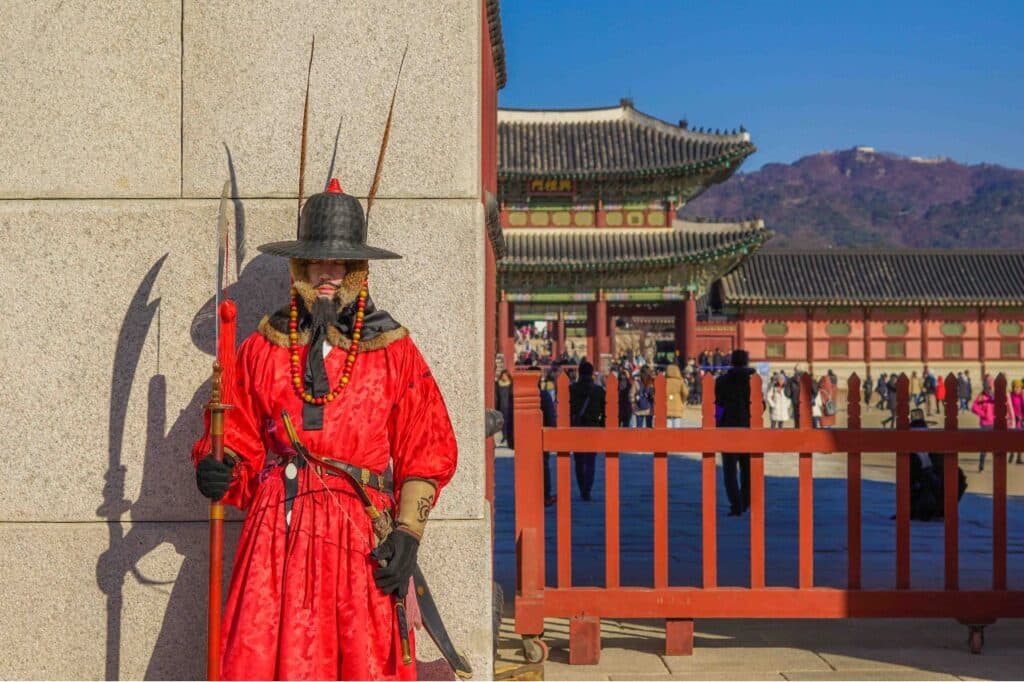
Constructed in 1395 AD by the first Joseon king, Taejo, its name was devised by an influential minister named Jeong Dojeon. The kingdom’s main palace complex housed the royal household and most of the government.
Stepping through the grand gates, you’re immediately transported back to the Joseon dynasty, as the palace’s intricate architecture and sprawling grounds evoke a sense of awe and wonder.
The imposing presence of Gyeongbokgung, with its vibrant hues and traditional designs, offers a glimpse into the luxury of Korea’s royal past.

Walking along the meticulously manicured gardens and serene ponds, you can almost hear the echoes of history whispering through the air.
Exploring the palace’s various halls, pavilions, and courtyards reveals a treasure trove of artifacts and stories, each corner brimming with centuries of tradition and significance.
Admission Fees Adults (ages 19-64): 3,000 won / Groups (10 people or more): 2,400 won Children (ages 7-18): 1,500 won / Groups (10 people or more): 1,200 won
Free on the last Wednesday of the month and on any other day, while wearing a hanbok.
Address : 161, Sajik-ro, Jongno-gu, Seoul
Gyeongbokgung Station (Seoul Subway Line 3) and Exit 5. Anguk Station (Seoul Subway Line 3) and Exit 1.
Official website

Move forward to the Changdeokgung Palace, a UNESCO World Heritage Site.
Its seamless integration with the surrounding landscape, particularly the majestic Huwon Secret Garden , showcases the meticulous harmony between nature and human ingenuity.
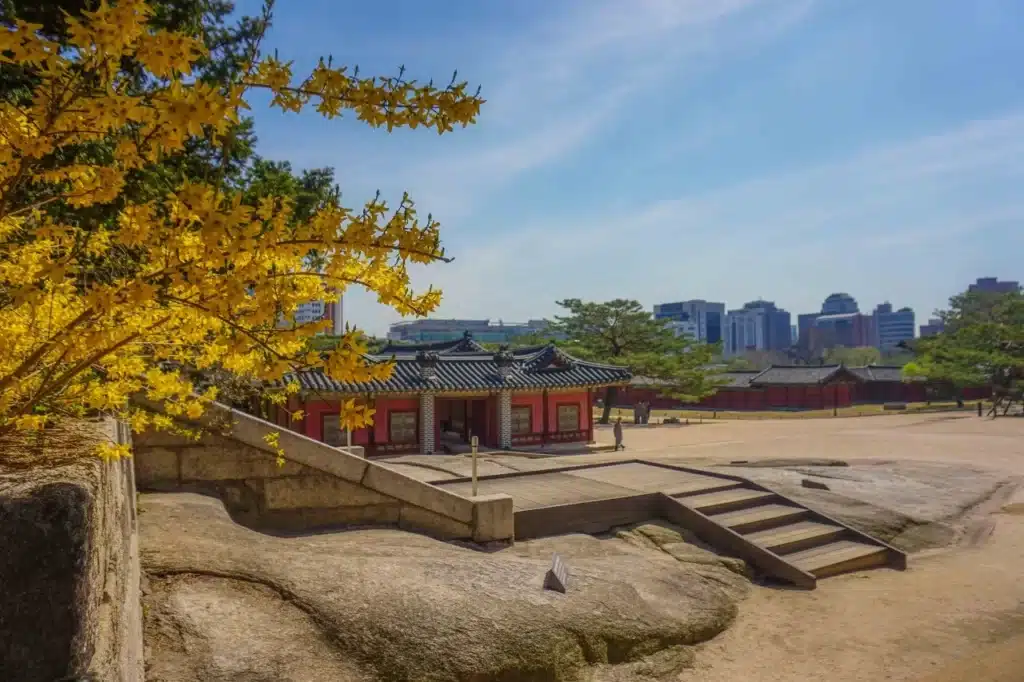
Walking through the palace’s ornate halls, pavilions, and courtyards, visitors are transported to an era of royal splendor, where every detail reflects the grace and elegance of Korean aesthetics.
From the iconic Injeongjeon Hall to the garden’s tranquil ponds and winding paths, each corner of Changdeokgung Palace invites exploration and contemplation.
Admission Fees [Changdeokgung Palace] Adults (ages 25-64): 3,000 won / Group (over 10 people): 2,400 won / Youth ( ages 7-18): 1500 won Students (ages 24 and under): Free (* Except for foreign visitors)
On the last Wednesday of the month and on any other day during the week while wearing a hanbok dress, the entrance is free.
Address : 99, Yulgok-ro, Jongno-gu, Seoul
Subway : Anguk Station (Seoul Subway Line 3), Exit 3.

One of our favorite areas in town, the Bukchon Hanok Village, is packed with pretty cafes, art museums, and local traditional restaurants.
The neighborhood boasts a labyrinth of narrow alleyways lined with beautifully preserved hanok houses, showcasing the elegance of traditional Korean architecture.
The perfect area to explore during spring or fall that’s when Seoul transforms itself and becomes incredibly photogenic.
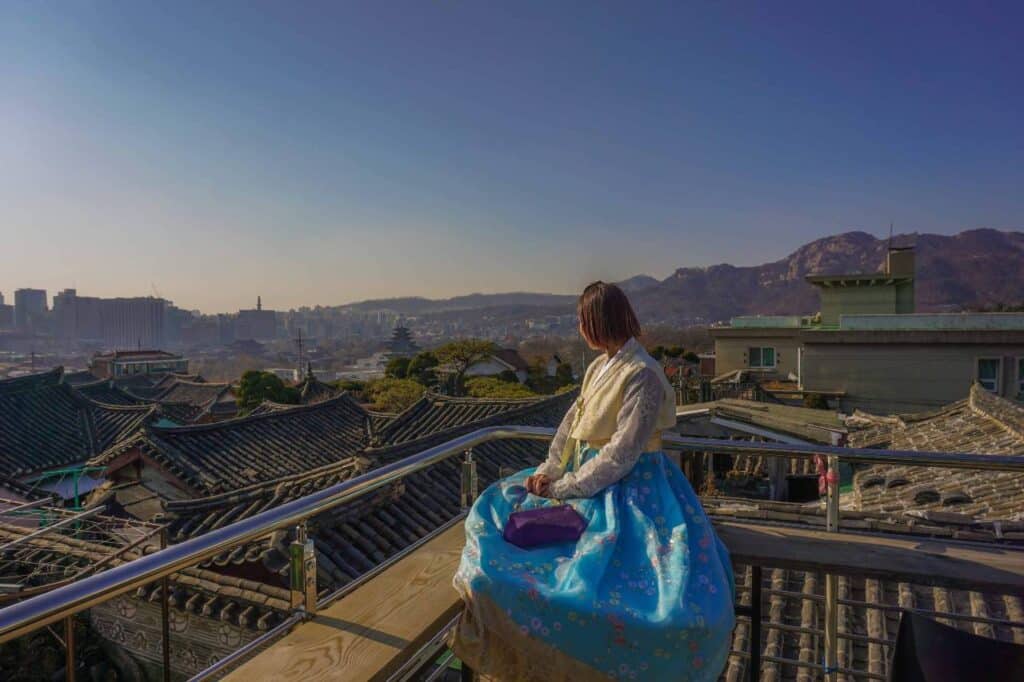
Rent a premium hanbok and stroll through the quaint streets. By doing so, you will be transported back in time, immersed in the tranquil ambiance of centuries-old courtyards, tiled roofs, and graceful eaves.
The village’s timeless charm is further enhanced by its panoramic views of the city skyline and nearby historic landmarks, including Gyeongbokgung Palace and Jongmyo Shrine.
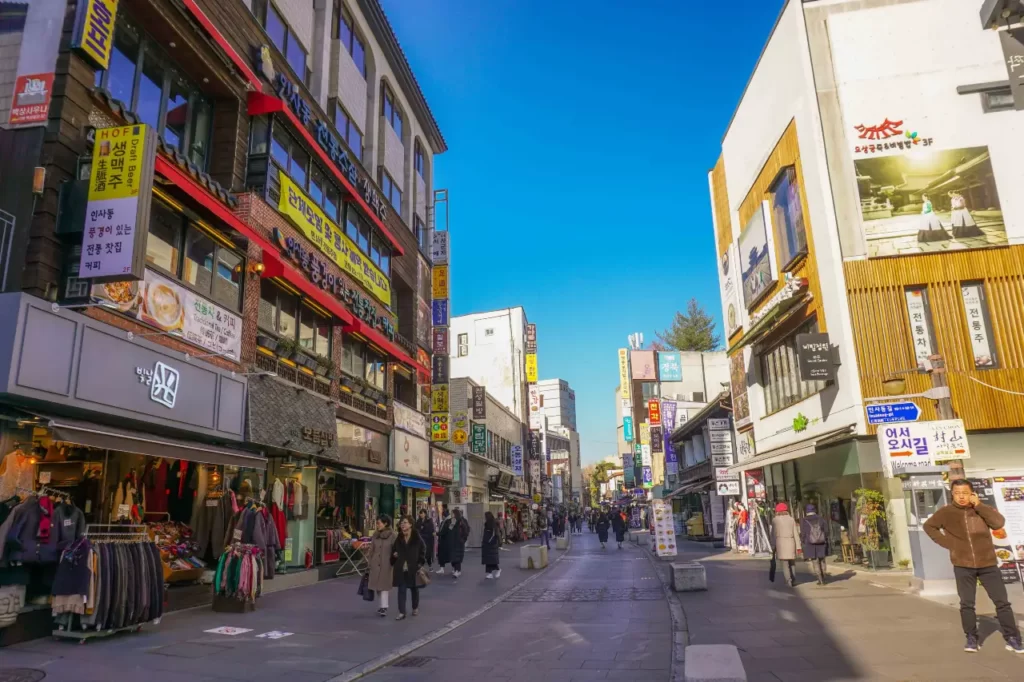
Across the street from the Bukchon Hanok Village lays the famous Insadong area.
Renowned as a hub for traditional Korean arts and crafts, Insadong’s bustling streets are adorned with galleries, teahouses, and shops showcasing a diverse array of handmade pottery, paintings, calligraphy, and other cultural treasures.
Eat at one of the local restaurants and try some traditional pastries – hotteok (sweet pancakes) and bindaetteok (mung bean pancakes).
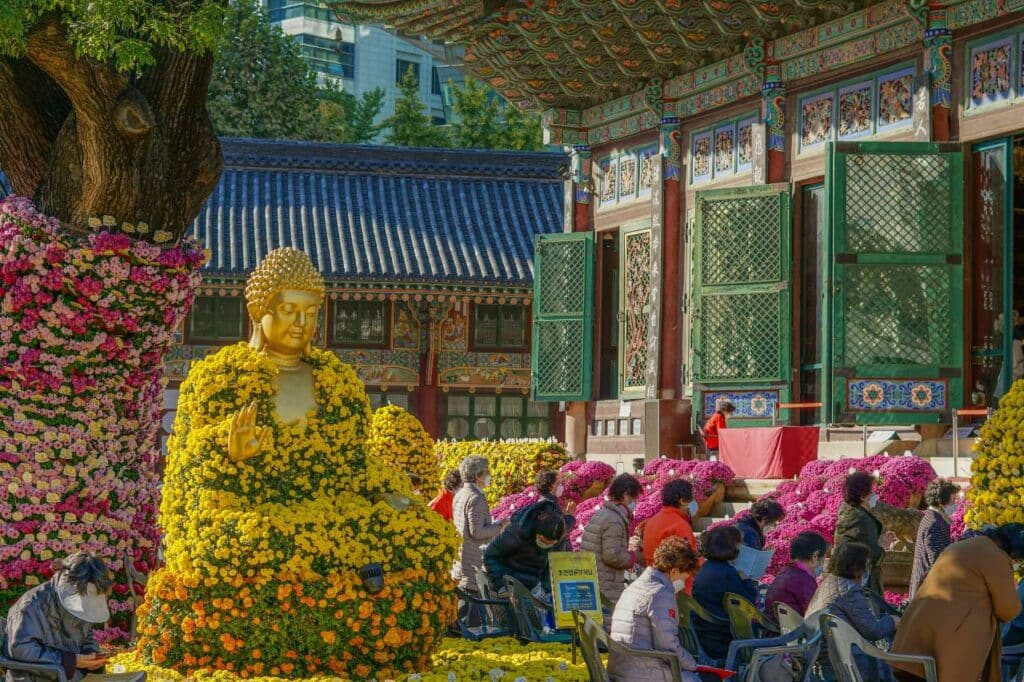
Don’t miss a visit to Jogyesa Temple – The temple’s main hall, Daeungjeon, is a masterpiece of traditional architecture, housing exquisite Buddhist relics and statues, including a majestic golden Buddha.
Moreover, the temple is decorated with colorful lanterns or flowers on special occasions.

End your day in Hongdae, one of the most vibrant areas in town.
You can quickly get there by subway (on line number 3, green) or by bus. However, we always preferred to go by bus because that’s the best way to see the city.
Lined with trendy cafes, indie boutiques, and street performers, Hongdae exudes an atmosphere of constant excitement and innovation.
By day, the streets teem with shoppers browsing unique fashion finds and enjoying quirky coffee shops. At the same time, by night, the area transforms into a lively hub of music, dance, and revelry, with numerous clubs and bars hosting live performances and DJ sets.
Read also: Things to do in Hongdae | Where to stay in Hongdae, best hotels
Day 2: Namdaemun Market, Namdaemun Park, NSeoul Tower, Itaewon , Myeongdong
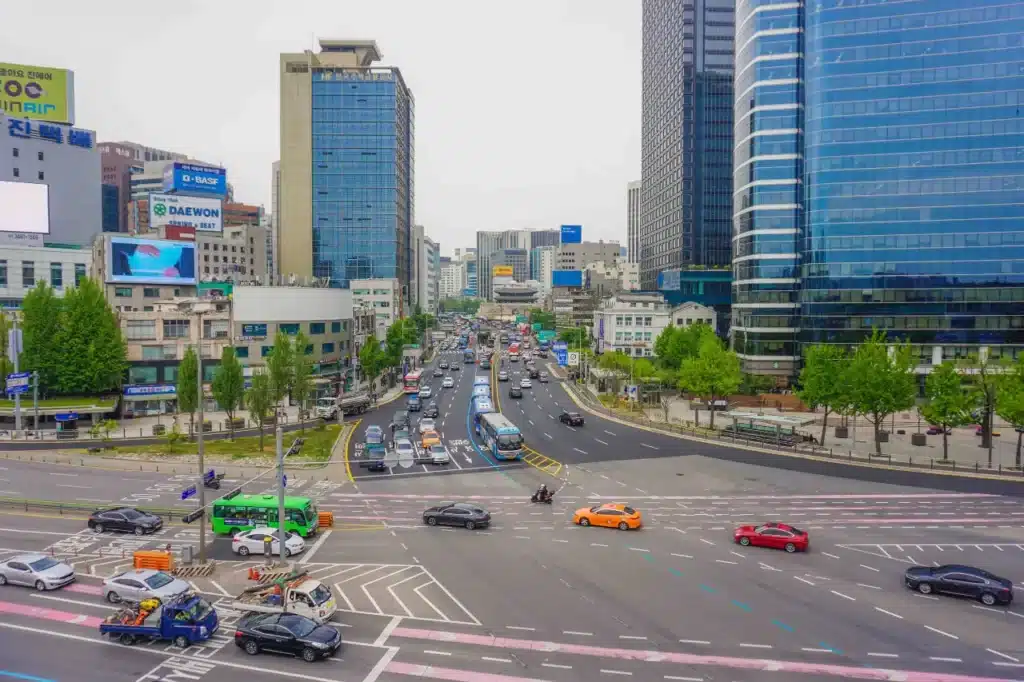
Start your day with a visit to the Namdaemun Market in the city’s heart.
As one of Seoul’s premier shopping destinations, Namdaemun Market exudes a vibrant and chaotic energy, with the lively calls of vendors mingling with the chatter of shoppers.

Cross the street from the market, enter the beautiful park, and climb Namsan Mountain toward N Seoul Tower. As you move forward, you will be welcomed by stunning city views.
Otherwise, if you don’t feel like walking, there are plenty of other ways to get to Namsan Tower . For example, you can take the bus, the cable car, or a taxi if you want to get there quickly and easily.

As one of the city’s most recognizable symbols, the tower, at 236 meters, provides visitors with an unparalleled vantage point from which to admire the beauty of the South Korean capital.
Whether by day or night, the observation decks offer stunning vistas, with distant mountains, skyscrapers, and the winding Han River stretching as far as the eye can see.
Beyond its panoramic allure, N Seoul Tower is also a cultural hub, featuring attractions like the Teddy Bear Museum and numerous restaurants, cafes, and souvenir shops.

Crossing on the other side of Namsan Mountain, you will get to the famous Itaewon district.
As a melting pot of cultures, Itaewon attracts visitors from all around the globe, offering a kaleidoscope of experiences catering to every taste and interest.
Its bustling streets are lined with an eclectic mix of trendy boutiques, art galleries, vintage shops, and an array of international restaurants, cafes, and bars.
You can spend the evening at one of the many restaurants or bars here or head to the next stop.
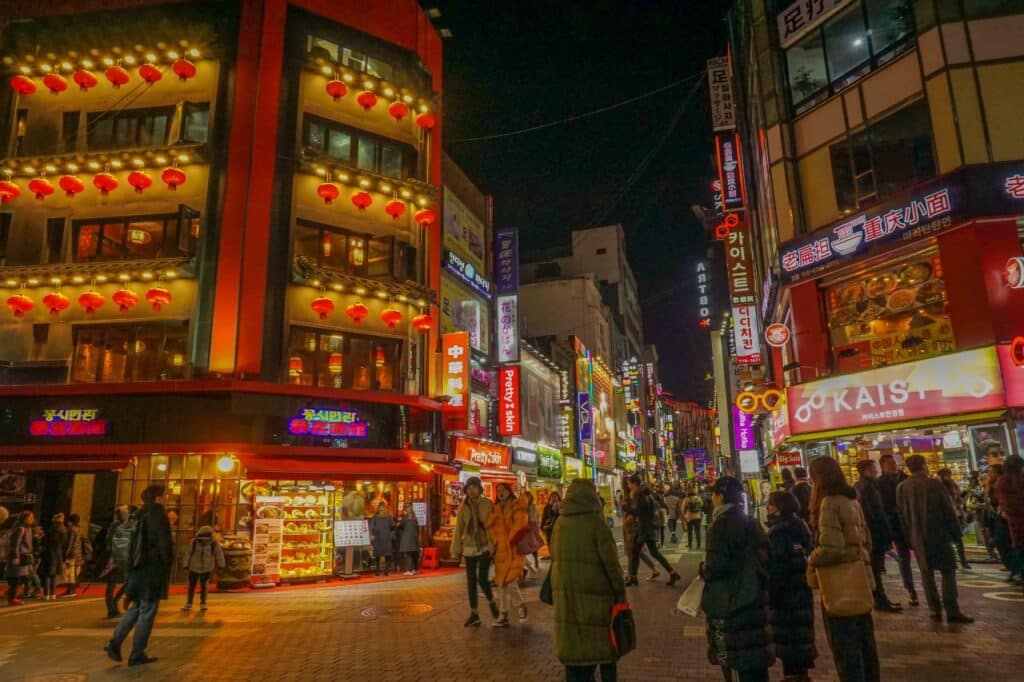
A popular neighborhood packed with cosmetics stores , restaurants, cafes, and street food vendors. You can shop till you drop, have dinner at one of the local places, see a show at Nanta , or visit a cat cafe.
There are countless options for what you can do in Myeongdong .
Read also: Where to stay in Myeongdong
Day 3-5 of your one week in South Korea itinerary: Busan
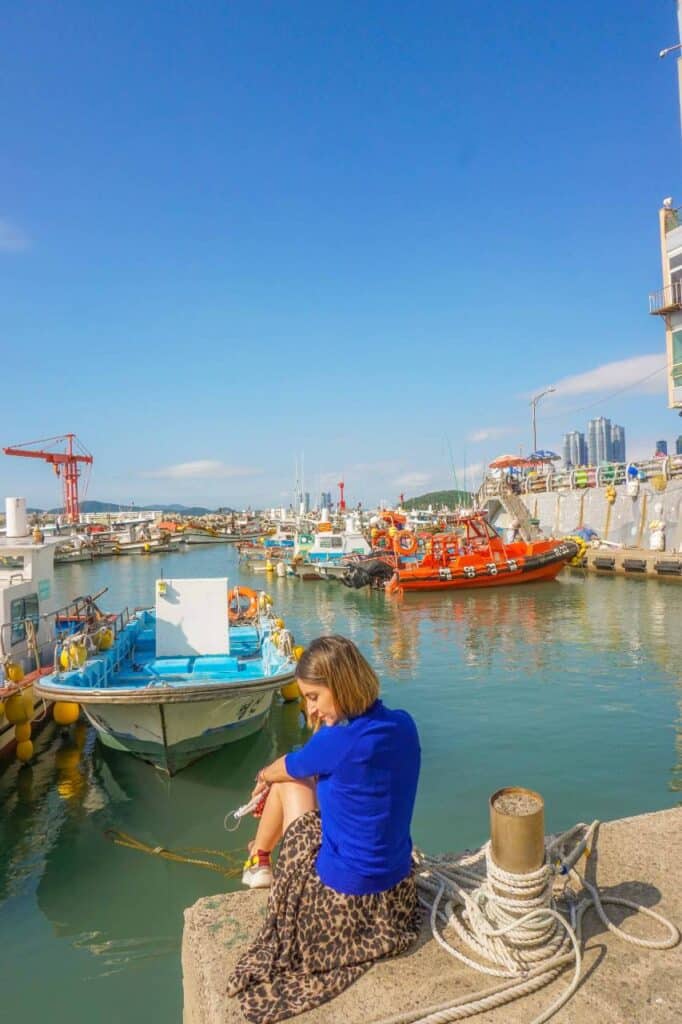
Getting from Seoul to Busan is easy and relatively fast when traveling by high-speed train (KTX) or plane.
If you ask us, we always travel by KTX—it is fast, convenient, and comfortable. The train station is close to the city center in both cities. As a result, you don’t waste any more time on the commute. Book your Korea Rail Pass here!
Best area to stay in for 2 days in Busan : Seomyeon
Recommended hotels in Seomyeon
Lotte Hotel Busan
Browndot Business Seomyeon
We love Busan and would return to the ocean-side city on every occasion.
As a matter of fact, the city offers so many things to do and see. With only two days, you must carefully craft your itinerary. Here is our suggestion.
Read also: 2 days in Busan itinerary – packed with useful information
Day 1 – Gamcheon Cultural Village , Jagalchi Fish Market , Yeongdo Island, Jeoryeong Coastal Walk, Yongdusan Park and Busan Tower

One of the most popular attractions in town, the Gamcheon Cultural Village attracts many tourists daily.
Nestled on the hillside, the colorful village offers stunning views.
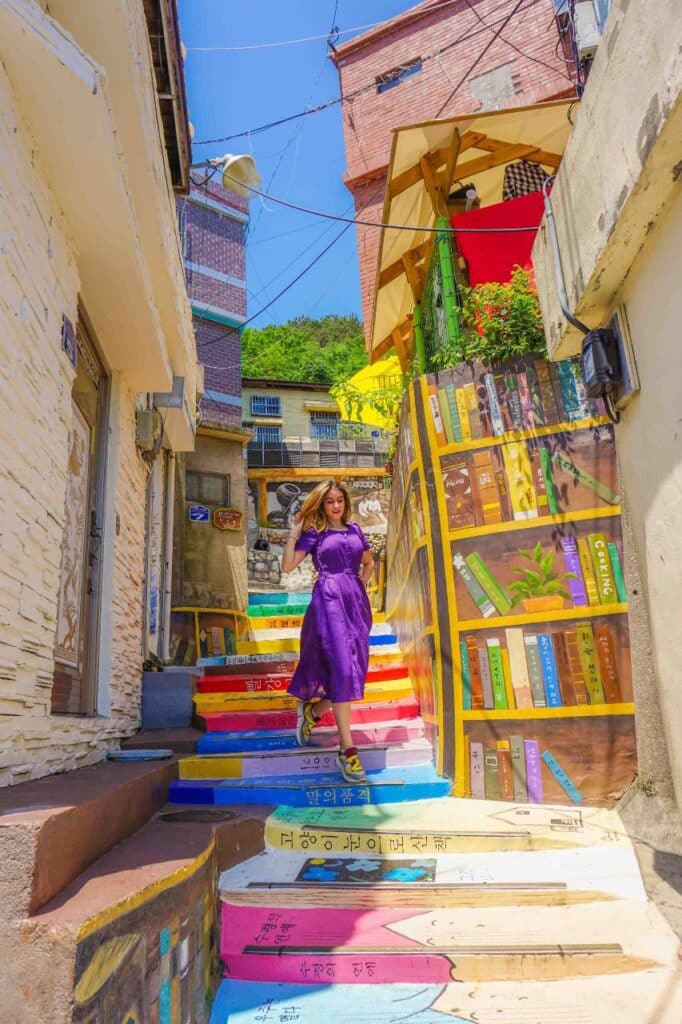
Once a humble settlement for refugees during the Korean War, the village became a lively cultural hub. It is adorned with vibrant murals, sculptures, and installations by local artists.
From quaint cafes and art galleries to cozy boutiques and handicraft workshops, Gamcheon exudes a palpable sense of community and artistic expression.
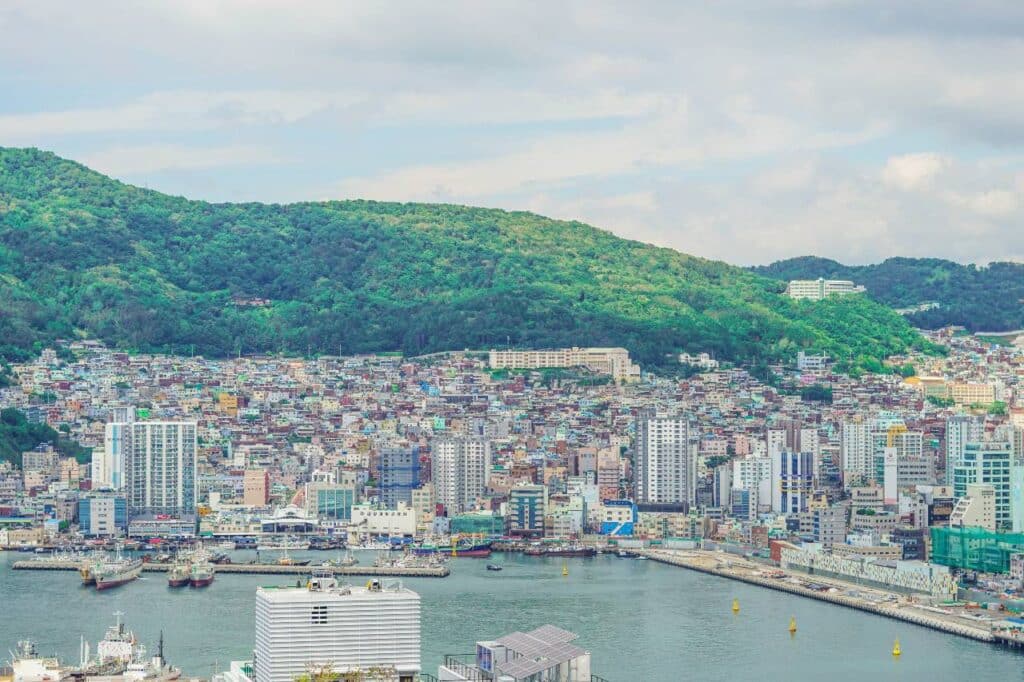
Take the bus and head to one of the most famous local fish markets: Jagalchi Fish Market.
As one of the largest fish markets in Korea, Jagalchi is a sensory feast. Rows upon rows of stalls brim with an astonishing variety of fresh seafood. They range from familiar favorites like octopus and shrimp to more exotic offerings such as sea squirts and sea cucumbers.
The market’s vibrant atmosphere is heightened by the lively calls of vendors hawking their wares and the frenetic energy of shoppers bargaining for the best catch of the day.
Book a Jagalchi Fish Market & Korean Food Market Tour

Cross the bridge and head to Yeongdo Island.
The island is home to several historic sites, including the towering Yeongdo Lighthouse and the historic Taejongdae Park, which boasts dramatic cliffs, dense forests, and sweeping coastline vistas.
However, the most popular attraction is the Jeoryeong Coastal Walk. It has colorful streets, cafes with scenic views, and a perfect walk along the ocean.

Yongdusan Park and climb Busan Tower (부산타워)
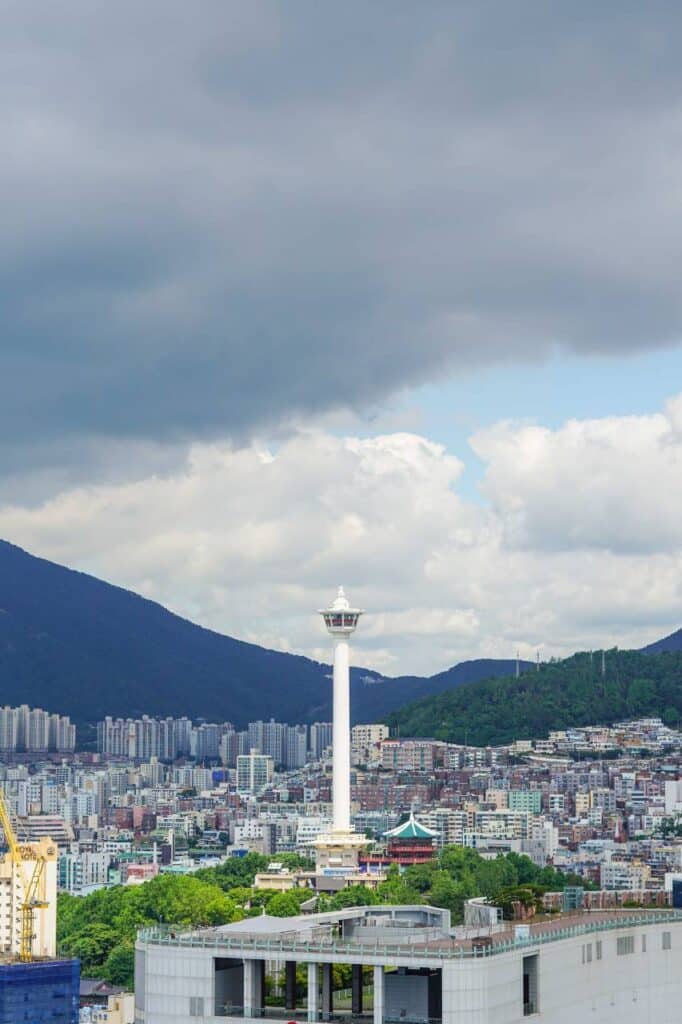
Standing 118 meters tall atop Yongdusan Park, this observation tower has symbolized Busan’s modernity and progress since its construction in 1973.
You can ascend to the tower’s observation deck via a high-speed elevator. From here, you are treated to breathtaking views of the city’s sprawling metropolis, picturesque coastline, and surrounding mountains.
Beyond its scenic allure, Busan Tower also houses a cultural exhibition hall showcasing the city’s history and achievements.
Tip : Save on attractions with the Busan Pas s
Day 2 – Haedong Yonggungsa Temple , The Blue Line Park Sky Capsule & Train, Haeundae Beach, Gwangalli Beach

Start your day at the temple and make your way back towards the city.
Unlike many other temples nestled in the mountains, Haedong Yonggungsa’s oceanfront location imbues a unique and tranquil ambiance. This makes it a popular destination for both spiritual seekers and tourists.
The temple, believed to have been first built in the 14th century, boasts a rich history steeped in legend and devotion.
Adorned with colorful lanterns, intricate pagodas, and ornate statues, the temple’s architecture harmonizes beautifully with its natural surroundings. It offers breathtaking views of the sea and surrounding cliffs.
Take the Blue Train or Sky Capsule from Cheongsapo Station (청사포정거장)
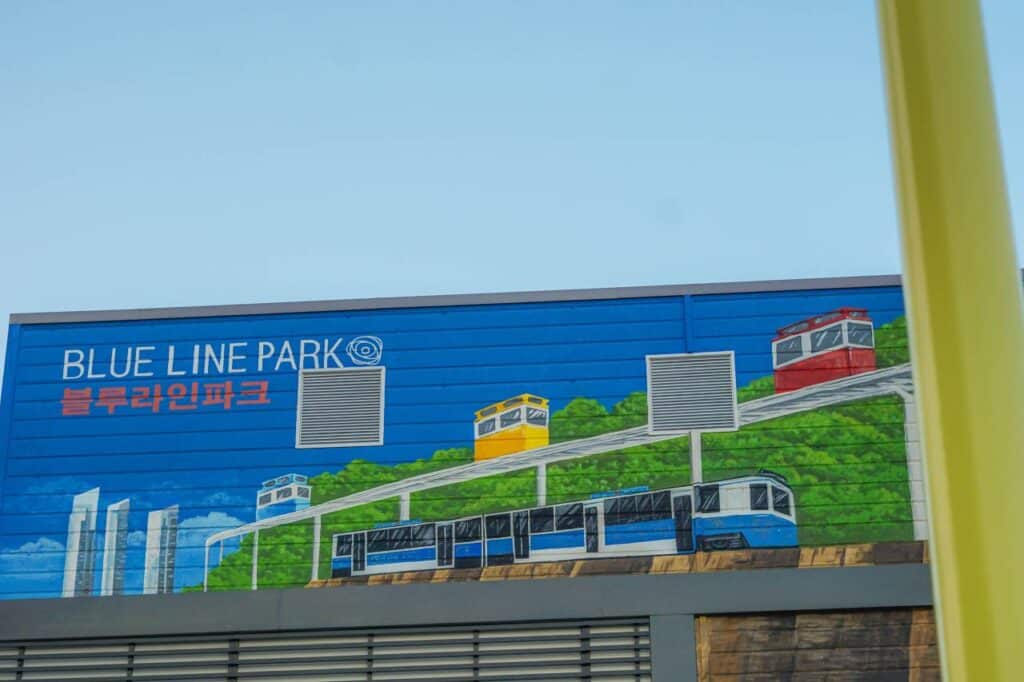
From the temple, take the bus and go to Cheongsapo Station, the end of the line for the Blue Train.
One of the most popular attractions in town, the train links Cheongsapo to Mipo Station, and it rides along the ocean, offering breathtaking scenic views.
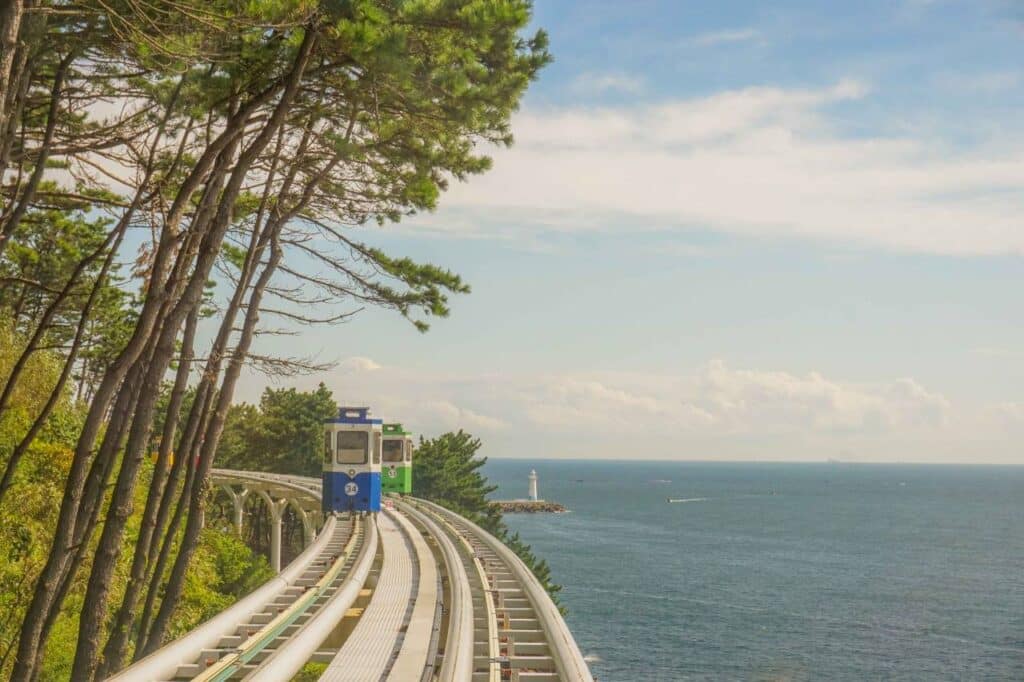
For the rest of the trip, choose to go on the Sky Capsule because it is a unique experience.
Read our complete Sky Capsule and Blue Line Train Guide!

Mipo Station is minutes from Korea’s most famous beach – Haeundae Beach .
Haeundae stretches for approximately 1.5 kilometers, offering ample space for relaxation and recreation against the backdrop of the sparkling East Sea.
With its soft sands, crystal-clear waters, and panoramic views of nearby islands and mountains, Haeundae Beach provides the perfect setting for sunbathing, swimming, or simply unwinding by the shore.

The beachfront promenade is lined with restaurants, cafes, and shops. They offer diverse local delicacies, refreshing beverages, and souvenirs.
During the summer, the beach comes alive with vibrant energy as locals and tourists flock to enjoy festivals, fireworks displays, and cultural performances.
Go for a SPA treatment with Korean beauty products at the famous SPA 1899 near the Haeundae beach. Book your treatment here!
Don’t miss the Sea Life Busan Aquarium – an impressive immersion into sea life. You will learn about hundreds of species of fish and marine animals. Moreover, you can also feed sharks. Book your ticket here!

End your day with dinner and a sunset view at Gwangalli Beach.
Unlike its more crowded counterpart, Haeundae Beach, Gwangalli is known for its laid-back vibe and picturesque setting, making it a favorite among locals and tourists seeking a more relaxed seaside experience.
In the evenings, the beach transforms into a dazzling spectacle as the Gwangan Bridge illuminates the night sky with its vibrant lights, casting a magical glow over the waterfront.
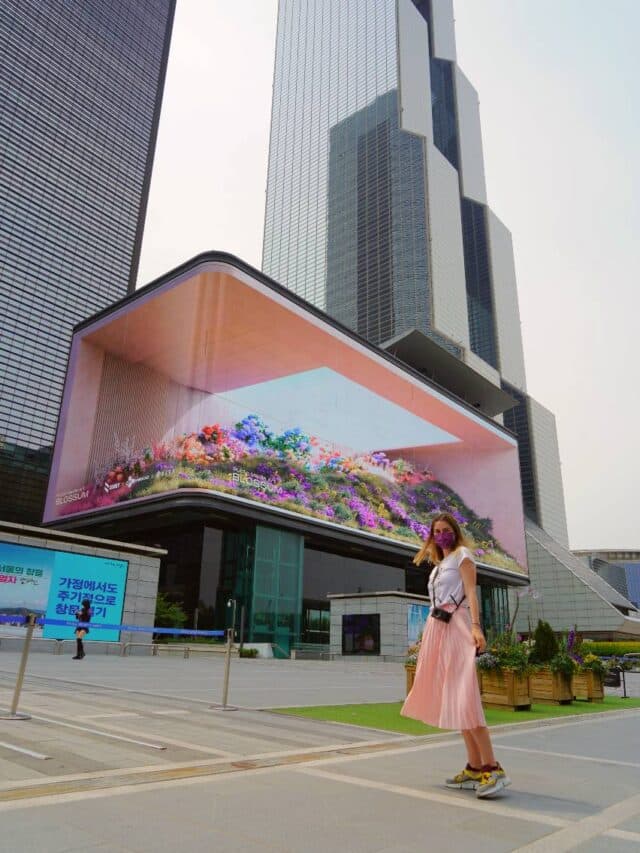
Made famous by the global hit song “Gangnam Style,” the district has become synonymous with luxury, fashion, and entertainment.
Its towering skyscrapers, glitzy shopping centers, and chic boutiques cater to a sophisticated clientele, offering a wide array of designer brands, trendy cafes, and gourmet restaurants.

You can explore Gangnam by having tea at Bongeunsa Temple, taking a picture with the famous COEX Mall Library, seeing the Samsung Display, shopping for luxury brands in Garosu-gil, or doing any one of these cool things to do in Gangnam .
You can also spend almost all day at the famous Lotte World – the most popular adventure park in South Korea.
As the day ends, climb Lotte Sky Tower , South Korea’s tallest building.
There are so many things you can fit into one day in Gangnam.
The options for day trips outside of Seoul are endless. However, visiting the DMZ should be on any new visitor’s list.
As one of the most heavily fortified borders in the world, the DMZ serves as a stark reminder of the ongoing conflict and the enduring hope for reunification.
Tours to the DMZ typically include stops at key landmarks such as the Joint Security Area (JSA), where visitors can observe soldiers from both sides standing face-to-face, and the Dora Observatory provides panoramic views of the border and glimpses into North Korea’s countryside.
Visitors also have the opportunity to explore the 3rd Infiltration Tunnel, dug by North Korea in an attempt to infiltrate the South, and the DMZ Exhibition Hall, which offers insightful exhibits on the area’s history and significance.
If that is not of interest to you, don’t worry! We have a comprehensive list covering many options for day trips outside of Seoul .
Incheon, The Garden of Morning Calm, Suwon, and Hwaseong Fortress are only a few of the amazing places you should see in South Korea that are also easily reached from Seoul.
If you are planning a 7-day South Korea itinerary, here are some travel resources you will find useful.
Visa – Depending on where you are traveling from, you will or won’t need a visa . Check your Visa requirements here!
Don’t travel without insurance – this is a World Wide Travel Health Insurance + Covid suitable for almost anyone, and easy to book. On top of that, they also provide luggage insurance in case your luggage gets lost or damaged. Get the best offer here!
Book your SIM Card & T-Money Card with airport pickup.
See if you would rather buy a SIM card or pocket wifi for your trip
Travel by train and get the best ticket price with a Korea Rail Pass
Get discounts on popular tourist attractions & activities by booking them ahead of time on Klook , Viator , or GetYourGuide
By Ingrid & Alex
Ingrid A former financial professional, I have been passionate about photography since an early age. My fascination with Korean culture was one of the reasons Alex accepted a business role in Seoul. Alex A former corporate business executive, I am a historical fiction writer. My business career allowed us to live in Seoul and explore South Korea for one year. We fell in love with the country, its culture, food, and people, and we strongly believe you will love it too! Because we know how difficult planning a trip can be, especially to South Korea, we are here to help you out and ensure you have an awesome time there.
Leave a comment Cancel reply
Your email address will not be published. Required fields are marked *
Save my name, email, and website in this browser for the next time I comment.

The Only 1 Month Korea Itinerary You Need
While I’ve already written ways to spend two weeks in Korea , I thought I’d make one giant Korea itinerary guide for a month.
I do think one month isn’t nearly enough to see all of Korea, but I’m obviously quite biased ;).
I decided to make this itinerary a bit faster than I’d normally travel just so I could fit in as much as possible. If you only can ever come to Korea once, this should help you feel like you saw everything you could see.
Quick Korea Travel Tips
- Getting in: If you’re coming from abroad, you’ll most likely fly into Incheon International Airport (ICN). It’s about an hour from Seoul and extremely easy to take the subway to get to your hotel. However, you can also get a taxi or book a transfer beforehand.
- Stay Connected: While Korea is pretty well connected wifi wise, I always recommend getting a SIM card! Even better, Korea offers e-SIMs! You can buy ahead and not even have to take out your normal SIM.
- Getting Around: All major cities have some sort of subway system and there’s a pretty robust bus system all around the country even in more rural areas. Download KakaoMap for the most up to date information. In between cities, you can take the train or bus. For trains, I always use Let’s Korail to buy tickets ahead of time as they can sell out. For buses, I usually just show up to the terminal and buy tickets, but my friend told me you could use TxBus , Kobus , or Bustago to order online.
- Language Help: While major tourist points are pretty okay with English, I’d say the rest of Korea you’ll want to have some sort of translation app on hand. And I recommend learning Hangul at least a little bit so you can read. Papago is better than Google translate for Korean.
- Travel Insurance: Korea can be expensive if you wind up in the hospital! I recommend getting either World Nom a ds or SafetyWing . I personally have an annual plan with Allianz.
For more advice, check out my Korea travel tips and my Korea trip planner .
The Ultimate Korea Itinerary Guide for 1 Month
Fly into: incheon international airport.
Assuming you’re coming from abroad, you’re most likely going to fly into Incheon Airport ! Incheon has spoiled me because it’s seriously one of the best airports in the world , even if the “ice rink” is a lie. Seriously, this place even has arrows on the ground to make sure you’re going in the right direction to the subway!

Days 1 – 4: Gangwon Province
So, you’re not actually going into Seoul just yet. Nope, you’re going to the Northeast coast to Gangwon-do! In fact, this is the northernmost province in South Korea.
You get there in one of two ways:
- Take an airport bus from Incheon to Sokcho ( Check the schedule here )
- Use the subway to first go to Seoul Station. Then take a train from Seoul Station to Gangneung Station. Forom there take a bus from Gangenung to Sokcho (Airport – 1 hour, KTX – 2 hours, Bus – 1 hour)
Stay: By the beach! Top spots include Heavenmark , Sokcho Beach’s House , or Sokcho & Guesthouse
Day 1: Sokcho
I’d base myself in Sokcho (속초) for this Gangwon trip. This is the main spot for anyone visiting the area as it’s a gateway city for Seoraksan National Park and has quite a few scenic things to do on its own.
Take the rest of the day to get over jet lag and sleep because your schedule is about to be packed .

Day 2: Hike or visit Seoraksan
Spend the day hiking Seoraksan , one of Korea’s most important mountains. Or you could take the cable car up, I won’t judge.
Day 3: Sea Train
Take the sea train and stop off at some of the main beaches in Gangwon, including Gangneung , Donghae , and Samcheok . Wander around, relax on the beach, and just enjoy. A good day to rest if you did actually hike Seoraksan. If you do want to do some sightseeing, you could do this Gangneung Taxi Tour .
- Seasonal Options: Goseong Lavender Farm in June, surfing and SUP at Surfyy Beach, or any of the ski resorts in winter

Days 5 – 9: Seoul
Time for one of the coolest cities in the world! I’m not kidding. I’ve been to so many cities in my travels and Seoul still tops the list for me. The biggest thing you should know is that it’s massive . Much bigger than what you’re expecting and unless you want to drain your bank account taking taxis, you’re going to want to give yourself more time than you think to get around via the subway or bus.
Getting back: For your time in Seoul, I recommend staying in Insadong . It’s the best location for everything you’ll want to do below! To get to Insadong from Sokcho, you’ll want to take a bus from Sokcho Bus Terminal to Seoul Express Bus Terminal. From there you can take the subway to the closest station to your hotel.
Stay: I’ve personally stayed at the Grid Inn which is in SUCH a good location. If you want to experience a hanok, try Charm Hanok Guest House .

Day 5: Seoul – Insadong
Once you’ve arrived to Seoul and dropped your things off at your hotel, just walk around and enjoy Insadong! This is probably my favorite neighborhood of Seoul because it’s the most historic area.
If you’re up for some walking, spend the afternoon strolling through Bukchon Hanok Village. It’s really such a pretty place as it’s where all the traditional houses are located! Be sure to go to the main view point, which is someone’s house, and see over the tiled roofs to Namsan Tower. Another good stop is the cool cafe, Green Mile Bukchon ! Also my favorite incense shop, Granhand has a location here.
When it comes time for dinner, hop over to Gwangjang Market to sample all the delicious Korean food you can. If it sounds familiar, it’s because the market was featured on Netflix’s “Street Food” series.

Day 6: Storybook Day Tour
There are a few different day tours you can do from Seoul , but I personally love the nearby storybook-esque visits ! You could take the subway to Gapyeong and do the Gapyeong shuttle bus or you can book a tour that will take you to each of the spots throughout the day.
I’ve personally only visited via a tour. Most will take you to the Garden of the Morning Calm , Nami Island , and Petite France . Sometimes the tours have one other stop, but I think doing all three is a good amount for one day without feeling overwhelming. Check this tour for prices + availability

Day 7: Changdeokgung & Deoksugung
To start, there are five official grand palaces of Seoul , and on this trip I have you seeing three of them. It sounds like overkill, but I promise these three are particularly different. Gyeongbokgung is the largest of the palaces (more below) while Changdeokgung is known for its Secret Garden and Deoksugung is much smaller and known for having some European style buildings mixed in. I promise they’re worth it!
On this day, you’re going to start off early and go straight to Changdeokgung . It opens at 9, and you want to make sure you get tickets to see the Secret Garden. If you visit during the fall, the line will be long! This whole palace area will take at least 2 hours to see everything.
For lunch and the middle of the day, you can go around Insadong (there’s plenty of good restaurants to pop into) or you can venture over to Seoul University to see all the restaurants and cafes near there.
In the afternoon, head to Deoksugung . Visit the palace grounds themselves before going up to the observatory to get a cool bird’s eye view. This is a particular must if you visit during peak fall foliage season.

Day 8: Full Day Tour to Suwon Hwaseong or the DMZ
Use this day to tour either the DMZ or Suwon Fortress . Both will take you the better part of the day and will showcase an interesting part of Korea’s history. Book a tour to Suwon here or book a DMZ tour here
Seasonal Option: Hike Bukhansan for its fall foliage.

Day 9: Gyeongbokgung + Cheonggyecheon
Start off early and head there to see the changing of the guards and then head in to walk around. Gyeongbokgung is massive , so you’ll probably spend a good few hours there. You can also stop in and visit the National Folk Museum of Korea.
From Gyeongbokgung, walk along Cheonggyecheon , Seoul’s very pretty manmade river. Depending on when you’re visiting, they sometimes have really nice exhibits. You’ll also pass through Gwanghwamun , which has the big statue of King Sejong and usually some sort of event going on.
From Cheongchyecheon, you can walk over to Jogyesa .
Days 10 – 16: Jeollanam-do and Jeollabuk-do
Time for my favorite provinces of Korea! Jeollanam and Jeollabuk (from here on just combined into Jeolla) are a deeply underrated part of the country. I think they’re home to some of the most incredible scenery and, most importantly, the very best food.
I know, I know. I’m biased because this is exactly where I lived for three years, but I promise it’s worse spending at least six days of your month in Korea here.
To get to Jeonju, the first stop in Jeolla, do one of the following:
- Take a KTX, and it’ll be about 90-minutes from Yongsan Station
- The slow train will be closer to 3 hours from Yongsan Station
- A bus will be around 2 1/2 – 3 hours from the Express Bus Terminal

Day 10: Jeonju
Stay overnight in Jeonju’s Hanok Village and get a proper hanok sleeping experience. I personally loved Ssamok Ssamok Hanok Guesthouse when I stayed overnight.
The main thing to do is to enjoy the hanok village. Compare it to Bukchon and let me know which one you like better, I’m personally more partial to Jeonju’s version.
Depending on how active you want to be, you can also visit Deokjin Park , especially if it’s around summer with the lotus pond, and/or visit Jeonju’s Mural Village .
The biggest thing to try here is bibimbap. I was a big fan of 종로회관 (Jongno Hoegwan) but you can’t really go wrong no matter where you go here. At night, climb up to Omokdae (오목대 ) to get a cool view over the village.
Seasonal Options: If you’re visiting in the fall, don’t go straight to Jeonju! Get up super early and take a bus to Naejangsan or Daedunsan ! You can hike or take the cable cars up *cough*. From either of those places, you can get a bus back to Jeonju.

Day 11: Namwon
Of course, I have to add Namwon . You can either stay another night in Jeonju and just do a day trip here or stay overnight. Either way, take a bus instead of the train as the bus terminal is right in town while the train station is a little ways out of town.
If you’re an avid hiker, then I’d plan to hike to Jirisan’s peak or one of its many trails, like Baemsagol or Guryong Falls .
Otherwise, wander around Gwanghallu , along the river, and eat . People say Jeonju has the best bibimbap, but I think Namwon does ;)
Seasonal Options: If you’re here in May, hike Baraebong instead to see all the royal azaleas.

Day 12: Damyang
Damyang is home to Korea’s famous bamboo forest! This should be another full day trip as you’ll be able to see Meta Provence and the metasequoia trees as well. Trust me, the bamboo forest is huge .
If you’re staying in Namwon, a reader just let me know there are now direct bus routes from Namwon to Damyang that take under an hour – hurrah! (Just check Bustago for times – Kakao didn’t seem to have a bus route option listed).

Day 13: Suncheon
For the rest of your time in Jeolla, Suncheon is the best spot to stay in both because it has a ton to do but also because it’s very easy to get around. I recommend staying around the train station; Sunshine Divine Hotel looks like the nicest option.
Once you’ve dropped off your things, head for the Suncheon Bay Wetland Reserve ! If you get in on time, you can hike up and see the sunset over the bay, and it should be gorgeous. The hike is around an hour maybe less and pretty easy if you’re in shape (only a little hard if you’re not). I’ve done it at least… 4 or 5 times in tennis shoes and skirts!

Day 14: Boseong Green Tea Fields
From Suncheon Bus Terminal, you can get to Boseong in about an hour. It’s an easy day trip that will have you trekking around the tea fields, eating all the green tea flavored food, and, if you have time, soaking in a green tea bath near Yulpo Beach. Just check the last bus back from Boseong to Suncheon so you get back in time.

Day 15: Suncheon
Take a breather in Suncheon and visit Naganeupseong , a pretty fortress village about an hour by local bus from downtown Suncheon. It’s a nice afternoon trip, so sleep in and go around golden hour. There’s also the very fun Open Film Location if you want to see what Korea was like in the 1950s-70s.
Alternatively, you can hike between Seonamsa and Sogwangsa if you still have a bunch of energy.

Day 16: Yeosu
Yeosu is one of Korea’s main port cities, and it’s only 30-minutes away from Suncheon via train! There’s a ton to do but the city is pretty spread out, so you’ll want to splurge on some taxi rides to make it more efficient.
The first thing to do is to go over to Hyangiram on Dolsan Island, a really gorgeous seaside temple that’s worth all the steps, I promise! From there go to Angel Alley to see all the murals and get a coffee at either Nangman Cafe or Cafe Duu. Both have pretty views out to the main Yeosu bridge.
Make your way back into town and enjoy Odongdo , a small island near-ish to the expo. If you’re feeling adventurous, there’s a gejang restaurant near Odongdo where you can try raw crab. I personally LOVE it, but it’s not the best for weak stomachs.
Days 17 – 20: Busan
Time for Busan ! If Seoul is NYC , Busan is LA but nicer. Actually back when I was planning a month-long trip to Korea pre-pandemic, I was planning to spend a solid week in Busan to get to know it better. Most of my trips have been day trips or short weekend trips from Suncheon/Namwon.
To get to Busan from Suncheon, your best bet is to take either a train or bus. They both should be between 2 and 2 1/2 hours. From there you can use the subway to get to your hotel.
Stay: Book your hotels in or around Haeundae to be the most central. Can’t go wrong with Park Hyatt Busan . MS Hotel Haeundae and Ekonomy Haeundae also have nice ocean views.

Day 17: Busan
The first day I’d go to Haedong Yongungsa and then hang out around Haeundae . If you have time, visit Spaland and experience the granddaddy of all jimjilbangs in Korea.
I highly recommend making sure you’re at Haeundae for sunset. It’s gotta be one of the prettiest sunsets I’ve seen in Korea.

Day 18: Gyeongju
Do a day tour of Gyeongju ! There’s SO much to see in this town as it’s got a ton of historical sites related to the Silla dynasty . If you really want to do DIY this, I’d rent a car because everything is super spread out and I remember the buses not being reliable (no idea if it’s gotten a major update). Otherwise we wound up paying a taxi driver to stay with us the whole day. You’re much better off just booking an actual day tour from Busan, like this one.

Day 19: Day Trip or Enjoy Busan
On this day you have to options depending on how you’re feeling. If you do want to rent a car, this is a good day to do a day trip to Tongyeong ! Otherwise, it’s quite hectic trying to get around with the public transportation and/or taxis.
Otherwise you can do a nice hike up Geumjeongsan , relax at either Haeundae or Gwanghalli all day, or see some of the islands close to Busan.
Seasonal Option: If you’re visiting during cherry blossom, get your butt to Hwagae or Jinhae at the crack of dawn!

Day 20: Busan
Start the morning over in Gamcheon Culture Village . It’s less busy in the mornings and easily one of my favorite places in all of Korea. The colorful buildings are so super charming and it’s just the perfect area to spend a few hours walking around.
From Gamcheon, you can head over to Nampodong and check out the different markets and alleyways. It’s also close to Jalgachi Fish Market for lunch and/or dinner.
Days 21 – 27: Jeju
Now for my favorite place in all of Korea – Jeju! For such a small island, you’d be surprised by just how many things there are to do . Depending on how you want to explore the island depends on how you’ll figure out where to stay. I’ve been a few times and while the bus system is really good, I do think if there’s one place to rent a car it’s here. If you do rent a car, you can just base yourself in one place the whole time. Otherwise I’d split my stays between the west and east so you’re not spending too much time in public transport
Getting to Jeju: From Busan, you’ll want to fly to Jeju! Don’t even think of taking a ferry. The best one is in Mokpo, which is 4-5 hours from Busan, and even from there it’s 4 hours by ferry. By the time you figure it all out you’ll wish you’d just flown.
When it comes to where to stay in Jeju , my favorite area is the Northeast. PLAYCE Camp is a really cool spot with sort like its own town center vibe. I also LOVED Baco Home 3 & Slow Mansion which is right next to the smaller port for Udo and by a beach that’s basically private with a view of Seongsan from afar. Another favorite was this super rural stay called Romantopia in Southeast Jeju. You really can only stay at these latter two if you have a car, though. Otherwise finding the bus or taxis will take up half your time!

Day 21: Northwest Jeju
If you’re going the bus route, stay around Hyeopjae for two nights. This is a little under an hour from Jeju Airport. For super budgeters Hyeopjae Guesthouse is nice and on the beach and if you can splurge a bit, Dyne Oceano Hotel looks lovely.
For your first day in Jeju, just enjoy the coast! Before you check in, you can actually stop off at Aewol which has a beautiful sea walk as well as some very cute cafes. If you’re feeling up to it, you can even do some sea kayaking.
Once you’re settled in Hyeopjae, you’ve GOT to go to Donato’s for pizza. It’s on par if not better than some slices I’ve gotten in Italy.
Day 22: Hike Hallasan
Hiking day! Hallasan is still one mountain I’ve yet to hike simply because it was either too hot when I went to Jeju or I just didn’t have time. It’s the tallest mountain in the country, and you’ll want to set aside the whole day to do it. Stop off at a convenience store to pack up some kimbap and snacks for the hike.

Day 23-25: Southwest Jeju + Seogwipo
For your next leg you’ll want to go towards Southwest Jeju and stay somewhere in Seogwipo. All the luxury resorts and hotels are in this area if you’re looking for a splurge. When I did my first trip, I stayed at this really cute hostel called Lemon Tree Guesthouse 2 , and I’ve always wanted to stay at Hidden Cliff Hotel & Nature.
There’s a lot to see in this area, which is why I recommend spending 2-3 days here. Some of the things you can see include Camelia Hill , O’Sulloc Tea Fields , the three major waterfalls, Yeomiji Botanical Garden , and Daesungeolli Cliffs . Seogwipo is the next largest city next to Jeju City but way cuter and more charming. There are also lots of cute cafes sprinkled around this area!

Day 26-27: Northeast Jeju
Next, head over to the east coast! Like I said the Northeast is my favorite area but you could also stay somewhere along the central eastern coast and still get around pretty easily. Spend one of these days moseying your way all around the even tinier island of Udo and at least one sunrise and sunset around Seongsan Ilchulbong! Sunrise is a must and if you go at the right time you’ll see the hanyeo emerging from the morning catches. Sunset, though, is my favorite time. Instead of hiking up to the peak, walk away along the water and look at it from afar. Truly magical.
Some other things to do include Bijarim Forest, Manjanggul Cave, and way more!
Days 28 – 30/31 – Seoul
From Jeju, you can easily (and fairly cheaply depending on when) fly up to Seoul! I’d stay around Hongdae just because it’s right on the same line as the airport, and it’s a fun area to end your trip on.
Stay: RYSE , L7 Hongdae , and Hotel Baroato are all near subway exits and lovely

Day 28: Seoul – Hongdae
Since Hongdae caters to three different universities (Hongik, Yonsei, and Ehwa), it’s bustling with energy and fun things to do. If you want to relax a bit, I’d spend the day at the Trick Eye Museum which holds the X-rated Love Museum, the actual Trick Eye area, an Ice Museum, and CaFace. There’s also the very fun Yeonnam-dong area which is where a ton of trendy cafes in Seoul are located.
You can also take the subway one stop over to Sinchon and Ehwa to visit those areas as well! Ehwa and Hongdae have really fun shopping if you’re hoping to indulge in some Korean fashion.

Day 29: Seokchon + Lotte World
If you don’t mind the trip across the city, you can squeeze in a trip to Seokchon Lake, Lotte World , and Seoul Sky Observatory. This is especially a must-see during cherry blossom season.
Day 30-31: Any Last Minute Visits or Shopping
Use your last day or two to do any last minute sightseeing or souvenir shopping. I know I don’t include Namsan Tower, so this is a good day to go up there!
Last Day: Fly Out of Incheon
If you’ve stayed in Hongdae, it’s a very easy hour ride to get to the airport from Hongdae Station. If for some reason you can’t use the subway, you may want to book an airport transfer .
Hope this guide helps you plan the perfect, month-long Korea itinerary! There’s so much to see and do, it might have pained me a little that I couldn’t recommend all of it.
SHARE THIS ON PINTEREST

want to support?
I’m always grateful when friends and readereach out wanting to support There She Goes Again . Truthfully, I’m just happy my posts are helping people travel! If you’d like to support the blog, here are some companies and brands I’m affiliated with. Simply click the links, and I receive a small commission at no extra cost to you!
- Booking (Hotels)
- Sixt (Car Rental)
- Klook (Tours)
- Viator (Tours)
- Get Your Guide (Tours)
- Trazy (Korea Tours)
- Tiqets (Entrance Tickets)
BLOGGING / SOCIAL MEDIA
- WPX Hosting (Advanced)
- Bluehost (Beginners)
- Lezé the Label (Clothing)
- Printfresh (Pajamas, etc)
- Promptly Journals
- Encircled (Clothing)
- Girlfriend Collective (Athleisure)
- Birkenstock (Sandals)
- Bookshop (For Local)
- Amazon Books
51 Comments
Hello! Thanks so much for the helpful guide.
We have 3 weeks in South Korea, arriving late May. I am not sure we can see both of Jeolla province and Gangwon province in this time… What do you think of the itineraries below? We like walking, food, and happy to take buses/trains where we can. Interested in how tricky it would be to go from Gangwon -> Busan as this isn’t in your plan above.
Option 1 (Gangwon): Arrive in Seoul -> 4-5 nights in Seoul -> bus/train to Gangwon province -> 3-4 nights in Sokcho -> bus/train south to Busan (a whole day?) -> 3-4 nights in Busan -> fly to Jeju -> 3-4 nights in Jeju -> fly to Seoul -> 2-3 nights in Seoul
Option 2 (Jeolla): Arrive in Seoul -> 4-5 nights in Seoul -> bus/train to Jeolla province -> 3-4 nights in Jeonju -> bus/train south to Busan -> 3-4 nights in Busan -> fly to Jeju -> 3-4 nights in Jeju -> fly to Seoul -> 2-3 nights in Seoul
Hi! These both sound great! I’d personally go with Option 2 but I’ll admit I’m not as familiar with Sokcho as I am with Jeonju and Jeolla is my favorite province, so I may be biased. However, I’d still vote Jeolla just because it’s more countryside vibes vs coastal like Sokcho. And you’re already going to get the coast with both Busan and Jeju!
Amazing! Thanks so much Samantha. Would either region be much/less trickier with no Korean? And only other question… we are there in late May / June – any tips on the weather in these regions at that time, or will it be pretty warm (but hopefully not too humid!) everywhere?
Of course! I would say they’re both about equal. You might struggle a little but if you download the Papago app, it will come in handy. (it’s better than the Google translate app for Korean! It also has the photo translation and voice translation functions). It starts getting hot in late May/June but not unbearable like it does in July and August. Sokcho is a little cooler because up north and Jeolla is down south but it’s really not the biggest difference. Humidity shouldn’t be bad yet either!
Hello! So glad to find you!
I am heading to Korea for 2 months (basically March and April 2024). I have to say that this one month guide is perfect! I will go more slowly but love how you have helped minimize the travel times. I hate wasting my vacation going back and forth from place to place.
I like nature, beautiful but easy – medium hikes, and cultural/artsy things. If you could add a few days here and there to your itinerary, where would you add? I’ll probably spend about 2 weeks in Seoul before I am done and can do some day trips.
I also do not want to rent a car or use a tour company unless there is a don’t miss thing that really requires a car or tour.
Anyway, appreciate hints AND really really really appreciate this sort of itinerary tool.
Oh such gorgeous months to go!! Definitely add more time in Jeollabuk + Jeollanam – this itinerary is really full on for those provinces. For two months, I’d also build in at least a day or two for jimjilbangs and rest – maybe even a little pampering with a hair appointment or facial. You’ll also be here for the cherry blossoms, so you’ll want to spent a time visiting those areas! Take a day for Hwagae Cherry Blossom Festival and a day for Gwangyang’s Maehwa Festival. Plus Gurye’s Sansuyu and Namwon’s Baraebong Royal Azalea hike… Spring is SUCH a gorgeous time to be here!
Hi Sam! I hope you are doing well. I just want to thank you for all the South Korean guides, trips, and tricks you shared. I have fun doing one month of solo traveling in Korea with it. I’m used to planning, but It was my first time flying solo, so I tend to plan thoroughly, and your blog has been a big help! I went there from last October to November, enjoying the autumn and getting the first snow there before returning! All the destinations are nice, and the food recommendations are delicious (The only sad thing is a lot of restaurants in Namwon are closed due to renovation! I didn’t get to try their naengmyeon) I love Suncheon the most. I got lucky and got to visit Suncheonman for free! Because their 2023 expo was a big success, the government showed its appreciation to the people by opening it free for one week before closing it until 2024. It’s a must visit for everyone visiting Suncheon! It was very very very very very beautiful. Also, have fun hiking in Seoraksan in autumn! I only have the energy to hike Ulsanbawi, but It will be a memory I will never forget. Once again, thank you, and have a great 2024! :)
Hi Jenn, this makes me so happy to read!!! I’m so glad you enjoyed your trip, it sounds like the perfect introduction to Korea! I’ll be visiting Namwon again later this year, so I’ll have to check on those restaurants!
Hi Samantha!
How are you?
I booked a summer 3 weeks for South Korea (big kpop/kdrama fan) but I booked with little knowing of what you can do. I am now reading up on it and feel that I might not love it as much as 3 weeks’ worth.
I booked a non-refundable stay in Seoul for my first 3 nights limiting me. Is there any advice you can give?
So far, I’ve liked the look of Seoul, Jeju Island, Busan but wondering where else I could go? Is there a direct way to get to Busan from Jeollabuk-do? Finding it quite hard to use the suggested Kakao maps (not in English as far as I can tell) and Google maps is useless. Or if you can suggest an itinerary for 3 weeks that’s quite public transport friendly?
I like to get out in nature, very much a scenic person but don’t mind unusual things like the poop cafe etc or anything else quite quirky! Not too much into history so I am wondering if I’ll enjoy the palaces.
There’s so much to do and see in Korea that I feel like even 3 weeks isn’t enough, but I’m obviously biased. Jeollabuk-do is a huge region but I imagine you’d at least want to go to Jeonju. There are both direct buses and trains that go. However I do recommend you use the Papago app to help you translate (you can screenshot maps and upload).
3 nights sounds like a great first time in Korea – how do you think it’s limiting you? I’d start with 3 days in Seoul and then end with 2-3 days in Seoul. You can do day trips, check out each neighborhoods, find filming locations, etc.
Jeju is my favorite place in Korea so I could easily spend a week there but you’d want at least 4-5 days especially if you want to do any of the Hallasan hiking.
I think the palaces and whatnot are gorgeous even if you’re not interested in their history but I guess that’s up to the person. Summer is VERY hot in Korea and Seoul, so plan wisely because there’s not a ton of shade.
This whole one month itinerary is designed to be public transport friendly, so I would pick from that or look at my other posts to see if anywhere else catches your fancy.
If I have 4 days for GANGWON PROVINCE, JEOLLANAM-DO AND JEOLLABUK-DO, how would you recommend I split it? I’m thinking 2 days for Sokcho/Seoraksan, not sure how to spend the other 2 days.
Will be going in late November too, so will be closer to winter
Ok, so just so you know if you go in late November, it’s not closer to winter, it IS winter. That’s when I went and I remember wearing heavy knit sweaters and my down jacket the whole time. There might be some leaves but fall foliage season is usually over, and it’s just very cold. It might even be ski season by late November, though I’m not sure. If you do want to stay up there, other good parts in Gangwon are Odaesan National Park, Donghae, and Gangneung. If I remember correctly Samcheok is supposed to be a cute village, but I haven’t spent enough time in Gangwon to know all the spots first hand!
If you go to Jeollnam & Jeollabuk, I have two options:
2D2N Jeollabuk, 2D2N Jeollanam – 2N in Jeonju – 1 day for Jeonju Hanok Village and Jeonju in general, 1 day for Namwon & Jirisan National Park – 2N in Suncheon – 1 day for Suncheon (lots of options) and 1 day for Boseong, Damyang, or Yeosu
1D1N Jeonju, 3D3N Jeollanam – 1D1N for Jeonju and the Hanok Village – 3N in Suncheon (use as base) – 1 day each for Boseong, Suncheon, and Damyang
Hope that helps!!
I’m planning to go to Seoul in early November, would you recommend going Sokcho/Seoraksan straight after then?
I was originally planning to go Seoul, Jeju, Busan, then the other cities. But if it makes a difference in terms of seeing fall leaves, and not as cold weather, I’ll change to Sokcho/Seoraksan first before Jeju and Busan. Or does it not make any difference?
Wrote this reply before but it’s not showing up here
From memory, fall foliage in the Gangwondo peaks in mid-October. If you’re trying to catch the leaves changing colors, in early November, your best bet is to head along the west coast (Naejangsan, Mudeungsan, etc) or to Jeju. Even looking at the forecast from last year, other places saw their peak the last week of October while the west coast areas were still colorful into the first week of November.
This is phenomenal!! Thank you so much. I love reading all of your pages – I am going to try and read them all before we go. We have booked to visit in mid march to go for 21 days! I am so excited. I have two questions below:
1. We have a late night flight arriving at Incheon airport at 8:30pm, where would you recommend we stay in Seoul if we want to head to Sokcho early in the morning? 2. Do you recommend booking things early in advance, we would like to be the most cost efficient and also stay in the best hostel/hotels?
1. Hmmm how are you planning to get to Sokcho? Bus or train? 2. I think you should be ok regardless. It never hurts to book early but don’t feel stressed that you have to. Cherry blossom season gets a little busier in Seoul, so if there’s anything you want to do around then, I’d book earlier, but I’ve never had any issues doing or booking anything last minute during March or April!
Hey Samantha! I’m planning on going to Korea for a month in September. You mentioned you planned this a little faster than you would normally travel… do you think it would be wise to split some of it into more trips to Korea and instead spend some more time in some places? If so, where would that be?
Hi Cosima! If you can, I would 100% slow it down and split between multiple trips. Give yourself a few extra days in each location – honestly you could spend 2 weeks in Seoul alone and still have left you want to see and do, especially if you factor in day trips.
I am preparing a one month trip to korea and found your article : its so well planned and includes all the places i wanted to go so ill probably follow it step by step ! I just had a question regarding the suitcase, how did you do ? Did you just travel light with a back pack ? Or did you leave your suitcase in some sort of locker ?
Hi! Usually when I travel to Korea I do a carry-on and a backpack for my laptop and camera (currently I use Paravel and Troubadour Goods, to give you an idea of the size). I’ll tuck in a tote bag and smaller bag/crossbody for daywear.
It’s pretty easy to navigate with that set-up! If I don’t have my hotel room, I usually find a locker to put my things in. (All major Seoul subway stations have them and nearly all train stations I’ve been to have them too)
Hi :D First: Thanks for the amazing blog! You put so much information into one page – its amazing!
I’m going to South Korea in about 2 weeks for 22 days. Which parts would you say can be skipped as I will not be able to do the full month like you describe it here. I have to admit that I did not do a ton of research before booking the flight. It was more a spur of the moment kind of thing :P
Thanks a ton!
Hi Claudia; I hope you enjoy your trip!!! I would cut out Gangwon and Busan altogether OR cut out Jeju.
Hey this is awesome. Thanks! I know this is really subjective depending on accommodation types etc but do you have a rough idea of budget? If you stayed in hostels/ mid range hotels. Any suggestions of a rough budget would be awesome
Hi! I would say anywhere from 50,000 KRW – 100,000 KRW a night will get you a decent mid-range or budget hotel or nice Airbnb. To give you an idea of the higher end, I stayed at some nicer hotels in Seoul last spring and I remember it coming out to around 250,000 KRW per night. Hope that helps!
What a amazing itinerary! I am planning to go there from 30 April to 29 May, and look here and there on the several website, I am glad to found your blog. Thank you so much for to share with us your trip, full of interest point. Did you use some pass for all the transfert?
Hi Valeria; I’m glad it was helpful! I’ve never used a pass besides a T-money card for subways and local buses. You can easily by all inter city buses and train tickets at stations!
Going to South Korea May 1-22. Planning to be in South Korea including Seoul May 19-21 for Lantern Festival – other than that pretty flexible. I am over 75 years old woman independent traveler. Although I am a good walker, I never was a hiker, particularly if hilly. Greatest interests are in people, culture, music, food ,history and much less so in scenery . Also I prefer not being on tight schedule. Moderate budget – with some splurges if worthwhile.
What modifications in your itinerary you would recommend for this senior woman?
Besides taking out the hikes in this itinerary, I’d be sure to take it easy and give yourself plenty of time. Korea is more mountain than flat land, so the whole country is basically hilly and even places that aren’t advertised as a hike will likely involve some incline.
I love this blog because it gave me an idea of where to visit when I travel to Korea around Spring time next year. Planning to stay there for at least 1 to 2 months. I just want to know if there is a need to declare and submit this one don’t itinerary to the Korean Embassy as part of their requirement?
Also, how many weeks or months in advance should we submit the application for Korean Visa?
Thanks in advance!
Hi Nina! What country is your passport? I know for Americans, we just have to have a K-ETA which just needs to be done a few days in advance (it can take anywhere from 15 minutes to 2 days for approval). We don’t need an itinerary or anything!
Hi! Thank you for your interesting article. We took a lot of inspiration from it to our trip. We are currently in Suncheon and we wanted to go to the bamboo forest in Damyang. But it seems like a 2 to 3h trip to go from there suncheon to damyang. How did you manage to go there by public transport?
Thank you for your answer! Have a great day!
Hi! If memory serves, it should be under two hours if you do Suncheon – Gwangju (~1hr) and then Gwangju – Damyang (~30mins). It goes pretty quickly and buses are frequent.
Hi Mirana! I’m seeing the same thing trying to go from Suncheon to Damyang…. Did you guys do this trek, and approx how long did it take you each way? 3-4 hrs round trip in a day seems pretty hectic (especially when you consider doing the transfers itself and getting back to the hotel) – if you did it, do you think it’s worth it?
Sam – may be worth editing this guide and suggesting it as a daytrip from Namwon. There’s a direct bus and it only takes 45min each way!
Good to know – there wasn’t a direct bus route when I lived in Namwon so I had no idea one existed now!
Great blog, do you by chance have a map with these points of interest on the map? I guess I can create my own but was wondering if you already had one. I’m not familiar with all these places
Hi! I don’t. The map I recommend – KakaoMap – doesn’t have an integration feature like Google Maps does.
hii!!! this looks like an awsome plan!!! is it also ideal if im going to this in the winter (mid jan to mid feb)?? im doung this as a part of a 4/5 months trip to the far east!
Hi! I just re-checked, and yes I’d say it does! Winter hiking is quite popular in Korea, so most of the popular trails should be okay to hike. If you like skiing, you may just want to re-adjust so you can spend more time in Gangwon!
This post guide got me sooo excited to visit South Korea!! I am especially grateful that you included places outside of Seoul too because I would love to see the countryside! I plan on making a one-month trip to SK in October 2023, hopefully, so I’ll be revisiting this guide. Thanks again!!!
Amazing!! I’m glad you found it helpful. October is one the BEST months to visit :D!
Hi , My dream country is south korea. And I really wanted to visit there.😄 I wanted to ask that I want to experience the weather where little breeze blowing and the sun is not so bright. And the surounding is green.. Can you help me in which month should I visit. And I love your guide. 🌈✨
Hi! Such a great country to love :) I’d say for that kind of weather, late September-mid October is your best bet or late April – mid May. Depends on where you are, of course The more north, the longer it stays cold and the more south, the longer it stays warm!
Love this! I’m going to South Korea for 6 weeks in the winter (i know not so smart lol)!! I’m so excited+terrified. This is my first solo travel and I would really like to explore more than Seoul. however I still book one Airbnb located at Seoul for my whole trip 😂 probably not the best idea, but I got the place pretty cheap with good reviews. I’m terrified for my life to be homeless in a foreign country. I’m thinking maybe I can do 1-day trip outside Seoul and commute back. Good idea, bad idea? 😅
Yay! Omg you couldn’t pick a better place for your first solo travel! I DEFINITELY recommend getting out of Seoul — that’s a long 6 weeks even though there’s a ton to do in the city. It’s pretty easy to arrange ski trips to Gangwon-do (most slopes will have shuttles from Seoul). It’s also super easy to hop on the KTX or an intercity bus to one of the towns nearby. Jeonju is such a fun spot, and I’m partial to my old hometowns of Suncheon and Namwon!
Wonderful post! Thanks so much – it’s really helpful.
Thank you for posting this as I will be staying in South Korea for a month in March/April. I have booked a Airbnb for in Seoul for the whole month but would love to see other parts of S Korea. This post has helped with figuring a few other cities. I was looking in what would be the best option for traveling with the country but not just limited to just 3-5 days. Any suggestions on what would be the best option for seeing other cities? Any other must see cities in S Korea?
Soooo many places! Korea is really easy to travel in and since it’s so small, nothing is really *that* far away by train or bus. Jeju is literally an hour flight from Seoul, so if you’re feeling really crazy, you could do a whirlwind day trip there.
Check out the other Korea posts on my blogs to get more ideas :) Might help you to narrow down where to go.
Awesome thank you! Question is the KTX/ or korail (maybe the same) is there a monthly purchase ticket or is just the 3-5 days? Or is it better to buy the reservation tickets as you go?
Hmm I’ve never bought multi day KTX tickets. I don’t take the KTX that often since the slower trains are still quite nice and the only difference you see in time is for longer distances (for example Suncheon to Namwon is a matter of maybe 20 minutes but the ticket is 2,000 KRW vs 8,000 KRW).
I don’t think you really need them based on the prices I’m seeing on letskorail. I’d just buy tickets as you need them.
This is amazing! How much would you say this would all cost?!?
Hmm good question! I’m not a good budgeter, so I’ve never broke down the costs. I’d say if you’re being careful with money, but you’re not totally on a shoestring budget, you could do about $50 USD (55-60,000 KRW)/day including hostels, food, and transportation. Let’s say you spend $20/night on a hostel bed, put aside $15 for transportation (some days might only be $5, but longer trips between cities might be more expensive), and $15 for food (maybe if you’re eating light for 2 meals and spending a bit more for one big meal — a good meal should be around $10 or less if it’s a mom and pop Korean place), that should even out.
If you’re super-super-super shoestring budgeting, you could maybe get by on $20-30/day. That would mean a lot of $2 kimbap and ramen, cheapest transportation options, and couchsurfing or sleeping in saunas.
Leave a Reply Cancel reply
Your email address will not be published. Required fields are marked *
This site uses Akismet to reduce spam. Learn how your comment data is processed .
SEOUL - north | SEOUL - south
Day Trips from Seoul | Busan | Best Collections
🌸Festivals ( Seoul • Busan )
5-9 Days Trip Itinerary for First Timers to Seoul, Korea
KoreaToDo has put together a step-to-step detailed trip itinerary for first timers (or any busy travellers with little time for planning) to Seoul , Korea .
It offers ONE central page of information for all your key travel needs to Seoul . They include, where to stay , important mobile apps to use, how to get from Incheon International Airport to your hotel in Myeongdong (the most popular and central place to stay in Seoul ), day-by-day itinerary with detailed transport/walking guides on getting from one attraction to another, recommended tours, shops and restaurants .
The itinerary covers 8 out of 9 Korea's Top 100 Must-Visit Places in Korea (2023-2024) in Seoul (e.g. N Seoul Tower , Gyeongbokgung Palace , Hongdae ), as released by Korean Tourism Organization . It also covers previous attraction winners like Myeongdong .
Itinerary Highlights

🎖 Present/Past Top 100 Must-Visit Destinations in Korea
Before Departure
1. Recommended Activities, Tours & Tickets to pre-purchase before trip (optional)

N Seoul Tower Observatory Ticket
enjoy breathtaking views

Namsan Cable Car Round Trip Ticket (weekdays & min. 2 pax)
beautiful scenery of Seoul

4G SIM Card (KR Airport Pick Up) - KT OLLEH (3/5/10/20/30 days options)
data, calls & texts/24 hrs pick up

4G Pocket WiFi (KR Airport Pick Up) - SK TELECOM (Unlimited Data)
max 3 devices / 24 hrs pick up
2. Recommended Hotel Location: anywhere near Myeongdong Station , preferably on the same side of the road as ' Nine Tree Hotel Myeongdong ' (i.e. 2 mins walk to airport limousine bus drop off/pick up bus stop , near exit 8 of Myeongdong Station )

★★★ | 8.5 Review Rating

★★★★ | 8.8 Review Rating

★★★★ | 8.6 Review Rating

★★★ | 8.4 Review Rating

★★★ | 8.8 Review Rating

★★★★ | 8.7 Review Rating
3. Download Mobile Apps
a) Korea Subway Info App - Metroid HD (/ KakaoMap/Naver Map )
b) Location/Walking Direction Map - KakaoMap or Naver Map
more travel tips ....
Day 1: Arrived Seoul / Check in / Namsan Seoul Tower / Myeongdong
At Incheon Airport - Arrival Hall (public area after collecting luggage)
Pick up pre-purchased WIFI Router & SIM Card at Incheon Airport (where applicable).
Recommend to purchase T-money Card at any convenience store at the arrival hall of Terminal 1 (T1) or Terminal 2 (T2). Card deposit is ₩4,000. Suggest to top up at least ₩20,000 to ₩30,000 as the airport limousine fare is ₩17,000.
( Th e card ca n be used on airport limousine bus to city, bus, taxi, subway and convenience stores. Top up at any downtown convenience stores or subway stations. More details ... )
💡If you can't get the card at the convenience store, you can walk a bit further to the subway station to purchase the card. Alternatively, you can get it at most convenience stores when you arrived in Myeongdong. Different stores carry different designs and you can pick your favourite too !

Take Airport Limousine Bus from Incheon Airport (T1/T2) to City (i.e. Myeongdong Station Bus Stop )
Bus #: 6015
Interval: 2-6 departures per hour
Duration: 80 mins
Fare: ₩17,000 (discount may apply when used with T-money Card)
No reservation required. Just join the queue and it is free seating on board.

Departing from T1 to Myeongdong Station :
First bus 05:40 | Last Bus 23:00
Walk outside of arrival hall (1F) at Gate 5, look for Bus #6015 to Myeongdong at bus platform 5B.

Departing from T2 to Myeongdong Station :
First bus 05:20 | Last Bus 22:40
Go to Basement 1 for platform No. 28
Tab the T-money Card on boarding.
alternatively, bus ticket can be purchased at counters/machines (recommended) outside arrival hall (T1, 1F), bus waiting area (T2, B1) or by cash to driver.

Refer to Incheon International Airport official website on the latest bus schedule and updates.
Alternative ways to get to Myeongdong from Incheon International Airport :
a) book your Private Airport Transfer by Car OR
b) take the non-stop AREX Airport Railroad express train from Incheon International Airport direct to Seoul Station (Terminal 1: 43 mins / Terminal 2: 51 mins, ₩11,000) and transfer to subway for Myeongdong Station (line 4, 3 mins, 2 stops, ₩1,400). Luggage carrying up/down the stairs might be required. There are taxi stands outside Seoul Station too.
Check into accommodation booked after alighting from Airport Limousine Bus at Myeongdong Station Bus Stop.

N Seoul Tower 남산서울타워

👉 How to get to N Seoul Tower
From N Seoul Tower, take the Shuttle Bus No. 01B to the last stop (i.e. Namsan Yejang Bus Transfer Parking Lot). 13 mins bus ride. From there, walk towards Myeongdong Station , 4 mins.
💡Myeongdong's main shopping area is right at Myeongdong Station's exit 5-8.

Food & Drinks

Street Food

Day 2: Seoul Plaza / Cheonggyecheon Stream / Gwanghwamun Square / Gyeongbokgung Palace / Tosokchon Samgyetang / Bukchon Hanok Village / Insadong
Depart 9:00 or earlier [ in time for the 10:00 changing of guard ceremony at palace]
Using KakaoMap or Naver Map , take an easy leisure walk from your accommodation to Seoul Plaza (15 mins) , located right next to City Hall Station (line 1, exit 5) and facing The Plaza Seoul (hotel). The very popular Lotte Department Store (main branch) and the established Lotte Hotel Seoul that every taxi drivers know even in English are located nearby too.
Seoul Plaza 서울광장

Walk along the straight road, Sejong-daero at the side of Seoul Plaza (passing by City Hall Station , line 1, exit 4/5) towards Gyeongbokgung Palace (20 mins) , bypassing Cheonggyecheon Stream and Gwanghwamun Square along the way . This is a nice, spacious and modern area in Seoul .

Cheonggyecheon Stream 청계천

Gwanghwamun Square 광화문광장

Gyeongbokgung Palace 경복궁
To arrive before 10:00 for the Changing of the Royal Guard Ceremony (20 mins) , followed by the optional Free English Guided Tour at 11:00 (1-1.5 hrs) . No reservation required.
The next Changing of the Royal Guard Ceremony is at 14:00.
For those who wish 'conserve' energy, you can take a taxi direct from Myeongdong to Gyeongbokgung Palace (20 mins, ₩7,200) or subway to Gyeongbokgung Station with 1 transfer (15 mins, ₩1,400). Use subway mobile app Metroid HD or KakaoMetro for the lines and transfer station.

Hanbok Experience (Hanboknam Gyeongbokgung Store)
incl. basic hairstyling & inner skirt

Hanbok Rental (& Photoshoot) Experience by Hanbok That Day
3 mins walk fr. Gyeongbokgung
Walk from Gyeongbokgung Palace to the popular Tosokchon Samgyetang (Ginseng Chicken Soup) Restaurant. 10 mins .
Tosokchon Samgyetang (Ginseng Chicken Soup) 토속촌 삼계탕 @Seochon Village

Seochon (Sejong) Village 서촌마을

Walk back to Gyeongbokgung Station (line 3).
Take the subway from Gyeongbokgung Station to the next stop, Anguk Station (line 3, exit 2). Walk to Bukchon Hanok Village ( 10 mins) .
Bukchon Hanok Village 북촌한옥마을

Walk from Bukchon Hanok Village back towards Anguk Station to Insadong . 3 mins walk from exit 6.
Insadong 인사동

Dinner at one of the quaint restaurants at Insadong .
After dinner, walk back to Anguk Station (line 3). Take the subway back to Myeongdong Station (line 4, 1 line transfer, 10 mins).
Alternatively, at any point along Insadong , you can take a taxi back to Myeongdong (11 mins, ₩5 ,600).
Day 3: Day Trip from Seoul
1. Recommended Day Tours from Seoul

DMZ 3rd Invasion Tunnel & Korea Traditional Boat Voyage Day Tour
river flowing out of North Korea

Everland Day Tour (Admission, Tour Guide & Round Trip Transfer)
Eng./Mandarin speaking guide

Nami Island, Petite France, Italian Village & The Morning Calm Day Tour

Nami Island, Alpaca World & Samaksan Mountain Lake Cable Car Day Tour
longest cable car in Korea!
2. or Pick a Day Trip from Seoul under 3 hours

Day 4: Gwangjang Market / Hongdae / Ikeongdong Hanok Village
Gwangjang Market 광장시장속박물관
Take the subway from Myeongdong Station to Euljiro 4-ga Station (line 2/5, 1 line transfer, 11 mins, exit 4). 5 mins walk to Gwangjang Market .

Take the subway from Euljiro 4-ga Station to Hongik Univ. Station (line 2, 14 mins journey, exit 9).

Hongdae / Kakao Friends Hongdae Flagship Store / Line Friends Hongdae Flagship Store

Seoul Personal Color Group Consulting Experience Using Self-Tester
Hongdae/Garosu-gil Branch

Nail Art & Hairstyling Experience at OLRANG, Hongdae
onsite English translation

Seoul Personal Color & Make-up Analysis in Hongdae
with English speaking expert

Nanta Show Seoul @Myeongdong / Hongdae
Korea's longest running show
Walk back to Hongik Univ. Station. Take the subway to Jongno 3-ga Station (line 1/3/5, 1 line transfer, 23 mins, exit 4/6).

Ikseondong Hanok Village
After visiting the hanok village, take the subway from Jongno 3-ga Station back to Myeongdong Station (line 4, 1 line transfer, 8 mins).
Day 5... : Self-explore based on your interest

Korean Folk Village, Suwon Hwaseong & Suwon Nammun Market Day Tour
Authentic cultural experience

Incheon Day Tour (Ganghwa Luge, Rail Bike, Wolmido & Fairy Tale Village)
enjoy the best of Incheon!

Alpaca World, Nami Island & The Garden of Morning Calm Day Tour
walk with adorable alpacas

Legoland Korea & Samaksan Mountain Lake Cable Car Day Tour
longest 3.61km cable car ride!
2. or Pick a Day Trip from Seoul under 3 hours

3. or Explore more on North of Han River / South of Han River (i.e. Gangnam)

Day before departure: last minute shopping / chilling out
Last Minute Shopping
or Chill Out...

Buy your favourite Korean goodies back home!

Duty free shops, food court & supermarket.

Largest underground mall in Seoul with over 600 shops (GOTO MALL).

For those who must see Gangnam & its underground shopping mall.

cluster of shopping malls that open past midnight.

12 floors of shopping, dining & entertainment experience.

Hairstyling at Franck Provost in Myeongdong
premium hair salon

O HUI & WHOO SPA Myeongdong
25% off skin care kits

Art De La Peau Massage Shop in Myeongdong
K-beauty by the professionals
Last Day: Getting to Airport...
Take the Airport Limousine Bus, #6015 (or #6001) from the same drop off stop ( Myeongdong Station ) to Incheon Airport (T1/T2)
Bus stop location: near exit 8 of Myeongdong Station and right in front of KB Bank.
Duration: 80 mins (T1) / 90 mins (T2)
Fare: ₩17,000 (discount may apply when used with T-money Card)
First bus 04:35 | Last Bus 20:15 ( refer to the information at bus stop for the latest schedule )

Alternatively, you can book on a private car transfer to Airport as well .

Private Transfer: Incheon Airport (ICN) to Seoul (1-3 or more pax/car)
Myeongdong, Hongdae, etc

🌸SPRING PICKS🌸 Handpicked Experiences from Seoul

Cherry Blossom Hunting Day Tour
29 Mar - 29 Apr 2024
2-3 most beautiful cherry blossom spots

Taean Tulip Festival & Strawberry Picking Day Tour
12 Apr - 7 May 2024
500g strawberry picking

Hwadam Botanic Garden, Nami Island & Gangchon Railbike Day Tour
29 Mar 2024 ~

Pink King Cherry Blossom Tour (Spring Flower Festival, Gaesimsa & Munsusa)
14-29 Apr 2024
king cherry blossoms are larger & denser

Taean Tulip Festival & Suspension Bridge Tour
14 Apr - 7 May 2024
largest flower festival in Korea

Pink King Cherry Blossom Tour (Wansan Flower Garden, Jeonju Hanok Village)
15-28 Apr 2023
& Gakwonsa Temple
♔ KoreaToDo recommends Klook.com , Asia leading in-destination service provider.
Other KoreaToDo Collection that you may like:
Seoul & busan travel itinerary, cherry blossoms & spring flowers travel itinerary in seoul, autumn foliage itinerary, still looking explore koreatodo handpicked collection of:, seoul - north of han river, seoul - south of han river.

- South Korea
Navigate forward to interact with the calendar and select a date. Press the question mark key to get the keyboard shortcuts for changing dates.
Navigate backward to interact with the calendar and select a date. Press the question mark key to get the keyboard shortcuts for changing dates.
South Korea Trip Planner
Top destinations in south korea.

Top attractions in South Korea

Other notable attractions

Explore nearby places
- Gwangmyeong
- Yangpyeong-gun
- Dongducheon
- Gapyeong-gun
All related maps of South Korea
- Map of South Korea
- Map of Seoul
- Map of Gwacheon
- Map of Seongnam
- Map of Guri
- Map of Gwangmyeong
- Map of Anyang
- Map of Hanam
- Map of Goyang
- Map of Gunpo
- Map of Uiwang
- Map of Bucheon
- Map of Gwangju
- Map of Siheung
- Map of Uijeongbu
- Map of Namyangju
- Map of Yongin
- Map of Suwon
- Map of Ansan
- Map of Yangju
- Map of Gimpo
- Map of Hwaseong
- Map of Incheon
- Map of Paju
- Map of Osan
- Map of Yangpyeong-gun
- Map of Pocheon
- Map of Icheon
- Map of Dongducheon
- Map of Gapyeong-gun
- Map of Pyeongtaek
South Korea throughout the year
- South Korea in January
- South Korea in February
- South Korea in March
- South Korea in April
- South Korea in May
- South Korea in June
- South Korea in July
- South Korea in August
- South Korea in September
- South Korea in October
- South Korea in November
- South Korea in December
Q&A about South Korea
Add places from guides with 1 click, collaborate with friends in real time, import flight and hotel reservations, expense tracking and splitting, checklists for anything, get personalized suggestions.
4.9 on App Store, 4.7 on Google Play
STARS AND STRIPES
- Middle East
- Asia-Pacific
- Map Of Memorials
- Entertainment
- - Video Games
- Europe Travel
- - Quick Trips
- - After Hours
- Pacific Travel
- The Meat and Potatoes of Life
- U.S. Travel
- Storm Tracker
- Rewards for readers
- Get Stripes
- Stripes Lite
- Archives/Library
- Special Publications
- Mobile Apps
- Email Newsletters
- Digital Access
- Home Delivery
- Marine Corps
- Coast Guard
- Space Force
- Archive Photo Of The Day
- - Military Matters
- - Force For Hire
- Out of Uniform
- Communities
- Stripes Europe
- Stripes Guam
- Stripes Japan
- Stripes Korea
- Stripes Okinawa
- Our Other Websites
- In Memoriam
- Month of the Military Child
- Best of Germany
- Best of the Pacific
- Letters to Santa
8 tips for enjoying your trip in South Korea

Image: HeungSoon via Pixabay ()
South Korea is a great place to travel. It has a vibrant culture, a welcoming culture, and plenty to see and do.
However, these are the 8 things you should know about traveling in South Korea before you book your flights.
If a Korean person offers you food, it is rude to say no. This is a common custom in South Korea. You should at least try a bite. Here’s what you should know first, though.
The food in Korea is AMAZING!
The food in Korea can be spicy [and doesn’t always agree with foreign stomachs].
Korean friends may invite you to eat with them when you go out drinking. You can’t really refuse.
If you’re invited to the home of a Korean person, bring fruit or dessert as part of your gift.
Many foreigners can enter without a visa This is true for most Western countries, but not all. The United States, Canada, New Zealand, and Australia are just some countries that require a visa to visit South Korea. That said, many people can enter without any issue, including citizens of Japan and Singapore.
A visit to the DMZ is not recommended The demilitarized zone that separates North and South Korea is one of the most highly militarized borders in the world. Many people tour it, but this isn’t something that travel companies recommend doing unless you’re a soldier or have cause to be there for other reasons. It’s not safe.
The internet connection is outstanding South Korea has a truly great internet connection for a country. It’s one of the best in the world. The downside? It’s also very expensive and not always available to use as freely as you would like. At least you can play poker online and FaceTime with your friends and family from anywhere.
Pressing a button for service South Korea can sometimes feel like a Disneyland for adults with so many conveniences. You’ve never lived until you press your floor number on an elevator, have your food brought to your table at a restaurant by pressing a button, or go shopping in a store where you don’t have to pick up your own items (and get out your credit card yourself). Hurray for the future!
Tipping is frowned upon The Korean custom is not to do so at restaurants and for services provided by companies (and most other places). The minimum wage in South Korea is pretty generous, which makes the option of tipping a less socially accepted thing.
Download local apps for directions Google maps are great for most places all over the world, but you won’t be able to access them in South Korea. Instead, download Kakao Maps or Naver Map for directions around South Korea.
Get used to calling people by their English names This is not an insult; Koreans love it when you try to speak Korean with them. However, there are a lot of sounds in the Korean language that simply doesn’t exist in other languages. Many times, foreigners mishear Korean words and call someone the wrong name as a result.
If you meet a Korean person through an introduction, it is perfectly acceptable to call them by their English name from the get-go. It’s actually encouraged! Just try not to forget it later on. You can always ask how to say a name again if you forget after knowing a new friend after a few weeks.
previous coverage
- Popular hotspots around Busan in spring
related stories
- 10 helpful phrases for traveling around Korea
The best stories from the Pacific, in your inbox
Sign up for our weekly newsletter of articles from Japan, Korea, Guam, and Okinawa with travel tips, restaurant reviews, recipes, community and event news, and more.
Sign Up Now
Our local experts can design your trip based on your preferences
Warning - You are using an outdated browser. Please upgrade your browser to properly view this website.

- Destinations
- Asia pacific
- South korea
- Plan your trip
Planning a trip to South Korea
Visa and entry requirements
Embassies and consulates
Health and safety, money and budgeting, visas and entry requirements.
Visitors from most countries may stay in South Korea for up to 90 days without a visa if they have confirmed out-bound tickets. Most European, and many Asian countries have agreements that permit citizens to stay for longer without a visa. US citizens can stay for 30 days; Canadian citizens 6 months. Note that any traveler holding a US, Canadian, or Japanese visa is granted a 15-day, visa-free stopover.
North Korea
Individual travel is not possible, and all travel arrangments, including your visa, are made by a travel agent. Recent tensions have restricted the number of foreign tourists allowed in to North Korea.
Embassies in Seoul
Note: if you are calling from outside of the Seoul area add the 02 telephone prefix.
Australia, 11th Floor, Kyobo Building, 1 Jongno 1-ga, Jongnogu. Tel: 2003-0100.
Canada, 16-1 Jeong-dong, Jung-gu. Tel: 3783-6000.
China, 54 Hyojadong, Jongno-gu. Tel: 738-1038.
France, 30 Hapdong, Seodaemun-gu. Tel: 3149-4300.
Germany, 308-5, Dongbinggodong, Yongsan-gu. Tel: 748-4114.
Ireland, 13th Fl. Leema Bldg. 146-1 Susong-dong, Jongno-gu. Tel: 774-6455.
Japan, 18-11 Junghakdong, Jongno-gu. Tel: 2170-5200.
New Zealand, 15th Floor, Kyobo Building, 1 Jongno 1-ga, Jongno-gu. Tel: 3701-7700.
Singapore, 28th Floor, Seoul Finance Center, 84 Taepyeongno 1-ga, Jung-gu. Tel: 774-2464.
United Kingdom, 40 Taepyeongno, 4 Jeongdong, Jung-gu. Tel: 3210-5500.
United States, 32 Sejongno, Jongno-gu. Tel: 397-4114.
Korean Embassies Overseas
Australia, 113 Empire Circuit, Yarralumla, ACT 2600. Tel: (02) 6270-4100.
Canada, 150 Boteler Street, Ottawa, Ontario K1N 5A6. Tel: (613) 244-5010.
China, 20 Dongfangdong Lu Chaoyang District, Beijing. Tel: (010) 8531-0700.
France, 125 rue de Grenelle, 75007 Paris. Tel: 01 47 53 01 01.
Germany, Stülerstrasse 10, 10787 Berlin. Tel: (030) 260-650.
Hong Kong (consulate general), 5/6 Floor, Far East Finance Centre, 16 Harcourt Road, Hong Kong. Tel: 2529-4141.
Japan, 1-2-5 Minami-Azabu, Minatoku, Tokyo. Tel: (03) 3452-7611/9.
New Zealand, The 11th Floor, ASB Bank Tower, 2 Hunter Street, Wellington, New Zealand. Tel: (04) 473-9073/4.
Singapore, 47 Scotts Road, #08-00 Goldbell Towers, Singapore 228233. Tel: 6256-1188.
United Kingdom, 60 Buckingham Gate, London SW1E 6AJ. Tel: (020) 7227-5500/2.
United States, 2450 Massachusetts Avenue, NW Washington DC 20008. Tel: (202) 939-5600.
Getting there
South Korea is one of East Asia’s major transport hubs. Incheon International Airport (IIA) is 52km (31 miles) west of Seoul, and 15km (9 miles) west of Incheon. For airport information, tel: 1577-2600.
South Korea is connected with the United States by Korean Air, Japan Airlines, United Airlines, and Northwest Airlines among others. Carriers routed through Seoul include Cathay Pacific, China Airlines, Malaysian Airlines, and Singapore Airlines. It is less than 13 hours from the US West Coast, 11 hours from London, 2½ hours from Tokyo, 3½ hours from Hong Kong, and 1½ hours from Beijing.
Gimpo Airport , 19km (12 miles) west of Seoul, now operates domestic flights. For airport information, tel: (02) 2660-2114.
South Korea’s other international airports are at Busan (Kimhae Airport) and on Jeju Island; these operate flights to major cities in the region, mostly to/from Japan.
Following is a list of airline offices in Seoul; add the 02 prefix if dialing from outside Seoul:
Aeroflot , tel: 551-0321.
Air Canada , tel: 3788-0100 ext. 1.
Air China , tel: 774-6886.
Air France , tel: 3483-1033.
All Nippon Airways , tel: 752-5500.
Asiana Airlines , tel: 1588-8000.
Cathay Pacific , tel: 311-2800.
China Eastern Airlines , tel: 518-0330.
China Southern Airlines , tel: 775-9070.
Garuda Indonesia Airline , tel: 080-773-2092.
Japan Airlines , tel: 757-1711.
KLM Royal Dutch Airlines , tel: 774-1133.
Korean Air , tel: 1588-2001 ext. 5.
Lufthansa , tel: 3420-0400.
Malaysia Airlines , tel: 777-7761.
Northwest Airlines , tel: 732-1700.
Philippine Airlines , tel: 774-3581.
Qantas , tel: 777-6871.
Singapore Airlines , tel: 755-1226.
Thai Airways International , tel: 3707-0011.
United Airlines , tel: 757-1691.
All passengers are subject to a W27,000 airport tax (normally included in air ticket prices).
To/From Japan
Overnight ferry services operate between Busan and the Japanese port of Shimonoseki on the western tip of Honshu (Bukwan Ferry, tel: 051-463-3161). Busan and Hakata, the port of Fukuoka, are connected by daily jetfoils (Korea Marine Express, tel: 02-730-8666) and ferries (Korea Ferry, tel: 051-466-7799).
There are also ferries to other Japanese ports like Kokura, Hatakatu, Izuhara, Osaka, and Hirosima. It is best to check the latest schedule and fare with KNTO before travel (tel: 02-1330) and then to contact individual ferry operators or a travel agency.
It is possible to purchase all-in-one train-ferry combination tickets for travel between South Korea and Japan, for instance from Seoul to Osaka via Busan.
To/From China
There are extensive ferry services from Incheon to several Chinese ports such as Dandong, Weihai, Qingdao, Tianjin, Dalian, and Yantai. They are overnight ferries and operate three times per week except for Tianjin (which operates twice a week).
Travel time is 11 hours to Dalian for the shortest (Dain Ferry, tel: 02 3218-6550) and one full day to Tianjin for the longest (Jinchon Ferry, tel: 02 515-6317).
It is advisable to check the latest schedule and fare with KNTO first before traveling (tel: 02-1330).
South Korea–China through-tickets which combine train and ferry services are also available.
Call the following companies for information on ferries traveling between South Korea and China and Japan:
Bukwan Ferry (Busan); tel: (051) 463-3161
Camellia Line (Busan); tel: (051) 466-7799
Camellia Line (Seoul); tel: (02) 775-2323
Dain Ferry (Seoul); tel: (02) 3218-6550
Dandong Ferry (Incheon); tel: (032) 891-3322
Korea Marine Express (Busan); tel: (051) 465-6111
Korea Marine Express (Seoul); tel: (02) 730-8666
Korea Ferry (Busan); tel: (051) 466-7799
Mirejet (Busan); tel: (051) 441-8200
Weidong Ferry (Seoul); tel: (02) 3271-6753
Getting around
From the airport.
The best way out of Incheon International is currently by bus, with routes to Gimpo (the main airport for domestic flights), numerous points in downtown Seoul, Incheon City, and Gyeonggi Province. Departures coincide with the first and last flights and run regularly in between. Buses take about 50 minutes to travel between the airport and downtown Seoul. Korean Air (KAL) runs a convenient Limousine shuttle from the airport to many of the nicer Seoul and Gangnam hotels, as well as to/from Gimpo Airport.
The Incheon airport train linking Gimpo and Incheon airports runs only hourly, on the hour and it is inconvenient for people to take the subway to Gimpo and then continue on to Incheon. At peak times, such as rush hour, this train/subway option makes sense. At other times of day it is easy to take the bus. Service between Incheon Airport and Seoul Station is expected to begin in 2010, a connection that will be warmly welcomed.
The fare for the commuter train is up to W3,400 (depending on the station you exit) between Incheon and Gimpo. See www.arex.or.kr for further details.
The Limousine Bus service covers Gimpo and Seoul, with tickets priced for standard and deluxe buses at W9,000 and W14,000 respectively.
The “Seat Style Bus” (SSB or jwajeok in Korean) covers 14 destinations in Seoul, and is cheaper, with fares ranging from W6,200–9,300.
Both SSBs and Limousine run to various destinations in Incheon city at costs between W3,500 and W6,500.
There are long-distance limousine services to Gyeonggi Province and as far as to Dajeon, Gwangju, and Mokpo.
Taxis are the most expensive method of airport transfer. From Incheon to downtown Seoul costs approximately W90,000 by deluxe taxi, or W70,000 in a regular cab.
More information is available at www.airport.kr .
The KAL Limousine Bus stops right outside 17 of Seoul’s major hotels and has plenty of room for luggage, plus free water and a phone on board. There are four routes to choose from and tickets (W9,000) are available from KAL counters inside the terminal. The stops are prominently signposted, and buses leave every 15–20 minutes. Call (02) 2656-5109 for information.
As from Incheon, there are ssbs from Gimpo to Seoul.
Airport Limousine Buses go directly to the Korea City Air Terminal (KCAT) leaving every 10 to 20 minutes between 7.35am and 10.20pm. They also go to Seoul Station-City Hall, Jamsil Terminal, Seoul National University, Geumcheongu office, Gwangmyeong, and Yeongdeungpo. Tickets (W9,000) are available from the counters on the first floor of the airport. Call (02) 551-0077/8 for information.
Subway Line 5 is cheap (W900 with transportation card/W1,000 cash) and leaves directly from the airport, but flights of stairs in the stations make this method impractical for anyone carrying heavy suitcases or using a wheelchair.
Expect to pay about W50,000 from Gimpo to downtown Seoul for a deluxe taxi; and W35,000 if you take a regular cab. The exact fare will depend on traffic conditions and your final destination.
Domestic Travel
Several airlines, including Jeju-Air, Korean Air, and Asiana, conduct air travel within Korea. Daily flights from Gimpo Airport to Jeju-do, Busan, Gwangju, Daegu, Yeosu, Pohang, Jinju, and Ulsan are available on domestic carriers with flight times of 40–65 minutes. Flights from Seoul to Yangyang in Gangwon Province are available only on Korean Air. Visit www.airport.co.kr/eng for daily schedules. Tickets are available at major hotels and tourist and travel agencies. Security at the airport is tight; passengers and baggage are checked, and sharp items, liquids, knives, and certain other articles are withheld during the flight.
Numerous ferries and jetfoils make regular connections between the mainland and the outlying islands. There are daily sailings between Busan and Jeju City (11½ hours); Busan and Sogwipo (15 hours); and Mokpo and Jeju City (5½ hours; 3 hours by high-speed ferry). Daily ferries operate between Pohang and Ullungdo (7½ hours).
Several routes on the south coast in the Hallyeosudo Waterway may be traveled by jetfoil from Geoje-do.
Ferry schedules change frequently and operators cancel trips at short notice if the weather gets bad, or sometimes for no apparent reason at all.
Travel arrangements should be made with travel agents and time should be allowed for last-minute changes especially if you travel during the monsoon season. The Korean National Tourism Organization (KNTO) provides information on schedules, itineraries, and fares, call (02) 1330. Giving yourself extra leeway as you plan will greatly improve your peace of mind if there are unexpected delays.
Three kinds of service are available in South Korea’s efficient and fast inter-city train system: KTX is the high-speed bullet train with the best facilities; the super-express Saemaul is fast, comfortable and air-conditioned and usually has a dining car; the express Mugunghwa may also have a dining car and sleeper facilities, but it depends on the route. All three types of train have comfortable seats with plenty of leg room and may also have private compartments for families. If you are planning to travel on a weekend or public holiday, it’s advisable to book at least two weeks in advance. For information, call 1544-7788 ext. 1. The KNTO also provides detailed information, tel: (02) 1330.
For more information about schedules and routes, browse http://info.korail.com .
Inter-city Buses: There are four kinds of inter-city buses: the Udeung Gosok , which is the most comfortable and usually includes a public phone and a video; the Gosok express bus (cheaper long-distance); the Jikhaeng (first class local and direct route); and the Wanhaeng (round-about with frequent stops). It is advisable to buy bus tickets in advance for a reserved seat. Listed below are six main bus stations in Seoul and their major destinations:
Dong Seoul Bus Terminal: Located near the river and Gangbyeon subway station (line 2); buses run to destinations south and east of Seoul including Chuncheon, Seoraksan, Sokcho, Yangyang, Gangneung, Gwangju, and Andong. Tel: (02) 455-3161.
Gangnam Express Bus Terminal/Central City Terminal: The main bus terminal, located south of the Han River in Banpodong, provides only express bus service to cities out of Seoul. Has its own subway station, “Express Bus Terminal,” on lines 3 and 7. Tel: (02) 535-4151 for Gyeongbu Line (to Gyeongsang-do Province); tel: (02) 6282-0600 for Jeolla Line (to Jeolla-do Province).
Nambu Bus Terminal: South of the river with its own subway stop (line 3); services to Buyeo, Cheongju, Gongju, Jonju, Songnisan, Jeongju, Daejeon. Tel: (02) 521-8550 ext. 0.
Sinchon Bus Terminal: Five minutes’ walk from Sinchon subway station (line 2); nonstop buses to Ganghwa-do: 5.40am–10pm; trip takes 1 hour 30 minutes. Tel: (02) 324-0611.
Sangbong Bus Terminal: Close to Sangbong subway station (line 7). Most buses are for destinations to the east of Seoul. Tel: (02) 435-2129.
Seoul Seobu Bus Terminal: In Bulgwangdong (northern Sodaemungu); service to Haengjusanseong, Uijeongbu. Tel: (02) 355-5103.
Car Rental
Foreigners should use extreme care driving in South Korea. The accident rate is one of the highest in the world and, in a legal dispute, foreigners tend to come off worse unless accompanied or supported by a local. Many road signs are only in Korean Hangeul script. Cars usually only have Korean GPS. One option is to not drive at all, but another possibility is to take on a chauffeur with your rental car, which costs around W180,000 inclusive for a ten-hour day. Hertz and Avis are represented by local companies Kumho (tel: 02 797-8000) and Avis Korea (tel: 02 1544-1600).
City Transport
The majority of people living in Seoul depend on public transport to get around. The subway is efficient and foreign-user-friendly; the bus system is less adapted to non-Korean speakers but still workable, while taxis seem to swarm everywhere. Use of the T Money card system is now mandatory in Seoul subways and will likely become so in other major cities as well.
During less hectic commuting hours, getting around on the local city bus can be interesting, quick, and cheap. The driver usually turns up his radio so everybody can listen to the local baseball game, a soap opera, or to the latest hits. Confucian ethics generally prevail on board the bus: students offer their seats to mothers toting babies and to the elderly and, out of mutual consideration, those seated relieve those standing of their schoolbooks and shopping bags. Smoking is prohibited.
Buses run frequently from 5am to around 11.45pm daily. Bus fares in Seoul are W900 for prepaid-card users and W1,100 for those paying cash. The T Money card is a convenient way to pay.
The W900 bus and subway fare applies over a given distance no matter how many times passengers transfer buses (including village buses) or subways. A surcharge of W100 is charged for every additional 5km (3 miles) beyond that given distance. (For buses, the distance surcharge only applies if you transfer.) The fare for buses linking Seoul and neighboring Gyeonggi-do is W1,700, or W1,500 for passengers using prepaid cards.
Seoul’s transit system has buses in one of four colors – blue, green, red, or yellow – depending on their function. Blue buses (main line) provide services on major trunk roads between downtown Seoul and satellite cities. Green buses (branch line) service routes between subway stations and nearby residential areas and main bus lines. (These routes are often also serviced by village buses.) Red buses (wide area line) service routes between major areas (downtown, Gangnam, Yeongdeungpo, etc.) and metropolitan satellite cities (Ilsan, Bundang, Uijeongbu, etc.). Yellow buses (circular line) serve circular belt roads in the downtown and major metropolitan area.
To search for Seoul public bus routes, go to http://english.seoul.go.kr .
Intra-city bus and subway fares depend on the total distance traveled. You can pay cash or purchase a transportation card that entitles you to free transfers in some cases.
In addition to the regular city buses, there are “Seat Style Buses”, which follow similar routes but with fewer stops and for a somewhat higher fare. These are designed for commuter use and generally make few stops downtown.
Destinations are written on the side of the bus in Hangeul and on street signs at the bus stops. Route maps for the entire system are virtually nonexistent and change so frequently that it is impossible to keep track. The routes are mapped out on a panel inside the bus, but destinations are again written only in Hangeul. The best way to get around the matter is with directions from a hotel concierge or a business partner. Two rules of thumb: when the bus comes, run to where it stops and leap on; at the other end, get to the exit before the bus stops and jump off just as fast.
A final word of caution: beware of pickpockets on the bus and at crowded bus stops.
Roomy, inexpensive, color-coded, prominently signed in English and Hangeul, Seoul’s subway system – first opened in 1974 – is the most convenient form of public transport for visitors. There are eight lines, and the subway also hooks up with the Korean National Railway. From Seoul Railway Station, it goes to six major destinations: Cheongnyangni Railway Station and Songbuk district to the north, and to Incheon (39km/24 miles west), Suwon (41km/25 miles south), Jamsil, and Guro. One-way tickets cost a basic W900 and you must pay with the T Money card, an automated prepaid system. Trains run from 5am to midnight at three-minute intervals during rush hours, and at six-minute intervals at other times. Smoking is prohibited on platforms as well as in the cars. The following are points of interest within walking distance of each subway stop within the city walls:
City Hall (Taepyeongno): City Hall, Deoksu Place, British Embassy, major hotels, banks, department stores, Seoul Tourist Information Centre.
Jonggak (Jongno): Bosingak (city bell tower), bookstores (with foreign- language sections), Korean National Tourism Organization, Jogye-sa (Buddhist Temple), Communications Memorial Center, Seoul Immigration Office, Gyeongbok Palace, National Museum, Folk Museum, Embassies of USA, Japan, and Canada, Sejong Center for the Performing Arts, Yi Sun-sin statue at Gwanghwamun intersection.
Jongno 3-ga: Pagoda (Tapgol) Park and shopping arcade, Jongmyo (Royal Confucian Shrine), Insadong (antique shops, art galleries, etc).
Jongno 5-ga: Dongdaemun market, herb shops.
Dongdaemun: Dongdaemun Design Plaza, Hwanghakdong flea market.
Health and medical care
South Korea is a healthy place, although it is recommended that you take out comprehensive travel insurance before traveling. In the UK, detailed health advice for visits anywhere in the world is available from MASTA (Medical Advice for Travellers Abroad), tel: 09068 224-100 (premium rate); www.masta.org. In the US, the Center for Disease Control offers useful advice for travelers; tel: 877 FYI-TRIP; https://wwwnc.cdc.gov .
Recommended vaccinations for South Korea include hepatitis A and B, typhoid and polio, as well as tetanus and diphtheria boosters. Except for those whose itineraries include cholera-infected areas, no certificate of vaccination is required. Japanese encephalitis inoculations are recommended for those staying in rural areas in the summer months.
Medical Services
Many kinds of medicines and healthcare goods are available at local pharmacies.
Immunizations are administered at the International Clinic at Severance Hospital, which uses disposable needles, and at the Seoul Quarantine Office, located to the right of the USO compound in Galwoldong, Yongsangu.
Dentists and optometrists are generally reliable and their work is reasonably priced. Major hotels have house doctors. Most medical treatment is costly, so make sure you have adequate insurance.
The following is a list of major hospitals for foreigners in Seoul:
Asan Medical Center , tel: (02) 3010-5001/5268.
Cha General Hospital Foreign Clinic , tel: (02) 3468-3113/3127.
Cheil General Hospital , tel: (02) 2000-7062.
Gangbuk Samsung Hospital , tel: (02) 2001-1100/1101.
Samsung Medical Center , tel: (02) 3410-3300.
Seoul Foreign Clinic (Jong-no) , tel: (02) 790-0075.
Seoul National University Hospital , tel: (02) 2072-2890.
Severance Hospital (International Clinic) , tel: (02) 2228-5810/(02) 392-3404.
Soonchunhyang , tel: (02) 709-9158.
Drinking Water
Potable water is available in hotels. In establishments for locals, boricha (roasted barley boiled in water), distinguished by its light brown color, is served instead: though you will see lukewarm barley tea served, it is common for any local restaurants to serve clean drinking water, which is free of charge. Although locals rarely do so, the city of Seoul does actively promote tap water for drinking.
In Korean restaurants, you may be served another water substitute, sungnyung , tea boiled from browned rice gathered from the bottom of a rice pot. It is also quite safe to drink water which springs from certain mountain sites at temples in the countryside. Unboiled tap water is never advised for drinking. Bottled water can be purchased from supermarkets or convenience stores.
Crime and safety
Outright crime in South Korea is rare, even in Seoul. Most people will visit this country and have nothing but good stories to tell. However, that does not mean that one shouldn’t take the usual precautions. Avoid walking alone late at night, and be aware that tempers in Korea are often inflamed by alcohol. It is not unheard of for South Korean men to be jealous of Westerners who are socializing with Korean women.
The best way to avoid trouble is to be polite and respectful no matter what else may be going on. If you perceive a problem arising, excuse yourself (and your guests) and choose a venue that’s happy to have your patronage. Keep in mind that all Korean men are required to serve in the South Korean army; fist fights are unwise unless you are also excellent in Tae Kwon Do.
Korean won comes in 1,000, 5,000, and 10,000 denomination notes and 10, 50, 100, and 500 won coins. Bank drafts for large amounts (normally W100,000) are available. There are also new W50,000 notes in circulation since 2009, as well as newly designed version of W1,000 and W10,000 notes which came out in 2007. In early 2010 the exchange rate was W1,130 to US$1.
Changing Money
Procuring won outside South Korea may be difficult. Once you have arrived, however, there are foreign exchange counters at the airport, large tourist hotels (usually less favorable rates), and major banks (some with branches in large hotels), and a few department stores (such as Lotte) in Seoul. The most viable currencies to carry in South Korea are Japanese yen and US dollars, although other major foreign currencies can also be exchanged. Remember to retain all exchange receipts for reconversion on departure from South Korea.
Credit Cards and ATMs
Credit cards are commonly used by Koreans, but may not be accepted by small shops and businesses. American Express, Visa, JCB, MasterCard, and Diners Club cards are accepted in major hotels, department stores, and restaurants, as well as tourist-oriented shops.
There are numerous atms dispensing cash advances on credit/debit cards. They are found at hotels, department stores, subway stations, and tourist attractions across the country, with instructions in English. Not all ATMs accept foreign cards, however, but don’t let that stop you: if at first you don’t succeed, go to a different bank and try, try again.
Tipping is not the norm in South Korea, and is expected only in businesses that cater primarily to Westerners. A 10 percent service charge is automatically added to major hotel room and restaurant bills (read the bill to make sure before tipping). Also it is common to see 10 percent VAT added on top of the original bill and the service charge in fancier restaurants, so it is probably a smart idea to check before tipping again. Airport baggage porters are tipped at the exit door according to a set standard. Cab drivers do not expect a tip unless they perform an extra service, although they may not return your change if it is only a small amount. Bellhops usually receive around W1,000 tip per bag.
Budgeting for your trip
South Korea remains a very affordable place to visit. Thrifty travelers planning on keeping a tight budget can expect to pay less than W75,000 (US$65) for a decent, clean place to sleep. Meals per day will run around W40,000 (US$35), and other miscellaneous expenses can add another W40,000. On the other hand, the luxury traveler will find lots that’s well worth the splurge: a comfortable stay in Seoul could run to W400,000 (US$350) or more, a nice meal with a bottle of drinkable wine another W300,000 (US$260) for two. Thus, there’s no easy way to calculate your budget beyond knowing what you’ll be comfortable with.
Popular trips in South Korea
Vietnam Culinary Experience
Uniquely Rustic Malaysia
Indian Wildlife Safari
Read more from the travel guide to South Korea
- Top attractions
- Historical highlights
- Cultural features
- Top restaurants
- Useful phrases


South Korea
Travel guide.
- Things to Do
- Things to See
- Health & Insurance
- Visitor Information
- Entry Requirements & Customs
- Getting Around
- Tips on Accommodations
- Calendar of Events
- Sustainable Travel & Ecotourism
- Getting There
- Escorted & Package Tours
- Tips for Families
- Tips for Gay and Lesbian Travelers
- Tips for Senior Travelers
- Tips for Student Travelers
- Tips for Travelers with Disabilities
- Tips for Women Travelers
- Tips for Black Travelers
- Tips for Vegetarian Travelers
- Staying Connected
- Suggested Itineraries
Planning a Trip in South Korea
South Korea is very much a land of contradictions. Rugged mountain ranges slope down to pristine beaches, and bustling, cosmopolitan cities are surrounded by farmland. An exotic land of colorful celebrations and beautiful landscapes, it's rife with traces of its thousands of years of history. At the same time, the country has industrialized so profoundly and so rapidly that, in urban areas, you may sometimes have to look a bit deeper to see the beauty amid the high traffic and towering concrete apartment blocks.
Looking at a map, you might think it would be easy to traverse South Korea's 99,237 sq. km (38,316 sq. miles). But nearly 70% of South Korea is made up of seemingly impenetrable mountainous terrain. That terrain has helped many of South Korea's regions maintain their unique charms and has gifted the country with some of the most stunning national parks in all of Asia.
Viewing a larger map, traces of South Korea's tumultuous past emerge. Extending south from China, and just north of Japan, the Korean Peninsula has long been strategically desirable to both countries. As a result, Korea has fought off invaders from Mongolia, Manchuria, China, and Japan over the course of its 5,000-year history. But the most traumatic moment in Korea's past came after a 35-year Japanese occupation that ended with the close of World War II. The Soviet Union was to oversee the northern half of the peninsula, while the U.S. oversaw the south, ostensibly until fair elections could be held. But it was not to be. The Soviets and the U.S. were unable to agree on how to reunify the country, and on June 25, 1950, Soviet-backed troops from what had become known as North Korea crossed the 38th parallel and invaded South Korea. The United Nations sent troops (predominantly American soldiers) to the South's defense, but Korea had fallen victim to the Cold War.
Though an armistice was signed on July 27, 1953, it resulted in the formal division of the peninsula into North and South with a buffer, the Demilitarized Zone (DMZ), in between. Its name is a tragically ironic one, as the DMZ is one of the world's most heavily guarded places. But while North Korea remains essentially sealed off to outsiders, South Korea, which makes up 45% of the peninsula (making it the same size as Portugal), is one of the most fascinating tourist destinations in the world.
Most visitors to the country see Seoul and think that they've experienced all that South Korea has to offer. Sure, Seoul is an exciting city with crowded markets, centuries-old palaces, and gourmet restaurants. But the real excitement of South Korea lies outside its modern confines.
All the more reason then to get out of the major cities and explore. You'll be well rewarded by the quiet beauty of the mountains and the sea, and the mystical charms of South Korea's ancient temples and fortresses, as you explore a vast countryside rarely visited by international tourists. Although English speakers are hard to find in some of these more remote areas, it's all part of the excitement and adventure of taking the roads less traveled.
Outside of Seoul, South Korea is a land little known to foreign travelers. Yet with its mountainous terrain, expansive beaches, modern cities, and traditional temples, it has much to offer first-time and repeat visitors alike. This section details everything you need to know to make your trip to South Korea easier, from how to get there and advice on accommodations to tips on money, safety, and special festivals.
Note : This information was accurate when it was published, but can change without notice. Please be sure to confirm all rates and details directly with the companies in question before planning your trip.

- All Regions
- Australia & South Pacific
- Caribbean & Atlantic
- Central & South America
- Middle East & Africa
- North America
- Washington, D.C.
- San Francisco
- New York City
- Los Angeles
- Arts & Culture
- Beach & Water Sports
- Local Experiences
- Food & Drink
- Outdoor & Adventure
- National Parks
- Winter Sports
- Travelers with Disabilities
- Family & Kids
- All Slideshows
- Hotel Deals
- Car Rentals
- Flight Alerts
- Credit Cards & Loyalty Points
- Cruise News
- Entry Requirements & Customs
- Car, Bus, Rail News
- Money & Fees
- Health, Insurance, Security
- Packing & Luggage
- -Arthur Frommer Online
- -Passportable
- Road Trip Guides
- Alaska Made Easy
- Great Vacation Ideas in the U.S.A.
- Best of the Caribbean
- Best of Mexico
- Cruise Inspiration
- Best Places to Go 2024

Enjoy fast, free delivery, exclusive deals, and award-winning movies & TV shows with Prime Try Prime and start saving today with fast, free delivery
Amazon Prime includes:
Fast, FREE Delivery is available to Prime members. To join, select "Try Amazon Prime and start saving today with Fast, FREE Delivery" below the Add to Cart button.
- Cardmembers earn 5% Back at Amazon.com with a Prime Credit Card.
- Unlimited Free Two-Day Delivery
- Streaming of thousands of movies and TV shows with limited ads on Prime Video.
- A Kindle book to borrow for free each month - with no due dates
- Listen to over 2 million songs and hundreds of playlists
- Unlimited photo storage with anywhere access
Important: Your credit card will NOT be charged when you start your free trial or if you cancel during the trial period. If you're happy with Amazon Prime, do nothing. At the end of the free trial, your membership will automatically upgrade to a monthly membership.
Buy new: $15.99

Download the free Kindle app and start reading Kindle books instantly on your smartphone, tablet, or computer - no Kindle device required .
Read instantly on your browser with Kindle for Web.
Using your mobile phone camera - scan the code below and download the Kindle app.

Image Unavailable

- To view this video download Flash Player

SOUTH KOREA TRAVEL GUIDE: Updated and Comprehensive handbook to explore the must-see sights, top attractions and plan a perfect trip to the heart of East Asia Paperback – April 12, 2024
Purchase options and add-ons.
- Print length 189 pages
- Language English
- Publication date April 12, 2024
- Dimensions 5.5 x 0.43 x 8.5 inches
- ISBN-13 979-8322713807
- See all details

Product details
- ASIN : B0D1MJJ4ZQ
- Publisher : Independently published (April 12, 2024)
- Language : English
- Paperback : 189 pages
- ISBN-13 : 979-8322713807
- Item Weight : 10.7 ounces
- Dimensions : 5.5 x 0.43 x 8.5 inches
Customer reviews
Customer Reviews, including Product Star Ratings help customers to learn more about the product and decide whether it is the right product for them.
To calculate the overall star rating and percentage breakdown by star, we don’t use a simple average. Instead, our system considers things like how recent a review is and if the reviewer bought the item on Amazon. It also analyzed reviews to verify trustworthiness.
No customer reviews
- Amazon Newsletter
- About Amazon
- Accessibility
- Sustainability
- Press Center
- Investor Relations
- Amazon Devices
- Amazon Science
- Sell on Amazon
- Sell apps on Amazon
- Supply to Amazon
- Protect & Build Your Brand
- Become an Affiliate
- Become a Delivery Driver
- Start a Package Delivery Business
- Advertise Your Products
- Self-Publish with Us
- Become an Amazon Hub Partner
- › See More Ways to Make Money
- Amazon Visa
- Amazon Store Card
- Amazon Secured Card
- Amazon Business Card
- Shop with Points
- Credit Card Marketplace
- Reload Your Balance
- Amazon Currency Converter
- Your Account
- Your Orders
- Shipping Rates & Policies
- Amazon Prime
- Returns & Replacements
- Manage Your Content and Devices
- Recalls and Product Safety Alerts
- Conditions of Use
- Privacy Notice
- Consumer Health Data Privacy Disclosure
- Your Ads Privacy Choices
- Jeju Island Tourism
- Jeju Island Hotels
- Jeju Island Bed and Breakfast
- Jeju Island Vacation Rentals
- Flights to Jeju Island
- Jeju Island Restaurants
- Things to Do in Jeju Island
- Jeju Island Travel Forum
- Jeju Island Photos
- Jeju Island Map
- All Jeju Island Hotels
- Jeju Island Hotel Deals
- Last Minute Hotels in Jeju Island
- Jeju Island
- Things to Do
- Restaurants
- Vacation Rentals
- Travel Stories
- Rental Cars
- Add a Place
- Travel Forum
- Travelers' Choice
- Help Center
First time to Jeju: what part of the island to stay? - Jeju Island Forum
- Asia
- South Korea
- Jeju Island
First time to Jeju: what part of the island to stay?
- United States Forums
- Europe Forums
- Canada Forums
- Asia Forums
- Central America Forums
- Africa Forums
- Caribbean Forums
- Mexico Forums
- South Pacific Forums
- South America Forums
- Middle East Forums
- Honeymoons and Romance
- Business Travel
- Train Travel
- Traveling With Disabilities
- Tripadvisor Support
- Solo Travel
- Bargain Travel
- Timeshares / Vacation Rentals
- South Korea forums
- Jeju Island forum

- First time to Jeju: what part of the island to stay? 3:10 am
- 2 weeks in Jeju Apr 26, 2024
- How do I choose which airline to Jeju? Any I should avoid? Apr 19, 2024
- Hotels near Jeju convention centre Apr 18, 2024
- Jeju Driver! Apr 10, 2024
- jeju taxi driver - Mr Lee (Nam Yang taxi company) Apr 08, 2024
- Parnas or Lotte ? Apr 07, 2024
- Round Jeju Island by cycle in 6 days (April to May) Mar 29, 2024
- Recommendation Jeju Taxi Tour - Mr Lim Taek Bin Mar 28, 2024
- Travelling with elderly and kids Mar 24, 2024
- Jeju airport area Mar 24, 2024
- Vodafone Roaming Mar 18, 2024
- Rental Car Driving License Requirements Mar 18, 2024
- 8hour cruise stop Mar 08, 2024
- Free and Easy in Jeju Island 4 replies
- 3D2N stay in Jeju Island 6 replies
- I have 1 day on Jeju Island. What's the most important? 12 replies
- Jeju in winter 2 replies
- Must visit places for first time visitor 3 replies
- Fantastic Tour Guide in Jeju-do 28 replies
- Taxi in Jeju - Mr Won 21 replies
- Staying in Seogwipo 6 replies
- Domestic flights into/out of Jeju-do 23 replies
- Submarine and Hallasan 10 replies
Jeju Island Hotels and Places to Stay
Ukraine-Russia war latest: North Korea says US move in Ukraine is causing 'concern'
There is concern within the international community about the US supplying long-range missiles to Ukraine, North Korea has said. Listen to a Daily podcast on whether the UK should send troops to Ukraine as you scroll.
Monday 29 April 2024 08:33, UK
- Big picture : What you need to know as a new week begins
- Telegram 'blocks bots that oppose Russian invasion of Ukraine'
- North Korea expresses 'concern' over US sending long-range missiles to Ukraine
- Explained : Why is Chasiv Yar the next target for Russia?
- Your questions answered: Will Ukraine launch another spring offensive?
- Listen to the Sky News Daily above and tap here to follow wherever you get your podcasts
- Live reporting by Andy Hayes
Telegram has reportedly restored some blocked Ukrainian bots.
They include those of the security service and ministry of digital transformation, the Kyiv Post said on X.
As we reported earlier (6.56am post) the security service said Telegram had "unreasonably" blocked bots that "opposed Russia's military aggression against Ukraine".
Three men who are entrepreneurs in their day jobs have been assembling drones in a home kitchen in Kyiv.
Denys, Yaw and Eugene send the tiny aircraft on to the Ukrainian armed forces.
There is concern within the international community about the US supplying long-range missiles to Ukraine, North Korea has said.
As we report in our big picture post (6.27am post) Kyiv has used long-range ballistic missiles from the US against Russia twice this month, according to NBC News.
"The US has secretly supplied long-range missiles to Ukraine, sparking off uneasiness and concern of the international community," North Korea's defence ministry said.
"The US can never defeat the heroic Russian army and people with any latest weaponry or military support," it added, according to state news agency KCNA.
Professor Michael Clarke, Sky News's military analyst, has said North Korea is supplying weapons to Russia - facilitated by China.
Official bots that oppose the Russian invasion of Ukraine have been blocked by the Telegram messaging app, Ukraine's military spy agency has claimed.
Ukraine's own bot was included, GUR added.
"Today, the management of the Telegram platform unreasonably blocked a number of official bots that opposed Russia's military aggression against Ukraine, including the main intelligence bot," GUR said in a statement posted on Telegram.
"Despite the blocking of our bot, your personal data is safe."
A bot is a piece of software that can run on its own, mimicking conversations or collecting content.
Telegram, which is based in Dubai, was founded by Russian-born Pavel Durov, who left Russia in 2014 after he refused to comply with government demands to shut down opposition groups on another social media platform.
Since the Ukraine war began in February 2022, both Ukraine and Russia have used the app to share updates.
Almost all major media outlets, government departments and public figures in both countries have channels on Telegram.
Telegram's press service did not immediately reply to a request for comment, Reuters said.
The big news last week was the US passing its $61bn (£48.1bn) aid package for Ukraine after months of delay.
Republicans in the House of Representatives - who, spurred on by Donald Trump and his supporters, had wanted more money for internal border security - finally approved the package and it was officially signed into law on Wednesday.
Joe Biden said it had been a "difficult path" but America eventually "rose to the moment".
Long-range missiles from US already in use in Ukraine
The initial package of aid will include long-range missiles, the US confirmed - but then it emerged that such missiles had already been provided in "secret".
Kyiv has used long-range ballistic missiles from the US against Russia twice this month, according to NBC News.
Three US officials told Sky News's partner network on Wednesday that Ukraine first used the Army Tactical Missile System - dubbed ATACMS - on 17 April.
It has a range of about 187 miles.
Long-range weaponry has previously been held back for fear it would be used in attacks inside Russia - and concerns over the potential for NATO missiles landing there to provoke a wider escalation.
Why was the bill finally approved?
The change of heart from House Republicans came after a meeting between the Republican speaker of the House, Mike Johnson, and Donald Trump, whose supporters have been vocal in their opposition to aid for Ukraine.
Read more on that here ...
'Urgently' needed Patriot missiles
A second military aid package worth $6bn (£4.8bn) - which includes Patriot missiles - was also approved by the US.
It includes more munitions for the National Advanced Surface-to-Air Missile Systems and gear to integrate Western air defence launchers, missiles and radars into Ukraine's existing weaponry, much of which dates back to Soviet times.
Volodymyr Zelenskyy had previously asked for at least seven Patriot systems to protect Ukrainian cities, saying they were needed "urgently".
Fighting intensifies in eastern Ukraine
And this is why Ukraine says it desperately needs more military aid...
On Sunday, Ukraine's top general said fighting had intensified in the east of the country, with troops falling back in three areas.
Oleksandr Syrskyi said Russian troops achieved "certain tactical successes" in the villages of Berdychi, Semenivka and Novomykhailivka, all of which are in the eastern Donetsk region.
Russia has been pushing forward in Donetsk, particularly in the area of Avdiivka.
Ukraine says it is outgunned and outmanned, and as a result is slowly losing ground.
Reports also suggest Russia has set its sights on the strategic town of Chasiv Yar which, if captured, would make it easier for Moscow to advance further in the east.
Potential Russian summer offensive
A commander from Ukraine's National Guard has said Russia is planning "unpleasant surprises" in a potential summer offensive.
Oleksandr Pivnenko told news outlet Liga Net that, as part of this, the National Guard does not rule out Russian attempts to target Kharkiv - the country's second-largest city.
Kharkiv and the surrounding region have been the focus of recent air attacks from Moscow, experiencing the most intense strikes.
On Tuesday, Rishi Sunak announced a £500m military aid package for Ukraine - the UK's largest military pledge to the country.
In a speech in Warsaw, Poland, Mr Sunak said: "An investment in Ukraine is an investment in our security."
The prime minister also said he would put the UK's own defence industry "on a war footing" as he confirmed an increase in defence spending to 2.5% of national income by 2030.
Russia-Finland tensions
Russia hit out at NATO exercises near its border with Finland, warning they raised the risk of "possible military incidents".
Russian foreign ministry spokeswoman, Maria Zakharova, told the RIA state news agency the drills are "provocative".
Commenting on Friday's drills, Ms Zakharova said: "NATO military exercises near the Russian borders are provocative in nature.
"Their task is to exert military pressure on the Russian Federation through a demonstration of force."
She added: "The drills... increase the risks of possible military incidents."
That's all from our live coverage for tonight. For a reminder of today's updates, you can scroll back through this live blog.
Volodymyr Zelenskyy has said Ukraine is still waiting for promised supplies from its allies, urging the international community to hurry up.
In his nightly video address today, he said: "We are expecting those volumes and scope that can change the situation on the battlefield in Ukraine's interests."
He also said he had spoken with US House minority leader Hakeem Jeffries, and had thanked Congress for passing the long-awaited aid package for Ukraine.
"In my conversation with Mr Jeffries, I underscored that Patriot systems are needed, and as soon as possible," he said.
Ukrainian forces are facing a worsening position in the east and are still awaiting the delivery of US weapons.
Mr Zelenskyy has repeatedly called for more air defence systems to protect its citizens and infrastructure, particularly the Patriot systems.
Russia will start restricting those called up for military service from leaving the country, according to news site Meduza.
Electronic summonses will reportedly be sent out from 1 November.
Those who are called up will not be allowed to leave Russia, and they will face further restrictions if they do not go to a military registration and enlistment office within 20 days.
In that case, they will not be allowed to register to run a business, drive a car, take out loans, or conduct real estate transactions, Meduza said.
New satellite imagery appears to show damage at Russia's Kushchyovskaya military airbase in the Krasnodar region.
Planet Labs shared images comparing how the base looked on 19 March compared with today.
A source in Ukraine's security and defence forces earlier told Ukrainian media that Kyiv had launched drone strikes against the airbase and two oil refineries overnight.
They told the Kyiv Independent the SBU and Ukraine's Defence Forces hit the airbase where "dozens of military aircraft, radars, and electronic warfare devices were stationed".
Earlier we brought you news of a Russian drone strike on the Black Sea city of Mykolaiv.
The attack set a hotel ablaze and damaged energy infrastructure, Ukrainian officials said.
Vitaliy Kim, the governor of the southern Mykolaiv region, said in an update the attack had "seriously damaged" the hotel.
The strike also damaged heat-generating infrastructure in the city.
There were no casualties, he said.
Be the first to get Breaking News
Install the Sky News app for free


IMAGES
VIDEO
COMMENTS
Week 1 in South Korea: Seoul-Busan. Start your wonderful trip in South Korea. Experience traditional activities in Seoul, such as trying on a hanbok to meander around Bukchon Hanok Village, and relax on a sandy beach and feed some seagulls in Busan. Week 2 in Japan: Osaka-Kyoto-Hakone-Tokyo. Fly to Osaka to continue your trip in Japan.
Learn how to plan a trip to South Korea with tips, advice, and information on the best time, season, and activities to enjoy. Find out the cultural, historical, and natural attractions of the country and get inspired by our itineraries and tips.
Current Requirements To Travel To Korea In 2024. This part of the South Korea travel guide is for tourists. If you plan to travel for business, employment, or other reasons, check your nearest Korean embassy for the latest travel requirements. Most of the restrictions and requirements for travelling to Korea have now been scrapped.
4. Take advantage of Korea's world-class public transportation. Korea's subways, trains and buses are clean, convenient and efficient. It can sometimes seem like a new station is added to the Seoul metro every month, and the rail and intercity bus networks will take you to every corner of the country.
This section of this South Korea Travel Guide will offer some of the best one-week and two-week itineraries for South Korea. These itineraries are rough guides, created to help you begin planning your trip. Feel free to pick and choose the parts from them that you like to create your own travel itinerary for South Korea.
These South Korea trip packages feature top sights, guided program, downtown hotels and private transfers. You might even want to call them all-inclusive trips to South Korea as the list of inclusions is lengthy. Get ready to explore the best of South Korea with your choice of program, whether it's as short as 7 day trip to South Korea or a 2 ...
A guide for travelers who want to plan a trip to South Korea, covering essential travel tips, documents, budget, destination, flights, hotels, and more. Learn how to prepare for the pandemic, choose a suitable destination, and enjoy your trip with tips and tricks from a local insider.
Patrick Foto/Getty Images. Most foreign visitors to South Korea will arrive at Incheon International Airport just west of Seoul, making the capital a perfect starting point on your itinerary. Take either a limousine bus or the AREX Airport Express train to downtown Seoul to get your trip started. Once you've stashed your bags at one of the city's numerous hotels, motels, or guesthouses, it ...
South Korea is more than just its cosmetics, dramas, music, and food. It's also the destination for fun attractions like Lotte World and Everland, and relaxing activities like spa and facial treatments and massage sessions.If you want to explore more things to do in Korea, then this travel guide is perfect for you!
At Asia Highlights, we create your kind of journey — your dates, your destinations, at your pace. You can have any trip tailor made for your travel. 16-Day South Korea and Japan Cultural Adventure Tour. 8-Day South Korea Tour to Visit Highlights of Seoul, Busan and Jeju. 10-Day South Korea Tour to Visit Seoul, Sokcho, Andong and Suncheon.
Hop onto one of these tours including Namdaemun Market: Seoul Street Food Walking Tour: Enjoy Korean street food delicacies from BBQ ribs to green onion pancakes with your own expert guide. UNESCO and Traditional Markets Tour: Combine a visit to Changdeokgung and Namdaemun Market with this 4-hour afternoon tour.
South Korea Travel FAQ. I've included a FAQ section including the most common questions I've been asked in the last 3 years, by friends, family, and complete strangers. Hopefully this answers the majority of your questions! ... Almost everyone planning South Korea vacations will end up either starting or ending here, and they're lucky to do so. ...
Here are the top apps for planning South Korea itinerary 10-days you can use to make your journey easy. 10-Day South Korea Itinerary: Provinces, Day to Day. You must start your visit from the capital of South Korea, Seoul and you will get to learn the royal history, Korean cuisine. Then on 3rd Day, you can travel to Suwon to watch the folk ...
Haeundae Beach. Spend the afternoon at Haedong Yonggungsa Temple, a unique Buddhist complex situated along Busan's northeastern coast. Then, cap off your day at Haeundae Beach, one of Korea's popular beaches where numerous festivals are held. With so many things to do in Busan, a day trip here is simply not enough.
5. Local Transport Cards - Public Transport in Seoul and Other Major Cities. Another great item to purchase for your trip to South Korea is a tap on tap off local transport card. Public transport in Seoul and other cities like Busan is the easiest, quickest and cheapest way to get around.
South Korea 5 day itinerary South Korea Travel Tips worth having. Before you go, here are a few valuable travel resources you might find useful. General Travel Information for South Korea - covers everything you need to know for planning your trip. From when is the best time to visit the country, to visa requirements, how to get there, and ...
When planning your trip to South Korea, it is important to decide how long you will be staying. We recommend staying 10 to 15 days to see most of the main sights in Korea. Since the flights to Korea can be quite expensive, make the most of your trip buy staying longer. If you only stay a week, you will miss many amazing sights in South Korea ...
Haedong Yonggungsa Temple. Take the Blue Train or Sky Capsule from Cheongsapo Station (청사포정거장) Haeundae Beach. Gwangalli Beach. Day 6 - Gangnam (Lotte World) Day 7: day trip outside of Seoul (DMZ, Suwon, etc) Other things to know when planning for one week in South Korea.
Actually back when I was planning a month-long trip to Korea pre-pandemic, I was planning to spend a solid week in Busan to get to know it better. ... Going to South Korea May 1-22. Planning to be in South Korea including Seoul May 19-21 for Lantern Festival - other than that pretty flexible. I am over 75 years old woman independent traveler ...
Dinner at one of the quaint restaurants at Insadong. After dinner, walk back to Anguk Station (line 3). Take the subway back to Myeongdong Station (line 4, 1 line transfer, 10 mins). Alternatively, at any point along Insadong, you can take a taxi back to Myeongdong (11 mins, ₩5,600). Day 3: Day Trip from Seoul.
Anne and Tony Sutherland-Smith with their family at Gyeongbokgung Palace in Korea. Don't miss out on the opportunity to make your trip planning easy, hassle-free and organized. Click here to download your FREE printable checklist, to help you to plan your trip step by step and tick off items as you finalise your preparations.
Plan on the go with our free. With Wanderlog's mobile travel planner on Android and iOS, access and edit your trips wherever you go — even while offline. Keep your places to visit, flight/hotel reservations, and day-by-day itineraries for your trip to South Korea in our web and mobile app vacation planner.
South Korea is a great place to travel. It has a vibrant culture, a welcoming culture, and plenty to see and do. However, these are the 8 things you should know about traveling in South Korea before you book your flights. If a Korean person offers you food, it is rude to say no. This is a common custom in South Korea. You should at least try a ...
South Korea is one of East Asia's major transport hubs. Incheon International Airport (IIA) is 52km (31 miles) west of Seoul, and 15km (9 miles) west of Incheon. For airport information, tel: 1577-2600. South Korea is connected with the United States by Korean Air, Japan Airlines, United Airlines, and Northwest Airlines among others.
Planning a Trip in South Korea. South Korea is very much a land of contradictions. Rugged mountain ranges slope down to pristine beaches, and bustling, cosmopolitan cities are surrounded by farmland. An exotic land of colorful celebrations and beautiful landscapes, it's rife with traces of its thousands of years of history.
SOUTH KOREA TRAVEL GUIDE: Updated and Comprehensive handbook to explore the must-see sights, top attractions and plan a perfect trip to the heart of East Asia [Larson, Karen] on Amazon.com. *FREE* shipping on qualifying offers. SOUTH KOREA TRAVEL GUIDE: Updated and Comprehensive handbook to explore the must-see sights, top attractions and plan a perfect trip to the heart of East Asia
With its exciting cities like Seoul, Busan, Jeju, and more, South Korea promises a beautiful and adventurous vacation. Whether you are a K-pop and K-drama fan, or simply curious about the "Land of the Morning Calm", the key to planning your dream South Korea itinerary is understanding the Korean visa requirements for Indians.
Hi everyone. I'm traveling to Jeju this summer (late July) for the first time with my family. We're staying for 3 nights. I'm planning to rent an AirBnB. Any part of the island that is better than the other? I'm hoping for an area...
There is concern within the international community about the US supplying long-range missiles to Ukraine, North Korea has said. As we report in our big picture post (6.27am post) Kyiv has used ...
If you're planning a trip to South Korea or just dreaming about it, I've got some thrilling news for you. Ther...". Ink Market | Hey bookworms, listen up! If you're planning a trip to South Korea or just dreaming about it, I've got some thrilling news for you. Ther... | Instagram